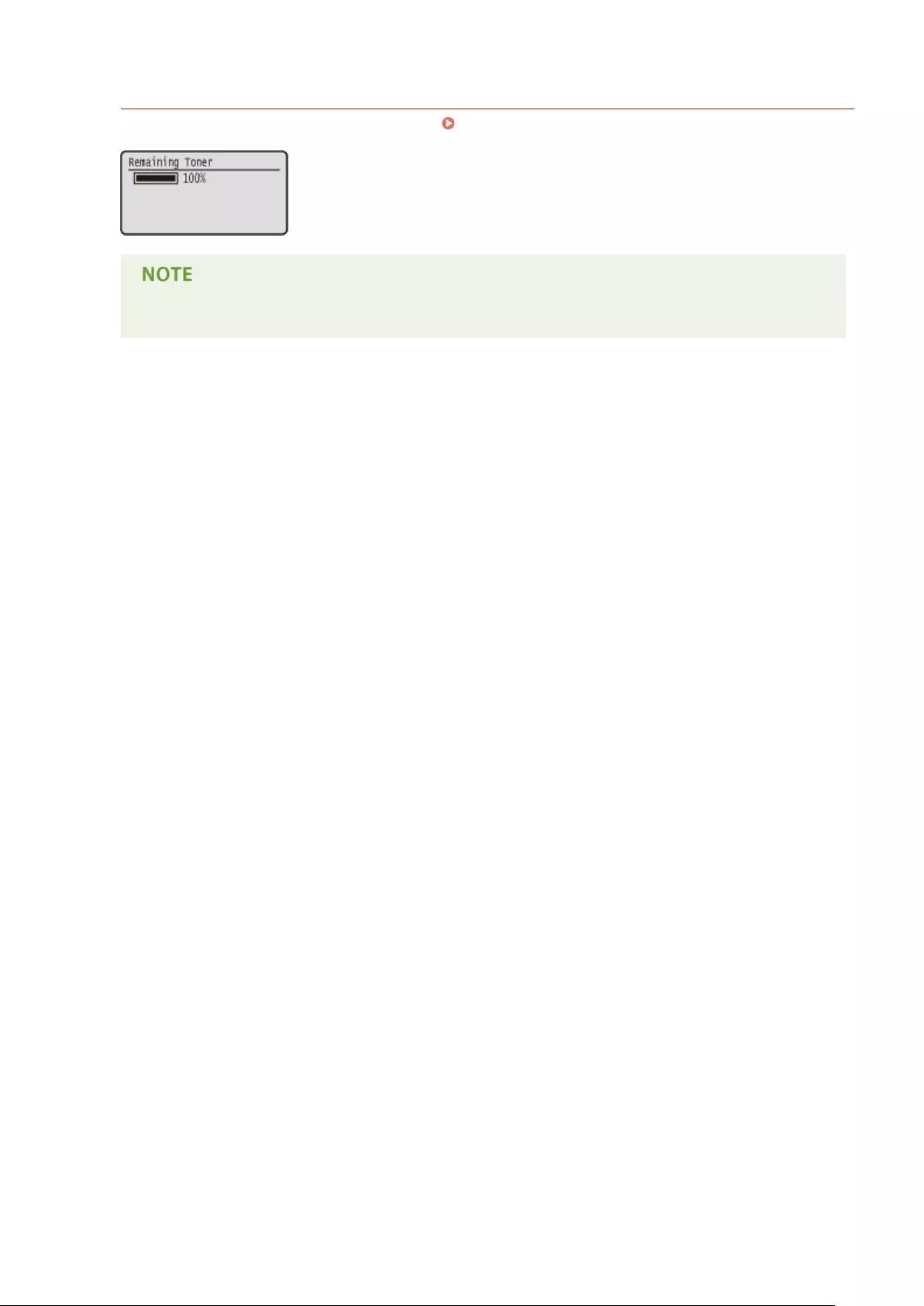Table of Contents
- Contents
- Important Safety Instructions
- Basic Operations
- Parts and Their Functions
- Using the Operation Panel
- Turning ON/OFF the Power
- Loading Paper
- Saving Energy
- Printing a Document
- Printing from a Computer
- Basic Printing Operations
- Canceling Prints
- Various Print Settings
- Enlarging or Reducing
- Switching 1-Sided and 2-Sided Printing
- Collating Printouts by Page
- Printing Multiple Pages onto One Sheet
- Printing Posters
- Printing Booklet
- Printing Borders
- Printing Dates and Page Numbers
- Printing Watermarks
- Printing Specific Pages onto Different Paper
- Selecting Document Type
- Saving Toner
- Combining and Printing Multiple Documents
- Configuring Print Settings to Your Needs
- Using Useful Print Functions
- Printing from a Computer
- Can Be Used Conveniently with a Mobile Device
- Network
- Security
- Using Remote UI
- Setting Menu List
- Troubleshooting
- Maintenance
- Appendix
- SIL OPEN FONT LICENSE
Canon LBP351x User Manual
Displayed below is the user manual for LBP351x by Canon which is a product in the Laser Printers category. This manual has pages.
Related Manuals

LBP352x / LBP351x
User's Guide
USRMA-0699-00 2016-05 en Copyright CANON INC. 2016

Contents
Important Safety Instructions ........................................................................................................... 2
Installation ............................................................................................................................................................... 3
Power Supply ............................................................................................................................................................ 5
Handling ................................................................................................................................................................... 6
Maintenance and Inspections .................................................................................................................................... 9
Consumables .......................................................................................................................................................... 10
Basic Operations .......................................................................................................................................... 14
Parts and Their Functions ........................................................................................................................................ 16
Front Side .......................................................................................................................................................... 17
Back Side ........................................................................................................................................................... 19
Interior .............................................................................................................................................................. 21
Multi-Purpose Tray .............................................................................................................................................. 22
Paper Drawer ..................................................................................................................................................... 23
Operation Panel ................................................................................................................................................. 24
Display ........................................................................................................................................................ 27
Using the Operation Panel ....................................................................................................................................... 29
Entering Text ...................................................................................................................................................... 31
Turning ON/OFF the Power ...................................................................................................................................... 33
Performing a Quick Start of the Machine ............................................................................................................... 35
Loading Paper ......................................................................................................................................................... 37
Loading Paper in the Paper Drawer ....................................................................................................................... 39
Loading Paper in the Multi-Purpose Tray ............................................................................................................... 44
Loading Paper in the Paper Deck (Option) .............................................................................................................. 47
Loading Envelopes in the Envelope Feeder (Option) ................................................................................................ 50
Loading Envelopes .............................................................................................................................................. 53
Loading Preprinted Paper .................................................................................................................................... 55
Specifying Paper Size and Type ............................................................................................................................. 59
Specifying the Size and Type of the Paper in the Paper Drawer ........................................................................... 60
Specifying Paper Size and Type in the Multi-Purpose Tray .................................................................................. 63
Specifying Paper Size and Type for the Envelope Feeder (Option) ........................................................................ 65
Saving Energy ......................................................................................................................................................... 67
Entering Sleep Mode ........................................................................................................................................... 68
Setting Auto Shutdown Time ................................................................................................................................ 71
Printing a Document ................................................................................................................................ 75
Printing from a Computer ....................................................................................................................................... 76
Basic Printing Operations .................................................................................................................................... 78
Canceling Prints ................................................................................................................................................. 83
Various Print Settings .......................................................................................................................................... 85
Enlarging or Reducing ................................................................................................................................... 87
I

Switching 1-Sided and 2-Sided Printing ............................................................................................................ 89
Collating Printouts by Page ............................................................................................................................ 91
Printing Multiple Pages onto One Sheet .......................................................................................................... 93
Printing Posters ............................................................................................................................................ 95
Printing Booklet ........................................................................................................................................... 96
Printing Borders ........................................................................................................................................... 98
Printing Dates and Page Numbers .................................................................................................................. 99
Printing Watermarks ................................................................................................................................... 101
Printing Specic Pages onto Different Paper .................................................................................................. 103
Selecting Document Type ............................................................................................................................ 105
Saving Toner .............................................................................................................................................. 107
Combining and Printing Multiple Documents ................................................................................................. 109
Conguring Print Settings to Your Needs ............................................................................................................. 113
Registering Combinations of Frequently Used Print Settings ............................................................................ 114
Changing Default Settings ........................................................................................................................... 116
Using Useful Print Functions ................................................................................................................................. 118
Printing from USB Memory (USB Direct Print) ....................................................................................................... 120
Changing Default USB Print Settings ............................................................................................................. 129
Printing a Document Secured by a PIN (Secured Print) .......................................................................................... 131
Using the Encrypted Print ............................................................................................................................ 136
Printing a Document Stored in the Machine (Stored Job Print) ................................................................................ 137
Deleting a Document Stored in the Machine .................................................................................................. 141
Setting a Name or PIN to a Box .................................................................................................................... 144
Printing without Opening a File (Direct Print) ....................................................................................................... 146
Print Settings for Direct Print ....................................................................................................................... 150
Printing Received E-mail (E-Mail Print) ................................................................................................................. 157
Can Be Used Conveniently with a Mobile Device ........................................................... 165
Connecting to a Mobile Device ............................................................................................................................... 166
Making the Best Use of the Machine by Utilizing Applications ................................................................................. 167
Using AirPrint ................................................................................................................................................... 169
Printing with AirPrint .................................................................................................................................. 173
If AirPrint Cannot Be Used ........................................................................................................................... 175
Using Google Cloud Print .................................................................................................................................. 176
Managing the Machine Remotely .......................................................................................................................... 180
Network ............................................................................................................................................................ 182
Connecting to a Network ...................................................................................................................................... 183
Connecting to a Wired LAN ................................................................................................................................ 185
Setting IP Addresses ......................................................................................................................................... 187
Setting IPv4 Address ................................................................................................................................... 188
Setting IPv6 Addresses ................................................................................................................................ 192
Conguring the Machine for Printing from a Computer .......................................................................................... 196
Conguring Printing Protocols and WSD Functions ............................................................................................... 197
Enabling IPP/IPPS ....................................................................................................................................... 203
Setting Up Print Server ...................................................................................................................................... 212
II

Conguring the Machine for Your Network Environment ....................................................................................... 216
Conguring Ethernet Settings ............................................................................................................................ 217
Setting a Wait Time for Connecting to a Network .................................................................................................. 219
Conguring DNS .............................................................................................................................................. 220
Conguring WINS ............................................................................................................................................. 226
Conguring SNTP ............................................................................................................................................. 229
Monitoring and Controlling the Machine with SNMP ............................................................................................. 232
Conguring Settings for Device Management Software ......................................................................................... 238
Conguring SMB .............................................................................................................................................. 242
Conguring Settings on the Computer for Printing ......................................................................................... 245
Security .............................................................................................................................................................. 248
Protecting the Machine from Unauthorized Access ................................................................................................ 249
Preventing Unauthorized Access ........................................................................................................................ 250
Setting Access Privileges .................................................................................................................................... 252
Setting the System Manager Password .......................................................................................................... 253
Setting the Department ID Management ....................................................................................................... 256
Setting a Remote UI PIN .............................................................................................................................. 263
Restricting Communication by Using Firewalls ..................................................................................................... 264
Specifying IP Addresses for Firewall Rules ...................................................................................................... 265
Specifying MAC Addresses for Firewall Rules .................................................................................................. 271
Setting a Proxy ................................................................................................................................................. 274
Restricting the Machine's Functions ...................................................................................................................... 277
Restricting the Printing Operations ..................................................................................................................... 278
Restricting USB Functions .................................................................................................................................. 282
Restricting Operation Panel Functions ................................................................................................................. 285
Disabling HTTP Communication ......................................................................................................................... 288
Disabling Remote UI ......................................................................................................................................... 289
Disabling the LAN Port ...................................................................................................................................... 290
Hiding the Print Job History ................................................................................................................................ 291
Implementing Robust Security Features ................................................................................................................ 293
Using TLS for Encrypted Communications ............................................................................................................ 294
Conguring IPSec Settings ................................................................................................................................. 298
Conguring IEEE 802.1X Authentication ............................................................................................................... 309
Conguring Settings for Key Pairs and Digital Certicates ...................................................................................... 315
Generating Key Pairs ................................................................................................................................... 317
Using CA-issued Key Pairs and Digital Certicates ........................................................................................... 326
Verifying Key Pairs and Digital Certicates ..................................................................................................... 329
Using Remote UI ........................................................................................................................................ 332
Starting Remote UI ............................................................................................................................................... 333
Remote UI Screens ................................................................................................................................................ 336
Managing Documents and Checking the Machine Status ........................................................................................ 342
Enabling End Users to Operate Documents .......................................................................................................... 348
Setting Up Menu Options from Remote UI ............................................................................................................. 351
III

Saving/Loading Registered Data ............................................................................................................................ 353
Saving Registered Data ..................................................................................................................................... 354
Loading Registered Data ................................................................................................................................... 356
Setting Menu List ...................................................................................................................................... 359
Setup Menu .......................................................................................................................................................... 360
Control Menu ................................................................................................................................................... 361
Paper Source ................................................................................................................................................... 374
Network .......................................................................................................................................................... 375
Layout ............................................................................................................................................................. 395
Print Quality ..................................................................................................................................................... 399
Interface ......................................................................................................................................................... 403
User Maintenance ............................................................................................................................................ 406
Print Mode ....................................................................................................................................................... 415
Settings Specic to Print Mode ........................................................................................................................... 417
UFR II ........................................................................................................................................................ 418
PCL ........................................................................................................................................................... 419
Imaging .................................................................................................................................................... 425
XPS ........................................................................................................................................................... 431
PDF ........................................................................................................................................................... 435
PS ............................................................................................................................................................. 439
MEAP Settings .................................................................................................................................................. 442
Check Counter ................................................................................................................................................. 443
Initialize Menu ................................................................................................................................................. 444
Utility Menu .......................................................................................................................................................... 445
Job Menu .............................................................................................................................................................. 449
Reset Menu ........................................................................................................................................................... 451
Select Feeder Menu ............................................................................................................................................... 453
Troubleshooting ......................................................................................................................................... 461
Clearing Jams ........................................................................................................................................................ 463
When an Error Message Appears ........................................................................................................................... 480
Common Problems ................................................................................................................................................ 497
Installation/Settings Problems ........................................................................................................................... 498
Printing Problems ............................................................................................................................................. 501
When You Cannot Print Properly ............................................................................................................................ 503
Printing Results Are Not Satisfactory ................................................................................................................... 505
Paper Creases or Curls ...................................................................................................................................... 511
Paper Is Fed Incorrectly ..................................................................................................................................... 513
When a Problem Cannot Be Solved ......................................................................................................................... 514
Maintenance ................................................................................................................................................. 516
Cleaning the Machine ........................................................................................................................................... 518
Exterior ........................................................................................................................................................... 519
IV

Fixing Unit ....................................................................................................................................................... 520
Replacing Toner Cartridges ................................................................................................................................... 521
How to Replace Toner Cartridges ........................................................................................................................ 524
Relocating the Machine ......................................................................................................................................... 527
Maintaining and Improving Print Quality ............................................................................................................... 529
Adjusting Print Density ...................................................................................................................................... 530
Adjusting Print Position ..................................................................................................................................... 532
Printing Reports and Lists ..................................................................................................................................... 536
Viewing the Counter Value .................................................................................................................................... 545
Checking Consumables ......................................................................................................................................... 548
Initializing Settings ............................................................................................................................................... 550
Initializing Menu ............................................................................................................................................... 551
Initializing the Network Settings ......................................................................................................................... 552
Appendix ........................................................................................................................................................... 554
Third Party Software ............................................................................................................................................. 555
Feature Highlights ................................................................................................................................................ 556
Going Green and Saving Money ......................................................................................................................... 557
Improving Eciency ......................................................................................................................................... 559
So Much More .................................................................................................................................................. 562
Specications ....................................................................................................................................................... 565
Machine Specications ...................................................................................................................................... 566
Paper .............................................................................................................................................................. 569
Consumables ........................................................................................................................................................ 573
Consumable Parts ................................................................................................................................................. 574
Optional Items ...................................................................................................................................................... 575
Installing the ROM ............................................................................................................................................ 579
Installing an SD Card ......................................................................................................................................... 583
Manuals Included with the Machine ...................................................................................................................... 587
Using e-Manual ..................................................................................................................................................... 588
Installing e-Manual ........................................................................................................................................... 589
Uninstalling e-Manual ....................................................................................................................................... 591
Screen Layout of e-Manual ................................................................................................................................ 592
Viewing e-Manual ............................................................................................................................................. 598
Manual Display Settings .................................................................................................................................... 600
Managing MEAP Applications ................................................................................................................................ 601
Using FTP Clients .................................................................................................................................................. 602
Preparing for Using the FTP Server ..................................................................................................................... 603
Printing via FTP Client (FTP Print) ........................................................................................................................ 606
Specifying Settings via FTP Client ........................................................................................................................ 608
Others .................................................................................................................................................................. 615
Basic Windows Operations ................................................................................................................................. 616
For Mac OS Users ............................................................................................................................................. 623
Font Samples ................................................................................................................................................... 624
V

Notice ............................................................................................................................................................. 629
Oce Locations .................................................................................................................................................... 633
VI

Important Safety Instructions
Important Safety Instructions ................................................................................................................... 2
Installation ............................................................................................................................................................ 3
Power Supply ......................................................................................................................................................... 5
Handling ................................................................................................................................................................. 6
Maintenance and Inspections .............................................................................................................................. 9
Consumables ....................................................................................................................................................... 10
Important Safety Instructions
1

Important Safety Instructions
0X7U-000
The content described in this chapter is for the prevention of damage to property and injury to users of the machine
and others. Before using this machine, read this chapter and follow the instructions to properly use this machine. Do
not perform any operations not described in this manual. Canon will not be responsible for any damages resulting
from use not described in this manual, improper use, or repair/changes not performed by Canon or a third party
authorized by Canon.
Important Safety Instructions
2

Installation
0X7U-001
To use this machine safely and comfortably, carefully read the following precautions and install the machine in an
appropriate location.
Do not install in a location that may result in a re or electrical shock
●A location where the ventilation slots are blocked
(too close to walls, beds, rugs, or similar objects)
●A damp or dusty location
●A location exposed to direct sunlight or outdoors
●A location subject to high temperatures
●A location exposed to open ames
●Near alcohol, paint thinners or other ammable substances
Other warnings
●Do not connect unapproved cables to this machine. Doing so may result in a re or electrical shock.
●Do not place necklaces and other metal objects or containers lled with liquid on the machine. If foreign
substances come in contact with electrical parts inside the machine, it may result in a re or electrical shock.
●When installing and removing the optional accessories, be sure to turn OFF the power, unplug the power
plug, and then disconnect all the interface cables and power cord from the machine. Otherwise, the power
cord or interface cables may be damaged, resulting in a re or electrical shock.
●If any foreign substance falls into this machine, unplug the power plug from the AC power outlet and
contact your local authorized Canon dealer.
Do not install in the following locations
The machine may drop or fall, resulting in injury.
●Unstable location
●Location exposed to vibrations
Other cautions
●When carrying this machine, follow the instructions in this manual. If carried improperly, it may fall, resulting
in injury.
●When installing this machine, be careful not to get your hands caught between the machine and the oor or
walls, or between the paper drawers. Doing so may result in injury.
Important Safety Instructions
3

Do not install in the following locations that may result in damage
●A location subject to dramatic changes in temperature or
humidity
●A location near equipment that generates magnetic or
electromagnetic waves
●A laboratory or location where chemical reactions occur
●A location exposed to corrosive or toxic gases
●A location that may warp from the weight of the machine or
where the machine is liable to sink (a carpet, etc.)
Avoid poorly ventilated locations
●This machine generates a slight amount of ozone, etc. during normal use. Although sensitivity to ozone, etc.
may vary, this amount is not harmful. Ozone, etc. may be more noticeable during extended use or long
production runs, especially in poorly ventilated rooms. It is recommended that the room where the machine
operates be appropriately ventilated to maintain a comfortable working environment. Also avoid locations
where people would be exposed to emissions from the machine.
Do not install in a location where condensation occurs
●Water droplets (condensation) may form inside the machine when the room where the machine is installed
is heated rapidly, and when the machine is moved from a cool or dry location to a hot or humid location.
Using the machine under these conditions may result in paper jams, poor print quality, or damage to the
machine. Let the machine adjust to the ambient temperature and humidity for at least 2 hours before use.
In altitudes of 3,000 m or above sea level
●Machines with a hard disk may not operate properly when used at high altitudes of about 3,000 meters
above sea level, or higher.
Important Safety Instructions
4

Power Supply
0X7U-002
This machine is compatible with voltages of 220 to 240 V, and electrical frequency of 50/60 Hz.
●Use only a power supply that meets the specied voltage requirements. Failure to do so may result in a re
or electrical shock.
●Do not use power cords other than the one provided, as this may result in a re or electrical shock.
●The provided power cord is intended for use with this machine. Do not connect the power cord to other
devices.
●Do not modify, pull, forcibly bend, or perform any other act that may damage the power cord. Do not place
heavy objects on the power cord. Damaging the power cord may result in a re or electrical shock.
●Do not plug in or unplug the power plug with wet hands, as this may result in an electrical shock.
●Do not use extension cords or multi-plug power strips with the machine. Doing so may result in a re or
electrical shock.
●Do not wrap the power cord or tie it in a knot, as this may result in a re or electrical shock.
●Insert the power plug completely into the AC power outlet. Failure to do so may result in a re or electrical
shock.
●Remove the power plug completely from the AC power outlet during a thunder storm. Failure to do so may
result in a re, electrical shock, or damage to the machine.
●Install this machine near the power outlet and leave sucient space around the power plug so that it can be
unplugged easily in an emergency.
When connecting power
●Do not connect the machine to an uninterruptible power source.
●If plugging this machine into an AC power outlet with multiple sockets, do not use the remaining sockets to
connect other devices.
●Do not connect the power cord into the auxiliary outlet on a computer.
Other precautions
●Electrical noise may cause this machine to malfunction or lose data.
Important Safety Instructions
5

Handling
0X7U-003
●Immediately unplug the power plug from the AC power outlet
and contact an authorized Canon dealer if the machine makes
an unusual noise, emits an unusual smell, or emits smoke or
excessive heat. Continued use may result in a re or electrical
shock.
●Do not disassemble or modify this machine. There are high-
voltage and high-temperature components inside the machine
which may result in a re or electrical shock.
●Place the machine where children will not come in contact with the power cord and other cables or internal
and electrical parts. Failure to do so may result in unexpected accidents.
●Do not use ammable sprays near this machine. If ammable substances come into contact with electrical
parts inside this machine, it may result in a re or electrical shock.
●When moving this machine, be sure to turn OFF the power of this machine and your computer, and then
unplug the power plug and interface cables. Failure to do so may damage the power cord or interface
cables, resulting in a re or electrical shock.
●When plugging or unplugging a USB cable when the power plug is plugged into an AC power outlet, do not
touch the metal part of the connector, as this may result in an electrical shock.
If you are using a cardiac pacemaker
●This machine generates a low level magnetic ux. If you use a cardiac pacemaker and feel abnormalities,
please move away from this machine and consult your physician immediately.
●Do not place heavy objects on this machine as they may fall, resulting in injury.
●For your safety, please unplug the power cord if the machine will not be used for a long period of time.
●Use caution when opening and closing covers to avoid injury to your hands.
●Keep hands and clothing away from the rollers in the output area. If the rollers catch your hands or clothing,
this may result in personal injury.
●The inside of the machine and the output slot are very hot during and immediately after use. Avoid contact
with these areas to prevent burns. Also, printed paper may be hot immediately after being output, so use
caution when handling it. Failure to do so may result in burns.
Important Safety Instructions
6

●Do not carry the machine with any of the paper drawer, optional
paper feeder, optional paper deck or optional envelope feeder
installed. Otherwise, they may fall, resulting in injury.
Laser beam
●This machine is classied as a Class 1 Laser Product under IEC60825-1:2007 and EN60825-1:2007. The laser
beam can be harmful to the human body. The laser beam is conned within protective housings and
external covers, so there is no danger of the laser beam escaping during normal machine operation. For
safety, never open covers other than those indicated in this manual.
●If you operate the machine in manners other than the control, adjustment, and operating procedures
prescribed in this manual, this may result in hazardous radiation exposure. If the laser beam should escape
and enter your eyes, exposure may cause damage to your eyes.
When transporting the machine
To prevent damage to the machine during transport, perform the following.
●Remove the toner cartridges.
●Securely pack the machine in the original box with packing materials.
If the operating noise concerns you
●Depending on the use environment and operating mode, if the operating noise is of concern, it is
recommended that the machine be installed in a place other than the oce.
Other precautions
●Follow the instructions in the caution label attached to this machine.
●Avoid shaking or applying shock to this machine.
●Do not forcibly open and close doors, covers, and other parts. Doing so may result in damage to the
machine.
●Do not touch the contacts ( ) inside the machine. Doing so may result in damage to the machine.
Important Safety Instructions
7

●To prevent a paper jam, do not turn OFF the power, open/close the covers, and load/unload the paper when
printing.
Important Safety Instructions
8

Maintenance and Inspections
0X7U-004
Clean this machine periodically. If dust accumulates, the machine may not operate properly. When cleaning, be sure to
observe the following. If a problem occurs during operation, see Troubleshooting(P. 461) . If the problem cannot be
resolved or you feel the machine requires an inspection, see When a Problem Cannot Be Solved(P. 514) .
●Before cleaning, turn OFF the power and unplug the power plug from the AC power outlet. Failure to do so
may result in a re or electrical shock.
●Unplug the power plug periodically and clean with a dry cloth to remove dust and grime. Accumulated dust
may absorb humidity in the air and may result in a re if it comes into contact with electricity.
●Use a damp, well wrung-out cloth to clean the machine. Dampen cleaning cloths with water only. Do not use
alcohol, benzenes, paint thinners, or other ammable substances. Do not use tissue paper or paper towels.
If these substances come into contact with electrical parts inside the machine, they may generate static
electricity or result in a re or electrical shock.
●Check the power cord and plug periodically for damage. Check the machine for rust, dents, scratches,
cracks, or excessive heat generation. Use of poorly-maintained equipment may result in a re or electrical
shock.
●The inside of the machine has high-temperature and high-voltage components. Touching these components
may result in burns. Do not touch any part of the machine that is not indicated in the manual.
●When loading paper or removing jammed paper, be careful not to cut your hands with the edges of the
paper.
●When removing jammed paper or replacing toner cartridges, be careful not to get any toner on your hands
or clothing. If toner gets on your hands or clothing, wash them immediately with cold water.
Important Safety Instructions
9

Consumables
0X7U-005
●Do not dispose of used toner cartridges in open ames. Also, do not store toner cartridges or paper in a
location exposed to open ames. This may cause the toner to ignite, and result in burns or re.
●If you accidentally spill or scatter toner, carefully wipe up the loose toner with a damp, soft cloth and avoid
inhaling any toner dust. Do not use a vacuum cleaner that is not equipped with safety measures to prevent
dust explosions to clean up loose toner. Doing so may cause damage to the vacuum cleaner or result in a
dust explosion due to static discharge.
If you are using a cardiac pacemaker
●The toner cartridge generates a low level magnetic ux. If you are using a cardiac pacemaker and feel
abnormalities, please move away from the toner cartridge and consult your physician immediately.
●Use caution not to inhale any toner. If you should inhale toner, consult a physician immediately.
●Use caution so that toner does not get into your eyes or mouth. If toner should get into your eyes or mouth,
immediately wash with cold water and consult a physician.
●Use caution so that toner does not come into contact with your skin. If it should, wash with soap and cold
water. If there is any irritation on your skin, consult a physician immediately.
●Keep the toner cartridges and other consumables out of the reach of small children. If toner is ingested,
consult a physician or poison control center immediately.
●Do not disassemble or modify the toner cartridge. Doing so may cause the toner to scatter.
●Remove the sealing tape of the toner cartridge completely without using excessive force. Doing otherwise
may cause the toner to scatter.
Handling the toner cartridge
●Be sure to hold the toner cartridge using the handle.
●Do not touch the toner cartridge memory ( ) or the electrical contacts ( ). To avoid scratching the
surface of the drum inside the machine or exposing it to light, do not open the drum protective shutter ( ).
Important Safety Instructions
10

●Do not remove the toner cartridge from this machine or from the protective bag unnecessarily.
●The toner cartridge is a magnetic product. Do not move it close to products susceptible to magnetism
including oppy disks and disk drives. Doing so may result in data corruption.
Storing the toner cartridge
●Store in the following environment to ensure safe and satisfactory use.
Storage temperature range: 0 to 35 °C
Storage humidity range: 35 to 85% RH (relative humidity/no condensation)*
●Store without opening until the toner cartridge is to be used.
●When removing the toner cartridge from this machine for storage, place the removed toner cartridge into
the original protective bag or wrap it with a thick cloth.
●When storing the toner cartridge, do not store it upright or upside down. The toner will solidify and may not
return to its original condition even if it is shaken.
* Even within the storable humidity range, water droplets (condensation) may develop inside the toner cartridge if there is a
difference of temperature inside and outside the toner cartridge. Condensation will adversely affect the print quality of
toner cartridges.
Do not store the toner cartridge in the following locations
●Locations exposed to open ames
●Locations exposed to direct sunlight or bright light for ve minutes or more
●Locations exposed to excessive salty air
●Locations where there are corrosive gases (i.e. aerosol sprays and ammonia)
●Locations subject to high temperature and high humidity
●Locations subject to dramatic changes in temperature and humidity where condensation may easily occur
●Locations with a large amount of dust
●Locations within the reach of children
Be careful of counterfeit toner cartridges
●Please be aware that there are counterfeit Canon toner cartridges in the marketplace. Use of counterfeit
toner cartridge may result in poor print quality or machine performance. Canon is not responsible for any
malfunction, accident or damage caused by the use of counterfeit toner cartridge.
For more information, see canon.com/counterfeit .
Availability period of repairing parts and toner cartridges
●The repairing parts and toner cartridges for the machine will be available for at least seven (7) years after
production of this machine model has been discontinued.
Toner cartridge packing materials
●Save the protective bag for the toner cartridge. They are required when transporting this machine.
Important Safety Instructions
11

●The packing materials may be changed in form or placement, or may be added or removed without notice.
●Dispose of the removed sealing tape according to local regulations.
When disposing of a used toner cartridge
●Place the toner cartridge into its protective bag to prevent the toner from scattering, and then dispose of the
toner cartridge according to local regulations.
Important Safety Instructions
12

Basic Operations
Basic Operations ............................................................................................................................................... 14
Parts and Their Functions ................................................................................................................................... 16
Front Side ....................................................................................................................................................... 17
Back Side ........................................................................................................................................................ 19
Interior ........................................................................................................................................................... 21
Multi-Purpose Tray ......................................................................................................................................... 22
Paper Drawer ................................................................................................................................................. 23
Operation Panel .............................................................................................................................................. 24
Display ..................................................................................................................................................... 27
Using the Operation Panel .................................................................................................................................. 29
Entering Text .................................................................................................................................................. 31
Turning ON/OFF the Power ................................................................................................................................. 33
Performing a Quick Start of the Machine ........................................................................................................ 35
Loading Paper ...................................................................................................................................................... 37
Loading Paper in the Paper Drawer ................................................................................................................ 39
Loading Paper in the Multi-Purpose Tray ........................................................................................................ 44
Loading Paper in the Paper Deck (Option) ...................................................................................................... 47
Loading Envelopes in the Envelope Feeder (Option) ....................................................................................... 50
Loading Envelopes .......................................................................................................................................... 53
Loading Preprinted Paper ............................................................................................................................... 55
Specifying Paper Size and Type ....................................................................................................................... 59
Specifying the Size and Type of the Paper in the Paper Drawer ............................................................... 60
Specifying Paper Size and Type in the Multi-Purpose Tray ....................................................................... 63
Specifying Paper Size and Type for the Envelope Feeder (Option) ............................................................ 65
Saving Energy ...................................................................................................................................................... 67
Entering Sleep Mode ...................................................................................................................................... 68
Setting Auto Shutdown Time .......................................................................................................................... 71
Basic Operations
13

Basic Operations
0X7U-006
This chapter describes basic operations, such as how to use the operation panel or how to load the paper, that are
frequently performed to use the functions of the machine.
◼Parts and Their Functions
This section describes the exterior and interior parts of the machine and their functions, as well as how to use the keys
on the operation panel and how to view the display. Parts and Their Functions(P. 16)
◼Using the Operation Panel
This section describes how to use the keys on the operation panel to perform various operations, such as adjusting
and checking the settings. Using the Operation Panel(P. 29)
◼Turning ON/OFF the Power
This section describes how to turn ON/OFF the power. Turning ON/OFF the Power(P. 33)
◼Loading Paper
This section describes how to load the paper into the paper drawer, multi-purpose tray, optional paper deck, and
optional envelope feeder. Loading Paper(P. 37)
Basic Operations
14

Parts and Their Functions
0X7U-007
This section describes the parts of the machine (exterior, front and back side, and interior) and how they function. In
addition to describing the parts of the machine used for such basic operations as loading paper and replacing the
toner cartridges, this section also describes the keys on the operation panel and display. Read this section for tips on
how to use the machine properly.
Front Side(P. 17)
Back Side(P. 19)
Interior(P. 21)
Multi-Purpose Tray(P. 22)
Paper Drawer(P. 23)
Operation Panel(P. 24)
Basic Operations
16

Front Side
0X7U-008
Output tray
Printed paper is output to the output tray.
Ventilation slots
Air from inside the machine is vented out to cool down the inside of the machine. Note that placing objects in
front of the ventilation slots prevents ventilation. Installation(P. 3)
Rating label
The label shows the serial number, which is needed when making inquiries about the machine. When a
Problem Cannot Be Solved(P. 514)
Lift handles
Hold the lift handles when carrying the machine. Relocating the Machine(P. 527)
Multi-purpose tray
Load the paper into the multi-purpose tray when you want to temporarily use a type of paper different from
that which is loaded in the paper drawer. Loading Paper in the Multi-Purpose Tray(P. 44)
Operation panel
The operation panel consists of numeric keys, a display, status indicators, etc. You can perform all the
operations and specify settings from the operation panel. Operation Panel(P. 24) Display(P. 27)
Basic Operations
17

Power switch
Press the power switch to turn ON the power. When turning OFF the power, do not use this switch, but follow
the procedures shown in Turning OFF the Power (Performing a Shutdown)(P. 33) .
Top cover
Open the top cover when replacing the toner cartridge or clearing paper jams. How to Replace Toner
Cartridges(P. 524) Clearing Jams(P. 463)
Paper drawer
Load the type of paper you frequently use into the paper drawer. Loading Paper in the Paper
Drawer(P. 39)
USB memory port (For USB memory)
You can connect a USB memory device to the machine and directly print the data from the USB memory
device. You can directly print the data in the USB memory device without using a computer. ( Printing
from USB Memory (USB Direct Print)(P. 120) ). Also, connect a USB memory device when exporting or
importing the settings of the machine ( Import/Export Set.(P. 413) ).
Right cover
Open the right cover to install the optional ROM. Installing the ROM(P. 579)
Basic Operations
18

Back Side
0X7U-009
Sub-output tray (Back cover)
Open the sub-output tray when printing on the envelopes. When using a paper type that easily curls such as
labels, you can reduce curl by opening this tray ( Paper Curls(P. 511) ).
Ventilation slots
Air from inside the machine is vented out to cool down the inside of the machine. Note that placing objects in
front of the ventilation slots prevents ventilation. Installation(P. 3)
Power socket
Connect the power cord.
Duplex unit
If paper has jammed during 2-sided printing, remove this.
SD card slot cover
Open the SD card slot cover when installing the optional SD card. Installing an SD Card(P. 583)
USB port (for USB device connection)
Connect a USB device that is used with MEAP applications.
USB port (for computer connection)
Connect a USB cable when connecting the machine and a computer.
ACT indicator
The ACT indicator blinks while data is being sent or received.
Basic Operations
19

Interior
0X7U-00A
Transport guide (at the back)
If there is a paper jam inside the machine, raise the transport guide to remove the jammed paper.
Clearing Jams(P. 463)
Transport guide (at the front)
If paper has jammed inside the machine, remove the envelope feeder cover and then raise this to remove the
jammed paper. Clearing Jams(P. 463)
Envelope feeder cover
To install the optional envelope feeder, remove this.
Basic Operations
21

Paper Drawer
0X7U-00E
Paper guides
Adjust the paper guides to exactly the size of the loaded paper to ensure that paper is fed straight into the
machine. Press the lock release levers that are marked with arrows in the illustrations to release the locks
and slide the paper guides.
Paper level indicator
Indicates the remaining amount of paper. The mark moves downward as the remaining amount of paper
decreases.
LINKS
Loading Paper in the Paper Drawer(P. 39)
Basic Operations
23

Operation Panel
0X7U-00F
Display
Displays the current printing or other operation status, error information, amount remaining in the toner
cartridge, etc. Display(P. 27)
Job Status/Cancel key
If you press this key when the [ ] indicator is lit or blinking, a document being printed and documents
waiting to be printed are listed. You can select the document from the list and cancel printing of the
document. From the Operation Panel(P. 84)
Back key
Press to return to the previous screen. If you press this key when specifying settings, for example, the
settings are not applied and the display returns to the previous screen.
Numeric keys ([0]-[9] keys)
Press to enter numbers and text. Entering Text(P. 31)
[*] key
Press to switch the type of text that is entered.
Basic Operations
24

Ready indicator
Lights up when the machine is ready for printing or otherwise blinks.
Message indicator
●Lights up when a problem occurs to disable printing. Troubleshooting(P. 461)
●Lights up if the machine enters sleep mode while being off line.
Job indicator
Lights up when the machine is receiving print data or any print data remains in the memory of the machine.
Blinks when print data is being processed.
Energy Saver key
Press to put the machine into sleep mode. This key lights up in green when the machine is in sleep mode.
Press the key again to exit sleep mode. Entering Sleep Mode(P. 68)
Application key
Each press of this key cycles through the functions in the order of: Print Screen MEAP1 MEAP2 ...
MEAP8 USB Direct Print Print Screen. Select the function you want to use. If you press this key without
logging on when department ID management is enabled, the authentication screen is displayed.
Feeder Selection key
Press to select the paper source or specify the paper size. Select Feeder Menu(P. 453)
[ID] key
Displays the login screen for using the MEAP function. After you nish using the machine, press this key
again to log off.
Clear key
Press to delete the entered numbers and text.
Online key
Switches between online mode (printing jobs are accepted) and oine mode (no printing job is accepted).
This key lights up green when the machine is online and goes off when the machine is oine. Usually, keep
the machine online, but set it to oine when specifying settings of User Maintenance(P. 406) in the
setting menu.
●If you do not operate the key for 2 minutes when the machine is oine and the Main Screen(P. 27) is
displayed, the machine automatically becomes online. You can select <Auto Reset Time> to change this
time value ( Auto Reset Time(P. 363) ).
[#] key
Press to enter symbols such as "@" or "/".
Basic Operations
25

Utility key/[ ] key
●Displays the Utility menu. You can display the total number of printed pages and print internal system
information for checking. Utility Menu(P. 445)
●When specifying settings, press to return to the previous screen. When entering text, press to move the
cursor to the left.
Job key/[ ] key
●Displays the Job menu. You can check the print logs. Job Menu(P. 449)
●When specifying settings, press to select the item immediately above the currently selected item. When
changing setting values, press to increase a value.
Settings key/[ ] key
●Displays the Setup menu. You can specify settings of the machine. Setup Menu(P. 360)
●When specifying settings, press to proceed to the next screen. When entering text, press to move the
cursor to the right.
Reset key/[ ] key
●Displays the Reset menu. You can cancel all processes, delete data in memory, and turn OFF the power.
Reset Menu(P. 451)
●When specifying settings, press to select the item immediately below the currently selected item. When
changing setting values, press to decrease a value.
[OK] key
Press to apply settings or specied details.
LINKS
Using the Operation Panel(P. 29)
Basic Operations
26

Display
0X7U-00H
The display shows the printing status and the screens for specifying settings. It also
shows error messages and the amount remaining in the toner cartridge.
Main Screen
Status indication
Displays the current status or operation mode of the machine.
Paper size indication
Displays the currently selected paper size.
The following paper sizes are shown in an abbreviated form.
●Legal: LG
●Letter:LT
●Executive: EX
●Statement: ST
●Foolscap: FC
●16K: 16K
●Envelope DL: DL
●Envelope No.10: CO
●Envelope ISO-C5: EC5
●Envelope Monarch: MO
●Index Card: IC
●Free Size: FR
●Custom Paper Size Landscape: 80
●Custom Paper Size Portrait: 80
Remaining toner cartridge indication
The amount of remaining toner cartridge is indicated.
Menu Screen
Press ( ), ( ), ( ), ( ), or ( ) to display the corresponding menu screen. The
screen displayed when ( ) is pressed is shown below as an example.
Setting Menu List(P. 359)
Basic Operations
27

When an Error Occurs
In some cases when an error occurs, instructions on how to respond to the error are displayed. Follow the on-
screen instructions to solve the problem. The screen displayed when a paper jam occurs is shown below as an
example. When an Error Message Appears(P. 480)
LINKS
Using the Operation Panel(P. 29)
Basic Operations
28

Using the Operation Panel
0X7U-00J
Use the keys shown below to specify settings and adjust values.
Using /
Scrolling the Screen
The scroll bar is displayed on the right side of the screen when not all of the information ts on one screen. If
the scroll bar is displayed, use / to scroll up or down. The text and background colors of an item are
inverted when it is selected.
Changing a Setting Value
Use / to enter values.
●Values in ( ) displayed below the entry box are the enterable value range.
Using /
Proceeding to the Next Screen/Returning to the Previous Screen
Press to proceed to the next screen. Press to return to the previous screen.
Basic Operations
29

●You can also proceed to the next screen by pressing , and return to the previous screen by pressing
.
Moving the Cursor
Use / to enter text and values. Entering Text(P. 31)
Using
Press to apply a setting.
Using ( )
To return to the main screen after exiting the setting menu, press ( ).
Using the Numeric Keys
Use the numeric keys to enter text and values. Entering Text(P. 31)
●Depending on the screen, you cannot use the numeric keys to enter values. In that case, enter with /
.
●You can specify a variety of display-related settings, such as the screen adjustment and display language, by
using <Control Menu> in the setting menu of the operation panel. Control Menu(P. 361)
Basic Operations
30

Entering Text
0X7U-00K
Use the numeric keys to enter text and values.
Switching the Type of Text
Press to switch the type of text that is entered.
Types of Text That Can Be Entered
Text that can be entered is listed below.
Key A a 12
@ . - _ / 1
ABC abc 2
DEF def 3
GHI ghi 4
JKL jkl 5
MNO mno 6
PQRS pqrs 7
TUV tuv 8
Basic Operations
31

WXYZ wxyz 9
(Not available) 0
(space) -.*#!",;:^`_=/|'?$@%&+\~()[]{}<> (Not available)
●Press when the type of text that is entered is <A> or <a> to display enterable symbols in the
screen. Use / / / to select the symbol you want to enter, and press .
Deleting Text
One character is deleted each time is pressed. Press and hold to delete all of the entered text.
Moving the Cursor
Press or to move the cursor.
Entering a Space
Press , and press .
Example of Entering Text and Numbers
Example: "Canon 1"
1Press repeatedly until <A> is selected.
2Press repeatedly until the letter "C" is selected.
3Press repeatedly until <a> is selected.
4Press repeatedly until the letter "a" is selected.
5Press repeatedly until the letter "n" is selected.
6Press repeatedly until the letter "o" is selected.
7Press repeatedly until the letter "n" is selected.
8Press , and press .
9Press repeatedly until <12> is selected.
10 Press .
11 Press .
Basic Operations
32

Turning ON/OFF the Power
0X7U-00L
The power switch is used to turn ON the machine. However, when turning OFF the machine, be sure to shut down the
machine from the operation panel without using the power switch. This procedure is the same as that for turning
ON/OFF a computer.
Turning ON the Power(P. 33)
Turning OFF the Power (Performing a Shutdown)(P. 33)
Turning ON the Power
Press the power switch of the machine. When the main screen appears on the display of the operation panel after self-
diagnosis is performed, the machine is ready for printing.
●If a message is displayed after the self-diagnosis When an Error Message Appears(P. 480)
●If you specify the quick startup settings, you can reduce a waiting time after the power is turned on.
Performing a Quick Start of the Machine(P. 35)
Turning OFF the Power (Performing a Shutdown)
When turning OFF the machine, shut down the machine from the operation panel.
Performing a Shutdown without Using the Power Switch
●If you press the power switch to turn OFF the power, an unexpected error may occur. Follow the procedure
below to properly turn OFF the power.
●If you have enabled the quick start function, you can press the power switch to turn OFF the power.
Performing a Quick Start of the Machine(P. 35)
1Press ( ).
Basic Operations
33

2Use / to select <Shut Down>, and press .
3Select <Yes>, and press .
➠After the message below appears, the power is automatically turned OFF.
When <Could not execute.> appears
●There is remaining print data. Delete the data ( Reset Menu(P. 451) ), and retry the operation. To
cancel the operation, press ( ).
●It may take a maximum of 10 minutes until the power is turned OFF, but it is not a failure.
Do not turn ON the power immediately after turning OFF the power
●Wait for 10 seconds or more, and then turn ON the power.
●The machine slightly consumes power even after the power is turned OFF. To completely eliminate power
consumption, unplug the power plug from the AC power outlet.
LINKS
Performing a Quick Start of the Machine(P. 35)
Basic Operations
34

Performing a Quick Start of the Machine
0X7U-00R
If you specify the quick startup settings, you can reduce the time from when the power switch is pressed until the
screens become operable. The way of turning OFF the power to perform a quick start of the machine is called "quick
turn-OFF."
Conguring Quick Startup Settings(P. 35)
Turning OFF the Power (Performing a Quick Turn-OFF)(P. 36)
Before Conguring Quick Startup Settings
When you are using a network
If any of the settings below is <On>, the quick start function is disabled.
●RARP, BOOTP, IPv6 Network(P. 182)
●IPSec Conguring IPSec Settings(P. 298)
When you are using the MEAP function
Check whether the currently installed MEAP applications support the quick start function.
Conguring Quick Startup Settings
1Press ( ).
2Use / to select <Control Menu>, and press .
3Select <Main Pwr Quick Start>, and press .
4Select <On>, and press .
<Off>
Disables the Quick Start function.
<On>
Enables the Quick Start function.
5Perform a hard reset. Performing a Hard Reset(P. 451)
➠The settings are enabled after the hard reset is performed.
Basic Operations
35

Turning OFF the Power (Performing a Quick Turn-OFF)
If you press the power switch to turn OFF the power when the quick start function is enabled, a quick start of the
machine is performed when the machine is turned ON next time (quick turn-OFF).
Do not unplug the power plug from the AC power outlet after performing a quick turn-
OFF
●Do not unplug the power plug from the AC power outlet after turning OFF the power by performing a quick
turn-OFF. Doing so may damage the internal components of the machine. Before you unplug the power plug
when relocating the machine, turn ON the power, and then perform a shutdown. Turning OFF the Power
(Performing a Shutdown)(P. 33)
●When the machine is performing a job or is in an error state or after you change any setting using the
operation panel or Remote UI, pressing the power switch does not trigger a quick turn-OFF, but triggers a
shutdown instead.
●If the power is turned OFF by a shutdown operation even when the quick start function is enabled, the
machine starts as usual when it is turned ON next time.
●If you perform the auto shutdown timer function when the quick start function is enabled, a quick turn-OFF
is performed. Setting Auto Shutdown Time(P. 71)
●If you turn ON the power immediately after performing a quick turn-OFF, it may take some time for the
machine to start up.
Basic Operations
36

Loading Paper
0X7U-00S
You can load paper into the paper drawer, multi-purpose tray, optional paper deck, and optional envelope feeder.
Load the paper you usually use into the paper drawer. The paper drawer is convenient when using large amounts of
paper. Use the multi-purpose tray when you temporarily use size or type of paper that is not loaded in the paper
drawer. See Paper(P. 569) for available paper sizes.
Paper Type and Setting for the Machine
See the table below to specify the paper settings according to the type and weight of the paper to load into the
paper source. For more information about how to specify the paper settings on the machine, see Specifying
Paper Size and Type(P. 59) . For the amount of paper that can be loaded in each paper source, see
Paper(P. 569) .
Paper Type Paper Weight Paper Setting on the Machine
Plain paper *1
60 g/m² <Plain L2>
61 to 70 g/m² <Plain L> *2
71 to 89 g/m² <Plain>
Heavy paper
90 to 120 g/m² <Heavy 1>
121 to 135 g/m² <Heavy 2>
136 to 199 g/m² <Heavy 3>
Bond paper
60 to 75 g/m² <Heavy 1>
76 to 90 g/m² <Heavy 2>
Envelope <Envelope>
<Envelope H> *3
Label <Labels>
*1 Recycled paper is also available.
*2 Specify <Plain L> as the paper type if printouts come out curled with <Plain> specied.
*3 Specify <Envelope H> as the paper type if printouts come out faded due to poor toner xing with <Envelope> specied.
Do not use the following types of paper:
●Wrinkled or creased paper
●Curled or rolled paper
●Torn paper
●Damp paper
●Very thin paper
Basic Operations
37

●Paper printed by a thermal transfer printer
●Highly textured paper
●Glossy paper
●Paper with low stiffness
Paper handling and storage
●Store the paper on a at surface.
●Keep the paper wrapped in its original package to protect the paper from moisture or dryness.
●Do not store the paper in such a way that may cause it to curl or fold.
●Do not store the paper vertically or stack too much paper.
●Do not store the paper in direct sunlight, or in a place subject to high humidity, dryness, or drastic
changes in temperature or humidity.
When printing on paper that has absorbed moisture
●Steam may emit from the paper output area, or water droplets may form on and around the paper
output area. There is nothing unusual about any of these occurrences, which occur when the heat
generated from xing toner on the paper causes moisture in the paper to evaporate (most likely to
occur at low room temperatures).
Basic Operations
38

Loading Paper in the Paper Drawer
0X7U-00U
Load the paper that you usually use in the paper drawer. When you want to print on paper that is not loaded in the
paper drawer, load the paper in the multi-purpose tray. Loading Paper in the Multi-Purpose Tray(P. 44)
Loading Standard Size Paper(P. 39)
Loading a Custom Size Paper(P. 41)
Paper Orientation
See the table below to load available paper in correct orientation.
Paper Orientation
A4, A5 (portrait), A6 *1 , B5, Legal, Letter, Executive, Statement *1, Foolscap, 16K, Custom (portrait)
A5 (landscape)*2, Custom (landscape)
*1 Can be loaded only in the optional custom media cassette.
*2 Can be loaded only in the optional A5 cassette.
●Follow the procedure below when loading paper into the optional paper feeder.
Loading Standard Size Paper
To load paper whose size is found in the paper size markings on the paper drawer, use the following procedure. For
paper whose size is not found in the paper size markings, see Loading a Custom Size Paper(P. 41) .
1Pull out the paper drawer until it stops, and remove it while lifting the front side.
2Adjust the positions of the paper guides to the paper size you want to use.
●Press the lock release lever ( ) to align the projection ( ) to the appropriate paper size marking.
Basic Operations
39

3Load the paper so that the edge of the paper stack is aligned against the paper guide
on the rear side of the paper drawer.
●Insert the paper with the print side face down.
●Fan the paper stack well, and tap it on a at surface to align the edges.
Do not exceed the load limit line when loading paper
●Make sure that the paper stack does not exceed the load limit line ( ). Loading too much paper can
cause paper jams.
●When loading paper with a logo, see Loading Preprinted Paper(P. 55) .
4Set the paper drawer.
»Continue to Specifying the Size and Type of the Paper in the Paper Drawer(P. 60)
When changing the paper size or type
●If the paper size setting is other than <Auto> or if you load a different type of paper into the machine,
make sure to change the settings. If you do not change the paper size or type setting, the machine cannot
print properly.
Printing on the Back Side of Printed Paper (Manual 2-Sided Printing)
Basic Operations
40

You can print on the back side of printed paper. Flatten any curls on the printed paper and insert it into the
multi-purpose tray ( Loading Paper in the Multi-Purpose Tray(P. 44) ), with the side to print face up
(previously printed side face down).
●When you want to print on the back side of the paper that is already printed, set <Manual 2-Sided (MP)> to
<2nd Side> in the setting menu of the operation panel. Manual 2-Sided (MP)(P. 458)
●Load one sheet of paper each time you print.
●You can use only the paper printed with this machine.
●You cannot print on the side that has previously been printed on.
Loading a Custom Size Paper
To load custom size paper or other paper whose size is not found in the paper size markings on the paper drawer, use
the following procedure.
1Pull out the paper drawer until it stops, and remove it while lifting the front side.
2Slide the paper guides apart.
●Press the lock release lever to slide the paper guides outward.
3Load the paper so that the edge of the paper stack is aligned against the front side of
the paper drawer.
●Place the paper stack with the print side face down.
●Fan the paper stack well, and tap it on a at surface to align the edges.
Basic Operations
41

Do not exceed the load limit line when loading paper
●Make sure that the paper stack does not exceed the load limit line ( ). Loading too much paper can
cause paper jams.
●When loading paper with a logo, see Loading Preprinted Paper(P. 55) .
4Align the paper guides against the edges of the paper.
●Press the lock release lever and slide the paper guides inward until they are aligned securely against the
edges of the paper.
Align the paper guides securely against the edges of the paper
●Paper guides that are too loose or too tight can cause misfeeds or paper jams.
5Insert the paper drawer into the machine.
»Continue to Specifying the Size and Type of the Paper in the Paper Drawer(P. 60)
When changing the paper size or type
●If you load custom size paper or a different type of paper into the machine, make sure to change the
settings. If you do not change the paper size or type setting, the machine cannot print properly.
●When you want to print a document from an environment not allowing you to make settings for paper size
and paper type, such as from a computer running an operating system or a mobile device that does not
support any printer driver, set <Standard Paper Size> and <Default Paper Type>. Select Feeder
Menu(P. 453)
Basic Operations
42

Printing on the Back Side of Printed Paper (Manual 2-Sided Printing)
You can print on the back side of printed paper. Flatten any curls on the printed paper and insert it into the
multi-purpose tray ( Loading Paper in the Multi-Purpose Tray(P. 44) ), with the side to print face up
(previously printed side face down).
●When you want to print on the back side of the paper that is already printed, set <Manual 2-Sided (MP)> to
<2nd Side> in the setting menu of the operation panel. Manual 2-Sided (MP)(P. 458)
●Load one sheet of paper each time you print.
●You can use only the paper printed with this machine.
●You cannot print on the side that has previously been printed on.
LINKS
Paper(P. 569)
Basic Operations
43

Loading Paper in the Multi-Purpose Tray
0X7U-00W
When you want to print on paper that is not loaded in the paper drawer, load the paper in the multi-purpose tray.
Load the paper that you usually use in the paper drawer. Loading Paper in the Paper Drawer(P. 39)
Paper Orientation
See the table below to load available paper in correct orientation.
Paper Orientation
A4, A5 (portrait), A6, B5, Legal, Letter, Executive, Statement, Foolscap, 16K, Index Card, Custom (portrait),
Envelope
A5 (landscape), Custom (landscape)
1Open the cover.
●Hold the left and right side handles, and open the cover.
2Pull out the paper tray.
3Spread the paper guides apart.
●Slide the paper guides outward.
Basic Operations
44

4Insert the paper into the multi-purpose tray until the paper stops.
●Insert the paper with the print side face up.
●Fan the paper stack well, and tap it on a at surface to align the edges.
Do not exceed the load limit guide when loading paper
●Make sure that the paper stack does not exceed the load limit guide ( ). Loading too much paper can
cause paper jams.
●When loading envelopes or paper with a logo, see Loading Envelopes(P. 53) or Loading Preprinted
Paper(P. 55) .
5Align the paper guides against the edges of the paper.
●Slide the paper guides inward until they are aligned securely against the edges of the paper.
Align the paper guides securely against the edges of the paper
●Paper guides that are too loose or too tight can cause misfeeds or paper jams.
»Continue to Specifying Paper Size and Type in the Multi-Purpose Tray(P. 63)
When changing the paper size or type
Basic Operations
45

●The factory default setting for paper size is <A4>. If you load a different size or type of paper into the
machine, make sure to change the settings. If you do not change the settings, a paper jam or printing
error may occur.
Printing on the Back Side of Printed Paper (Manual 2-Sided Printing)
You can print on the back side of printed paper. Flatten any curls on the printed paper and insert it into the
multi-purpose tray, with the side to print face up (previously printed side face down).
●When you want to print on the back side of the paper that is already printed, set <Manual 2-Sided (MP)> to
<2nd Side> in the setting menu of the operation panel. Manual 2-Sided (MP)(P. 458)
●Load one sheet of paper each time you print.
●You can use only the paper printed with this machine.
●You cannot print on the side that has previously been printed on.
LINKS
Paper(P. 569)
Basic Operations
46

Loading Paper in the Paper Deck (Option)
0X7U-00X
You can load a large amount of A4, Letter or Legal size paper in the paper deck. It will be convenient if you use the
paper deck to hold paper you use frequently.
1Press the button to open the door.
2Slide the paper guide.
●Adjust the paper guide to the position for the paper size you are using.
Adjust the paper guide to the exact position for the paper size
●If the guide position adjustment is not exact, it may cause paper misfeeds or paper jams.
3Load the paper so that the far edge of the paper stack is in close contact with the
rear side of the paper deck.
●Insert the paper with the print side face down.
●Fan the paper stack well, and tap it on a at surface to align the edges.
Basic Operations
47

Do not exceed the load limit line when loading paper
●Make sure that the paper stack does not exceed the load limit line ( ). Loading too much paper can
cause paper jams.
●When loading paper with a logo, see Loading Preprinted Paper(P. 55) .
4Close the door.
»Continue to Specifying the Size and Type of the Paper in the Paper Drawer(P. 60)
When changing the paper size or type
●If the paper size setting is other than <Auto> or if you load a different type of paper into the machine,
make sure to change the settings. If you do not change the paper size or type setting, the machine cannot
print properly.
Basic Operations
48

●When you want to print a document from an environment not allowing you to make settings for paper size
and paper type, such as from a computer running an operating system or a mobile device that does not
support any printer driver, set <Standard Paper Size> and <Default Paper Type>. Select Feeder
Menu(P. 453)
Printing on the Back Side of Printed Paper (Manual 2-Sided Printing)
You can print on the back side of printed paper. Flatten any curls on the printed paper and insert it into the
multi-purpose tray ( Loading Paper in the Multi-Purpose Tray(P. 44) ), with the side to print face up
(previously printed side face down).
●When you want to print on the back side of the paper that is already printed, set <Manual 2-Sided (MP)> to
<2nd Side> in the setting menu of the operation panel. Manual 2-Sided (MP)(P. 458)
●Load one sheet of paper each time you print.
●You can use only the paper printed with this machine.
●You cannot print on the side that has previously been printed on.
LINKS
Paper(P. 569)
Optional Items(P. 575)
Basic Operations
49

Loading Envelopes in the Envelope Feeder (Option)
0X7U-00Y
You can load a large number of envelopes in the envelope feeder. This provides you convenience when you are
printing on many envelopes at a time.
Paper Orientation
See the table below to load available paper in correct orientation.
Paper Orientation
custom (portrait), envelope
custom (landscape)
1Open the cover.
●Hold the handle on the right side, and open the cover.
2Spread the paper guides apart.
●Press the lock release lever to slide the paper guides outward.
3Raise the envelope pressure plate.
Basic Operations
50

4Insert the envelopes into the envelope feeder until they stop.
●Insert the envelopes with the print side face up.
●Fan the envelope stack well, and tap it on a at surface to align the edges.
Do not exceed the load limit line when loading envelopes
●Make sure that the envelope stack does not exceed the load limit line ( ). Loading too much envelopes
can cause paper jams.
●When loading envelopes, see Loading Envelopes(P. 53) .
5Align the paper guides against the edges of the envelopes.
●Press the lock release lever and slide the paper guides inward until they are aligned securely against the
edges of the envelopes.
Basic Operations
51

Align the paper guides securely against the edges of the envelopes
●Paper guides that are too loose or too tight can cause paper misfeeds or paper jams.
6Lower the envelope pressure plate.
»Continue to Specifying Paper Size and Type for the Envelope Feeder (Option)(P. 65)
When changing the paper size or type
●The factory default setting for paper size is <Env. DL>. If you load a different size or type of paper into the
machine, make sure to change the settings. If you do not change the settings, a paper jam or printing
error may occur.
Printing on the Back Side of Printed Paper (Manual 2-Sided Printing)
You can print on the back side of printed paper. Flatten any curls on the printed paper and insert it into the
multi-purpose tray ( Loading Paper in the Multi-Purpose Tray(P. 44) ), with the side to print face up
(previously printed side face down).
●When you want to print on the back side of the paper that is already printed, set <Manual 2-Sided (MP)> to
<2nd Side> in the setting menu of the operation panel. Manual 2-Sided (MP)(P. 458)
●Load one sheet of paper each time you print.
●You can use only the paper printed with this machine.
●You cannot print on the side that has previously been printed on.
LINKS
Loading Preprinted Paper(P. 55)
Paper(P. 569)
Optional Items(P. 575)
Basic Operations
52

Loading Envelopes
0X7U-010
Make sure to atten any curls on envelopes before loading them. Also pay attention to the orientation of envelopes
and which side is face up. Note that envelopes cannot be loaded in the paper drawer.
Before Loading Envelopes(P. 53)
Loading Envelopes in the Multi-Purpose Tray(P. 54)
●This section describes how to load envelopes in the orientation you want, as well as procedures that you
need to complete before loading envelopes. For the general procedure for loading envelopes in the multi-
purpose tray or optional envelope feeder, see the following.
Loading Paper in the Multi-Purpose Tray(P. 44)
Loading Envelopes in the Envelope Feeder (Option)(P. 50)
Before Loading Envelopes
Follow the procedure below to prepare the envelopes before loading.
●Envelopes cannot be ejected into the output tray. Make sure to open the sub-output tray.
1Close the ap of each envelope.
2Flatten them to release any remaining air, and make sure that the edges are pressed
tightly.
Basic Operations
53

3Loosen any stiff corners of the envelopes and atten any curls.
4Align the edges of the envelope on a at surface.
Loading Envelopes in the Multi-Purpose Tray
Load the envelopes Monarch, COM10, DL, or ISO-C5 in portrait orientation (with the short edge toward the machine),
with the non-glued side (front side) face up. You cannot print on the reverse side of envelopes. Use the same way to
load envelopes in the envelope feeder.
●Load the envelopes so that the edge with the ap is toward the left side as shown in the illustration.
Basic Operations
54

Loading Preprinted Paper
0X7U-011
When you use paper that has been preprinted with a logo, pay attention to the orientation of the paper when loading.
Load the paper properly so that printing is performed on the correct side of the paper with a logo.
Making 1-Sided Printouts on Paper with Logos(P. 55)
Making 2-Sided Printouts on Paper with Logos(P. 57)
●This section mainly describes how to load preprinted paper with the proper facing and orientation. For the
general procedure for loading paper in the paper drawer, multi-purpose tray, optional paper deck, or
optional envelope feeder, see the following.
Loading Paper in the Paper Drawer(P. 39)
Loading Paper in the Multi-Purpose Tray(P. 44)
Loading Paper in the Paper Deck (Option)(P. 47)
Loading Envelopes in the Envelope Feeder (Option)(P. 50)
Making 1-Sided Printouts on Paper with Logos
Printing on Paper with Logos in Portrait Orientation
When loading paper in the paper drawer or paper deck
Load the paper with the logo side (the side to print the document) face down.
Basic Operations
55

When loading paper in the multi-purpose tray or envelope feeder
Load the paper with the logo side (the side to print the document) face up.
Printing on Paper with Logos in Landscape Orientation
When loading paper in the paper drawer or paper deck
Load the paper with the logo side (the side to print the document) face down.
When loading paper in the multi-purpose tray or envelope feeder
Load the paper with the logo side (the side to print the document) face up.
Basic Operations
56

Making 2-Sided Printouts on Paper with Logos
When a document to print consists of an odd number of pages, set <Alternative Method> to <Off> in the setting menu
of the operation panel. Alternative Method(P. 398)
Printing on Paper with Logos in Portrait Orientation
When loading paper in the paper drawer or paper deck
Load the paper with the front logo side (the side to print the rst page of the document) face up.
When loading paper in the multi-purpose tray
Load the paper with the front logo side (the side to print the rst page of the document) face down.
Basic Operations
57

Printing on Paper with Logos in Landscape Orientation
When loading paper in the paper drawer or paper deck
Load the paper with the front logo side (the side to print the rst page of the document) face up.
When loading paper in the multi-purpose tray
Load the paper with the front logo side (the side to print the rst page of the document) face down.
The <Paper Feed Method> setting
●When you print on preprinted paper, you need to change the facing of the paper to load each time you
switch between 1-sided and 2-sided printing. However, if <Paper Feed Method> is set to <Print Side Priority>,
the facing that you use for loading preprinted paper for 2-sided printing (logo side face up for paper drawer
or down for multi-purpose tray) can also be used for 1-sided printing. This setting is especially useful if you
frequently perform both 1-sided and 2-sided printing. Paper Feed Method(P. 412)
Basic Operations
58

Specifying Paper Size and Type
0X7U-012
You must specify the paper size and type settings to match the paper that is loaded. Make sure to change the paper
settings when you load the paper that is different from the previously loaded paper.
●If the setting does not match the size and type of loaded paper, a paper jam or printing error may occur.
Basic Operations
59

Specifying the Size and Type of the Paper in the Paper
Drawer
0X7U-013
Specify the paper size and type as necessary depending on the paper you load in the paper drawer. When you use an
optional paper drawer, you need to specify the type of that paper drawer before specifying the paper size.
Specifying the Type of Drawer 1(P. 60)
Specifying Paper Size and Type(P. 60)
Specifying the Type of Drawer 1
When using the optional A5 cassette or custom media cassette, you need to specify <Select Drawer1 Model>. Also, you
need to change the setting back to <Standard Drawer> when replacing the optional paper drawer with the standard
paper drawer.
1Press ( ).
2Use / to select <Select Drawer1 Model>, and press .
●When a message appears, press .
3Select the type of the paper drawer to install, and press .
4Perform a hard reset. Performing a Hard Reset(P. 451)
➠The settings are enabled after the hard reset is performed.
Specifying Paper Size and Type
The factory default setting for paper size is <Auto>. With this setting, the machine automatically recognizes the size of
the loaded paper and therefore you need not change the paper size setting in most cases. You only need to set the
paper type. However, you need to set the paper size in the following cases.
●When using the A5 cassette or custom media cassette
●When using custom size paper
●When printing with paper size set to <Free Size>
Basic Operations
60

●When using <Free Size> as the paper size setting, ensure that the settings in the printer driver match the
paper that is loaded in the paper drawer.
●When using paper of a standard size after changing <Auto> to a different paper size setting, return the
setting to <Auto>.
1Press ( ).
●If you do not need to change the paper size setting, proceed to step 4.
2Use / to select one of <Drawer 1 Paper Size> to <Drawer 5 Paper Size>, and
press .
●<Drawer 2 Paper Size> to <Drawer 5 Paper Size> are displayed when the optional paper feeder or paper deck
is installed.
3Select the paper size, and press .
For custom size paper
●Custom size paper can be loaded in either portrait or landscape orientation. See the table below to select
the setting according to the orientation of the paper.
Paper size Orientation Setting
Custom size paper *< Custom Size>
< Custom Size>
* Before printing, select the [Feed Custom Paper Vertically] check box in the [Paper Source] tab of the printer driver.
About <Free Size>
●If you frequently change sizes of paper to load, you can specify <Free Size>, which saves you the trouble of
changing the paper size setting each time you print. However, note that the paper size specied on the
printer driver is not checked before printing in this case.
●If you select <Free Size>, the print speed will be slower.
Basic Operations
61

Specifying Paper Size and Type in the Multi-Purpose
Tray
0X7U-014
1Press ( ).
2Use / to select <MP Tray Paper Size>, and press .
3Select the paper size, and press .
For A5 size/custom size paper
●A5 size or custom size paper can be loaded in either portrait or landscape orientation. See the table below
to select the setting according to the orientation of the paper.
Paper size Orientation Setting
A5 *1 < A5>
< A5>
Custom size paper *2 < Custom Size>
< Custom Size>
*1 Before printing, select the [Feed A5 Vertically] check box in the [Paper Source] tab of the printer driver.
*2 Before printing, select the [Feed Custom Paper Vertically] check box in the [Paper Source] tab of the printer driver.
About <Free Size>
●If you frequently change sizes of paper to load, you can specify <Free Size>, which saves you the trouble of
changing the paper size setting each time you print. However, note that the paper size specied on the
printer driver is not checked before printing in this case.
●If you select <Free Size>, the print speed will be slower.
Basic Operations
63

Specifying Paper Size and Type for the Envelope Feeder
(Option)
0X7U-015
1Press ( ).
2Use / to select <Env. Tray Paper Size>, and press .
3Select the paper size, and press .
For custom size paper
●Custom size paper can be loaded in either portrait or landscape orientation. See the table below to select
the setting according to the orientation of the paper.
Paper size Orientation Setting
Custom size paper *< Custom Size>
< Custom Size>
* Before printing, select the [Feed Custom Paper Vertically] check box in the [Paper Source] tab of the printer driver.
About <Free Size>
●If you frequently change sizes of paper to load, you can specify <Free Size>, which saves you the trouble of
changing the paper size setting each time you print. However, note that the paper size specied on the
printer driver is not checked before printing in this case.
●If you select <Free Size>, the print speed will be slower.
4Select <Env. Tray Paper Type>, and press .
Basic Operations
65

Saving Energy
0X7U-016
You can save energy by making a setting so that the machine automatically enters the power saving state (sleep
mode) or automatically turns OFF if no operation is performed for a certain period of time or that the machine is
automatically turned OFF at a xed time on each day of the week.
Entering Sleep Mode(P. 68)
Setting Auto Shutdown Time(P. 71)
Basic Operations
67

Entering Sleep Mode
0X7U-017
The sleep mode function reduces the amount of power consumed by the machine by disabling power ow to the
operation panel. If no operations will be performed on the machine for a while, such as during a lunch break, you can
save power simply by pressing on the operation panel. You can also use the Auto Sleep Time setting to
automatically put the machine into sleep mode if it remains idle for a specied length of time. You can specify settings
to change the interval at which the auto sleep function is performed or put the machine in sleep mode at a specied
time.
When in sleep mode
●When the machine is in sleep mode, lights in green.
Situations in which the machine does not enter sleep mode
●The machine does not enter sleep mode when it is receiving data from or sending data to a computer, any
of the covers is opened, or no toner cartridge is installed.
Selecting the Sleep Mode Level
Sleep mode can be set to 2 different levels with different energy consumption reduction effects. The factory
default setting for sleep mode level is <High (Deep Sleep)>. We recommend using the factory default setting to
save the most power. If you want to change the setting, follow the procedure below.
Sleep Mode Power-saving effect
High (Deep Sleep) Large
Mid (Printer Sleep) Medium
( ) <Control Menu> <Sleep Mode> Select the sleep mode level
Changing Auto Sleep Time
When the sleep mode level is set to other than <Off>, the machine automatically enters sleep mode if it remains
idle for a specied length of time. The factory default setting for the amount of time that elapses before Auto
Sleep is performed is 5 minutes (the user setting range is 5 to 60 minutes). We recommend using the factory
default settings to save the most power. If you want to change the amount of time that elapses before Auto
Sleep is performed, follow the procedure below.
Basic Operations
68

( ) <Control Menu> <Auto Sleep Time> Select the time
Automatically Entering/Exiting Sleep Mode at Specied Time
You can set the machine to enter sleep mode at a specied time. You can also set the machine to exit sleep
mode at a specied time.
( ) <Control Menu> <Timer Settings> <Wake Up Timer> or <Sleep
Timer> <On> <Wake Up Time> or <Sleep Time> Set the time
<Wake Up Timer>
Select <On> to automatically exit sleep mode at a specied time.
<Wake Up Time>
Set the time to automatically exit sleep mode.
<Sleep Timer>
Select <On> to automatically enter sleep mode at a specied time.
<Sleep Time>
Set the time to automatically enter sleep mode.
When You Want to Prevent the Machine from Entering Sleep Mode if an Error Occurs
By default, Auto Sleep is enabled even if an error occurs. However, you can specify settings so that the machine
will not enter sleep mode when an error occurs.
( ) <Control Menu> <Sleep Even if Error> <Off>
Exiting Sleep Mode
Press .
Basic Operations
69

When you are using utility software related to network
●If you set sleep mode to <High (Deep Sleep)>, the utility software may fail in communication.
Basic Operations
70

Setting Auto Shutdown Time
0X7U-018
You can congure the machine to be automatically turned OFF when it is not operated for a long time. You can also
congure the machine to be turned OFF at a specied time. These functions allow you to avoid useless power
consumption that occurs due to failure to turn OFF the power. By factory default, this function is enabled.
1Start the Remote UI and log on in Management Mode. Starting Remote UI(P. 333)
2Click [Settings/Registration].
3Click [Control Menu] [Edit].
4Congure auto shutdown timer settings.
Basic Operations
71

[Use Auto Shutdown Timer]
Select the check box to turn OFF the power when the time set in [Auto Shutdown Time] elapses.
[Auto Shutdown Time]
Specify after how many hours the machine should be turned OFF since it has entered sleep mode. You can
select in the range from [After 1 hr.] to [After 8 hr.] in units of hours.
[Set Auto Shutdown Weekly Timer]
Select the check box to set the auto shutdown time for each day of the week.
[Sunday] to [Saturday]
Enter the time to turn OFF the power for each day of the week. If no time is specied, the auto shutdown
time is not set for the day of the week.
5Click [OK].
If shutdown does not seem to be nished
●It may take a maximum of 10 minutes until the power is turned OFF, but it is not a failure.
Basic Operations
72

Situations that may be responsible for failure to turn OFF the power automatically at
the specied time
●You are making some operation on the machine.
●The machine is in the process of printing, cleaning, or some other operation.
●An error message is displayed.
If the power cannot be turned OFF automatically at the specied time, a retry will be performed up to 10 times
at intervals of 1 minute. If the power cannot be turned OFF even after ten retries, auto shutdown will be
impossible for that day.
Basic Operations
73

Printing a Document
Printing a Document ...................................................................................................................................... 75
Printing from a Computer ................................................................................................................................... 76
Basic Printing Operations ............................................................................................................................... 78
Canceling Prints .............................................................................................................................................. 83
Various Print Settings ..................................................................................................................................... 85
Enlarging or Reducing ............................................................................................................................. 87
Switching 1-Sided and 2-Sided Printing .................................................................................................... 89
Collating Printouts by Page ...................................................................................................................... 91
Printing Multiple Pages onto One Sheet .................................................................................................. 93
Printing Posters ....................................................................................................................................... 95
Printing Booklet ....................................................................................................................................... 96
Printing Borders ...................................................................................................................................... 98
Printing Dates and Page Numbers ........................................................................................................... 99
Printing Watermarks .............................................................................................................................. 101
Printing Specic Pages onto Different Paper ......................................................................................... 103
Selecting Document Type ...................................................................................................................... 105
Saving Toner .......................................................................................................................................... 107
Combining and Printing Multiple Documents ........................................................................................ 109
Conguring Print Settings to Your Needs ..................................................................................................... 113
Registering Combinations of Frequently Used Print Settings ................................................................. 114
Changing Default Settings ..................................................................................................................... 116
Using Useful Print Functions ............................................................................................................................ 118
Printing from USB Memory (USB Direct Print) .............................................................................................. 120
Changing Default USB Print Settings ..................................................................................................... 129
Printing a Document Secured by a PIN (Secured Print) ................................................................................. 131
Using the Encrypted Print ...................................................................................................................... 136
Printing a Document Stored in the Machine (Stored Job Print) ..................................................................... 137
Deleting a Document Stored in the Machine ......................................................................................... 141
Setting a Name or PIN to a Box ............................................................................................................. 144
Printing without Opening a File (Direct Print) ............................................................................................... 146
Print Settings for Direct Print ................................................................................................................. 150
Printing Received E-mail (E-Mail Print) .......................................................................................................... 157
Printing a Document
74

Printing a Document
0X7U-019
This section describes how to print documents made on your computer, print les saved in a USB memory device, and
print documents by entering a PIN from the operation panel.
◼Printing from a Computer
You can print a document made on your computer by using the printer driver. Printing from a Computer(P. 76)
◼Using Useful Print Functions
You can use the print functions to print les stored in a USB memory device by connecting it directly to the machine
without using a computer and to set a requirement that a PIN must be entered before any printing can start. Using
Useful Print Functions(P. 118)
Printing a Document
75

Printing from a Computer
0X7U-01A
You can print a document made with an application on your computer by using the printer driver. There are useful
settings on the printer driver, such as enlarging/reducing and 2-sided printing, that enable you to print your
documents in various ways. Before you can use this function, you need to complete some procedures, such as
installing the printer driver on your computer. For more information, see Printer Driver Installation Guide.
●If you are a Mac user, see Canon UFR II/UFRII LT Printer Driver Guide for installing the printer drivers and
Printer Driver's Help for using print functions ( For Mac OS Users(P. 623) ).
●Depending on the operating system and the type or version of the printer driver you are using, the printer
driver screens in this manual may differ from your screens.
●You can use the PCL6 printer driver as well as the UFR II printer driver. The available print settings vary
depending on the printer driver. For more information, click [Help] on each printer driver screen.
About the Printer Driver Help
●Clicking [Help] on the printer driver screen displays the Help screen. On this screen, you can see the detailed
descriptions that are not in the e-Manual.
◼To Use Optional Accessories
If the optional paper feeder, paper deck, envelope feeder, or SD card is installed on the machine, perform the
following operation on the printer driver before using these accessories.
●To perform the following procedure, log on to your computer with an administrator account.
Open the printer folder ( Displaying the Printer Folder(P. 616) ) Right-click your printer icon
[Printer Properties] or [Properties] [Device Settings] tab Make settings for the option you
want to use [OK]
Printing a Document
76

Printing a Document
77

Basic Printing Operations
0X7U-01C
This section describes how to print a document on your computer by using the printer driver.
●Before printing, specify the paper size and type for the paper loaded in the paper source.
Loading Paper(P. 37)
Specifying Paper Size and Type(P. 59)
1Open a document in an application and display the print dialog box.
●How to display the print dialog box differs for each application. For more information, see the instruction
manual for the application you are using.
2Select your printer, and click [Preferences] or [Properties].
●The screen that is displayed differs depending on the application you are using.
3Specify the paper size.
Printing a Document
78

[Page Size]
Select the size of a document made in the application.
[Output Size]
Select the size of paper on which the document will be actually printed. If the selected size differs from the
one specied in [Page Size], the document is printed enlarged/reduced automatically according to the size
specied in [Output Size]. Enlarging or Reducing(P. 87)
Clickable UI
●You can easily specify the page layout, binding position, etc. intuitively on the preview image. For more
information, click [Help] on the printer driver screen.
4Click the [Paper Source] tab, and specify the paper source and paper type.
Printing a Document
79

[Paper Source]
Select the paper source from which paper is fed.
Setting Value Paper Source
Auto The paper source is automatically selected according to the specied size and type of
the paper to print on and the settings congured in the machine.
Multi-Purpose Tray Paper is fed from the multi-purpose tray.
Drawer 1 Paper is fed from the paper drawer of the machine.
Drawer N (N=2 to 5) Paper is fed from the optional paper feeder.
Envelope Feeder Paper is fed from the optional envelope feeder.
●When the optional paper deck is installed, it constitutes the lowest paper feeder.
[Paper Type]
Specify the setting according to the type and basis weight of the paper to print on. Loading Paper(P. 37)
●If [Printer Default] is selected, the paper type specied for <Default Paper Type> in the setting menu of
the operation panel is applied. Default Paper Type(P. 457)
●If paper is loaded in portrait orientation, select the [Feed A5 Vertically] or [Feed Custom Paper Vertically]
check box.
5Specify other print settings as necessary. Various Print Settings(P. 85)
●You can register the settings you specied in this step as a "prole" and use the prole whenever you
print. You can eliminate the need to specify the same settings every time you print. Registering
Combinations of Frequently Used Print Settings(P. 114)
Printing a Document
80

6Click [OK].
7Click [Print] or [OK].
●Printing starts. On some applications, a screen like shown below appears.
●To cancel printing, click [Cancel] when the screen shown above is displayed. After the screen disappears or if
the screen is not displayed, you can cancel printing in other ways. Canceling Prints(P. 83)
When printing from the Windows Store app in Windows 8/Server 2012
Display the charms on the right side of the screen and use the procedure shown below.
Windows 8/Server 2012
[Devices] the printer driver for this machine tap or click [Print]
Windows 8.1/Server 2012 R2
[Devices] [Print] the printer driver for this machine tap or click [Print]
●If you print using this method, only a limited number of print settings are available.
Printing a Document
81

●If the message [The printer requires your attention. Go to the desktop to take care of it.] is displayed, go to
the desktop and follow the instructions in the displayed dialog box. This message appears when the
machine is set to display the user name during printing and similar instances.
LINKS
Managing Documents and Checking the Machine Status(P. 342)
Printing a Document
82

Canceling Prints
0X7U-01E
You can cancel printing from your computer or on the operation panel of the machine.
From a Computer(P. 83)
From the Operation Panel(P. 84)
From a Computer
You can cancel printing from the printer icon displayed on the system tray on the desktop.
1Double-click the printer icon.
When the printer icon is not displayed
●Open the printer folder ( Displaying the Printer Folder(P. 616) ), right-click your printer icon, and click
[See what's printing] (or double-click the icon of the printer driver for the machine).
2Select the document you want to cancel, and click [Document] [Cancel].
3Click [Yes].
●Printing of the selected document is canceled.
●Several pages may be output after you cancel printing.
Canceling from the Remote UI
●You can cancel printing from the [Job Status] page on the Remote UI: Checking Current Status of Print
Documents(P. 342)
Printing a Document
83

Canceling from an application
●On some applications, a screen like shown below appears. You can cancel printing by clicking [Cancel].
From the Operation Panel
When the print data is sent to the machine from a computer, the [ ] indicator lights up (or blinks). You can cancel
printing from the operation panel while the indicator is lit or blinking.
1Press ( ).
2Use / to select the document to cancel, and press .
3Select <Yes>, and press .
➠The <Canceling jobs> message is displayed and the selected print job is canceled.
●Several pages may be output after you cancel printing.
LINKS
Basic Printing Operations(P. 78)
Managing Documents and Checking the Machine Status(P. 342)
Printing a Document
84

Various Print Settings
0X7U-01F
There are a variety of settings to suit your needs, such as Enlarged/Reduced and 2-sided Printing.
Enlarging or Reducing(P. 87) Switching 1-Sided and 2-Sided
Printing(P. 89)
Collating Printouts by
Page(P. 91)
Printing Multiple Pages onto One
Sheet(P. 93)
Printing Posters(P. 95) Printing Booklet(P. 96)
Printing Borders(P. 98) Printing Dates and Page
Numbers(P. 99)
Printing Watermarks(P. 101)
Printing a Document
85

Enlarging or Reducing
0X7U-01H
You can make enlarged or reduced printouts by using a preset print ratio, such as A5
to A4, or a custom print ratio that you set in increments of 1%.
Setting Print Ratio by Specifying the Original Document and Paper Size (Preset Ratio)
The print ratio is automatically set based on the document and paper size you have specied.
[Basic Settings] tab Select the document size in [Page Size] Select the paper size in [Output
Size] [OK]
Specifying Print Ratio in Increments of 1%
[Basic Settings] tab Select the [Manual Scaling] check box Enter the print ratio in [Scaling]
[OK]
Printing a Document
87

●Depending on the selected paper size, you may not be able to set the optimum enlarging/reducing ratio. For
example, there may be large blank spaces on your printout, or portions of the document that are missing.
●The enlarging/reducing settings on some applications have priority over those on the printer driver.
LINKS
Basic Printing Operations(P. 78)
Printing a Document
88

Switching 1-Sided and 2-Sided Printing
0X7U-01J
You can make both 1-sided and 2-sided printouts. The default setting is [2-sided
Printing]. Change the setting as necessary.
●When the sub-output tray is open, you cannot perform 2-sided printing. When performing 2-sided printing,
always make sure that the sub-output tray is closed. Back Side(P. 19)
●2-sided printing may not be available with some sizes and types of paper. Paper(P. 569)
[Basic Settings] tab Select [1-sided Printing] or [2-sided Printing] in [1-sided/2-sided/Booklet
Printing] Select the position to bind in [Binding Location] [OK]
[1-sided/2-sided/Booklet Printing]
Select [1-sided Printing] or [2-sided Printing].
●For [Booklet Printing], see Printing Booklet(P. 96) .
Printing a Document
89

[Binding Location]
Specify the position to bind the printouts with a binding tool such as a stapler. Printing orientation will be
changed depending on the specied binding position. To specify the margin width for the binding position,
click [Gutter].
[Long Edge [Left]] Prints a document in such a way that the printed pages are opened to the left when
bound.
[Short Edge [Top]] Prints a document in such a way that the printed pages are opened to the top when
bound.
[Long Edge [Top]] Prints a document in such a way that the printed pages are opened to the top when
bound.
[Short Edge [Left]] Prints a document in such a way that the printed pages are opened to the left when
bound.
[Gutter]
Specify a binding margin.
LINKS
Basic Printing Operations(P. 78)
Printing Multiple Pages onto One Sheet(P. 93)
Printing Booklet(P. 96)
Printing a Document
90

Collating Printouts by Page
0X7U-01K
When printing copies of multi-page documents, select [Collate] to print complete
sets in sequential page order. This function is useful when preparing handouts for
meetings or presentations.
[Basic Settings] tab Select [Collate] or [Group] in [Collate/Group] [OK]
[Collate/Group]
Specify the sorting method of the printouts when printing multiple-page documents.
[Off] If you select [Off], whether the printouts are collated or not depends on the setting
made on the application.
[Collate] The printouts are grouped into complete sets in sequential page order. For example, if
you are printing three copies of a four-page document, the printouts will be arranged
in the following page order: 1, 2, 3, 4, 1, 2, 3, 4, 1, 2, 3, 4.
[Group] The printouts are not collated. The specied number of copies are printed for each
page. For example, if you are printing three copies of a four-page document, the
printouts will be arranged in the following page order: 1, 1, 1, 2, 2, 2, 3, 3, 3, 4, 4, 4.
Printing a Document
91

Printing Multiple Pages onto One Sheet
0X7U-01L
You can print multiple pages onto a single sheet. For example, you can print four or
nine pages onto a single sheet by using [4 on 1] or [9 on 1]. Use this function if you
want to save paper or to view your document in thumbnails.
●To save more paper, combine this setting with 2-sided printing. Switching 1-Sided and 2-Sided
Printing(P. 89)
[Basic Settings] tab In [Page Layout], select the number of pages to print onto a single sheet In
[Page Order], select the page distribution layout [OK]
[Page Layout]
Select the number of pages to print onto a single sheet from [1 on 1] to [16 on 1]. For example, to print 16
pages onto a single sheet, select [16 on 1].
●For options such as [Poster [2 x 2]], see Printing Posters(P. 95) .
●Printing may not be performed properly if you combine this setting with an application setting for
collating printouts.
Printing a Document
93

Printing Posters
0X7U-01R
You can print one page of a document onto multiple pages. For example, if you make
a one-page A4-size document nine times larger, you will have a poster 3x3 A4 size
sheets large after you print the document and paste it together.
[Basic Settings] tab In [Page Layout], select the dimensions of your poster (for example, [Poster [2
x 2]]) [OK]
●There are four size settings: [Poster [1 x 2]], [Poster [2 x 2]], [Poster [3 x 3]], and [Poster [4 x 4]].
Poster size settings cannot be selected when 2-sided printing is enabled. Select [1-sided Printing] in [1-
sided/2-sided/Booklet Printing], and then select a poster size setting.
●Select the [Print Border] check box to add borders on your printouts. The borders are helpful if you want to
paste the printouts together or cut off the margins.
LINKS
Basic Printing Operations(P. 78)
Enlarging or Reducing(P. 87)
Printing a Document
95

Printing Booklet
0X7U-01S
You can print two pages of a document on both sides of paper and then fold your
printed pages in half to make a booklet. The printer driver controls the print order in
such a way that the page numbers are correctly arranged.
●When the sub-output tray is open, you cannot perform booklet printing. When performing booklet printing,
always make sure that the sub-output tray is closed. Back Side(P. 19)
●Booklet printing may not be available with some sizes and types of paper. The paper that is available for 2-
sided printing is also available for booklet printing. See Paper(P. 569) .
[Basic Settings] tab Select [Booklet Printing] in [1-sided/2-sided/Booklet Printing] Click
[Booklet] to specify detailed settings as necessary [OK] [OK]
[1-sided/2-sided/Booklet Printing]
Select [Booklet Printing].
●For [1-sided Printing] and [2-sided Printing], see Switching 1-Sided and 2-Sided Printing(P. 89) .
Printing a Document
96

[Booklet]
The screen below is displayed.
[Booklet Printing Method]
●[All Pages at Once]: Prints all of the pages at once as a single bundle so that you can make a booklet just
by folding the printed pages in half.
●[Divide into Sets]: Prints as multiple bundles divided by the number of the pages specied on [Sheets
per Set]. Bind each bundle, and then combine them as one booklet. Select this option when the
document has so many pages that you cannot bind them all into a single booklet.
[Specify Booklet Gutter]
If you are using a stapler or other binding tools, specify the margin width for binding your booklet. Select
the [Specify Booklet Gutter] check box and specify the margin width in [Booklet Gutter].
LINKS
Basic Printing Operations(P. 78)
Printing a Document
97

Printing Borders
0X7U-01U
You can add borders, such as broken lines or double lines, in the margins of
printouts.
[Page Setup] tab Click [Page Options] Select the border type in [Edging] [OK] [OK]
[Edging]
Select the border type.
Preview
Displays a preview with the selected border.
LINKS
Basic Printing Operations(P. 78)
Printing Dates and Page Numbers(P. 99)
Printing Watermarks(P. 101)
Printing a Document
98

Printing Dates and Page Numbers
0X7U-01W
You can print the information such as dates or page numbers, and you can specify
where to print this information on the document (upper-left, lower-right, etc.).
[Page Setup] tab Click [Page Options] Select the print position of the print date, user name or
page number [OK] [OK]
[Print Date]
Specify the position to print the print date.
[Print User Name]
Specify the position to print the user name (logon name) for the computer used to print the document.
[Print Page Number]
Specify the position to print the page number.
Changing the Print Format of Dates and Page Numbers
●You can change formatting details such as font and font size when printing dates, logon names, or page
numbers. Click [Format Settings] on the Page Options screen shown above to specify the details.
LINKS
Printing a Document
99

Printing Watermarks
0X7U-01X
You can print watermarks such as "COPY" or "CONFIDENTIAL" over the document.
You can create new watermarks or use pre-registered watermarks.
[Page Setup] tab Select the [Watermark] check box Select a watermark from the drop-down list
[OK]
[Watermark]
Select the [Watermark] check box to display the list of the watermarks in the drop-down list. Select a
watermark from the menu.
[Edit Watermark]
Displays the screen to create or edit watermarks.
Printing a Document
101

[Add]
Click to create a new watermark. Up to 50 watermarks can be registered.
[Name]
Enter the created watermark name.
[Attributes]/[Alignment]/[Print Style]
Click each tab to specify the text, color, or print position of the watermark. For more information, click [Help]
on the printer driver screen.
LINKS
Basic Printing Operations(P. 78)
Printing Borders(P. 98)
Printing Dates and Page Numbers(P. 99)
Printing a Document
102

Printing Specic Pages onto Different Paper
0X7U-01Y
You can print specic pages of a document, such as when you want to print the cover
of a booklet on colored paper. In this case, load colored paper for the cover in the
multi-purpose tray and load plain paper for the body pages in the paper drawer, and
then specify the paper settings on the printer driver.
[Paper Source] tab Select the pages to print on different paper and the paper source loaded with
the paper from [Paper Selection] [OK]
[Paper Selection]
Specify which pages should be printed on different paper, and select which paper source should be used to
feed paper for each page.
[Same Paper for All Pages] Prints all of the pages on the same paper, and does not print any specic
pages on different paper. All the pages are printed on paper specied in
[Paper Source].
[Different for First, Others, and Last] You can use different paper for the rst page, body pages, and last page,
respectively. For example, you can specify the paper in the multi-purpose tray
for [First Page], the paper in the paper drawer for [Other Pages] (body pages),
and the paper in the multi-purpose tray for [Last Page]. You can also print by
specifying the paper type in [Paper Type].
[Different for First, Second, Others,
and Last]
You can also specify the paper for the following page of the cover as well as
specifying the paper in [Different for First, Others, and Last]. You can also print
by specifying the paper type in [Paper Type].
[Different for Cover and Others] Specify the settings for booklet printing ( Printing Booklet(P. 96) ). You can
specify different paper for the cover and body pages, respectively. For
example, you can specify the paper in the multi-purpose tray for [Cover Page]
and the paper in the paper drawer for [Other Pages] (body pages).
Printing a Document
103

Selecting Document Type
0X7U-020
You can specify the document type to ensure optimal image quality. There are
different settings for photo documents, documents that have charts or graphs, and
documents that have design drawings with ne lines.
[Quality] tab Select the document type in [Objective] [OK]
[Objective]
Select an option that suits the document type or purpose of printing. For example, select [General] for
general use, or select [Photos] when you want to print photo images in optimal print quality.
[General]
A versatile option that is suitable when printing most documents.
[Publications]
Suitable when printing documents that have a mix of photo images, charts, and graphs.
[Graphics]
Suitable when printing documents that have charts or graphs.
[Photos]
Suitable when printing photo images.
[Designs [CAD]]
Suitable when printing design drawings that have many ne lines.
[High Denition Text]
Suitable when printing documents that have small characters.
Printing a Document
105

Saving Toner
0X7U-021
You can set the printer driver to print documents using less toner.
●When the toner save setting is enabled, ne lines and portions with lighter print density may become
blurred.
[Quality] tab Select the document type in [Objective] Click [Advanced Settings] Select [Toner
Save] in the [Advanced Settings] screen Select [On] from the drop-down list [OK] [OK]
[Objective] Selecting Document Type(P. 105)
Select the document type for which you want to enable the toner save setting.
Printing a Document
107

[Advanced Settings]
A screen with settings is displayed. Click [Toner Save] and select [On] from the drop-down list on the bottom
of the screen.
●You can specify whether to enable the toner save setting for each document type. Specify the toner save
setting for each document type listed in [Objective].
●In the [Advanced Settings] screen, you can specify various print settings other than toner save settings.
For more information, click [Help] on the printer driver screen.
LINKS
Basic Printing Operations(P. 78)
Printing a Document
108

Combining and Printing Multiple Documents
0X7U-022
By using Canon PageComposer, you can combine multiple documents into one print
job and print the job with specied print settings. This function, for example, enables
you to combine documents made with different applications and print all of the
pages in the same paper size.
1Open a document in an application and display the print dialog box.
●How to display the print dialog box differs for each application. For more information, see the instruction
manual for the application you are using.
2Select your printer, and click [Preferences] or [Properties].
3Select [Edit and Preview] in [Output Method].
●Click [OK] on the [Information] pop-up screen.
●Click [OK] at the bottom of the screen.
4Click [Print] or [OK].
Printing a Document
109

●The Canon PageComposer starts. Printing does not start in this step.
5Repeat steps 1 to 4 for the documents you want to combine.
●The documents are added to the Canon PageComposer.
6From the [Document Name] list, select the documents to combine, and click .
●To select multiple documents, click the documents while holding down [SHIFT] key or [CTRL] key.
7Change the settings as necessary, and click [Combine].
●The documents selected in step 6 are combined.
Printing a Document
110

[Print Preview]
Displays a preview of the document to be printed.
[Document List]/[Print Settings]
●Click the [Document List] tab to display the documents added in steps 1 to 4. You can remove
documents by selecting them in the list and clicking [Delete from List].
●Click the [Print Settings] tab to display the screen for specifying print settings such as the number of
copies or 1-sided/2-sided printing. The settings specied here are applied to the whole print job.
●For more information, click [Help] on the Canon PageComposer screen.
[Details]
Displays the print setting screen of the printer driver. There are fewer settings available than when using
the ordinary printing method.
Printing a Document
111

Conguring Print Settings to Your Needs
0X7U-023
You can register combinations of settings as "Proles" to suit your different printing needs. Also, you can register the
settings that you frequently use as the default setting. Once the default setting is set, the registered settings are
automatically displayed on the printer driver screen, and you can skip the operations to specify the print settings and
print immediately.
Specify "TOP SECRET" for a watermark and register it as a
"Prole." Just select this "Prole" when you need it.
Registering Combinations of Frequently Used Print
Settings(P. 114)
Specify [2 on 1] as the user default in the printer driver.
The next and following print jobs will be performed so
that each two pages are shrinked and printed on one
page. Changing Default Settings(P. 116)
Printing a Document
113

Registering Combinations of Frequently Used Print
Settings
0X7U-024
Specifying combinations of settings such as "1-sided landscape orientation on A4 size paper" every time you print may
be time consuming. If you register these frequently used combinations of print settings as "proles," you can specify
printing settings simply by selecting one of these proles from the list. This section describes how to register proles
and how to print using them.
Registering a Prole(P. 114)
Selecting a Prole(P. 115)
Registering a Prole
1Change the settings that you want to register as a prole, and click [Add].
●Click the [Basic Settings], [Page Setup], [Finishing], [Paper Source], or [Quality] tabs to specify the print
settings on each screen as necessary. Various Print Settings(P. 85)
2Enter a prole name in [Name], select an icon, and then click [OK].
●Enter comments on the prole in [Comment] as necessary.
●Click [View Settings] to see the settings to register.
Editing a prole
●By clicking [Edit] on the right side of [Add] on the screen shown in step 1, you can change the name, icon, or
comment of the proles you have previously registered. You cannot edit the pre-registered proles.
Printing a Document
114

Selecting a Prole
Select the prole that suits your needs, and click [OK].
Changing the settings of the selected prole
●You can change the settings of a selected prole. In addition, the changed settings can be registered as
another prole.
LINKS
Basic Printing Operations(P. 78)
Changing Default Settings(P. 116)
Printing a Document
115

Changing Default Settings
0X7U-025
The default settings are the settings that are rst displayed whenever you open the print settings screen of the printer
driver, but you can change them. For example, if you want to print all documents in such manner that each two pages
are shrinked and printed on one page, specify [2 on 1] as the user default of page layout. From next time on, the
printer driver will be opened with [2 on 1] specied as page layout setting and you will not have to change settings
each time you print.
●To perform the following procedure, log on to your computer with an administrator account.
1Open the printer folder. Displaying the Printer Folder(P. 616)
2Right-click your printer icon and click [Printing preferences].
3Change the settings on the print setting screen, and click [OK].
●Click the [Basic Settings], [Page Setup], [Finishing], [Paper Source], or [Quality] tabs to specify the print
settings on each screen as necessary. Various Print Settings(P. 85)
Printing a Document
116

Using Useful Print Functions
0X7U-026
You can use a variety of useful print functions as well as performing the basic print operations with the printer driver.
◼Printing from USB Memory (USB Direct Print)
You can print PDF les and image les stored in a USB memory device by connecting it directly to the machine. Using
this function, you can print without using a computer. Printing from USB Memory (USB Direct Print)(P. 120)
◼Printing a Document Secured by a PIN (Secured Print)
By setting a PIN to data that is sent to the machine from a computer, the data is not printed until the correct PIN is
entered on the operation panel of the machine. This function is useful when printing condential documents.
Printing a Document Secured by a PIN (Secured Print)(P. 131)
◼Printing a Document Stored in the Machine (Stored Job Print)
You can save print data sent from a computer onto an SD card. The stored data can be printed as many times as you
want. Printing a Document Stored in the Machine (Stored Job Print)(P. 137)
◼Printing without Opening a File (Direct Print)
You can print les (PDF, JPEG, etc.) stored in your computer by sending them to the machine via a Web browser. No
specic application is needed. Printing without Opening a File (Direct Print)(P. 146)
Printing a Document
118

Printing from USB Memory (USB Direct Print)
0X7U-027
You can print image les (PDF, TIFF, JPEG, and XPS) stored in a USB memory device by connecting it directly to the
machine. Using this function, you can print without using a computer.
Available File Formats
You can print the following types of image les. However, some les cannot be printed depending on the le
structure.
●PDF le *
●JPEG le
●TIFF le
●XPS le
* Version 1.7 is supported.
●The maximum size of a printable le is 2 GB.
Available USB Memory Devices
You can use FAT32 formatted USB memory devices (memory capacity: up to 32 GB).
●Do not use non-standard USB memory devices. You may not be able to print the les properly
depending on the USB memory device.
●Do not connect anything other than a USB memory device. USB memory devices cannot be connected
via a USB hub or an extension cable.
●Do not use USB memory devices with special functions such as built-in security functions.
●The USB port of the machine supports USB 2.0.
●If a folder in a USB memory device has many les, scanning image les to print will take some
considerable time. Use your computer to delete unnecessary les on your USB memory device or
move them to a different folder.
1Connect a USB memory device to the USB port on the right side of the machine.
Printing a Document
120

➠The following screen is automatically displayed.
●If the screen is not displayed, press ( ).
●Do not shock or shake the USB memory device or the machine while the device is connected to the
machine.
2Use / to select <Select File(s)>, and press .
3Select the type of the le to print, and press .
4Select the le to print, and press .
●You can select up to 10 les.
●To clear a selection, select the le you have selected (marked with ), and press . To clear all selections,
select <Clear All>, and press .
●To display the contents of a folder, select a folder, and press or . To return to the folder in the upper
level, press or .
●Folders and les in lower levels or with longer names may not be displayed.
●When you move to another folder, the previous le selections will be cleared.
Printing a Document
121

5Select <Apply>, and press .
When printing an XPS Document Using a Print Ticket
When a le to print is in XPS format, it can be printed according to the print ticket (print settings) attached to
the le.
1Select <Use Print Ticket>, and press .
2Select <Start Printing>, and press .
Printing starts. When the printing is nished, remove the USB memory device from the machine.
Disconnect the USB memory device.(P. 128)
6Specify the print settings as necessary.
●Select the desired setting item, press , and specify the setting.
Icons* in the description
Settings for printing PDF les
Settings for printing XPS les
Settings for printing JPEG les
Settings for printing TIFF les
* Icons are omitted for the settings that are displayed regardless of the le format.
<No. of Copies>
Specify the number of copies from 1 to 9999. Use the numeric keys to enter a quantity, and press .
Printing a Document
122

<Print Range>/<Print Range (TIFF)>
Specify the range (pages) to print. Use / to select <Designation Method> select the method to
designate the print range .
<All>
Prints all pages.
<Specify Pages>
Prints only the specied pages. To specify the pages, select <Page Range> enter <First Page> and
<Last Page> using the numeric keys select <Apply> .
<Resolution>
Specify the resolution for processing print data. Use / to select the resolution, and press .
<600 dpi>
This print mode is suitable for printing at a high speed.
<1200 dpi>
Edges of characters and graphics can be clearly reproduced at high resolution. This print mode is suitable for
printing data that contains many small characters.
<2-Sided Printing>
Select whether to print on both sides of paper. Use / to select the setting, and press .
●<2-Sided Printing> may not be available with some sizes or types of paper. Paper(P. 569)
Printing a Document
123

<Binding Location>
Specify whether to bind the long edge or short edge of the 2-sided printouts with a binding tool such as a
stapler. Use / to select the binding position, and press .
<Long Edge>
Binds the printouts on the long edge.
<Short Edge>
Binds the printouts on the short edge.
<Select Paper>
Select the paper source in which the paper to print is already loaded. Use / to select the paper source,
and press .
●When you want to print a PDF le or XPS le, specify <Auto> to automatically select the optimum paper
source.
●A paper source with custom size paper loaded cannot be selected.
<Halftones>
You can select the method to reproduce halftones (the intermediate range between the lighter and darker
areas of an image).
PDF les and XPS les
Halftones can be specied for each image data type in a single document. Use / to select the image data
type select the method to reproduce halftones .
Printing a Document
124

JPEG les and TIFF les
Use / to select the method to reproduce halftones, and press .
Image data type
Select the image data type for which you want to change the settings. Select <Text> for characters,
<Graphics> for lines and gures, or <Image> for images such as photos.
<Resolution>
Prints gradation and lines with a smooth nish. This print mode is suitable for printing gures and charts
with gradation.
<Gradation>
Prints vivid images with a tonal contrast effect. This print mode is suitable for printing image data such as
photos.
<High Resolution>
Performs ne printing by sharply reproducing the edges of characters. This print mode is suitable for
printing data of characters and thin lines with a clear nish.
<Match Paper Size>
Automatically makes enlarged or reduced printouts according to the Printable Area(P. 572) of the paper.
The printouts are enlarged or reduced with the original's aspect ratio kept. Use / to select the setting, and
press .
●This setting is not available if <Auto> is set in <Select Paper>.
<Zoom>
Enable or disable enlarging/reducing images. The printouts are enlarged or reduced with the image's aspect
ratio kept. Use / to select the setting, and press .
Printing a Document
125

<Off>
When the image is within the Printable Area(P. 572) of the paper, it is printed with the size as is. When an
image is larger than the printable area, printouts are reduced.
<Auto>
Makes enlarged or reduced printouts according to the Printable Area(P. 572) .
<Enlarge Print Area>
Specify whether or not to print the image by extending the Printable Area(P. 572) fully to the paper size.
Use / to select the setting, and press .
●If you select <On>, some portions of the image may be missing near the edge of the paper or the paper
may be partly tainted depending on the original.
<N on 1>
Select whether to print multiple pages onto a single sheet by sequentially allocating them from the top left. For
example, to print four pages onto a single sheet, select <4 on 1>. Use / to select the setting, and press
.
●This setting is not available if <Auto> is set in <Select Paper>.
<Finishing>
Specify the method to collate the printouts when printing multiple-page documents. Use / to select
whether or not to collate the printouts, and press .
Printing a Document
126

<Off>
The printouts are not collated. The specied number of copies are printed for each page. For example, if you
are printing three copies of a four-page document, the printouts will be arranged in the following page
order: 1, 1, 1, 2, 2, 2, 3, 3, 3, 4, 4, 4.
<Collate>
The printouts are grouped into complete sets in sequential page order. For example, if you are printing three
copies of a four-page document, the printouts will be arranged in the following page order: 1, 2, 3, 4, 1, 2, 3,
4, 1, 2, 3, 4.
<Image Orientation>
Specify the print orientation of an image. Use / to select the print orientation, and press .
<Auto>
Automatically determines the print orientation based on the width and height of the image.
<Vertical>
Select when printing a vertically-long image.
<Horizontal>
Select when printing a horizontally-long image.
●If the specied setting of <Vertical> or <Horizontal> does not match the orientation of the image, the
reduced image is printed.
<Print Position>
Specify the position to print the image. Use / to select the print position, and press .
Printing a Document
127

<Auto>
If the TIFF data contains the information that species the print position, the image is printed according to
the information, otherwise, it is printed at the center of paper. JPEG data is always printed at the center of
paper.
<Center>
Images are printed at the center of paper.
<Top Left>
Images are printed at the top left.
7Select <Start Printing>, and press .
➠Printing starts.
●To cancel printing, use the operation panel. Canceling Prints(P. 83)
8Disconnect the USB memory device.
1Select <Remove USB Memory>, and press .
2Select <Yes>, and press .
Wait until the message shown below appears.
3Disconnect the USB memory device.
●If you select <Sort Files> on the screen in step 1, you can change the order of displaying les when you select
the le to print.
TIPS
If you always want to print with the same settings: Changing Default Settings(P. 116)
Printing a Document
128

Changing Default USB Print Settings
0X7U-028
The settings that are initially displayed for specifying print settings are called the default settings. If you change these
default settings to match the operations that you perform frequently, you can eliminate the need to specify the same
settings every time you make prints.
( ) <USB Print Settings> <PDF/XPS Default Set.> or <JPEG/TIFF Def. Set.>
Select the setting item Change the default value of the selected item
PDF/XPS JPEG/TIFF
Setting items
Select the item you want to set, and change the default value.
◼Setting the Order of Displaying Files to Print
You can set the order in which les to print from a USB memory device are displayed for selection.
( ) <USB Print Settings> <File Sort Def. Set.> Select the standard of
the le display order
<Name (Ascending)>
Displays the les in ascending order by name.
<Name (Descending)>
Displays the les in descending order by name.
Printing a Document
129

Printing a Document Secured by a PIN (Secured Print)
0X7U-029
By setting a PIN to a document when printing from a computer, the document is held in an optional SD card installed
on the machine, and is not printed until the correct PIN is entered on the operation panel of the machine. This
function is called "Secured Print," and the document that is protected by a PIN is called a "secured document." Using
Secured Print keeps printouts of condential documents from being left unattended. Before you can use this function,
you need to install an optional SD card on the machine ( Installing an SD Card(P. 583) ).
Sending a Secured Document from a Computer to the Machine(P. 131)
Printing Out Secured Documents(P. 133)
Changing the Valid Time Period for Secured Documents(P. 134)
Sending a Secured Document from a Computer to the Machine
Follow the procedure below. You can send a document protected by a PIN.
1Open a document in an application and display the print dialog box.
●How to display the print dialog box differs for each application. For more information, see the instruction
manual for the application you are using.
2Select this machine, and click [Preferences] or [Properties].
●The screen that is displayed differs depending on the application you are using.
3Select [Secured Print] in [Output Method].
●Click [Yes] or [No] on the [Information] pop-up screen.
●If you want to use the same user name and PIN every time, click [Yes]. To change the user name and PIN
every time, click [No].
Printing a Document
131

If you selected [Yes]
Enter the user name for [User Name] and PIN for [PIN], and click [OK].
●The computer name (logon name) of your computer is displayed in [User Name]. If you want to change it,
enter up to 32 alphanumeric characters for a new computer name.
●Enter a number of up to seven digits to [PIN].
4Specify the print settings, and click [OK].
●Click the [Basic Settings], [Page Setup], [Finishing], [Paper Source], or [Quality] tab to specify the print
settings on each screen as necessary. Various Print Settings(P. 85)
5Click [Print] or [OK].
Printing a Document
132

➠After the secured document is sent to the machine, it is held in the SD card waiting to be printed.
If you selected [No] at step 3
Enter the [Document Name], [User Name], and [PIN] and click [OK].
●The document name is automatically set based on the information from the application. If you want to
change the document name, enter up to 32 alphanumeric characters for a new document name.
●The computer name (logon name) of your computer is displayed in [User Name]. If you want to change the
user name, enter up to 32 alphanumeric characters for a new user name.
●Enter the [PIN] of up to seven digits.
●If you install the "Encrypted Print Driver Add-in" that comes with the optional SD CARD-C1 kit on the
machine, you can use the encrypted print function with enhanced security. Using the Encrypted
Print(P. 136)
Printing Out Secured Documents
After you send the secured document to the machine, print it out within one hour. After that, the secured document
will be deleted from the SD card and can no longer be printed.
●You can change the valid time period for secured documents. Changing the Valid Time Period for
Secured Documents(P. 134)
1Press ( ).
2Use / to select <Secured Print>, and press .
Printing a Document
133

3Select the secured document to print, and press .
●If the SD card contains only one secured document, this screen is not displayed.
If the user name is displayed
●If secured documents from two or more users are being held in the SD card, the user selection screen as
shown below is displayed prior to the screen shown above. Select your user name, and press .
4Enter the PIN, and press .
➠Printing starts.
●To cancel print jobs, use the operation panel. Canceling Prints(P. 83)
Changing the Valid Time Period for Secured Documents
By default, the machine is set to delete secured documents one hour after receiving them unless they are printed. You
can change this time value within a dened range.
1Press ( ).
2Use / select <Control Menu>, and press .
3Select <Sec. Print Del. Time>, and press .
4Select how long the SD card holds secured documents, and press .
●The secured document is erased from the SD card when the time selected here elapses.
Printing a Document
134

Using the Encrypted Print
0X7U-02A
Print data is encrypted before being sent to the machine, enhancing security more than the regular secured print
function. To use this function, install the "Encrypted Print Driver Add-in" that comes with the optional "SD CARD-C1" kit.
A document that is printed by the Encrypted Print function is called an "encrypted document."
To install "Encrypted Print Driver Add-in"
●See "Readme.txt" contained in the CD-ROM supplied with the "SD CARD-C1" kit.
◼Sending an Encrypted Document from a Computer to the Machine
See Help. You can view Help from the printer driver.
Open the printer folder ( Displaying the Printer Folder(P. 616) ) Right-click the icon of the
machine [Printer properties] or [Properties] [Encrypted-P] tab [Help]
◼Printing Out Encrypted Documents
After you send the secured document to the machine, print it out within one hour. After that, the secured document
will be deleted from the SD card and can no longer be printed.
( ) <Encrypted Print> Select the encrypted document to print Enter the
PIN using the numeric keys
About the valid time period for encrypted documents
●You can change the valid time period for encrypted documents. You can use the same changing
method as for secured documents. Changing the Valid Time Period for Secured
Documents(P. 134)
If you are using alphanumeric characters or symbols in your PIN
●The Encrypted Print function allows you to use alphabetic characters and symbols as well as numbers
when specifying a PIN in the printer driver. However, if you use an alphabetic character or symbol in
the PIN, you cannot print an encrypted document from the operation panel of the machine. Use [Job
Status] of the Remote UI to print an encrypted document. Checking Current Status of Print
Documents(P. 342)
Printing a Document
136

Printing a Document Stored in the Machine (Stored Job
Print)
0X7U-02C
The data printed from a computer can be saved on the SD card installed on the machine. Since the saved data can be
directly printed from the machine, you can eliminate the need to operate the computer every time you print. It is
convenient to save a document that will be printed many times such as a fax cover sheet. Installing an SD
Card(P. 583)
Storing a Document in the Machine(P. 137)
Printing a Document Stored in the Machine(P. 139)
●Up to 1,000 documents can be stored in the machine.
●The data saved on the SD card is not deleted even when the power is turned OFF, but the machine is set to
automatically delete the data three days later. When you want to change the data storage period or prevent
the data from being automatically deleted, change the applicable settings from the Remote UI ( Changing
the Storage Period for Documents(P. 141) ). The saved data can also be deleted manually ( Manually
Deleting Documents(P. 142) ).
Storing a Document in the Machine
1Open a document in an application and display the print dialog box.
●How to display the print dialog box differs for each application. For more information, see the instruction
manual for the application you are using.
2Select this machine, and click [Preferences] or [Properties].
●The screen that is displayed differs depending on the application you are using.
3Select [Store] in [Output Method], and click [Yes].
Printing a Document
137

4Specify the settings for storing documents, and click [OK].
[Data Name]
Assign a name to print data to store in the SD card.
[Enter Name] Manually set a name. Enter up to 24 characters for the name of the print data. Specify
a friendly name that can be easily identied on the display of the machine.
[Use File Name] A name is automatically set based on the le name of print data to store and the
information of an application that you are using.
[Box]
A place used to store print data in the SD card is called a box. Select the number of the box to store the
document. You can assign a name to the box to facilitate identication of the box. Setting a Name or
PIN to a Box(P. 144)
5Specify the print settings, and click [OK].
●Click the [Basic Settings], [Page Setup], [Finishing], [Paper Source], or [Quality] tab to specify the print
settings on each screen as necessary. Various Print Settings(P. 85)
●The settings changed here are stored with the document. When the document is printed next time, it is
printed with the stored settings.
Printing a Document
138

6Click [Print] or [OK].
➠The document is sent to the machine and stored in the specied box.
Printing a Document Stored in the Machine
1Press ( ).
●When the machine is oine, it does not operate even if you press ( ). Set the machine to Online.
Online key(P. 25)
2Use / to select <Stored Job Print>, and press .
3Select the box number of the document to print, and press .
Printing a Document
139

If the box is protected by a PIN
●When the PIN input screen is displayed, enter the PIN and press . If you are unsure of the PIN, contact
the administrator of the machine.
4Select the document to print, and press .
➠Printing starts.
●To cancel printing, use the operation panel. Canceling Prints(P. 83)
●Documents saved on the SD card can also be printed from the [Box] page of the Remote UI ( [Box]
Page(P. 339) ). Open the box in which documents are saved, select the check box for a document to print,
and click [Print].
LINKS
Deleting a Document Stored in the Machine(P. 141)
Setting a Name or PIN to a Box(P. 144)
Installing an SD Card(P. 583)
Printing a Document
140

Deleting a Document Stored in the Machine
0X7U-02E
The data saved on the SD card is set to be automatically deleted three days later by default. If you want to change how
long the SD card holds documents or prevent the documents from being automatically deleted, change the settings
from the Remote UI. The saved documents can also be deleted manually.
Changing the Storage Period for Documents(P. 141)
Manually Deleting Documents(P. 142)
Changing the Storage Period for Documents
1Start the Remote UI and log on in Management Mode. Starting Remote UI(P. 333)
2Click [Settings/Registration].
3Click [Control Menu] [Edit].
4Change the storage period.
●To prevent documents from being automatically deleted, select [Off].
Printing a Document
141

5Click [OK].
Manually Deleting Documents
1Start the Remote UI and log on. Starting Remote UI(P. 333)
If you logged on in General User Mode
●By default, the machine is congured so that no users (general users) other than the administrator can
delete the documents. To allow end users to operate documents, you must change the settings.
Enabling End Users to Operate Documents(P. 348)
●You can delete only the document of which user name matches the one that was used to log on to the
Remote UI.
2Click [Box].
Printing a Document
142

3Click the number of the box where the document to delete is stored.
If the box is protected by a PIN
●When the screen shown below is displayed, enter the PIN and click [OK].
4Select the check box of the document to delete, and click [Delete].
➠The selected document is deleted.
●You can click the text link under [File Name] to check the details of the document.
●It may take some time until the free space of the SD card is increased because the stored data is erased in
the background.
Printing a Document
143

Setting a Name or PIN to a Box
0X7U-02F
You can set a name for a box and a PIN to open the box. If you set a friendly name for the box, you can easily identify
the box when selecting the place to store documents by using the printer driver. If you set a PIN, the stored
documents can be accessed by only limited users, enhancing the security.
1Start the Remote UI and log on in Management Mode. Starting Remote UI(P. 333)
2Click [Box].
3Click the number of the box for which you want to specify the settings.
If the box is protected by a PIN
●When the screen shown below is displayed, enter the PIN and click [OK].
4[Settings].
Printing a Document
144

5Set a name and PIN.
[Box Name]
To specify the box name, you can enter up to 96 characters depending on the character type.
[Set PIN]
To set a PIN, select the [Set PIN] check box and enter a number of up to seven digits for the PIN in the [PIN]
text box. For conrmation, enter the same number in the [Conrm] text box.
●You cannot use "0" as the rst digit of the PIN. A number with "0" removed from the rst digit will be set as
the PIN.
6Click [OK].
Printing a Document
145

Printing without Opening a File (Direct Print)
0X7U-02H
You can print a le from a Web browser (Remote UI) without opening the le. In addition, you can also print a PDF le
on the Web by only specifying the URL.
Available File Formats
You can print the following types of les by Direct Print. However, Direct Print may be unavailable depending on
the le structure.
●PDF le *1
●PS le
●EPS le
●JPEG le
●TIFF le
●XPS le
*1 Version 1.7 is supported.
You cannot print any image le exceeding the following data size.
●PDF/XPS les (with SD card installed) : 2 GB
(without SD card installed) : 20 MB
●PS/EPS/JPEG/TIFF les *2 : 2 GB
*2 If no SD card is installed, TIFF les exceeding 20 MB in size may not be printed depending on the le structure.
1Start the Remote UI and log on. Starting Remote UI(P. 333)
2Click [Direct Print].
Printing a Document
146

3Click the type of the le to print.
[PDF File]
Click to print a PDF le.
[PS File]
Click to print a PS or EPS le.
[Image File]
Click to print a JPEG or TIFF le.
[XPS Files]
Click to print an XPS le.
4Click [Browse].
●When the dialog box for selecting the le appears, select the le to print and click [Open].
●When you print a PDF le, select [File Path].
Printing a Document
147

When you print a PDF le on the Web
●Select [URL], and enter the URL of the PDF le. If the user authentication is performed, enter the user
name and password.
When the PDF le is password-protected
●Enter the password in [Document Password].
When you print a PDF le linked to a policy server
●Specify the [Policy Server User Name] and [Policy Server Password] settings.
5Specify the print settings as necessary. Print Settings for Direct Print(P. 150)
6Click [Start Printing].
➠The screen shown below is displayed and printing starts.
●If you click [To Job List], the [Job Status] page is displayed to show the print status. Checking Current
Status of Print Documents(P. 342)
Printing a Document
148

Print Settings for Direct Print
0X7U-02J
When you want to change the settings for Direct Print according to the document to print, specify the following
settings.
When you specify the print settings for XPS les
●Clear the [Prioritize Print Ticket] check box. If the check box is selected, some items are unavailable.
Icons* in the description
Settings for printing PDF les
Settings for printing PS/EPS les
Settings for printing JPEG les
Settings for printing TIFF les
Settings for printing XPS les
* Icons are omitted for the settings that are displayed regardless of the le format.
[Specify Print Range]
Printing a Document
150

[Print Range]
Specify the range (pages) to print.
[All] Select to print all pages.
[Specify Pages] Select to specify the print range. This setting is unavailable for JPEG les.
[Quality Settings]
[Resolution]
Specify the resolution of data to print.
[1200 dpi] Edges of characters and graphics can be clearly reproduced at high resolution. This
print mode is suitable for printing data that contains many small characters.
[600 dpi] This print mode is suitable for printing at a high speed.
[Halftones]
You can select the printing method to reproduce halftones (the intermediate range between the lighter and
darker areas of an image). For PDF les and XPS les, you can specify the halftones for each image data type:
[Text], [Graphics], and [Image].
[Resolution] Prints gradation and lines with a smooth nish. This print mode is suitable for printing
gures and charts with gradation.
[Gradation] Prints vivid images with a tonal contrast effect. This print mode is suitable for printing
image data such as photos.
[High Resolution] Performs ne printing by sharply reproducing the edges of characters. This print
mode is suitable for printing data of characters and thin lines with a clear nish.
Printing a Document
151

[Color Settings]
[Grayscale Conversion]
You can select the method to convert color pint data to black-and-white data. For XPS les, you can specify
the conversion method for each image data type: [Text], [Graphics], and [Image].
[sRGB] Color data is converted to black-and-white data to generate color-conscious smooth
gradation.
[NTSC] Color data is converted to black-and-white data to generate appearances equivalent to
television pictures (NTSC).
[Uniform RGB] Color data is converted to black-and-white data to equalize all RGB levels based on the
brightness only.
[Print Settings]
Printing a Document
152

[Copies]
Specify the number of copies.
[Paper Size]
Specify the size of the paper to print on.
●When you want to print a PDF le or XPS le, specify [Auto] to automatically select the optimum paper size.
If no optimum size is found, the paper size set in <Standard Paper Size> is selected ( Standard Paper
Size(P. 455) ).
[Paper Type]
Specify the type of the paper to print on.
[Manual Feed]
If you select the check box, a document is printed only on the paper loaded in the multi-purpose tray.
[Enlarge/Reduce to Fit Paper Size]
If you select the check box, printouts are enlarged or reduced printouts according to the Printable
Area(P. 572) of the paper. The printouts are enlarged or reduced with the original aspect ratio kept.
●If [Paper Size] is set to [Auto], this item is unavailable.
[Image Orientation]
Specify the print orientation of an image.
[Auto] Automatically determines the print orientation based on the width and height of the
image.
[Vertical] Select when printing a vertically-long image.
[Horizontal] Select when printing a horizontally-long image.
●If the specied setting of [Vertical] or [Horizontal] does not match the orientation of the image, the
reduced image is printed.
[Print Position]
Specify the position to print the image.
[Auto] If the TIFF data contains the information that species the print position, the image is
printed according to the information, otherwise, it is printed at the center of paper.
JPEG data is always printed at the center of paper.
[Center] Images are printed at the center of paper.
[Top Left] Images are printed at the top left.
Printing a Document
153

[Zoom]
Enable or disable enlarging/reducing images. The printouts are enlarged or reduced with the image aspect
ratio kept.
[Off] When the image is within the Printable Area(P. 572) of the paper, it is printed with
the size as is. When an image is larger than the printable area, printouts are reduced.
[Auto] Makes enlarged or reduced printouts according to the printable area of the paper.
[Enlarge Print Area]
If you select the check box, the image is printed by extending the Printable Area(P. 572) fully to the paper
size. However, a part of the image may be missing near the edge of the paper or the paper may be partly
tainted depending on the original.
[Print 2-Sided]
Select the check box to print on both sides of the paper.
[Binding Location]
Select whether to bind the long edge or short edge of the printouts with a binding tool such as a stapler.
Printing orientation will be changed depending on the specied binding position. You can also specify the
binding margin ( Gutter(P. 397) ).
[Long Edge] Binds the printouts on the long edge.
[Short Edge] Binds the printouts on the short edge.
[Show Warnings]
You can specify how the machine should behave if an error occurs.
[Print] Error information is printed and no image is printed.
[Panel] No image is printed and an error message is displayed on the operation panel.
[Off] No image is printed and no error is displayed.
Printing a Document
154

[N on 1]
Specify whether or not to print multiple pages onto a single sheet by sequentially allocating them. For
example, to print four pages onto a single sheet, select [4 on 1].
●If [Paper Size] is set to [Auto], this item is unavailable.
[Page Order]
Select a page distribution layout.
[Finishing]
Specify the method to collate the printouts when printing multiple-page documents. This item is displayed
when the SD card is installed.
[Off] The printouts are not collated. The specied number of copies are printed for each
page. For example, if you are printing three copies of a four-page document, the
printouts will be arranged in the following page order: 1, 1, 1, 2, 2, 2, 3, 3, 3, 4, 4, 4.
[Collate] The printouts are grouped into complete sets in sequential page order. For example, if
you are printing three copies of a four-page document, the printouts will be arranged
in the following page order: 1, 2, 3, 4, 1, 2, 3, 4, 1, 2, 3, 4.
[Comment Print]
Select whether to print comments.
[Auto] Prints comments in the PDF le.
[Off] Prints no comments.
[Store in Box]
You can store a document in the SD card installed on the machine without making printouts. Select the check
box to store the document in a box specied in [Box Number (00-99)]. You can print the documents in the
box from the operation panel as many times as you want. For how to print a document, see Printing a
Document Stored in the Machine(P. 139) . This item is displayed when the SD card is installed.
Printing a Document
155

Printing Received E-mail (E-Mail Print)
0X7U-02K
E-Mail Print allows you to print the message and attached JPEG or TIFF image les of an e-mail received from the POP3
mail server without using a computer. E-mails can be manually received as well as being automatically received at
regular intervals. When the SMTP protocol is used, e-mails directly sent to the machine via no mail server are printed.
Conguring E-Mail Print Settings(P. 158)
Manually Receiving E-Mails(P. 162)
●When you set <TIFF Spooler> in the Setup menu to <On>, the received data is temporarily stored in the
machine or SD card before printed. This reduces the occurrence of errors. TIFF Spooler(P. 427)
Outline of E-Mail Print
General
●An e-mail message is printed with e-mail header information.
●An HTML e-mail message is printed as a plain text.
●If a line (without line feed) in an e-mail message contains more than 1,000 characters, excessive characters
are placed on a new line and may not be correctly printed.
●An e-mail message cannot be printed on paper loaded in the optional envelope feeder.
When <TIFF Spooler> is set to <On>
●If the e-mail message size exceeds 25 MB or the e-mail size exceeds 1.5 GB, the e-mail message is not
printed.
●If the e-mail header data exceeds 20 KB, the excessive data is not printed.
●If no SD card is installed, TIFF les exceeding 40 MB in size may not be printed.
●If the SD card has no sucient free space, E-Mail Print is not available.
●When the toner cartridge is nearly empty, no e-mails can be received.
Supported e-mail encoding formats
●7bit
●8bit
●binary
●uuencode
●x-uuencode
●base64
●quoted-printable
Printing a Document
157

Supported e-mail character sets
●us-ascii ●iso-8859-1 ●iso-8859-15
(If any character set is not specied, "us-ascii" is applied.)
Printable Formats of Attached Image Files
The E-Mail Print function supports the following types of image les.
●JPEG le
●TIFF le
●Some les are unavailable depending on the le structure.
●You can print up to three attached les for each e-mail. (Excessive attached les are not printed.)
●If the SD card is installed, the printable le size is 100 MB or less per le.
Conguring E-Mail Print Settings
This section describes how to specify the settings for receiving and printing e-mails on this machine. Use a computer
to specify the settings for receiving e-mails and the operation panel of the machine to specify the settings for printing
e-mails.
From a Computer
1Start the Remote UI and log on in Management Mode. Starting Remote UI(P. 333)
2Click [Settings/Registration].
3Click [Network] [E-Mail Print Settings].
Printing a Document
158

4Click [Edit].
5Specify the settings for E-Mail Print.
When performing E-Mail Print from POP3 mail server
When the e-mail receiving starts, all e-mails stored in the mailbox of the mail server are printed. If you send e-
mails that you want to print to the machine in advance, you can automatically print the e-mails at regular time
intervals or print all stored e-mails in an arbitrary timing.
●We recommend using the mail address exclusively for E-Mail Print because all e-mails received into the
machine are deleted from the mail server.
Printing a Document
159

Conditions of use for POP3 protocol
●The POP3 mail server must support the UIDL command. For details, contact your network administrator or
server administrator.
[POP3 Server Name]
Enter the mail server name or IP address for receiving e-mails.
[POP3 User Name]
Enter up to 32 alphanumeric characters for the user name used to connect to the mail server.
[Set/Change Password]
To set the password for connecting to the mail server, select the check box and enter up to 32 alphanumeric
characters for the password in the [Password] text box. For conrmation, enter the same password in the
[Conrm] text box.
[POP3 RX Interval]
Specify the interval for automatically connecting to the mail server in minutes. New e-mails in the mailbox of
the mail server are automatically received and printed at the specied time intervals. You can also specify this
setting by using <POP3 RX Interval> in the setting menu of the operation panel ( POP3 RX
Interval(P. 393) ).
Preventing E-mails from Being Automatically Received
●Set [POP3 RX Interval] to [0]. If you set [0], you must manually receive e-mails. Manually Receiving E-
Mails(P. 162)
[POP3 RX]
Select the check box to enable E-Mail Print from the POP3 mail server. You can also specify this setting by
using <POP3 RX> in the setting menu of the operation panel ( POP3 RX(P. 393) ).
[POP3 Server Port Number]
Specify the port number of the mail server that receives e-mails.
When performing E-Mail Print by using SMTP protocol
If e-mails are sent to the machine via SMTP, the machine prints the e-mails immediately after receiving them.
Enable this function when you want to forward fax documents from Canon multifunction printers to this
machine and print them on the machine ( To forward fax documents from Canon multifunction
printers(P. 162) ).
Printing a Document
160

[SMTP RX]
Select the check box to enable E-Mail Print by using the SMTP protocol. You can also specify this setting by
using <SMTP RX> in the setting menu of the operation panel ( SMTP RX(P. 394) ).
[SMTP Server Port Number]
Specify the port number of the SMTP server for receiving e-mails.
6Click [OK].
7Perform a hard reset.
●Click [Device Control], select [Hard Reset], and then click [Execute].
➠The settings are enabled after the hard reset is performed.
From the Operation Panel
8Specify other settings for E-Mail Print as necessary.
Specify whether or not to print the e-mail message.
Print E-Mail Text(P. 428)
You can limit the number of pages to print the e-mail message.
Limit E-Mail Print(P. 428)
You can specify the settings for printing attached image les.
Image Orientation(P. 425)
Zoom(P. 426)
Printing a Document
161

Print Position(P. 426)
TIFF Spooler(P. 427)
Show Warnings(P. 427)
Enlarge Print Area(P. 429)
Halftones(P. 429)
Grayscale Conversion(P. 430)
Specify whether or not to display an E-Mail Print error.
Show Warnings(P. 365)
Manually Receiving E-Mails
If e-mail printing from the POP3 mail server is enabled, you can manually receive and print e-mails as well. When you
want to connect to the mail server before automatically receiving e-mails or the machine is congured to prevent e-
mails from being automatically received, follow the procedure below to manually receive the e-mails.
1Press ( ).
●When the machine is oine, it does not operate even if ( ) is pressed. Set the machine to Online.
Online key(P. 25)
2Use / to select <E-Mail Print Utility>, and press .
3Select <Received E-Mail>, and press .
4Select <Yes>, and press .
➠The machine is connected to the mail server. E-Mail Print is started for new e-mails in the mailbox of the
mail server if any.
To forward fax documents from Canon multifunction printers
Enable SMTP RX on this machine, and then specify the IP address of the machine as the Internet Fax (I Fax)
Address on the source multifunction printer. Forwarded fax documents are printed immediately when received.
●Attached les can only be printed if they are in TIFF format. Only one TIFF le can be printed for each fax
document.
Printing a Document
162

●When the toner cartridge is nearly empty, no fax documents can be received. The fax documents that could
not be received on this machine are printed on the source multifunction printer.
●When the optional SD card is installed on the machine, the maximum size of a printable TIFF le is limited to
100 MB.
LINKS
Checking History of Documents(P. 343)
E-Mail RX Log List(P. 538)
Printing a Document
163

Can Be Used Conveniently with a
Mobile Device
Can Be Used Conveniently with a Mobile Device ........................................................................ 165
Connecting to a Mobile Device ......................................................................................................................... 166
Making the Best Use of the Machine by Utilizing Applications ...................................................................... 167
Using AirPrint ............................................................................................................................................... 169
Printing with AirPrint ............................................................................................................................. 173
If AirPrint Cannot Be Used ..................................................................................................................... 175
Using Google Cloud Print ............................................................................................................................. 176
Managing the Machine Remotely .................................................................................................................... 180
Can Be Used Conveniently with a Mobile Device
164

Can Be Used Conveniently with a Mobile Device
0X7U-02L
Combining the machine with a mobile device such as a smartphone or tablet enables you to use an appropriate
application to perform printing with ease. You can also use a mobile device to operate the machine remotely, check
the printing status, and change machine's settings.
Connecting to a Mobile Device(P. 166)
Making the Best Use of the Machine by Utilizing Applications(P. 167)
Managing the Machine Remotely(P. 180)
Can Be Used Conveniently with a Mobile Device
165

Connecting to a Mobile Device
0X7U-02R
Connect a mobile device and the machine via a wireless LAN router. For how to set and operate your wireless LAN
router and mobile devices, see the instruction manuals for the devices or contact your manufacturers.
●The machine does not come with a wireless LAN router. Have one ready as necessary.
Can Be Used Conveniently with a Mobile Device
166

Making the Best Use of the Machine by Utilizing
Applications
0X7U-02S
You can use an appropriate application that enables you to print by operating the machine from your mobile device.
The machine supports a dedicated application from Canon and various other applications. You can select the most
appropriate application to your mobile device, the purpose, the situation, and so on.
◼Printing through Canon Mobile Application or a Plug-In
You can perform printing from a mobile device. For compatible operating systems, the detailed setting procedure and
operating procedure, please see the Canon website at: http://www.canon.com/ .
◼Using Google Cloud Print
You can print from an application or service that supports Google Cloud Print. You can print by remotely operating the
machine at any time and from anywhere, for example even while you are on the go. Using Google Cloud
Print(P. 176)
◼Printing with Mopria™
This machine also supports Mopria™. Using Mopria™ allows you to print with printers of different models from
different manufacturers by using common operations and common settings. For example, assume that Mopria™
compatible printers of different models from different manufacturers are installed in your oce, at your place, or at
places you are visiting. You can then print with any of those printers by using Mopria™ without the need to install the
respective dedicated applications on them. For details about the models supporting Mopria™ and the system
requirements, see http://www.mopria.org .
Viewing Mopria™ Settings
Log on to the Remote UI in Management Mode ( Starting Remote UI(P. 333) ) [Settings/
Registration] [Network] [Mopria Settings] [Edit] Check that the [Use Mopria] check box is
selected [OK]
Can Be Used Conveniently with a Mobile Device
167

Can Be Used Conveniently with a Mobile Device
168

Using AirPrint
0X7U-07W
You can print without using printer driver by sending print data from Apple devices.
AirPrint settings
Conguring AirPrint Settings(P. 169)
Displaying the Screen for AirPrint(P. 171)
Functions of the AirPrint
Printing with AirPrint(P. 173)
Troubleshooting
If AirPrint Cannot Be Used(P. 175)
Conguring AirPrint Settings
You can register information, including the name of the machine and installation location, that is used for identifying
the machine. You can also disable the AirPrint function of the machine. Use the Remote UI to change these settings.
1Start the Remote UI and log on in Management Mode. Starting Remote UI(P. 333)
2Click [Settings/Registration].
●If you are using a mobile device, such as iPad, iPhone, or iPod touch, read "click" as "tap" in this section.
3Click [Network] [AirPrint Settings].
Can Be Used Conveniently with a Mobile Device
169

4Click [Edit].
5Specify the required settings, and click [OK].
Can Be Used Conveniently with a Mobile Device
170

[Use AirPrint]
Select the check box to enable AirPrint. To disable AirPrint, clear the check box.
[Printer Name]/[Location]/[Latitude]/[Longitude]
Enter the name and the installation location information to help you identify this machine when operating
your Apple device. This information is useful if you have more than one AirPrint printer.
If you select the [Use AirPrint] check box
The following items are also set to <On> automatically.
●<mDNS Settings> in IPv4 and IPv6 Conguring DNS(P. 220)
●<HTTP> Disabling HTTP Communication(P. 288)
●<IPP Print> Conguring Printing Protocols and WSD Functions(P. 197)
If you change [Printer Name]
●If you change [Printer Name] that you have once specied, you may be unable to print any more from the
Mac that has been able to be used for printing so far. This phenomenon occurs because <mDNS Name>
( Conguring DNS(P. 220) ) of IPv4 is also changed automatically. In this case, add the machine to the
Mac again.
Using the operation panel
●You can also enable or disable AirPrint from the setting menu of the operation panel.
( ) <Network> Check the message <AirPrint> <Off> or
<On>
Displaying the Screen for AirPrint
You can display the screen for AirPrint, on which you can not only access the AirPrint Settings but also view
information about consumables, such as paper and toner cartridge. Further, you can congure security function
settings ( Using TLS for Encrypted Communications(P. 294) ).
1Click [System Preferences] in the Dock on the desktop [Printers & Scanners].
2Select your printer and click [Options & Supplies].
3Click [Show Printer Webpage].
4Log on to the Remote UI.
●To change AirPrint settings, log on in Management Mode.
➠The page dedicated for AirPrint is displayed.
Can Be Used Conveniently with a Mobile Device
171

Trademarks
Apple, Bonjour, iPad, iPhone, iPod touch, Mac, Mac OS, Mac OS X, AirPrint and the AirPrint logo are trademarks of
Apple Inc.
Can Be Used Conveniently with a Mobile Device
172

Printing with AirPrint
0X7U-07X
You do not necessarily need to use a computer for printing e-mails, photos, Web pages, and other documents. AirPrint
enables you to print directly from Apple devices such as iPad, iPhone, and iPod touch.
Printing from iPad, iPhone, or iPod touch(P. 173)
Printing from Mac(P. 174)
System Requirements
To print with AirPrint, you need one of the following Apple devices.
●iPad (all models)
●iPhone (3GS or later)
●iPod touch (3rd generation or later)
●Mac (Mac OS X 10.7 or later)*
* Mac OS X 10.9 or later when you use USB connection.
Network Environment
You need one of the following environments.
●The Apple device and the machine are connected to the same LAN.
●The Mac and the machine are connected via USB.
When using USB connection
●Set <USB-Connected PC OS> to <Mac OS>. USB-Connected PC OS(P. 370)
Printing from iPad, iPhone, or iPod touch
1Make sure that the machine is turned ON and that it is connected to your Apple
device.
●For how to make sure of this, see "Getting Started." Manuals Included with the Machine(P. 587)
2From the application on your Apple device, tap to display the menu options.
3From the drop-down list, tap [Print].
Can Be Used Conveniently with a Mobile Device
173

4Select this machine from [Printer] in [Printer Options].
●The printers connected to the network are displayed. Select this machine in this step.
●[Printer Options] is not displayed on applications that do not support AirPrint. You cannot print by using
those applications.
5Specify the print settings as necessary.
●The available settings and paper sizes differ depending on the application you are using.
6Tap [Print].
➠Printing starts.
Checking the print status
●During printing, press the Home button of the Apple device twice tap [Print].
Printing from Mac
1Make sure that the machine is turned ON and that it is connected to your Mac.
●For how to make sure of this, see "Getting Started." Manuals Included with the Machine(P. 587)
2Add the machine to the Mac from [System Preferences] [Printers & Scanners].
3Open a document in an application and display the print dialog box.
●How to display the print dialog box differs for each application. For more information, see the instruction
manual for the application you are using.
4Select this machine in the print dialog box.
●The printers connected to the Mac are displayed. Select this machine in this step.
5Specify the print settings as necessary.
●The available settings and paper sizes differ depending on the application you are using.
6Click [Print].
➠Printing starts.
Can Be Used Conveniently with a Mobile Device
174

If AirPrint Cannot Be Used
0X7U-07Y
If AirPrint cannot be used, try taking the following solutions.
●Make sure that the machine is turned ON. If the machine is turned ON, rst turn it OFF, then wait for at least 10
seconds and then turn it back ON to check if the problem is solved.
●Make sure that no error messages are displayed on the machine.
●Make sure that Apple devices and the machine are connected to the same LAN. If the machine is turned ON, it may
take several minutes before the machine is ready for communication.
●Make sure that Bonjour on your Apple device is enabled.
●Make sure that the machine is congured to enable printing from a computer even when no department ID and
password are entered. Blocking Jobs When Department ID Is Unknown(P. 261)
●Make sure that the paper is loaded in the machine and the machine has sucient toner cartridge remaining.
Displaying the Screen for AirPrint(P. 171)
Can Be Used Conveniently with a Mobile Device
175

Using Google Cloud Print
0X7U-080
Google Cloud Print is a service that enables a user who has a Google account to print from applications such as Google
Docs™ or Gmail™ via a smartphone, tablet, or computer connected to the Internet. Unlike conventional printing from a
computer, Google Cloud Print enables you to print without using a printer driver. For example, if you want to print an
e-mail or les that are attached to an e-mail, you can print just by using Gmail for mobile. You will nd your printouts
when you go to the machine.
Checking the Machine Settings(P. 176)
Changing Google Cloud Print Settings(P. 176)
Registering the Machine with Google Cloud Print(P. 177)
●When registering the machine or when using Google Cloud Print to print documents, you must be able to
connect the machine to the Internet. You are also responsible for paying all Internet connection fees.
●You may not be able to use this function in some countries or regions.
●Google Cloud Print does not support printing from IPv6 addresses.
●To use Google Cloud Print, a Google account is required. If you do not have one, access Google Web site to
create your account.
Checking the Machine Settings
Before setting up Google Cloud Print, check the following:
●Make sure that the machine is assigned an IPv4 address and connected to a computer over a network.
Connecting to a Wired LAN(P. 185)
●Make sure that the date and time settings are correct. Date/Time Settings(P. 367)
●If the Department ID Management is enabled, make sure that the machine is congured to enable printing from a
computer even when no Department ID and PIN are entered. Blocking Jobs When Department ID Is
Unknown(P. 261)
Changing Google Cloud Print Settings
Enable the Google Cloud Print function of the machine. You can also disable the Google Cloud Print function of the
machine.
1Press ( ).
Can Be Used Conveniently with a Mobile Device
176

2Use / to select <Network>, and press .
●When a message appears, press .
3Select <Google Cloud Print>, and press .
4Select <Use Cloud Print>, and press .
5Select <Off> or <On>, and press .
Registering the Machine with Google Cloud Print
Registering the machine with Google Cloud Print allows you to print from anywhere.
1Start the Remote UI and log on in Management Mode. Starting Remote UI(P. 333)
2Click [Settings/Registration].
3Click [Network] [Google Cloud Print Settings].
Can Be Used Conveniently with a Mobile Device
177

4Click [Register] in [Registration Status].
If [Register] is unavailable
●You need to enable Google Cloud Print. Click [Edit], select the [Use Google Cloud Print] check box, and
then click [OK].
To reregister the machine
●To reregister the machine if the owner of the machine has changed or for other reasons, unregister the
machine and register it again.
5Click the link of the URL displayed for [URL for Registration].
Can Be Used Conveniently with a Mobile Device
178

6Follow the on-screen instructions to register the machine.
➠You can print from a Google Cloud Print compatible application such as Google Chrome™, Gmail, or
Google Docs.
●Access the Google Cloud Print Web site for information about the latest applications that support Google
Cloud Print.
Registering from a mobile device or Google Chrome
You can also register the machine from a mobile device or Google Chrome. The machine's display shows the
following conrmation screen before completion of the registration. Perform <Yes> to complete
the registration.
●To perform the registration, the main screen need to be displayed. Press ( ) to display the
main screen and then proceed to the registration.
●For the registration procedure, see the instruction manual for your mobile device or the Google Cloud Print
Web site.
Can Be Used Conveniently with a Mobile Device
179

Managing the Machine Remotely
0X7U-02U
You can use the Remote UI from a Web browser installed on your mobile device. This allows you to check the
machine's status and specify machine's settings from your mobile device. Note that the Remote UI screen may not be
displayed properly for some devices and environments.
Starting Remote UI with a Mobile Device
Enter the IP address of the machine into the Web browser and start the Remote UI. Check the IP address set to the
machine in advance ( Network Status Print(P. 536) ). If you have any questions, ask your Network Administrator.
1Start the Web browser on your mobile device.
2Enter "http://(the IP address of the machine)/" in the address eld.
●If you want to use an IPv6 address, enclose the IPv6 address with brackets (example: http://
[fe80::2e9e:fcff:fe4e:dbce]/).
LINKS
Using Remote UI(P. 332)
Can Be Used Conveniently with a Mobile Device
180

Network
Network .............................................................................................................................................................. 182
Connecting to a Network .................................................................................................................................. 183
Connecting to a Wired LAN ........................................................................................................................... 185
Setting IP Addresses ..................................................................................................................................... 187
Setting IPv4 Address .............................................................................................................................. 188
Setting IPv6 Addresses .......................................................................................................................... 192
Conguring the Machine for Printing from a Computer ................................................................................ 196
Conguring Printing Protocols and WSD Functions ...................................................................................... 197
Enabling IPP/IPPS .................................................................................................................................. 203
Setting Up Print Server ................................................................................................................................. 212
Conguring the Machine for Your Network Environment ............................................................................. 216
Conguring Ethernet Settings ...................................................................................................................... 217
Setting a Wait Time for Connecting to a Network ......................................................................................... 219
Conguring DNS .......................................................................................................................................... 220
Conguring WINS ......................................................................................................................................... 226
Conguring SNTP ......................................................................................................................................... 229
Monitoring and Controlling the Machine with SNMP .................................................................................... 232
Conguring Settings for Device Management Software ............................................................................... 238
Conguring SMB .......................................................................................................................................... 242
Conguring Settings on the Computer for Printing ............................................................................... 245
Network
181

Network
0X7U-02W
The machine has been designed for exibility of use across a variety of environments, and it includes advanced
technologies in addition to basic network features. Do not worry if you are not a network expert, because the machine
has also been designed for convenience and ease of use. Relax and proceed with the network setup one step at a time.
◼Connecting to a Computer/Viewing the Machine's Network Settings
Connecting to a Network(P. 183)
◼Conguring for Printing
Conguring the Machine for Printing from a Computer(P. 196)
◼Customizing the Machine for More Convenient Network Experience
Conguring the Machine for Your Network Environment(P. 216)
Network
182

Connecting to a Network
0X7U-02X
The machine can be connected to a network via wired LAN, requiring a unique network IP address. For specic IP
address settings, contact your Internet service provider or network administrator.
●If the machine is connected to an unsecured network, your personal information might be leaked to a third
party.
●The machine does not come with a LAN cable or router. Have them ready as necessary.
◼Before You Start
Follow these steps to connect the machine to a network.
Check your computer settings.
●Make sure that the computer is correctly connected to the network. For more
information, see the instruction manuals for the devices you are using, or contact the
device manufacturers.
●Make sure that the network settings have been completed on the computer. If the
network has not been set up properly, you will not be able to use the machine on the
network, even if you perform the rest of the procedure below.
●Depending on the network, you may need to change settings for the
communication method (half-duplex/full-duplex) or the Ethernet type (10BASE-T/
100BASE-TX/1000BASE-T) ( Conguring Ethernet Settings(P. 217) ). For more
information, contact your Internet service provider or Network Administrator.
●To check the MAC address of the machine.
MAC Address(P. 393)
●To connect to an IEEE 802.1X network, see Conguring IEEE 802.1X
Authentication(P. 309) .
Network
183

Connecting to a Wired LAN
0X7U-02Y
Connect the machine to a computer via a router. Use a LAN cable to connect the machine to the router.
1Connect a LAN cable.
●Connect the machine to a router by using a LAN cable.
●Push the connector in until it clicks into place.
2Check that the LNK indicator ( ) is lit.
●When the LNK indicator does not light up. Problems with the Wired LAN Connection(P. 498)
3Wait approximately 2 minutes.
●While you wait, the IP address is set automatically.
Network
185

Setting IP Addresses
0X7U-030
Connecting the machine to a network requires a unique network IP address. Two versions of IP addresses are
available: IPv4 and IPv6. Congure these settings depending on the network environment. To use IPv6 addresses, you
need to properly congure the IPv4 address settings.
Network
187

Setting IPv4 Address
0X7U-031
The machine's IPv4 address can be either assigned automatically by a dynamic IP
addressing protocol, such as DHCP, or entered manually. When connecting the
machine to a wired LAN, make sure that the connectors of the LAN cable are rmly
inserted into the ports ( Connecting to a Wired LAN(P. 185) ).
Setting IPv4 Address
1Press ( ).
2Use / to select <Network>, and press .
●When a message appears, press .
3Select <TCP/IP Settings> <IPv4 Settings> <IP Mode>.
4Congure IP address settings.
<Auto>
Select to automatically assign an IP address via a protocol such as DHCP.
<Manual>
Select to congure the IP address settings by manually entering an IP address.
Automatically assigning an IP address
1Select <Auto>, and press .
2Select <Protocol>, and press .
3Select <Use DHCP>, <Use BOOTP>, or <Use RARP>, and press .
Network
188

●You can use only one of the protocols DHCP, BOOTP, and RARP. If the selected protocol is set to <On>,
the other two protocols are automatically set to <Off>.
4Select <On>, and press .
5Press .
6Select <Auto IP>, and press .
7Select <On>, and press .
When using DHCP
If you turn OFF the power and ON again, an IP address differing from the current one will be assigned. This
may disable printing. To use DHCP, specify one of the following settings after consulting the network
administrator.
●Conguring the DNS Dynamic Update Function Conguring DNS(P. 220)
●Specifying Settings for the DHCP Server to Constantly Assign the Same IP Address
If you do not want to use DHCP/BOOTP/RARP to assign an IP address
●Set all the protocols to <Off>. If you set <Use DHCP>, <Use BOOTP>, or <Use RARP> to <On> when the
DCHP/BOOTP/RARP servers are unavailable, the machine will waste time and communication resources in
searching the network for available services.
IP addresses that are given precedence
●IP addresses assigned via DHCP/BOOTP/RARP override the address obtained via Auto IP.
Manually entering an IP address
1Select <Manual>, and press .
2Select <IP Address Settings>, and press .
Network
189

3Specify the IP address, subnet mask, and gateway address (or default gateway).
●Select the item to set, press , enter an address, and press .
How to enter addresses
●Use / to move to the target eld (a period-delimited input area), and use the numeric keys to
increase/decrease the value.
When you are unsure of the IP address to input
●The IP address can be determined from the router settings of the network. Determining the IP
Address to Assign to the Machine(P. 190)
5Perform a hard reset. Performing a Hard Reset(P. 451)
➠The settings are enabled after the hard reset is performed.
Checking whether the settings are correct
●Make sure that the Remote UI screen can be displayed with your computer. Starting Remote UI(P. 333)
If you have changed the IP address after installing the printer driver
●By following the procedure for changing the standard TCP/IP port described in the "Printer Driver
Installation Guide", specify the port to use again.
Determining the IP Address to Assign to the Machine
When you want to use a xed IP address for the machine, you can determine the IP address as shown below.
◼To Determine the IP Address
An IP address consists of four numbers delimited by a period (.) (example: 192.168.1.45). Each number must be
in the range from 0 to 255. In general, set the rst three numbers to be the same as those for the router
because they are common in the network. Determine the last number (for example, 45 in 192.168.1.45) that is
different from that for other devices.
Network
190

◼Checking the Router Settings
When you want to use a xed IP address, check the settings of the DHCP that functions to automatically assign
an IP address in a network. To avoid duplication of the IP address, you need to set an IP address outside the
range of IP addresses assigned by DHCP. Since a router often functions as a DHCP server, check the router
settings.
●For how to display the setting screen of the router, see the instruction manual of your router.
1Display the setting screen of the router.
2Check the range of IP addresses assigned by DHCP.
●The range of IP addresses assigned by DHCP is set according to your router.
Example DHCP setting screen of the router:
3Determine the IP address of the machine.
●In the example screen shown in step 2, assign an IP address in the range of 192.168.11.66 to 192.168.11.254
to the machine because an IP address that the router assigns by DHCP is in the range of 192.168.11.2 to
192.168.11.65.
LINKS
Setting IPv6 Addresses(P. 192)
Network Status Print(P. 536)
Conguring WINS(P. 226)
Network
191

Setting IPv6 Addresses
0X7U-032
The IPv6 addresses of the machine can be congured via the Remote UI. Before
setting IPv6 addresses, check the IPv4 address settings ( Setting IPv4
Address(P. 188) ). You need to set the correct IPv4 settings to use IPv6 addresses.
The machine can use up to seven of the following IPv6 addresses:
Type Maximum
number
available
Description
Link-local address 1 An address that is only valid within a subnet or link and cannot be used to
communicate with devices beyond a router. A link-local address is automatically set
when the IPv6 function of the machine is enabled.
Manual address 1 An address that is entered manually. When using this address, specify the prex
length and default router address.
Stateless address 4 An address that is generated automatically using the MAC address of the machine
and the network prex that is advertised by the router. Stateless addresses are
discarded when the machine is restarted (or turned ON).
Stateful address 1 An address obtained from a DHCP server using DHCPv6.
1Start the Remote UI and log on in Management Mode. Starting Remote UI(P. 333)
2Click [Settings/Registration].
3Click [Network] [TCP/IP Settings].
Network
192

4Click [Edit] in [IPv6 Settings].
5Select the [Use IPv6] check box and congure the required settings.
Network
193

[Use IPv6]
Select the check box to enable IPv6 on the machine. When not using IPv6, clear the check box.
[Use Stateless Address]
Select the check box when using a stateless address. When not using a stateless address, clear the check box.
[Use Manual Address]
When you want to manually enter an IPv6 address, select the check box and enter the IP address, prex
length, and default router address in the corresponding text boxes.
[IP Address]
Enter an IPv6 address. You cannot enter an address that starts with "ff" (or multicast address), the address of
"0000::0000" (all zeros), or an address that starts with "0:0:0:0:0:ffff" or "0:0:0:0:0:0."
[Prex Length]
Enter a number that indicates how many bits are available for the network address.
[Default Router Address]
Specify the IPv6 address of the default router as necessary. You cannot enter an address that starts with "ff"
(or multicast address), the address of "0000::0000" (all zeros), or an address that starts with "0:0:0:0:0:ffff" or
"0:0:0:0:0:0."
[Use DHCPv6]
Select the check box when using a stateful address. When not using DHCPv6, clear the check box.
6Click [OK].
7Perform a hard reset.
●Click [Device Control], select [Hard Reset], and then click [Execute].
Network
194

➠The settings are enabled after the hard reset is performed.
Checking whether the settings are correct
●Make sure that the Remote UI screen can be displayed with your computer by using the IPv6 address of the
machine. Starting Remote UI(P. 333)
Selecting settings from the operation panel
●You can also enable or disable IPv6 addresses from the setting menu of the operation panel. IPv6
Settings(P. 378)
If you changed the IP address after installing the printer driver
●By following the procedure for changing the standard TCP/IP port described in the "Printer Driver
Installation Guide", specify the port to use again.
LINKS
Setting IPv4 Address(P. 188)
Network Status Print(P. 536)
Network
195

Conguring the Machine for Printing from a Computer
0X7U-033
When using the machine as a network printer, you can congure the protocols and ports used for printing and create
a print server for the machine. Before conguring the machine for printing from a computer, perform the basic setup
procedures, including the printer driver installation.For more information, see the Printer Driver Installation Guide.
●Printing protocols are rules for delivering document data created on a computer to the machine, and can be
selected according to the printing purpose or the network environment.
●Ports are gateways for passing document data from a computer to the printer. Incorrect port settings are
often the cause when documents cannot be printed from a network computer.
Network
196

Conguring Printing Protocols and WSD Functions
0X7U-034
Congure the protocols that are used for printing documents from a networked computer. The protocols supported
by the machine include LPD, RAW, IPP/IPPS, WSD (Web Services on Devices), and FTP. This section describes the
settings of LPD, RAW, IPP/IPPS, and WSD. To use FTP, see Using FTP Clients(P. 602) .
1Start the Remote UI and log on in Management Mode. Starting Remote UI(P. 333)
2Click [Settings/Registration].
3Click [Network] [TCP/IP Settings].
4Congure printing protocols.
Conguring LPD settings
1Click [Edit] in [LPD Settings].
Network
197

2Congure the settings as necessary.
[Use LPD Printing]
When using LPD for printing, select the check box. When not using, clear the check box.
[Print LPD Banner Page]
Select the check box to include the information such as user names and le names on printouts. When
not printing the information, clear the check box.
[RX Timeout]
Set the time period after which the print job automatically ends when print data cannot be received due
to a communication error or some other problem.
3Click [OK].
Conguring RAW settings
1Click [Edit] in [RAW Settings].
Network
198

2Congure the settings as necessary.
[Use RAW Printing]
When using RAW for printing, select the check box. When not using, clear the check box.
[Use Bidirectional Communication]
When using bidirectional communication to notify the computer of machine status and print completion,
select the check box. When not using, clear the check box.
[RX Timeout]
Set the time period after which the print job automatically ends when print data cannot be received due
to a communication error or some other problem.
3Click [OK].
Conguring IPP/IPPS settings
1Click [Edit] in [IPP Print Settings].
2Congure the settings as necessary.
Network
199

[Use IPP Printing]
When using IPP/IPPS for printing, select the check box. When not using, clear the check box.
[Use TLS]
When using IPPS (IPP Print with TLS encrypted communication), select the check box. When not using,
clear the check box.
When using IPPS, enable the TLS encrypted communication function. Using TLS for Encrypted
Communications(P. 294)
[Use IPP Authentication]
When using the user authentication function for IPP Print, select the check box and set the user name
and password. When not using, clear the check box.
[User Name]
Enter up to 24 alphanumeric characters for the user name used in IPP authentication.
[Set/Change Password]
To set or change the password, select the check box and enter up to 24 alphanumeric characters for the
password in the [Password] text box. For conrmation, enter the same password in the [Conrm] text
box.
3Click [OK].
Conguring WSD settings
1Click [Edit] in [WSD Print Settings].
Network
200

2Congure the settings as necessary.
[Use WSD Printing]
When using WSD for printing, select the check box. When not using, clear the check box.
[Use WSD Browsing]
Select the check box to obtain information about the machine from a computer via WSD. This check box is
automatically selected when the [Use WSD Printing] check box is selected.
[Use Multicast Discovery]
Select the check box to set the machine to reply to multicast discovery messages. If the check box is
cleared, the machine stays in sleep mode even when multicast discovery messages are owing on the
network.
3Click [OK].
5Perform a hard reset.
●Click [Device Control], select [Hard Reset], and then click [Execute].
Network
201

➠The settings are enabled after the hard reset is performed.
Using the operation panel
●You can also enable or disable LPD print, RAW print, and IPP print from the setting menu of the operation
panel.
LPD Settings(P. 380)
RAW Settings(P. 380)
IPP Print(P. 381)
●WSD settings can also be accessed from the setting menu of the operation panel. WSD(P. 381)
Setup procedures on your computer
After the setting in the machine is completed, you may need to congure settings or install applications on your
computer as well. Congure settings in your computer as necessary.
●Conguring printer ports
Printing errors can occur when the IP address of the machine has been changed, or when a printer has been
added via the Windows printer folder. These errors are typically caused by incorrect printer port settings. For
example, an incorrect port number or port type may have been specied in the computer. To x this type of
problem, congure the printer port settings by following the procedure for changing the standard TCP/IP
port described in the "Printer Driver Installation Guide".
●Setting up WSD network devices on Windows Vista/7/8
Install the printer driver by following the procedure for installation with the WSD port described in the
"Printer Driver Installation Guide".
●Enabling IPP/IPPS
Install the printer drivers by specifying the IPP port. Enabling IPP/IPPS(P. 203)
LINKS
Setting Up Print Server(P. 212)
Network
202

Enabling IPP/IPPS
0X7U-035
To set the printing protocol to IPP or IPPS, install the printer driver by using the procedure shown below that suits the
operating system of your computer.
If Using Windows Vista/7/8/Server 2008/Server 2012(P. 203)
If Using Windows Server 2003(P. 209)
●To perform the following procedure, log on to your computer with an administrator account.
●Congure the IPP print settings by using the Remote UI before staring the procedure.
Conguring Printing Protocols and WSD Functions(P. 197)
If Using Windows Vista/7/8/Server 2008/Server 2012
Installing the printer driver requires the User Software DVD-ROM. Insert the User Software DVD-ROM into the drive on
the computer before starting the procedure.
●Close the setup screen that is displayed when the DVD-ROM is inserted.
1Open the Printer Folder. Displaying the Printer Folder(P. 616)
2Click [Add a printer].
3Click [Add a network, wireless or Bluetooth printer].
Network
203

4Click [The printer that I want isn't listed].
5Select [Select a shared printer by name], enter a connection destination, and click
[Next].
●To use IPP, enter "http://<IP address of the machine>/ipp" for the connection destination.
Example: http://192.168.1.81/ipp
●To use IPPS, enter "https://<IP address of the machine>/ipp" for the connection destination.
Example: https://192.168.1.81/ipp
●When you are using a DNS server, enter "<host name of the machine>.<domain name>" instead of "IP
address of the machine" (example: https://my_printer.example.com/ipp).
6Click [Have Disk].
Network
204

7Click [Browse].
8Specify the folder where the printer drivers are contained, select the INF le, and
then click [Open].
●Specify the folder as shown below according to the operating system of your computer. If you are not sure
whether the operating system of your computer is a 32-bit or 64-bit version, see Checking the Bit
Architecture(P. 619) .
32-bit operating systems
Select [UFR II]-your language-[32BIT]-[Driver] folder on the User Software DVD-ROM.
64-bit operating systems
Select [UFR II]-your language-[x64]-[Driver] folder on the User Software DVD-ROM.
If using the IPP authentication function
●When you are prompted to enter the password, enter the user name and password, and click [OK].
Conguring Printing Protocols and WSD Functions(P. 197)
9Proceed with the setting procedure by following the on-screen instructions.
➠The printer driver is installed. To use IPPS, install public keys of the machine in the computer.
◼Installing Public Keys of the Machine
Using IPPS additionally requires installing the public keys of the machine on the computer.
●The [Common Name] of key pairs must be set in advance to be the "IP address" or "<host name>.<domain
name>" used when connecting to the machine. Generating Key Pairs(P. 317)
Network
205

1Start the Web browser.
2Enter "https://<IP address of the machine>/" in the address eld, and press the
[ENTER] key.
●Example: https://192.168.1.81/
●When you are using a DNS server, enter "<host name of the machine>.<domain name>" instead of "IP
address of the machine" (example: https://my_printer.example.com/).
3Click [Continue to this website (not recommended).].
➠Login Page is displayed.
4Click [Tools] [Internet options].
5Select [Trusted Sites] in the [Security] tab, and click [Sites].
Network
206

6Make sure that "https://<IP address of the machine> or <host name of the
machine>.<domain name>/" is displayed, and click [Add] [Close].
7Clear the [Enable Protected Mode (requires restarting Internet Explorer)] check box
when it is selected.
8Click [OK].
➠The screen returns to the Remote UI screen.
9Exit the Web browser.
10 Repeat steps 1 to 3 to start the Remote UI.
11 Click [Certicate error] [View certicates] in the right of the address eld.
Network
207

12 Click [Install Certicate].
13 Click [Next].
14 Select [Place all certicates in the following store] and click [Browse].
15 Select [Trusted Root Certication Authorities], and follow the on-screen instructions
to complete the certicate import wizard.
16 If you have cleared the [Enable Protected Mode (requires restarting Internet
Explorer)] check box in step 7, select the check box.
Network
208

If Using Windows Server 2003
Installing the printer drivers requires the User Software DVD-ROM. Insert the User Software DVD-ROM into the drive
on the computer before starting the procedure.
●Close the setup screen that is displayed when the DVD-ROM is inserted.
1Open the Printer Folder. Displaying the Printer Folder(P. 616)
2Double-click [Add Printer].
3Click [Next].
4Select [A network printer, or a printer attached to another computer] and click
[Next].
Network
209

5Select [Connect to a printer on the Internet or on a home or oce network:], enter
the connection destination, and click [Next].
●To use IPP, enter "http://<IP address of the machine>/ipp" for the connection destination.
Example: http://192.168.1.81/ipp
●To use IPPS, enter "https://<IP address of the machine>/ipp" for the connection destination.
Example: https://192.168.1.81/ipp
●When you are using a DNS server, enter "<host name of the machine>.<domain name>" instead of "IP
address of the machine" (example: https://my_printer.example.com/ipp).
6Click [Have Disk].
7Click [Browse].
Network
210

8Specify the folder where the printer drivers are contained, select the INF le, and
then click [Open].
●Specify the folder as shown below according to the operating system of your computer.
32-bit operating systems
Select [UFR II]-your language-[32BIT]-[Driver] folder on the User Software DVD-ROM.
64-bit operating systems
Select [UFR II]-your language-[x64]-[Driver] folder on the User Software DVD-ROM.
If using the IPP authentication function
●When you are prompted to enter the password, enter the user name and password, and click [OK].
Conguring Printing Protocols and WSD Functions(P. 197)
9Proceed with the setting procedure by following the on-screen instructions.
➠The printer driver is installed and you can print via IPP/IPPS.
LINKS
Setting Up Print Server(P. 212)
Network
211

Setting Up Print Server
0X7U-036
With a print server, you can reduce the load on the computer that you print from. The print server also enables each
computer to install printer drivers over the network, which saves you the trouble of installing printer drivers on each
computer by using the DVD-ROM. To set up a computer on the network as a print server, congure the settings for
sharing the printer.
●To perform the following procedure, log on to your computer with an administrator account.
●You may be unable to install printer drivers over the network depending on the operating system and the bit
architecture (32-bit or 64-bit) of the print server and client computers.
●When implementing a print server in a domain environment, consult your Network Administrator.
To carry out Department ID Management when using a print server
●Canon Driver Information Assist Service must be added during the printer driver installation. For more
information, see the Printer Driver Installation Guide.
1Open the printer folder. Displaying the Printer Folder(P. 616)
2Right-click your printer icon and click [Printer properties] or [Properties].
3Click the [Sharing] tab, select [Share this printer], and enter the share name of the
machine.
Network
212

When [Change Sharing Options] is displayed
●Click [Change Sharing Options].
4Install additional drivers as necessary.
●This operation is required if you want to install printer drivers in other computers running a different bit
architecture via the print server.
1Click [Additional Drivers].
2Select the check box for the bit architecture that other computers are running, and click [OK].
Network
213

●Select additional drivers from the following, according to the operating system of the print server.
Print server Select the check box for
32-bit operating systems [x64]
64-bit operating systems
●Windows Server 2003
[Windows 2000, Windows XP and Windows Server 2003] under [Version]
●Windows Vista/7/8/Server 2008/Server 2012
[x86] under [Processor]
●If you do not know whether your Windows Vista/7/8/Server 2008/Server 2012 is a 32-bit or 64-bit
operating system, see Checking the Bit Architecture(P. 619) .
3Insert the User Software DVD-ROM into the drive on the computer, and click [Browse].
4Specify the folder that contains additional drivers, select the INF le, and then click [Open].
●Select the folder as shown below according to the operating system of the print server.
If the print server runs a 32-bit operating system
Select [UFR II]-your language-[x64]-[Driver] folder on the User Software DVD-ROM.
If the print server runs a 64-bit operating system
Select [UFR II]-your language-[32BIT]-[Driver] folder on the User Software DVD-ROM.
5Click [OK].
➠Installation of the additional drivers starts. Wait until the [Sharing] tab is displayed back.
When [User Account Control] is displayed
●Click [Yes].
5Click [OK].
Network
214

◼Installing Printer Drivers on a Computer via the Print Server
1Locate the shared printer in the print server. Displaying Shared Printers in the
Print Server(P. 617)
2Double-click the shared printer.
3Follow the on-screen instructions to install the printer drivers.
LINKS
Printing from a Computer(P. 76)
Network
215

Conguring the Machine for Your Network
Environment
0X7U-037
The conguration of a network varies depending on the purpose of the network. The machine has been designed to
be compatible with as many network congurations as possible, and it is equipped with a variety of technologies.
Consult your Network Administrator and set a conguration to suit your network environment.
Network
216

Conguring Ethernet Settings
0X7U-038
Ethernet is a standard for communicating data in a local area network (LAN). You can set
the communication mode (half-duplex/full-duplex) and the Ethernet type (10BASE-T/
100BASE-TX/1000BASE-T). In general, the machine can be used without changing the
defaults ( Ethernet Driver(P. 391) ), but you can change these settings to suit your
network environment.
1Press ( ).
2Use / to select <Network>, and press .
●When a message appears, press .
3Select <Ethernet Driver> <Auto Detect>.
4Select whether to congure Ethernet settings automatically or manually.
Conguring Ethernet settings automatically
Select <On> and press . The machine detects and automatically sets the communication mode and the
Ethernet type that can be used.
Conguring Ethernet settings manually
1Select <Off>, and press .
2Select the communication mode.
●Select <Communication Mode> Select <Half Duplex> or <Full Duplex>
<Half Duplex>
Alternately sends and receives communication data. Select when the machine is connected to a
networking device using half duplex.
<Full Duplex>
Simultaneously sends and receives communication data. Use this setting for most environments.
Network
217

3Select the Ethernet type.
●Select <Ethernet Type> Select the Ethernet type
●When you select <1000 Base-T>, the setting for <Communication Mode> is changed to <Full Duplex>.
5Perform a hard reset. Performing a Hard Reset(P. 451)
➠The settings are enabled after the hard reset is performed.
LINKS
Setting a Wait Time for Connecting to a Network(P. 219)
Network
218

Setting a Wait Time for Connecting to a Network
0X7U-039
When a network is designed to enjoy redundant connectivity with multiple switching hubs or bridges, it must have a
mechanism to prevent packets from looping. One effective solution is to dene the role of each switch port. However,
communication may still be disrupted for several tens of seconds immediately after you change the way that network
devices are connected, or if you add a new device. If this type of problem occurs, set a wait time for connecting to the
network.
1Press ( ).
2Use / to select <Network>, and press .
●When a message appears, press .
3Select <Wait Time at Startup>, and press .
4Enter the wait time in seconds, and press .
●Use the numeric keys to enter the time.
5Perform a hard reset. Performing a Hard Reset(P. 451)
➠The settings are enabled after the hard reset is performed.
LINKS
Conguring Ethernet Settings(P. 217)
Network
219

Conguring DNS
0X7U-03A
DNS (Domain Name System) provides a service for name resolution that associates a host (or domain) name with an IP
address. Congure the DNS, mDNS or DHCP option settings as necessary. Note that the procedures for conguring
DNS are different for IPv4 and IPv6.
1Start the Remote UI and log on in Management Mode. Starting Remote UI(P. 333)
2Click [Settings/Registration].
3Click [Network] [TCP/IP Settings].
4Congure DNS settings.
Network
220

Conguring IPv4 DNS
1Click [Edit] in [IPv4 Settings].
2Congure IPv4 DNS settings.
[DNS Settings]
[Primary DNS Server Address]
Enter the IP address of a DNS server. You can also set the IP address from the operation panel (
IPv4 Settings(P. 375) ).
[Secondary DNS Server Address]
Enter the IP address of a secondary DNS server, if any. You can also set the IP address from the
operation panel ( IPv4 Settings(P. 375) ).
[Host Name]
Enter up to 47 alphanumeric characters for the host name of the machine that is to be registered to
the DNS server.
[Domain Name]
Enter up to 47 alphanumeric characters for the name of the domain the machine belongs to, such
as "example.com."
[DNS Dynamic Update]
Network
221

Select the check box to dynamically update the DNS records whenever the machine's IP address is
changed.
[mDNS Settings]
[Use mDNS]
Adopted by Bonjour, mDNS (multicast DNS) is a protocol for associating a host name with an IP
address without using DNS. Select the check box to enable mDNS and enter the mDNS name in the
[mDNS Name] text box using up to 63 characters. This check box can only be selected when the
[Use IPv4] check box is selected.
[DHCP Option Settings]
[Acquire Host Name]
Select the check box to enable Option 12 to obtain the host name from the DHCP server. You can
also specify whether to obtain a host name from the operation panel ( IPv4 Settings(P. 375) ).
[DNS Dynamic Update]
Select the check box to enable Option 81 to dynamically update the DNS records through the DHCP
server. You can also specify whether to perform DNS dynamic update from the operation panel (
IPv4 Settings(P. 375) ).
[Acquire DNS Server Address]
Select the check box to enable Option 6 to obtain a DNS server address from the DHCP server.
[Acquire Domain Name]
Select the check box to enable Option 15 to obtain a domain name from the DHCP server.
[Acquire WINS Server Address]
Select the check box to enable Option 44 to obtain a WINS server address from the DHCP server.
3Click [OK].
Conguring IPv6 DNS
1Click [Edit] in [IPv6 Settings].
Network
222

2Congure IPv6 DNS settings.
●The [Use IPv6] check box must be selected to congure the settings. Setting IPv6
Addresses(P. 192)
[DNS Settings]
[Primary DNS Server Address]
Enter the IP address of a DNS server. You cannot enter an address that starts with "ff" (or multicast
address), the address of "0000::0000" (all zeros), or an address that starts with "0:0:0:0:0:ffff" or
"0:0:0:0:0:0".
[Secondary DNS Server Address]
Network
223

Enter the IP address of a secondary DNS server, if any. You cannot enter an address that starts with
"ff" (or multicast address), the address of "0000::0000" (all zeros), or an address that starts with
"0:0:0:0:0:ffff" or "0:0:0:0:0:0".
[Use IPv4 Host/Domain Names]
Select the check box to use the same host and domain names as in IPv4.
[Host Name]
Enter up to 47 alphanumeric characters for the host name of the machine that is to be registered to
the DNS server.
[Domain Name]
Enter up to 47 alphanumeric characters for the name of the domain the machine belongs to, such
as "example.com."
[DNS Dynamic Update]
Select the check box to dynamically update the DNS records whenever the machine's IP address is
changed. To specify the type(s) of addresses you want to register to the DNS server, select the
check box for [Register Manual Address], [Register Stateful Address], or [Register Stateless
Address].
[mDNS Settings]/[DHCP Option Settings]
[Use mDNS]
Adopted by Bonjour, mDNS (multicast DNS) is a protocol for associating a host name with an IP
address without using DNS. Select the check box to enable mDNS. This check box can only be
selected when the [Use IPv6] check box is selected.
[Use Same mDNS Name as IPv4]
Select the check box to use the same mDNS name as that set in IPv4. To set a different name, clear
the check box and enter the mDNS name in the [mDNS Name] text box using up to 63 characters.
[Acquire DNS Server Address]
Select the check box to enable Option 23 to obtain a DNS server address from the DHCP server.
[Acquire Domain Name]
Select the check box to enable Option 24 to obtain a domain name from the DHCP server.
3Click [OK].
5Perform a hard reset.
●Click [Device Control], select [Hard Reset], and then click [Execute].
Network
224

Conguring WINS
0X7U-03C
Windows Internet Name Service (WINS) is a name resolution service that associates a NetBIOS name (a computer or
printer name in an SMB network) with an IP address. To enable WINS, the WINS server must be specied.
●The function is not available in an IPv6 network.
1Start the Remote UI and log on in Management Mode. Starting Remote UI(P. 333)
2Click [Settings/Registration].
3Click [Network] [TCP/IP Settings].
4Click [Edit] in [WINS Conguration].
Network
226

5Select the [WINS Resolution] check box, specify the required settings, and click [OK].
[WINS Resolution]
Select the check box to use WINS for name resolution. When not using WINS, clear the check box.
[WINS Server Address]
Enter the IP address of the WINS server.
●If the IP address of the WINS server is obtained from a DHCP server, the obtained IP address overrides the
IP address entered in the [WINS Server Address] text box.
[Scope ID]
When dividing the network into several groups with scope IDs (identiers for groups of devices in the
network), you can enter up to 64 characters depending on the character type. Leave the text box blank if
there is no scope ID set for your computer.
[SMB Server Name]
When registering the machine in the WINS server, you can specify the server name in the SMB network by
entering up to 16 characters depending on the character type.
●You cannot use spaces.
●A server name set in [Server Name] under [SMB Settings] is automatically used for [SMB Server Name], if
any. A change to the server name in [SMB Server Name] is also applied to [Server Name] under [SMB
Settings].
[SMB Workgroup Name ]
When registering the machine in the WINS server, you can specify the name of the work group to which the
machine belongs by entering up to 16 characters depending on the character type.
Network
227

●You cannot use spaces.
●A workgroup name set in [Workgroup Name] under [SMB Settings] is automatically used for [SMB
Workgroup Name], if any. A change to the workgroup name in [SMB Workgroup Name] is also applied to
[Workgroup Name] under [SMB Settings].
6Perform a hard reset.
●Click [Device Control], select [Hard Reset], and then click [Execute].
➠The settings are enabled after the hard reset is performed.
Selecting settings from the operation panel
●You can also enable or disable the WINS settings from the setting menu of the operation panel. WINS
Resolution(P. 379)
LINKS
Conguring SMB(P. 242)
Network
228

Conguring SNTP
0X7U-03E
Simple Network Time Protocol (SNTP) enables you to adjust the system clock by using
the time server on the network. When you use SNTP, the system checks the time server
periodically, so that the system clock is always accurate.
●The SNTP of the machine supports both NTP (version 3) and SNTP (versions 3 and 4) servers.
1Start the Remote UI and log on in Management Mode. Starting Remote UI(P. 333)
2Click [Settings/Registration].
3Click [Network] [TCP/IP Settings].
Network
229

4Click [Edit] in [SNTP Settings].
5Select the [Use SNTP] check box and specify the required settings.
[Use SNTP]
Select the check box to use SNTP for synchronization. If you do not want to use SNTP, clear the check box.
[NTP Server Name]
Enter the IP address of the NTP or the SNTP server. If DNS is available on the network, you can enter "<host
name>.<domain name>" (or FQDN) of up to 255 alphanumeric characters instead (example:
ntp.example.com).
[Polling Interval]
Specify the interval between one synchronization and the next. Specify an interval from 1 to 48 hours.
6Click [OK].
7Perform a hard reset.
●Click [Device Control], select [Hard Reset], and then click [Execute].
Network
230

➠The settings are enabled after the hard reset is performed.
Testing communication with the NTP/SNTP server
●You can view communication status with the registered server by clicking [Settings/Registration]
[Network] [TCP/IP Settings] and then clicking [Check NTP Server Connection] in [SNTP Settings] that
appears. If a proper connection has been established, the result is displayed as shown below. Note that this
operation does not adjust the system clock.
Selecting settings from the operation panel
●You can also enable or disable the SNTP settings from the setting menu of the operation panel.
SNTP(P. 384)
Network
231

Monitoring and Controlling the Machine with SNMP
0X7U-03F
Simple Network Management Protocol (SNMP) is a protocol for monitoring and controlling communication devices in a
network by using Management Information Base (MIB). The machine supports SNMPv1 and security-enhanced
SNMPv3. You can check the status of the machine from a computer when you print documents or use the Remote UI.
You can enable either SNMPv1 or SNMPv3, or both at the same time. Specify the settings for each version to suit your
network environment and the purpose of use.
SNMPv1
SNMPv1 uses information called "community" to dene the scope of SNMP communication. Because this
information is exposed to the network in plain text, your network will be vulnerable to attacks. If you want to
ensure network security, disable SNMPv1 and use SNMPv3.
SNMPv3
With SNMPv3, you can implement network device management that is protected by robust security features.
Note that TLS must be enabled for the Remote UI before conguring SNMPv3 ( Using TLS for Encrypted
Communications(P. 294) ).
●The machine does not support the trap notication feature of SNMP.
●SNMP management software, when installed on a computer on the network, enables you to congure,
monitor, and control the machine remotely from the computer. For more information, see the instruction
manuals for your management software.
1Start the Remote UI and log on in Management Mode. Starting Remote UI(P. 333)
2Click [Settings/Registration].
Network
232

3Click [Network] [SNMP Settings].
4Click [Edit].
5Specify SNMPv1 settings.
●If you do not need to change SNMPv1 settings, proceed to the next step.
Network
233

[Use SNMPv1]
Select the check box to enable SNMPv1. You can specify the rest of SNMPv1 settings only when this check box
is selected.
[Use Community Name 1]/[Use Community Name 2]
Select the check box to specify a community name. If you do not need to specify a community name, clear
the check box.
[Community Name 1]/[Community Name 2]
Enter up to 32 alphanumeric characters for the name of the community.
[MIB Access Permission]
For each community, select [Read/Write] or [Read Only] for the access privileges to MIB objects.
[Read/Write] Permits both viewing and changing the values of MIB objects.
[Read Only] Permits only viewing the values of MIB objects.
[Dedicated Community]
Dedicated Community is a preset community, intended exclusively for administrators using Canon software,
such as imageWARE Enterprise Management Console. Select [Off], [Read/Write], or [Read Only] for the access
privileges to MIB objects.
[Off] Does not use Dedicated Community.
[Read/Write] Permits both viewing and changing the values of MIB objects by using Dedicated
Community.
[Read Only] Permits only viewing the values of MIB objects by using Dedicated Community.
6Specify SNMPv3 settings.
●If you do not need to change SNMPv3 settings, proceed to the next step.
Network
234

[Use SNMPv3]
Select the check box to enable SNMPv3. You can specify the rest of SNMPv3 settings only when this check box
is selected.
[Enable User]
Select the check box to enable [User Settings 1] to [User Settings 5]. To disable user settings, clear the
corresponding check box.
[User Name]
Enter up to 32 alphanumeric characters for the user name.
[MIB Access Permission]
Select [Read/Write] or [Read Only] for the access privileges to MIB objects.
[Read/Write] Permits both viewing and changing the values of MIB objects.
[Read Only] Permits only viewing the values of MIB objects.
[Security Settings]
Select [Authentication Yes/Encryption Yes], [Authentication Yes/Encryption No], or [Authentication No/
Encryption No] for the desired combination of authentication and encryption settings.
[Authentication Algorithm]
Click the [Authentication Yes/Encryption Yes] or [Authentication Yes/Encryption No] for [Security Settings] for
the algorithm that corresponds to your environment.
[Encryption Algorithm]
Click the [Authentication Yes/Encryption Yes] for [Security Settings] for the algorithm that corresponds to
your environment.
[Set/Change Password]
To set or change the password, select the check box and enter between 6 and 16 alphanumeric characters
for the password in the [Authentication Password] or [Encryption Password] text box. For conrmation, enter
the same password in the [Conrm] text box. Passwords can be set independently for authentication and
encryption algorithms.
[Context Name 1] to [Context Name 5]
Network
235

Enter up to 32 alphanumeric characters for the context name. Up to ve context names can be registered.
7Specify Printer Management Information Acquisition Settings.
●With SNMP, the printer management information, such as printing protocols and printer ports, can be
monitored and obtained regularly from a computer on the network.
[Obtain Printer Management Information from Host]
Select the check box to enable monitoring of the printer management information of the machine via SNMP.
To disable monitoring of the printer management information, clear the check box.
[Reject SNMP Packets While in Sleep Mode]
Select the check box to discard SNMP packets received during sleep mode. If you do not want to discard the
packets, clear the check box.
●If you select the check box, applications that use the SNMP protocol, such as Canon software imageWARE
Series, may be disabled to access the machine.
8Click [OK].
9Perform a hard reset.
●Click [Device Control], select [Hard Reset], and then click [Execute].
➠The settings are enabled after the hard reset is performed.
Network
236

Disabling SNMPv1
●If SNMPv1 is disabled, some of the functions of the machine become unavailable, such as obtaining machine
information via the printer driver.
Using the operation panel
●SNMP settings can also be accessed from the setting menu of the operation panel. SNMP Settings(P. 387)
Enabling Both SNMPv1 and SNMPv3
●If both versions of SNMP are enabled, it is recommended that MIB access permission in SNMPv1 be set to
[Read Only]. MIB access permission can be set independently in SNMPv1 and SNMPv3 (and for each user in
SNMPv3). Selecting [Read/Write] (full access permission) in SNMPv1 negates the robust security features
that characterize SNMPv3 because most of the machine settings can then be controlled with SNMPv1.
LINKS
Using TLS for Encrypted Communications(P. 294)
Network
237

Conguring Settings for Device Management Software
0X7U-03H
You can facilitate the collection and management of various information about networked devices by implementing
device management software, such as imageWARE Enterprise Management Console, into the network. Information
such as device settings and error logs is retrieved and distributed via the server computer. If the machine is connected
to such a network, imageWARE Enterprise Management Console searches the network for the machine by using
protocols such as Service Location Protocol (SLP) to gather information from the machine, including the power status.
SLP settings can be specied via the Remote UI.
1Start the Remote UI and log on in Management Mode. Starting Remote UI(P. 333)
2Click [Settings/Registration].
3Click [Network] [TCP/IP Settings].
4Specify SLP settings.
Specifying multicast device discovery
1Click [Edit] in [Multicast Discovery Settings].
Network
238

2Select the [Respond to Discovery] check box and specify the required settings.
[Respond to Discovery]
Select the check box to set the machine to respond to device management software multicast discovery
packets and enable monitoring by device management software. If you do not want to set the machine to
respond, clear the check box.
[Scope Name]
To include the machine into a specic scope, enter up to 32 characters for the scope name.
3Click [OK].
Notifying a device management software of the power status of the machine
1Click [Edit] in [Sleep Mode Notication Settings].
2Select the [Notify] check box and specify the required settings.
Network
239

[Notify]
Select the check box to notify a device management software of the power status of the machine. When
[Notify] is selected, you can expect the machine to avoid unnecessary communication during sleep mode
and reduce the total power consumption.
[Port Number]
Change the port number for this function according to the network environment.
[Number of Routers to Traverse]
Specify how many routers the notication packets can pass. Enter a number from 0 to 254.
[Notication Interval]
Specify how often the machine noties a device management software of its power status. Enter a
number in seconds from 60 to 65535.
3Click [OK].
5Perform a hard reset.
●Click [Device Control], select [Hard Reset], and then click [Execute].
➠The settings are enabled after the hard reset is performed.
Using the operation panel
●You can also enable or disable discovery response from the setting menu of the operation panel.
Discovery Response(P. 384)
●Power status notication settings can also be accessed from the setting menu of the operation panel.
Sleep Notif. Set.(P. 385)
Network
240

Conguring SMB
0X7U-03J
Server Message Block (SMB) is a protocol for sharing resources, such as les and printers, with more than one device
in a network and used to register the machine as a shared printer on the SMB network.
●SMB supports only NetBIOS over TCP/IP and does not support NetBEUI. Congure the IP address before
conguring the SMB settings. Setting IP Addresses(P. 187)
●SMB is enabled only when the optional SD card is installed in the machine.
1Start the Remote UI and log on in Management Mode. Starting Remote UI(P. 333)
2Click [Settings/Registration].
3Click [Network] [SMB Settings].
4Click [Edit].
Network
242

5Select the [Use SMB Server] check box and specify the required settings.
[Use SMB Server]
If you select the check box, the computer is indicated as an SMB server on the SMB network.
[Server Name]
To specify the server name that is to be displayed on the SMB network, you can enter up to 16 characters
depending on the character type. The name must be different from the names of any other computers and
printers on the network.
●You cannot use spaces.
●A server name set in [SMB Server Name] under [WINS Conguration] is automatically used for [Server
Name], if any. A change to the server name in [Server Name] is also applied to [SMB Server Name] under
[WINS Conguration].
[Workgroup Name]
To specify the name of the work group to which the machine belongs, you can enter up to 16 characters
depending on the character type. If there is no workgroup in your network environment, create a workgroup
on Windows and enter the name of the workgroup.
●You cannot use spaces.
●A workgroup name set in [SMB Workgroup Name] under [WINS Conguration] is automatically used for
[Workgroup Name], if any. A change to the server name in [Workgroup Name] is also applied to [SMB
Workgroup Name] under [WINS Conguration].
[Comments]
Network
243

To create comments on the machine as necessary, you can enter up to 192 characters depending on the
character type.
[Use LM Announce]
Select the check box to notify the LAN Manager of existence of the machine. If you do not need to notify,
clear the check box, reducing a network load.
[Use SMB Printing]
When using SMB printing with the machine, select the check box.
[Printer Name]
To specify the name of the machine, you can enter up to 13 characters depending on the character type.
●You cannot use spaces.
6Click [OK].
7Perform a hard reset.
●Click [Device Control], select [Hard Reset], and then click [Execute].
➠The settings are enabled after the hard reset is performed.
»Continue to Conguring Settings on the Computer for Printing(P. 245) .
Using the operation panel
●You can also enable or disable the SMB server from the setting menu of the operation panel. SMB(P. 387)
●You can also enable or disable SMB print from the setting menu of the operation panel. SMB(P. 387)
LINKS
Conguring WINS(P. 226)
Network
244

Conguring Settings on the Computer for Printing
0X7U-03K
Congure the connection settings and install the printer driver on the computer so that printing can be performed
with the machine from the computer via SMB network.
Connecting to the SMB Network(P. 245)
Installing the Printer Driver(P. 246)
Connecting to the SMB Network
1Display [Local Area Connection Properties]. Displaying [Local Area Connection
Properties](P. 621)
2Select the [Client for Microsoft Networks] check box.
3Select the [Internet Protocol Version 4 (TCP/IPv4)] or [Internet Protocol] check box
and click [Properties].
4Click the [General] tab [Advanced].
Network
245

5Click the [WINS] tab, select [Enable NetBIOS over TCP/IP], and then click [OK].
6Click [OK] until all dialog boxes are closed.
●Restart the computer if you are prompted to do so.
Installing the Printer Driver
Install the printer driver by following the procedure described in the "Printer Driver Installation Guide".
When a port selection screen appears during installation
●Follow the procedure below.
1Click [Add Port].
2Select [Network] and click [OK].
3From the list, select "Workgroup Name," "Server Name," and "Printer Name" that were
specied in the SMB protocol settings in this order. Conguring SMB(P. 242)
Network
246

Security
Security ................................................................................................................................................................ 248
Protecting the Machine from Unauthorized Access ....................................................................................... 249
Preventing Unauthorized Access .................................................................................................................. 250
Setting Access Privileges .............................................................................................................................. 252
Setting the System Manager Password .................................................................................................. 253
Setting the Department ID Management .............................................................................................. 256
Setting a Remote UI PIN ........................................................................................................................ 263
Restricting Communication by Using Firewalls ............................................................................................. 264
Specifying IP Addresses for Firewall Rules ............................................................................................. 265
Specifying MAC Addresses for Firewall Rules ......................................................................................... 271
Setting a Proxy ............................................................................................................................................. 274
Restricting the Machine's Functions ................................................................................................................ 277
Restricting the Printing Operations .............................................................................................................. 278
Restricting USB Functions ............................................................................................................................. 282
Restricting Operation Panel Functions ......................................................................................................... 285
Disabling HTTP Communication ................................................................................................................... 288
Disabling Remote UI ..................................................................................................................................... 289
Disabling the LAN Port ................................................................................................................................. 290
Hiding the Print Job History .......................................................................................................................... 291
Implementing Robust Security Features ......................................................................................................... 293
Using TLS for Encrypted Communications .................................................................................................... 294
Conguring IPSec Settings ........................................................................................................................... 298
Conguring IEEE 802.1X Authentication ....................................................................................................... 309
Conguring Settings for Key Pairs and Digital Certicates ........................................................................... 315
Generating Key Pairs ............................................................................................................................. 317
Using CA-issued Key Pairs and Digital Certicates ................................................................................. 326
Verifying Key Pairs and Digital Certicates ............................................................................................. 329
Security
247

Security
0X7U-03L
Condential information is handled by information devices everywhere, including computers and printers, and any of
these devices may become a target for malicious third parties at anytime. Attackers may directly gain unauthorized
access to your devices, or indirectly take advantage of negligence or improper use. Either way, you may incur
unanticipated losses when your condential information is leaked. To counter these risks, the machine is equipped
with a variety of security functions. Set the necessary conguration depending on your network environment.
You can congure the best security system by building an environment that inhibits access to printers on your
in-house network via the Internet and using such environment together with the machine's security features.
Preventing Unauthorized Access(P. 250)
◼Establishing the Basics of Information Security
Protecting the Machine from Unauthorized Access(P. 249)
◼Preparing for Risks from Negligence or Misuse
Restricting the Machine's Functions(P. 277) Printing a Document Secured by a PIN (Secured Print)
(P. 131)
◼Implementing Robust Security Features
Implementing Robust Security Features(P. 293)
Security
248

Protecting the Machine from Unauthorized Access
0X7U-03R
Prevent unauthorized third parties from accessing and using the machine. You can implement multiple security
measures, such as managing user access privileges and using rewalls.
Security
249

Preventing Unauthorized Access
0X7U-03S
This section describes the security measures on how to prevent unauthorized access from the external network. This is
a must-read for all users and administrators before using this machine, other printers, and multifunction machines
connected to the network. In recent years, a printer/multifunction machine connected to the network can offer you a
variety of useful functions, such as printing from a computer, operating from a computer using the remote function,
and sending scanned documents via the Internet. On the other hand, it is essential to take security measures to
reduce the security risk for information leakage, as a printer/multifunction machine has become more exposed to
threats, such as unauthorized access and theft, when it is connected to the network. This section explains necessary
settings you need to specify to prevent unauthorized access before using a printer/multifunction machine connected
to the network.
Security Measures to Prevent Unauthorized Access from the External Network
Assigning a Private IP Address(P. 250)
Using Firewall to Restrict Transmission(P. 251)
Specifying the TLS Encrypted Communication (P. 251)
Setting PIN to Manage Information Stored in the Printer(P. 251)
Assigning a Private IP Address
An IP address is a numerical label assigned to each device participating in a computer network. A "global IP address" is
used for the communication connecting to the Internet, and a "private IP address" is used for the communication
within a local area network, such as a LAN in the company. If a global IP address is assigned, your printer/
multifunction machine is open to the public and can be accessed via the Internet. Thus, the risk of information leakage
due to unauthorized access from external network increases. On the other hand, if a private IP address is assigned,
your printer/multifunction machine is closed to a local area network and can be accessed by only users on your local
area network, such as a LAN in the company.
Global IP Address
Can be accessed from the users within a local area
network
Private IP Address
Can be accessed from the users within a local area network
Basically, assign a private IP address to your printer/multifunction machine. Make sure to conrm the IP address,
assigned to the printer/multifunction machine you are using, is a private IP address or not. A private IP address is
found in one of the following ranges.
Ranges for Private IP addresses
●From 10.0.0.0 to 10.255.255.255
●From 172.16.0.0 to 172.31.255.255
●From 192.168.0.0 to 192.168.255.255
For information on how to conrm the IP address, see Setting IPv4 Address(P. 188) .
●If a global IP address is assigned to a printer/multifunction machine, you can create a network environment
to reduce the risk of unauthorized access by installing security software, such as a rewall that prevents
Security
250

access from the external networks. If you want to assign a global IP address to and use a printer/
multifunction machine, contact your network administrator.
Using Firewall to Restrict Transmission
A rewall is a system that prevents unauthorized access from the external networks and protects against attacks/
intrusions to a local area network. You can use a rewall on your network environment to block access from the
external network that appears to be dangerous, by restricting communication from specied IP address of the
external network. The function installed to a Canon printer/multifunction machine enables you to set up the IP
address lter. For information on how to set up an IP address lter, see Specifying IP Addresses for Firewall
Rules(P. 265) .
Specifying the TLS Encrypted Communication
For information on the TLS Encrypted Communication, see Implementing Robust Security Features(P. 293) , and
on the procedures to specify, see Using TLS for Encrypted Communications(P. 294) .
Setting PIN to Manage Information Stored in the Printer
If a malicious third party attempts to gain unauthorized access to a printer/multifunction machine, setting PIN to
information stored in the machine will reduce the risk of information leakage. Canon printer/multifunction machine
enables you to protect various type of information by setting PIN.
Setting PIN to Each Function
●Setting PIN for Using Remote UI
For more information, see Setting a Remote UI PIN(P. 263) .
●Setting the password for the System Manager
For more information, see Setting the System Manager Password(P. 253) .
Listed above are some examples of security measures for preventing unauthorized access. For more information on
the other security measures, see Security(P. 248) and take necessary security measures for preventing
unauthorized access to suit your environment.
Security
251

Setting Access Privileges
0X7U-03U
Protect the machine from unauthorized access by only allowing users with access privileges to use the machine.
Access privileges are set separately for the System Manager password, an account called "Department ID," and the
Remote UI. When privileges are set, the user must enter an ID and PIN to print or change settings.
The System Manager password is intended exclusively for administrators while the Department ID is for genera users.
Both are specied by System Managers. And by setting a Remote UI Access PIN, you can restrict use of the Remote UI.
System Manager Password
Specifying the settings for the machine from the Remote UI requires the System Manager password. The
password is set to "7654321" by default, and can be changed to allow only specic administrators to change the
settings.
Setting the System Manager Password(P. 253)
Department ID (Department ID Management)
Department ID is an account for managing printing jobs. You can register multiple Department IDs to specify
access privileges for a user (or group of users). If a user tries to print a document when Department IDs are
enabled, the screen for entering a Department ID is displayed, and the user must enter his/her own
Department ID. Information for each Department ID can be viewed, such as how many pages have been
printed.
Setting the Department ID Management(P. 256)
Remote UI PIN (Remote UI Access PIN)
This is a PIN for using the Remote UI. Only users who know the PIN can access the Remote UI.
Setting a Remote UI PIN(P. 263)
Security
252

Setting the System Manager Password
0X7U-03W
Changing the settings congured in the machine from the Remote UI requires administrative privileges. Follow the
procedure shown below to change the System Manager password. The System Manager password settings
information is critical to the security of the machine, so make sure that only Administrators know the System Manager
password.
●The factory default setting of the System Manager password is "7654321." Note that it is not preferable to
use this value as it is, from the viewpoint of security. It is recommended that you change the value by using
the following procedure.
1Start the Remote UI and log on in Management Mode. Starting Remote UI(P. 333)
2Click [Settings/Registration].
3Click [Security] [Management Settings].
Security
253

4Click [Edit].
5Enter the current password in [Current System Manager Password].
●The default password is "7654321".
6Enter a new password.
[Set/Change Password]
To set or change the password, select the check box and enter up to 16 alphanumeric characters for the
password in the [Password] text box. For conrmation, enter the same password in the [Conrm] text box.
Security
254

●If you click [OK] with the check box selected and the [Password] and [Conrm] text boxes left blank, the
currently set password is deleted.
7Enter the System Manager name and contact information as necessary, and click
[OK].
[System Manager]
Enter up to 128 characters for the name of an administrator.
[Contact Information]
Enter up to 128 characters for the contact information of the administrator.
[E-Mail Address]
Enter up to 64 alphanumeric characters for the e-mail address of the administrator.
[System Manager Comment]
Enter up to 128 characters for comments of the administrator.
●Be sure to remember the password that you have set. If you have forgotten the password, contact your local
authorized Canon dealer or the Canon help line.
LINKS
Setting Access Privileges(P. 252)
Checking System Manager Information(P. 346)
Security
255

Setting the Department ID Management
0X7U-03X
You can control access to the machine by using multiple IDs for multiple users or groups. If a user tries to operate the
machine when Department ID Management is enabled, a logon screen is displayed, and the user must enter their own
Department ID and PIN to use the machine. Department ID Management provides recorded details of the past use of
the machine for each Department ID. To congure Department ID Management, register department IDs as necessary
and then enable Department ID Management function. Additional settings are required if you want to enable
Department ID Management for printing from a computer.
Registering/Editing Department ID and PIN(P. 256)
Enabling the Department ID Management(P. 257)
Setting the Department ID Management for Printing from the Computer(P. 260)
Blocking Jobs When Department ID Is Unknown(P. 261)
To manage the print status of each department
Checking the Number of Pages Printed for Each Department(P. 545)
Registering/Editing Department ID and PIN
Register a Department ID and set a PIN for it. Up to 300 Department IDs can be registered.
1Start the Remote UI and log on in Management Mode. Starting Remote UI(P. 333)
2Click [Settings/Registration].
3Click [Department ID Management] and register or edit Department IDs.
Security
256

Registering a Department ID
1Click [Register New Department].
2Specify the required settings and click [OK].
[Department ID]
Enter a number of up to seven digits for the Department ID.
[Set PIN]
To set a PIN, select the check box and enter a number of up to seven digits both in the [PIN] and
[Conrm] text boxes.
Editing the settings of the registered Department ID
1Click the corresponding text link under [Department ID] to edit.
2Change the settings as necessary and click [OK].
Deleting a Department ID
●Click [Delete] on the right of the Department ID you want to delete click [OK].
Enabling the Department ID Management
After you register as many Department IDs as necessary, enable Department ID Management.
Security
257

1Start the Remote UI and log on in Management Mode. Starting Remote UI(P. 333)
2Click [Settings/Registration].
3Click [Department ID Management] [Settings].
4Select the [Enable Department ID Management] check box and click [OK].
[Enable Department ID Management]
Select the check box to enable Department ID Management. If you do not want to use Department ID
Management, clear the check box.
Security
258

●For information on the [Accept Print Jobs With Unknown IDs] check box, see Blocking Jobs When
Department ID Is Unknown(P. 261) .
If Department ID Management is enabled
●When users try to print a le in the USB memory device or a document stored
on the SD card from the operation panel, the authentication screen is
displayed. Enter the Department ID and PIN, select <Log In>, and press .
●To log on to the Remote UI in General User Mode, you must enter the Department ID and PIN. Starting
Remote UI(P. 333)
◼When the XPS Printer Driver Is Used
If you want to use Department ID Management when the XPS printer driver is used, set key pairs for TLS
encrypted communication ( Using TLS for Encrypted Communications(P. 294) ). After completing the
settings of key pairs, congure the settings shown below.
Log on to the Remote UI in Management Mode ( Starting Remote UI(P. 333) ) [Settings/
Registration] [Network] [TCP/IP Settings] [Edit] in [Department ID Management PIN
Conrmation Settings] Select the [Use Department ID Management PIN Conrmation] check
box [OK]
[Use Department ID Management PIN Conrmation]
If you select the check box, Department ID Management will be enabled for printing with the XPS printer
driver. If you do not want to use Department ID Management, clear the check box.
●If any key pair is not set in the machine, you cannot enable [Use Department ID Management PIN
Conrmation]. Conguring Settings for Key Pairs and Digital Certicates(P. 315)
Security
259

Setting the Department ID Management for Printing from the Computer
If you want to enable Department ID Management for printing from a computer, you need to specify settings by using
the printer driver you already installed on the computer. Specify the Department ID and PIN as necessary.
●To perform the following procedure, log on to your computer with an administrator account.
1Open the printer folder. Displaying the Printer Folder(P. 616)
2Right-click your printer icon and click [Printer properties] or [Properties].
3Click the [Device Settings] tab and specify the required settings.
1Select the [Use Department ID Management] check box and click [Settings] on the right of it.
2Specify the settings as necessary and click [OK].
Security
260

[Allow PIN Setting]
Select the check box to enable the PIN setting.
[Department ID]
Enter a number of up to seven digits for the Department ID.
[PIN]
Enter a number of up to seven digits for the PIN if it is set for the Department ID.
[Verify]
Click to verify that the correct ID and PIN are entered. This function is not available if the machine and
the computer are connected via a USB or WSD (Web Services on Devices) port.
[Conrm Department ID/PIN When Printing]
Select the check box to display the [Conrm Department ID/PIN] pop-up screen each time you print
from a computer.
[Authenticate Department ID/PIN at Device]
Select the check box if the machine and the computer are connected via a USB or WSD port.
3Click [OK].
Logging on to the machine
●When you try to print from a computer when Department ID
Management is enabled, the following pop-up screen is displayed
(unless the [Conrm Department ID/PIN When Printing] check box is
cleared):
Blocking Jobs When Department ID Is Unknown
The factory default settings are such that even when Department ID Management is enabled, you can print from a
computer without entering an ID and PIN. If you want to change this so that printing is not possible unless an ID and
PIN are entered, use the following procedure.
1Start the Remote UI and log on in Management Mode. Starting Remote UI(P. 333)
2Click [Settings/Registration].
Security
261

3Click [Department ID Management] [Settings].
4Clear the [Accept Print Jobs With Unknown IDs] check box and click [OK].
●If you clear the check box, users cannot print by a method that is not supported by Department ID
Management or perform Direct Print from the Remote UI that the users log on in Management Mode.
LINKS
Setting Access Privileges(P. 252)
Setting the System Manager Password(P. 253)
Security
262

Setting a Remote UI PIN
0X7U-03Y
You can set a PIN for access to the Remote UI. All users use a common PIN.
●When Department ID Management is enabled, setting here is not required. Setting the Department ID
Management(P. 256)
1Press ( ).
2Use / to select <Network>, and press .
●When a message appears, press .
3Select <Remote UI Settings> <RUI Access Sec. Set.>.
4Select <On>, and press .
5Select <Remote UI Access PIN>, and press .
6Set a PIN.
●Enter up to 7 digits and press .
●As <Conrm PIN> is displayed for conrmation, enter again the same PIN digits.
If Remote UI settings are initialized
●The Remote UI Access PIN is also initialized. After an initialization, reset the PIN. Initializing Menu(P. 551)
LINKS
Setting Access Privileges(P. 252)
Setting the System Manager Password(P. 253)
Security
263

Restricting Communication by Using Firewalls
0X7U-040
Without proper security, unauthorized third parties can access computers and other communication devices that are
connected to a network. To prevent this unauthorized access, specify the settings for packet lter, a feature that
restricts communication to devices with specied IP addresses or MAC addresses.
Security
264

Specifying IP Addresses for Firewall Rules
0X7U-041
You can either limit communication to only devices with specied IP addresses, or block devices with specied IP
addresses but permit other communications. You can specify a single IP address or a range of IP addresses. For data
reception, you can specify IP addresses by specifying port numbers.
●Up to 16 IP addresses (or ranges of IP addresses) can be specied for both IPv4 and IPv6.
●The maximum number of port numbers that can be specied for a single IP address is 50.
●The packet lters described in this section control communications over TCP, UDP, and ICMP.
1Start the Remote UI and log on in Management Mode. Starting Remote UI(P. 333)
2Click [Settings/Registration].
3Click [Security] [IP Address Filter].
4Click [Edit] for the lter type that you want to use.
Security
265

[IPv4 Address: TX Filter]
Select to restrict sending data from the machine to a computer by specifying IPv4 addresses.
[IPv4 Address: RX Filter]
Select to restrict receiving data from the machine to a computer by specifying IPv4 addresses and the port
number.
[IPv6 Address: TX Filter]
Select to restrict sending data from the machine to a computer by specifying IPv6 addresses.
[IPv6 Address: RX Filter]
Select to restrict receiving data from the machine to a computer by specifying IPv6 addresses and the port
number.
5Specify the settings for packet ltering.
For TX Filter
Select the default policy to allow or reject the communication of other devices with the machine, and then
specify IP addresses for exceptions.
Security
266

1Select the [Use Filter] check box and click the [Reject] or [Allow] radio button for the [Default
Policy].
[Use Filter]
Select the check box to restrict communication. Clear the check box to disable the restriction.
[Default Policy]
Select the precondition to allow or reject the communication of other devices with the machine.
[Allow]
Select to block communication packets when they are sent to or received from
devices whose IP addresses are entered in [Exception Addresses]. Communications
with other devices are permitted.
[Reject]
Select to pass communication packets only when they are sent to or received from
devices whose IP addresses are entered in [Exception Addresses]. Communications
with other devices are prohibited.
2Specify address exceptions.
●Enter the IP address (or the range of IP addresses) in [Register Address] and click [Add].
Check for entry errors
●If IP addresses are incorrectly entered, you may be unable to access the machine from the Remote UI,
in which case you need to set <Address Filter> to <Off>. Address Filter(P. 392)
When you have selected [Reject] under [Default Policy]
●Neither multicast packets nor broadcast packets can be ltered.
Deleting an IP address from exceptions
●Select an IP address and click [Delete].
3Click [OK].
For RX Filter
When selecting [Allow] under [Default Policy], specify the IP addresses of devices whose communication with
the machine should be blocked. When selecting [Reject] under [Default Policy], specify the IP addresses of
devices that should be able to communicate with the machine.
Security
267

1Click [Register New].
2Specify address exceptions.
●Enter the IP address (or the range of IP addresses) in [Register Address].
●To specify a port number, select the [Specify Port Number] check box, enter a port number (1 to
65535) in [Port Number], and click [Add].
Check for entry errors
●If IP addresses or the port numbers are incorrectly entered, you may be unable to access the machine
from the Remote UI, in which case you need to set <Address Filter> to <Off>. Address Filter(P. 392)
To delete a set port number
●Select the port number to delete, and click [Delete].
Security
268

3Click [OK].
4Select the [Use Filter] check box and click the [Reject] or [Allow] radio button for the [Default
Policy].
[Use Filter]
Select the check box to restrict communication. Clear the check box to disable the restriction.
[Default Policy]
Select the precondition to allow or reject the communication of other devices with the machine.
[Allow]
Select to block communication packets when they are sent to or received from
devices whose IP addresses are entered in [Exception Addresses]. Communications
with other devices are permitted.
[Reject]
Select to pass communication packets only when they are sent to or received from
devices whose IP addresses are entered in [Exception Addresses]. Communications
with other devices are prohibited.
Deleting an IP address from exceptions
●Select an IP address to delete, and click [Delete].
5Click [OK].
Security
269

6Perform a hard reset.
●Click [Device Control], select [Hard Reset], and then click [Execute].
➠The settings are enabled after the hard reset is performed.
Using the operation panel
●You can also enable or disable IP address ltering from the Setting menu of the operation panel. Address
Filter(P. 392)
LINKS
Specifying MAC Addresses for Firewall Rules(P. 271)
Security
270

Specifying MAC Addresses for Firewall Rules
0X7U-042
You can limit communication to only devices with specied MAC addresses, or block devices with specied MAC
addresses but permit other communications. Up to 50 MAC addresses can be specied.
1Start the Remote UI and log on in Management Mode. Starting Remote UI(P. 333)
2Click [Settings/Registration].
3Click [Security] [MAC Address Filter].
4Click [Edit] for a lter type.
Security
271

[TX Filter]
Select to restrict sending data from the machine to a computer by specifying MAC addresses.
[RX Filter]
Select to restrict receiving data from the machine to a computer by specifying MAC addresses.
5Specify the settings for packet ltering.
●Select the precondition (default policy) to allow or reject the communication of other devices with the
machine, and then specify MAC addresses for exceptions.
1Select the [Use Filter] check box and click the [Allow] or [Reject] radio button for the [Default Policy].
[Use Filter]
Select the check box to restrict communication. Clear the check box to disable the restriction.
[Default Policy]
Select the precondition to allow or reject other devices to communicate with the machine.
[Allow]
Select to block communication packets when they are sent to or received from
devices whose MAC addresses are entered in [Exception Addresses].
Communications with other devices are permitted.
[Reject]
Select to pass communication packets only when they are sent to or received from
devices whose MAC addresses are entered in [Exception Addresses].
Communications with other devices are prohibited.
2Specify address exceptions.
●Enter the MAC address in the [Register Address] text box and click [Add].
Security
272

●You do not need to delimit the address with hyphens or colons.
Check for entry errors
●If MAC addresses are incorrectly entered, you may become unable to access the machine from the
Remote UI, in which case you need to set <Address Filter> to <Off>. Address Filter(P. 392)
When [Reject] is selected for an outbound lter
●Outgoing multicast and broadcast packets cannot be ltered.
Deleting a MAC address from exceptions
●Select a MAC address and click [Delete].
3Click [OK].
6Perform a hard reset.
●Click [Device Control], select [Hard Reset], and then click [Execute].
➠The settings are enabled after the hard reset is performed.
Using the operation panel
●You can also enable or disable MAC address ltering from the setting menu of the operation panel.
Address Filter(P. 392)
LINKS
Specifying IP Addresses for Firewall Rules(P. 265)
Security
273

Setting a Proxy
0X7U-043
A proxy (or HTTP proxy server) refers to a computer or software that carries out HTTP communication for other
devices, especially when communicating with resources outside the network, such as when browsing Web sites. The
client devices connect to the outside network through the proxy server, and do not communicate directly to the
resources outside. Setting a proxy not only facilitates management of trac between in-house and outside networks
but also blocks unauthorized access and consolidates anti-virus protection for enhanced security. When you use
Google Cloud Print to print over the Internet, you can enhance security by setting a proxy. When setting a proxy, make
sure that you have the necessary proxy information, including the IP address, port number, and a user name and
password for authentication.
1Start the Remote UI and log on in Management Mode. Starting Remote UI(P. 333)
2Click [Settings/Registration].
3Click [Network] [TCP/IP Settings].
4Click [Edit] in [Proxy Settings].
Security
274

5Select the [Use Proxy] check box and specify the required settings.
[Use Proxy]
Select the check box to use the specied proxy server when communicating with an HTTP server.
[HTTP Proxy Server Address]
Enter the address of the proxy server. Specify the IP address or host name depending on the environment.
[HTTP Proxy Server Port Number]
Change the port number as necessary. Enter a number between 1 and 65535.
[Use Proxy within Same Domain]
Select the check box to also use the specied proxy server for communication with devices in the same
domain.
[Use Proxy Authentication]
To enable authentication by the proxy server, select the check box and enter up to 24 alphanumeric
characters for the user name in the [User Name] text box.
[Set/Change Password]
To set or change the password for the proxy authentication, when it is enabled, select the check box and
enter up to 24 alphanumeric characters for the new password in the [Password] text box. For conrmation,
enter the same password in the [Conrm] text box.
6Click [OK].
7Perform a hard reset.
●Click [Device Control], select [Hard Reset], and then click [Execute].
Security
275

Restricting the Machine's Functions
0X7U-044
Some of the functions of the machine may rarely be used or provide opportunities for misuse. For security purposes,
the machine can be set to limit its capabilities by partially or completely disabling these functions.
Restricting the Printing Functions
Restricting the Printing Operations(P. 278)
Restricting USB Functions
Restricting USB Functions(P. 282)
Restricting Operation Panel Functions
Restricting Operation Panel Functions(P. 285)
Restricting Network Functions Including HTTP Communications
Disabling HTTP Communication(P. 288)
Disabling Remote UI(P. 289)
Disabling the LAN Port(P. 290)
Hiding the Print Job History
Hiding the Print Job History(P. 291)
Security
277

Restricting the Printing Operations
0X7U-045
You can specify settings to prevent received print data from being automatically printed, reducing wasteful use of
paper and disabling third parties to use the machine. To use this function, you must install an optional SD card.
Installing an SD Card(P. 583)
●Even when the printing operations are restricted, settings lists and reports can be printed. Printing
Reports and Lists(P. 536)
1Start the Remote UI and log on in Management Mode. Starting Remote UI(P. 333)
2Click [Settings/Registration].
3Click [Security] [Management Settings].
Security
278

4Click [Edit].
5Enter the System Manager password in [Current System Manager Password].
6Select the [Restrict Printer Jobs] check box and click [OK].
Security
279

[Restrict Printer Jobs]
Select the check box to restrict the printing operations of the machine. Clear the check box to disable the
restriction.
7Perform a hard reset.
●Click [Device Control], select [Hard Reset], and then click [Execute].
➠The settings are enabled after the hard reset is performed.
When the printing operations are restricted
●Only Stored Job Print can be performed from the printer drivers. Printing a Document Stored in the
Machine (Stored Job Print)(P. 137)
●Only PDF, PS, EPS, and XPS les stored in boxes can be printed from the Remote UI. Printing without
Opening a File (Direct Print)(P. 146)
●USB Direct Print from the USB memory device and E-mail Print are not available.
LINKS
Security
280

Restricting USB Functions
0X7U-046
USB is a convenient way of connecting peripheral devices and storing or relocating data, but USB can also be a source
of information leakage if it is not properly managed. Be especially careful when handling USB memory devices. This
section describes how to restrict connection via the USB port of the machine and how to prohibit use of USB memory
devices.
Restricting the USB Connection with a Computer(P. 282)
Restricting the USB Direct Print Function(P. 283)
Restricting the USB Connection with a Computer
You can disable the USB port, for connecting a computer, located on the back side of the machine. Connection to a
computer via USB will be disabled, but a USB memory device can be connected to the USB port on the right side of the
machine.
1Press ( ).
2Use / to select <Interface>, and press .
3Select <Interface Selection> and press .
●When a message appears, press .
4Select <USB> and press .
5Select <Off> and press .
<Off>
Disables the USB port located on the back side of the machine.
<On>
Enables the USB port located on the back side of the machine.
Security
282

6Perform a hard reset. Performing a Hard Reset(P. 451)
➠The settings are enabled after the hard reset is performed.
Restricting the USB Direct Print Function
You can disable printing data from a USB memory device. This makes it impossible to print data stored in the USB
memory.
1Start the Remote UI and log on in Management Mode. Starting Remote UI(P. 333)
2Click [Settings/Registration].
3Click [Security] [Management Settings].
4Click [Edit].
Security
283

5Enter the System Manager password in [Current System Manager Password].
6Clear the [USB Direct Print] check box and click [OK].
[USB Direct Print]
Clear the check box to disable direct printing from a USB memory device. Select the check box to enable
printing from a USB memory device. If you also select the [Automatically Display USB Direct Print Screen]
check box, the USB Direct Print screen will be automatically displayed when a USB memory device is attached
to the machine.
LINKS
Printing from USB Memory (USB Direct Print)(P. 120)
Security
284

Restricting Operation Panel Functions
0X7U-047
You can restrict the use of the keys on the operation panel to prevent the settings of the machine from being
carelessly changed.
1Start the Remote UI and log on in Management Mode. Starting Remote UI(P. 333)
2Click [Settings/Registration].
3Click [Security] [Management Settings].
4Click [Edit].
Security
285

5Enter the System Manager password in [Current System Manager Password].
6Select the check box of the key to restrict and click [OK].
[Keys to Lock]
You can select the check box to lock the corresponding key even when it is pressed on the operation panel.
Clear the check box to unlock the key. You can also lock the Setup key from the operation panel ( Mng.
Settings(P. 371) ).
Security
286

Disabling HTTP Communication
0X7U-048
HTTP is used for communications over the network, such as when you access the machine via the Remote UI. If you
are using a USB connection or are otherwise not using HTTP, you can disable HTTP to block malicious third-party
intrusions via the unused HTTP port.
Disabling HTTP disables some of the network capabilities, such as the Remote UI, WSD printing., and printing
with Google Cloud Print.
1Press ( ).
2Use / to select <Network>, and press .
●When a message appears, press .
3Select <TCP/IP Settings> <HTTP>.
4Select <Off>, and press .
<Off>
Disables HTTP communication.
<On>
Enables HTTP communication.
5Perform a hard reset. Performing a Hard Reset(P. 451)
➠The settings are enabled after the hard reset is performed.
LINKS
Using Remote UI(P. 332)
Conguring Printing Protocols and WSD Functions(P. 197)
Using Google Cloud Print(P. 176)
When the XPS Printer Driver Is Used(P. 259)
Security
288

Disabling Remote UI
0X7U-049
The Remote UI is useful because the machine settings can be specied by using a Web browser on a computer. To use
the Remote UI, the machine must be connected to a computer over the network. If the machine is connected to a
computer via USB, or if you do not need to use the Remote UI, you might want to disable the Remote UI to reduce the
risk of having your machine controlled remotely over the network by malicious third parties.
1Press ( ).
2Use / to select <Network>, and press .
●When a message appears, press .
3Select <Remote UI Settings> <Remote UI>.
4Select <Off>, and press .
<Off>
Disables the Remote UI.
<On>
Enables the Remote UI.
5Perform a hard reset. Performing a Hard Reset(P. 451)
➠The settings are enabled after the hard reset is performed.
LINKS
Using Remote UI(P. 332)
Disabling HTTP Communication(P. 288)
Security
289

Disabling the LAN Port
0X7U-04A
A LAN port is an interface that connects a LAN cable for using a network. When you are using the machine via USB, you
can disable the LAN port to completely shut down the network, blocking malicious third-party intrusions via the LAN
port.
1Press ( ).
2Use / to select <Interface>, and press .
3Select <Interface Selection> and press .
●When a message appears, press .
4Select <Network> and press .
5Select <Off> and press .
<Off>
Disables the LAN port.
<On>
Enables the LAN port.
6Perform a hard reset. Performing a Hard Reset(P. 451)
➠The settings are enabled after the hard reset is performed.
Security
290

Hiding the Print Job History
0X7U-04C
To protect the privacy of users, you can specify settings to disable displaying the print job history on the Remote UI
screen and printing the print history list. The print job history is updated and maintained even if it is set to be hidden,
so that administrators can view the history as necessary.
1Start the Remote UI and log on in Management Mode. Starting Remote UI(P. 333)
2Click [Settings/Registration].
3Click [Security] [Display Job Log].
4Click [Edit].
Security
291

5Clear the [Display Job Log] check box and click [OK].
[Display Job Log]
If you clear the check box, the print job history will not be displayed on the Remote UI screen and the print
history list cannot be printed, either. To display the job history, select the check box.
[Allow to Retrieve Job Log with Management Software]
If you select the check box, device management software such as imageWARE Enterprise Management
Console can be used to obtain a print job history. Clear the check box to disable the management software to
obtain the print job history. This function is automatically enabled when the [Display Job Log] check box is
selected.
LINKS
Checking History of Documents(P. 343)
Job Menu(P. 449)
Security
292

Implementing Robust Security Features
0X7U-04E
Authorized users may incur unanticipated losses from attacks by malicious third parties, such as sning, spoong,
and tampering of data as it ows over a network. To protect your important and valuable information from these
attacks, the machine supports the following features to enhance security and secrecy.
TLS Encrypted Communication
TLS is a protocol for encryption for data sent over a network and is often used for communication via a Web
browser or an e-mail application. TLS enables secure network communication when you access the machine
from a computer via the Remote UI. Using TLS for Encrypted Communications(P. 294)
IPSec Communication
While TLS only encrypts data used on a specic application, such as a Web browser or an e-mail application,
IPSec encrypts the whole (or payloads of) IP packets. This enables IPSec to offer a more versatile security system
than TLS. Conguring IPSec Settings(P. 298)
IEEE 802.1X Authentication
IEEE 802.1X is a standard and mechanism for blocking unauthorized access to the network by collectively
managing user authentication information. If a device tries to connect to the 802.1X network, the device must
go through user authentication in order to prove that the connection is made by an authorized user.
Authentication information is sent to and checked by a RADIUS server, which permits or rejects communication
to the network depending on the authentication result. If authentication fails, a LAN switch blocks access from
the outside of the network. The machine can connect to an 802.1X network as a client device. Conguring
IEEE 802.1X Authentication(P. 309)
LINKS
Conguring Settings for Key Pairs and Digital Certicates(P. 315)
Security
293

Using TLS for Encrypted Communications
0X7U-04F
You can encrypt communication between the machine and a Web browser on the computer and the IPP Print data to
print via Internet by using Transport Layer Security (TLS). TLS is a mechanism for encrypting data sent or received over
the network. TLS must be enabled when the Remote UI is used for specifying settings for IPSec (Pre-Shared Key
Method), IEEE 802.1X authentication (TTLS/PEAP), or SNMPv3. To use TLS encrypted communication, you need to set a
key pair and enable the TLS function. Have a key pair to use ready ( Conguring Settings for Key Pairs and Digital
Certicates(P. 315) ).
1Start the Remote UI and log on in Management Mode. Starting Remote UI(P. 333)
2Click [Settings/Registration].
3Click [Network] [TCP/IP Settings].
Security
294

4Click [Key and Certicate] in [TLS Settings].
5Select a key from the list of keys and certicates, and click [Default Key Settings].
Viewing details of a certicate
●You can check the details of the certicate or verify the certicate by clicking the corresponding text link
under [Key Name], or the certicate icon. Verifying Key Pairs and Digital Certicates(P. 329)
If [Default Key Settings] is not displayed
●When TLS is already enabled by [Remote UI Settings] or [IPP Print Settings], [Default Key Settings] is not
displayed. To change the key to use, refer to step 6 and clear the [Use TLS] check boxes under [Remote UI
Settings] or [IPP Print Settings], respectively.
6Enable TLS for the Remote UI.
Using TLS for communication with the Remote UI
1Click [Security] [Remote UI Settings].
Security
295

2Click [Edit].
3Select the [Use TLS] check box and click [OK].
[Use TLS]
When using TLS for Remote UI communication, select the check box. When not using, clear the check
box.
Using TLS for a function that is compatible with encrypted communication
Using TLS for IPP printing
Make the following setting to perform IPP printing using TLS. For other IPP print settings, see Conguring
Printing Protocols and WSD Functions(P. 197) .
Security
296

[Network] [TCP/IP Settings] [Edit] in [IPP Print Settings] Select the [Use TLS] check box [OK]
7Perform a hard reset.
●Click [Device Control], select [Hard Reset], and then click [Execute].
➠The settings are enabled after the hard reset is performed.
Using the operation panel
●You can also enable or disable TLS encrypted communication from the setting menu of the operation panel.
Remote UI Settings(P. 390)
Starting the Remote UI with TLS
●If you try to start the Remote UI when TLS is enabled, a security alert may be displayed regarding the
security certicate. In this case, check that the correct URL is entered in the address eld, and then proceed
to display the Remote UI screen. Starting Remote UI(P. 333)
LINKS
Generating Key Pairs(P. 317)
Using CA-issued Key Pairs and Digital Certicates(P. 326)
Conguring IPSec Settings(P. 298)
Conguring IEEE 802.1X Authentication(P. 309)
Monitoring and Controlling the Machine with SNMP(P. 232)
Security
297

Conguring IPSec Settings
0X7U-04H
Internet Protocol Security (IPSec or IPsec) is a protocol suite for encrypting data transported over a network, including
Internet networks. While TLS only encrypts data used on a specic application, such as a Web browser or an e-mail
application, IPSec encrypts either whole IP packets or the payloads of IP packets, offering a more versatile security
system. The IPSec of the machine works in transport mode, in which the payloads of IP packets are encrypted. With
this feature, the machine can connect directly to a computer that is in the same virtual private network (VPN). Check
the system requirements and set the necessary conguration on the computer before you congure the machine.
Registering Security Policies(P. 299)
Enabling IPSec Communication(P. 306)
System Requirements
IPSec that is supported by the machine conforms to RFC4301, RFC4302, RFC4303, and RFC4305.
Operating systems supported by
communication partners Windows Vista/7/8/Server 2003/Server 2008/Server 2012
Connection mode Transport mode
Key exchange protocol
IKEv1
Print Mode
●Main mode
●Aggressive mode
Authentication method
●Pre-shared key
●Digital signature
Hash algorithm
●HMAC-MD5-96
●HMAC-SHA1-96
Encryption algorithm
(and key length)
●3DES-CBC
●AES-CBC (128 bits, 192 bits, or 256 bits)
Key exchange algorithm/group
(and key length)
Die-Hellman (DH)
●Group 1 (768 bits)
●Group 2 (1024 bits)
●Group 14 (2048 bits)
ESP (Encapsulating Security
Payload)
Hash algorithm
●HMAC-MD5-96
●HMAC-SHA1-96
Encryption algorithm
(and key length)
●3DES-CBC
●AES-CBC (128 bits, 192 bits, or 256 bits)
AH (Authentication Header) Hash algorithm
●HMAC-MD5-96
●HMAC-SHA1-96
Security
298

Before conguring IPSec communication settings
●Check the IPSec settings in the operating system the machine will communicate with. An incorrect
combination of the operating system settings and machine settings will disable the IPSec communication.
IPSec functional restrictions
●IPSec supports communication to a unicast address (or a single device).
●The machine cannot use both IPSec and DHCPv6 at the same time.
●IPSec is unavailable in networks in which NAT or IP masquerade is implemented.
●In IKEv1 phase1, PFS is not supported.
Using IPSec with IP address lter
●The IPSec settings are applied before the IP address lter settings during packet reception while the IP
address settings are applied before the IPSec settings during packet transmission. Specifying IP
Addresses for Firewall Rules(P. 265)
Registering Security Policies
To use IPSec for encrypted communication, you need to register security policies (SP) before enabling the IPSec
settings ( Enabling IPSec Communication(P. 306) ). A security policy consists of the groups of settings described
below. Up to 10 policies can be registered. You can register multiple policies according to a combination of the IP
address and the port number. After registering policies, specify the order in which they are applied.
Selector
Selector denes conditions for IP packets to apply IPSec communication. Selectable conditions include IP
addresses and port numbers of the machine and the devices to communicate with.
IKE
IKE congures the IKEv1 that is used for key exchange protocol. Note that instructions vary depending on the
authentication method selected.
[Pre-Shared Key Method]
A key of up to 24 alphanumeric characters can be shared with the other devices. Enable TLS for the Remote UI
in advance ( Using TLS for Encrypted Communications(P. 294) ).
[Digital Signature Method]
The machine and the other devices authenticate each other by mutually verifying their digital signatures. Have
a key pair to use ready ( Using CA-issued Key Pairs and Digital Certicates(P. 326) ).
Setting Protocols and Options
Specify the settings for ESP and AH, which are added to packets during IPSec communication. ESP and AH
cannot be used at the same time. You can also select whether or not to enable PFS for tighter security.
1Start the Remote UI and log on in Management Mode. Starting Remote UI(P. 333)
2Click [Settings/Registration].
Security
299

3Click [Security] [IPSec Settings].
4Click [IPSec Policy List].
5Click [Register IPSec Policy].
Security
300

6Enter a policy name in [Policy Name], and select the [Enable Policy] check box.
[Policy Name]
Enter up to 24 alphanumeric characters for a name that is used for identifying the policy.
[Enable Policy]
Select the check box to enable the policy. When not using the policy, clear the check box.
7Specify the selector settings.
[Local Address]
Security
301

Select the type of the IP address of the machine to apply the policy from the following list.
[All IP Addresses] Select to use IPSec for all IP packets.
[IPv4 Address] Select to use IPSec for all IP packets that are sent to or from the IPv4 address of the
machine.
[IPv6 Address] Select to use IPSec for all IP packets that are sent to or from an IPv6 address of the
machine.
[IPv4 Manual Settings] Select to specify a single IPv4 address or a range of IPv4 addresses to apply IPSec.
Enter the IPv4 address (or the range) in the [Addresses to Set Manually] text box.
[IPv6 Manual Settings] Select to specify a single IPv6 address or a range of IPv6 addresses to apply IPSec.
Enter the IPv6 address (or the range) in the [Addresses to Set Manually] text box.
[Addresses to Set Manually]
If [IPv4 Manual Settings] or [IPv6 Manual Settings] is selected for [Local Address], enter the IP address to
apply the policy.
[Subnet Settings]
When manually specifying IPv4 addresses, you can express the range by using the subnet mask. Enter the
subnet mask using periods to delimit numbers (example:"255.255.255.240").
[Remote Address]
Select the type of IP address of the other devices to apply the policy from the list shown below.
[All IP Addresses] Select to use IPSec for all IP packets.
[All IPv4 Address] Select to use IPSec for all IP packets that are sent to or from an IPv4 address.
[All IPv6 Address] Select to use IPSec for all IP packets that are sent to or from an IPv6 address.
[IPv4 Manual Settings] Select to specify a single IPv4 address or a range of IPv4 addresses to apply IPSec.
Enter the IPv4 address (or the range) in the [Addresses to Set Manually] text box.
[IPv6 Manual Settings] Select to specify a single IPv6 address or a range of IPv6 addresses to apply IPSec.
Enter the IPv6 address (or the range) in the [Addresses to Set Manually] text box.
[Addresses to Set Manually]
If [IPv4 Manual Settings] or [IPv6 Manual Settings] is selected for [Remote Address], enter the IP address to
apply the policy.
[Subnet Settings]
When manually specifying IPv4 addresses, you can express the range by using the subnet mask. Enter the
subnet mask using periods to delimit numbers (example:"255.255.255.240").
[Local Port]/[Remote Port]
If you want to create separate policies for each protocol, such as HTTP or SMTP, enter the appropriate port
number for the protocol to determine whether to use IPSec.
●IPSec is not applied to the packets that have a specied multicast or broadcast address.
8Specify the IKE Settings.
Security
302

[IKE Mode]
The mode used for the key exchange protocol is displayed. Normally select the main mode.
●Select the aggressive mode when the IP address is not xed. Note that security is lower in the aggressive
mode than in the main mode.
[AUTH Method]
Select [Pre-Shared Key Method] or [Digital Signature Method] for the method used when authenticating the
machine.
●When the aggressive mode is selected in [IKE Mode], the [Pre-Shared Key Method] setting does not
encrypt the shared key.
[Authentication/Encryption Algorithm]
To automatically set the algorithm that is used for key exchange, select the [Auto] check box. If you select the
check box, the algorithm is set as shown below.
[Authentication] [SHA1 and MD5]
[Encryption] [3DES-CBC and AES-CBC]
[DH Group] [Group 2 (1024)]
To manually set the algorithm, clear the check box and select the algorithm.
[Authentication] Select the hash algorithm.
[Encryption] Select the encryption algorithm.
[DH Group] Select the Die-Hellman group, which determines the key strength.
Using [Pre-Shared Key Method] for authentication
1Select [Pre-Shared Key Method] for [AUTH Method] and click [Shared Key Settings].
2Enter up to 24 alphanumeric characters for the pre-shared key and click [OK].
Security
303

Using [Digital Signature Method] for authentication
1Select [Digital Signature Method] for [AUTH Method] and click [Key and Certicate].
2Select the key pair you want to use, and click [Default Key Settings].
Viewing details of a key pair or certicate
●You can check the details of the certicate or verify the certicate by clicking the corresponding text
link under [Key Name], or the certicate icon. Verifying Key Pairs and Digital Certicates(P. 329)
9Specify the IPSec Network Settings.
[Use PFS]
Select the check box to enable Perfect Forward Secrecy (PFS) for IPSec session keys. Enabling PFS enhances
the security while increasing the load on the communication. Make sure that PFS is also enabled for the other
devices. When not using PFS, clear the check box.
[Validity]
Security
304

Specify how long SA is used as a communication tunnel. Select the [Specify by Time] or [Specify by Size] check
box or both check boxes as necessary. If both check boxes are selected, the IPSec SA session is terminated
when either of the conditions has been satised.
[Specify by Time] Enter a time in minutes to specify how long a session lasts. The entered time is applied
to both IPSec SA and IKE SA.
[Specify by Size] Enter a size in megabytes to specify how much data can be transported in a session.
The entered size is applied to IPSec SA only.
If you have selected the [Specify by Size] check box only
●The IKE SA validity cannot be specied by size, so that the initial value (480 minutes) of [Specify by Time] is
applied.
[Authentication/Encryption Algorithm]
Select the protocol and algorithm to use for IPSec communication.
Automatically setting up connection
Select [Auto].
[ESP Authentication] ESP is enabled and the authentication algorithm is set to [SHA1 and MD5].
[ESP Encryption] ESP is enabled and the encryption algorithm is set to [3DES-CBC and AES-CBC].
Using ESP
Choose [ESP] and select the authentication algorithm and encryption algorithm.
[ESP Authentication] Select the hash algorithm to use for ESP authentication.
[ESP Encryption] Select the encryption algorithm for ESP.
Using AH
Choose [AH], and select the hash algorithm to use for AH authentication from [AH Authentication].
[Connection Mode]
The connection mode of IPSec is displayed. The machine supports transport mode, in which the payloads of
IP packets are encrypted. Tunnel mode, in which whole IP packets (headers and payloads) are encapsulated
is not available.
10 Click [OK].
●If you need to register an additional security policy, return to step 5.
11 Arrange the order of policies listed under [IPSec Policy List].
●Policies are applied from one at the highest position to the lowest. Click [Raise Priority] or [Lower Priority] to
move a policy up or down the order.
Security
305

Editing a policy
●You can click the text link under [Policy Name] to edit the settings.
Deleting a policy
●Click [Delete] on the right of the policy that you want to delete.
12 Perform a hard reset.
●Click [Device Control], select [Hard Reset], and then click [Execute].
➠The settings are enabled after a hard reset is performed.
Enabling IPSec Communication
After completion of registering security policies, enable the IPSec communication.
1Start the Remote UI and log on in Management Mode. Starting Remote UI(P. 333)
2Click [Settings/Registration].
Security
306

3Click [Security] [IPSec Settings].
4Click [Edit].
5Select the [Use IPSec] check box and click [OK].
Security
307

[Use IPSec]
When using IPSec in the machine, select the check box. When not using, clear the check box.
[Allow Receive Non-Policy Packets]
If you select the check box when using IPSec, packets that are not available for the registered policies are
also sent/received. To disable sending/receiving the packets that are not available for the policies, clear the
check box.
6Perform a hard reset.
●Click [Device Control], select [Hard Reset], and then click [Execute].
➠The settings are enabled after the hard reset is performed.
Using the operation panel
●You can also enable or disable IPSec communication from the setting menu of the operation panel.
IPSec(P. 385)
LINKS
Conguring Settings for Key Pairs and Digital Certicates(P. 315)
IPSec Policy List(P. 446)
Security
308

Conguring IEEE 802.1X Authentication
0X7U-04J
The machine can connect to an 802.1X network as a client device. A typical 802.1X network consists of a RADIUS server
(authentication server), LAN switch (authenticator), and client devices with authentication software (supplicants). If a
device tries to connect to the 802.1X network, the device must go through user authentication in order to prove that
the connection is made by an authorized user. Authentication information is sent to and checked by a RADIUS server,
which permits or rejects communication to the network depending on the authentication result. If authentication fails,
a LAN switch (or an access point) blocks access from the outside of the network.
Select the authentication method from the options below. If necessary, install or register a key pair or CA certicate
before conguring IEEE 802.1X authentication ( Using CA-issued Key Pairs and Digital Certicates(P. 326) ).
TLS
The machine and the authentication server authenticate each other by mutually verifying their certicates. A
key pair issued by a certication authority (CA) is required for the client authentication (when authenticating the
machine). For the server authentication, a CA certicate installed via the Remote UI can be used in addition to a
CA certicate preinstalled in the machine.
TTLS
This authentication method uses a user name and password for the client authentication and a CA certicate for
the server authentication. MSCHAPv2 or PAP can be selected as the internal protocol. TTLS can be used with
PEAP at the same time. Enable TLS for the Remote UI before conguring this authentication method ( Using
TLS for Encrypted Communications(P. 294) ).
PEAP
The required settings are almost the same as those of TTLS. MS-CHAPv2 is used as the internal protocol. Enable
TLS for the Remote UI before conguring this authentication method ( Using TLS for Encrypted
Communications(P. 294) ).
1Start the Remote UI and log on in Management Mode. Starting Remote UI(P. 333)
2Click [Settings/Registration].
Security
309

3Click [Network] [IEEE 802.1X Settings].
4Click [Edit].
5Select the [Use IEEE 802.1X] check box, enter the login name in the [Login Name] text
box, and specify the required settings.
Security
310

[Use IEEE 802.1X]
Select the check box to enable IEEE 802.1X authentication.
[Login Name]
Enter up to 24 alphanumeric characters for a name (EAP identity) that is used for identifying the user.
Setting TLS
1Select the [Use TLS] check box and click [Key and Certicate].
●You cannot use TLS with TTLS or PEAP.
2Select a key from the list of keys and certicates, and click [Default Key Settings].
Viewing details of a key pair or certicate
●You can check the details of the certicate or verify the certicate by clicking the corresponding text
link under [Key Name], or the certicate icon. Verifying Key Pairs and Digital Certicates(P. 329)
Setting TTLS/PEAP
1Select the [Use TTLS] or [Use PEAP] check box.
Security
311

Internal protocol for TTLS
●You can select MSCHAPv2 or PAP. If you want to use PAP, click the [PAP] radio button.
2Click [Change User Name/Password].
●To specify a user name other than the login name, clear the [Use Login Name as User Name] check
box. Select the check box if you want to use the login name as the user name.
3Set the user name/password and click [OK].
Security
312

[User Name]
Enter up to 24 alphanumeric characters for the user name.
[Change Password]
To set or change the password, select the check box and enter up to 24 alphanumeric characters for the
new password both in the [Password] and [Conrm] text boxes.
6Click [OK].
7Perform a hard reset.
●Click [Device Control], select [Hard Reset], and then click [Execute].
➠The settings are enabled after the hard reset is performed.
Security
313

Conguring Settings for Key Pairs and Digital
Certicates
0X7U-04K
In order to encrypt communication with a remote device, an encryption key must be sent and received over an
unsecured network beforehand. This problem is solved by public-key cryptography. Public-key cryptography ensures
secure communication by protecting important and valuable information from attacks, such as sning, spoong, and
tampering of data as it ows over a network.
Key Pair
A key pair consists of a public key and a secret key, both of which are required for encrypting or
decrypting data. Because data that has been encrypted with one of the key pair cannot be
returned to its original data form without the other, public-key cryptography ensures secure
communication of data over the network. Up to eight key pairs, including the preinstalled pairs,
can be registered ( Using CA-issued Key Pairs and Digital Certicates(P. 326) ). For TLS
encrypted communication, a key pair can be generated for the machine ( Generating Key
Pairs(P. 317) ).
CA Certicate
Digital certicates including CA certicates are similar to other forms of identication, such as
driver's licenses. A digital certicate contains a digital signature, which enables the machine to
detect any spoong or tampering of data. It is extremely dicult for third parties to abuse
digital certicates. A digital certicate that contains a public key of a certication authority (CA)
is referred to as a CA certicate. CA certicates are used for verifying the device the machine is
communicating with for features such as printing with Google Cloud Print or IEEE 802.1X
authentication. Up to 150 CA certicates can be registered, including the 72 certicates that are
preinstalled in the machine ( Using CA-issued Key Pairs and Digital Certicates(P. 326) ).
◼Key and Certicate Requirements
The certicate contained in a key pair generated with the machine conforms to X.509v3. If you install a key pair or a CA
certicate from a computer, make sure that they meet the following requirements:
Format
●Key pair: PKCS#12*1
●CA certicate:
X.509v1 DER (encoded binary)
X.509v3 DER (encoded binary)
File extension
●Key pair: ".p12" or ".pfx"
●CA certicate: ".cer"
Public key algorithm
(and key length)
●Key Pair: RSA (512 bits*2, 1024 bits, 2048 bits, 4096 bits)
●CA Certicate:
RSA (512 bits*2, 1024 bits, 2048 bits, 4096 bits)
DSA (1024 bits/2048 bits/3072 bits)
*1 Requirements for the certicate contained in a key pair are pursuant to CA certicates.
*2 Not supported when the operating system of the device the machine communicates with is Windows 8/Server 2012. Encrypted
communication may also be unavailable with other Windows versions depending on the program update status.
*3 SHA384-RSA and SHA512-RSA are available only when the RSA key length is 1024 bits or more.
Security
315

Certicate signature algorithm SHA1-RSA, SHA256-RSA, SHA384-RSA*3, SHA512-RSA*3, MD5-RSA, or
MD2-RSA
Certicate thumbprint algorithm SHA1
*1 Requirements for the certicate contained in a key pair are pursuant to CA certicates.
*2 Not supported when the operating system of the device the machine communicates with is Windows 8/Server 2012. Encrypted
communication may also be unavailable with other Windows versions depending on the program update status.
*3 SHA384-RSA and SHA512-RSA are available only when the RSA key length is 1024 bits or more.
●The machine does not support use of a certicate revocation list (CRL).
Security
316

Generating Key Pairs
0X7U-04L
A key pair can be generated with the machine when it is required for encrypted communication via Transport Layer
Security (TLS). You can use TLS when accessing the machine via the Remote UI or performing IPP Print. Up to eight key
pairs, including the preinstalled pairs, can be registered. Self-signed certicates are used with key pairs generated in
"Network Communication". With a "Key and Certicate Signing Request (CSR)", you can apply for a CA-issued digital
certicate for the key pair generated by the machine.
Generate Network Communication Key(P. 317)
Generate Key and Certicate Signing Request (CSR)(P. 320)
Generate Network Communication Key
1Start the Remote UI and log on in Management Mode. Starting Remote UI(P. 333)
2Click [Settings/Registration].
3Click [Security] [Key and Certicate Settings].
Security
317

4Click [Generate Key].
Deleting a registered key pair
●Click [Delete] on the right of the key pair you want to delete click [OK].
●A key pair cannot be deleted if it is currently used for some purpose, such as when "TLS" or "IEEE 802.1X",
is displayed under [Key Usage]. In this case, disable the function or replace the key pair before deleting it.
5Select [Network Communication] and click [OK].
6Specify settings for the key and certicate.
Security
318

[Key Settings]
[Key Name]
Enter up to 24 alphanumeric characters for naming the key pair. Set a name that will be easy for you to
nd later in a list.
[Signature Algorithm]
Select the signature algorithm from the drop-down list.
[Key Algorithm]
RSA is used for generating a key pair. Select the key length from the drop-down list. The larger the
number for the key length, the slower the communication. However, the security is tighter.
●[512 bit] cannot be selected for the key length, if [SHA384] or [SHA512] is selected for
[Signature Algorithm].
[Certicate Settings]
[Validity Start Date (yyyy/mm/dd)]
Enter the validity start date of the certicate in the range between 01/01/2000 and 31/12/2037.
[Validity End Date (yyyy/mm/dd)]
Enter the validity end date of the certicate in the range between 01/01/2000 and 31/12/2037. A date
earlier than [Validity Start Date (yyyy/mm/dd)] cannot be set.
[Country/Region]
Enter up to 2 characters for the Internet country code.
[State]/[City]
Enter up to 24 alphanumeric characters for the location as necessary.
[Organization]/[Organization Unit]
Enter up to 24 alphanumeric characters for the organization name as necessary.
[Common Name]
Enter up to 41 alphanumeric characters for the common name of the certicate as necessary. "Common
Name" is often abbreviated as "CN."
Security
319

To perform IPPS Print from Windows Vista/7/8/Server 2008/Server 2012, the "IP address" or "<host
name>.<domain name>" that is used for connection via IPPS must be entered in [Common Name].
●Enter the "IP address" when it is xed.
●Enter "<host name>.<domain name>" when the DNS server is used. Enabling IPP/
IPPS(P. 203)
7Click [OK].
●Keys for network communication may take approximately 10 to 15 minutes to generate.
●After a key pair is generated, it is automatically registered to the machine.
Generate Key and Certicate Signing Request (CSR)
1Start the Remote UI and log on in Management Mode.
Starting Remote UI(P. 333)
2Click [Settings/Registration].
3Click [Security] [Key and Certicate Settings].
Security
320

4Click [Generate Key].
Deleting a registered key pair
●Click [Delete] on the right of the key pair you want to delete click [OK].
●A key pair cannot be deleted if it is currently used for some purpose, such as when "TLS" or "IEEE 802.1X",
is displayed under [Key Usage]. In this case, disable the function or replace the key pair before deleting it.
5Select [Key and Certicate Signing Request (CSR)] and click [OK].
6Specify settings for the key and certicate.
Security
321

[Key Settings]
[Key Name]
Enter up to 24 alphanumeric characters for naming the key pair. Set a name that will be easy for you to
nd later in a list.
[Signature Algorithm]
Select the signature algorithm from the drop-down list.
[Key Algorithm]
RSA is used for generating a key pair. Select the key length from the drop-down list. The larger the
number for the key length, the slower the communication. However, the security is tighter.
●[512 bit] cannot be selected for the key length, if [SHA384] or [SHA512] is selected for
[Signature Algorithm].
[Certicate Signing Request (CSR) Settings]
[Country/Region]
Enter up to 2 characters for the Internet country code.
[State]/[City]
Enter up to 24 alphanumeric characters for the location as necessary.
[Organization]/[Organization Unit]
Enter up to 24 alphanumeric characters for the organization name as necessary.
[Common Name]
Enter up to 41 alphanumeric characters for the common name of the certicate as necessary. "Common
Name" is often abbreviated as "CN."
To perform IPPS Print from Windows Vista/7/8/Server 2008/Server 2012, the "IP address" or "<host
name>.<domain name>" that is used for connection via IPPS must be entered in [Common Name].
●Enter the "IP address" when it is xed.
●Enter "<host name>.<domain name>" when the DNS server is used. Enabling IPP/
IPPS(P. 203)
Security
322

7Click [OK].
●Key and Certicate Signing Request (CSR) may take approximately 10 to 15 minutes to generate.
8Click [Store in File].
●A dialog box for storing the le appears. Choose where to store the le and click [Save].
➠The Key and Certicate Signing Request (CSR) le is stored on the computer.
9Attach the stored le and submit the application to the certication authority.
◼Register the digital certicate issued by the certication authority.
You cannot use the key pair generated by the Certicate Signing Request (CSR) until the certicate is registered. Once
the certication authority has issued the digital certicate, register it using the procedure below.
1Start the Remote UI and log on in Management Mode. Starting Remote UI(P. 333)
2Click [Settings/Registration].
3Click [Security] [Key and Certicate Settings].
4Click [Key Name] or [Certicate] for the certicate to be registered.
Security
323

Using CA-issued Key Pairs and Digital Certicates
0X7U-04R
Key pairs and digital certicates can be obtained from a certication authority (CA) for use with the machine. You can
store and then register these les by using the Remote UI. Make sure that the key pair and the certicate satisfy the
requirements of the machine ( Key and Certicate Requirements(P. 315) ). Up to 8 key pairs (including the
preinstalled ones) can be registered, and up to 150 CA certicates (including the 72 preinstalled ones) can be
registered.
1Start the Remote UI and log on in Management Mode. Starting Remote UI(P. 333)
2Click [Settings/Registration].
3Click [Security] [Key and Certicate Settings] or [CA Certicate Settings].
●Click [Key and Certicate Settings] to install a key pair, or [CA Certicate Settings] to install a CA certicate.
Security
326

4Click [Register Key and Certicate] or [Register CA Certicate].
Deleting a registered key pair or CA certicate
●Click [Delete] on the right of the key pair or CA certicate you want to delete click [OK].
●A key pair cannot be deleted if it is currently used for some purpose, such as when "[TLS]" or "[IEEE
802.1X]" is displayed under [Key Usage]. In this case, disable the function or replace the key pair before
deleting it. The preinstalled CA certicate cannot be deleted.
5Click [Install].
Deleting a key pair or CA certicate
●Click [Delete] on the right of the le you want to delete, and then click [OK].
6Click [Browse], specify the le to install, and click [Start Installation].
Security
327

●The key pair or CA certicate is installed in the machine.
7Register the key pair or CA certicate.
Registering a key pair
1Click [Register] on the right of the key pair you want to register.
2Enter the name of the key pair and password, and then click [OK].
[Key Name]
Enter up to 24 alphanumeric characters for the name of the key pair to be registered.
[Password]
Enter up to 24 alphanumeric characters for the password of the private key set for the le to be
registered.
Registering a CA certicate
Click [Register] on the right of the CA certicate you want to register.
LINKS
Generating Key Pairs(P. 317)
Verifying Key Pairs and Digital Certicates(P. 329)
Using TLS for Encrypted Communications(P. 294)
Conguring IPSec Settings(P. 298)
Conguring IEEE 802.1X Authentication(P. 309)
Security
328

Verifying Key Pairs and Digital Certicates
0X7U-04S
Once key pairs and CA certicates are registered, you can view their detailed information or verify them for validity
and signature.
1Start the Remote UI and log on in Management Mode. Starting Remote UI(P. 333)
2Click [Settings/Registration].
3Click [Security] [Key and Certicate Settings] or [CA Certicate Settings].
●Click [Key and Certicate Settings] to verify a key pair, or [CA Certicate Settings] to verify a CA certicate.
4Click the icon for the key pair or certicate that you want to verify.
Security
329

Using Remote UI
Using Remote UI ............................................................................................................................................. 332
Starting Remote UI ........................................................................................................................................... 333
Remote UI Screens ............................................................................................................................................ 336
Managing Documents and Checking the Machine Status .............................................................................. 342
Enabling End Users to Operate Documents .................................................................................................. 348
Setting Up Menu Options from Remote UI ...................................................................................................... 351
Saving/Loading Registered Data ...................................................................................................................... 353
Saving Registered Data ................................................................................................................................ 354
Loading Registered Data .............................................................................................................................. 356
Using Remote UI
331

Using Remote UI
0X7U-04U
Using a Web browser to operate the machine remotely, you can check the documents waiting to be printed or the
status of the machine. You can also make some settings for the machine. You can do this without leaving your desk,
making system management easier.
Functions of the Remote UI
Managing Documents and Checking the Machine Status(P. 342)
Setting Up Menu Options from Remote UI(P. 351)
Saving/Loading Registered Data(P. 353)
Basics of the Remote UI
Starting Remote UI(P. 333)
Remote UI Screens(P. 336)
System Requirements
The following environment is required to use the Remote UI. In addition, set the Web browser to enable
Cookies.
●Microsoft Internet Explorer 7.0 or later
●Display with a resolution of 800 x 600 pixels or higher and 256 or more colors
Using Remote UI
332

Starting Remote UI
0X7U-04W
To operate remotely, you need to input the IP address of the machine into a Web browser and start the Remote UI.
Check the IP address set to the machine in advance ( Network Status Print(P. 446) ). If you have any questions, ask
your Network Administrator.
1Start the Web browser.
2Enter "http://(the IP address of the machine)/" in the address eld, and press the
[ENTER] key.
●If you want to use an IPv6 address, enclose the IPv6 address with brackets (example: http://
[fe80::2e9e:fcff:fe4e:dbce]/).
If using a DNS server
●You can enter "<host name of the machine>.<domain name>" instead of "IP address of the machine"
(example: http://my_printer.example.com).
If a security alert is displayed
●A security alert may be displayed when the Remote UI communication is encrypted ( Using TLS for
Encrypted Communications(P. 294) ). When certicate settings or TLS settings have no errors, continue
browsing the Web site.
3Log on to the Remote UI.
When the Department ID Management is disabled
Select [Management Mode] or [General User Mode].
[Management Mode]
You can perform all the Remote UI operations and settings. Enter the System Manager password in
[Password].
Using Remote UI
333

●The default System Manager password is "7654321." Setting the System Manager Password(P. 253)
[General User Mode]
You can check the status of documents or the machine, and you can also change some of the settings. If
you wish to delete your print documents, enter the user name of the documents in [User Name]. The user
name is automatically set to print documents based on information such as your computer name or
computer logon name.
About [User Name]
●By default, [User Name] is not displayed to disable general users to operate documents. If you want to
operate documents in General User Mode, log on in Management Mode and enable [Allow General
User Job Operation]. Enabling End Users to Operate Documents(P. 348)
[Remote UI Access PIN]
If [Remote UI Access PIN] is displayed, enter the PIN ( Setting a Remote UI PIN(P. 263) ).
When the Department ID Management is enabled
Enter the appropriate ID in [Department ID] and PIN in [PIN] ( Setting the Department ID
Management(P. 256) ).
4Click [Log In].
➠Portal Page (main page) will be displayed. Remote UI Screens(P. 336)
Using Remote UI
334

Using Remote UI
335

Remote UI Screens
0X7U-04X
This section describes the typical screens of the Remote UI.
Portal Page (Main Page)(P. 336)
[Status Monitor/Cancel] Page(P. 337)
[Settings/Registration] Page(P. 338)
[Box] Page(P. 339)
[Direct Print] Page(P. 340)
Portal Page (Main Page)
[Log Out]
Logs off from the Remote UI. The Login page will be displayed.
[Mail to System Manager]
Displays a window for creating an e-mail to the system manager specied in [Management Settings] under
[Security].
Refresh Icon
Refreshes the currently displayed page.
Device Basic Information
Displays the current status of the machine and error information. If an error has occurred, the link to the
Error Information page will be displayed.
Using Remote UI
336

Consumables Information
Displays paper information and the amount remaining in the toner cartridge.
[Message Board]
Displays a message from the System Manager specied in [Message Board/Support Link] under [Settings/
Registration] [License/Other].
Support Link
Displays a text link to the support information of the machine specied in [Message Board/Support Link]
under [Settings/Registration] [License/Other].
[Status Monitor/Cancel]
Displays [Status Monitor/Cancel] page. You can use this page to check the current printing status, cancel
print processing, and view a history of print jobs.
[Settings/Registration]
Displays [Settings/Registration] page. When you have logged on in Management Mode, you can change the
settings items and save/load the registered data. Setting Up Menu Options from Remote UI(P. 351)
[Box] (only when an optional SD card is installed)
Displays the [Box] page. You can print and delete documents stored in the machine. Printing a Document
Stored in the Machine (Stored Job Print)(P. 137)
[Direct Print]
You can print a le stored in a computer without opening it. Printing without Opening a File (Direct
Print)(P. 146)
[Service Management Service]
Starts Service Management Service (SMS) used to manage MEAP applications (function-enhancing software).
Function Guide for MEAP Application Management
[Status Monitor/Cancel] Page
Using Remote UI
337

[To Portal]
Returns to Portal Page (main page).
Menu
Click an item, and the content is displayed in the right page. Managing Documents and Checking the
Machine Status(P. 342)
Breadcrumb Trail
Indicates the series of pages you opened to display the currently displayed page. You can check what page is
currently displayed.
Refresh Icon
Refreshes the currently displayed page.
Top Icon
Moves the scroll box up to the top of the page when the page is scrolled down.
[Settings/Registration] Page
[To Portal]
Returns to Portal Page (main page).
Menu
Click an item, the content is displayed in the right page. Setting Up Menu Options from Remote
UI(P. 351)
Using Remote UI
338

Breadcrumb Trail
Indicates the series of pages you opened to display the currently displayed page. You can check what page is
currently displayed.
Top Icon
Moves the scroll box up to the top of the page when the page is scrolled down.
Menu on the [Settings/Registration] page
●You can change settings on the [Settings/Registration] page only when you have logged on in
Management Mode.
●If you log on in General User Mode, [Utility Menu], [Device Control], [Department ID Management],
and [Import/Export] are not displayed.
[Box] Page
[To Portal]
Returns to Portal Page (main page).
[Box]
Displays a list of boxes. You can open a box to check detailed information of the documents stored in the
box, print and delete the documents. Printing a Document Stored in the Machine (Stored Job Print)
(P. 137)
Using Remote UI
339

Breadcrumb Trail
Indicates the series of pages you opened to display the currently displayed page. You can check what page is
currently displayed.
Refresh Icon
Refreshes the currently displayed page.
Box Number
You can enter a box number and click [Open] to open the box of the entered number.
Box List
You can click the text link under [Box Number] to open the applicable box.
Top Icon
Moves the scroll box up to the top of the page when the page is scrolled down.
[Direct Print] Page
[To Portal]
Returns to Portal Page (main page).
Menu
Displays the page for specifying the le format of a le to be printed by Direct Print. Printing without
Opening a File (Direct Print)(P. 146)
Using Remote UI
340

Breadcrumb Trail
Indicates the series of pages you opened to display the currently displayed page. You can check what page is
currently displayed.
Top Icon
Moves the scroll box up to the top of the page when the page is scrolled down.
Using Remote UI
341

Managing Documents and Checking the Machine
Status
0X7U-04Y
Checking Current Status of Print Documents(P. 342)
Checking History of Documents(P. 343)
Checking Error Information(P. 345)
Checking Device Specications(P. 346)
Checking System Manager Information(P. 346)
Checking Print Total Counter(P. 347)
●The document le name displays only 128 characters. The printed application name may be added to the le
name.
Checking Current Status of Print Documents
You can check the print status (currently being printed or waiting to be printed) of the documents designated to be
printed from a computer, and delete or interrupt documents.
Log on to the Remote UI ( Starting Remote UI(P. 333) ) [Status Monitor/Cancel] [Job Status]
[Cancel]
You can delete documents that are being printed or waiting to be printed.
[Interrupt] *
Temporarily stops the current print job in progress and starts a specied print job. For the interrupted print
job, printing of the remaining pages is started as soon as the interrupting print job is nished.
[Priority Print] *
Moves up the print order of a document waiting to be printed by one.
Using Remote UI
342

[Pause] */[Resume] *
Press [Pause] to temporarily stop the current print job. Press [Resume] to restart the paused print job.
●For a secured or encrypted document, clicking [Resume] displays a screen to prompt you to enter the PIN.
Enter the correct PIN and click [OK].
* Not displayed when <Interrupt Print> is set to <Off> in the setting menu of the operation panel ( Interrupt
Print(P. 369) ).
●The status of all print jobs is displayed regardless of the settings of the Department ID Management.
●The factory default settings prevent some operations, such as deleting a document to print or
interrupting a print job, from being performed in General User Mode. If you want to operate
documents in General User Mode, log on in Management Mode and enable [Allow General User Job
Operation]. Enabling End Users to Operate Documents(P. 348)
●If you entered your user name when you logged on in General User Mode, your user name will only
be displayed on the documents that you printed.
●Click [Job No.] on the paused documents and secure documents to display detailed information. You
can check the user name and the page count of the printed document.
Checking History of Documents
The print history and e-mail reception history are displayed in list form.
Log on to the Remote UI ( Starting Remote UI(P. 333) ) [Status Monitor/Cancel] [Job Log]
[Job Log] (Print)
Four types of print history can be displayed.
[Print Job/Direct Print] Up to 400 documents printed from computers and USB memory devices are displayed
(up to 2,000 documents when the SD card is mounted).
[Stored Job] The history of up to 2,000 printed documents stored in the machine is displayed (only
when the SD card is installed).
Using Remote UI
343

[Report] The history of up to 16 documents printed as setting lists and reports is displayed (up
to 128 documents when the SD card is installed).
[E-Mail Print] The history of up to 16 e-mails printed after received is displayed (up to 128
documents when the SD card is installed).
[Job Log] (E-Mail RX)
The e-mail reception history shows up to 96 e-mails. If an error occurs during e-mail reception, the applicable
error code is displayed in [RX Results].
Error Code Cause Action
407
The POP3 mail server was
disconnected. ●Consult your network administrator.
●If the error occurs frequently with the same e-mail
data, check whether the e-mail data is normal.
Data of 1 KB (1024 bytes) could
not be received within 10
minutes during e-mail reception.
408
The "ERR" response was
returned from the POP3 mail
server.
Consult your network administrator.
412
Data of 1 KB (1024 bytes) could
not be received within 10
minutes during e-mail reception.
●Consult your network administrator.
●If the error occurs frequently with the same e-mail
data, check whether the e-mail data is normal.
420 The e-mail data size exceeds 1.5
GB.
If the SD card is installed on the machine, the data size of
an e-mail to send must be 1.5 GB or less.
421 The e-mail message size exceeds
25 MB.
If the SD card is installed on the machine, the message
size of an e-mail to send must be 25 MB or less.
422 The size of an attached le
exceeds 100 MB.
If the SD card is installed on the machine, the size of each
attached le must be 100 MB or less.
423 A received attached le is in an
unsupported format.
Attached les must be in JPEG or TIFF format. Do not
attach any les of other formats to an e-mail to send.
424 More than three les are
attached. Excessive attached les are not printed.
430 The sender of the received e-
mail is unknown. Make sure to set a sender before sending e-mails.
431
A divided e-mail has been
received.
Take the following action to prevent e-mails from being
sent as a divided e-mail.
●Reduce the size of an e-mail to send. (Reduce the e-
mail size to be less than the one that causes a divided
e-mail.)
●Congure the application to prevent e-mails from
being divided before sending.
The received e-mail contains
unsupported encoding or
character codes.
For e-mails to send, use the encoding and character codes
supported by the machine. Outline of E-Mail
Print(P. 157)
The received e-mail is in an
unsupported format.
Check the e-mail format. We recommend sending e-mails
in text format.
432 The received data is invalid. Check whether the data of the sent e-mail is normal.
Using Remote UI
344

433 The received e-mail is in HTML
format.
This machine does not support HTML e-mails. (An HTML e-
mail message is printed as a plain text.)
434 No message is in the e-mail. The received e-mail contains no message.
435 Forwarded fax document is
illegal.
The attached le is not in TIFF format or exceeds the
printable size.
436 Forwarded fax document has no
attached le. No document is printed due to no attached le.
440 Printing was canceled for some
reason. Resend the e-mail.
441 An error has occurred during
processing. Resend the e-mail.
499 An error has occurred in the
machine.
Take appropriate action according to the message on the
display of the machine. When an Error Message
Appears(P. 480)
●If two or more errors occur, only the error code of a lower number is displayed.
●You can also check error codes by using the E-Mail RX History List. E-Mail RX Log List(P. 538)
[Display] (print history only)
When you select the print type from the drop-down list and click [Display], the history of the selected print
type is displayed in list form.
●If any optional SD card is not installed on the machine, the history is erased when a shutdown or hard reset
is performed.
Checking Error Information
When an error occurs, this page will be displayed by clicking the message displayed under [Error Information] on
Portal Page (main page). Portal Page (Main Page)(P. 336)
Log on to the Remote UI ( Starting Remote UI(P. 333) ) [Status Monitor/Cancel] [Error
Information]
Using Remote UI
345

Checking Device Specications
You can view the information including the maximum print speed and features of the machine.
Log on to the Remote UI ( Starting Remote UI(P. 333) ) [Status Monitor/Cancel] [Device
Features]
Checking System Manager Information
Information about the machine and the system manager is displayed. This information is what has been set in
[Security] [Management Settings] on the [Settings/Registration] page ( Setting the System Manager
Password(P. 253) ).
Log on to the Remote UI ( Starting Remote UI(P. 333) ) [Status Monitor/Cancel] [Device
Information]
Using Remote UI
346

Enabling End Users to Operate Documents
0X7U-050
You can congure settings so that you can delete or interrupt the documents even when you log on to the Remote UI
in General User Mode.
1Start the Remote UI and log on in Management Mode. Starting Remote UI(P. 333)
2Click [Settings/Registration].
3Click [Security] [Management Settings].
4Click [Edit].
Using Remote UI
348

5Enter the System Manager password in [Current System Manager Password].
6Select the [Allow General User Job Operation] check box and click [OK].
[Allow General User Job Operation]
If you select the check box, general users will be able to operate the documents of which the user name
matches the one that was used to log on. When you do not want to allow general users to operate
documents, clear the check box.
Using Remote UI
349

Setting Up Menu Options from Remote UI
0X7U-051
You can change the various machine settings by using the Remote UI. Most of the settings can be set also on the
machine, but some settings can only be set using the Remote UI.
1Start the Remote UI and log on in Management Mode. Starting Remote UI(P. 333)
2Click [Settings/Registration].
3Click the menu item you want to set, and click [Edit].
●For more information about the settings menu, see each item below
Menu items Referents
Preferences
Control Menu Control Menu(P. 361)
Paper Source Settings Select Feeder Menu(P. 453)
Network Network(P. 375)
Using Remote UI
351

Menu items Referents
Layout Layout(P. 395)
Print Quality Print Quality(P. 399)
User Maintenance User Maintenance(P. 406)
Output/Control
Utility Menu Printing Reports and Lists(P. 536)
Job Menu(P. 449)
Device Control You can control the status of the machine.
Online key(P. 25)
Soft Reset(P. 451)
Entering Sleep Mode(P. 68)
Management Settings
Department ID Management Setting the Department ID Management(P. 256)
Security Security(P. 248)
Import/Export Saving/Loading Registered Data(P. 353)
License/Other ●You can change messages shown on the message board and the link to the
support page that are displayed on the Portal Page (main page).
●You can register or update software ( Function Guide for Software
Registration and Update ).
●You may not be able to use this function in some countries or regions.
LINKS
Remote UI Screens(P. 336)
Setting Menu List(P. 359)
Using Remote UI
352

Saving/Loading Registered Data
0X7U-052
Menu options data that has been registered in the machine can be saved in your computer (export). Data that is saved
on your computer can also be registered in the machine (import). Data exported from this machine can be imported to
another machine of the same model. So you can easily copy a variety of settings data to multiple machines. To use
these features, it is required that you have logged on in Management Mode.
Saving Registered Data(P. 354)
Loading Registered Data(P. 356)
Do not proceed to an import/export operation immediately after the power is turned
ON
●After the power is turned ON, wait until the <Starting up... 80 Initializing MEAP. Do not turn power OFF.>
message disappears. If you proceed to an import/export operation while this message is displayed, saving/
loading of registered data cannot be performed correctly.
Do not turn OFF the machine until the export/import process is complete
●It may take a few minutes to complete the process. If the machine is turned OFF during the process, it may
result in damage to data or the machine.
Do not operate the machine during the export/import process
●Before exporting/importing, check that no operation such as printing documents is currently processing.
Import/export using the operation panel
●You can also save/load settings data via a USB memory device by using the operation panel of the machine.
Import/Export Set.(P. 413)
Using Remote UI
353

Saving Registered Data
0X7U-053
You can export machine settings data and save them in your computer. It is recommended that you regularly back up
important settings.
1Start the Remote UI and log on in Management Mode. Starting Remote UI(P. 333)
2Click [Settings/Registration].
3Click [Import/Export] [Export].
4Select the settings to export, and set the encryption password.
Using Remote UI
354

[Settings/Registration]
To export the settings data of items that can be set from [Settings/Registration] in the Portal Page, select the
check boxes for those items.
[MEAP Application Setting Information]
To export the settings data of MEAP applications, select this check box.
[PDL Setting Information]
To export the settings data of items that can be set from Settings Specic to Print Mode(P. 417) , select
this check box.
[Encryption Password]
Enter the password to encrypt data to be exported using up to 32 characters. Enter the same password in
[Conrm]. If no password is set, data exporting is impossible.
●The password is required when exported data is imported. Loading Registered Data(P. 356)
5Click [Start Exporting].
6Follow the on-screen instructions to specify the location where the exported setting
data is saved.
➠The setting data will be saved.
LINKS
Remote UI Screens(P. 336)
Setting Menu List(P. 359)
Using Remote UI
355

Loading Registered Data
0X7U-054
Load (import) data that was exported from the machine. You can also import settings from another machine if it is the
same model as your machine.
1Start the Remote UI and log on in Management Mode. Starting Remote UI(P. 333)
2Click [Settings/Registration].
3Click [Import/Export] [Import].
4Specify the setting le to be imported, and enter the password.
Using Remote UI
356

[File Path]
Click [Browse] and select the le.
[Decryption Password]
Enter the password set when the settings were exported.
5Click [Start Importing].
6Click [OK].
➠The specied setting data will be imported into the machine.
7Perform a hard reset.
●Click [Device Control], select [Hard Reset], and then click [Execute].
➠The settings are enabled after the hard reset is performed.
LINKS
Remote UI Screens(P. 336)
Setting Menu List(P. 359)
Using Remote UI
357

Setting Menu List
Setting Menu List ........................................................................................................................................... 359
Setup Menu ........................................................................................................................................................ 360
Control Menu ............................................................................................................................................... 361
Paper Source ................................................................................................................................................ 374
Network ....................................................................................................................................................... 375
Layout .......................................................................................................................................................... 395
Print Quality ................................................................................................................................................. 399
Interface ....................................................................................................................................................... 403
User Maintenance ........................................................................................................................................ 406
Print Mode .................................................................................................................................................... 415
Settings Specic to Print Mode ..................................................................................................................... 417
UFR II ..................................................................................................................................................... 418
PCL ........................................................................................................................................................ 419
Imaging ................................................................................................................................................. 425
XPS ........................................................................................................................................................ 431
PDF ........................................................................................................................................................ 435
PS .......................................................................................................................................................... 439
MEAP Settings .............................................................................................................................................. 442
Check Counter .............................................................................................................................................. 443
Initialize Menu .............................................................................................................................................. 444
Utility Menu ....................................................................................................................................................... 445
Job Menu ............................................................................................................................................................ 449
Reset Menu ........................................................................................................................................................ 451
Select Feeder Menu ........................................................................................................................................... 453
Setting Menu List
358

Setting Menu List
0X7U-055
There are various settings in this machine. You can adjust each of the settings in detail. Specify the settings from the
menu screens of the operation panel.
NOTE
Priority of settings
●Settings that are specied on the printer driver will
override those specied on the operation panel.
●When you perform USB Direct Print or Direct Print, the
settings specied for printing or stored in TIFF data
override those specied on the operation panel.
●You can print the setting menu in list form to check the current settings:
Conguration Page(P. 445)
Network Status Print(P. 446)
Setting Menu List
359

Setup Menu
0X7U-056
You can specify the settings for the operation environment of the machine and for
printing. When you press ( ) on the operation panel, the Setup menu
appears to show the setting items under each function item.
Control Menu(P. 361)
Paper Source(P. 374)
Network(P. 375)
Layout(P. 395)
Print Quality(P. 399)
Interface(P. 403)
User Maintenance(P. 406)
Print Mode(P. 415)
Settings Specic to Print Mode(P. 417)
MEAP Settings(P. 442)
Check Counter(P. 443)
Initialize Menu(P. 444)
Setting Menu List
360

Control Menu
0X7U-057
The settings about the sleep mode and how the machine should behave if an error
occurs are listed with short descriptions. Default settings are marked with a dagger
().
Asterisks (*)
●Settings marked with an asterisk (*) are not displayed depending on other settings or whether an optional
SD card is installed on the machine.
Sleep Mode(P. 361)
Sleep Even if Error(P. 361)
Deep Sleep Eco Prior(P. 362)
Auto Sleep Time(P. 362)
Sleep When Using USB(P. 362)
Timer Settings(P. 362)
Warning Step(P. 364)
Auto Skip Error(P. 364)
Language(P. 365)
Alarm(P. 365)
Show Warnings(P. 365)
Date/Time Settings(P. 367)
Main Pwr Quick Start(P. 368)
SD Card(P. 369)
Interrupt Print(P. 369)
Sec. Print Del. Time(P. 369)
Secure Job Log(P. 369)
USB-Connected PC OS(P. 370)
PDL Selection (PnP)(P. 370)
Mng. Settings(P. 371)
RMT-SW(P. 371)
Adjust Screen(P. 371)
Animated Instruction(P. 372)
Show Toner Gauge(P. 372)
Set. Comp. Notify(P. 373)
Scrolling Speed(P. 373)
Sleep Mode
The sleep mode function reduces the amount of power consumed by the machine by temporarily stopping some
internal operations. Specify the sleep mode level. Entering Sleep Mode(P. 68)
High (Deep Sleep)
Mid (Printer Sleep)
Sleep Even if Error
Select whether to automatically enter sleep mode when an error occurs.
Off
On
( ) <Control Menu> <Sleep Even if Error> <Off> or <On>
Setting Menu List
361

Deep Sleep Eco Prior
Select whether to further reduce power consumption when the machine and the computer are connected via USB.
Off
On
( ) <Control Menu> <Deep Sleep Eco Prior> <Off> or <On>
●It may be possible that when you do an operation to perform printing with this item set to <On>, the
machine does not exit the sleep mode. In that case, press to exit the sleep mode.
Auto Sleep Time
If the machine has not been operated or has had no data to print for a specied period of time, it enters sleep mode to
save energy consumption (Auto Sleep). Specify the period of time after which auto sleep is performed. We recommend
using the factory default settings to save the most power. Entering Sleep Mode(P. 68)
5 min.
10 min.
15 min.
30 min.
60 min.
Sleep When Using USB *
Select whether to allow the machine to enter sleep mode when you are using USB over NW to access a USB device
from a computer via a network. Adv. Func. Settings(P. 403)
Do Not Allow
Allow
( ) <Control Menu> <Sleep When Using USB> <Do Not Allow> or
<Allow>
Timer Settings
You can specify the settings for the machine operations and time regarding Sleep Mode and for the Auto Reset
function that displays the main screen if any key is not pressed for a specied period of time.
Setting Menu List
362

Wake Up Timer
Select whether to automatically exit sleep mode at a specied time. Entering Sleep Mode(P. 68)
Off
On
Wake Up Time
Set the time to exit sleep mode if <Wake Up Timer> is set to <On>. Entering Sleep Mode(P. 68)
00:00 to 12:00 to 23:59
Auto Reset Time
If any key is not pressed for a specied period of time, the current menu screen automatically returns to the
main screen and the machine returns to the online mode (Auto Reset). Specify the interval at which the Auto
Reset is performed. Select <Off> to disable the Auto Reset function.
Off
10 sec.
20 sec.
30 sec.
40 sec.
50 sec.
1 min.
2 min.
3 min.
4 min.
5 min.
6 min.
7 min.
8 min.
9 min.
( ) <Control Menu> <Timer Settings> <Auto Reset
Time> Select the time
Sleep Timer
Select whether to automatically enter sleep mode at a specied time. Entering Sleep Mode(P. 68)
Off
On
Sleep Time
Set the time to enter sleep mode if <Sleep Timer> is set to <On>. Entering Sleep Mode(P. 68)
00:00 to 12:00 to 23:59
Setting Menu List
363

Warning Step
Specify how the machine should behave when a toner cartridge lifetime message appears.
Toner Cart. Warning
Select whether to automatically stop printing when the toner cartridge will soon reach the end of its lifetime.
Continue Printing
Stop Printing
( ) <Control Menu> <Warning Step> <Toner Cart.
Warning> <Continue Printing> or <Stop Printing>
<Continue Printing>
When the time for toner cartridge replacement is near, the <Toner cartridge will soon reach end of lifetime.>
message is displayed, but the printing is continued.
<Stop Printing>
When the time for toner cartridge replacement is near, the <Toner cartridge will soon reach end of lifetime. >
message is displayed, and the printing is temporarily stopped. To resume the printing, press
( ).
Auto Skip Error
If an error occurs during printing, the printing is stopped. When you want to continue printing even if an error occurs,
specify <On>. For the errors during which the current print job is allowed to continue by this setting, see When an
Error Message Appears(P. 480) .
Off
On
( ) <Control Menu> <Auto Skip Error> <Off> or <On>
Setting Menu List
364

Language
You can change the language displayed on the operation panel screen, login screen of the remote UI, and the setting
lists.
Čeština
Dansk
Deutsch
English
Español
Français
Italiano
Magyar
Nederlands
Norsk
Polski
Português
Русский
Suomi
Svenska
Türkçe
中文(简体)
한국어
( ) <Control Menu> <Language> Select the language
Alarm
Select whether the machine beeps when a problem such as a paper jam or an operation mistake occurs.
Off
On
( ) <Control Menu> <Alarm> <Off> or <On>
Show Warnings
Select whether to inform about warnings by messages when the machine has entered the warning state.
Toner Cart. Warning
Select whether to display an applicable message when the replacement time for the toner cartridge is near.
Off
Setting Menu List
365

On
( ) <Control Menu> <Show Warnings> <Toner Cart.
Warning> <Off> or <On>
Mnt. Kit Warning
Select whether to display an applicable message when the replacement time of the xing unit, feeder rollers, or
the like is near.
Off
On
( ) <Control Menu> <Show Warnings> <Mnt. Kit
Warning> <Off> or <On>
Drawer Empty
Select whether to display an applicable message when the paper drawer or the optional paper deck runs out of
paper.
Off
On
( ) <Control Menu> <Show Warnings> <Drawer Empty> <Off>
or <On>
E-Mail Trans. Error
Select whether to display an applicable message when a communication error occurs during E-Mail Print.
Off
On
( ) <Control Menu> <Show Warnings> <E-Mail Trans.
Error> <Off> or <On>
Setting Menu List
366

Date/Time Settings
Set the current date and time.
Date
Set the current date in the order of Year, Month, and Day. Use / to move the cursor, and use the
numeric keys to specify the date.
01/01 2001 to 31/12 2030
( ) <Control Menu> <Date/Time Settings> <Date> Set the
date
Time (24 hour)
Specify the current time on a 24-hour basis. Use / to move the cursor, and use the numeric keys to
specify the time.
00:00:00 to 23:59:59
( ) <Control Menu> <Date/Time Settings> <Time (24
hour)> Set the time
Daylight Savings
Specify settings for daylight saving time.
DST Settings
Species whether to set the daylight saving time.
Off
On
( ) <Control Menu> <Date/Time Settings> <Daylight
Savings> Check the message <DST Settings> <Off> or
<On> Perform a hard Reset ( Performing a Hard Reset(P. 451) )
Start Date/Time
Species the start date and time of daylight saving time.
Setting Menu List
367

Month
Week
Day
Time (24 hour)
( ) <Control Menu> <Date/Time Settings> <Daylight
Savings> Check the message <Start Date/Time> Set the date and
time Perform a hard Reset ( Performing a Hard Reset(P. 451) )
End Date/Time
Species the end date and time of daylight saving time.
Month
Week
Day
Time (24 hour)
( ) <Control Menu> <Date/Time Settings> <Daylight
Savings> Check the message <End Date/Time> Set the date and
time Perform a hard reset ( Performing a Hard Reset(P. 451) )
Time Zone
Species the time zone according to the region where the machine is being used.
GMT-12:00 to GMT 00:00 to GMT+12:00
( ) <Control Menu> <Date/Time Settings> <Time Zone>
Check the message Set the time zone Perform a hard reset (
Performing a Hard Reset(P. 451) )
Main Pwr Quick Start
If you specify the quick startup settings, you can reduce the time from when the power switch is pressed until the
screens become operable. Performing a Quick Start of the Machine(P. 35)
Off
On
Setting Menu List
368

SD Card *
Enable or disable the SD card.
Off
On
( ) <Control Menu> <SD Card> Check the message <Off> or
<On> Perform a hard reset ( Performing a Hard Reset(P. 451) )
Interrupt Print *
Select whether to allow use of the Interrupt Print function ( Checking Current Status of Print Documents(P. 342) ).
Off
On
( ) <Control Menu> <Interrupt Print> <Off> or <On>
Sec. Print Del. Time *
Set the time until secured documents stored in the machine are automatically deleted. Changing the Valid Time
Period for Secured Documents(P. 134)
1 hr.
2 hr.
3 hr.
6 hr.
12 hr.
24 hr.
Secure Job Log *
If the machine is turned OFF during printing, a print log may not be generated and the total number of printed pages
may not be calculated. If you set this function to <On>, print log generation and total printed page counting are surely
performed. However, the print speed will be slower.
Off
On
Setting Menu List
369

( ) <Control Menu> <Secure Job Log> Check the
message <Off> or <On> Perform a hard reset ( Performing a Hard
Reset(P. 451) )
USB-Connected PC OS
Select the OS of the PC connecting to the machine via USB.
Mac OS
Windows
Other
●Be sure to match the machine settings to the OS of the PC. If not matched, the PC will not correctly
recognize the machine.
●If the OS of your computer is Mac OS X 10.10 or earlier and if you want to print from a printer driver
via USB, set this item to <Other>.
( ) <Control Menu> <USB-Connected PC OS> Select the OS of the
computer to connect to the machine
PDL Selection (PnP)
Specify a printer driver to be installed when the machine is connected to a computer via USB or it is searched over the
WSD network.
UFR II
UFR II (V4)
PCL6
PS3
XPS (Direct)
( ) <Control Menu> <PDL Selection (PnP)> Check the message
Select the page description language Perform a hard reset ( Performing a
Hard Reset(P. 451) )
Setting Menu List
370

Mng. Settings
Select whether to restrict the use of the ( ) key on the operation panel to prevent any settings from being
changed carelessly.
Settings Key Lock
If you select <On>, the Setup menu is not operable even if ( ) is pressed.
Off
On
( ) <Control Menu> <Mng. Settings> <Settings Key
Lock> Check the message <Off> or <On>
●If you select <On>, the Settings key can be unlocked from the Remote UI only. Restricting
Operation Panel Functions(P. 285)
RMT-SW
Use this machine leaving this item set to <Off>. You may be asked to change the setting to <On> to allow for remote
maintenance on your machine by a Canon service representative.
Off
On
( ) <Control Menu> <RMT-SW> <Off> or <On>
Adjust Screen
You can adjust the contrast and brightness of the display.
Contrast
Adjust the contrast (difference in brightness between light and dark areas) of the display to suit the installation
location of the machine.
-3 to 0 to +3
Setting Menu List
371

( ) <Control Menu> <Adjust Screen> <Contrast> Use /
to adjust the contrast
Adjusting the contrast
Set a "+" value to brighten the screen. Set a "-" value to darken the screen.
Backlight Brightness
Adjust the backlight brightness of the display by selecting from three levels. Select <Off> to disable the
backlight.
Off
Level 1
Level 2
Level 3
( ) <Control Menu> <Adjust Screen> <Backlight
Brightness> Select the brightness level
Animated Instruction
Select whether to show animated instructions on the display when a paper jam occurs.
Off
On
( ) <Control Menu> <Animated Instruction> <Off> or <On>
Show Toner Gauge
Select whether to display the toner gauge in the lower right of the display.
Off
On
Setting Menu List
372

( ) <Control Menu> <Show Toner Gauge> <Off> or <On>
Set. Comp. Notify
Specify how long a message that appears when a setting is changed is displayed in
seconds. If you select <Off>, the message will no longer be displayed.
Off
1 sec.
2 sec.
3 sec.
( ) <Control Menu> <Set. Comp. Notify> Select the number of
seconds
Scrolling Speed
Adjust the speed for scrolling characters from the right to the left on the display by selecting from three levels.
Slow
Normal
Fast
( ) <Control Menu> <Scrolling Speed> Select the speed
Setting Menu List
373

Network
0X7U-059
All the settings about the network are listed with short descriptions. Default settings
are marked with a dagger ( ).
If <Network> is not displayed
●If <Network> under <Interface Selection> is set to <Off>, <Network> is not displayed in the Setup menu.
Interface Selection(P. 403)
Asterisks (*)
●Settings marked with an asterisk (*) are not displayed depending on other settings or whether an optional
SD card is installed on the machine.
TCP/IP Settings(P. 375)
Mopria(P. 386)
Google Cloud Print(P. 387)
SMB(P. 387)
SNMP Settings(P. 387)
Spooler(P. 389)
Receive in Parallel(P. 390)
Wait Time at Startup(P. 390)
Remote UI Settings(P. 390)
Ethernet Driver(P. 391)
Sleep Mode Priority(P. 391)
IEEE802.1X(P. 392)
Address Filter(P. 392)
MAC Address(P. 393)
E-Mail Print Set.(P. 393)
Init. Network Set.(P. 394)
TCP/IP Settings
Specify settings for using the machine in a TCP/IP network, such as IP address settings.
IPv4 Settings
Specify settings for using the machine in an IPv4 network.
IPv4
Enable or disable IPv4 in the machine.
Off
On
( ) <Network> Check the message <TCP/IP Settings> <IPv4
Settings> <IPv4> <Off> or <On> Perform a hard reset ( Performing a
Hard Reset(P. 451) )
IP Mode
Select how to set the IP address. Setting IPv4 Address(P. 188)
Setting Menu List
375

Auto
Manual
Protocol *
Select the protocol to use when <IP Mode> is set to <Auto>. If you set the selected protocol to <On>, the
other two protocols are automatically set to <Off>. Setting IPv4 Address(P. 188)
Use DHCP
Off
On
Use BOOTP
Off
On
Use RARP
Off
On
Auto IP *
Select whether to automatically obtain an IP address. Specify <On> when <IP Mode> is set to <Auto>.
Setting IPv4 Address(P. 188)
Off
On
IP Address Settings
Congure the IP address, which is used for identifying devices, such as computers and printers, on a TCP/IP
network. Setting IPv4 Address(P. 188)
IP Address
0.0.0.0 to 255.255.255.255
Subnet Mask
0.0.0.0 to 255.255.255.255
Gateway Address
0.0.0.0 to 255.255.255.255
DNS
Specify settings for the server address of the Domain Name System (DNS), which provides a host name for IP
address resolutions. Use / to move the cursor, and use the numeric keys to specify the address. Use
the Remote UI to specify other settings for DNS. Conguring DNS(P. 220)
Primary Address
0.0.0.0 to 255.255.255.255
Secondary Address
0.0.0.0 to 255.255.255.255
Setting Menu List
376

( ) <Network> Check the message <TCP/IP Settings> <IPv4
Settings> <DNS> Select the server to congure Set the
address Perform a hard reset ( Performing a Hard Reset(P. 451) )
mDNS Settings *
Specify settings for using DNS functions without DNS servers. Conguring DNS(P. 220)
mDNS
Off
On
( ) <Network> Check the message <TCP/IP Settings> <IPv4
Settings> <mDNS Settings> <mDNS> <Off> or <On> Perform a
hard reset ( Performing a Hard Reset(P. 451) )
mDNS Name *
When <mDNS> is set to <On>, set this item.
( ) <Network> Check the message <TCP/IP Settings> <IPv4
Settings> <mDNS Settings> <mDNS Name> Set the
name Perform a hard reset ( Performing a Hard Reset(P. 451) )
DHCP Option
When DHCP is enabled, select whether to acquire the host name and whether to perform dynamic update of
the DNS using the DHCP options.
Acquire Host Name
Off
On
DNS Dynamic Update
Off
On
( ) <Network> Check the message <TCP/IP Settings> <IPv4
Settings> <DHCP Option> <Acquire Host Name> or <DNS Dynamic
Setting Menu List
377

Update> <Off> or <On> Perform a hard reset ( Performing a Hard
Reset(P. 451) )
IPv6 Settings
Select whether to use the machine in an IPv6 network. Use the Remote UI to specify the IPv6 address settings.
Setting IPv6 Addresses(P. 192)
IPv6
Enable or disable IPv6 in the machine.
Off
On
( ) <Network> Check the message <TCP/IP Settings> <IPv6
Settings> <IPv6> <Off> or <On> Perform a hard reset ( Performing a
Hard Reset(P. 451) )
mDNS Settings *
Specify settings for using DNS functions without DNS servers. Conguring DNS(P. 220)
mDNS
Off
On
( ) <Network> Check the message <TCP/IP Settings> <IPv6
Settings> <mDNS Settings> <mDNS> <Off> or <On> Perform a
hard reset ( Performing a Hard Reset(P. 451) )
Use IPv4 Name (mDNS) *
Off
On
( ) <Network> Check the message <TCP/IP Settings> <IPv6
Settings> <mDNS Settings> <Use IPv4 Name (mDNS)> <Off> or
<On> Perform a hard reset ( Performing a Hard Reset(P. 451) )
mDNS Name *
When <Use IPv4 Name (mDNS)> is set to <Off>, set this item.
Setting Menu List
378

( ) <Network> Check the message <TCP/IP Settings> <IPv6
Settings> <mDNS Settings> <mDNS Name> Set the
name Perform a hard reset ( Performing a Hard Reset(P. 451) )
WINS Resolution
Select whether to use Windows Internet Name Service (WINS), which provides a NetBIOS name for IP address
resolutions in a mixed network environment of NetBIOS and TCP/IP. Use the Remote UI to specify detailed
settings that are applied when WINS is enabled. Conguring WINS(P. 226)
Off
On
( ) <Network> Check the message <TCP/IP Settings> <WINS
Resolution> <Off> or <On> Perform a hard reset ( Performing a Hard
Reset(P. 451) )
FTP
Select whether to change the settings for printing and those congured in the machine from FTP.
FTP Print
Select whether to print from FTP. Use the Remote UI to set the user name and password that are used to
print from FTP. Preparing for Using the FTP Server(P. 603)
Off
On
( ) <Network> Check the message <TCP/IP
Settings> <FTP> <FTP Print> <Off> or <On> Perform a hard
reset ( Performing a Hard Reset(P. 451) )
Allow Set. via FTP
Select whether to change the settings congured in the machine from FTP.
Off
On
Setting Menu List
379

( ) <Network> Check the message <TCP/IP
Settings> <FTP> <Allow Set. via FTP> <Off> or <On> Perform a
hard reset ( Performing a Hard Reset(P. 451) )
LPD Settings
Enable or disable LPD, a printing protocol that can be used on any hardware platform or operating system. Also,
set the time period after which the print job automatically ends when print data cannot be received due to a
communication error or some other problem. Use the Remote UI to specify settings for banner page printing
when LPD is enabled. Conguring Printing Protocols and WSD Functions(P. 197)
LPD Print
Off
On
( ) <Network> Check the message <TCP/IP Settings> <LPD
Settings> <LPD Print> <Off> or <On> Perform a hard reset (
Performing a Hard Reset(P. 451) )
RX Timeout *
1 to 60 (min.)
( ) <Network> Check the message <TCP/IP Settings> <LPD
Settings> <RX Timeout> Set Timeout Time Perform a hard reset (
Performing a Hard Reset(P. 451) )
RAW Settings
Enable or disable RAW, a Windows specic printing protocol. Also, set the time period after which the print job
automatically ends when print data cannot be received due to a communication error or some other problem.
Use the Remote UI to specify settings for bidirectional communication. Conguring Printing Protocols and
WSD Functions(P. 197)
RAW Print
Off
On
Setting Menu List
380

( ) <Network> Check the message <TCP/IP Settings> <RAW
Settings> <RAW Print> <Off> or <On> Perform a hard reset (
Performing a Hard Reset(P. 451) )
RX Timeout *
1 to 60 (min.)
( ) <Network> Check the message <TCP/IP Settings> <RAW
Settings> <RX Timeout> Set Timeout Time Perform a hard reset (
Performing a Hard Reset(P. 451) )
IPP Print
Enable or disable IPP, which enables printing from an external network via Internet. Use the Remote UI to
specify settings for TLS encryption of data to send and user authentication. Conguring Printing Protocols
and WSD Functions(P. 197)
Off
On
( ) <Network> Check the message <TCP/IP Settings> <IPP
Print> <Off> or <On> Perform a hard reset ( Performing a Hard Reset(P. 451) )
WSD
Enable or disable automatic browsing and acquiring information for the machine by using the WSD protocol
that is available on Windows Vista/7/8/Server 2008/Server 2012. Conguring Printing Protocols and WSD
Functions(P. 197)
WSD Print
Select whether to print with the machine by using WSD.
Off
On
( ) <Network> Check the message <TCP/IP
Settings> <WSD> <WSD Print> <Off> or <On> Perform a hard
reset ( Performing a Hard Reset(P. 451) )
Setting Menu List
381
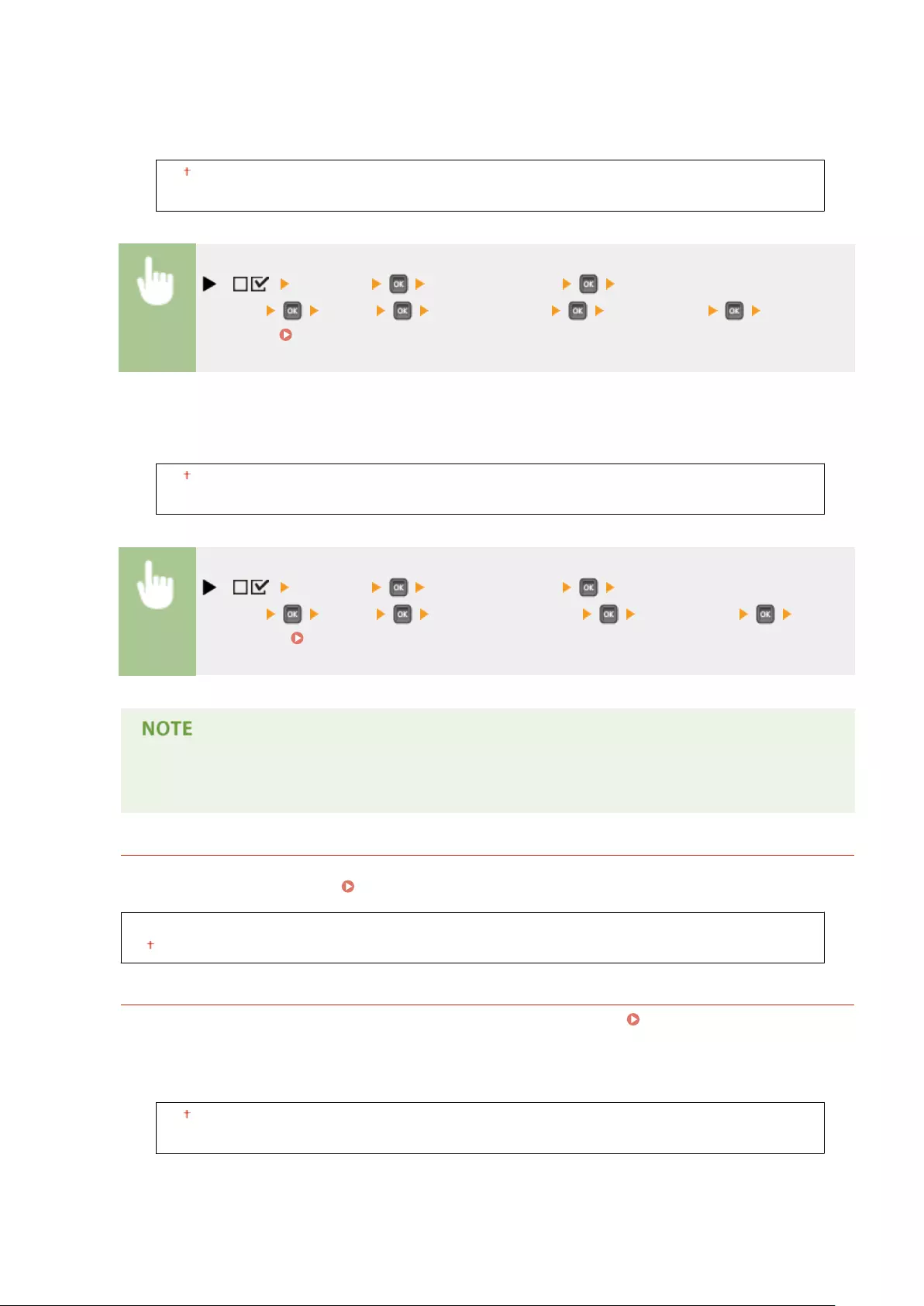
WSD Browsing *
Select whether to acquire information of the machine from a computer by using WSD. If <WSD Print> is set to
<On>, <WSD Browsing> is xed to <On> and is not displayed in the setting menu.
Off
On
( ) <Network> Check the message <TCP/IP
Settings> <WSD> <WSD Browsing> <Off> or <On> Perform a
hard reset ( Performing a Hard Reset(P. 451) )
Multicast Discovery
Select whether to set the machine to reply to multicast discovery messages.
Off
On
( ) <Network> Check the message <TCP/IP
Settings> <WSD> <Multicast Discovery> <Off> or <On> Perform
a hard reset ( Performing a Hard Reset(P. 451) )
●If <Multicast Discovery> is set to <Off>, the machine stays in sleep mode even when multicast
discovery messages are owing on the network.
HTTP
Enable or disable HTTP. HTTP is required for communications with a computer, such as when using the Remote
UI and performing WSD printing. Disabling HTTP Communication(P. 288)
Off
On
Proxy Settings
Specify settings for using the proxy server that relays HTTP communications. Setting a Proxy(P. 274)
Proxy
Enable or disable the proxy server when the machine performs HTTP communications.
Off
On
Setting Menu List
382

( ) <Network> Check the message <TCP/IP Settings> <Proxy
Settings> <Proxy> <Off> or <On> Perform a hard reset ( Performing a
Hard Reset(P. 451) )
Server Address *
Set the address of the proxy server to use. Specify the IP address, domain name, and other necessary
information that suit your operational environment. Use / to move the cursor, and use the numeric
keys to enter the address ( Entering Text(P. 31) ).
( ) <Network> Check the message <TCP/IP Settings> <Proxy
Settings> <Server Address> Enter the server address Perform a hard
reset ( Performing a Hard Reset(P. 451) )
Port Number *
Specify the port number of the proxy server to use.
1 to 80 to 65535
( ) <Network> Check the message <TCP/IP Settings> <Proxy
Settings> <Port Number> Enter the port number Perform a hard reset
( Performing a Hard Reset(P. 451) )
Same Domain *
Enable or disable the proxy server even for performing HTTP communications with devices in the same
domain.
Use Proxy
Do Not Use Proxy
( ) <Network> Check the message <TCP/IP Settings> <Proxy
Settings> <Same Domain> <Use Proxy> or <Do Not Use Proxy> Perform
a hard reset ( Performing a Hard Reset(P. 451) )
Proxy Authentication *
Enable or disable the authentication function of the proxy server.
Off
On
Setting Menu List
383

( ) <Network> Check the message <TCP/IP Settings> <Proxy
Settings> <Proxy Authentication> <Off> or <On> Perform a hard reset
( Performing a Hard Reset(P. 451) )
User Name *
To enable the proxy authentication, enter up to 24 alphanumeric characters for the user name to
authenticate. Use the numeric keys to enter the user name. ( Entering Text(P. 31) )
( ) <Network> Check the message <TCP/IP Settings> <Proxy
Settings> <User Name> Enter the user name Perform a hard reset (
Performing a Hard Reset(P. 451) )
Password *
To set the password for the proxy authentication, enter up to 24 alphanumeric characters. Use the numeric
keys to enter the password. ( Entering Text(P. 31) )
( ) <Network> Check the message <TCP/IP Settings> <Proxy
Settings> <Password> Enter the password Perform a hard reset (
Performing a Hard Reset(P. 451) )
SNTP
Select whether to acquire time from a network time server. Use the Remote UI to specify the server address
settings. Conguring SNTP(P. 229)
Off
On
( ) <Network> Check the message <TCP/IP
Settings> <SNTP> <Off> or <On> Perform a hard reset ( Performing a
Hard Reset(P. 451) )
Discovery Response
Select whether to set the machine to respond to multicast discovery packets on the network. Use the Remote UI
to specify the scope name that is used to include the machine into a specic scope. Conguring Settings for
Device Management Software(P. 238)
Off
On
Setting Menu List
384

( ) <Network> Check the message <TCP/IP
Settings> <Discovery Response> <Off> or <On> Perform a hard reset (
Performing a Hard Reset(P. 451) )
IPSec
Select whether to perform encrypted communication by establishing a virtual private network (VPN) via IPSec.
Use the Remote UI to register and specify the security policies. Conguring IPSec Settings(P. 298)
Off
On
( ) <Network> Check the message <TCP/IP
Settings> <IPSec> <Off> or <On> Perform a hard reset ( Performing a
Hard Reset(P. 451) )
Sleep Notif. Set.
Specify settings for SLP communication to notify imageWARE of the power status of the machine. If you set
<Sleep Mode Notif.> to <On>, you can expect the machine to avoid unnecessary communication during sleep
mode and reduce the total power consumption. Conguring Settings for Device Management
Software(P. 238)
Sleep Mode Notif.
Enable or disable SLP communication. If you select <On>, the power status of the machine is notied to
imageWARE.
Off
On
( ) <Network> Check the message <TCP/IP Settings> <Sleep
Notif. Set.> <Sleep Mode Notif.> <Off> or <On> Perform a hard reset (
Performing a Hard Reset(P. 451) )
Port Number *
Enter the port number for SLP communications with management software.
1 to 11427 to 65535
Setting Menu List
385
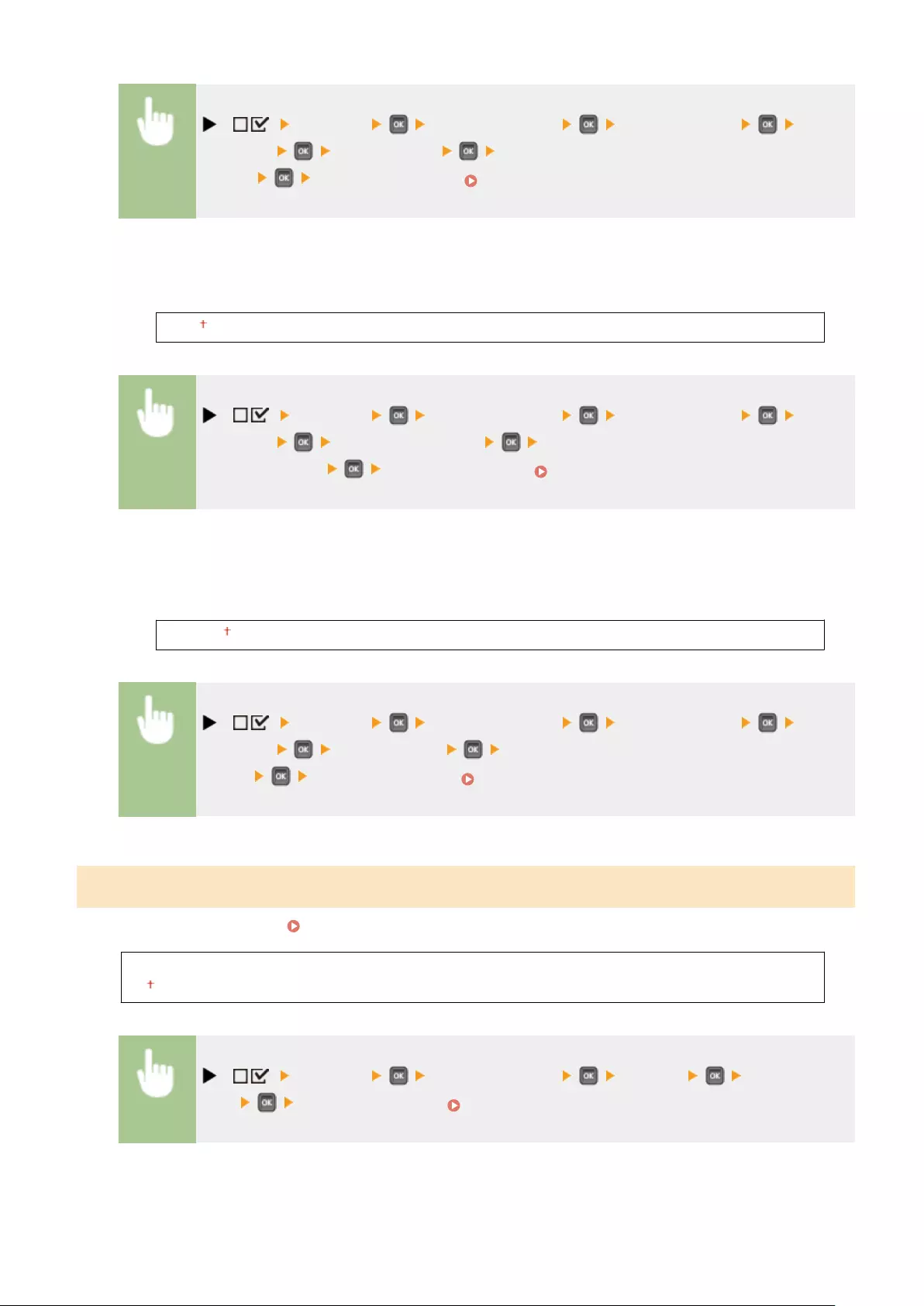
( ) <Network> Check the message <TCP/IP Settings> <Sleep
Notif. Set.> <Port Number> Use the numeric keys to enter the port
number Perform a hard reset ( Performing a Hard Reset(P. 451) )
Routers to Traverse *
Specify how many routers the notication packets can pass. Enter a number from 0 to 254.
0 to 3 to 254
( ) <Network> Check the message <TCP/IP Settings> <Sleep
Notif. Set.> <Routers to Traverse> Use the numeric keys to enter the number of
routers to traverse Perform a hard reset ( Performing a Hard Reset(P. 451) )
Notif. Interval *
Specify how often the machine noties imageWARE of its power status. Enter a number in seconds from 60 to
65535.
60 to 600 to 65535
( ) <Network> Check the message <TCP/IP Settings> <Sleep
Notif. Set.> <Notif. Interval> Use the numeric keys to enter the notication
interval Perform a hard reset ( Performing a Hard Reset(P. 451) )
Mopria
Select whether to use Mopria™. Printing with Mopria™(P. 167)
Off
On
( ) <Network> Check the message <Mopria> <Off> or
<On> Perform a hard reset ( Performing a Hard Reset(P. 451) )
Setting Menu List
386

Google Cloud Print
Enable or disable Google Cloud Print. Changing Google Cloud Print Settings(P. 176)
Use Cloud Print
Off
On
Registration Status
SMB *
Select whether to use the machine as a shared printer on the SMB network. Use the Remote UI to specify other SMB
settings including the server name and the workgroup name. Conguring SMB(P. 242)
SMB Server
Select whether to display the machine as an SMB Server on the SMB network conguration screen.
Off
On
( ) <Network> Check the message <SMB> <SMB
Server> <Off> or <On> Perform a hard reset ( Performing a Hard
Reset(P. 451) )
SMB Print *
Enable or disable SMB Print.
Off
On
( ) <Network> Check the message <SMB> <SMB
Print> <Off> or <On> Perform a hard reset ( Performing a Hard Reset(P. 451) )
SNMP Settings
Specify the settings for monitoring and controlling the machine from a computer running SNMP-compatible software.
Monitoring and Controlling the Machine with SNMP(P. 232)
SNMPv1 Settings
Specify settings for using SNMPv1. Use the Remote UI to specify a community name and access privileges to
Management Information Base (MIB) objects.
Setting Menu List
387

SNMPv1
Enable or disable SNMPv1.
Off
On
( ) <Network> Check the message <SNMP
Settings> <SNMPv1 Settings> <SNMPv1> <Off> or
<On> Perform a hard reset ( Performing a Hard Reset(P. 451) )
Dctd. Community Set.
Dedicated Community is a preset community, intended exclusively for administrators using Canon software,
such as imageWARE Enterprise Management Console. Select the access privilege to Management
Information Base (MIB) objects.
Dctd. Community
Off
Read/Write
Read Only
( ) <Network> Check the message <SNMP
Settings> <SNMPv1 Settings> <Dctd. Community Set.> <Dctd.
Community> Select the access privilege Perform a hard reset ( Performing a
Hard Reset(P. 451) )
SNMPv3 Settings
Specify settings for using SNMPv3. Use the Remote UI to specify detailed settings that are applied when
SNMPv3 is enabled.
SNMPv3
Enable or disable SNMPv3.
Off
On
( ) <Network> Check the message <SNMP Settings> <SNMPv3
Settings> <SNMPv3> <Off> or <On> Perform a hard reset (
Performing a Hard Reset(P. 451) )
Setting Menu List
388

User Settings N (N=1, 2, 3, 4, 5) *
Specify the authentication password and encryption password as the user information used on SNMPv3. Use
the Remote UI to register the user information. Monitoring and Controlling the Machine with
SNMP(P. 232)
Auth. Password /Encryption Password
Enter 6 to 16 alphanumeric characters for each password. Use the numeric keys to enter the password.
( ) <Network> Check the message <SNMP
Settings> <SNMPv3 Settings> Select the user settings number Check the
user name <Auth. Password> or <Encryption Password> Enter the
password Perform a hard reset ( Performing a Hard Reset(P. 451) )
Rjct Packet in Sleep
Select whether to discard SNMP packets received during sleep mode.
Off
On
( ) <Network> Check the message <SNMP Settings> <Rjct
Packet in Sleep> <Off> or <On> Perform a hard reset ( Performing a Hard
Reset(P. 451) )
●If you select <On>, applications that use the SNMP protocol, such as Canon software imageWARE
Series, may be disabled to access the machine.
Spooler *
Select whether to include the SD card in the storage locations of received print data. If you select <On>, the machine
capacity of receiving print data is increased.
Off
On
( ) <Network> Check the message <Spooler> <Off> or
<On> Perform a hard reset ( Performing a Hard Reset(P. 451) )
Setting Menu List
389

Receive in Parallel
Specify whether to print the received jobs in the order of reception when multiple print jobs are sent from multiple
computers or other devices. When you sequentially send multiple print jobs to the machine, you can print them
without being interrupted by print jobs sent from other computers or the like. To do so, set this item to <Off>.
Off
On
( ) <Network> Check the message <Receive in Parallel> <Off>
or <On> Perform a hard reset ( Performing a Hard Reset(P. 451) )
Wait Time at Startup
Specify a wait time for connecting to a network. Select the setting depending on the network environment. Setting a
Wait Time for Connecting to a Network(P. 219)
0 to 300 (sec.)
Remote UI Settings
Specify settings for using the Remote UI. You can use the Remote UI to specify settings for the machine from a Web
browser.
Remote UI
Enable or disable the Remote UI. Disabling Remote UI(P. 289)
Off
On
RUI Access Sec. Set.
Select whether to use a PIN to access the Remote UI. Setting a Remote UI PIN(P. 263)
Off
On
Remote UI Access PIN *
Specify so that entry of a PIN is required for access to the Remote UI when <RUI Access Sec. Set.> is set to <On>.
Set a PIN of up to 7 digits. All users use a common PIN. Setting a Remote UI PIN(P. 263)
TLS *
Enable or disable TLS for Remote UI communications. To use TLS for encrypted communications, you need to
set key pairs by using the Remote UI ( Using TLS for Encrypted Communications(P. 294) ), respectively.
Off
On
Setting Menu List
390

( ) <Network> Check the message <Remote UI
Settings> <TLS> <Off> or <On> Perform a hard reset ( Performing a
Hard Reset(P. 451) )
Ethernet Driver
Specify the Ethernet communication mode (half duplex/full duplex) and Ethernet type (10 Base-T/100 Base-TX/1000
Base-T). Conguring Ethernet Settings(P. 217)
Auto Detect
Select whether to automatically detect or manually select the communication mode and the Ethernet type.
Off
On
Communication Mode *
If <Auto Detect> is set to <Off>, select the Ethernet communication mode.
Half Duplex
Full Duplex
Ethernet Type *
If <Auto Detect> is set to <Off>, select the Ethernet type.
10 Base-T
100 Base-TX
1000 Base-T
Sleep Mode Priority
Select whether to give priority to rapid returning from sleep mode or greater energy saving effect of sleep mode.
Optimal Balance
Exit Speed
Energy Saving
( ) <Network> Check the message <Sleep Mode
Priority> Select the settings item Perform a hard reset ( Performing a Hard
Reset(P. 451) )
Setting Menu List
391
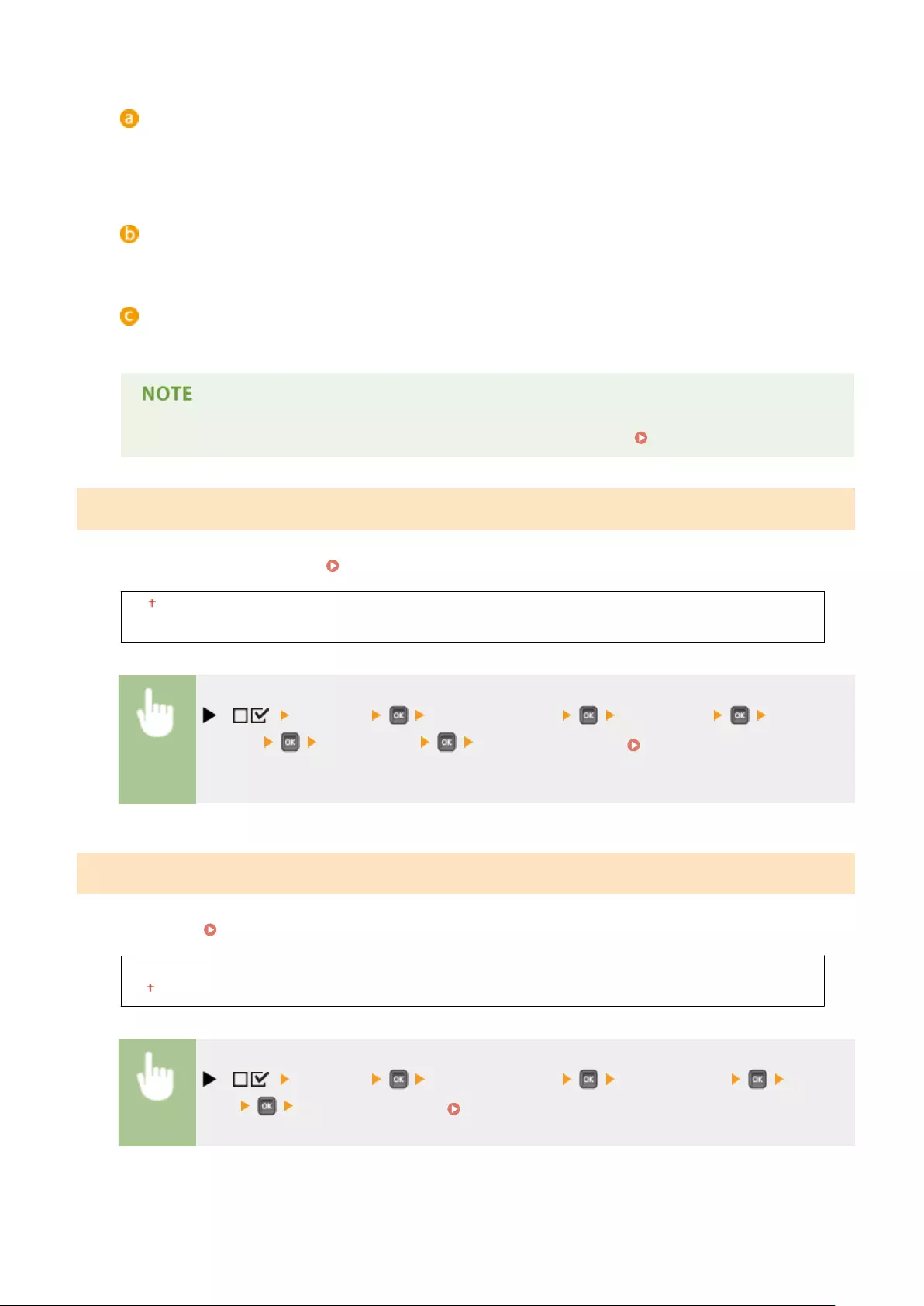
Optimal Balance
The machine returns from sleep mode rapidly. When the devices directly connected to the machine support
EEE (Energy Ecient Ethernet), power consumption can be reduced to a greater degree. Normally use this
setting.
Exit Speed
The machine returns from sleep mode more rapidly.
Energy Saving
Communication speed during sleep mode is reduced for lowest power consumption.
●This item is available when <Sleep Mode> is set to <High (Deep Sleep)>. Entering Sleep Mode(P. 68)
IEEE802.1X
Enable or disable IEEE 802.1X authentication. Use the Remote UI to specify detailed settings that are applied when
IEEE802.1X authentication is enabled. Conguring IEEE 802.1X Authentication(P. 309)
Off
On
( ) <Network> Check the message <IEEE802.1X> Check the
message <Off> or <On> Perform a hard reset ( Performing a Hard
Reset(P. 451) )
Address Filter
Enable or disable communication restricted with the IP address and MAC address. Use the Remote UI to specify the
address to restrict. Basic Printing Operations(P. 78)
Off
On
( ) <Network> Check the message <Address Filter> <Off> or
<On> Perform a hard reset ( Performing a Hard Reset(P. 451) )
Setting Menu List
392
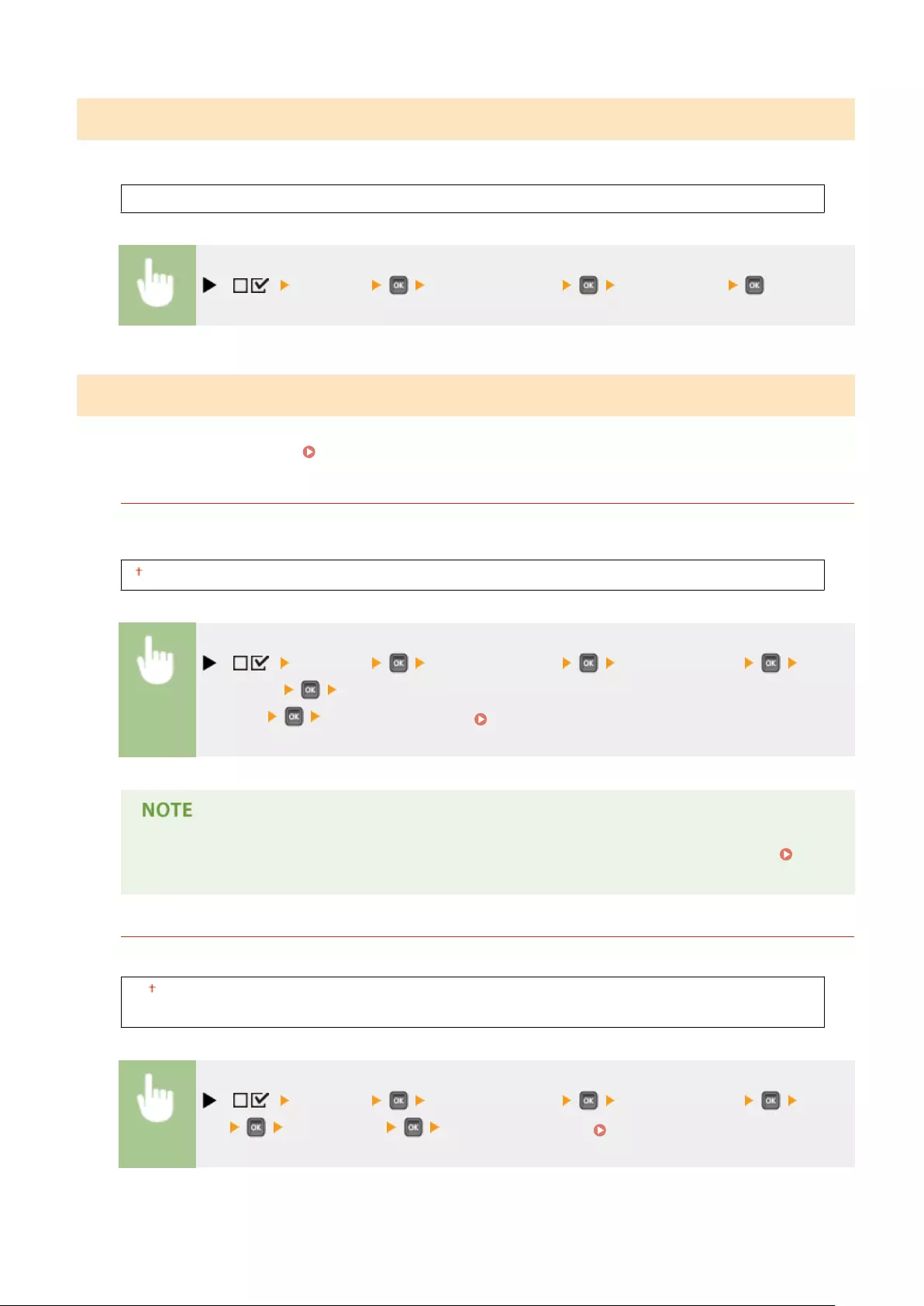
MAC Address
Check the MAC address of the machine, which is a number unique to each communication device.
(Display only)
( ) <Network> Check the message <MAC Address>
E-Mail Print Set.
Specify settings for using the E-Mail Print function. Use the Remote UI to specify other settings for E-Mail Print
including the mail server settings. Printing Received E-mail (E-Mail Print)(P. 157)
POP3 RX Interval
Specify the interval for automatically connecting to the mail server in minutes. New e-mails in the mailbox of the
mail server are automatically received and printed at the specied time intervals.
0 to 90 (min.)
( ) <Network> Check the message <E-Mail Print Set.> <POP3
RX Interval> Use the numeric keys to enter the interval of auto e-mail
reception Perform a hard reset ( Performing a Hard Reset(P. 451) )
●If you select "0," e-mails are not automatically received. In this case, receive e-mails manually.
Manually Receiving E-Mails(P. 162)
POP3 RX
Enable or disable E-Mail Print for the POP3 mail server.
Off
On
( ) <Network> Check the message <E-Mail Print Set.> <POP3
RX> <Off> or <On> Perform a hard reset ( Performing a Hard Reset(P. 451) )
Setting Menu List
393

SMTP RX
Enable or disable E-Mail Print for the SMTP protocol.
Off
On
( ) <Network> Check the message <E-Mail Print Set.> <SMTP
RX> <Off> or <On> Perform a hard reset ( Performing a Hard Reset(P. 451) )
Init. Network Set.
Select to return the Network Settings to the factory defaults. Initializing the Network Settings(P. 552)
Setting Menu List
394

Layout
0X7U-05A
The settings about print appearance including gutter margins and print positions
are listed with short descriptions. Default settings are marked with a dagger ( ).
Number of Copies(P. 395)
Offset Y/Offset X(P. 395)
Binding Location(P. 396)
Gutter(P. 397)
Alternative Method(P. 398)
Number of Copies
Specify the number of copies.
1 to 9999
( ) <Layout> <Number of Copies> Use the numeric keys to enter the
number of copies
Offset Y/Offset X
You can specify settings for shifting the print position for all types of printing in 0.5 mm increments regardless of the
paper source.
-50.0 to 0.0 to +50.0 (mm)
( ) <Layout> <Offset Y> or <Offset X> Use / to enter the offset
value
<Offset Y>
Shifts the print position vertically.
Setting Menu List
395

<Offset X>
Shifts the print position horizontally.
Offset values
For <Offset Y>, set a plus (+) value to shift the print position downward. For <Offset X>, set a plus (+) value to
shift the print position rightward. Set a minus (-) value to shift the print position in the opposite direction.
<Offset Y> <Offset X>
Specifying ne settings for the print position
You can select <Adj. Print Position> under <User Maintenance> to nely specify the print position for each paper
source. The range of available offset values is from -5.0 to +5.0 mm. Adjusting Print Position(P. 532)
Binding Location
Select whether to bind the long edge or short edge of the printouts with a binding tool such as a stapler. In this case,
specify settings for <Gutter> to adjust the binding margin, as well.
Long Edge
Short Edge
( ) <Layout> <Binding Location> <Long Edge> or <Short Edge>
<Long Edge>
Select to bind the printouts along the long edge.
<Short Edge>
Select to bind the printouts along the short edge.
Setting Menu List
396

Gutter
Adjust the margin width of the edge specied in <Binding Location> by shifting the print position of the print data. If
you select "0.0", the margin will not be changed.
-50.0 to 0.0 to +50.0 (mm)
( ) <Layout> <Gutter> Use / to enter the offset value
Margin values
Specify the direction and width for shifting the print position of the print data. The edge where the margin is
changed varies depending on whether a "+" or "-" value is set. You can adjust the margin width in 0.5 mm
increments.
Portrait-oriented document
Setting Value Long edge binding Short edge binding
"+" value Left end of paper
(for left binding)
Upper end of paper
(for top binding)
"-" value Right end of paper
(for right binding)
Lower end of paper
(for bottom binding)
Landscape-oriented document
Setting Value Long edge binding Short edge binding
"+" value Left end of paper
(for top binding)
Upper end of paper
(for right binding)
Setting Menu List
397

Setting Value Long edge binding Short edge binding
"-" value Right end of paper
(for bottom binding)
Upper end of paper
(for right binding)
Alternative Method
When you perform 2-sided printing of a document that consists of an odd number of pages, you can select whether to
process the last page in 1-sided printing mode. If you select <On>, the printing will be nished faster than the regular
2-sided printing.
Off
On
( ) <Layout> <Alternative Method> <Off> or <On>
When the printing of a document consisting of an even number of pages nishes in 1-
sided printing mode
In the following cases, the last page is processed in 1-sided printing mode even if the document consists of an
even number of pages.
●The last page is blank.
●The last page cannot be printed for a reason such as the paper size is not available for 2-sided printing.
When paper with preprinted logo is used
●If the last page is processed in 1-sided printing mode with <Alternative Method> to <On>, the orientation or
print side of the last page may not match those of other pages. In this case, set <Alternative Method> to
<Off>.
Setting Menu List
398

Print Quality
0X7U-05C
The settings about print quality including the resolution and toner density are listed
with short descriptions. Default settings are marked with a dagger ( ).
Asterisks (*)
●Settings marked with an asterisk (*) are not displayed depending on other settings.
Resolution(P. 399)
Image Renement(P. 400)
Toner Save(P. 400)
Density(P. 400)
Density (Fine Adj)(P. 400)
Halftones(P. 400)
Reduce Quality(P. 402)
Adj. Prt. Line Width(P. 402)
Resolution
Specify the resolution for processing print data.
600 dpi
1200 dpi
( ) <Print Quality> <Resolution> <600 dpi> or <1200 dpi>
<600 dpi>
This print mode is suitable for printing at a high speed.
<1200 dpi>
Edges of characters and graphics can be clearly reproduced at high resolution. This print mode is suitable for
printing data that contains many small characters.
Setting Menu List
399

Image Renement *
Enable or disable the smoothing mode in which the edges of characters and graphics are smoothly printed. <Image
Renement> is not displayed when <Resolution> is set to <1200 dpi>.
Off
On
( ) <Print Quality> <Image Renement> <Off> or <On>
Toner Save
Specify this setting when you want to check the nishing such as the layout before printing a large job, for example.
Since this printing mode saves toner, ne lines and portions with lighter print density may become blurred.
Off
On
( ) <Print Quality> <Toner Save> <Off> or <On>
Density *
Adjust the toner density to apply to printing. <Density> is not displayed when <Toner Save> is set to <On>.
Adjusting Print Density(P. 530)
-8 to 0 to +8
Density (Fine Adj) *
You can make ne adjustment of the toner density applied to printing separately for three different density areas.
<Density (Fine Adj)> is not displayed when <Toner Save> is set to <On>. Adjusting Print Density(P. 530)
-8 to 0 to +8
Halftones
You can select the printing method to reproduce halftones (the intermediate range between the lighter and darker
areas of an image). Halftones can be specied for each image data type in a single document.
Text
Resolution
Setting Menu List
400
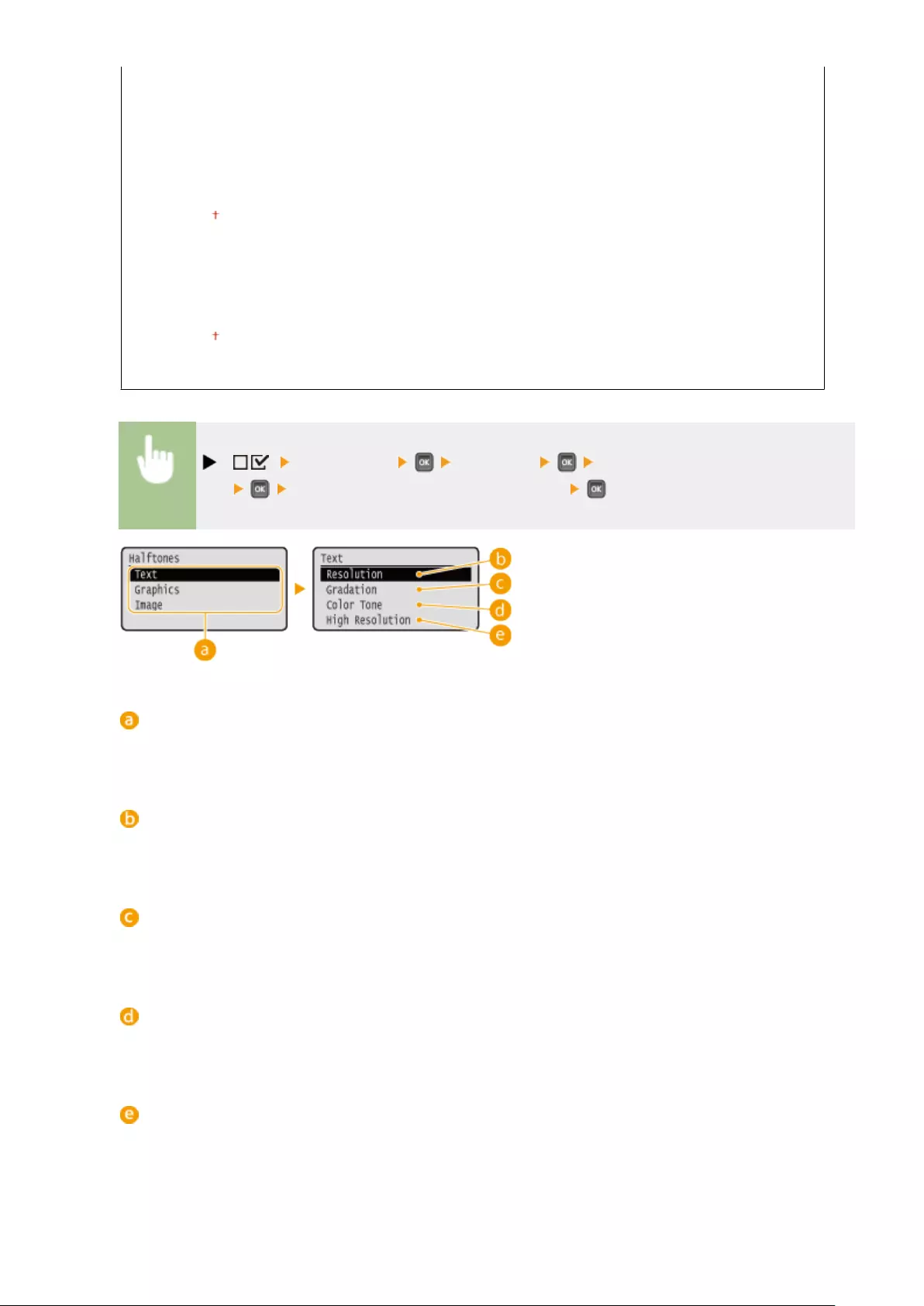
Gradation
Color Tone
High Resolution
Graphics
Resolution
Gradation
Color Tone
High Resolution
Image
Resolution
Gradation
Color Tone
High Resolution
( ) <Print Quality> <Halftones> Select the image data
type Select the method to reproduce halftones
Image data type
Select the image data type for which the settings are changed. Select <Text> for characters, <Graphics> for
lines and gures, or <Image> for images such as photos.
<Resolution>
Performs ne printing by sharply reproducing the edges of characters. This print mode is suitable for
printing data of characters and thin lines with a clear nish.
<Gradation>
Prints gradation and lines with a smooth nish. This print mode is suitable for printing gures and charts
with gradation.
<Color Tone>
Prints vivid images with a tonal contrast effect. This print mode is suitable for printing image data such as
photos.
<High Resolution>
Implements higher denition printing than the <Resolution> setting, but is slightly inferior in stability of
texture. This print mode is suitable for sharply printing edges of data such as characters, thin lines, and CAD
data.
Setting Menu List
401

Reduce Quality
Select whether to continue printing by automatically reducing the quality when insucient memory is available for the
processing.
Continue Printing
Stop Printing
( ) <Print Quality> <Reduce Quality> <Continue Printing> or <Stop
Printing>
●If you select <Stop Printing>, an error message is displayed and the printing is stopped when the machine
runs out of memory. You can press ( ) to resume the printing by reducing the quality.
Adj. Prt. Line Width
Adjust this if the printed text or thin lines are faded.
-7 to 0 to +8
( ) <Print Quality> <Adj. Prt. Line Width> Use / for print line
width adjustment.
Setting Menu List
402

Interface
0X7U-05E
All the settings about interfaces for communications with a computer and USB are
listed with short descriptions. Default settings are marked with a dagger ( ).
Asterisks (*)
●Settings marked with an asterisk (*) are not displayed depending on other settings.
Interface Selection(P. 403)
Timeout(P. 404)
Connection Recog.(P. 405)
Extended RX Buffer(P. 405)
Interface Selection
Select the interface used for the machine.
USB
Enable or disable the USB port. Restricting the USB Connection with a Computer(P. 282)
Off
On
Network
Enable or disable the LAN port. Disabling the LAN Port(P. 290)
Off
On
USB Adv. Functions
Specify settings for selecting a function to use a USB device or selecting a device driver to use.
Adv. Func. Settings
Select which of MEAP applications and USB over NW to be given priority when a USB device is connected to
the machine.
Meap Priority
USB Over NW Priority
Setting Menu List
403
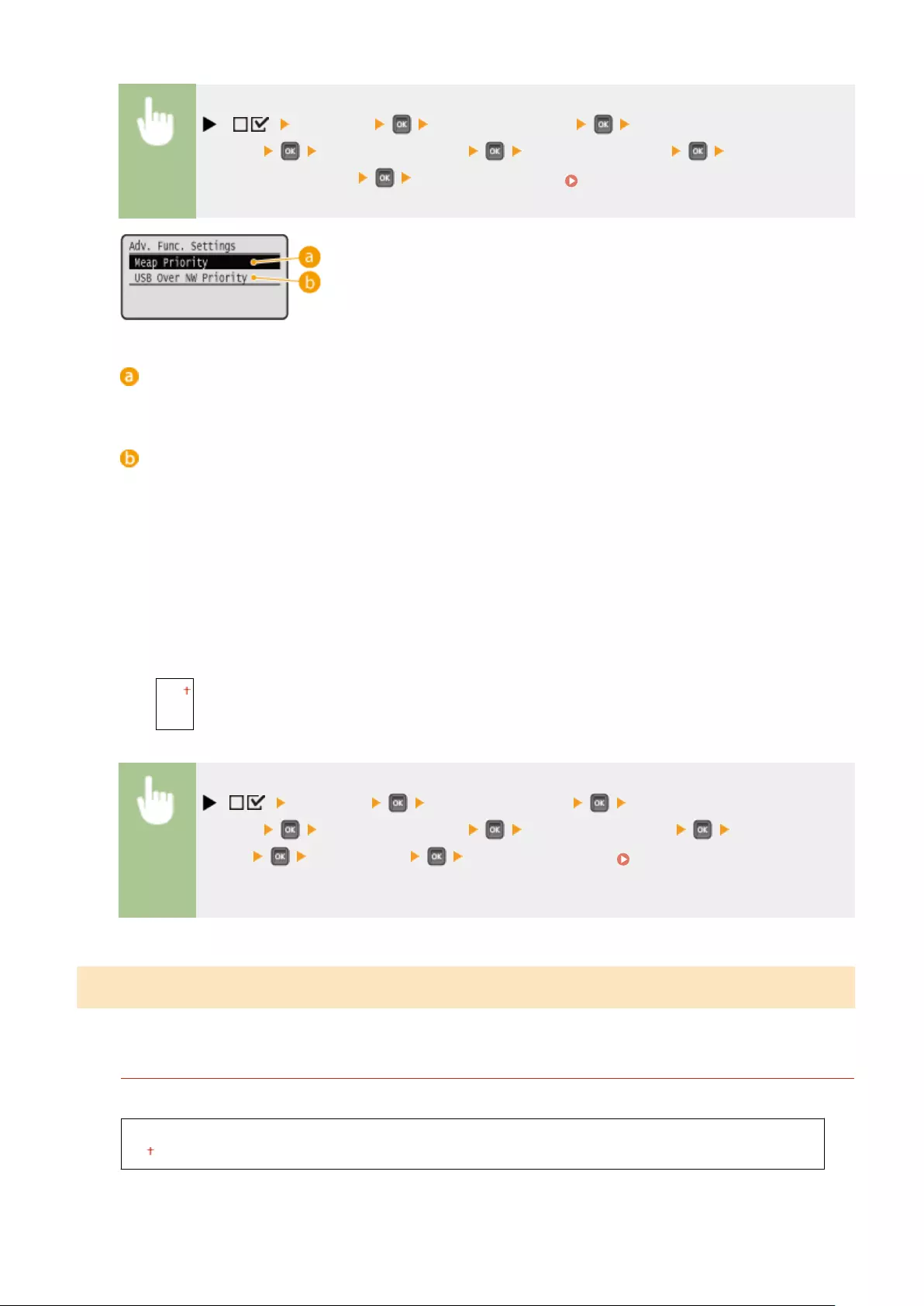
( ) <Interface> <Interface Selection> Check the
message <USB Adv. Functions> <Adv. Func. Settings> <Meap Priority> or
<USB Over NW Priority> Perform a hard reset ( Performing a Hard Reset(P. 451) )
<Meap Priority>
Specify this to give priority to MEAP applications.
<USB Over NW Priority>
Specify this to give priority to USB over NW. This function enables you to use, from your computer, a USB
device connected to the machine's USB port.
USB Storage Device
Specify settings for the device driver for using a USB memory device.
MEAP Driver
Enable or disable the MEAP specic device driver when a USB memory device is attached to the machine.
When you want to perform the direct print function (USB Direct Print) from a USB memory device without
using a computer, select <Off>.
Off
On
( ) <Interface> <Interface Selection> Check the
message <USB Adv. Functions> <USB Storage Device> <MEAP
Driver> <Off> or <On> Perform a hard reset ( Performing a Hard
Reset(P. 451) )
Timeout
Specify how the machine should behave if receiving print data is interrupted.
Timeout
Select whether to cancel printing if print data receiving is interrupted for a specied period of time.
Off
On
Setting Menu List
404

( ) <Interface> <Timeout> <Timeout> <Off> or <On>
Timeout Time *
Set the time period until a timeout error occurs.
5 to 15 to 300 (seconds)
( ) <Interface> <Timeout> <Timeout Time> Use the numeric
keys to set the time period
Connection Recog.
A problem such as improper overlay printing or garbled characters may occur during printing via wired LAN
connection. In this case, set <Connection Recog.> to <Off>.
Off
On
( ) <Interface> <Connection Recog.> Check the
message <Off> or <On> Perform a hard reset ( Performing a Hard
Reset(P. 451) )
Extended RX Buffer
Select whether to increase the space of the memory built in the machine for receiving print data from a computer. If
you select <On>, the time until the computer will be freed from print data processing or transmission can be reduced
when the computer sends a large volume of data or complicatedly structured data.
Off
On
( ) <Interface> <Extended RX Buffer> Check the
message <Off> or <On> Perform a hard reset ( Performing a Hard
Reset(P. 451) )
Setting Menu List
405
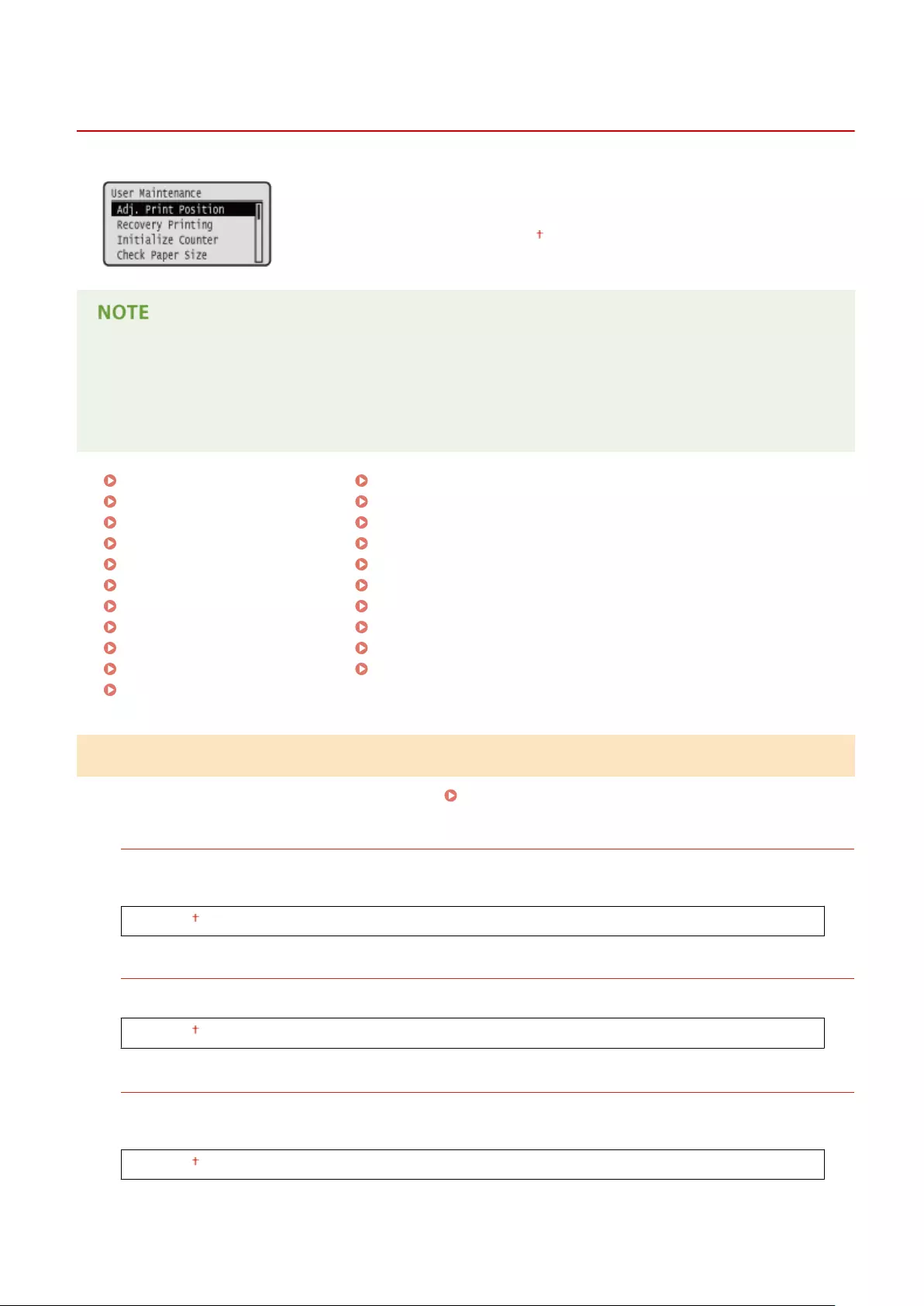
User Maintenance
0X7U-05F
The settings about adjustment of the machine including print position correction
for each paper source and print quality improvement are listed with short
descriptions. You can specify those settings when the machine is oine. Default
settings are marked with a dagger ( ).
Asterisks (*)
●Settings marked with an asterisk (*) are not displayed depending on other settings and whether the paper
feeder, paper deck, envelope feeder, or SD card (all of these being optional) is installed or not in the
machine.
Adj. Print Position(P. 406)
Recovery Printing(P. 407)
Initialize Counter(P. 407)
Check Paper Size(P. 407)
Substitute Size(P. 408)
Short Edge Fd. Prty.(P. 408)
Sp. Transfer Mode(P. 408)
Special Print Mode A(P. 409)
Special Density Mode(P. 409)
SD Card Maintenance(P. 410)
Special Print Mode(P. 410)
Special Print Adj. C(P. 410)
Barcode Adj. Mode(P. 411)
Update Firmware(P. 411)
Paper Feed Method(P. 412)
Show Job List(P. 412)
Import/Export Set.(P. 413)
Notify to Clean(P. 413)
Clean. Notif. Timing(P. 414)
Toner Check Timing(P. 414)
Spec Tnr Chk Timing(P. 414)
Adj. Print Position
You can adjust the print position for each paper source. Adjusting Print Position(P. 532)
Offset Y (Env. Tray)/Offset X (Env. Tray) *
You can adjust the vertical/horizontal print position for printing on envelopes fed from the optional envelope
feeder.
-5.0 to 0.0 to +5.0 (mm)
Offset Y (MP Tray)/Offset X (MP Tray)
You can adjust the vertical/horizontal print position for printing on paper from the multi-purpose tray.
-5.0 to 0.0 to +5.0 (mm)
Offset Y (Drawer 1 to 5)/Offset X (Drawer 1 to 5) *
You can adjust the vertical/horizontal print position for printing on paper fed from a paper drawer or the
optional paper deck.
-5.0 to 0.0 to +5.0 (mm)
Setting Menu List
406

Offset Y (2-Sided)/Offset X (2-Sided) *
You can adjust the vertical/horizontal print position for printing on the rst page (front side) in 2-sided printing
mode. The print position on the second page (back side) follows the settings for the paper source available
when the printing is started.
-5.0 to 0.0 to +5.0 (mm)
Recovery Printing
Select whether to print again the page of which printing was interrupted by a paper jam or an error.
Off
On
( ) <User Maintenance> <Recovery Printing> <Off> or <On>
Initialize Counter
Select whether to initialize the count of printed pages on the xing unit.
Fixing Unit
Initialize the count of pages using the same xing unit. You need to perform this operation each time you
replace the xing unit.
( ) <User Maintenance> <Initialize Counter> <Fixing
Unit> <Yes>
Check Paper Size
Select whether to check the size of paper that is fed from the paper source with the paper size set to <Free Size>. If you
select <On>, the message for conrming the paper size is displayed and the printing is stopped when the size of the
paper fed from the paper source does not match the print data.
Off
On
( ) <User Maintenance> <Check Paper Size> <Off> or <On>
Setting Menu List
407

●If the difference in size between the fed paper and the print data is not so large, it is possible that no
message will be displayed and the printing will be continued even when the selected setting is <On>.
Substitute Size
Select whether to print by substituting A4 size paper and Letter size paper with each other. If you select <On>, Letter
size paper is used for printing when you have specied A4 size paper for printing from a computer but the A4 size
paper is not loaded in the machine.
Off
On
( ) <User Maintenance> <Substitute Size> <Off> or <On>
Short Edge Fd. Prty.
When printing on paper of a size that allows for loading both in portrait and landscape orientations, set this item to
<On> if you want the paper in portrait orientation to be fed preferentially. This setting applies only when <Paper
Source> to <Auto>.
Off
On
( ) <User Maintenance> <Short Edge Fd. Prty.> <Off> or <On>
Sp. Transfer Mode
When you use the machine in an environment with low humidity, printed images or text may be smudged. In this case,
setting this item to <On> may solve the problem.
Off
On
( ) <User Maintenance> <Sp. Transfer Mode> <Off> or <On>
Setting Menu List
408

●When you set this item to <On> and use the machine in an environment with high humidity, the print
density may become lighter or uneven.
Special Print Mode A
Streaks may appear on printouts depending on the paper type or the environmental conditions. In this case, setting
this item may solve the problem. The improvement effect is weakest with <Mode 1> and strongest with <Mode 4>.
Off
Mode 1
Mode 2
Mode 3
Mode 4
( ) <User Maintenance> <Special Print Mode A> Select the mode
●This item cannot be set when <Barcode Adj. Mode> is set to one of <Mode 1> to <Mode 4>. Barcode Adj.
Mode(P. 411)
●If you select <Mode 3> or <Mode 4>, the print speed will be slower.
●As the improvement effect is increased, the print density becomes lighter. In addition, the edges may be
blurred or roughness may be slightly emphasized.
Special Density Mode
When you use the machine in an environment with high humidity, the print density may become lighter or uneven. In
this case, setting this item to <On> may solve the problem.
Off
On
( ) <User Maintenance> <Special Density Mode> <Off> or <On>
●When you set this item to <On> and use the machine in an environment with low humidity, printed images
or text may be smudged.
Setting Menu List
409

SD Card Maintenance *
When an error occurs in an SD card or when you want to discard an SD card, you can erase all the data stored on that
card.
Format
Initializes the SD card. All the stored data is erased from the card.
( ) <User Maintenance> <SD Card
Maintenance> <Format> <Yes>
Completely Del. Data
All the stored data is erased from the SD card. Perform this operation as necessary, such as when you want to
discard an SD card after erasing all the stored data including those fragments that cannot be erased normally.
Deleting All Data in an SD Card(P. 585)
Special Print Mode
Provides items you can set when printing cannot be performed properly.
Reduce Ppr. Sticking
In 2-sided printing, printed paper may stick to each other depending on the image density of print data. In this
case, setting this item may solve the problem. However, the printing speed may be slower.
Off
On
( ) <User Maintenance> <Special Print Mode> <Reduce Ppr.
Sticking> <Off> or <On>
Special Print Adj. C
Set this item to <On> when printing noise is noticeable.
Off
On
( ) <User Maintenance> <Special Print Adj. C> <Off> or <On>
Setting Menu List
410

●If you set this item to <On>, the printing speed becomes slower.
Barcode Adj. Mode
Specify this setting when a printed barcode cannot be correctly read. The improvement effect becomes greater as the
mode number shown below becomes larger.
Off
Mode 1
Mode 2
Mode 3
Mode 4
( ) <User Maintenance> <Barcode Adj. Mode> Select the mode
●Print density will be lighter when you select stronger improvement.
●When printing from the computer, the setting in the printer driver takes precedence. When the setting of
[Graphics Mode] in the printer driver is changed to [UFR II Mode] and [Barcode Adjustment Mode] is
changed to [Printer Default], the setting in the operation panel takes precedence.
●When you set this item to one of <Mode 1> to <Mode 4>, <Special Print Mode A> is automatically set to
<Off>.
●If you select <Mode 4>, the print speed will be slower.
Update Firmware
Upgrades the rmware of the machine.
( ) <User Maintenance> <Update Firmware> Select the connection
method <Yes>
Connection method selection
Select the method to connect a computer that performs the rmware update.
Setting Menu List
411

Paper Feed Method
Specify this setting when you print a document on paper with logos. To print on paper with logos, you need to change
how the paper loaded in the paper source is facing depending on whether you are performing 1- or 2-sided printing.
However, if you change the setting to <Print Side Priority>, you can just load the paper face down for both 1- and 2-
sided printing. For more information, see Loading Preprinted Paper(P. 55) .
Speed Priority
Print Side Priority
( ) <User Maintenance> <Paper Feed Method> Select the paper
source <Speed Priority> or <Print Side Priority>
Paper source selection
Select the paper source for which you want to change the setting of Paper Feed Mode.
<Speed Priority>
When using paper that has been preprinted with a logo, you need to change which side is up depending on
1-sided or 2-sided printing.
●We recommend selecting <Speed Priority> if you do not need to consider which side to print on.
<Print Side Priority>
To print on a specic side of paper, you do not need to ip over paper in the paper source regardless of
whether 1- or 2-sided printing is selected.
●Even if <Print Side Priority> is selected for the paper source ( Paper(P. 569) ), it is disabled and the
machine operates in the same way as when <Speed Priority> is selected. In this case, load the paper in the
same way as when <Speed Priority> is selected ( Loading Preprinted Paper(P. 55) ).
●If you select <Print Side Priority>, 1-sided printing speed will be slower.
Show Job List
Select whether to display a list of data that is being printed and waiting to be printed when you press ( ) on
the operation panel.
Off
Setting Menu List
412

On
( ) <User Maintenance> <Show Job List> <Off> or <On>
●If you press ( ) when <Off> is selected, the current print job in progress is canceled.
Import/Export Set.
You can transfer and save the data registered in the machine and the setting data of the menu options to the USB
memory device attached to the machine. The exported data can be imported. If the machine model is the same, other
machines can import the data exported from this machine and vice versa.
IMPORT
You can import data that was written to a USB memory device from the machine.
( ) <User Maintenance> <Import/Export
Set.> <IMPORT> <Yes> Select the le to be imported Enter the
password Check the message
EXPORT
You can save the data registered in the machine and the setting data of the menu options to a USB memory
device.
( ) <User Maintenance> <Import/Export
Set.> <EXPORT> Enter the password Password (Conrm) Check
the message
●For these purposes, you can only use the USB port provided on the right side of the machine.
Notify to Clean
Select whether to display a message that prompts you to clean the xing unit.
Off
Setting Menu List
413

On
( ) <User Maintenance> <Notify to Clean> <Off> or <On>
Clean. Notif. Timing *
When you have set <Notify to Clean> to <On>, you can specify the timing to display a prompt message for cleaning the
xing unit, in terms of the number of printed pages and in units of 1,000. The Conguration Page allows you to check
how many pages you can print before the prompt message is displayed. ( Conguration Page(P. 536) )
1000 to 50000
( ) <User Maintenance> <Clean. Notif. Timing> Enter the number of
printed pages
Toner Check Timing
To change the timing to display a message when the toner remaining amount is low, select <Custom>.
Default
Custom
( ) <User Maintenance> <Toner Check Timing> <Default> or
<Custom>
Spec Tnr Chk Timing *
When you have set <Toner Check Timing> to <Custom>, specify the timing to display the message.
1 to 20 to 99 (%)
( ) <User Maintenance> <Spec Tnr Chk Timing> Use the numeric keys
to enter the toner cartridge remaining amount
Setting Menu List
414
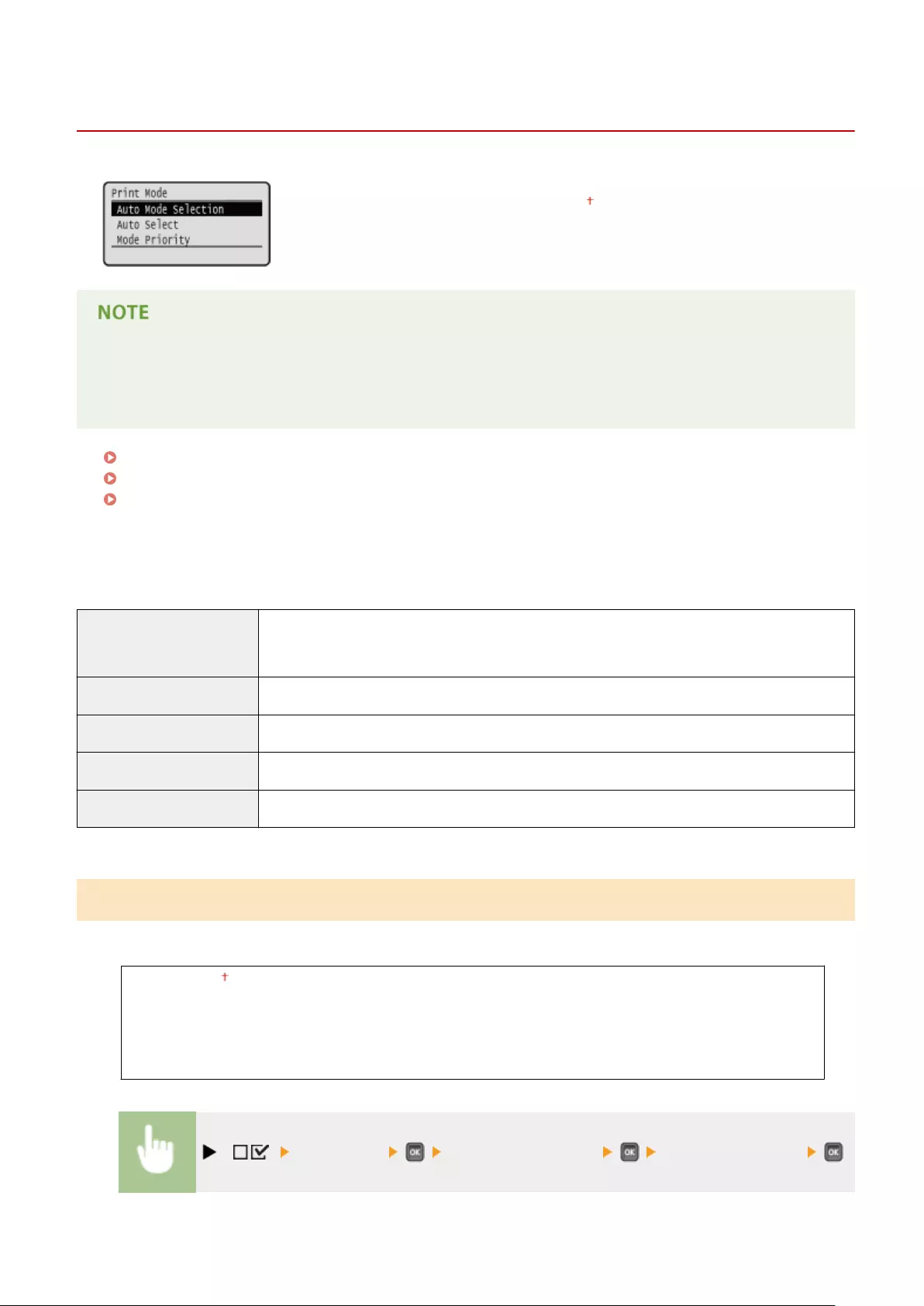
Print Mode
0X7U-05H
All the settings about print mode switching are listed with short descriptions.
Default settings are marked with a dagger ( ).
Asterisks (*)
●Settings marked with an asterisk (*) are not displayed depending on other settings or whether an optional
ROM is installed on the machine.
Auto Mode Selection(P. 415)
Auto Select(P. 416)
Mode Priority(P. 416)
◼Type of Print Mode
Auto selection mode The machine enters the auto selection mode when <Auto Selection> is selected for <Auto Mode
Selection>. The machine automatically discriminates data sent from a computer and selects the
print mode. Normally use this print mode when you print from an application.
<PCL> Mode for printing a PCL le sent from a computer.
<PS> Mode for printing a PS le sent from a computer.
<PDF> Mode for printing a PDF le by using Direct Print or USB Direct Print.
<XPS> Mode for printing an XPS le by using Direct Print or USB Direct Print.
Auto Mode Selection
Specify the print mode in which the machine operates.
Auto Selection
PCL
PS
PDF
XPS
( ) <Print Mode> <Auto Mode Selection> Select the print mode
Setting Menu List
415

Auto Select
Enable or disable the automatic mode selection feature for the print modes during auto selection mode.
Off
On
( ) <Print Mode> <Auto Select> Select the print mode <Off>
or <On>
●If all print modes are set to <Off>, the machine operates in the print mode specied for <Mode Priority>.
Mode Priority
Specify the print mode that is automatically selected when the machine cannot identify the control command during
auto selection mode.
None
PCL
PS
PDF
XPS
( ) <Print Mode> <Mode Priority> Select the preferential print
mode
●If you select <None>, the machine automatically determines the print mode when it cannot identify the
control command.
Setting Menu List
416

UFR II
0X7U-05K
This section describes the settings available during use of UFR II with the control
commands. Default settings are marked with a dagger ( ).
Paper Save
Select whether to prevent blank pages from being output when they are contained in documents to print.
Off
On
( ) <UFR II> <Paper Save> <Off> or <On>
Setting Menu List
418

PCL
0X7U-05L
All the settings about the PCL control commands are listed with short descriptions.
Default settings are marked with a dagger ( ).
Asterisks (*)
●Settings marked with an asterisk (*) are not displayed depending on other settings or whether the optional
ROM is installed on the machine.
Paper Save(P. 419)
Orientation(P. 419)
Font Number(P. 420)
Point Size(P. 420)
Pitch(P. 420)
Form Lines(P. 420)
Character Code(P. 421)
Custom Size(P. 422)
Unit of Measurement(P. 422)
X Dimension(P. 422)
Y Dimension(P. 423)
Append CR to LF(P. 423)
Enlarge A4 Prt Width(P. 423)
BarDIMM(P. 424)
FreeScape(P. 424)
Paper Save
Species whether the machine outputs the blank page that can be created due to no data existing between two form
feed codes sent from an application.
Off
On
( ) <PCL> <Paper Save> <Off> or <On>
Orientation
Enables you to set the paper orientation.
Portrait
Landscape
( ) <PCL> <Orientation> <Portrait> or <Landscape>
Setting Menu List
419

Font Number
Enables you to set the default font for this machine function using the corresponding font numbers. Valid font
numbers are from 0 to 104.
0 to 104
( ) <PCL> <Font Number> Use the numeric keys to enter the port
number
Point Size *
If the number selected in <Font Number> is that of a proportionally spaced scalable font, this option appears in the
<PCL> options. It enables you to specify a point size for the default font. The point size can be adjusted in increments
of 0.25 pts.
4.00 to 12.00 to 999.75 point
( ) <PCL> <Point Size> Use the numeric keys to enter the setting
value
Pitch *
If the number selected in <Font Number> is that of a xed pitch scalable font, <Pitch> appears in the <PCL> options. It
enables you to specify the pitch for the default font. The pitch can be adjusted in increments of 0.01 cpi (characters per
inch).
0.44 to 10.00 to 99.99 cpi
( ) <PCL> <Pitch> Use the numeric keys to enter the setting
value
Form Lines
Enables you to specify the number of lines to be printed on a page. You can specify from 5 to 128 lines.
5 to 64 to 128 lines
Setting Menu List
420
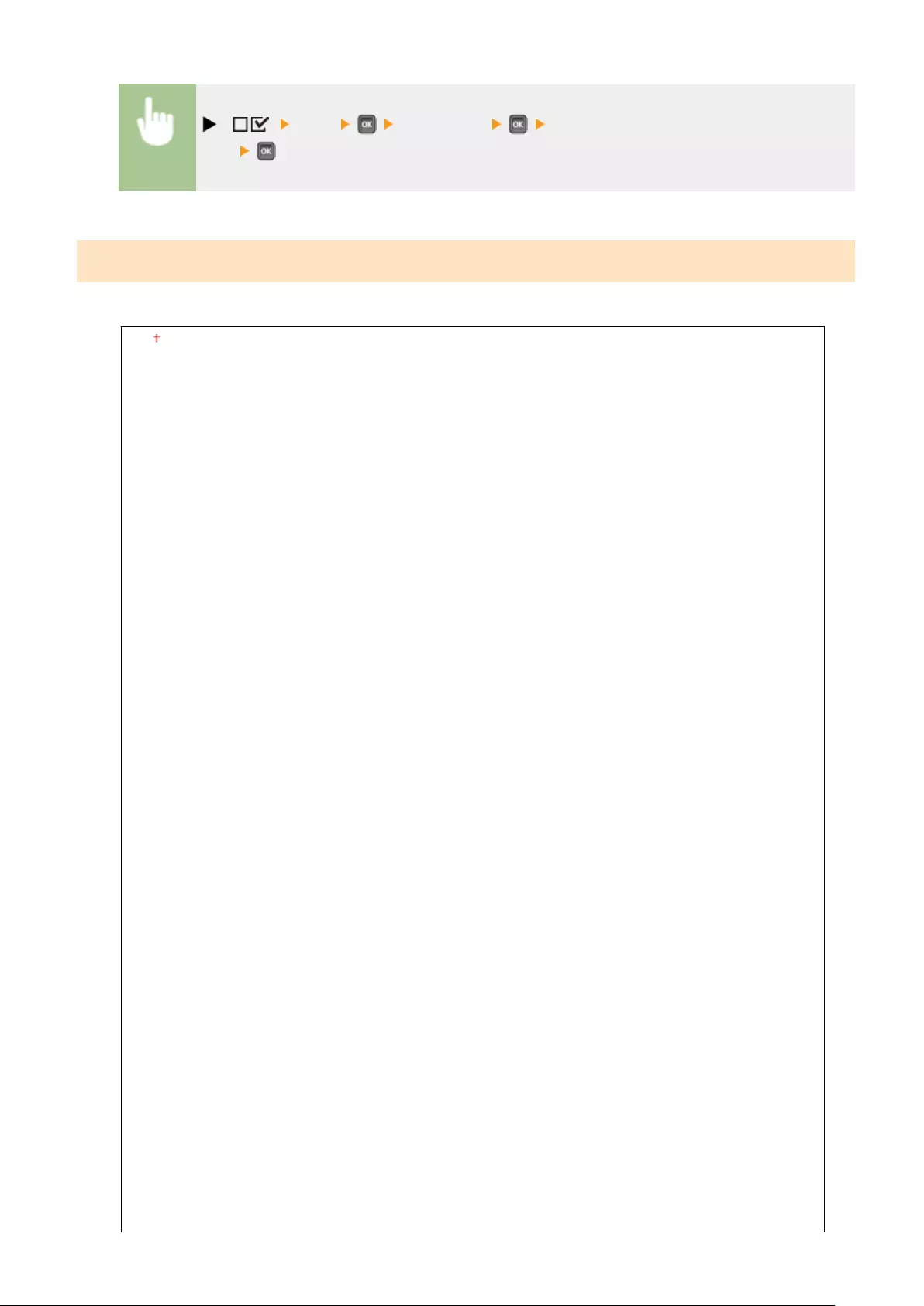
( ) <PCL> <Form Lines> Use the numeric keys to enter the setting
value
Character Code
Enables you to select the symbol set most suited to the needs of the host computer.
PC8
ROMAN8
ROMAN9
ISOL1
ISOL2
ISOL5
ISOL6
ISOL9
PC775
PC8DN
PC850
PC852
PC858
PC8TK
PC1004
WINL1
WINL2
WINL5
WINBALT
DESKTOP
PSTEXT
LEGAL
ISO4
ISO6
ISO11
ISO15
ISO17
ISO21
ISO60
ISO69
WIN 30
MCTEXT
PC864
ARABIC8
WINARB
PC866
ISOCYR
WINCYR
PC851
GREEK8
ISOGRK
PC8GRK
WINGRK
Setting Menu List
421

PC862
HEBREW7
HEBREW8
ISOHEB
( ) <PCL> <Character Code> Select the character code
Custom Size
Enables you to specify a custom paper size. If <Set> is selected, you can enter a custom size.
Do Not Set
Set
( ) <PCL> <Custom Size> <Set> or <Do Not Set>
Unit of Measurement *
Enables you to specify the unit of measurement you would like to use to specify your custom paper size.
Millimeters
Inches
( ) <PCL> <Unit of Measurement> <Millimeters> or <Inches>
X Dimension *
Enables you to specify the X dimension of the custom paper. The X dimension can be adjusted between 76.2 mm and
215.9 mm in increments of 0.1 mm.
76.2 to 215.9 mm
( ) <PCL> <X Dimension> Use the numeric keys to enter the setting
value
Setting Menu List
422

Y Dimension *
Enables you to specify the Y dimension of the custom paper. The Y dimension can be adjusted between 127.0 mm and
355.6 mm in increments of 0.1 mm.
127.0 to 355.6 mm
( ) <PCL> <Y Dimension> Use the numeric keys to enter the setting
value
Append CR to LF
Enables you to specify whether to append a carriage return (CR) when line feed code (LF) is received.
Yes
No
( ) <PCL> <Append CR to LF> <Yes> or <No>
Enlarge A4 Prt Width
Determines whether to expand the printable area of A4 paper to that of Letter size in width.
Off
On
( ) <PCL> <Enlarge A4 Prt Width> <Off> or <On>
Setting Menu List
423

BarDIMM *
You can enable or disable the Bar Code Printing function of the machine.
Enable
Disable
( ) <PCL> <BarDIMM> <Enable> or <Disable>
FreeScape *
You can specify the AEC (Alternate Escape Code) to be used for bar code commands when the host computer does not
support the standard Escape Code.
Off
~
"
#
$
/
\
?
{
}
|
( ) <PCL> <FreeScape> Select Escape Code
Setting Menu List
424
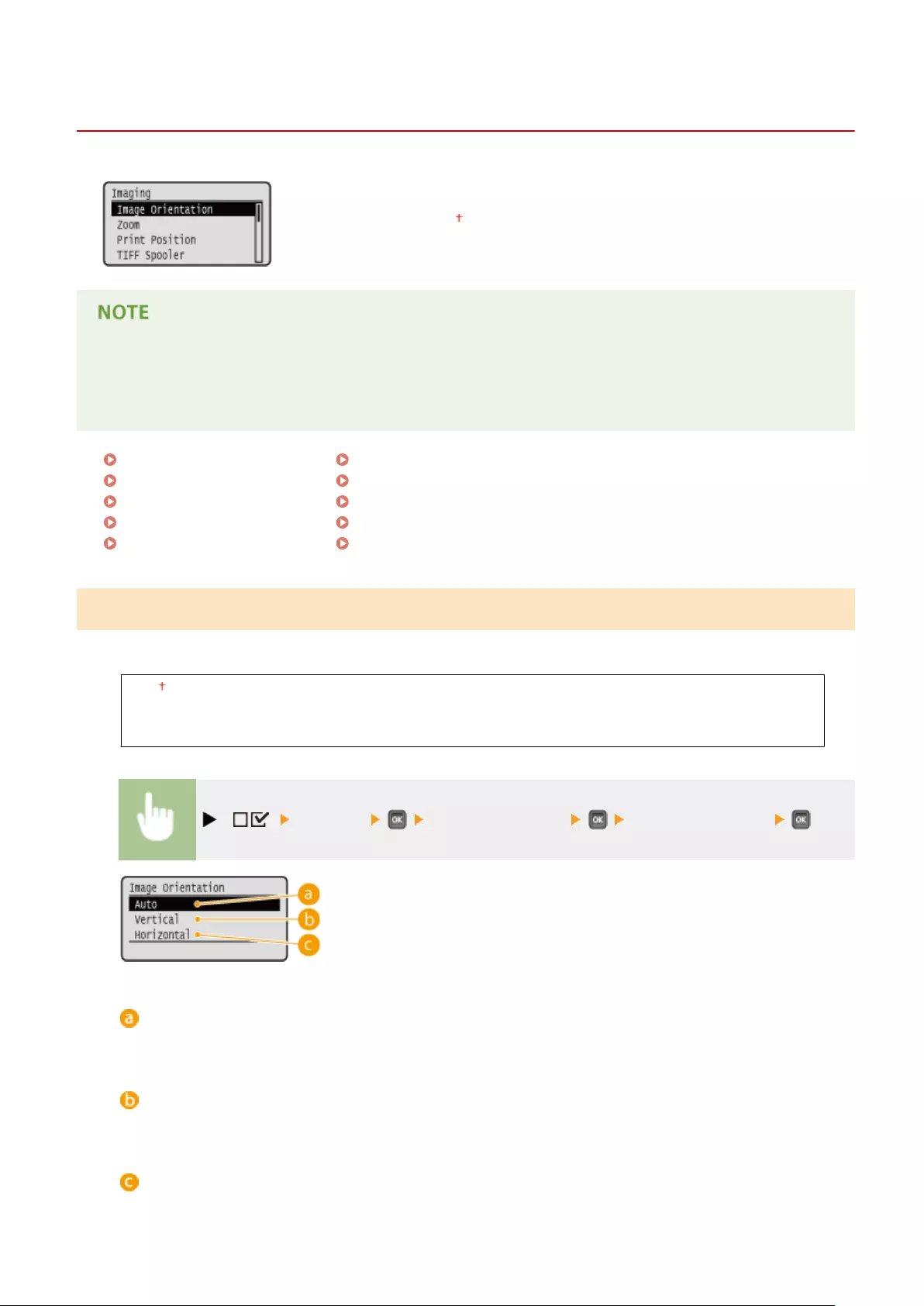
Imaging
0X7U-05R
All the settings about image les (JPEG and TIFF les) available for USB Direct Print,
Direct Print, and E-Mail Print are listed with short descriptions. Default settings are
marked with a dagger ( ).
Asterisks (*)
●Settings marked with an asterisk (*) are not displayed depending on other settings or whether an optional
SD card is installed on the machine.
Image Orientation(P. 425)
Zoom(P. 426)
Print Position(P. 426)
TIFF Spooler(P. 427)
Show Warnings(P. 427)
Print E-Mail Text(P. 428)
Limit E-Mail Print(P. 428)
Enlarge Print Area(P. 429)
Halftones(P. 429)
Grayscale Conversion(P. 430)
Image Orientation
Specify the print orientation of an image.
Auto
Vertical
Horizontal
( ) <Imaging> <Image Orientation> Select the orientation
<Auto>
Automatically determines the print orientation based on the width and height of the image.
<Vertical>
Select when printing a vertically-long image.
<Horizontal>
Select when printing a horizontally-long image.
Setting Menu List
425
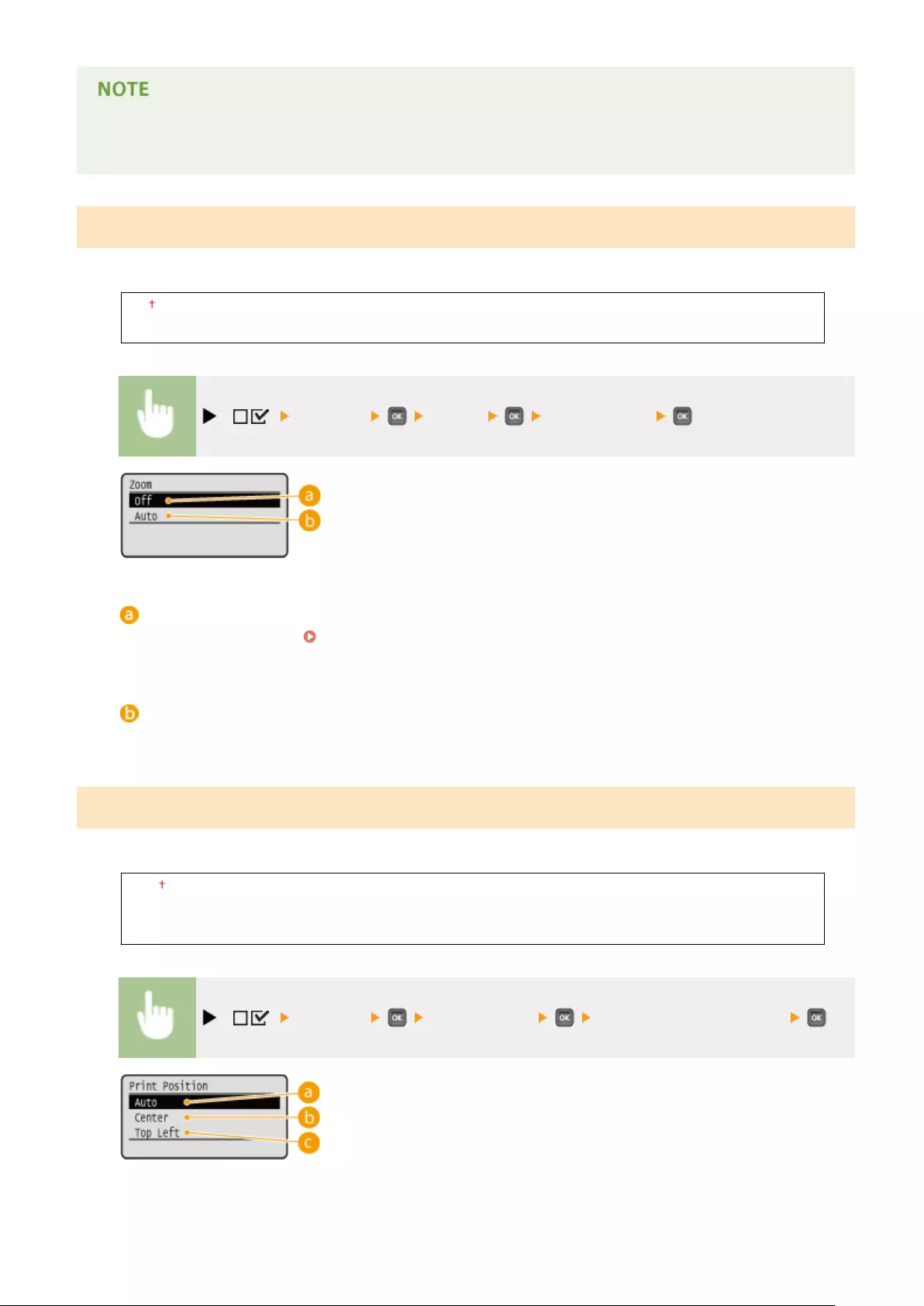
●If the specied setting (<Vertical> or <Horizontal>) does not match the orientation of the image, the image is
printed at a reduced size.
Zoom
Enable or disable enlarging/reducing images. The printouts are enlarged or reduced with the image aspect ratio kept.
Off
Auto
( ) <Imaging> <Zoom> <Off> or <Auto>
<Off>
When an image is within Printable Area(P. 572) , it is printed at the original size. When an image is larger
than the printable area, printouts are reduced.
<Auto>
Makes enlarged or reduced printouts according to the printable area of the paper.
Print Position
Specify the position to print the image.
Auto
Center
Top Left
( ) <Imaging> <Print Position> Select <Auto> or the position
Setting Menu List
426
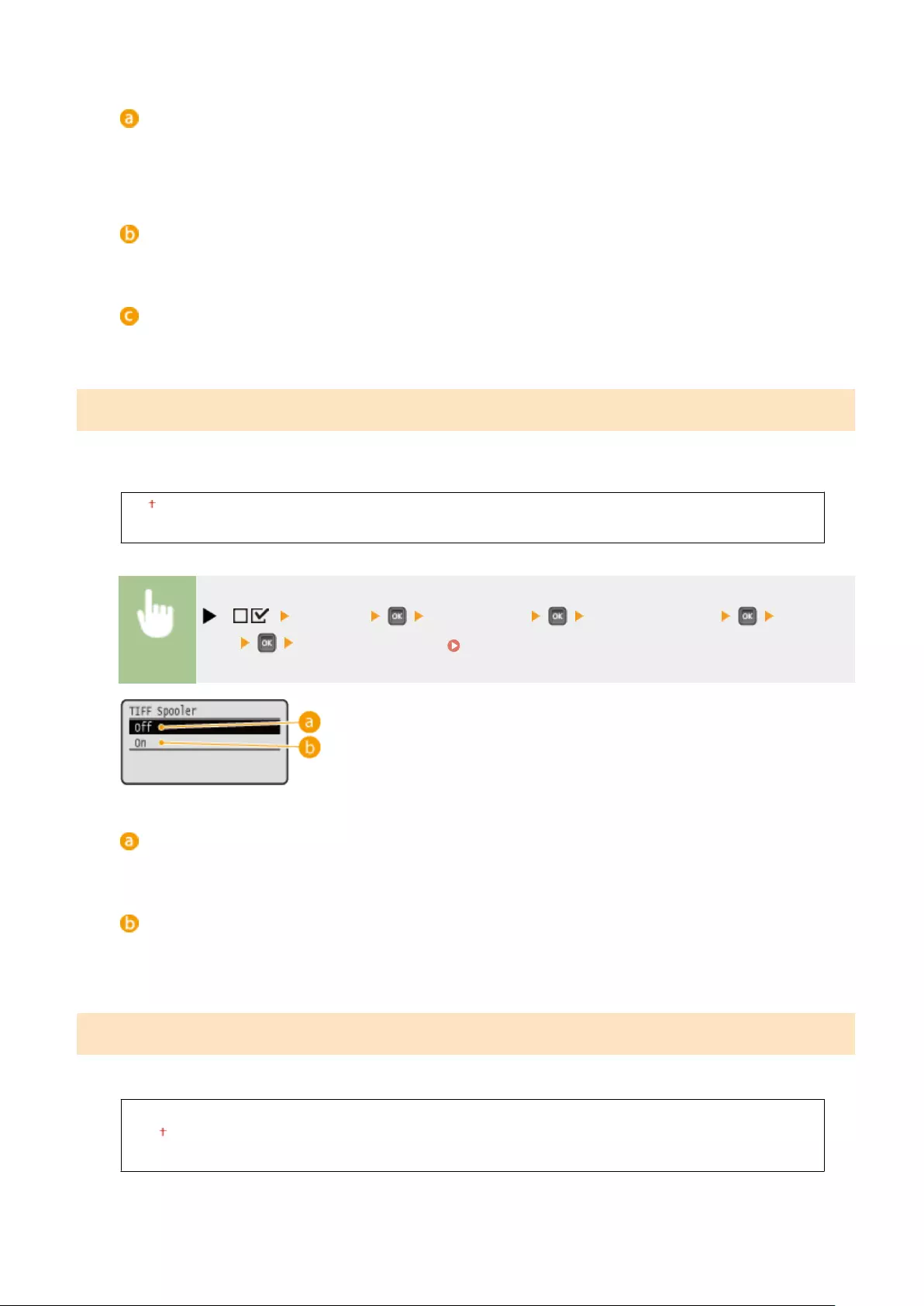
<Auto>
If the TIFF data contains the information that species the print position, the image is printed according to
the information, otherwise, it is printed at the center of paper. JPEG data is always printed at the center of
paper.
<Center>
Images are printed at the center of paper.
<Top Left>
Images are printed at the top left.
TIFF Spooler
Select whether to store TIFF data in the SD card prior to processing it for printing. Set this item to <On> if an error
occurs during printing.
Off
On
( ) <Imaging> <TIFF Spooler> Check the message <Off> or
<On> Perform a hard reset ( Performing a Hard Reset(P. 451) )
<Off>
TIFF data is continuously processed as soon as it is received, reducing the processing time.
<On>
All of received TIFF data is processed at one time, reducing the occurrence of errors. When an SD card is
installed, the data is stored to the SD card.
Show Warnings
You can specify how the machine should behave if an error occurs.
Off
Print
Panel
Setting Menu List
427

( ) <Imaging> <Show Warnings> Select how the machine should
behave
<Off>
No image is printed and no error is displayed.
<Print>
Error information is printed and no image is printed.
<Panel>
No image is printed and an error message is displayed on the operation panel.
Print E-Mail Text
Select whether to print e-mail messages when E-Mail Print is performed. If you select <Off>, only an image attached to
the e-mail is printed.
Off
On
( ) <Imaging> <Print E-Mail Text> <Off> or <On>
Limit E-Mail Print *
Select whether to limit the number of e-mail message pages to print when <Print E-Mail Text> is set to <On>. If you
select <On>, the number of e-mail message pages to print is limited to 5.
Off
On
( ) <Imaging> <Limit E-Mail Print> <Off> or <On>
Setting Menu List
428
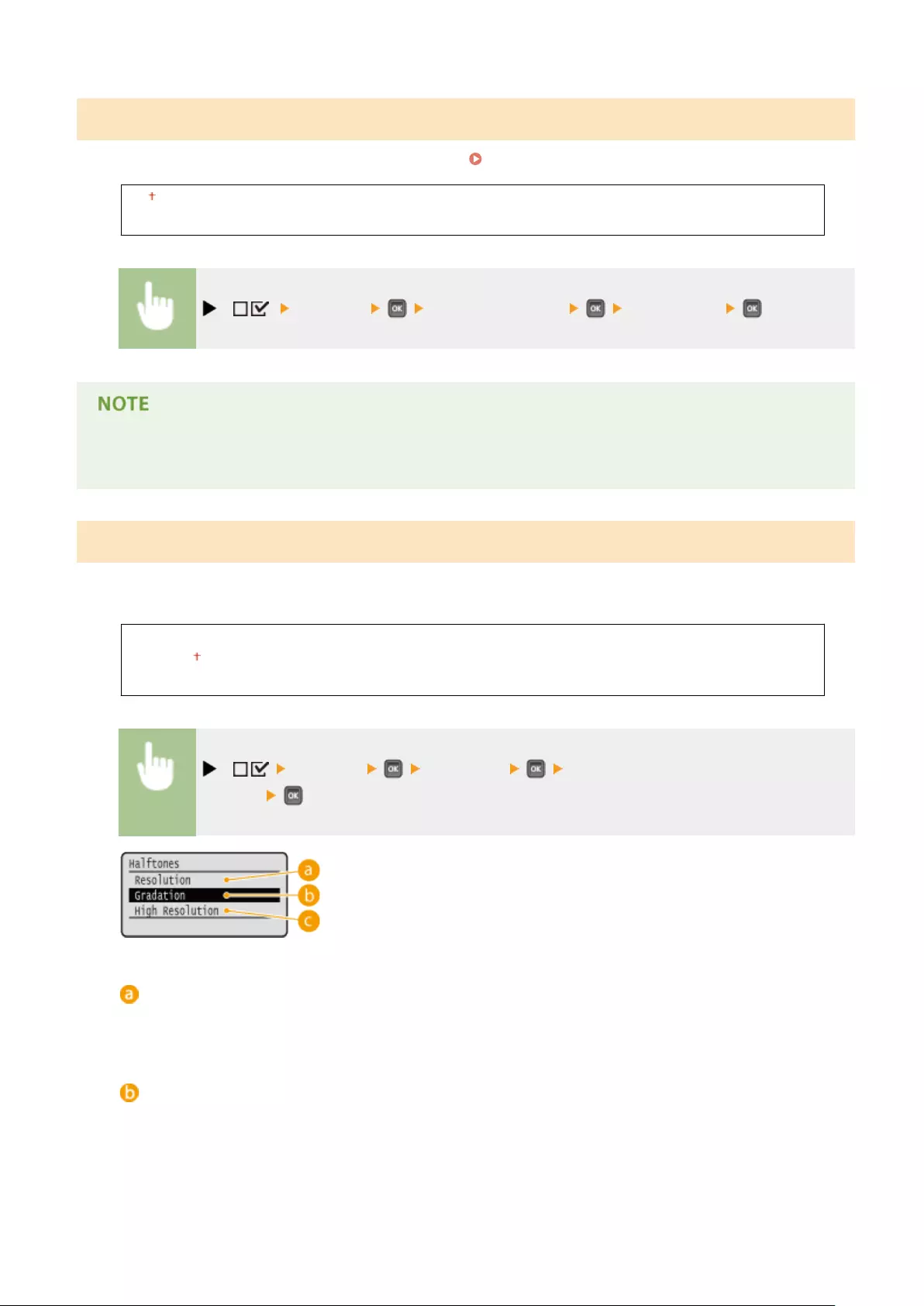
Enlarge Print Area
Specify whether or not to print the image by extending the Printable Area(P. 572) fully to the paper size.
Off
On
( ) <Imaging> <Enlarge Print Area> <Off> or <On>
●If you select <On>, some portions of the image may be missing near the edge of the paper or the paper may
be partly tainted depending on the original.
Halftones
You can select the printing method to reproduce halftones (the intermediate range between the lighter and darker
areas of an image).
Resolution
Gradation
High Resolution
( ) <Imaging> <Halftones> Select the method to reproduce
halftones
<Resolution>
Prints gradation and lines with a smooth nish. This print mode is suitable for printing gures and charts
with gradation.
<Gradation>
Prints vivid images with a tonal contrast effect. This print mode is suitable for printing image data such as
photos.
Setting Menu List
429
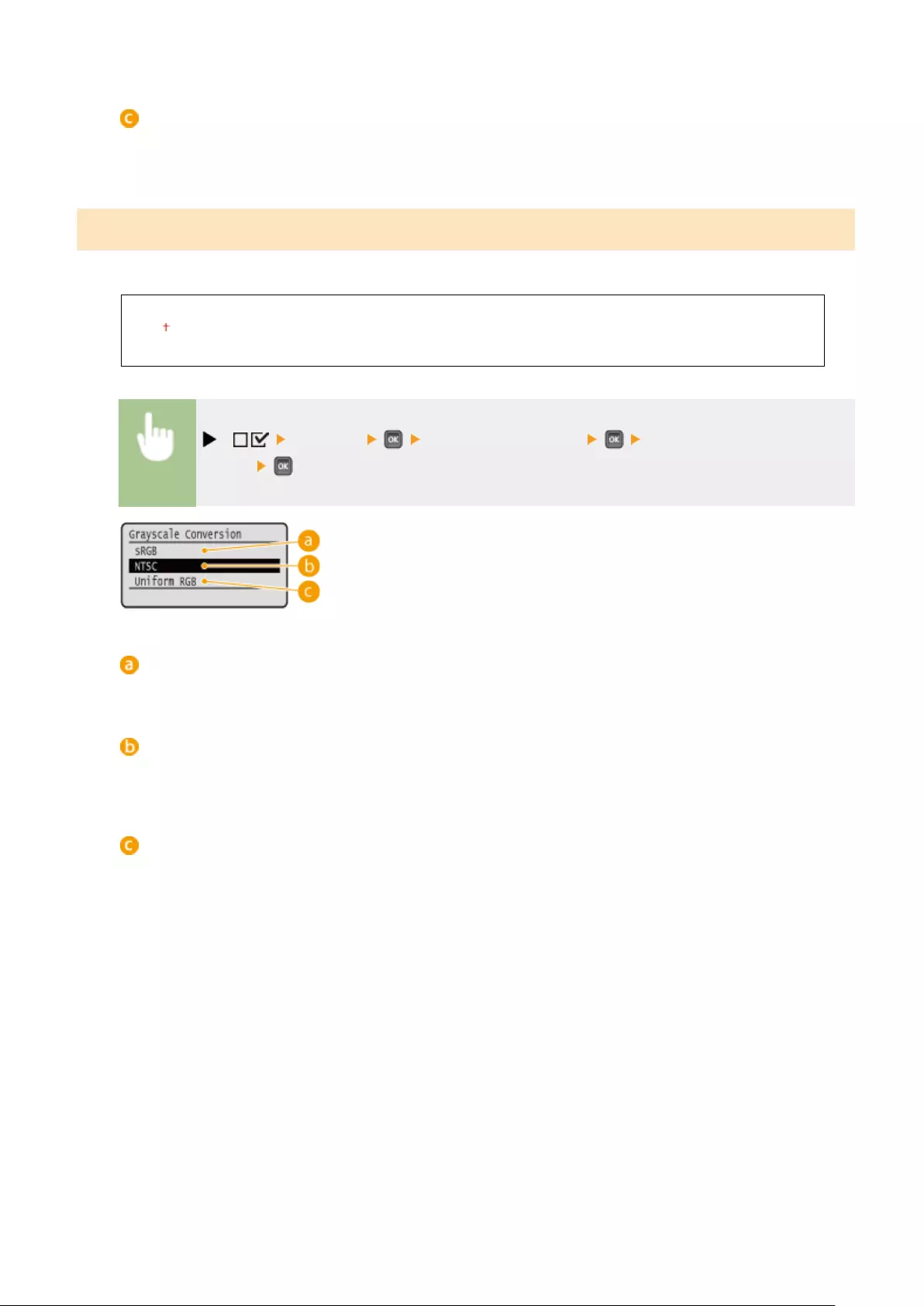
<High Resolution>
Performs ne printing by sharply reproducing the edges of characters. This print mode is suitable for
printing data of characters and thin lines with a clear nish.
Grayscale Conversion
You can select the method to convert color pint data to black-and-white data.
sRGB
NTSC
Uniform RGB
( ) <Imaging> <Grayscale Conversion> Select the conversion
method
<sRGB>
Color data is converted to black-and-white data to generate color-conscious smooth gradation.
<NTSC>
Color data is converted to black-and-white data to generate appearances equivalent to television pictures
(NTSC).
<Uniform RGB>
Color data is converted to black-and-white data to equalize all RGB levels based on the brightness only.
Setting Menu List
430
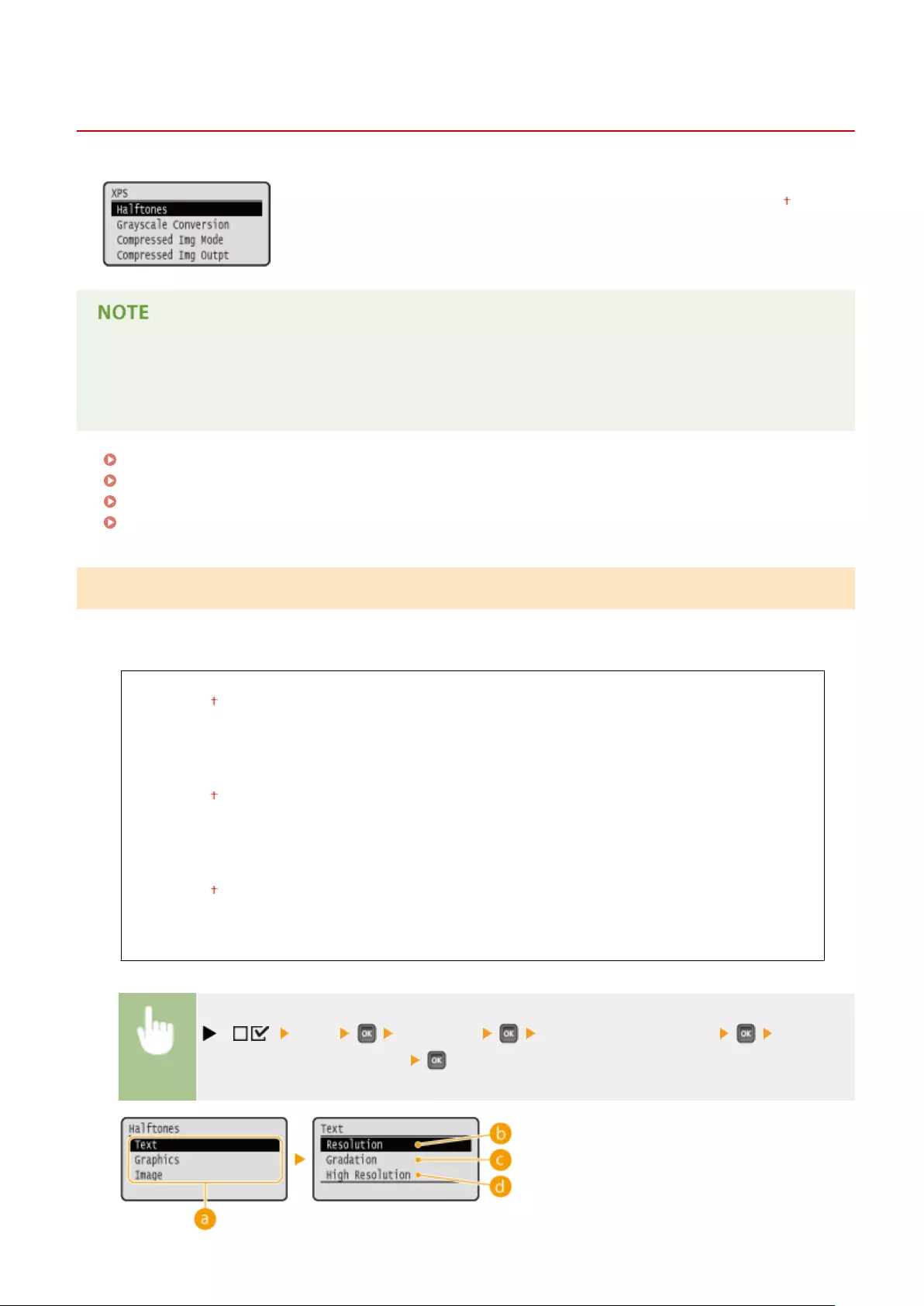
XPS
0X7U-05S
All the settings about XPS les available for USB Direct Print and Direct Print are
listed with short descriptions. Default settings are marked with a dagger ( ).
Asterisks (*)
●Settings marked with an asterisk (*) are not displayed depending on other settings or whether an optional
SD card is installed on the machine.
Halftones(P. 431)
Grayscale Conversion(P. 432)
Compressed Img Mode(P. 433)
Compressed Img Outpt(P. 434)
Halftones
You can select the printing method to reproduce halftones (the intermediate range between the lighter and darker
areas of an image). Halftones can be specied for each image data type in a single document.
Text
Resolution
Gradation
High Resolution
Graphics
Resolution
Gradation
High Resolution
Image
Resolution
Gradation
High Resolution
( ) <XPS> <Halftones> Select the image data type Select the
method to reproduce halftones
Setting Menu List
431

Image data type
Select the image data type for which the settings are changed. Select <Text> for characters, <Graphics> for
lines and gures, or <Image> for images such as photos.
<Resolution>
Prints gradation and lines with a smooth nish. This print mode is suitable for printing gures and charts
with gradation.
<Gradation>
Prints vivid images with a tonal contrast effect. This print mode is suitable for printing image data such as
photos.
<High Resolution>
Performs ne printing by sharply reproducing the edges of characters. This print mode is suitable for
printing data of characters and thin lines with a clear nish.
Grayscale Conversion
You can select the method to convert color pint data to black-and-white data. You can specify the conversion method
for each image data type: <Text>, <Graphics>, and <Image>.
Text
sRGB
NTSC
Uniform RGB
Graphics
sRGB
NTSC
Uniform RGB
Image
sRGB
NTSC
Uniform RGB
( ) <XPS> <Grayscale Conversion> Select the image data
type Select the conversion method
Setting Menu List
432
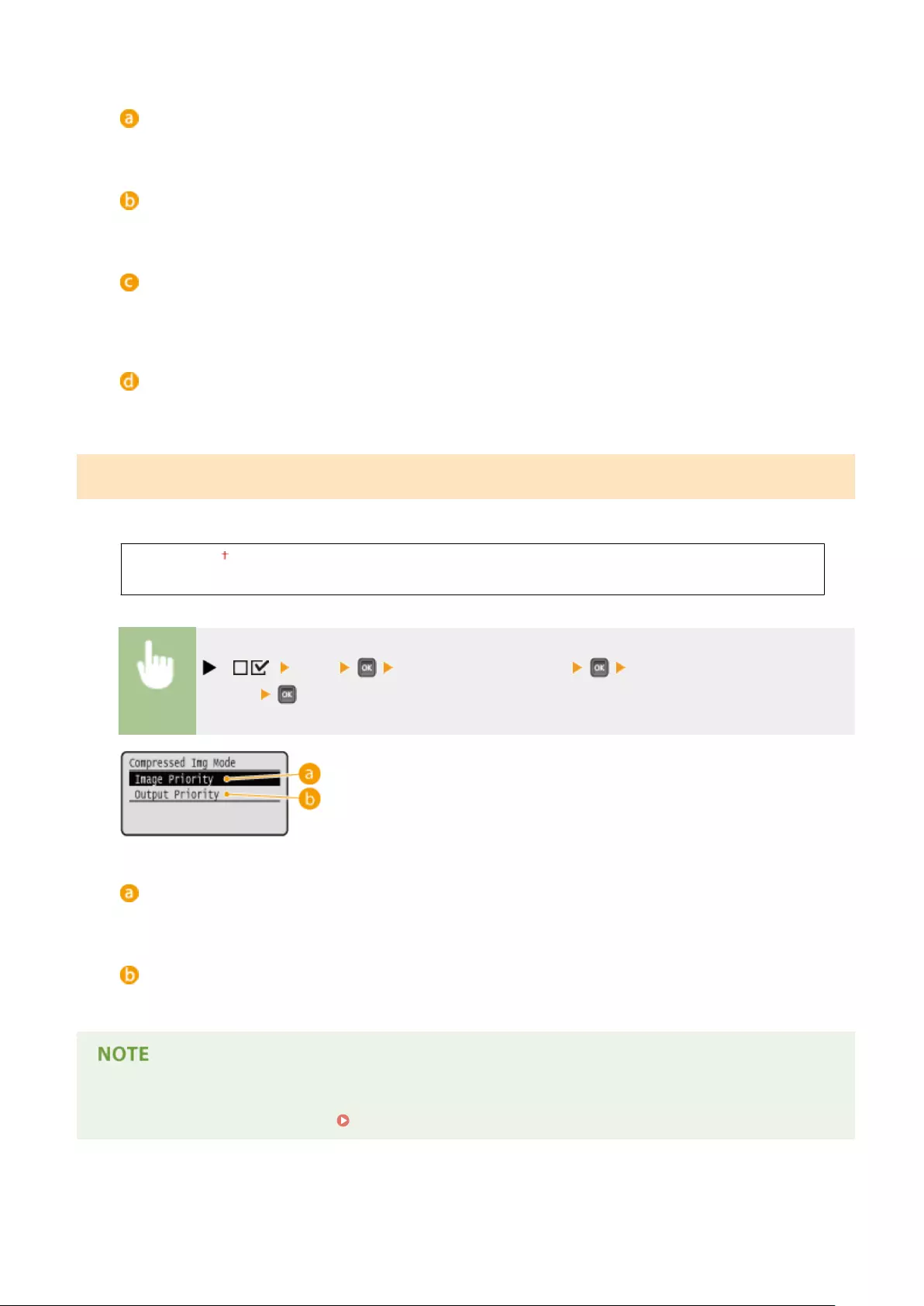
Image data type
Select the image data type for which you want to specify the conversion method.
<sRGB>
Color data is converted to black-and-white data to generate color-conscious smooth gradation.
<NTSC>
Color data is converted to black-and-white data to generate appearances equivalent to television pictures
(NTSC).
<Uniform RGB>
Color data is converted to black-and-white data to equalize all RGB levels based on the brightness only.
Compressed Img Mode *
Specify how the machine should behave when the machine is running out of memory during XPS le printing.
Image Priority
Output Priority
( ) <XPS> <Compressed Img Mode> <Image Priority> or <Output
Priority>
<Image Priority>
Cancels printing before the quality is reduced when insucient memory is available.
<Output Priority>
Continues printing even if the quality is reduced due to insucient memory.
●You can specify this item when no SD card is used. If <SD Card> is set to <On>, the machine always operates
with <Output Priority> selected ( SD Card(P. 369) ).
Setting Menu List
433
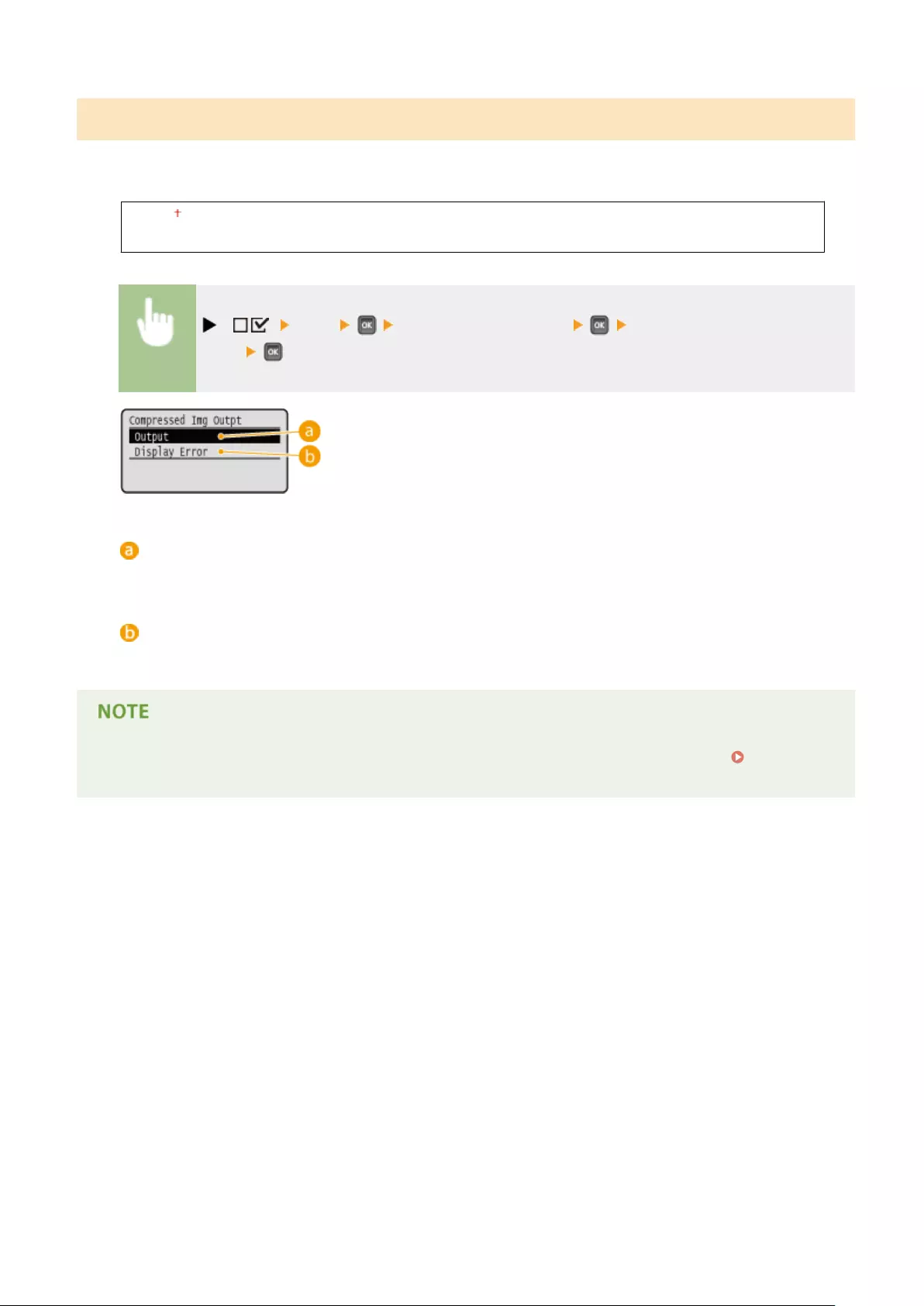
Compressed Img Outpt
If <Compressed Img Mode> is set to <Output Priority>, the quality may be reduced over time depending on image
data. You can specify how the machine should behave if the quality is excessively reduced.
Output
Display Error
( ) <XPS> <Compressed Img Outpt> <Output> or <Display
Error>
<Output>
Continues printing regardless of how the quality is reduced.
<Display Error>
Displays an applicable error message and cancels printing when the quality is excessively reduced.
●This setting is valid when <Compressed Img Mode> is set to <Output Priority> or <SD Card> ( SD
Card(P. 369) ) is set to <On>.
Setting Menu List
434
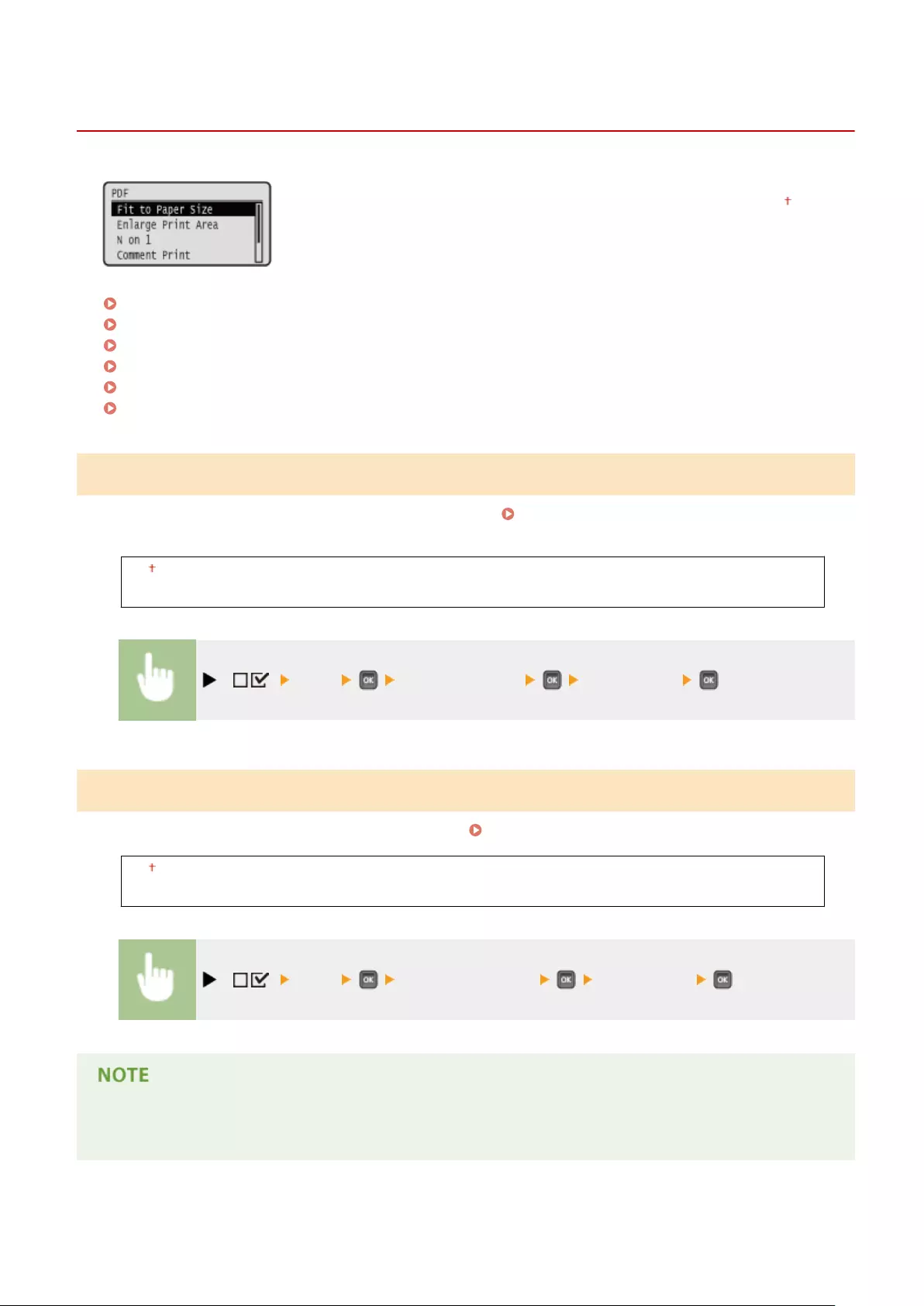
PDF
0X7U-05U
All the settings about PDF les available for USB Direct Print and Direct Print are
listed with short descriptions. Default settings are marked with a dagger ( ).
Fit to Paper Size(P. 435)
Enlarge Print Area(P. 435)
N on 1(P. 436)
Comment Print(P. 436)
Halftones(P. 436)
Grayscale Conversion(P. 437)
Fit to Paper Size
Specify whether to enlarge or reduce printouts according to the Printable Area(P. 572) of paper. The printouts are
enlarged or reduced with the original aspect ratio kept.
Off
On
( ) <PDF> <Fit to Paper Size> <Off> or <On>
Enlarge Print Area
Specify whether or not to print the image by extending the Printable Area(P. 572) fully to the paper size.
Off
On
( ) <PDF> <Enlarge Print Area> <Off> or <On>
●If you select <On>, some portions of the image may be missing near the edge of the paper or the paper may
be partly tainted depending on the original.
Setting Menu List
435

N on 1
Select whether to print multiple pages onto a single sheet at a reduced size by sequentially allocating them from the
top left. For example, to print four pages onto a single sheet, select <4 on 1>.
Off
2 on 1
4 on 1
6 on 1
8 on 1
9 on 1
16 on 1
( ) <PDF> <N on 1> Select the aggregation method
Comment Print
Select whether to print comments. If you select <Auto>, comments in the PDF le are printed.
Off
Auto
( ) <PDF> <Comment Print> <Off> or <Auto>
Halftones
You can select the printing method to reproduce halftones (the intermediate range between the lighter and darker
areas of an image). Halftones can be specied for each image data type in a single document.
Text
Resolution
Gradation
High Resolution
Graphics
Resolution
Gradation
High Resolution
Image
Resolution
Gradation
High Resolution
Setting Menu List
436

( ) <PDF> <Halftones> Select the image data type Select the
method to reproduce halftones
Image data type
Select the image data type for which the settings are changed. Select <Text> for characters, <Graphic Mode>
for lines and gures, or <Image> for images such as photos.
<Resolution>
Prints gradation and lines with a smooth nish. This print mode is suitable for printing gures and charts
with gradation.
<Gradation>
Prints vivid images with a tonal contrast effect. This print mode is suitable for printing image data such as
photos.
<High Resolution>
Performs ne printing by sharply reproducing the edges of characters. This print mode is suitable for
printing data of characters and thin lines with a clear nish.
Grayscale Conversion
You can select the method to convert color pint data to black-and-white data.
sRGB
NTSC
Uniform RGB
( ) <PDF> <Grayscale Conversion> Select the conversion
method
Setting Menu List
437

<sRGB>
Color data is converted to black-and-white data to generate color-conscious smooth gradation.
<NTSC>
Color data is converted to black-and-white data to generate appearances equivalent to television pictures
(NTSC).
<Uniform RGB>
Color data is converted to black-and-white data to equalize all RGB levels based on the brightness only.
Setting Menu List
438
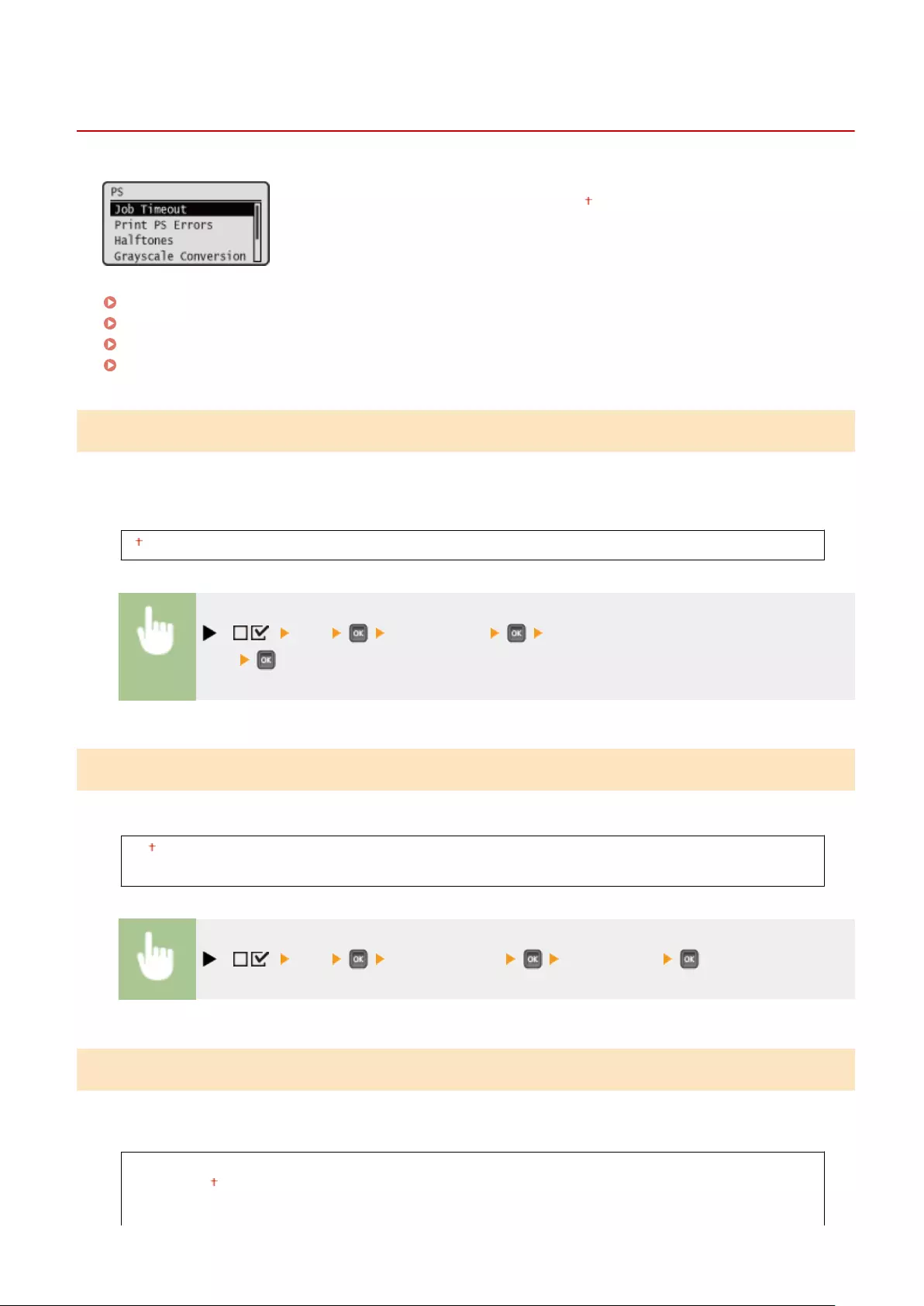
PS
0X7U-05W
All the settings about the PS control commands are listed with short descriptions.
Default settings are marked with a dagger ( ).
Job Timeout(P. 439)
Print PS Errors(P. 439)
Halftones(P. 439)
Grayscale Conversion(P. 440)
Job Timeout
If the time specied in this item has elapsed since a job process was started, the machine automatically nishes the
job and receives the next job.
If you do not want to specify the timeout, specify "0 seconds."
0 to 3600 seconds
( ) <PS> <Job Timeout> Use the numeric keys to enter the setting
value
Print PS Errors
Species whether an error page should be printed when a PostScript error is occurring.
Off
On
( ) <PS> <Print PS Errors> <Off> or <On>
Halftones
You can select the printing method to reproduce halftones (the intermediate range between the lighter and darker
areas of an image). Halftones can be specied for each image data type in a single document.
Text
Resolution
Gradation
Setting Menu List
439
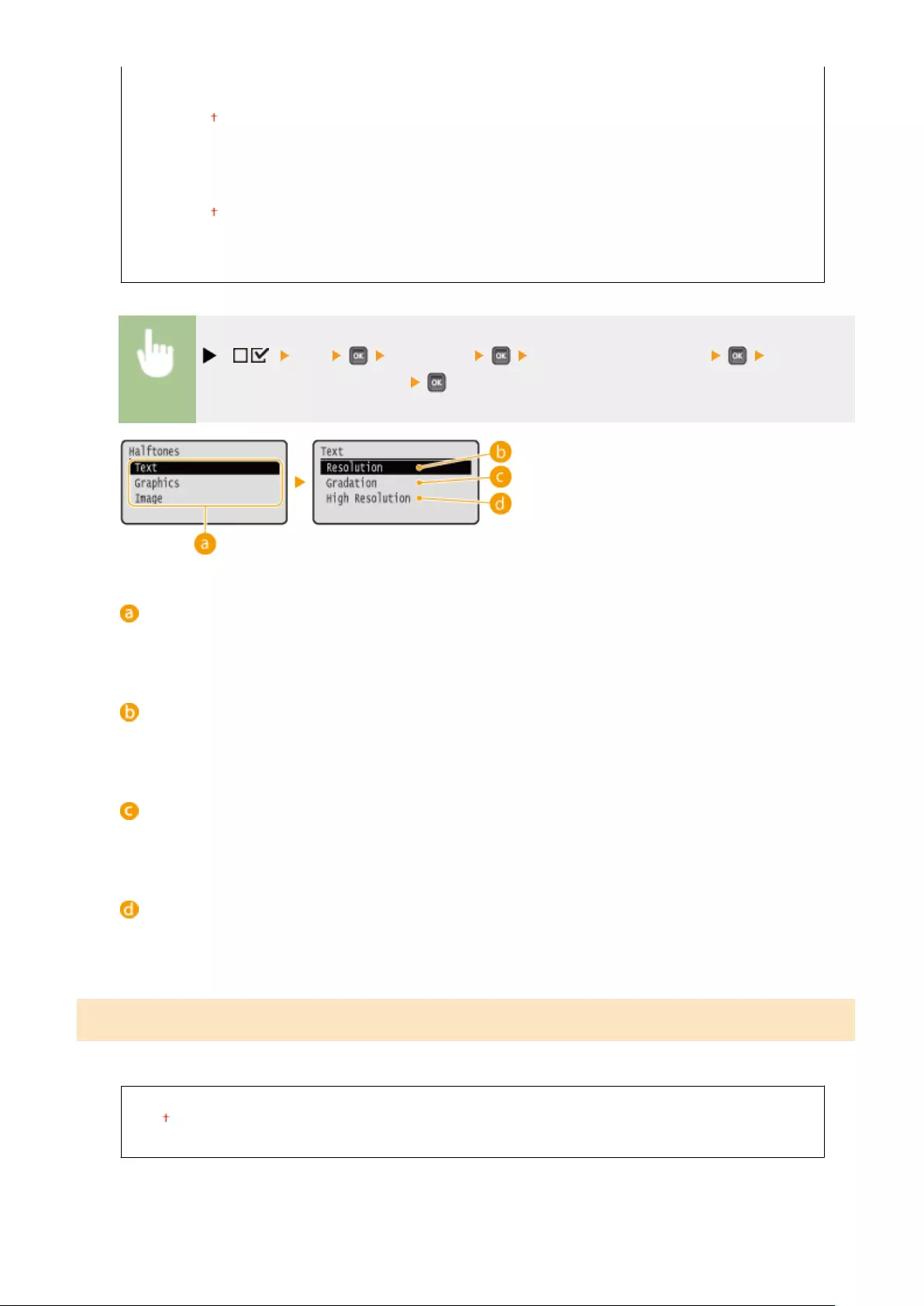
High Resolution
Graphics
Resolution
Gradation
High Resolution
Image
Resolution
Gradation
High Resolution
( ) <PS> <Halftones> Select the image data type Select the
method to reproduce halftones
Image data type
Select the image data type for which the settings are changed. Select <Text> for characters, <Graphics> for
lines and gures, or <Image> for images such as photos.
<Resolution>
Prints gradation and lines with a smooth nish. This print mode is suitable for printing gures and charts
with gradation.
<Gradation>
Prints vivid images with a tonal contrast effect. This print mode is suitable for printing image data such as
photos.
<High Resolution>
Performs ne printing by sharply reproducing the edges of characters. This print mode is suitable for
printing data of characters and thin lines with a clear nish.
Grayscale Conversion
You can select the method to convert color print data to black-and-white data.
sRGB
NTSC
Uniform RGB
Setting Menu List
440
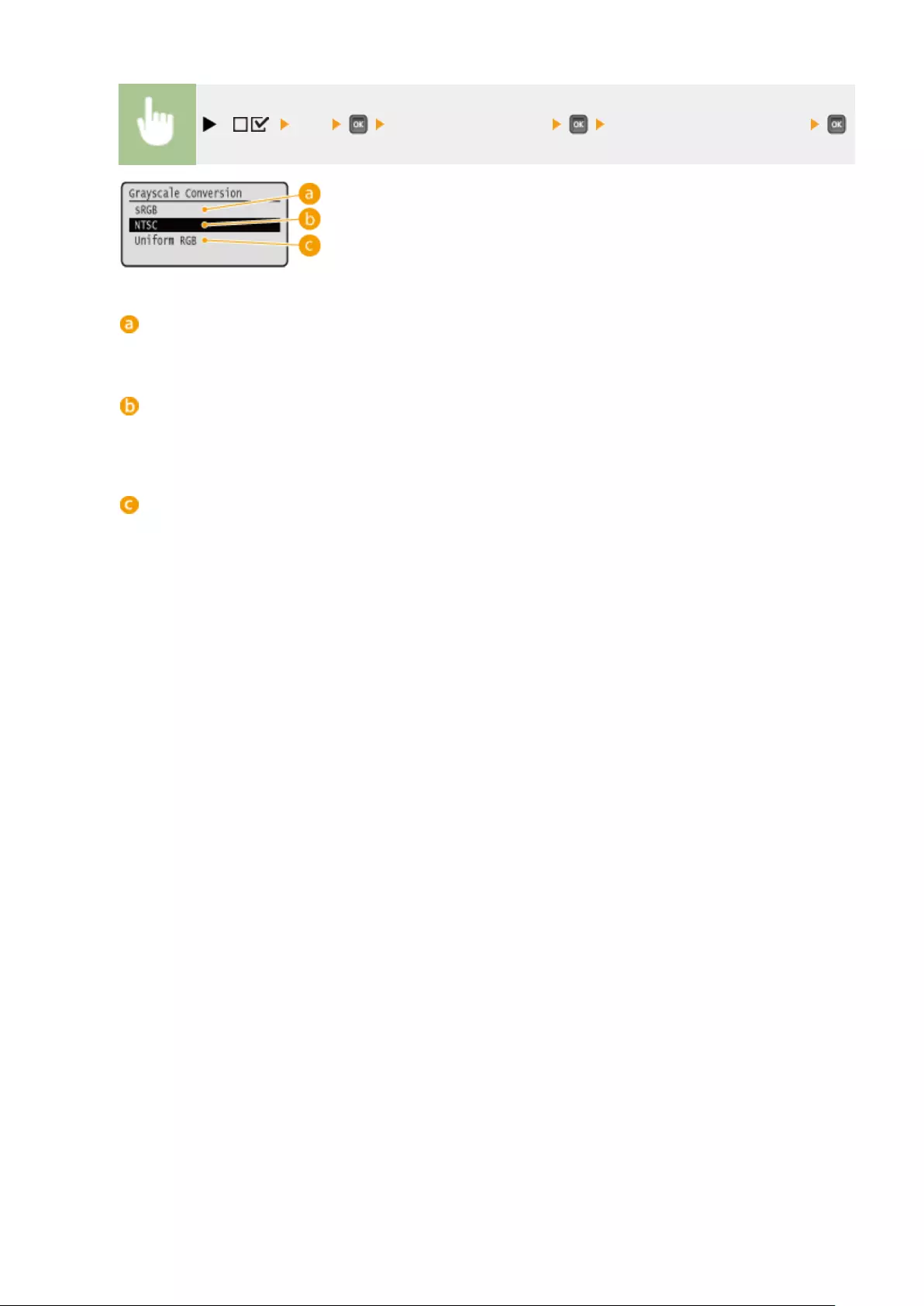
( ) <PS> <Grayscale Conversion> Select the conversion method
<sRGB>
Color data is converted to black-and-white data to generate color-conscious smooth gradation.
<NTSC>
Color data is converted to black-and-white data to generate appearances equivalent to television pictures
(NTSC).
<Uniform RGB>
Color data is converted to black-and-white data to equalize all RGB levels based on the brightness only.
Setting Menu List
441

MEAP Settings
0X7U-05X
The setting items about the main screen on MEAP are listed with short descriptions.
Default settings are marked with a dagger ( ).
Select Def. Screen
You can specify the screen that appears on the display of the operation panel when the machine starts up.
Print Screen
MEAP
( ) <MEAP Settings> <Select Def. Screen> <Print Screen> or
<MEAP>
<Print Screen>
The print standby screen (main screen) is displayed.
<MEAP>
The screen of an installed MEAP application is displayed if any installed.
●You can press ( ) on the operation panel to change the screens of the display.
Setting Menu List
442
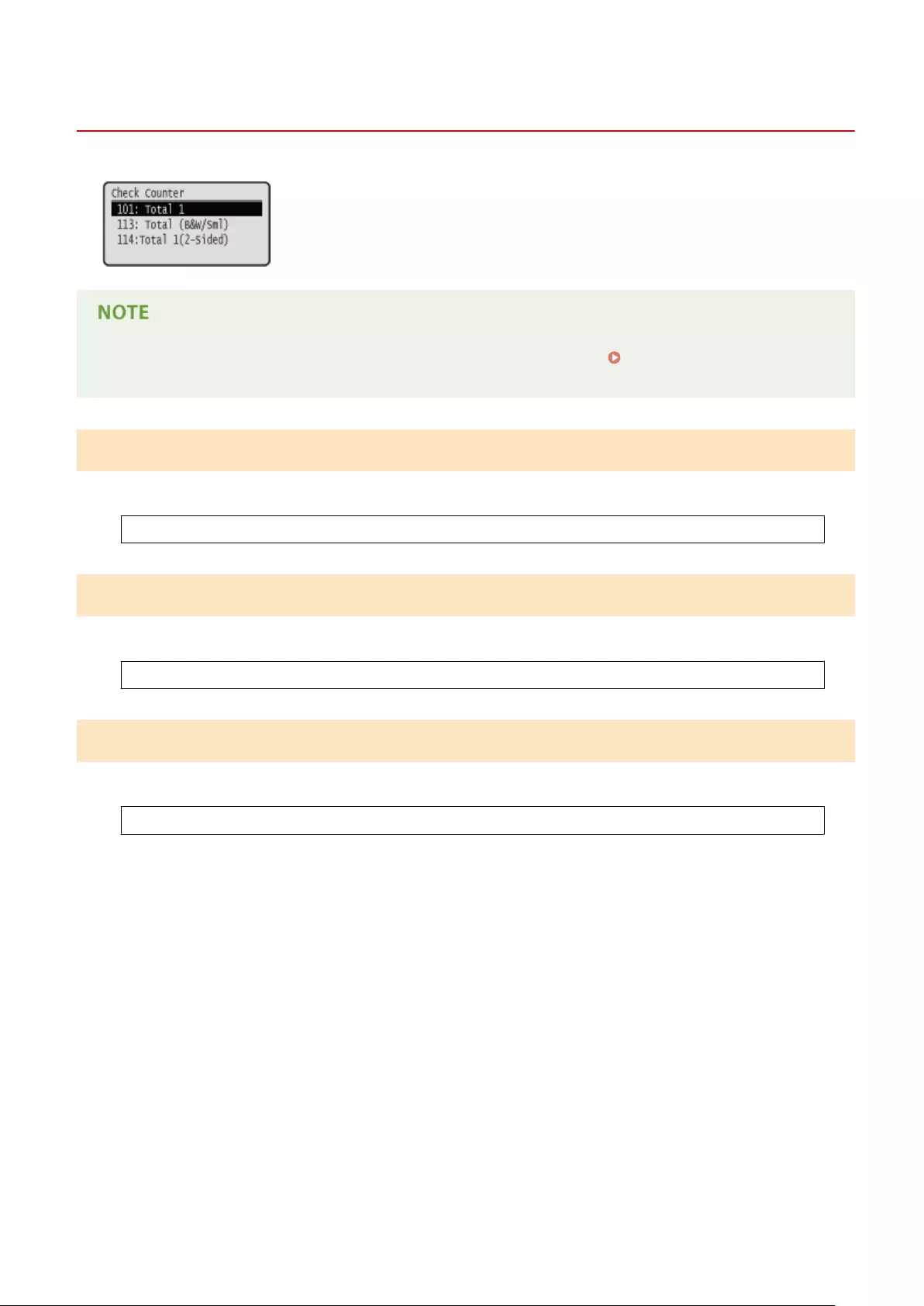
Check Counter
0X7U-05Y
You can check the total number of printed pages.
●You can also check the counter value by selecting <Check Counter> in the Utility Menu(P. 445) as well as
this item.
101: Total 1
You can check the total number of pages printed.
(Display only)
113: Total (B&W/Sml)
You can check the total number of pages printed.
(Display only)
114:Total 1(2-Sided)
You can check the total number of pages printed in 2-sided printing mode.
(Display only)
Setting Menu List
443

Initialize Menu
0X7U-060
Select to restore the settings of the Setup menu listed below to the factory defaults.
Initializing Menu(P. 551)
Settings that cannot be initialized
●You cannot initialize the settings specied for <Network> and <Adj. Print Position>. When you want to
initialize the <Network> settings, see Initializing the Network Settings(P. 552) . When you want to
initialize the <Adj. Print Position> settings, manually restore them to the factory default settings ( Adj.
Print Position(P. 406) ).
Setting Menu List
444
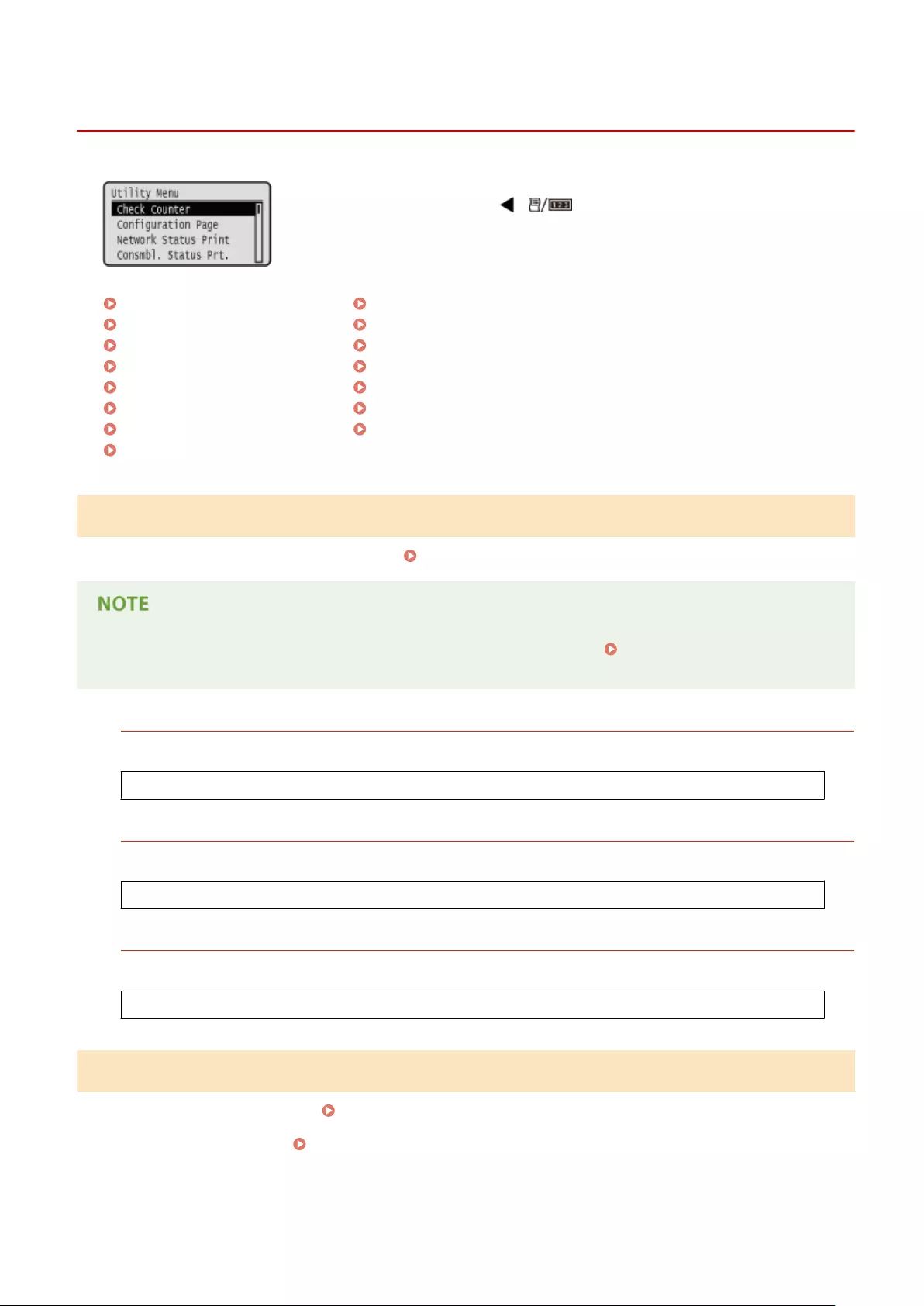
Utility Menu
0X7U-061
You can display the total number of printed pages and print internal system
information. When you press ( ) on the operation panel, the Utility menu
is displayed. You can specify the settings described below when the machine is
oine.
Check Counter(P. 445)
Conguration Page(P. 445)
Network Status Print(P. 446)
Consmbl. Status Prt.(P. 446)
IPSec Policy List(P. 446)
PCL Utility(P. 446)
PS Utility(P. 446)
Cleaning(P. 446)
E-Mail Print Utility(P. 446)
Printing Pos. Print(P. 447)
Page Count List(P. 447)
Counter Report(P. 447)
Print MEAP Sys. Info(P. 447)
Serial Number(P. 447)
Consumables Info.(P. 447)
Check Counter
You can check the total number of printed pages. Checking Total Number of Printed Pages(P. 545)
●You can also check the counter value by selecting <Check Counter> in the Setup Menu(P. 360) as well as
this item.
101: Total 1
You can check the total number of pages printed.
(Display only)
113: Total (B&W/Sml)
You can check the total number of pages printed.
(Display only)
114:Total 1(2-Sided)
You can check the total number of pages printed in 2-sided printing mode.
(Display only)
Conguration Page
You can check the machine settings ( Setup Menu(P. 360) ) congured in the machine. You can also check other
information including the amount of remaining toner, the number of printed pages, and the capacity of the memory
(RAM) mounted on the machine. Conguration Page(P. 536)
Setting Menu List
445
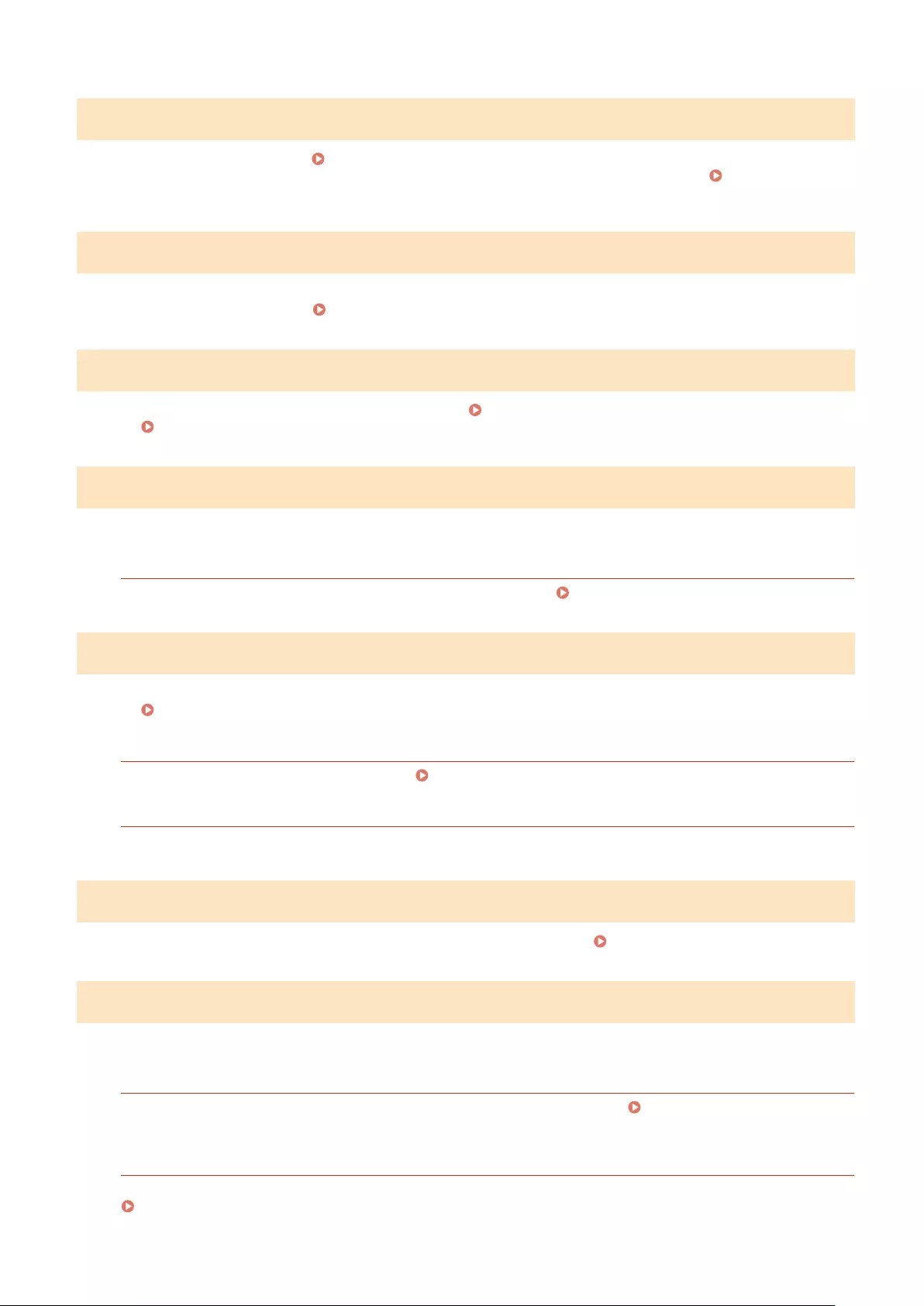
Network Status Print
Select to print a list of the settings ( Network(P. 375) ) about the network congured in the machine. You can also
check the information about the security including the address lter settings and IPSec settings. Network Status
Print(P. 536)
Consmbl. Status Prt.
The information such as toner remaining amount, warning messages, and information on where you can purchase
new toner cartridges is printed out. Consmbl. Status Prt.(P. 537)
IPSec Policy List
Select to print a list of the IPSec policy names and settings ( Conguring IPSec Settings(P. 298) ) congured in the
machine. IPSec Policy List(P. 537)
PCL Utility
Select to print a list of the internal information items registered in the machine for use of the PCL mode.
Font List
Select to print a list of the fonts that can be used in the PCL mode. PCL Font List(P. 540)
PS Utility
Select to print a list of the settings for use of the PS mode and the internal information items registered in the
machine. PS Mode List(P. 540)
Conguration Page
Select to print a list of the machine settings ( PS(P. 439) ).
Font List
Select to print a list of the fonts that can be used in the PS mode.
Cleaning
Select to clean the xing unit when black spots or streaks appear on printouts. Fixing Unit(P. 520)
E-Mail Print Utility
Select to manually receive e-mails and print a log of received e-mails in list form.
Received E-Mail
Select to manually receive e-mails from the POP3 mail server and print them. Manually Receiving E-
Mails(P. 162)
E-Mail RX Log List
Select to print a log consisting of subjects and received date/time of e-mails received in the machine in list form.
E-Mail Print Log(P. 543)
Setting Menu List
446
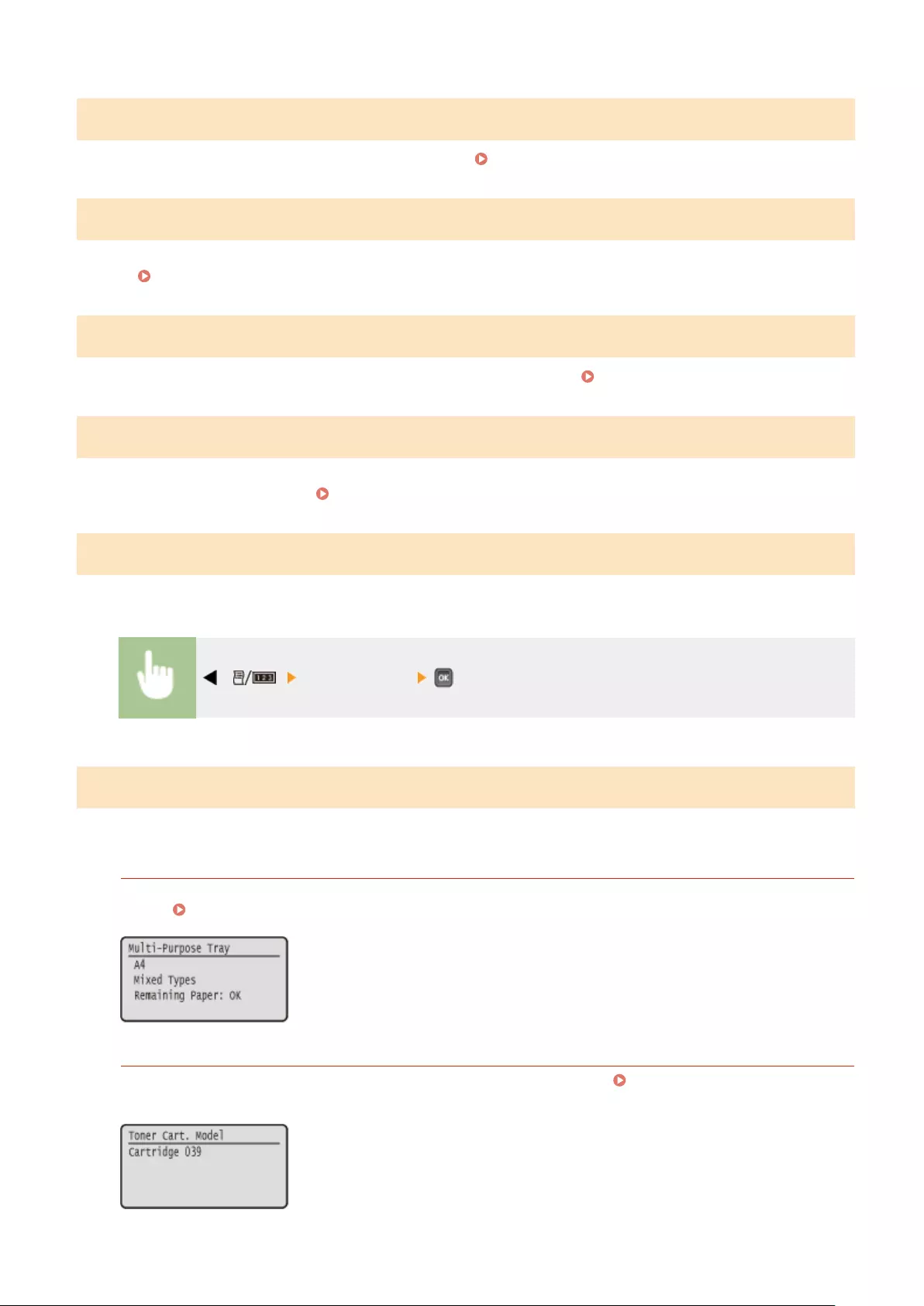
Printing Pos. Print
Select to print marks that indicate the current print position. Adjusting Print Position(P. 532)
Page Count List
Select to print a report on the number of printed pages for each department when Department ID Management is
enabled. Page Count List(P. 538)
Counter Report
Prints an aggregate report of the number of pages printed for each counter. Counter Report(P. 447)
Print MEAP Sys. Info
Select to print a list of information about MEAP applications installed in the machine and the MEAP system applications
when the MEAP function is enabled. Print MEAP Sys. Info(P. 539)
Serial Number
Select to display the serial number of the machine.
( ) <Serial Number>
Consumables Info.
Select to display the information about the paper and toner cartridge.
Paper Information
Select to display the currently specied paper size and paper type, and the remaining paper level for each paper
source. Checking Paper(P. 548)
Toner Cart. Model
Select to display the model number of the toner cartridge for the machine. Checking the Toner Cartridge
Model(P. 548)
Setting Menu List
447
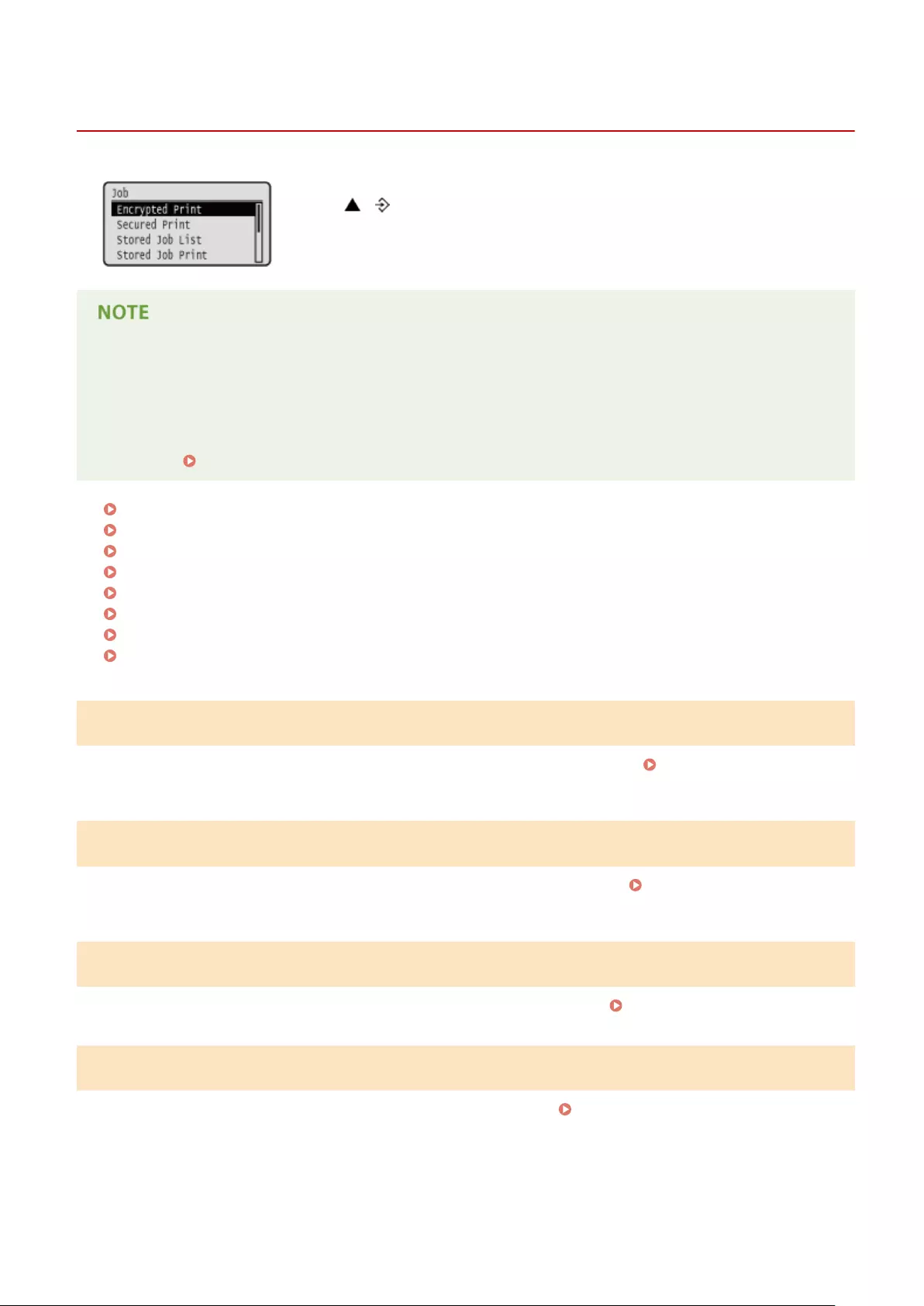
Job Menu
0X7U-062
You can print documents stored in the SD card and a print log. When you
press ( ) on the operation panel, the Job menu is displayed. You can specify
the settings described below when the machine is oine.
Asterisks (*)
●Settings marked with "*1" are not displayed depending on other settings or whether an optional SD card is
installed on the machine.
●Settings marked with "*2" are not displayed when [Display Job Log] check box of the Remote UI is not
selected. Hiding the Print Job History(P. 291)
Encrypted Print(P. 449)
Secured Print(P. 449)
Stored Job List(P. 449)
Stored Job Print(P. 449)
Job Print Log(P. 450)
Stored Job Print Log(P. 450)
Report Print Log(P. 450)
E-Mail Print Log(P. 450)
Encrypted Print *1
Select to print encrypted documents that you sent to the machine from the computer. Printing Out Secured
Documents(P. 133)
Secured Print *1
Select to print secured documents that you sent to the machine from the computer. Printing Out Secured
Documents(P. 133)
Stored Job List *1
Select to print a list of documents stored in the SD card installed on the machine. Stored Job List(P. 542)
Stored Job Print *1
Select to print documents stored in the SD card installed on the machine. Printing a Document Stored in the
Machine(P. 139)
Setting Menu List
449
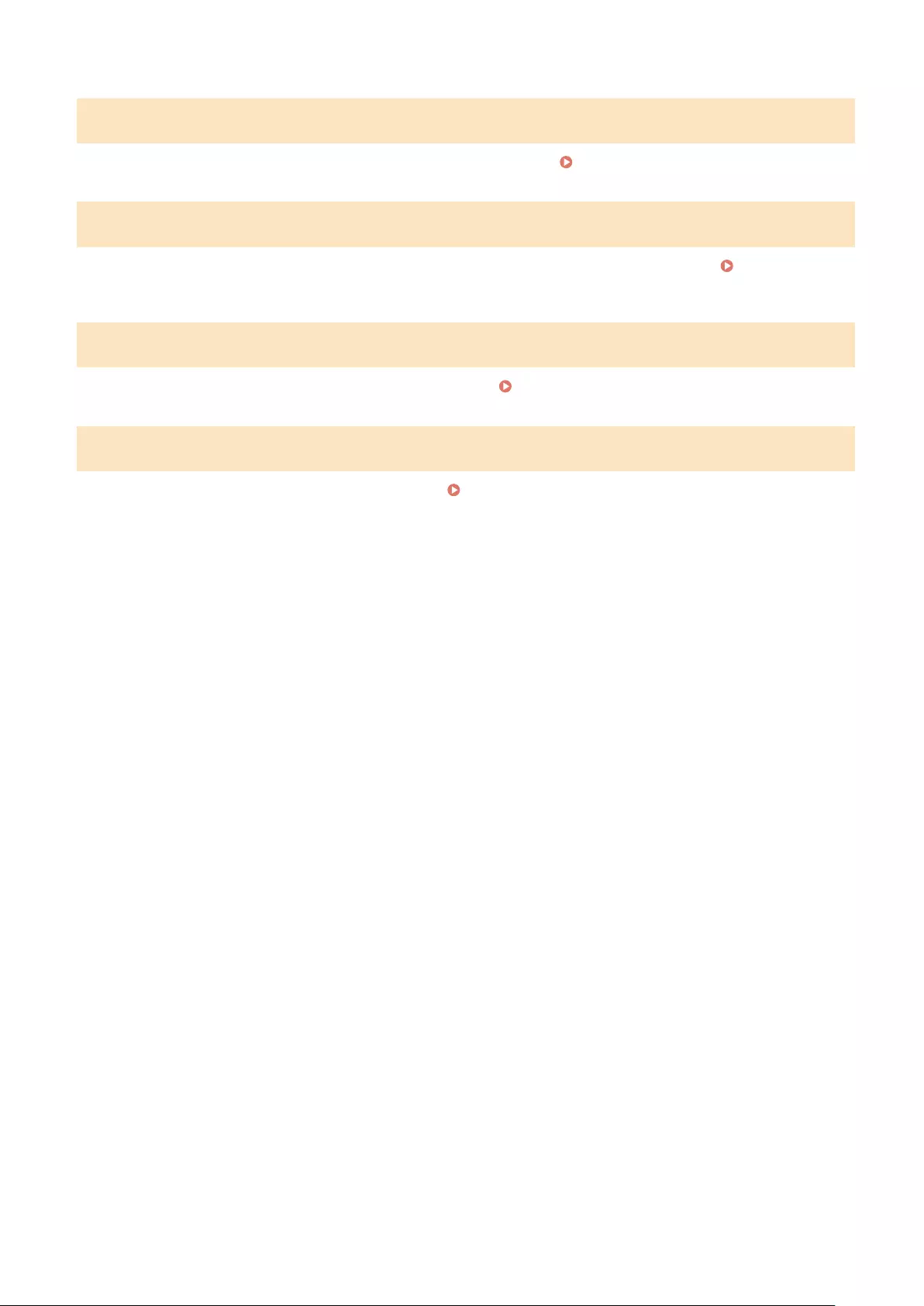
Job Print Log *2
Select to print a log of documents printed from the computer in list from. Job Print Log(P. 542)
Stored Job Print Log *1*2
Select to print a print log of documents stored in the SD card installed on the machine in list form. Stored Job Print
Log(P. 542)
Report Print Log *2
Select to print the settings and a print log of reports in list form. Report Print Log(P. 543)
E-Mail Print Log *2
Select to print a print log of received e-mails in list form. E-Mail Print Log(P. 543)
Setting Menu List
450

Reset Menu
0X7U-063
You can cancel all processes, delete data in memory, and turn OFF the power. When
you press ( ) on the operation panel, the Reset menu is displayed.
Soft Reset(P. 451)
Form Feed(P. 452)
Shut Down(P. 452)
●When the message Ennn-nnnn (n is a number) is displayed, only <Shut Down> can be executed.
Soft Reset
Select to erase all data of print jobs that are not yet nished (soft reset). You can also select this item to perform a hard
reset for enabling the changed settings.
●Make sure to check that other users are not using the machine before performing a soft reset or hard reset,
otherwise, all print data is erased before being printed.
◼Performing a Soft Reset
Perform a soft reset when you want to erase all print data that is being printed, waiting to be printed, or being
received.
( ) <Soft Reset> <Yes>
◼Performing a Hard Reset
Perform a hard reset when you want to enable the changed settings of machine or to erase data registered in memory
of the machine.
1Press ( ).
●If the setting menu is displayed, rst press ( ) to return to the main screen and then
perform this step 1.
Setting Menu List
451

2Use / to select <Soft Reset>, press and hold for 5 seconds or more, and
release it.
➠The message <Execute hard reset?> is displayed.
3Select <Yes>, and press .
➠When a hard reset is executed, the machine is restarted.
●When a soft reset or hard reset is performed, secured documents stored in the optional SD card are also
deleted.
Form Feed
If printing is canceled from the computer or the communication is interrupted during data reception, the data may
remain in the memory of the machine, preventing the printing from nishing. The next print data cannot be printed
with the remaining data left as is. In this case, select <Form Feed> to forcibly print the data remaining in memory.
( ) <Form Feed> <Yes>
●If the remaining data is not printed, perform a soft reset.
●If the data still remains in the memory of the machine after a form feed is performed (the [Job] indicator is lit
on the machine), perform a soft reset.
Shut Down
When turning OFF the machine, shut down the machine from the operation panel without using the power switch.
Turning OFF the Power (Performing a Shutdown)(P. 33)
Setting Menu List
452
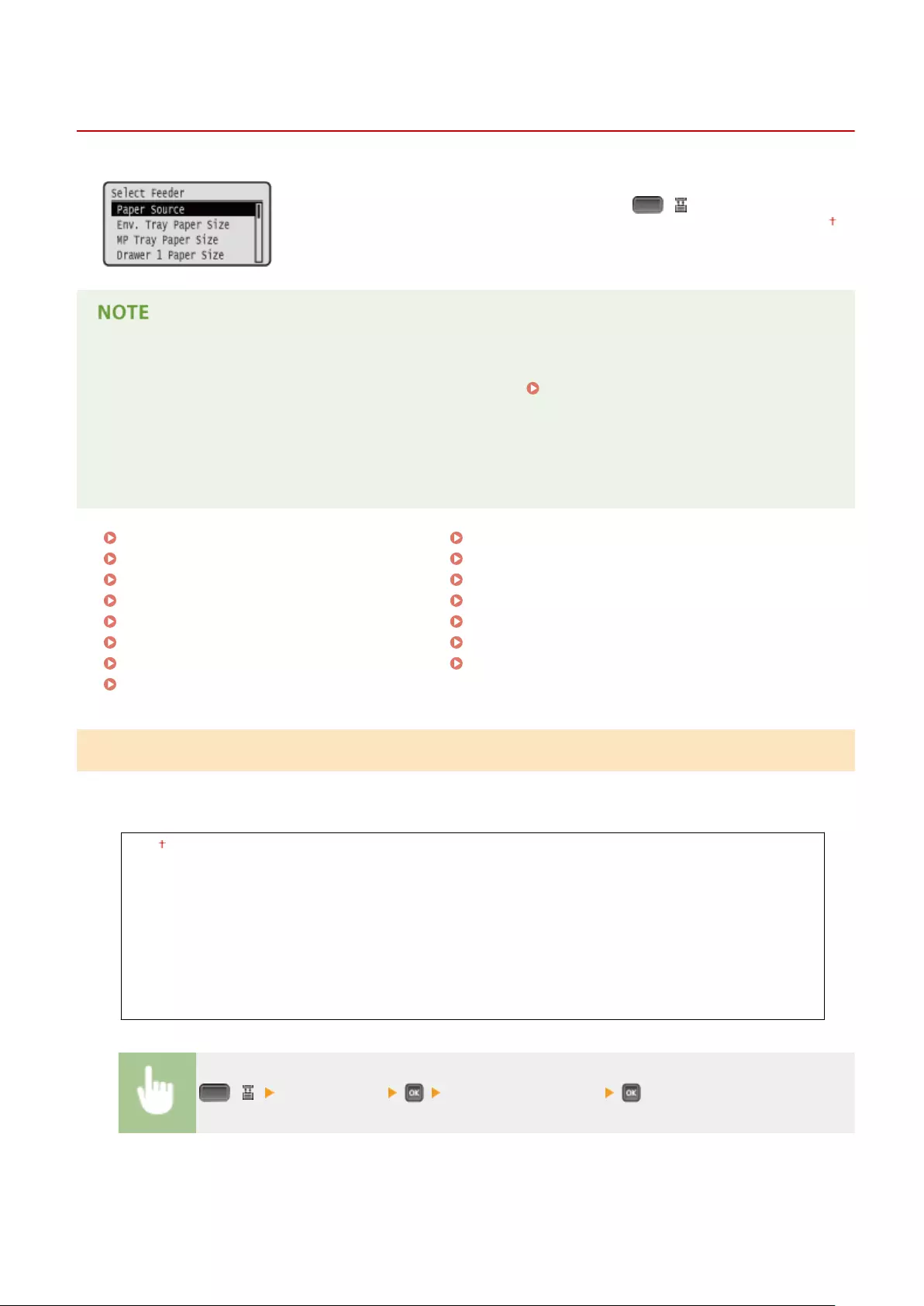
Select Feeder Menu
0X7U-064
The settings about the paper source and the size of paper loaded in the machine
are listed with short descriptions. When you press ( ) on the operation panel,
the Select Feeder menu is displayed. Default settings are marked with a dagger ( ).
Common settings
●The settings are the same as those for <Paper Source> in the Setup Menu(P. 360) . The settings specied
here are also applied to the <Paper Source> settings.
Asterisks (*)
●Settings marked with an asterisk (*) are not displayed depending on other settings or whether an optional
paper feeder, paper deck, or envelope feeder is installed in the machine.
Paper Source(P. 453)
Env. Tray Paper Size(P. 454)
MP Tray Paper Size(P. 454)
Drawer N Paper Size (N=1, 2, 3, 4, 5)(P. 454)
Standard Paper Size(P. 455)
MP Tray Priority(P. 456)
MP Tray for Mix Ppr.(P. 456)
Auto Select Drawer(P. 456)
Default Paper Type(P. 457)
Env. Tray Paper Type(P. 458)
MP Tray Paper Type(P. 458)
Drawer N Paper Type (N=1, 2, 3, 4, 5)(P. 458)
Manual 2-Sided (MP)(P. 458)
2-Sided Printing(P. 459)
Select Drawer1 Model(P. 459)
Paper Source
Select the paper source from which paper is fed. When you want to automatically change the paper source based on
the paper size and paper type, select <Auto>.
Auto
Envelope Tray *
Multi-Purpose Tray
Drawer 1
Drawer 2 *
Drawer 3 *
Drawer 4 *
Drawer 5 *
( ) <Paper Source> Select the paper source
Setting Menu List
453
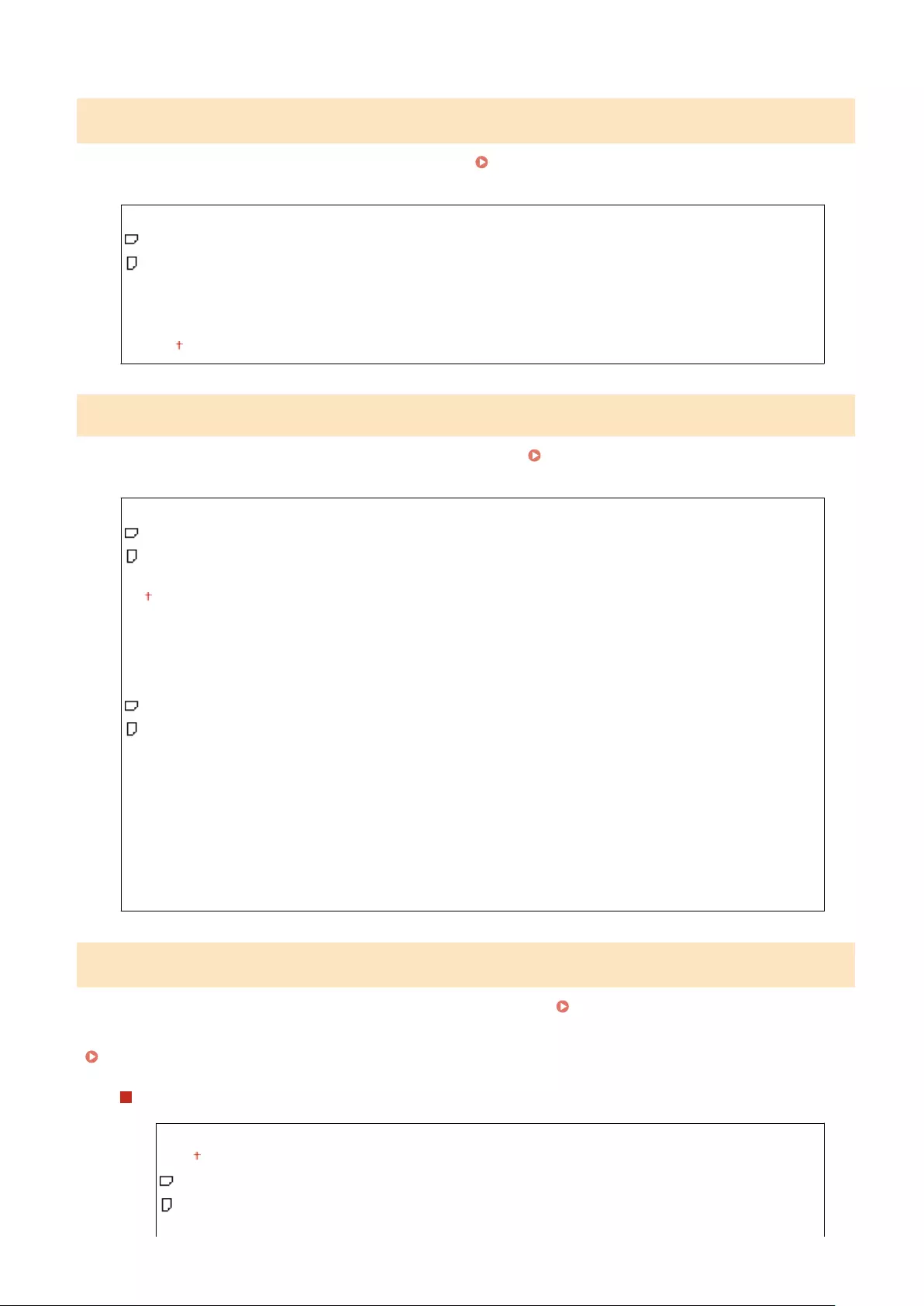
Env. Tray Paper Size *
Set the size of paper loaded in the optional envelope feeder. Specifying Paper Size and Type for the Envelope
Feeder (Option)(P. 65)
Free Size
Custom Size
Custom Size
Env. ISO-C5
Env. Monarch
Env. No.10
Env. DL
MP Tray Paper Size
Specify the size of the paper that is loaded in the multi-purpose tray. Specifying Paper Size and Type in the Multi-
Purpose Tray(P. 63)
A6
A5
A5
B5
A4
LTR
LGL
EXEC
Free Size
Custom Size
Custom Size
Env. ISO-C5
Env. Monarch
Env. No.10
Env. DL
Index Card
STMT
FLSC
16K
Drawer N Paper Size (N=1, 2, 3, 4, 5) *
Set the size of paper loaded in the paper drawer or optional paper deck ( Specifying the Size and Type of the Paper
in the Paper Drawer(P. 60) ). The paper types displayed differ depending on the type of the drawer or the option
installed. When you use an optional A5 cassette or custom media cassette, you need to specify the type of drawer 1
( Select Drawer1 Model(P. 459) ).
Machine's Standard Paper Drawer or Paper Feeder's Paper Drawer
Free Size
Auto
Custom Size
Custom Size
FLSC
Setting Menu List
454
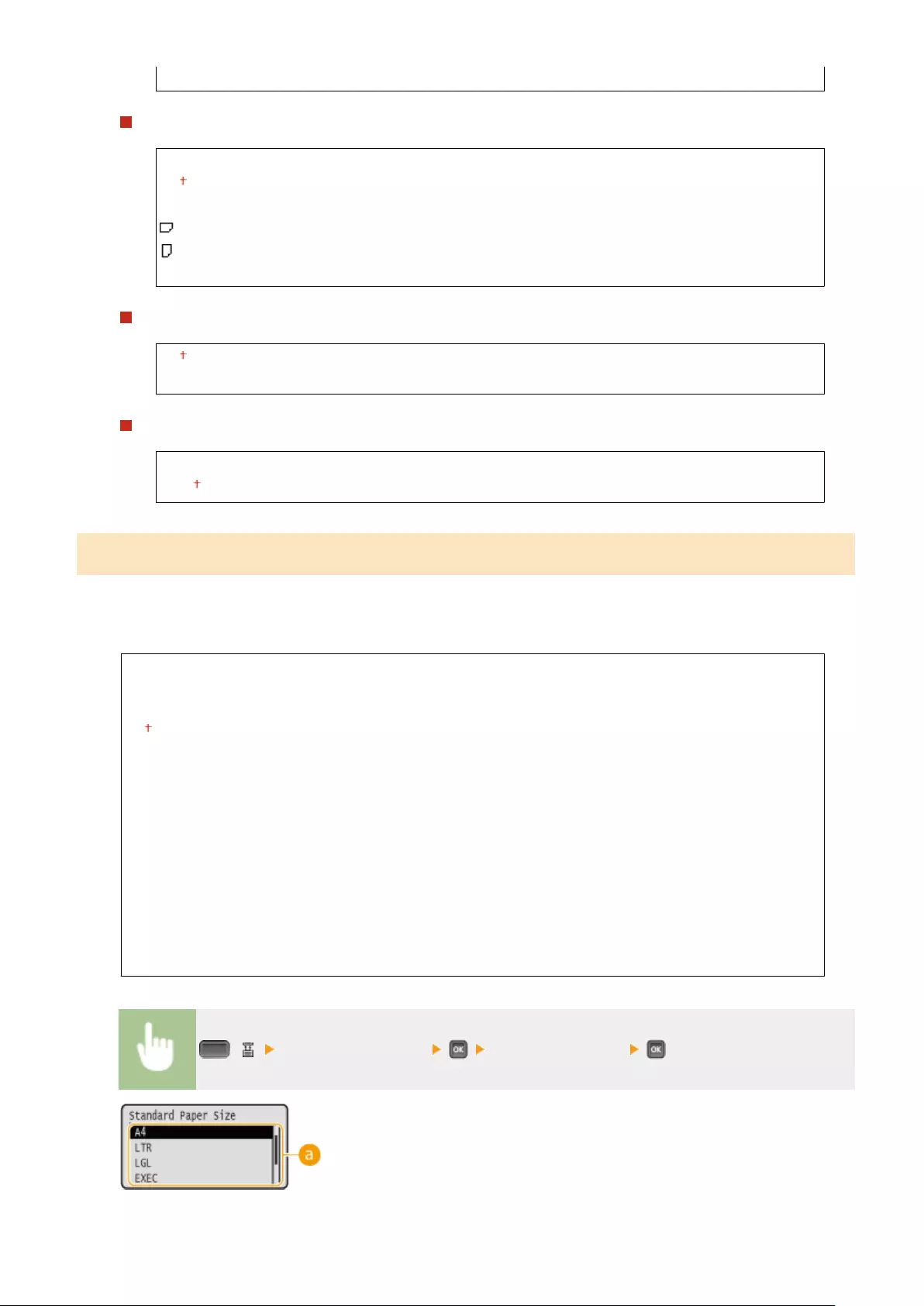
16K
Custom Media Cassette
A6
A5
Free Size
Custom Size
Custom Size
STMT
A5 Cassette
A5
Free Size
Paper Deck
Free Size
Auto
Standard Paper Size
You cannot perform paper size setting on a computer running an operating system or a mobile device that does not
support any printer driver. If you want to print from such computer or mobile device, use this item to set the size of
the paper to print on.
A6
A5
B5
A4
LTR
LGL
EXEC
Env. ISO-C5
Env. Monarch
Env. No.10
Env. DL
Index Card
STMT
FLSC
16K
( ) <Standard Paper Size> Select the paper size
Setting Menu List
455
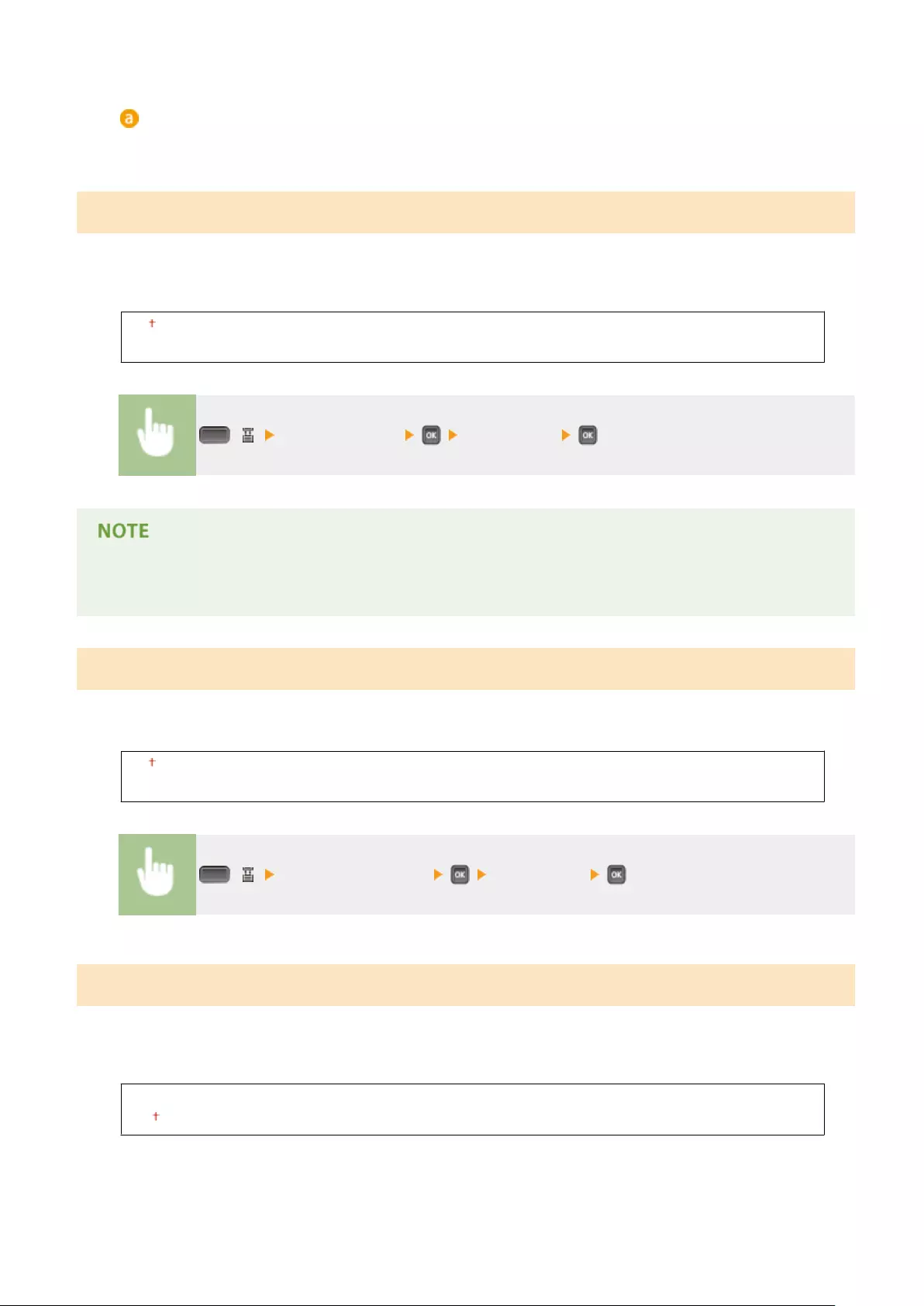
Selecting the paper size
Specify the setting according to the size of the paper to print on.
MP Tray Priority
Select whether to prioritize paper feeding from the multi-purpose tray when <Paper Source> is set to <Auto>. If you
select <On>, paper is fed from the multi-purpose tray when the same size paper is loaded in both the multi-purpose
tray and the paper drawer.
Off
On
( ) <MP Tray Priority> <Off> or <On>
●When <MP Tray for Mix Ppr.> is set to <On>, paper is preferentially fed from the paper drawer even if <MP
Tray Priority> is set to <On>.
MP Tray for Mix Ppr.
If you select <On> with <Paper Source> set to <Auto>, the multi-purpose tray is automatically selected when
appropriate size paper is not loaded in any paper drawer.
Off
On
( ) <MP Tray for Mix Ppr.> <Off> or <On>
Auto Select Drawer
If you select <Use> with <Paper Source> set to <Auto>, the machine automatically selects the paper source with
appropriate size paper loaded. Also, when the paper runs out, this setting enables continuous printing by switching
from one paper source to another that is loaded with the same paper size.
Do Not Use
Use
Setting Menu List
456
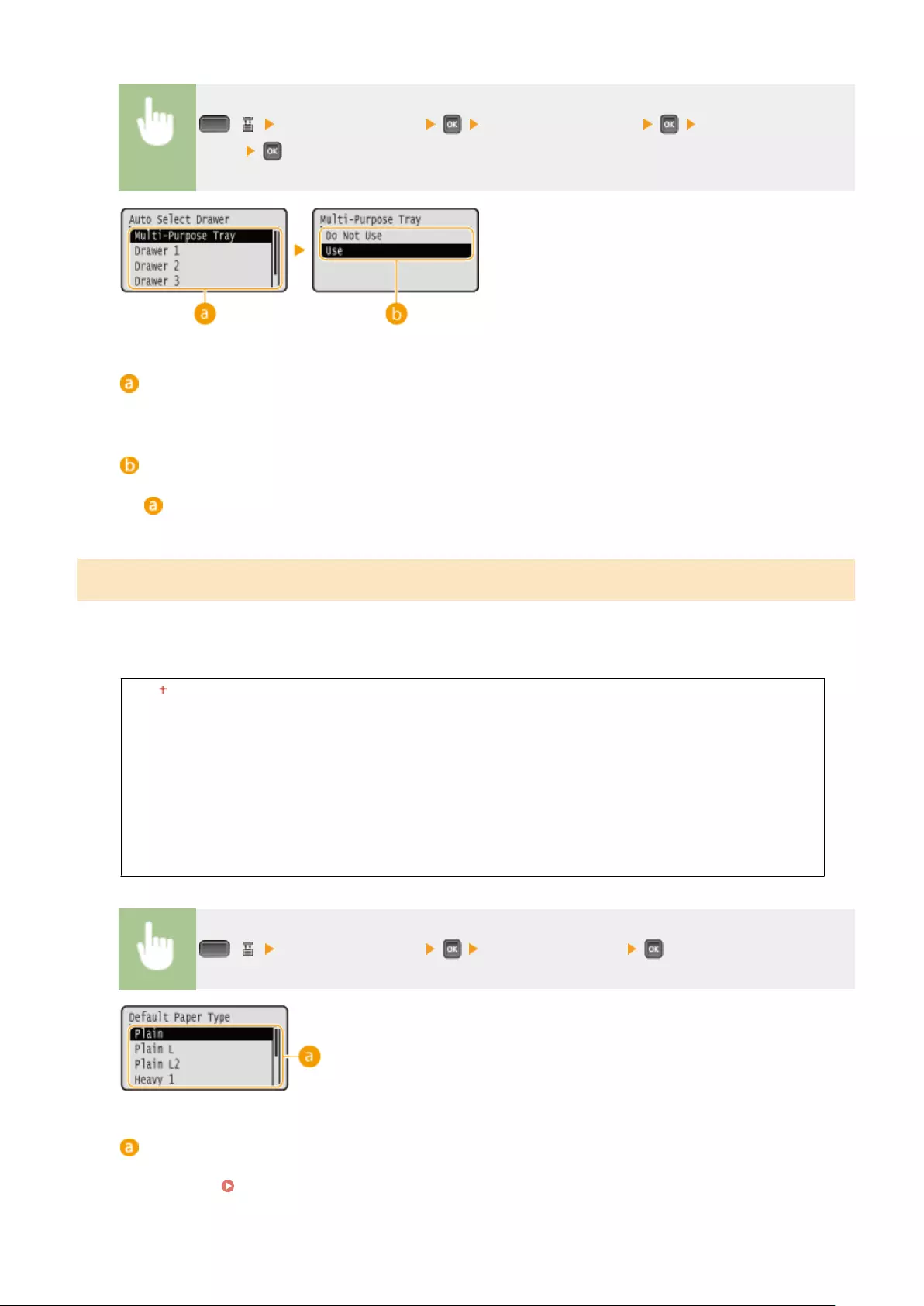
( ) <Auto Select Drawer> Select the paper source <Do Not Use> or
<Use>
Paper source selection
Select the paper source to which you want to apply the Auto Select Drawer function.
Switching of the settings
Select <On> to enable automatic drawer selection for the paper source you selected on the previous screen
().
Default Paper Type
You cannot perform paper type setting on a computer running an operating system or a mobile device that does not
support any printer driver. If you want to print from such computer or mobile device, use this item to set the type of
the paper to print on.
Plain
Plain L
Plain L2
Heavy 1
Heavy 2
Heavy 3
Envelope
Envelope H
Labels
( ) <Default Paper Type> Select the paper type
Paper type selection
Specify the settings in the same way as the paper settings in the printer driver according to the paper type
for printing. Loading Paper(P. 37)
Setting Menu List
457
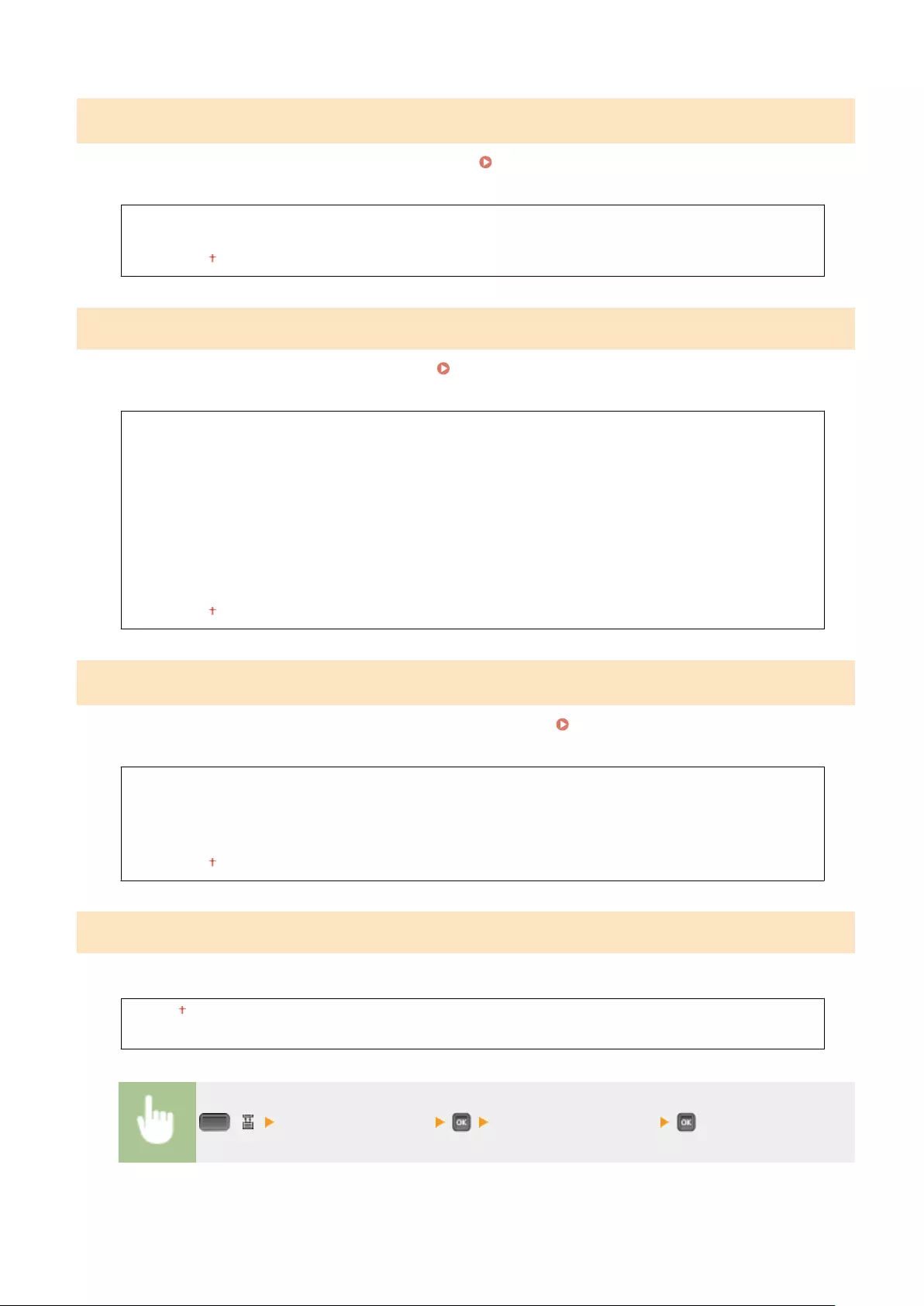
Env. Tray Paper Type *
Set the type of paper loaded in the optional envelope feeder. Specifying Paper Size and Type for the Envelope
Feeder (Option)(P. 65)
Envelope
Envelope H
Mixed Types
MP Tray Paper Type
Set the type of paper loaded in the multi-purpose tray. Specifying Paper Size and Type in the Multi-Purpose
Tray(P. 63)
Plain
Plain L
Plain L2
Heavy 1
Heavy 2
Heavy 3
Envelope
Envelope H
Labels
Mixed Types
Drawer N Paper Type (N=1, 2, 3, 4, 5) *
Set the type of paper loaded in the paper drawer or optional paper deck. Specifying the Size and Type of the Paper
in the Paper Drawer(P. 60)
Plain
Plain L
Plain L2
Heavy 1
Mixed Types
Manual 2-Sided (MP)
Select the side of paper to print on when you want to perform 2-sided printing manually from the multi-purpose tray.
1st Side
2nd Side
( ) <Manual 2-Sided (MP)> <1st Side> or <2nd Side>
Setting Menu List
458
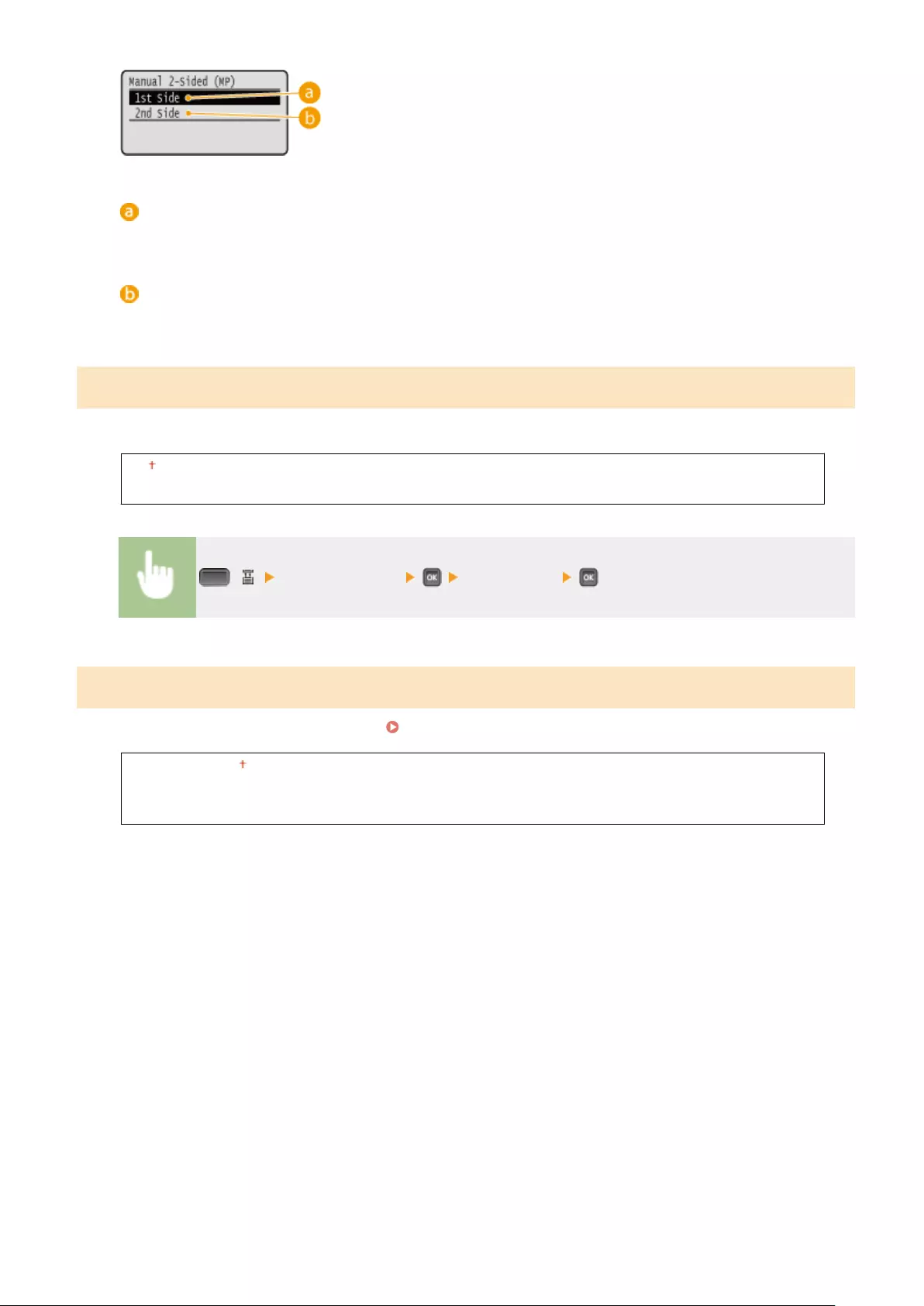
<1st Side>
Select to print on the front side (the side to print rst).
<2nd Side>
Select to print on the back side (the opposite of the side that is already printed).
2-Sided Printing
Select whether to print on both sides of paper.
Off
On
( ) <2-Sided Printing> <Off> or <On>
Select Drawer1 Model
Set the type of the cassette to use as drawer 1. Specifying the Type of Drawer 1(P. 60)
Standard Drawer
Custom Media Drawer
A5 Drawer
Setting Menu List
459

Troubleshooting
Troubleshooting ............................................................................................................................................. 461
Clearing Jams ..................................................................................................................................................... 463
When an Error Message Appears ..................................................................................................................... 480
Common Problems ............................................................................................................................................ 497
Installation/Settings Problems ..................................................................................................................... 498
Printing Problems ......................................................................................................................................... 501
When You Cannot Print Properly ...................................................................................................................... 503
Printing Results Are Not Satisfactory ............................................................................................................ 505
Paper Creases or Curls ................................................................................................................................. 511
Paper Is Fed Incorrectly ................................................................................................................................ 513
When a Problem Cannot Be Solved .................................................................................................................. 514
Troubleshooting
460
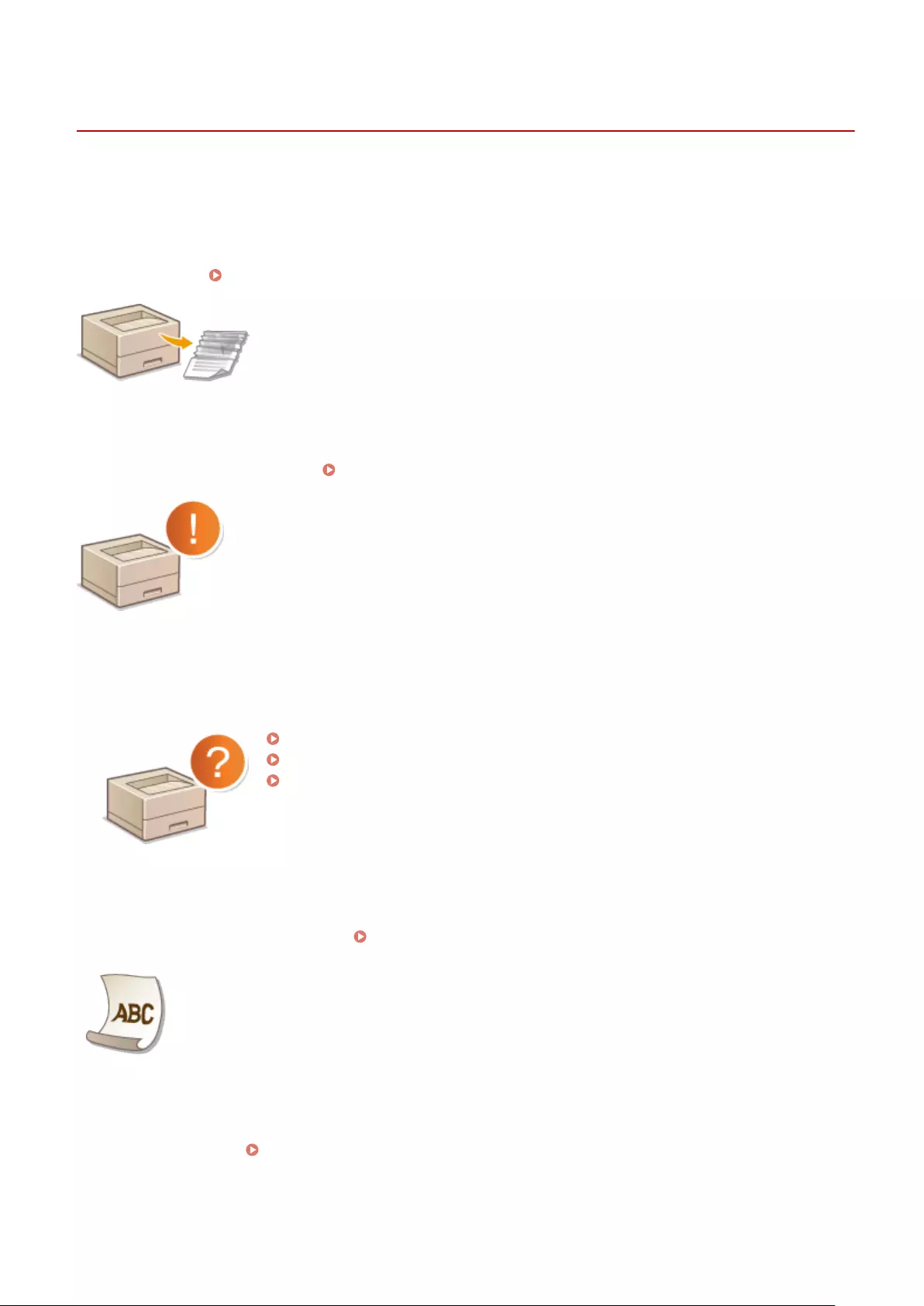
Troubleshooting
0X7U-065
When a problem occurs, check this chapter to nd out solutions before contacting Canon.
◼Paper Jams
If a paper jams, see Clearing Jams(P. 463) to remove the jammed paper.
◼A Message Appears
If the screen displays a message, see When an Error Message Appears(P. 480) .
◼Common Problems
If you suspect that the machine is malfunctioning, see the following sections before contacting Canon.
Common Problems(P. 497)
Installation/Settings Problems(P. 498)
Printing Problems(P. 501)
◼Printing Results are Not Satisfactory
If printing results are not satisfactory, see When You Cannot Print Properly(P. 503) .
◼When a Problem Cannot Be Solved
If a problem persists, see When a Problem Cannot Be Solved(P. 514) to nd out where to contact.
Troubleshooting
461
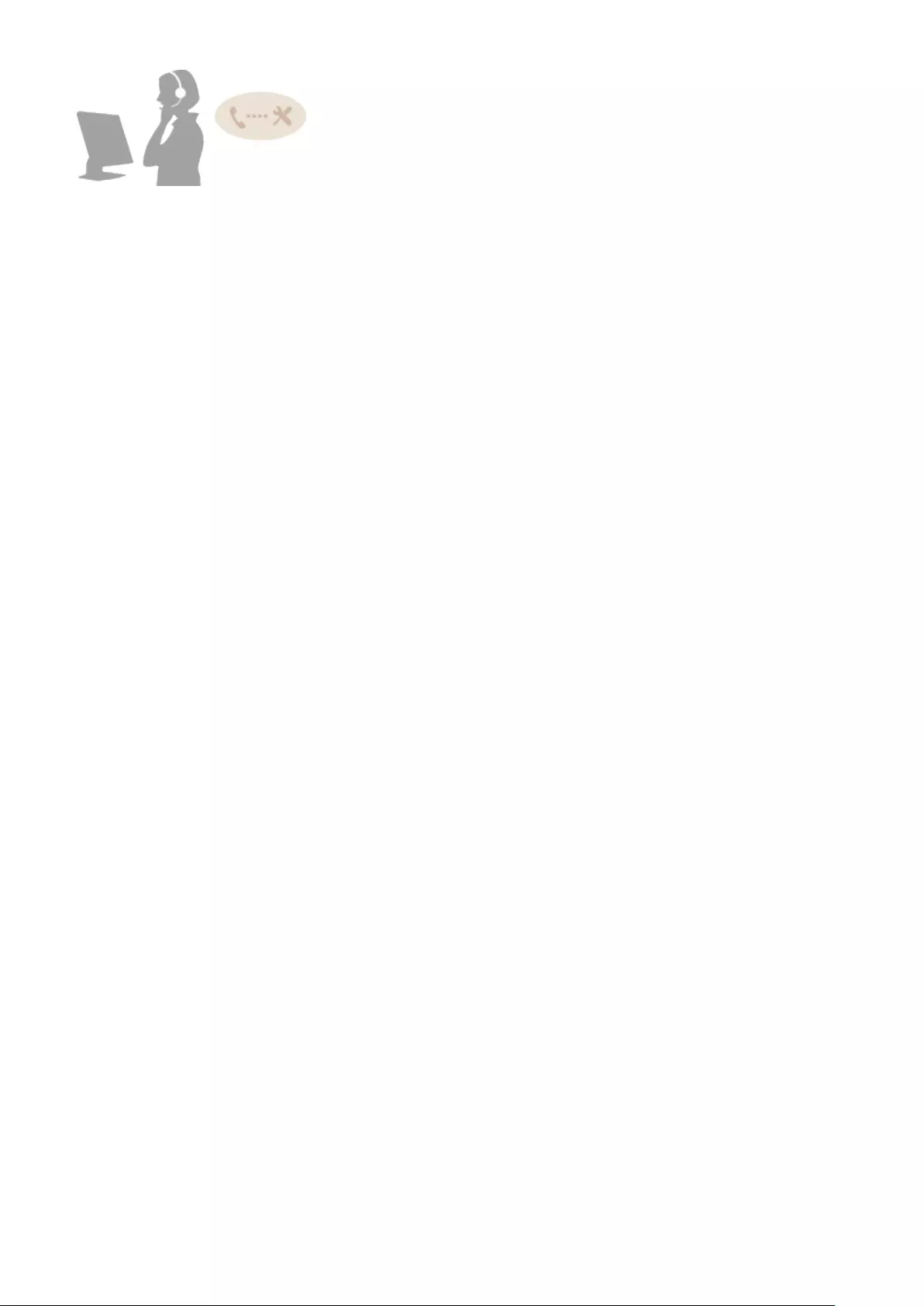
Troubleshooting
462

Clearing Jams
0X7U-066
If a paper jam occurs, an alarm beep sound is generated and a paper jam location is indicated on the screen. Press
to display simple solutions. If it is dicult to understand the procedures on the display, see the following sections to
clear jams. If a paper jam occurs in multiple locations at the same time, check all messages that are displayed.
Carefully read the precautions in Important Safety Instructions(P. 2) before you start clearing paper jams.
●<MP tray area>
Paper Jams in the Multi-Purpose Tray(P. 464)
●<Drawer N area> (N=1, 2, 3, 4, 5)
Paper Jams in the Paper Drawer or the Optional Paper Deck (P. 464)
●<2-sided unit area>
Paper Jams in the Duplex Unit(P. 467)
●<Back cover area>
Paper Jams in the Back Side(P. 472)
●<Top cover area>
Paper Jams inside the Machine(P. 473)
●<Output tray area>
Paper Jams in the Optional Envelope Feeder(P. 477)
When removing the jammed paper, do not turn OFF the machine
●Turning OFF the machine deletes the data that is being printed.
If paper tears
●Remove all the paper fragments to prevent them from becoming jammed.
If paper jams repeatedly
●Tap the paper stack on a at surface to even the edges of the paper before loading it into the machine.
●Check that the paper is appropriate for the machine. Paper(P. 569)
●Check that no jammed paper fragments remain in the machine.
●If a paper jam occurs during printing on the back side of the paper that is already printed (manual 2-sided
printing), select the [Print on the Other Side] check box in the [Paper Source] tab of the printer driver.
Do not forcibly remove the jammed paper from the machine
●Forcibly removing the paper may damage parts. If you are not able to remove the paper,contact your local
authorized Canon dealer or the Canon help line. When a Problem Cannot Be Solved(P. 514)
Troubleshooting
463

Paper Jams in the Multi-Purpose Tray
If there is paper loaded in the tray, remove it rst. If the jammed paper cannot be removed easily, do not forcibly pull it
out, but follow the procedure for a different paper jam location indicated by the message.
1Gently pull out the paper.
2Open and close the top cover.
●When the top cover is opened and closed, the paper jam message disappears.
1Open the top cover.
●Hold the handle on the left side, and open the top cover.
2Close the top cover.
When the message is still displayed
●Paper may be jammed in other locations. Check other locations, and remove jammed paper if any. If the
message is still displayed, check whether the top cover is securely closed.
Paper Jams in the Paper Drawer or the Optional Paper Deck
If the jammed paper cannot be removed easily, do not forcibly pull it out, but follow the procedure for a different
paper jam location indicated by the message.
◼Paper Jams in the Paper Drawer
1Pull out the paper drawer until it stops, and remove it while lifting the front side.
Troubleshooting
464
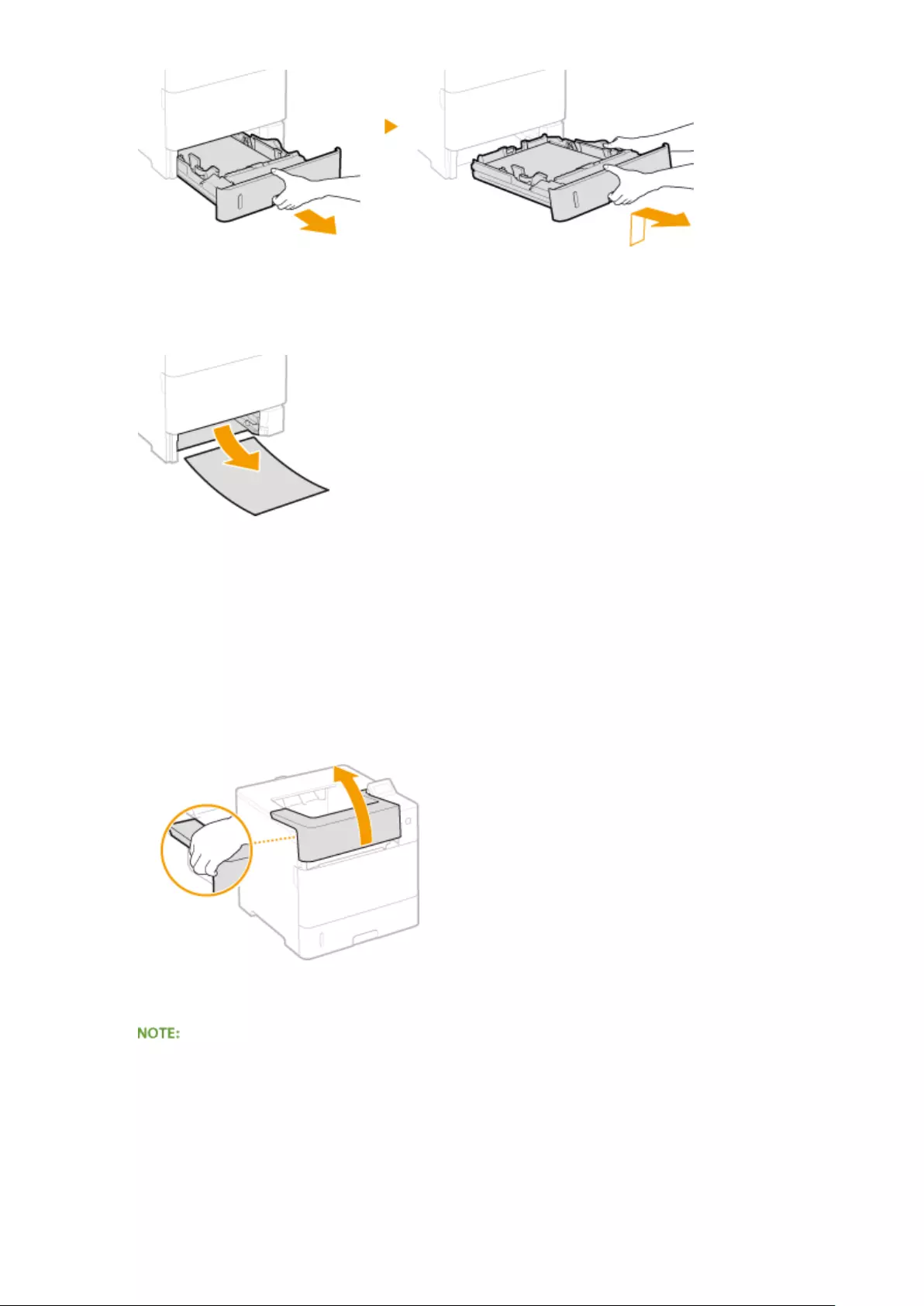
2Gently pull out the paper.
●When the optional paper feeder(drawer 2) is attached, gently pull out the paper in the same way.
3Set the paper drawer.
4Open and close the top cover.
●When the top cover is opened and closed, the paper jam message disappears.
1Open the top cover.
●Hold the handle on the left side, and open the top cover.
2Close the top cover.
When the message is still displayed
●Paper may be jammed in other locations. Check other locations, and remove jammed paper if any. If the
message is still displayed, check whether the top cover is securely closed.
Troubleshooting
465
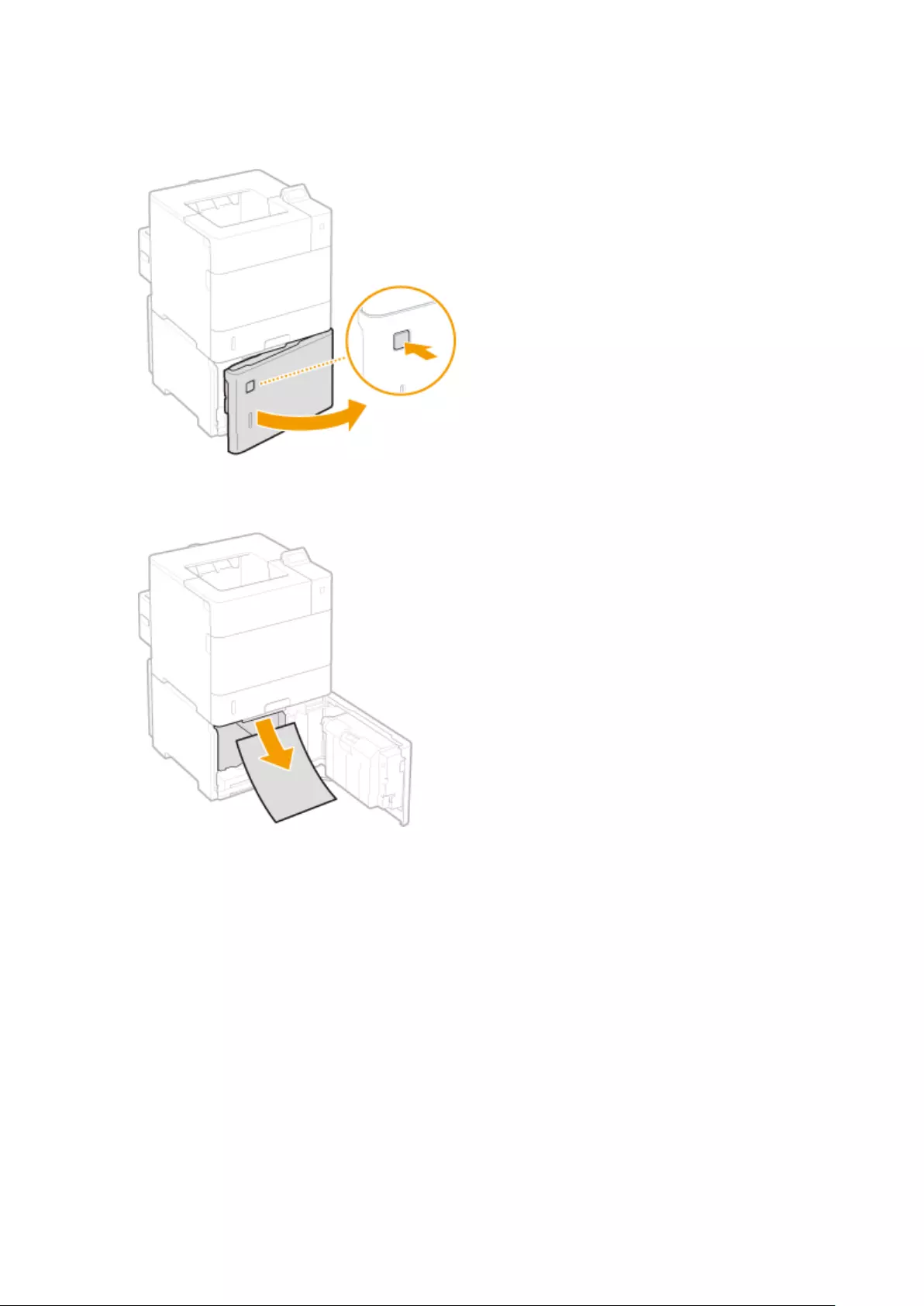
◼Paper Jams in the Optional Paper Deck
1Press the button to open the door.
2Gently pull out the paper.
3Close the door.
4Open and close the top cover.
●When the top cover is opened and closed, the paper jam message disappears.
1Open the top cover.
●Hold the handle on the left side, and open the top cover.
Troubleshooting
466
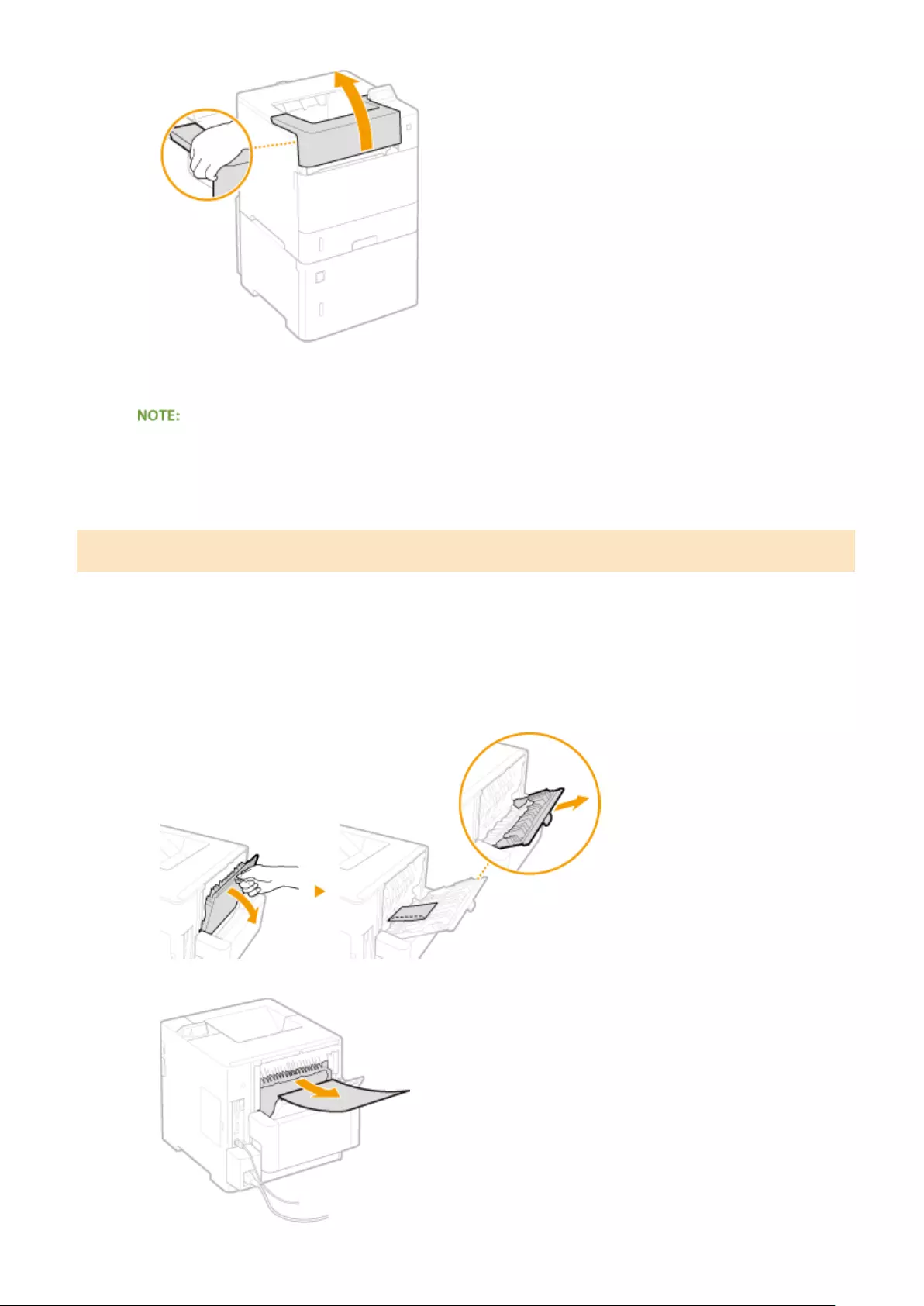
2Close the top cover.
When the message is still displayed
●Paper may be jammed in other locations. Check other locations, and remove jammed paper if any. If the
message is still displayed, check whether the top cover is securely closed.
Paper Jams in the Duplex Unit
Do not forcibly remove jammed paper from the machine. If the jammed paper cannot be removed easily, proceed to
the next step.
1Check whether paper is jammed inside the rear cover.
1Open the rear cover.
2Gently pull out the paper.
Troubleshooting
467
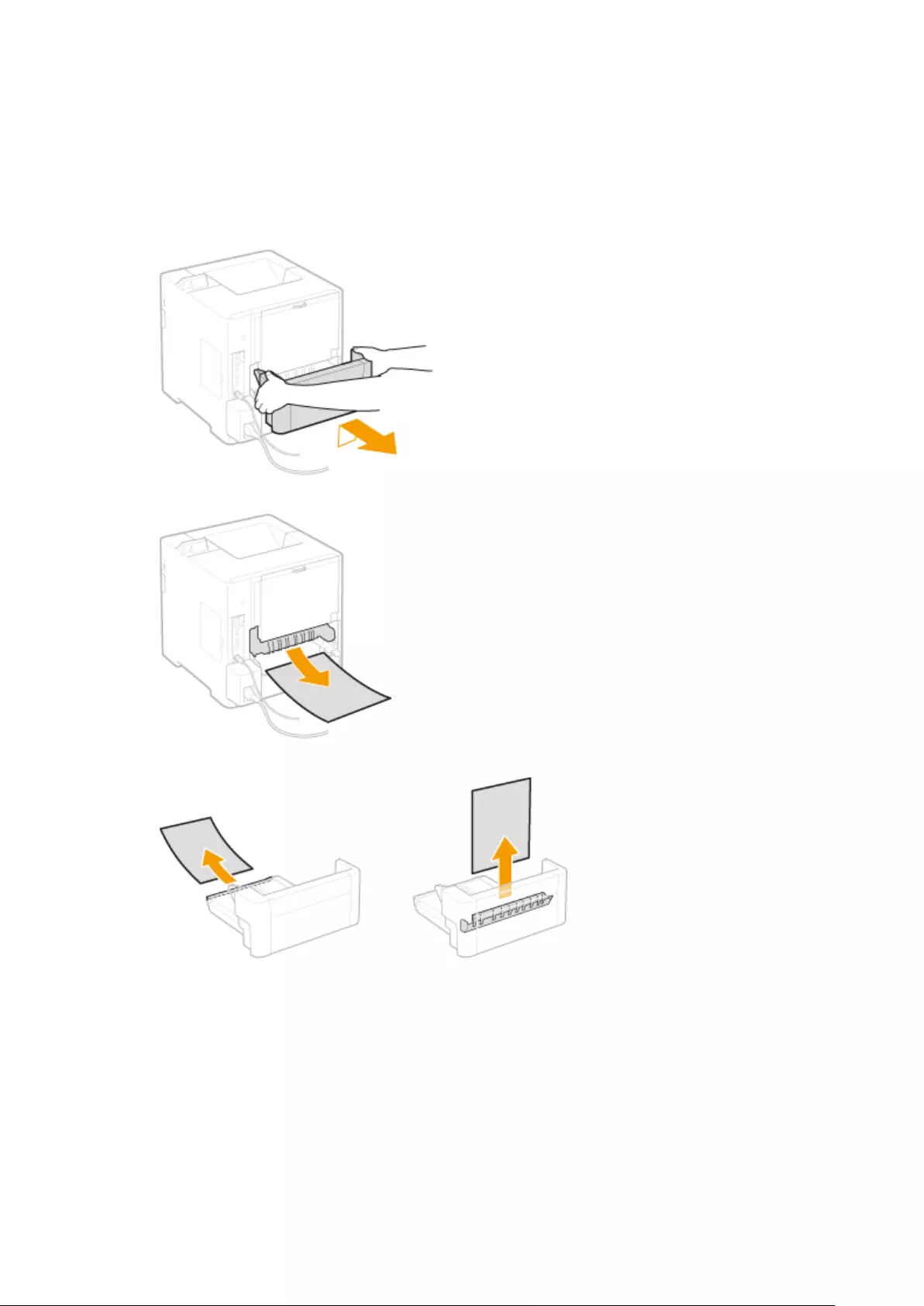
3Close the rear cover.
2Remove the jammed paper in the duplex unit.
1Pull out the duplex unit
●Hold the handles on the left and right sides, and pull out the duplex unit.
2Gently pull out the paper.
3Gently pull out the jammed paper from the duplex unit.
4Replace the duplex unit back in place.
3Remove the jammed paper inside the top cover.
1Open the top cover.
●Hold the handle on the left side, and open the top cover.
Troubleshooting
468
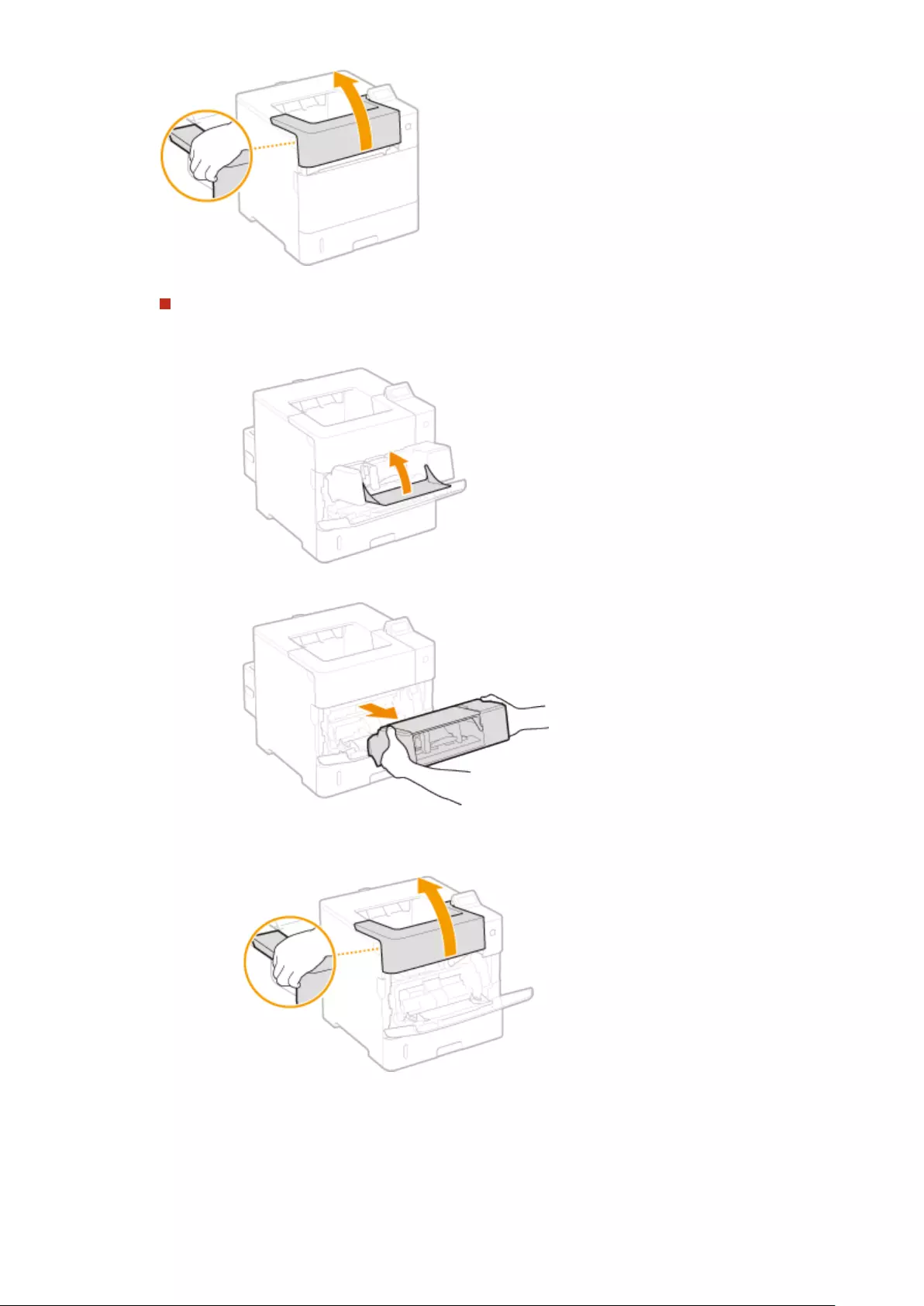
When the optional envelope feeder is installed
1Close the envelope feeder cover.
2Remove the envelope feeder.
3Open the top cover.
●Hold the handle on the left side, and open the top cover.
2Remove the toner cartridge.
Troubleshooting
469
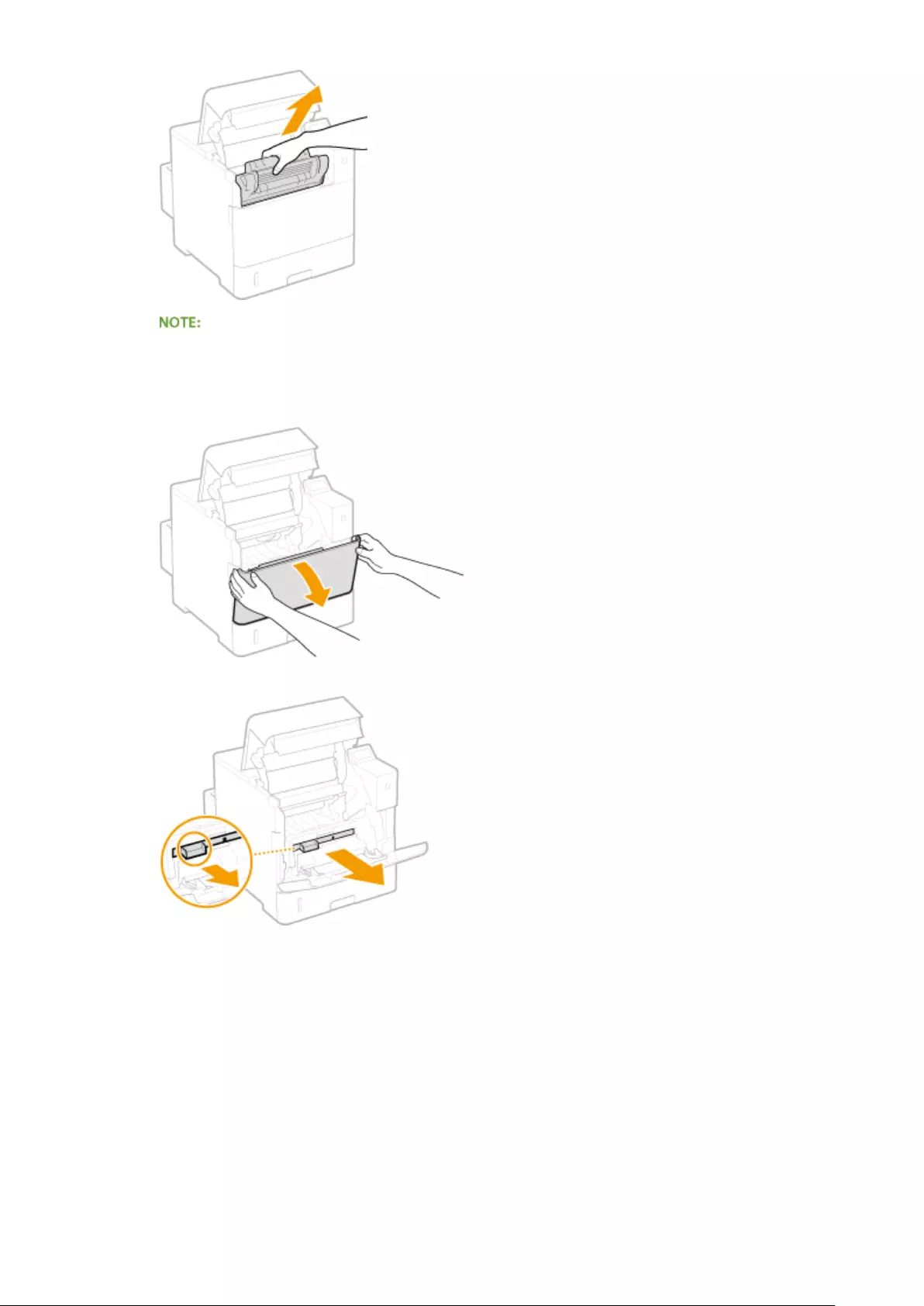
●When the envelope feeder had been installed, skip to step 5.
3Open the cover of the multi-purpose tray.
●Hold the left and right side handles, and open the cover.
4Remove the envelope feeder cover.
5Hold the front side green knob and lift the transport guide.
●Keep holding the transport guide until returning it to the original position in step 7.
Troubleshooting
470
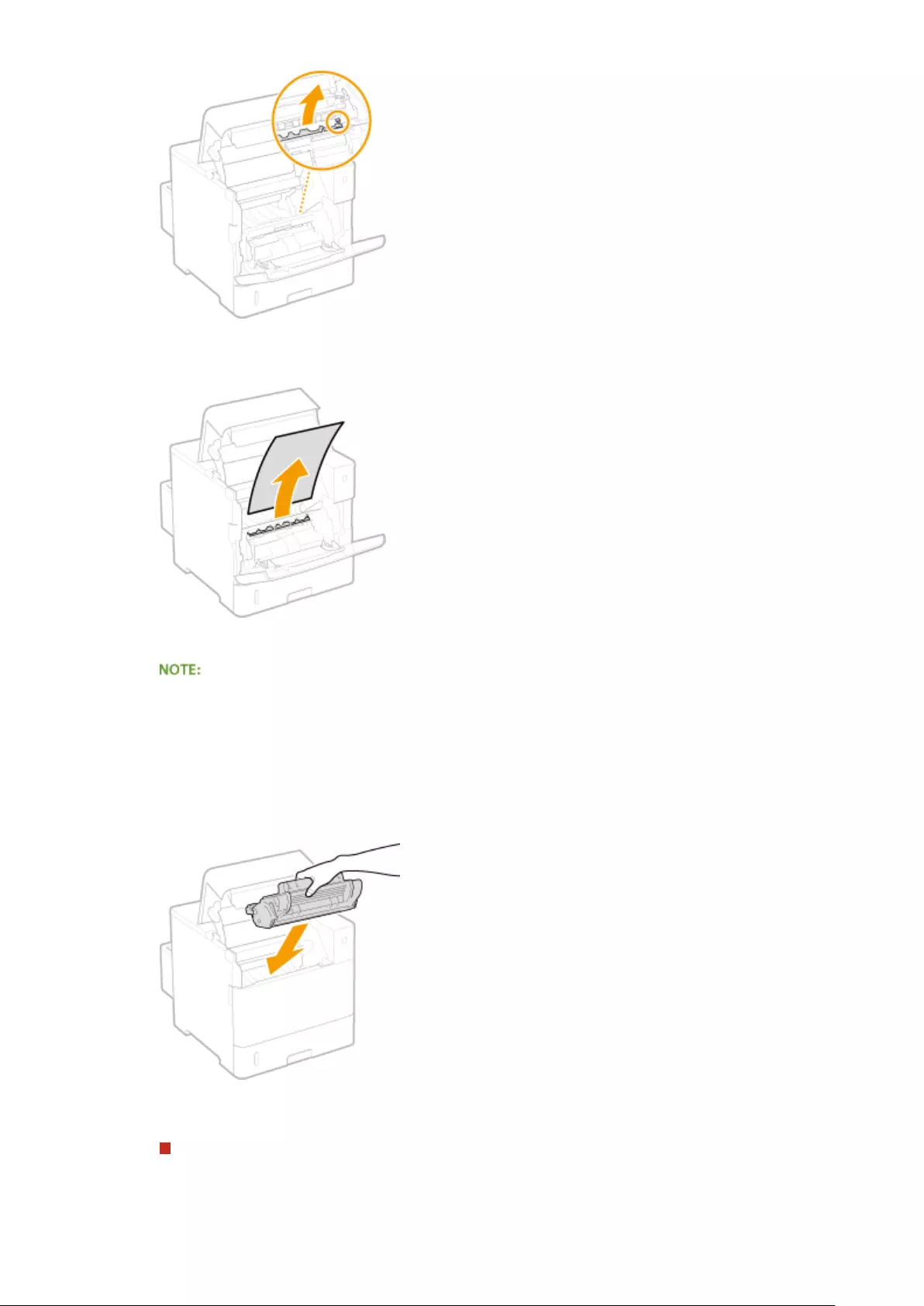
6Gently pull out the paper.
●Pull out the paper atly as much as possible to prevent unxed toner from being dropped.
7Gently return the transport guide back in place.
●When the envelope feeder had been installed, skip to step 10.
8Replace the envelope feeder cover back in place.
9Close the cover of the multi-purpose tray.
10 Install the toner cartridge.
●Make sure to push in the cartridge until it stops.
11 Close the top cover.
When the envelope feeder had been installed
1Replace the envelope feeder back in place.
Troubleshooting
471
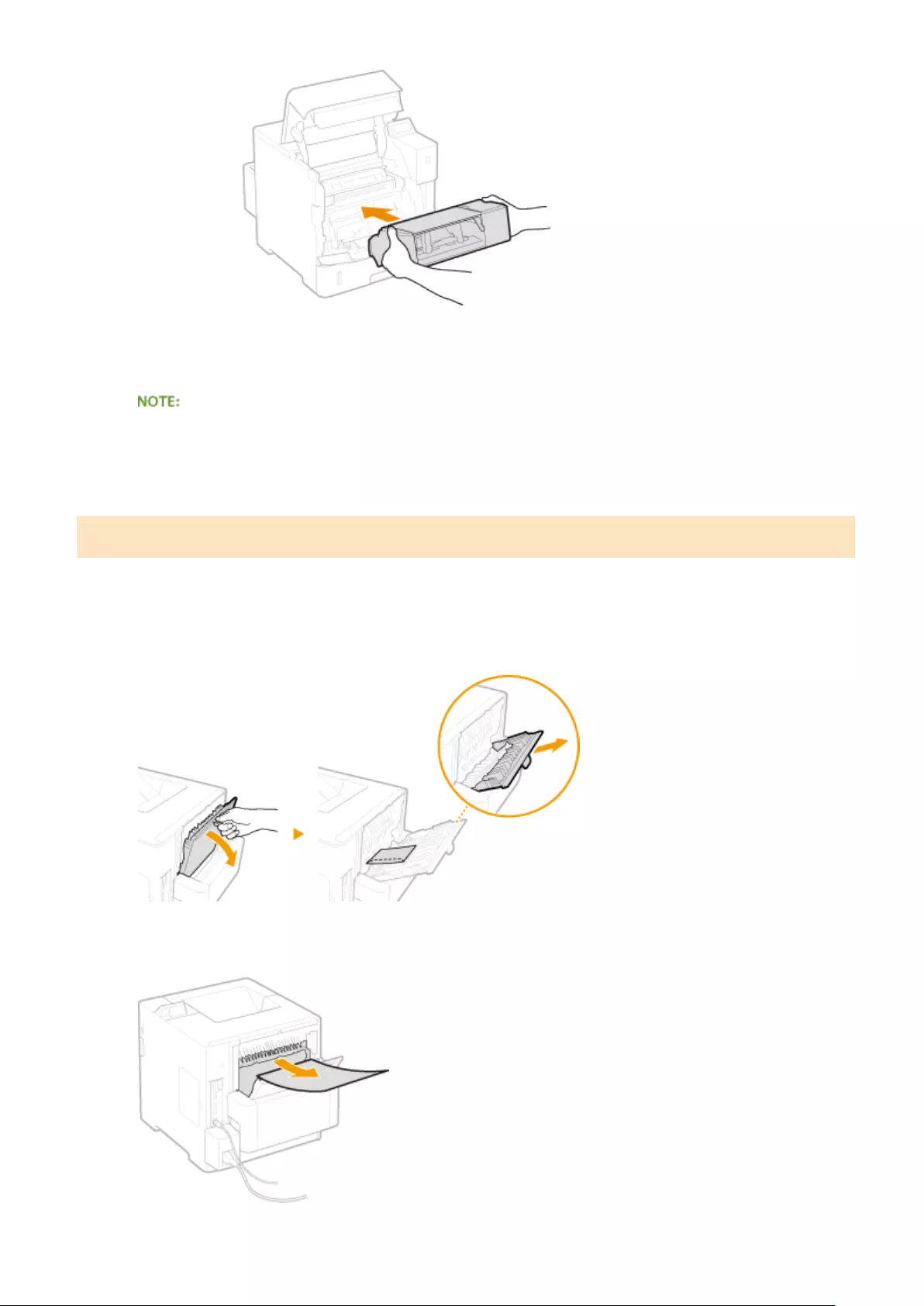
2Close the top cover.
When the message is still displayed
●Paper may be jammed in other locations. Check other locations, and remove jammed paper if any. If the
message is still displayed, check whether the top cover is securely closed.
Paper Jams in the Back Side
If the jammed paper cannot be removed easily, do not forcibly pull it out, but follow the procedure for a different
paper jam location indicated by the message.
1Open the rear cover.
2Gently pull out the paper.
Troubleshooting
472
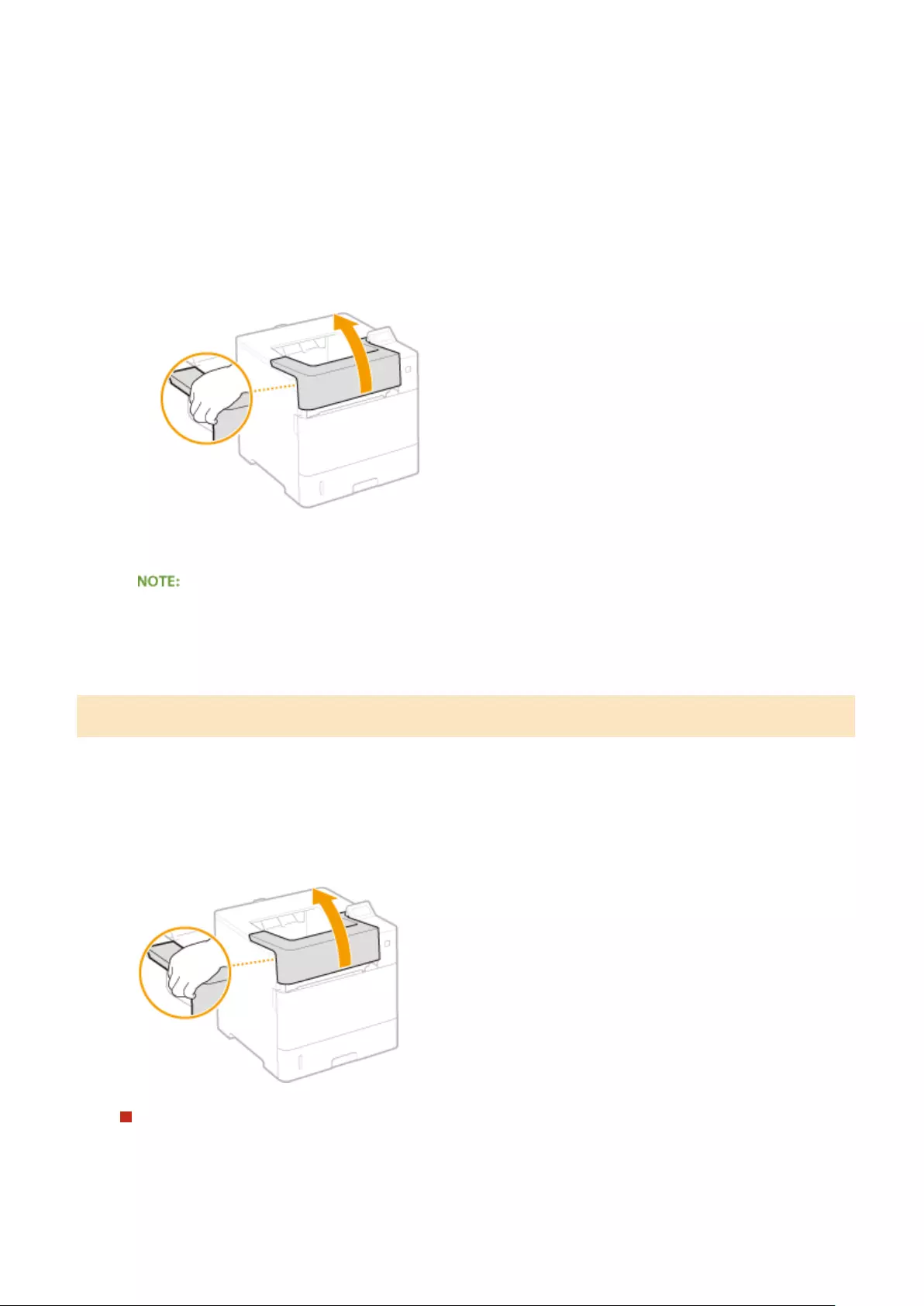
3Close the rear cover.
4Open and close the top cover.
●When the top cover is opened and closed, the paper jam message disappears.
1Open the top cover.
●Hold the handle on the left side, and open the top cover.
2Close the top cover.
When the message is still displayed
●Paper may be jammed in other locations. Check other locations, and remove jammed paper if any. If the
message is still displayed, check whether the top cover is securely closed.
Paper Jams inside the Machine
If the jammed paper cannot be removed easily, do not forcibly pull it out, but follow the procedure for a different
paper jam location indicated by the message.
1Open the top cover.
●Hold the handle on the left side, and open the top cover.
When the optional envelope feeder is installed
1Close the envelope feeder cover.
Troubleshooting
473

2Remove the envelope feeder.
3Open the top cover.
●Hold the handle on the left side, and open the top cover.
2Remove the toner cartridge.
●When the envelope feeder had been installed, skip to step 4.
3Open the cover of the multi-purpose tray.
Troubleshooting
474
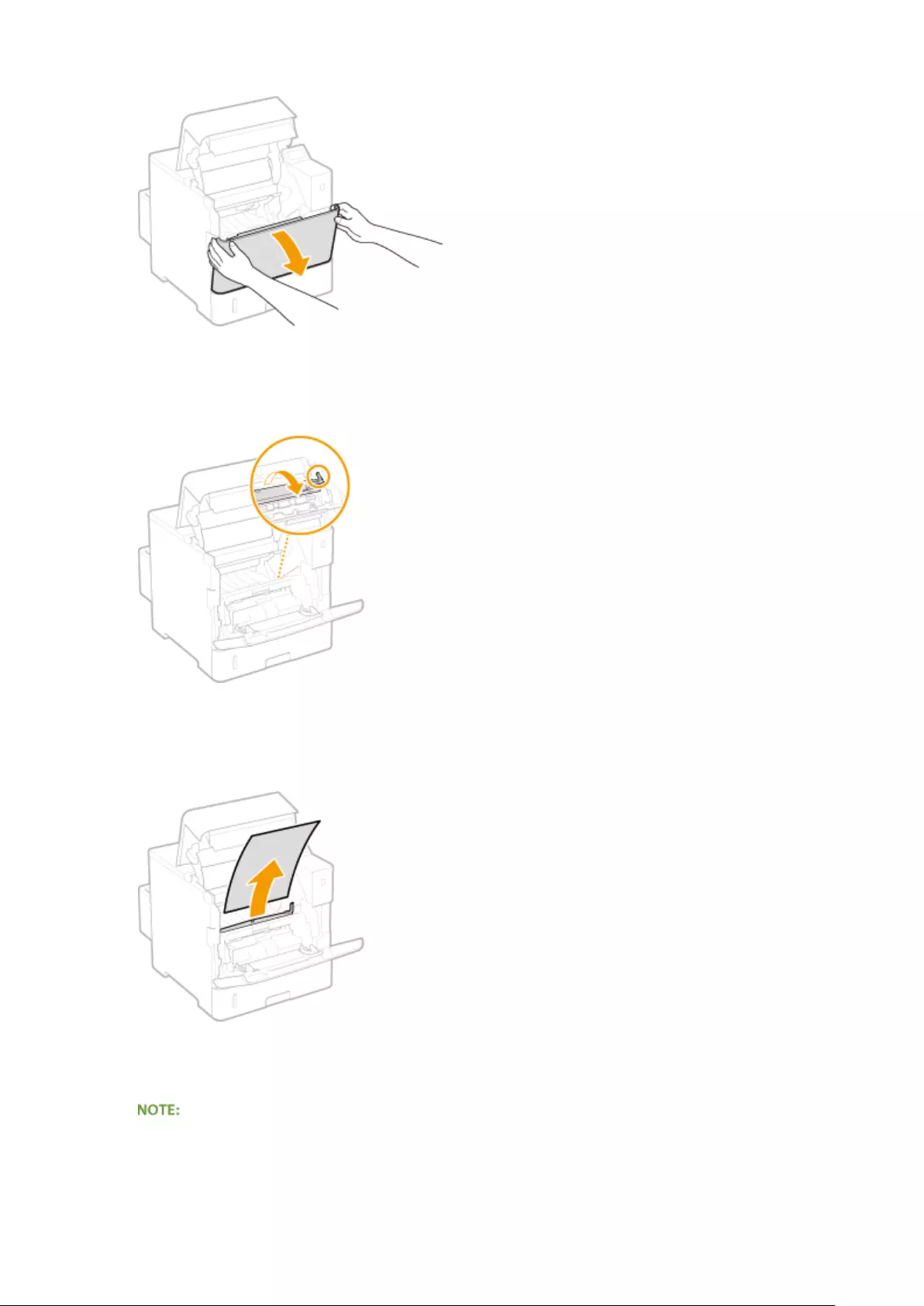
●Hold the left and right side handles, and open the cover.
4Hold the back side green knob and lift the transport guide.
●Keep holding the transport guide until returning it to the original position in step 6.
5Gently pull out the paper.
●Pull out the paper atly as much as possible to prevent unxed toner from being dropped.
6Gently return the transport guide back in place.
●When the envelope feeder had been installed, skip to step 8.
7Hold the handle of the envelope feeder cover, and remove the cover.
Troubleshooting
475
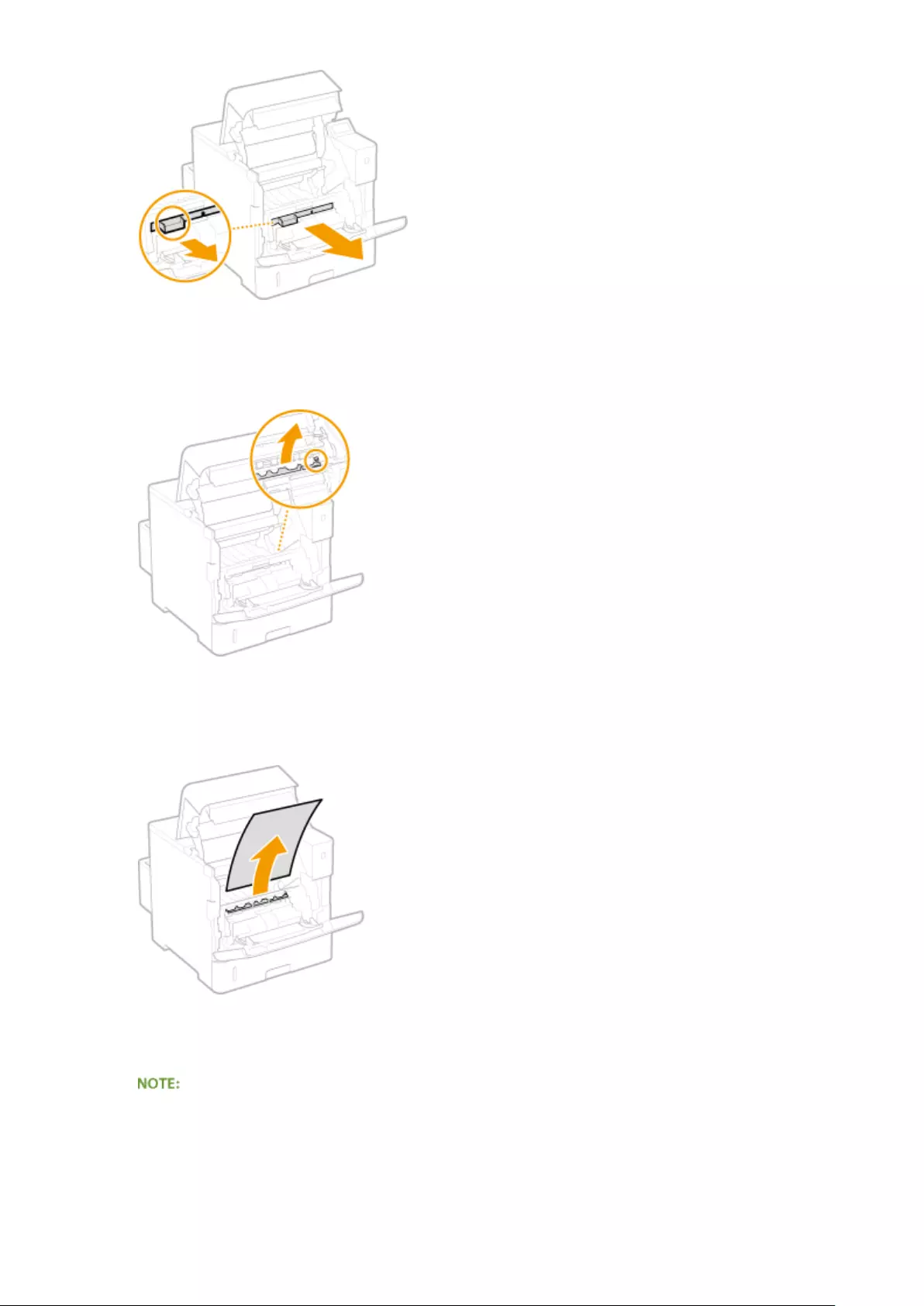
8Hold the front side green knob and lift the transport guide.
●Keep holding the transport guide until returning it to the original position in step 10.
9Gently pull out the paper.
●Pull out the paper atly as much as possible to prevent unxed toner from being dropped.
10 Gently return the transport guide back in place.
●When the envelope feeder had been installed, skip to step 13.
11 Replace the envelope feeder cover back in place.
Troubleshooting
476
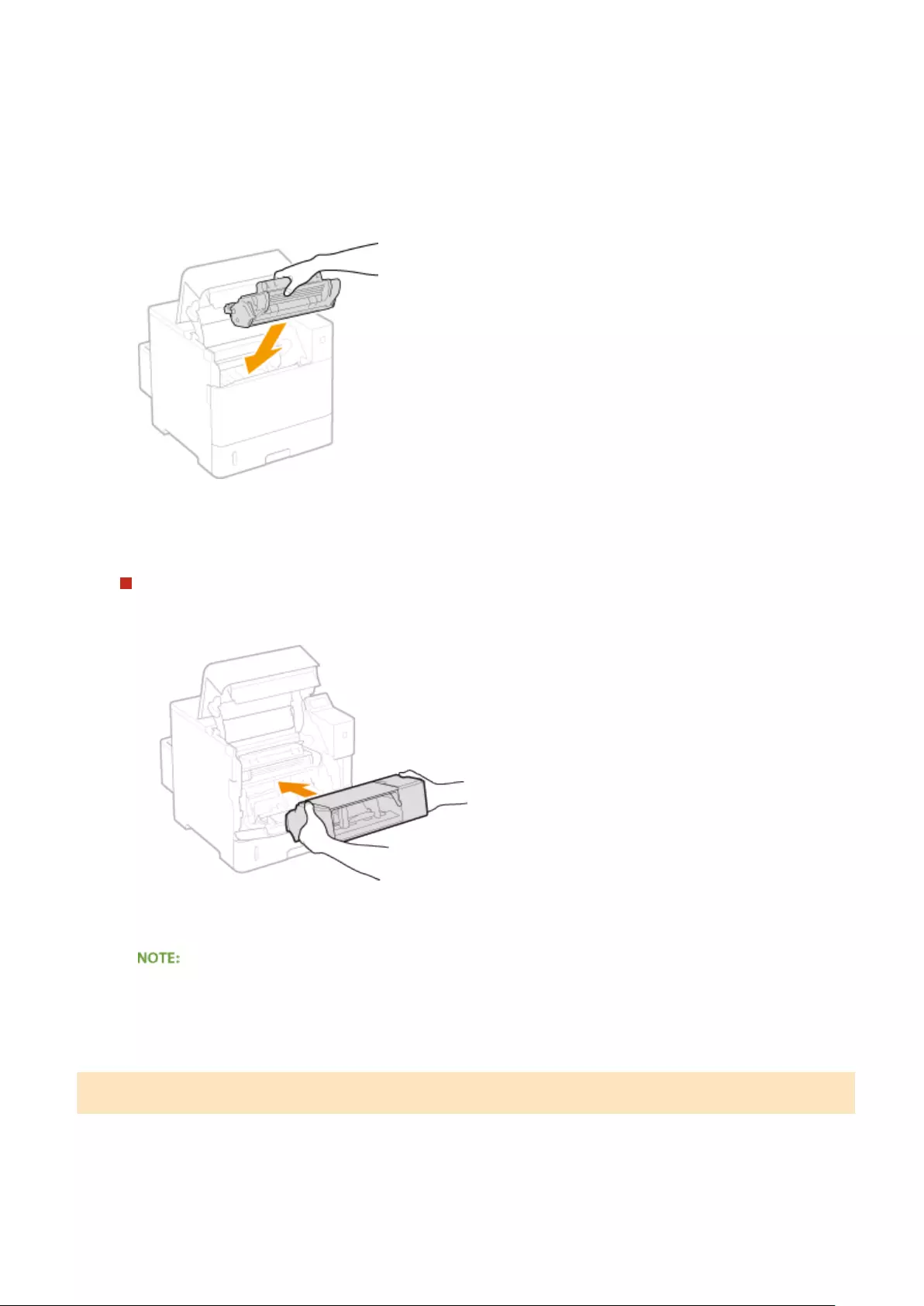
12 Close the cover of the multi-purpose tray.
13 Install the toner cartridge.
●Make sure to push in the cartridge until it stops.
14 Close the top cover.
When the envelope feeder had been installed
1Replace the envelope feeder back in place.
2Close the top cover.
When the message is still displayed
●Paper may be jammed in other locations. Check other locations, and remove jammed paper if any. If the
message is still displayed, check whether the top cover is securely closed.
Paper Jams in the Optional Envelope Feeder
When paper is loaded in the envelope feeder, rst remove the loaded paper before starting the following procedure. If
the jammed paper cannot be removed easily, do not forcibly remove it from the machine, but follow the procedure for
another location indicated by the message.
Troubleshooting
477

1Close the envelope feeder cover.
2Remove the envelope feeder.
3Gently pull out the jammed paper from the envelope feeder.
4Open the top cover.
●Hold the handle on the left side, and open the top cover.
Troubleshooting
478

5Gently pull out the paper.
6Replace the envelope feeder back in place.
7Close the top cover.
When the message is still displayed
●Paper may be jammed in other locations. Check other locations, and remove jammed paper if any. If the
message is still displayed, check whether the top cover is securely closed.
Troubleshooting
479
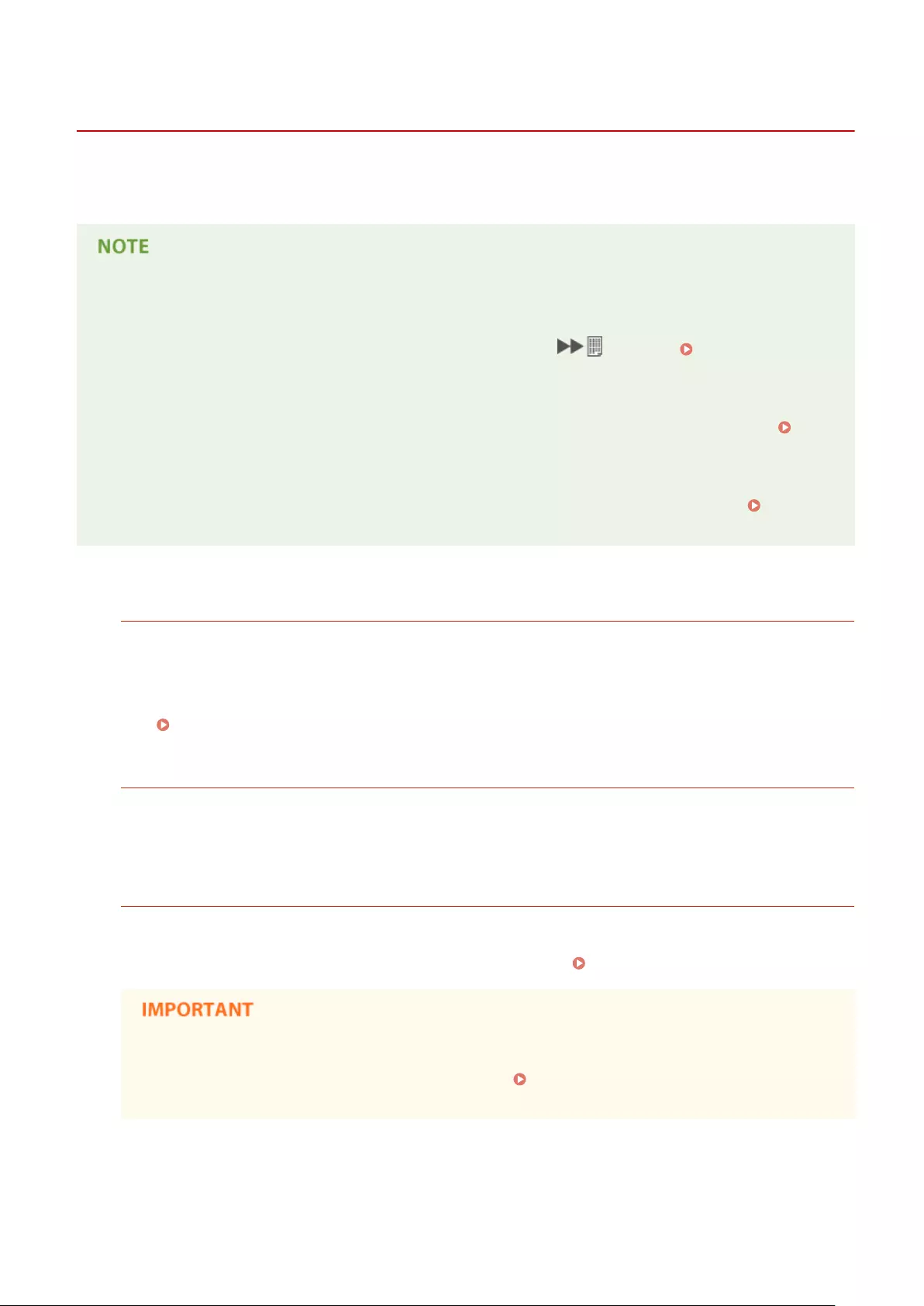
When an Error Message Appears
0X7U-067
If an abnormality occurs in the print processing or the memory is full, or you encounter operation problems, a
message appears on the display. Find out more information about messages in the following list.
Auto Continue
●If you set <Auto Skip Error> to <On> in the setting menu of the operation panel, the printing is continued
with the error skipped regarding the error messages marked with in the list ( Auto Skip
Error(P. 364) ). If the error skip causes missing print data or improper printouts, print the le again.
To cancel printing
●When you want to cancel the current printing regardless of the error message, perform a soft reset. Soft
Reset(P. 451)
About <Show Warnings>
●You can specify settings not to display some messages showing that printing can be continued. Show
Warnings(P. 365)
16 Tnr cart. will soon reach end of lifetime.
The replacement time for the toner cartridge is near.
●Make sure that you have a replacement toner cartridge ready.
●Replace the toner cartridge if you see this message before you start to print a large job.
Replacing Toner Cartridges(P. 521)
1F Output tray is full.
Too much paper is on the output tray.
●Remove the paper from the output tray.
1G Change toner cartridge recommended.
The toner cartridge has reached the end of its lifetime.
●Replacing the toner cartridge with a new one is recommended. Replacing Toner Cartridges(P. 521)
●You can continue printing when this message is displayed, but the print quality may deteriorate.
●Receiving e-mail and fax documents will be disabled. Printing Received E-mail (E-Mail Print)
(P. 157)
Troubleshooting
480

51 Print settings error.
Printing data containing an unavailable paper type or width has been attempted with <Resolution> set
to <1200 dpi>.
●Set <Resolution> to <600 dpi> and print the data again. Resolution(P. 399)
●Press ( ) to cancel the print job since the data is not available for printing.
55 SD Card error.
An error has occurred in the SD card.
●Shut down the machine, remove the SD card, and install it again.
Turning ON/OFF the Power(P. 33)
Installing an SD Card(P. 583)
●You can press ( ) to continue printing, but <SD Card> will be changed to <Off>. SD
Card(P. 369)
56 SD Card error.
An error has occurred in the SD card.
●Shut down the machine, wait for 10 seconds or more, and turn ON the power again.
Turning ON/OFF the Power(P. 33)
●Format the SD card.
SD Card Maintenance(P. 410)
80 Initializing MEAP. Do not turn power OFF.
You have tried to shut down the machine while MEAP was being initialized.
●When the MEAP initialization is complete, this message is automatically removed. Wait until the message
is removed.
80 Preparing MEAP... Do not turn power OFF.
You have tried to shut down the machine while MEAP was preparing for operation.
●When MEAP is ready for operation, this message is automatically removed. Wait until the message is
removed.
A4 nn Error (nn: 2-digit alphanumeric)
An abnormality has occurred in the machine, resulting in malfunction.
●Shut down the machine, wait for 10 seconds or more, and turn ON the power again.
Turning ON/OFF the Power(P. 33)
A5 nn Error (nn: 2-digit alphanumeric)
An abnormality has occurred in the machine, resulting in malfunction.
Troubleshooting
481
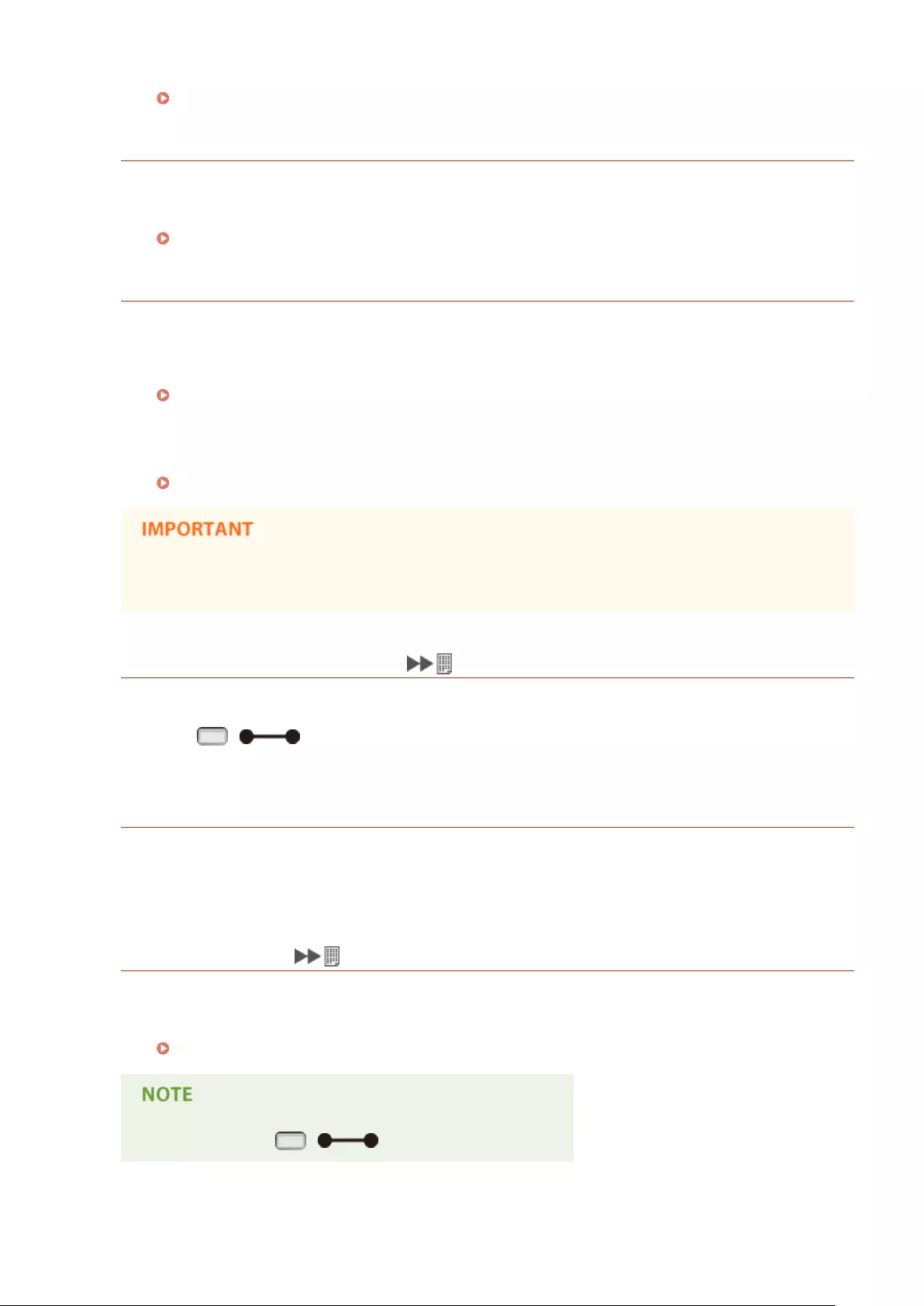
●Shut down the machine, wait for 10 seconds or more, and turn ON the power again.
Turning ON/OFF the Power(P. 33)
A7 nn ERROR (nn: 2-digit alphanumeric)
An abnormality has occurred in the machine, resulting in malfunction.
●Shut down the machine, wait for 10 seconds or more, and turn ON the power again.
Turning ON/OFF the Power(P. 33)
Amount in cart. cannot be displ. correctly.
A toner cartridge may be set that cannot guarantee print quality because it has reached the end of its
lifetime or for other reasons.
●Replacing the toner cartridge with a new one is recommended.
Replacing Toner Cartridges(P. 521)
The toner cartridge used may not be a genuine Canon product.
●Only genuine Canon toner cartridges should be used as replacement toner cartridges.
Consumables(P. 573)
●You can continue printing when this message is displayed, but the print quality may deteriorate.
Doing so may result in damage to the machine.
An error occurred while receiving.
Unanalyzable data has been received or a timeout error has occurred during receipt of print data.
●Press ( ) to cancel the print job, and print the le again.
●Check the status of the network that you are using because the network may have a problem.
BT Clock error.
The clock built in the machine has a failure.
●You can continue printing with the clock left faulty, but logs including the print log will not be generated
properly. Contact your local authorized Canon dealer.
Cannot decode data.
Data for Encrypted Print has failed in analysis.
●Perform a soft reset, and print the le again.
Soft Reset(P. 451)
●When you press ( ), the print job is canceled.
Troubleshooting
482
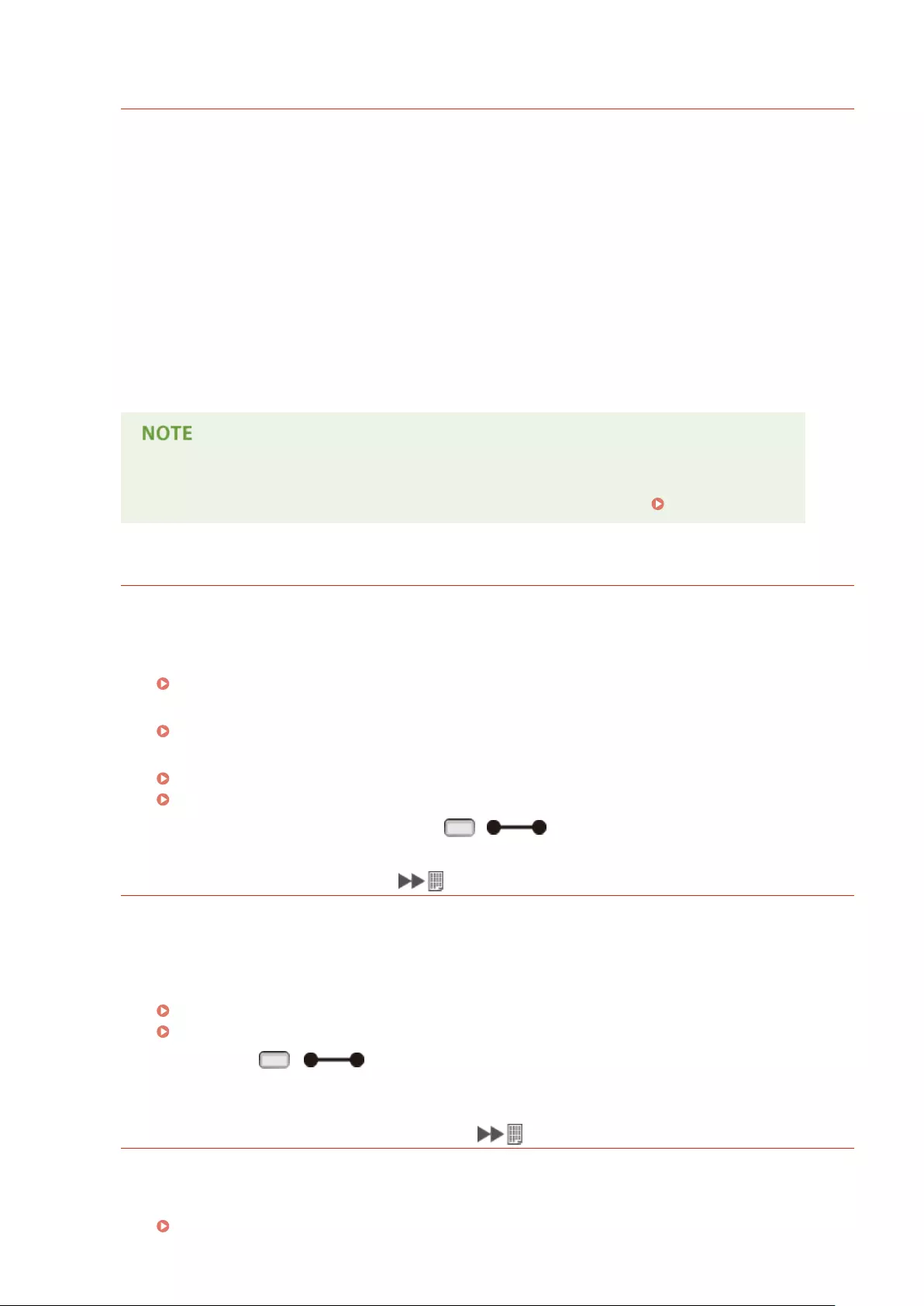
Cannot decode PDF data.
An incorrect password has been entered for PDF data printing.
●Print the le again with the correct password.
PDF data printing is not permitted by the security settings.
●Change the settings to permit printing, and print the le again.
The PDF le is linked to the policy server, but the machine cannot access the server.
●Make sure that the policy server is turned ON and the network to which the machine and the policy server
are connected is normal, and print the le again.
The encryption algorithm being used is not supported by the machine.
●Use the PDF data in the format supported by the machine.
●The machine supports the PDF encryption algorithm of RC4 128bit/AES 128bit/AES 256bit.
●To remove the error message, perform a soft reset to cancel the print job. Soft Reset(P. 451)
Cannot feed paper.
The specied paper size or paper type is not available for paper feeding.
●Set <Paper Source> to the paper source where the paper matching the specied paper size/type is loaded
or to <Auto>.
Paper Source(P. 453)
●Load the specied paper in the selected paper source.
Loading Paper(P. 37)
●Properly specify the <Standard Paper Size> and <Default Paper Type> settings.
Standard Paper Size(P. 455)
Default Paper Type(P. 457)
●To forcibly print on the loaded paper, press ( ).
Cannot perform 2-Sided Printing.
The machine has received print data for a paper size (including orientation) or paper type that is not
available for automatic 2-sided printing.
●Perform a soft reset, specify the paper size or paper type available for automatic 2-sided printing, and
print the le again.
Soft Reset(P. 451)
Paper(P. 569)
●You can press ( ) to continue printing. However, 2-sided printing data is printed on two
sheets in 1-sided printing mode.
Cannot print with the specied resolution.
The data is too complicated to print.
●Perform a soft reset, set <Resolution> to <600 dpi>, and print the le again.
Resolution(P. 399)
Troubleshooting
483
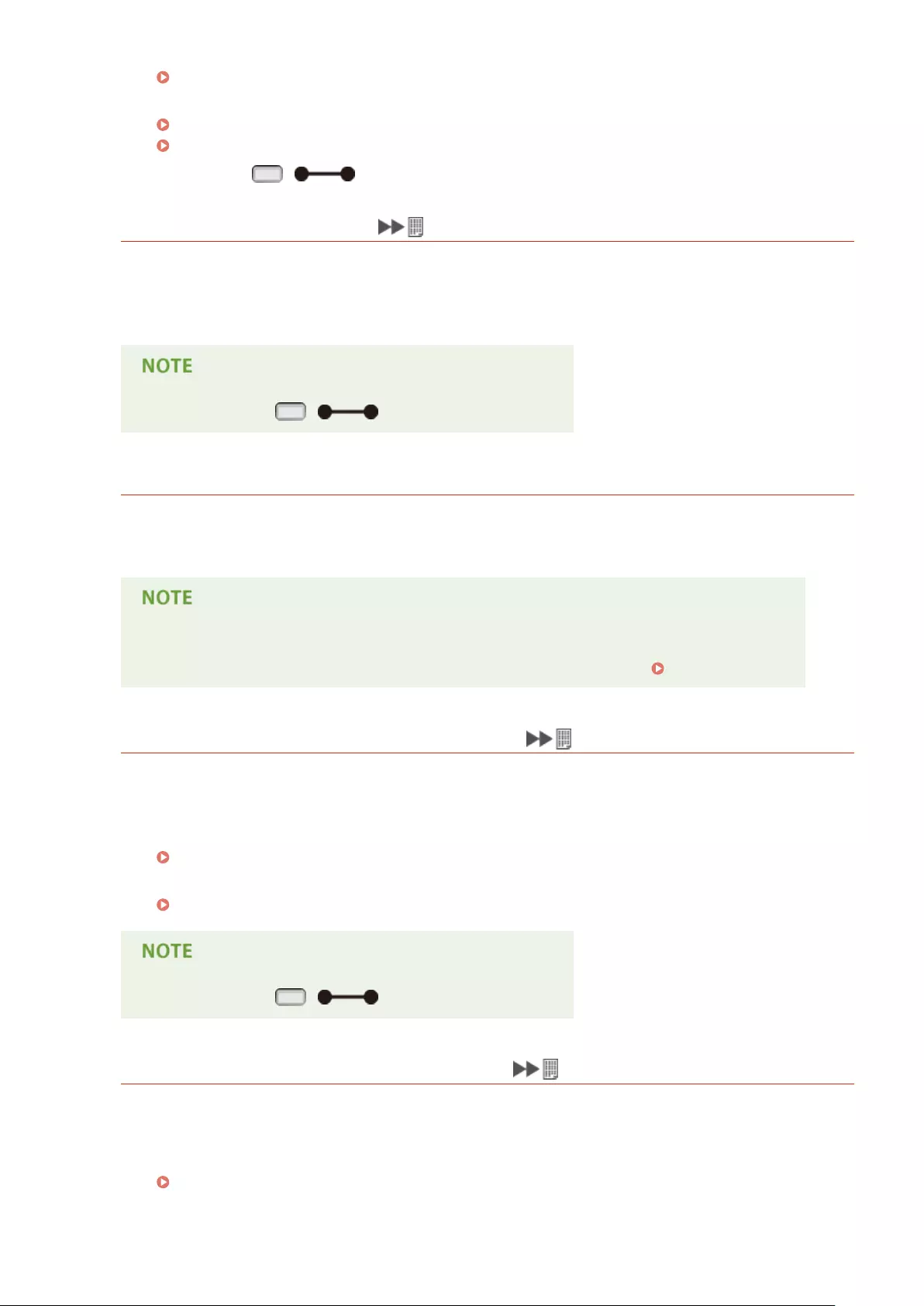
Soft Reset(P. 451)
●Perform a soft reset, set <Image Renement> to <Off>, and print the le again.
Image Renement(P. 400)
Soft Reset(P. 451)
●You can press ( ) to continue printing. However, the print quality is reduced.
Cannot print. Reg. Table is full.
The upper limit on the number of binders or documents in one print data item has been exceeded.
●The maximum number of binders and documents is 2 and 5, respectively, per print data item. Correct the
data, and print the le again.
●When you press ( ), the print job is canceled.
Cannot read PDF data.
An abnormality has occurred during PDF data read.
●Use the PDF data in the format supported by the machine.
●The machine supports the PDF version 1.7.
●To remove the error message, perform a soft reset to cancel the print job. Soft Reset(P. 451)
Cannot receive PDF data. Set the receivable size.
Free space is insucient to perform Direct Print for the PDF le.
●Optimize the PDF le to reduce its size or retry printing after dividing the le.
●Install the SD card, and then resend the data to the machine.
Installing an SD Card(P. 583)
●Send the data from the USB memory device to the machine.
Printing from USB Memory (USB Direct Print)(P. 120)
●When you press ( ), the print job is canceled.
Cannot start printing because job is restricted.
Normal printing has been attempted while the printing operations are restricted.
●Only Stored Job Print is available while the printing operations are restricted. Print the le again with the
settings to store data on the SD card.
Storing a Document in the Machine(P. 137)
Troubleshooting
484

●When you press ( ), the print job is canceled.
Cannot store.
The SD card is set to <Off>.
●Set <SD Card> to <On>, and send the print data again.
SD Card(P. 369)
The upper limit on the volume of data that can be stored on the SD card has been exceeded.
●A maximum of 1000 data items can be stored in the machine. Delete unnecessary stored data.
Deleting a Document Stored in the Machine(P. 141)
Free space of the SD card is insucient.
●The SD card can store up to 3 GB of data in total. Delete unnecessary stored data.
An incorrect box number has been specied.
●Specify the correct box number.
Storing a Document in the Machine(P. 137)
●When you press ( ), the print job is canceled.
Cannot verify.
A department ID authentication error has occurred.
●Specify the correct department ID and password, and print the le again.
●If the print data does not support the department ID management, specify the setting to permit printing
with an unknown department ID, and print the le again.
Blocking Jobs When Department ID Is Unknown(P. 261)
●When you press ( ), the print job is canceled.
Check paper size.
The paper loaded in the paper source does not match the specied paper size.
●Specify the paper size correctly.
Specifying the Size and Type of the Paper in the Paper Drawer(P. 60)
Specifying Paper Size and Type in the Multi-Purpose Tray(P. 63)
Basic Printing Operations(P. 78)
When the paper size was set to <Free Size>, printing has been attempted with the custom size paper of
which long edge is 215.9 mm or less loaded in portrait orientation (only during use of the UFR II printer
driver).
Troubleshooting
485
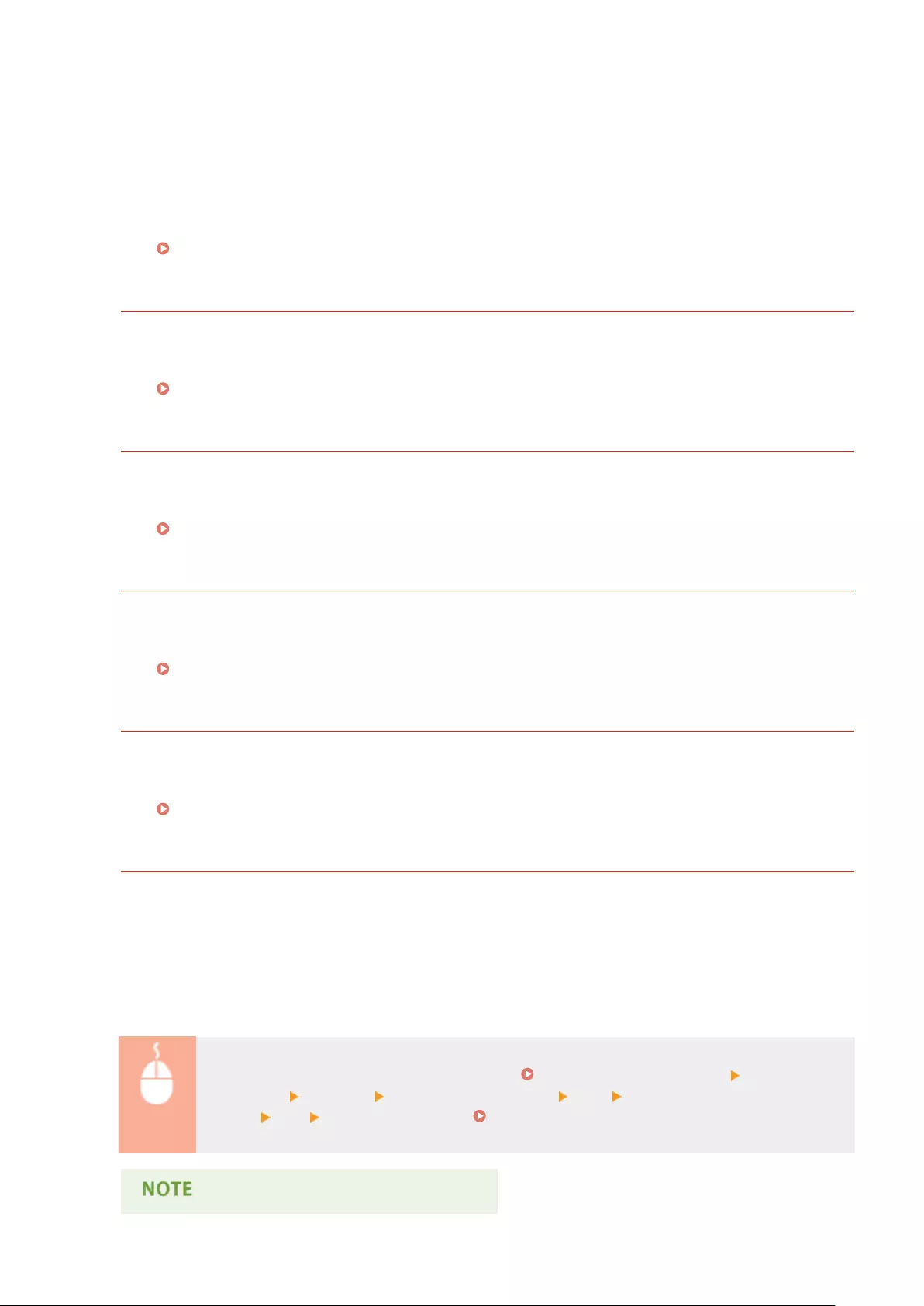
●Load the paper in landscape orientation, and print the le again.
Printing has been attempted with the custom size paper loaded in landscape orientation without the
UFR II printer driver used.
●Load the paper in portrait orientation, and print the le again.
<Check Paper Size> is set to <On>.
●Set <Check Paper Size> to <Off>, and print the le again.
Check Paper Size(P. 407)
Consmbl. status print. Press Utility key.
A warning message about toner cartridge has been issued.
●Check the message by Consumables Status Print.
Consmbl. Status Prt.(P. 537)
D7 nn Error (nn: 2-digit alphanumeric)
An abnormality has occurred in the machine, resulting in malfunction.
●Shut down the machine, wait for 10 seconds or more, and turn ON the power again.
Turning ON/OFF the Power(P. 33)
D8 nn Error (nn: 2-digit alphanumeric)
An abnormality has occurred in the machine, resulting in malfunction.
●Shut down the machine, wait for 10 seconds or more, and turn ON the power again.
Turning ON/OFF the Power(P. 33)
D9 nn Error (nn: 2-digit alphanumeric)
An abnormality has occurred in the machine, resulting in malfunction.
●Shut down the machine, wait for 10 seconds or more, and turn ON the power again.
Turning ON/OFF the Power(P. 33)
Data receiving error.
When you are using a printer driver other than the supplied one, [Dedicated Port Authentication
Method] of the Remote UI is set to [Mode 2].
●When you are using a printer driver that allows you to select the authentication mode for Department ID
Management and Secured Print, select Mode 2.
●When you are using a printer driver that does not allow you to select the authentication mode, set
[Dedicated Port Authentication Method] of the Remote UI to [Mode 1].
Log on to the Remote UI in Management Mode ( Starting Remote UI(P. 333) ) [Settings/
Registration] [Network] [Dedicated Port Settings] [Edit] Select [Mode 1] in [Authentication
Method] [OK] Perform a hard reset ( Performing a Hard Reset(P. 451) )
Troubleshooting
486

●Pressing ( ) cancels the print job.
E001-nnnn (n: Number)
An error has occurred in the xing unit.
●Write down the error code, hold down the power switch for 5 seconds or more to turn OFF the power,
unplug the power plug from the AC outlet, and then contact your local authorized Canon dealer.
Do not turn ON the power
●When this message appears, never turn ON the power after turning it OFF.
E003-nnnn (n: Number)
An error has occurred in the xing unit.
●Write down the error code, hold down the power switch for 5 seconds or more to turn OFF the power,
unplug the power plug from the AC outlet, and then contact your local authorized Canon dealer.
Do not turn ON the power
●When this message appears, never turn ON the power after turning it OFF.
E004-nnnn (n: Number)
An error has occurred in the xing unit.
●Write down the error code, hold down the power switch for 5 seconds or more to turn OFF the power,
unplug the power plug from the AC outlet, and then contact your local authorized Canon dealer.
Do not turn ON the power
●When this message appears, never turn ON the power after turning it OFF.
EM E-Mail access error.
Connection was unable to be established due to an error on the SD card.
●The SD card may be broken. Replace the SD card with a new one.
EM POP3 server error.
The machine could not connect to the POP3 server during E-Mail Print or the POP3 server settings are not
congured properly.
●Use the Remote UI or Network Status Print to check the error information.
Troubleshooting
487
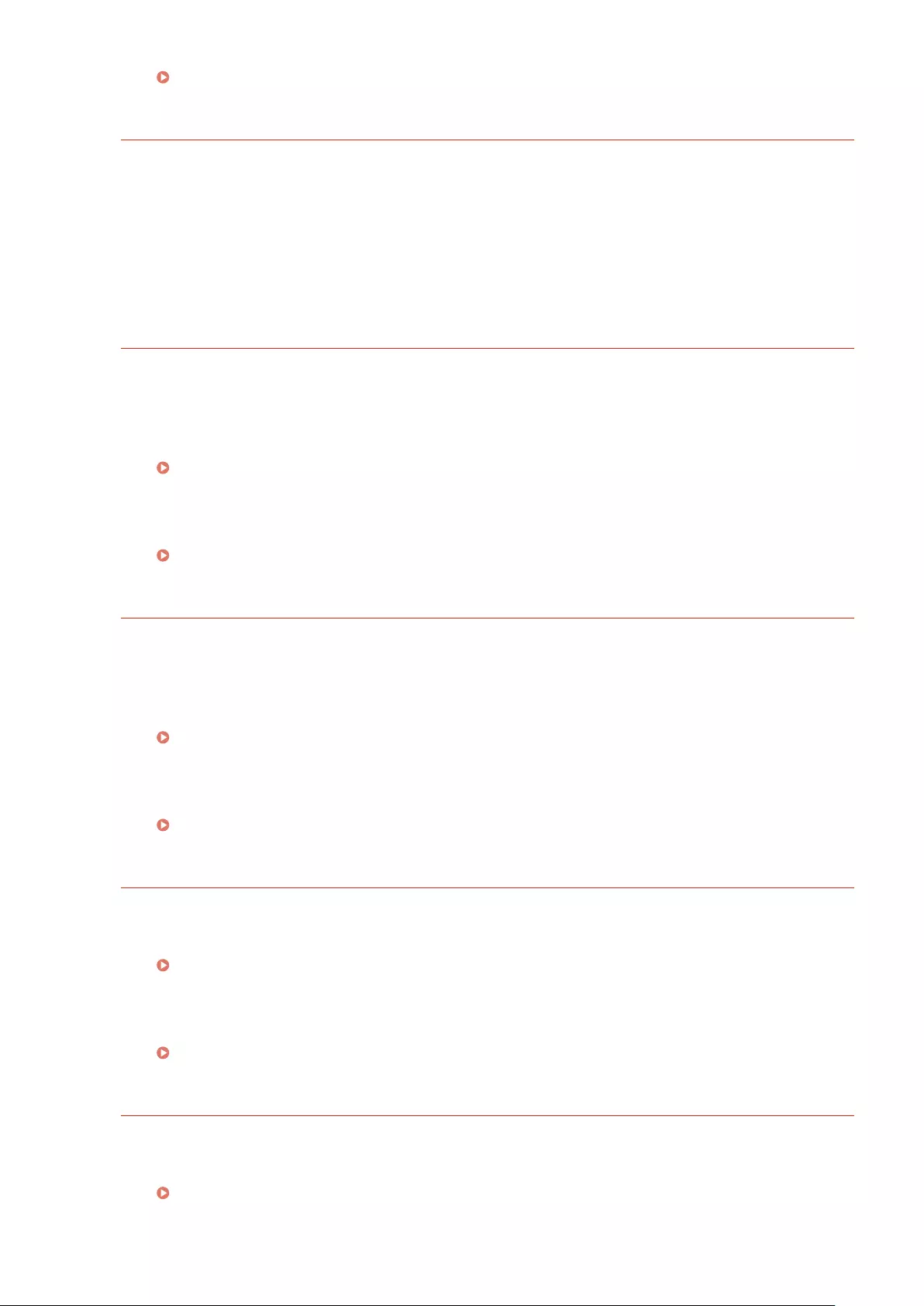
Checking Error Information(P. 345)
Ennn-nnnn (n: Number)
An error has occurred in an internal mechanism of the machine.
●Hold down the power switch for 5 seconds or more to turn OFF the power, wait for 10 seconds or more,
and turn ON the power again.
●If the machine does not operate normally even after the power is turned ON again, write down the error
code, hold down the power switch for 5 seconds or more to turn OFF the power, unplug the power plug
from the AC outlet, and then contact your local authorized Canon dealer.
Error. Non-Canon cart. not cov'd by warranty.
A toner cartridge may not be installed correctly or may be faulty.
●Re-install the toner cartridge. If re-installing the toner cartridge fails to clear the error message, the toner
cartridge may be faulty. Contact the store where you purchased the toner cartridge or consult the Canon
Customer Help Center.
How to Replace Toner Cartridges(P. 524)
The toner cartridge used may not be a genuine Canon product.
●Only genuine Canon toner cartridges should be used as replacement toner cartridges.
Consumables(P. 573)
Error. Non-Canon cart. not covered by warranty.
A toner cartridge may not be installed correctly or may be faulty.
●Re-install the toner cartridge. If re-installing the toner cartridge fails to clear the error message, the toner
cartridge may be faulty. Contact the store where you purchased the toner cartridge or consult the Canon
Customer Help Center.
How to Replace Toner Cartridges(P. 524)
The toner cartridge used may not be a genuine Canon product.
●Only genuine Canon toner cartridges should be used as replacement toner cartridges.
Consumables(P. 573)
Google Cloud Print not avail. Server auth err
Server authentication for Cloud Print failed. Or, acquisition of information for registration failed.
●Check whether the date and time settings are correctly specied.
Date/Time Settings(P. 367)
The CA certicate does not exist or has become invalid. Or the CA certicate has expired.
●Check whether the CA certicate settings are correct.
Verifying Key Pairs and Digital Certicates(P. 329)
Google Cloud Print not avail. Server comm err
Cloud Print is unavailable due to an error.
●Check whether the machine is correctly connected to a wired LAN.
Connecting to a Wired LAN(P. 185)
Troubleshooting
488
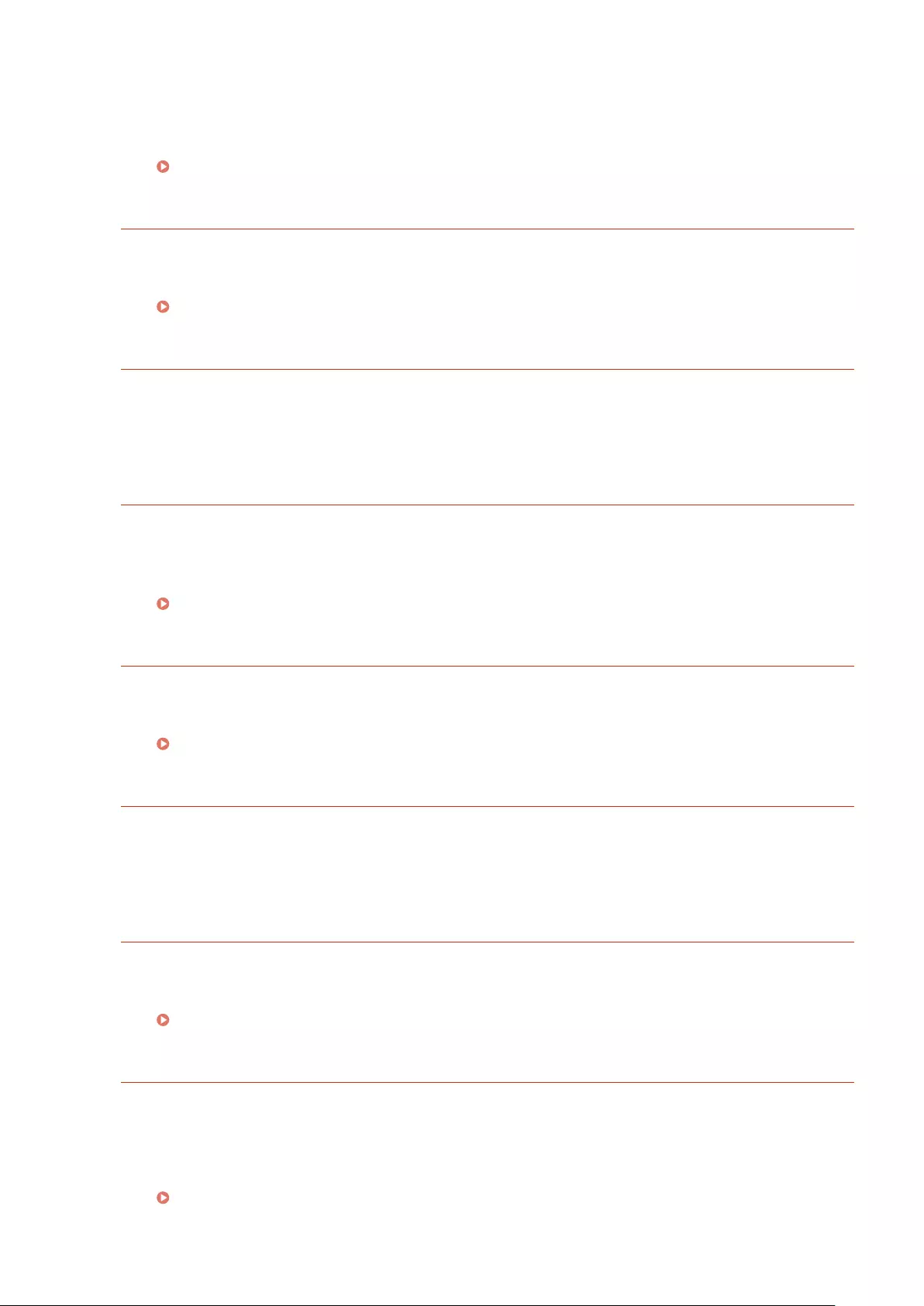
●A port that is used for Cloud Print may be blocked by a rewall or other protection. Check whether the
5222 port is available with your computer.
●If a proxy server is used on the network, check whether the proxy settings on the machine and the server
are correct. For details, contact your Network Administrator.
Setting a Proxy(P. 274)
IE An unknown error has occurred.
An error with an unidentied cause has occurred during IEEE802.1X authentication.
●Perform a hard reset or restart the machine.
Performing a Hard Reset(P. 451)
IE Cannot analyze the certicate.
Analysis of the certicate received from the authentication server has failed during IEEE802.1X
authentication.
●Check the certicate of the authentication server.
IE Change the password.
The password used for IEEE802.1X authentication has expired.
●Change the password registered in the authentication server, and update the password for IEEE802.1X
authentication.
Conguring IEEE 802.1X Authentication(P. 309)
IE Check auth. settings
The IEEE802.1X authentication method differs between the machine and the authentication server.
●Select the correct IEEE802.1X authentication method.
Conguring IEEE 802.1X Authentication(P. 309)
IE No reply from the destination.
An error has occurred during communication for IEEE802.1X authentication with the authentication
server.
●Check whether the LAN cable is securely connected.
IE Set necessary authentication info.
The information specied for IEEE802.1X authentication is not sucient.
●Check the IEEE802.1X settings, and specify the settings properly.
Conguring IEEE 802.1X Authentication(P. 309)
IE Set the correct authentication info.
An error has been returned from the authentication server because the certicate to be used for
IEEE802.1X authentication is not specied or it is invalid.
●The certicate to be used for TLS authentication is not specied or it is invalid. Check the certicate, and
specify the valid certicate.
Conguring IEEE 802.1X Authentication(P. 309)
●If the certicate in the machine is valid, check the CA certicate of the authentication server.
Troubleshooting
489
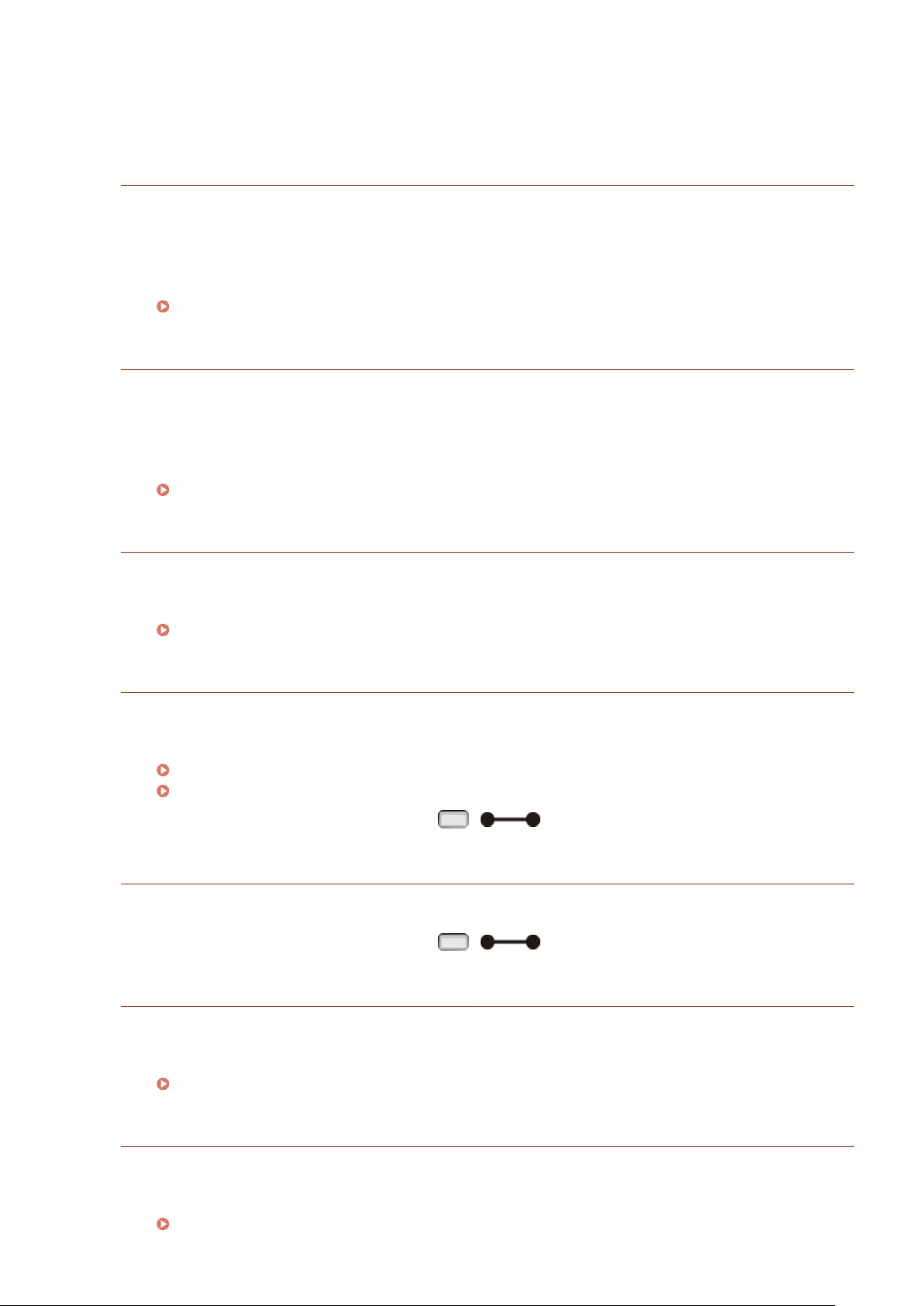
The login name to be used for IEEE802.1X authentication is not specied.
●The login name to be used for IEEE802.1X authentication is not specied. Specify the login name.
IE The certicate has expired.
The certicate received from the authentication server has been found to have expired during
IEEE802.1X authentication.
●Check the certicate of the authentication server.
●Check the time settings in the machine and authentication server.
Date/Time Settings(P. 367)
IE The certicate is incorrect.
An error has occurred as a result of verication of the certicate received from the authentication server
by using the CA certicate during IEEE802.1X authentication.
●Check the certicate of the authentication server.
●Install the CA certicate in the machine.
Using CA-issued Key Pairs and Digital Certicates(P. 326)
IEEE802.1X error. Set the necessary auth. information.
The information specied for IEEE802.1X authentication is not sucient.
●Check the IEEE802.1X settings, and specify the settings properly.
Conguring IEEE 802.1X Authentication(P. 309)
Image browse data error.
The TIFF data contains data that the machine cannot process while receiving.
●Set <TIFF Spooler> to <On>, and print the le again. If the le size exceeds 40 MB, install an SD card.
TIFF Spooler(P. 427)
Installing an SD Card(P. 583)
●Because the data cannot be printed, press ( ) to cancel the print job.
Image data error.
The TIFF or JPEG data contains data that is not available for the machine.
●Because the data cannot be printed, press ( ) to cancel the print job.
Insert toner cartridge.
The toner cartridge is not set or properly set.
●Properly set the toner cartridge.
How to Replace Toner Cartridges(P. 524)
Key management le is corrupt or deleted.
Files related to key management are damaged.
●Restart the machine, regenerate or reinstall the key and certicate, and then specify the TLS settings.
Turning ON/OFF the Power(P. 33)
Troubleshooting
490
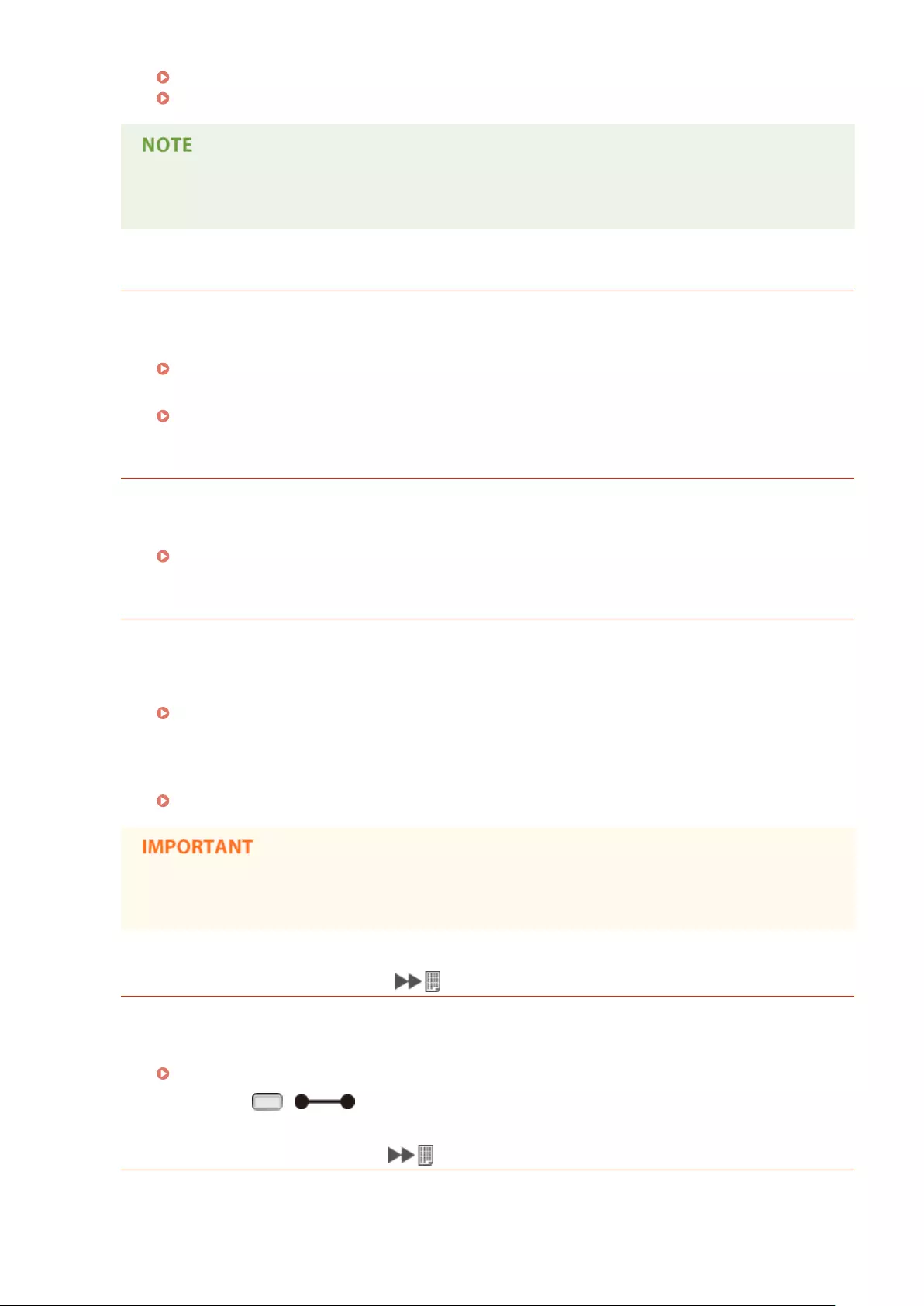
Specifying the TLS Encrypted Communication (P. 251)
Conguring Settings for Key Pairs and Digital Certicates(P. 315)
●While this error message is displayed, the machine cannot be connected from the Remote UI until it is
restarted.
Load paper.
The paper of the size specied to print is not loaded in the paper source.
●Load the appropriate paper in the selected paper source.
Loading Paper(P. 37)
●Select the paper source loaded with the paper of the size specied to print or of a size larger than that.
Paper Source(P. 453)
No Paper: Drawer N (N=1 to 5)
Paper is not loaded in the paper drawer.
●As the specied paper size and type are displayed, load appropriate paper.
Loading Paper in the Paper Drawer(P. 39)
Non-Canon cart. not covered by warranty.
A toner cartridge may be set that cannot guarantee print quality because it has reached the end of its
lifetime or for other reasons.
●Replacing the toner cartridge with a new one is recommended.
Replacing Toner Cartridges(P. 521)
The toner cartridge used may not be a genuine Canon product.
●Only genuine Canon toner cartridges should be used as replacement toner cartridges.
Consumables(P. 573)
●You can continue printing when this message is displayed, but the print quality may deteriorate.
Doing so may result in damage to the machine.
Not enough display list memory.
The available memory space is insucient for the processing and an overow has occurred.
●Perform a hard reset, and print the le again.
Performing a Hard Reset(P. 451)
●You can press ( ) to continue printing. However, the data that overowed is not registered.
Not enough download memory.
Memory for registering the overlay form and external characters is insucient and has overowed.
●Perform a hard reset, and print the le again.
Troubleshooting
491
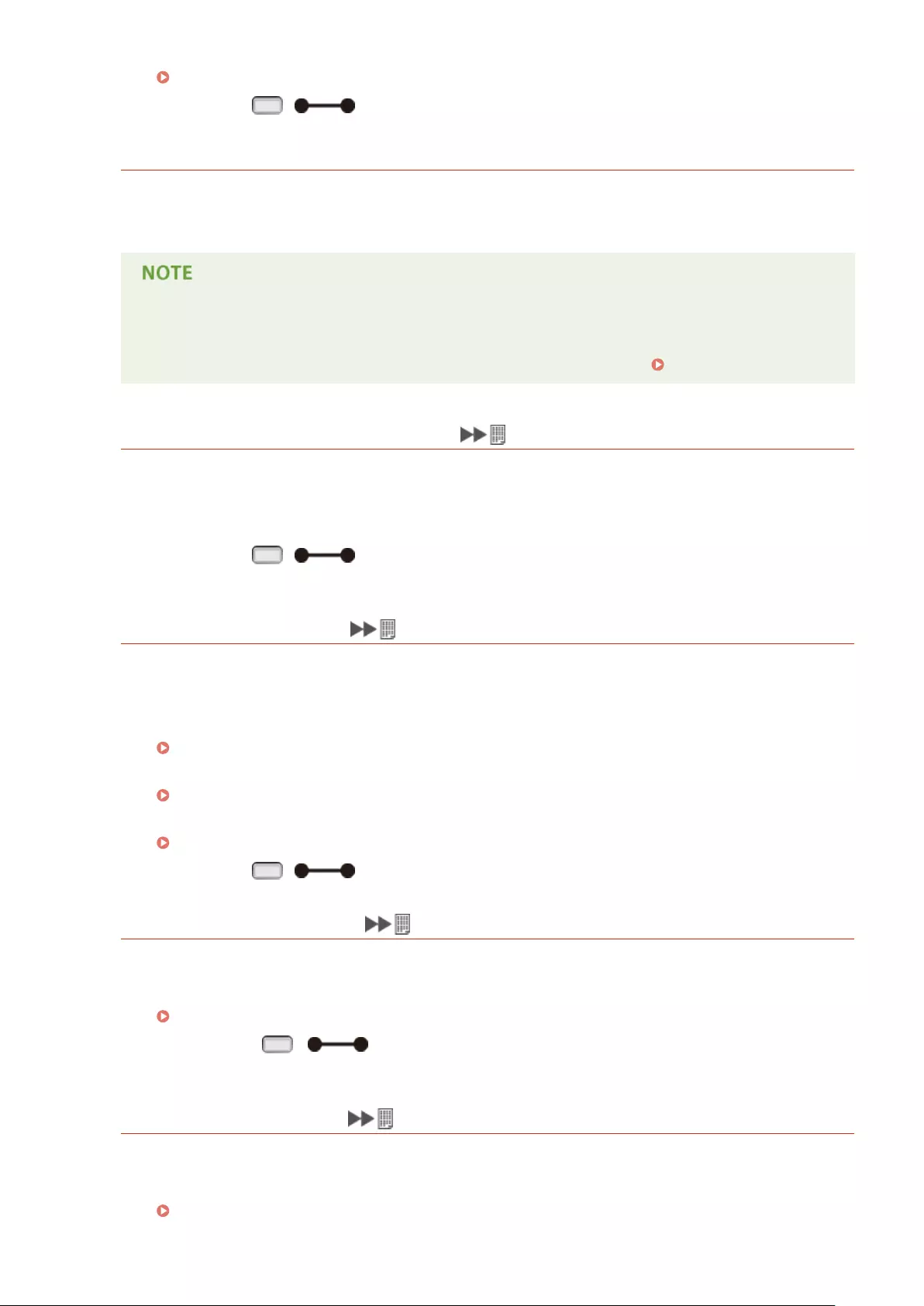
Performing a Hard Reset(P. 451)
●You can press ( ) to continue printing. However, the data that overowed is not registered.
Not enough memory for PDF processing.
Memory for processing the PDF le is insucient.
●Optimize the PDF le to reduce its size or retry printing after dividing the le.
●If you tried USB Direct Print or Direct Print, printing may be properly performed when it is restarted
from the printer driver.
●To remove the error message, perform a soft reset to cancel the print job. Soft Reset(P. 451)
Not enough memory for XPS processing.
Memory for XPS processing is insucient.
●When the XPS le contains a ProgressiveJpeg image or the like, convert the image to a TIFF or
BaselineJPEG format, and print the le again.
●You can press ( ) to continue printing. However, the output result of pages with errors is not
guaranteed.
Not enough spool memory.
Printing an excessive amount of data has been attempted.
●Specify the reduced paper size, and print the le again.
●Set <Image Renement> to <Off>, and print the le again.
Image Renement(P. 400)
●Set <2-Sided Printing> to <Off>, and print the le again.
2-Sided Printing(P. 459)
●Change the <Halftones> setting, and print the le again.
Halftones(P. 400)
●You can press ( ) to continue printing. However, pages with errors are not printed.
Not enough system memory.
Memory for data processing (mainly, graphics and characters) in the system is insucient.
●Perform a hard reset, and print the le again.
Performing a Hard Reset(P. 451)
●You can press ( ) to continue printing. However, graphics or characters with the error
cannot be printed properly.
Not enough work memory.
Memory dedicated to each print mode is insucient.
●Perform a hard reset, and print the le again.
Performing a Hard Reset(P. 451)
Troubleshooting
492
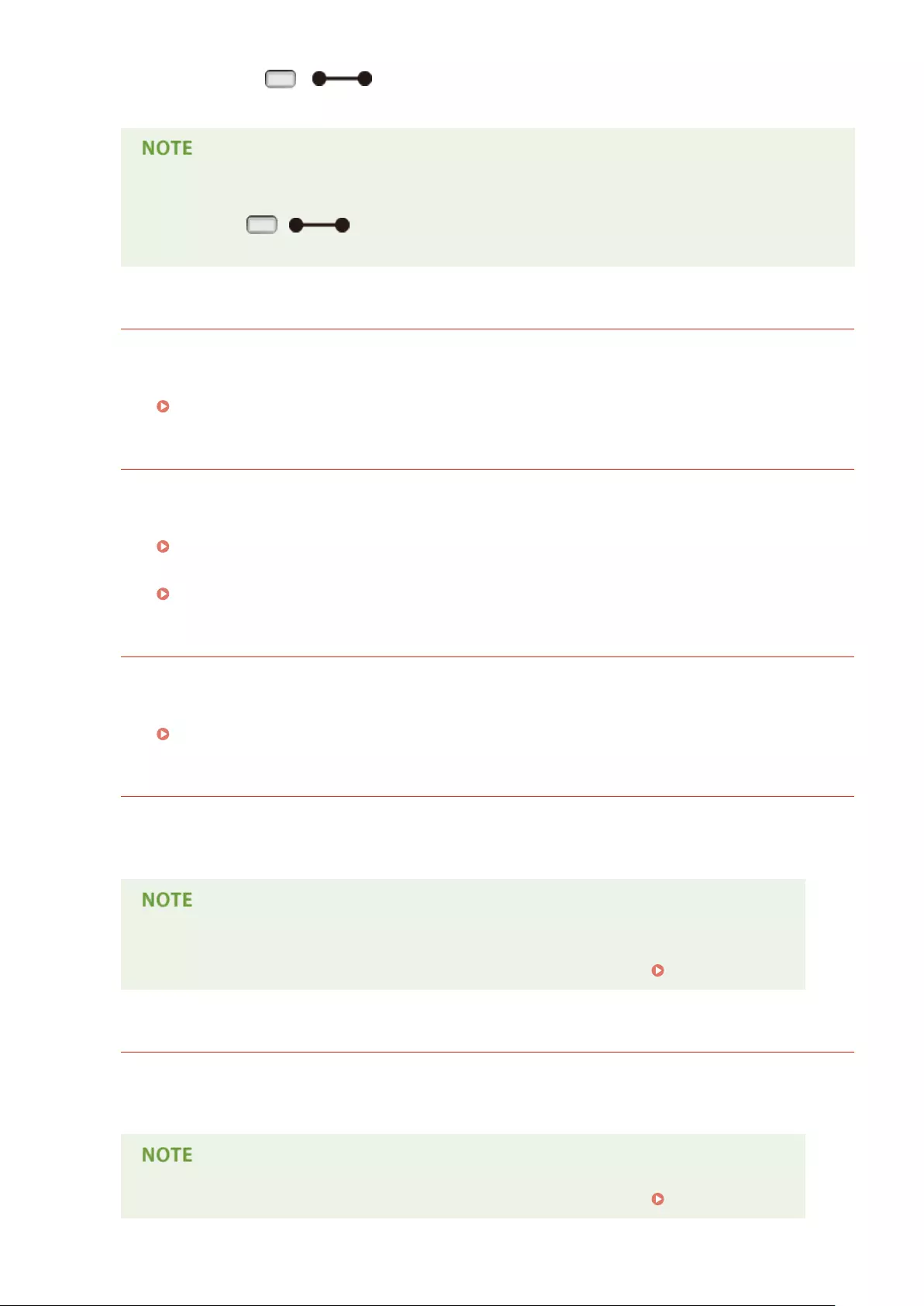
●You can press ( ) to continue printing. However, data with errors cannot be printed
properly.
Registered Data
●If you press ( ) to continue printing, the data such as registered overlay or macros may
be deleted.
NW Competing IP add. found on the network.
The IPv4 address set for the machine is a duplication of that for another host on the network.
●Set a proper IPv4 address for the machine, and restart the machine.
Setting IPv4 Address(P. 188)
NW IP address updated. Turn main power OFF/ON
The IP address has been changed when the machine was operating or a quick start was performed.
●Perform a hard reset or restart the machine.
Performing a Hard Reset(P. 451)
●Fix the IP address assigned to the machine in the DHCP server.
Setting IP Addresses(P. 187)
Paper is jammed.
Paper jams have occurred inside the machine.
●Do not forcibly pull out the jammed paper, but follow the procedure described in the manual.
Clearing Jams(P. 463)
PDF error.
Printing the PDF data that is not available for the machine has been attempted.
●Use the PDF data in the format supported by the machine.
●The machine supports the PDF version 1.7.
●To remove the error message, perform a soft reset to cancel the print job. Soft Reset(P. 451)
PDF font error.
The PDF data contains fonts that are not available for the machine.
●Use the PDF data in the format supported by the machine.
●To remove the error message, perform a soft reset to cancel the print job. Soft Reset(P. 451)
Troubleshooting
493
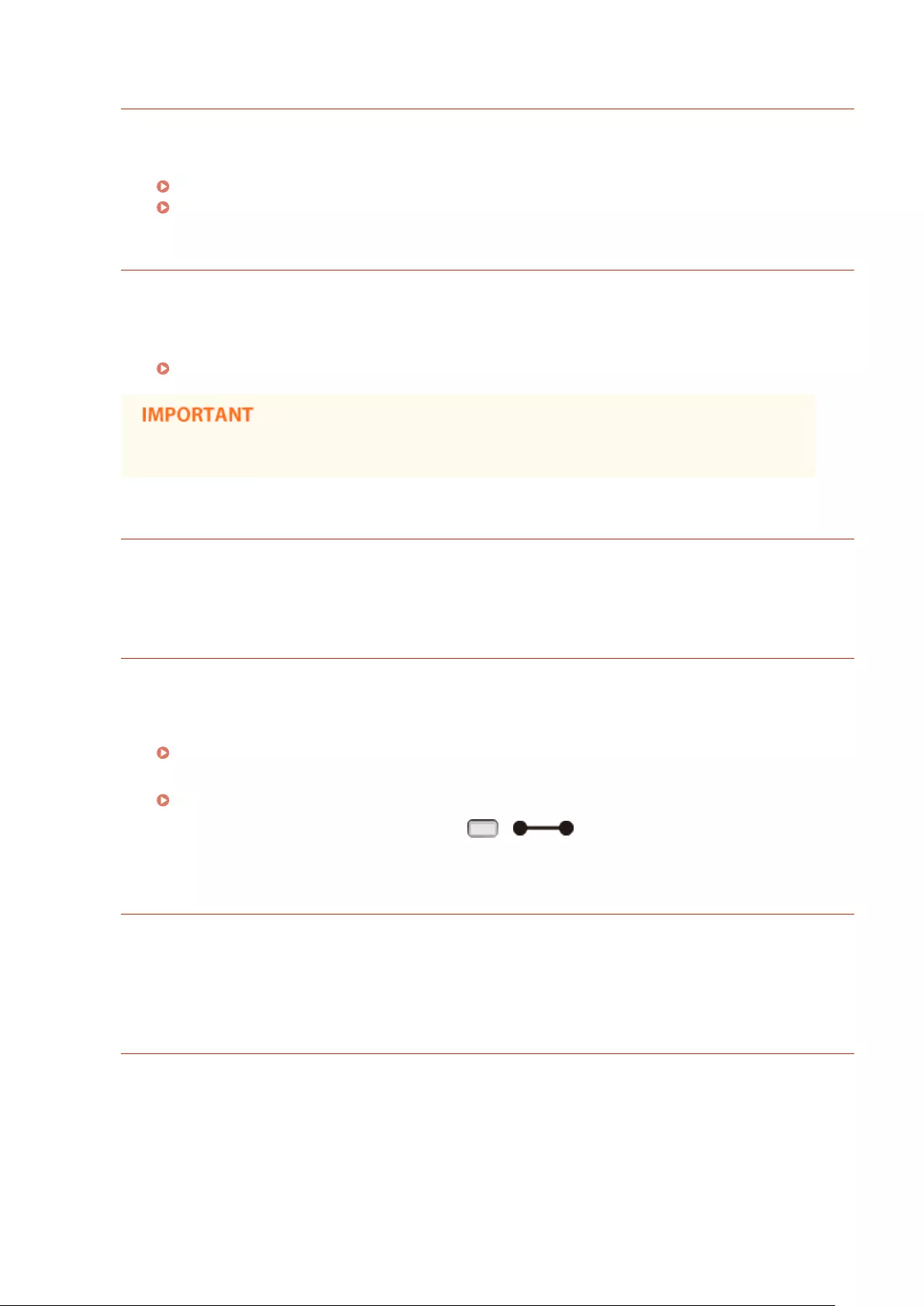
PDF print range error.
An invalid range of pages has been specied for printing.
●Specify the correct range of print pages, and print the le again.
Printing from USB Memory (USB Direct Print)(P. 120)
Print Settings for Direct Print(P. 150)
Prepare maintenance kit.
The xing unit, feeder rollers, or the like have reached the end of their lifetime.
●Replacing the xing unit, feeder rollers, or the like with those included in a new maintenance kit is
recommended.
Consumable Parts(P. 574)
●You can continue printing when this message is displayed, but the print quality may deteriorate.
Print data version error.
Printing has been tried from the printer driver that is not available for the machine.
●Print again by using the printer driver available for this machine.
Set below paper.
Paper of the size specied to print is not loaded or the selected paper source does not match the paper
size.
●Load the paper of the size specied to print in the selected paper source.
Loading Paper(P. 37)
●Select the paper source loaded with the paper of the size specied to print.
Paper Source(P. 453)
●To forcibly print on the loaded paper, press ( ). For the multi-purpose tray, the setting
specied for <MP Tray Paper Size> is automatically changed to the paper size of the print data.
Starting up... 80 Initializing MEAP. Do not turn power OFF.
You have tried to shut down the machine while MEAP was being initialized.
●When the MEAP initialization is complete, this message is automatically removed. Wait until the message
is removed.
Starting up... 80 Preparing MEAP... Do not turn power OFF.
You have tried to shut down the machine while MEAP was preparing for operation.
●When MEAP is ready for operation, this message is automatically removed. Wait until the message is
removed.
Troubleshooting
494
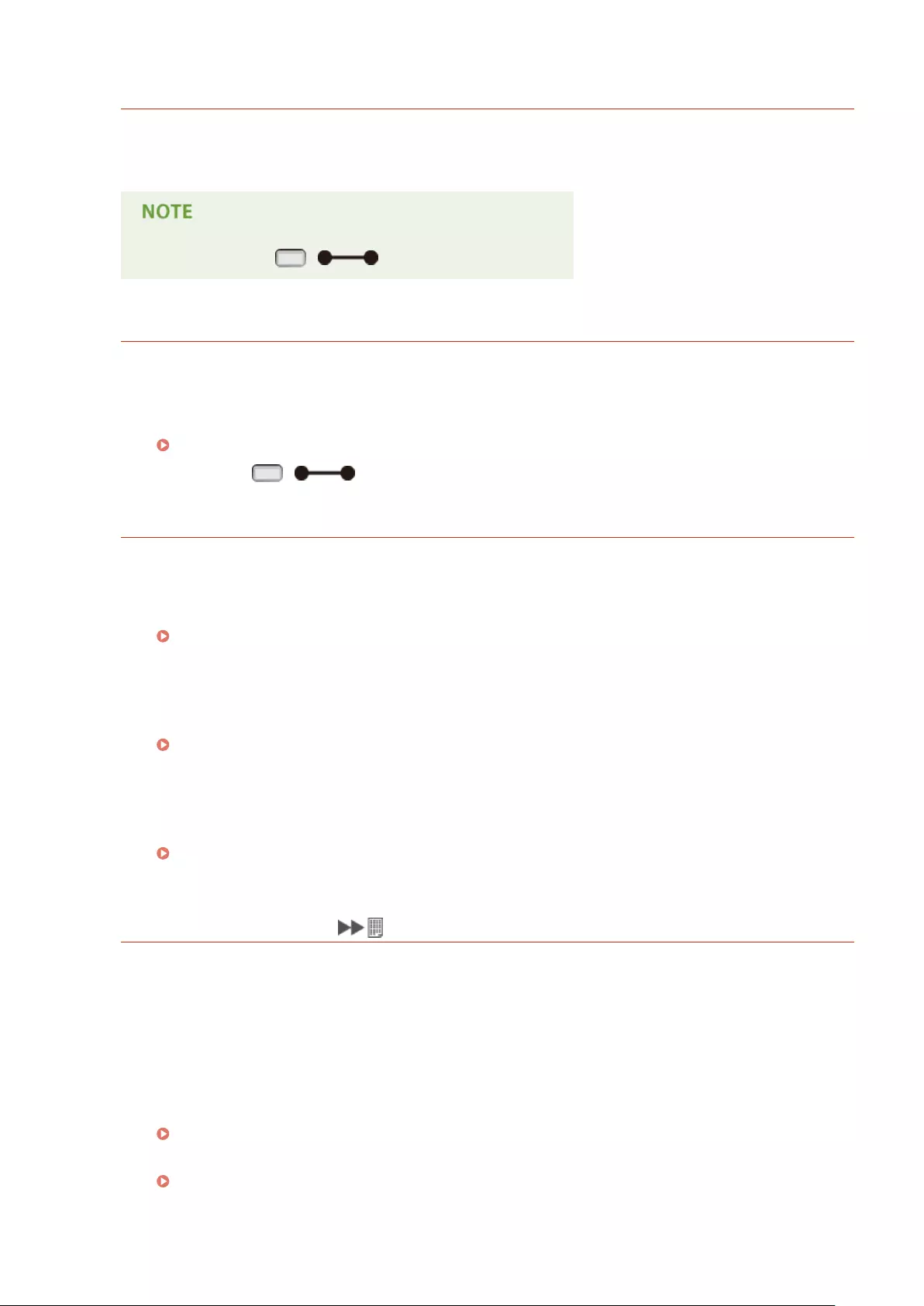
Syntax error.
Invalid data has been sent during printing with the UFR II printer driver.
●Change the printer driver settings or the format of print data, and print the le again.
●When you press ( ), the print job is canceled.
Toner cartridge will soon reach end of lifetime.
The replacement time for the toner cartridge is near.
●Make sure that you have a replacement toner cartridge ready.
●Replace the toner cartridge if you see this message before you start to print a large job.
Replacing Toner Cartridges(P. 521)
●You can press ( ) to continue printing.
Turn OFF main power. Check options.
The duplex unit or an optional accessory * is not properly installed.
●Shut down the machine, properly install the duplex unit or optional accessory, and then turn ON the
power.
Turning ON/OFF the Power(P. 33)
The duplex unit or an optional accessory * has been detached when the machine is ON.
●Shut down the machine, properly install the duplex unit or optional accessory, and then turn ON the
power.
Turning ON/OFF the Power(P. 33)
The connection part of the duplex unit or an optional accessory * has a contact failure.
●Shut down the machine, unplug the power plug from the AC power outlet, and then contact your local
authorized Canon dealer.
Turning OFF the Power (Performing a Shutdown)(P. 33)
* Paper Feeder, Paper Deck, Envelope Feeder
XPS document data error.
XPS data is damaged.
●Check that XPS data is not damaged and that the XPS data format is supported by the machine, and then
try printing the document again.
A large le has been sent by Direct Print.
●Optimize the XPS le to reduce its size or retry printing after dividing the le.
●Install the SD card, and then resend the data to the machine.
Installing an SD Card(P. 583)
●Send the data from the USB memory device to the machine.
Printing from USB Memory (USB Direct Print)(P. 120)
Troubleshooting
495
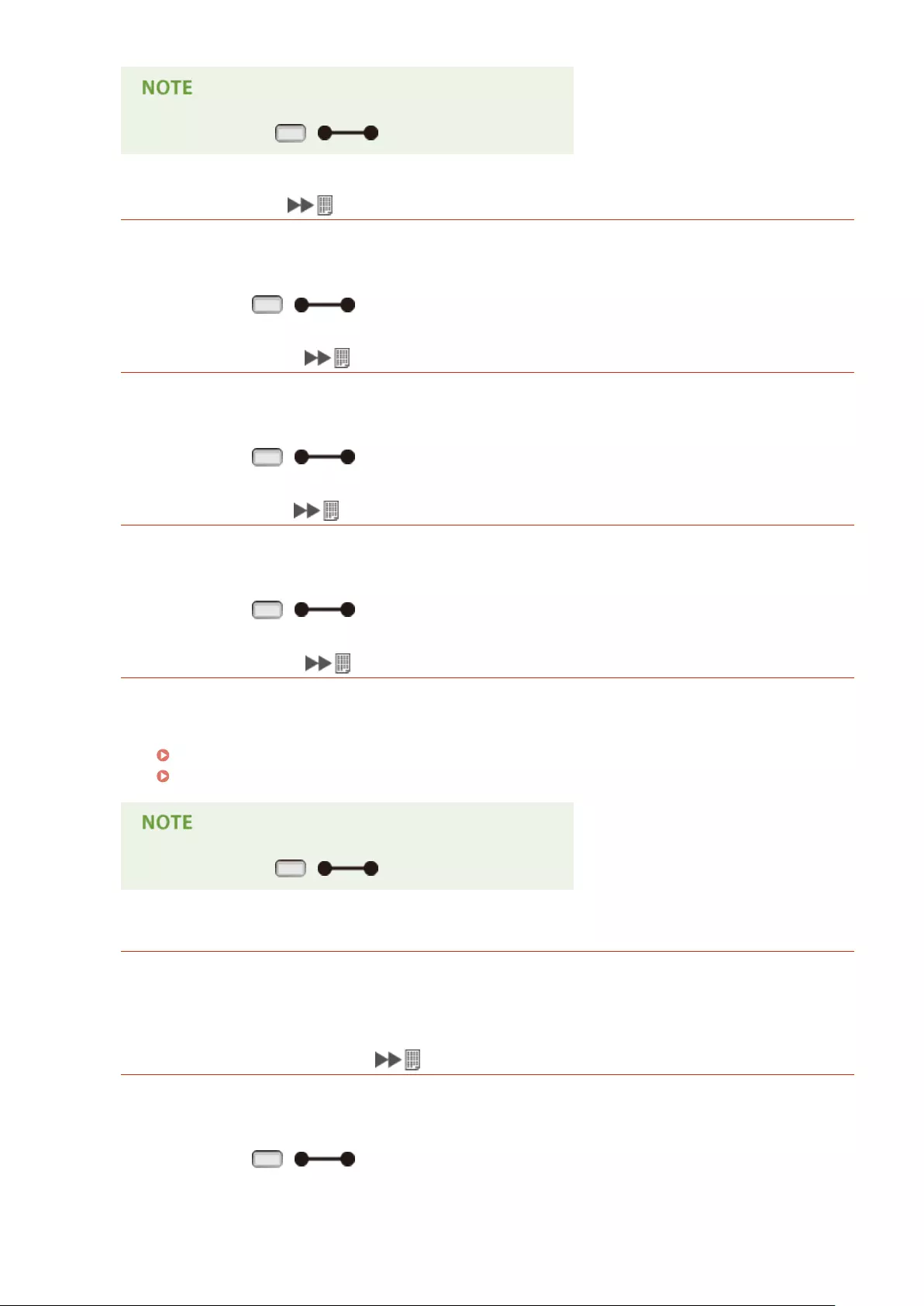
●When you press ( ), the print job is canceled.
XPS font data error.
Font data analysis has failed.
●Replace the font data in the XPS le, and try printing the le again.
●You can press ( ) to continue printing. However, characters with errors are not printed.
XPS image data error.
Image data is damaged.
●Replace the image data in the XPS le, and try printing the le again.
●You can press ( ) to continue printing. However, images with errors are not printed.
XPS page data error.
A page cannot be generated due to an invalid description.
●Check the description of the page with the error, and try printing the le again.
●You can press ( ) to continue printing. However, pages with errors are not printed.
XPS print range error.
There is no page that can be processed in the specied print range.
●Specify the correct range of print pages, and try printing the le again.
Printing from USB Memory (USB Direct Print)(P. 120)
Print Settings for Direct Print(P. 150)
●When you press ( ), the print job is canceled.
XPS rendering error.
An error has occurred in the XPS rendering system.
●Contact your local authorized Canon dealer.
XPS unsupported image error.
Unprintable images (HD Photo) are contained in the data.
●Convert the image data in the XPS le to other data format, and try printing the le again.
●You can press ( ) to continue printing. However, images with errors are not printed.
Troubleshooting
496
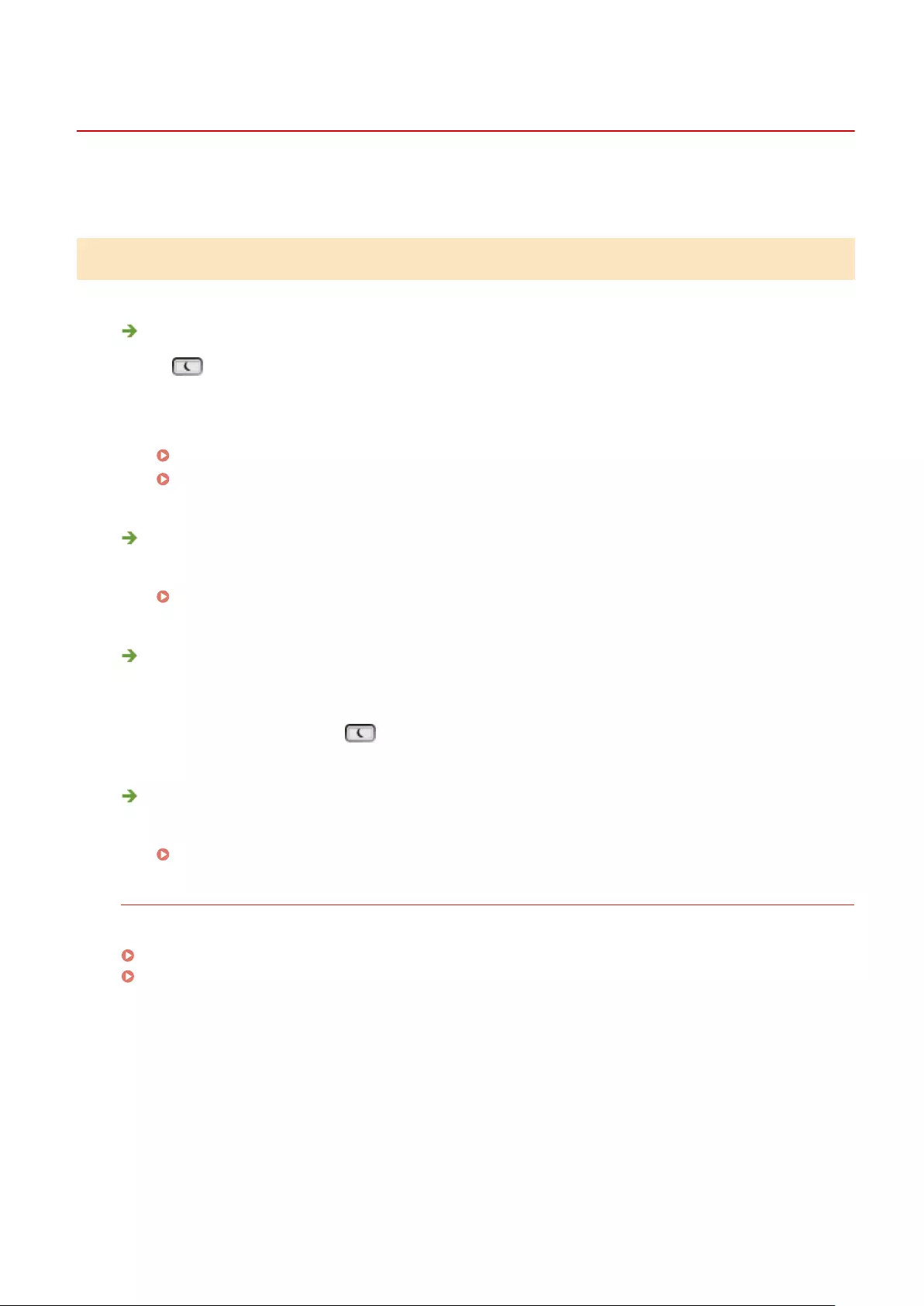
Common Problems
0X7U-068
If you encounter problems when using the machine, check the items in this section before contacting us. If the
problems persist, contact your local authorized Canon dealer or the Canon help line.
Check the Following
Is the machine turned ON? Is the power cord connected?
●If and the display of the operation panel are in the off state, it indicates that a quick turn-OFF has
been performed or the machine has not been turned ON. If the machine does not respond when you
press the power switch, check whether the power cord is connected correctly, and press the power switch
again. For power cord connection, see "Getting Started".
Operation Panel(P. 24)
Manuals Included with the Machine(P. 587)
Are the LAN cable and USB cable connected correctly?
●Check whether these cables are connected correctly.
Parts and Their Functions(P. 16)
Is sleep mode activated?
●If you leave the machine unattended for a specic period of time, it enters sleep mode for power
conservation, not allowing you to operate it.
To cancel sleep mode, press .
Is any message displayed on the screen?
●If a problem occurs, a message is displayed.
When an Error Message Appears(P. 480)
If a problem persists even after checking
Click the link that corresponds to the problem.
Installation/Settings Problems(P. 498)
Printing Problems(P. 501)
Troubleshooting
497
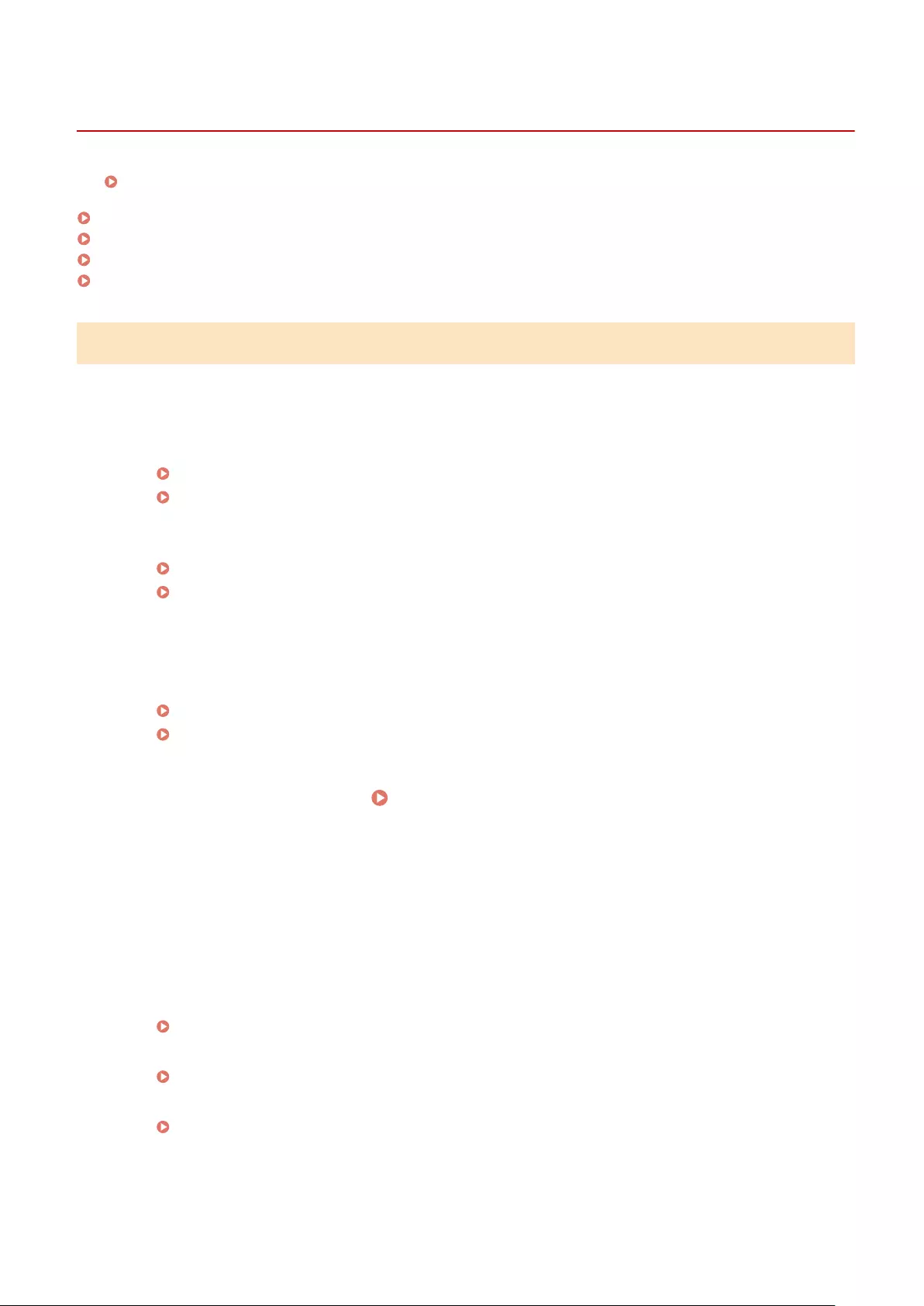
Installation/Settings Problems
0X7U-069
See Common Problems(P. 497) also.
Problems with the Wired LAN Connection(P. 498)
Problem with the USB Connection(P. 499)
Problem with the Print Server(P. 499)
Machine Problem(P. 499)
Problems with the Wired LAN Connection
Remote UI is not displayed.
●Are <HTTP> and <Remote UI> set to <On>?
Disabling HTTP Communication(P. 288)
Disabling Remote UI(P. 289)
●Check whether the LAN cable is connected properly and the IP address is set correctly, and then start the
Remote UI again.
Connecting to a Wired LAN(P. 185)
Network Status Print(P. 536)
●Are you using a proxy server? If so, add the machine's IP address to the [Exceptions] list (addresses that do
not use the proxy server) in the Web browser's proxy settings dialog.
●Is the computer communication restricted by rewalls? Use the operation panel to set <Address Filter> to
<Off>.
Restricting Communication by Using Firewalls(P. 264)
Address Filter(P. 392)
The LNK indicator is Off. Back Side(P. 19)
●Use a straight-through Ethernet cable for the wired LAN connection.
●Check that the hub or router is turned ON.
●Do not connect the cable to the UP-LINK (cascade) port of the hub.
●Change the LAN cable.
A connection to a network cannot be established.
●Is <Network> under <Interface Selection> set to <On>?
Interface Selection(P. 403)
●The IP address may not be set correctly. Set the IP address again.
Setting IP Addresses(P. 187)
●If you are using an IPv4 address, specify the xed IP address.
Setting IPv4 Address(P. 188)
You are unsure of the set IP address.
●Check by using Network Status Print.
Troubleshooting
498
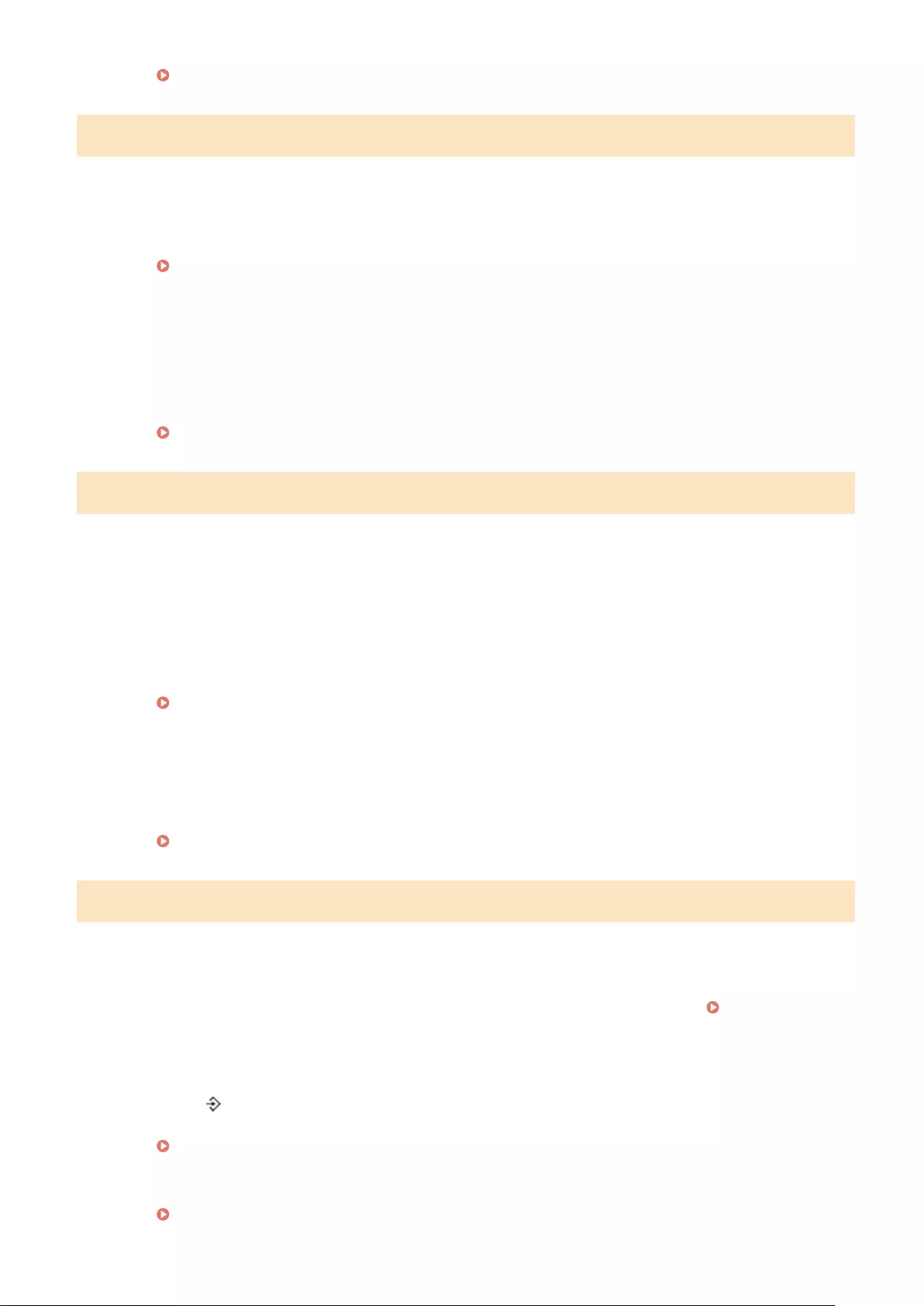
Network Status Print(P. 536)
Problem with the USB Connection
Cannot communicate.
●Is <USB> under <Interface Selection> set to <On>?
Interface Selection(P. 403)
●Change the USB cable. If you are using a long USB cable, replace it with a short one.
●If you are using a USB hub, connect the machine directly to your computer using a USB cable.
The machine cannot be correctly detected from a computer.
●Does the setting of <USB-Connected PC OS> under <Control Menu> match the OS of your computer?
USB-Connected PC OS(P. 370)
Problem with the Print Server
You cannot nd the print server to connect to.
●Are the print server and computer connected correctly?
●Is the print server running?
●Do you have user rights to connect to the print server? If you are not sure, contact the server administrator.
●Is [Network discovery] enabled? (Windows Vista/7/8/Server 2008/Server 2012)
Enabling [Network discovery](P. 616)
You cannot connect to a shared printer.
●On the network, does the machine appear among the printers of the print server? If it is not displayed,
contact the network or server administrator.
Displaying Shared Printers in the Print Server(P. 617)
Machine Problem
No menus are displayed.
●Is the machine oine? The Utility menu and Job menu are available in online mode. Online key(P. 25)
The operation panel keys do not work.
●Is the [ ] indicator lit? In this case, print data remains in memory. If the remaining data is not printed
even after a while, select <Form Feed> in the Reset menu.
Form Feed(P. 452)
●If <Key locked.> appears on the display, the key lock function is active. Contact the administrator of the
machine or disable the key lock function from the Remote UI.
Restricting Operation Panel Functions(P. 285)
Troubleshooting
499

●If you cannot perform any operation, hold down the power switch for 5 seconds or more to turn OFF the
power. When turning ON the power, wait for 10 seconds or more after indicator is turned OFF, and
then press the power switch.
No SD card can be used.
●Is <SD Card> set to <Off>? Select <On>.
SD Card(P. 369)
●Is the SD card write-protected?
Shut down the machine, and check whether the SD card is write-protected. If the card is write-protected,
unlock the card, and again install it on the machine. Installing an SD Card(P. 583)
Troubleshooting
500

Printing Problems
0X7U-06A
See Common Problems(P. 497) also.
Printing results are not satisfactory. Paper creases or curls.
When You Cannot Print Properly(P. 503)
You cannot print.
Check the Following.
●Is the [ ] indicator lit or blinking? In this case, printing is in progress. Please wait for a while. If the
remaining data is not printed even after a while, select <Form Feed> or <Soft Reset> in the Reset menu.
Reset Menu(P. 451)
●Is ( ) lit? If it is not lit, press ( ) to set the machine to online.
Online key(P. 25)
●Can you print by Status Print or Network Status Print? If you can print, the machine has no problem. Check
the congured network and computer settings.
Printing Reports and Lists(P. 536)
●Can you print a Windows test page? If you can print a Windows test page, there is no problem with the
machine or the printer driver. Check the print settings of your application.
Printing a Test Page in Windows(P. 618)
If the problems persist, check the items that suit your operational environment.
Wired LAN connection
●Have you selected the correct port?
Checking the Printer Port(P. 619)
If the correct port is selected, click [Congure Port] of the [Ports] tab to check that the setting specied for
[Printer Name or IP Address] matches that congured in the machine.
If there is no port to use or the IP address of the machine is changed, generate a port by following the
procedure for changing the standard TCP/IP port described in the Printer Driver Installation Guide.
●Is the computer communication restricted by rewalls? Use the operation panel to set <Address Filter> to
<Off>.
Restricting Communication by Using Firewalls(P. 264)
Address Filter(P. 392)
●Disable security software and other resident software.
●By following the procedure for changing the standard TCP/IP port described in the Printer Driver
Installation Guide, change the print protocol to LPD and enable LRP Byte Counting.
●Reinstall the printer driver in accordance with the Printer Driver Installation Guide.
●Can you print from other computers on the network? If you also cannot print from other computers,
contact your local authorized Canon dealer or the Canon help line.
If you are using the SMB network
●Are the SMB settings congured correctly? In particular, check that the DHCP server and WINS server are
connected properly if you are using them. Conguring SMB(P. 242)
Troubleshooting
501
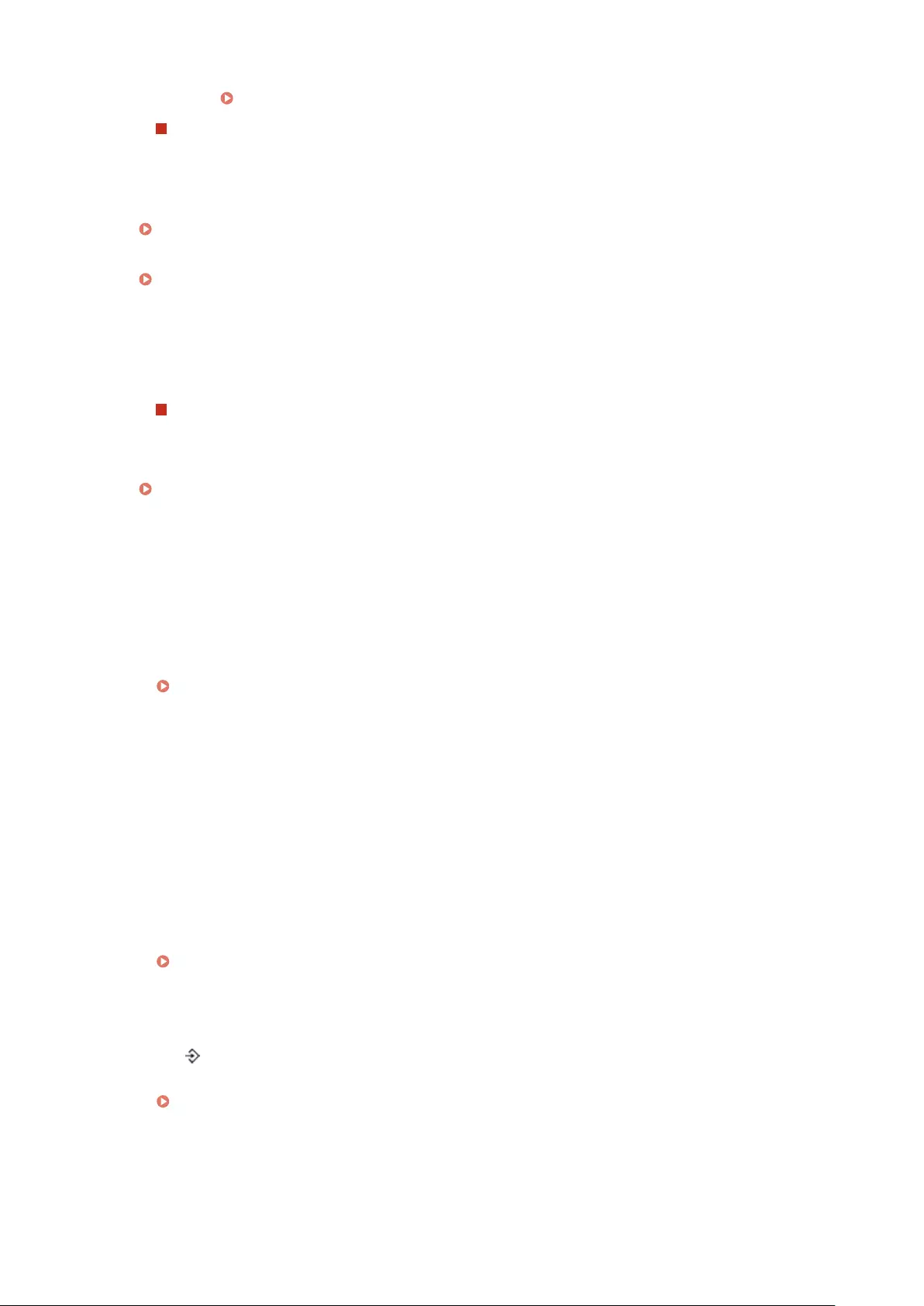
●If the SMB settings are correctly congured, set a time value slightly longer than usual in <Wait Time at
Startup>. Setting a Wait Time for Connecting to a Network(P. 219)
USB connection
●Have you selected the correct port? If there is no port to use or you are not sure, reinstall the printer driver
in accordance with the Printer Driver Installation Guide. When you reinstall the printer driver, the correct
port is created automatically.
Checking the Printer Port(P. 619)
●Is bidirectional communication enabled? Enable bidirectional communication, and restart the computer.
Checking Bidirectional Communication(P. 620)
●Disable security software and other resident software.
●Connect to another USB port on the computer.
●Can you print from a USB connection to another computer? If you also cannot print from other computers,
contact your local authorized Canon dealer or the Canon help line.
Via print server
●Can you print from the print server? If you can print from the print server, check the connection between
the print server and your computer.
Problem with the Print Server(P. 499)
●Disable security software and other resident software.
●Reinstall the printer driver in accordance with the Printer Driver Installation Guide.
●Can you print from other computers via the print server? If you also cannot print from other computers,
contact your local authorized Canon dealer or the Canon help line.
You cannot print with Google Cloud Print.
Using Google Cloud Print(P. 176)
It takes a long time before printing starts.
●Did you print to narrow width paper? After you print to narrow width paper, the machine may cool itself to
maintain the print quality. As a result, it may take some time before the next job is printed. Wait until the
machine is ready to print. Printing will resume when the temperature inside the machine has fallen.
A blank sheet is output (nothing is printed).
●Did you pull the sealing tape out when loading the toner cartridge? If you did not pull it out, remove the
toner cartridge, pull the sealing tape out, and reload the toner cartridge.
How to Replace Toner Cartridges(P. 524)
Printing has stopped halfway.
●Is the [ ] indicator lit? If it is lit, the machine has not received a command for the print data end. If the
printing is not resumed even after a while, select <Form Feed> in the Reset menu.
Form Feed(P. 452)
●If you cannot perform any operation, hold down the power switch for 5 seconds or more to turn OFF the
power. Wait for 10 seconds or more after you have turned OFF the power, then turn it ON again and retry
printing.
Troubleshooting
502
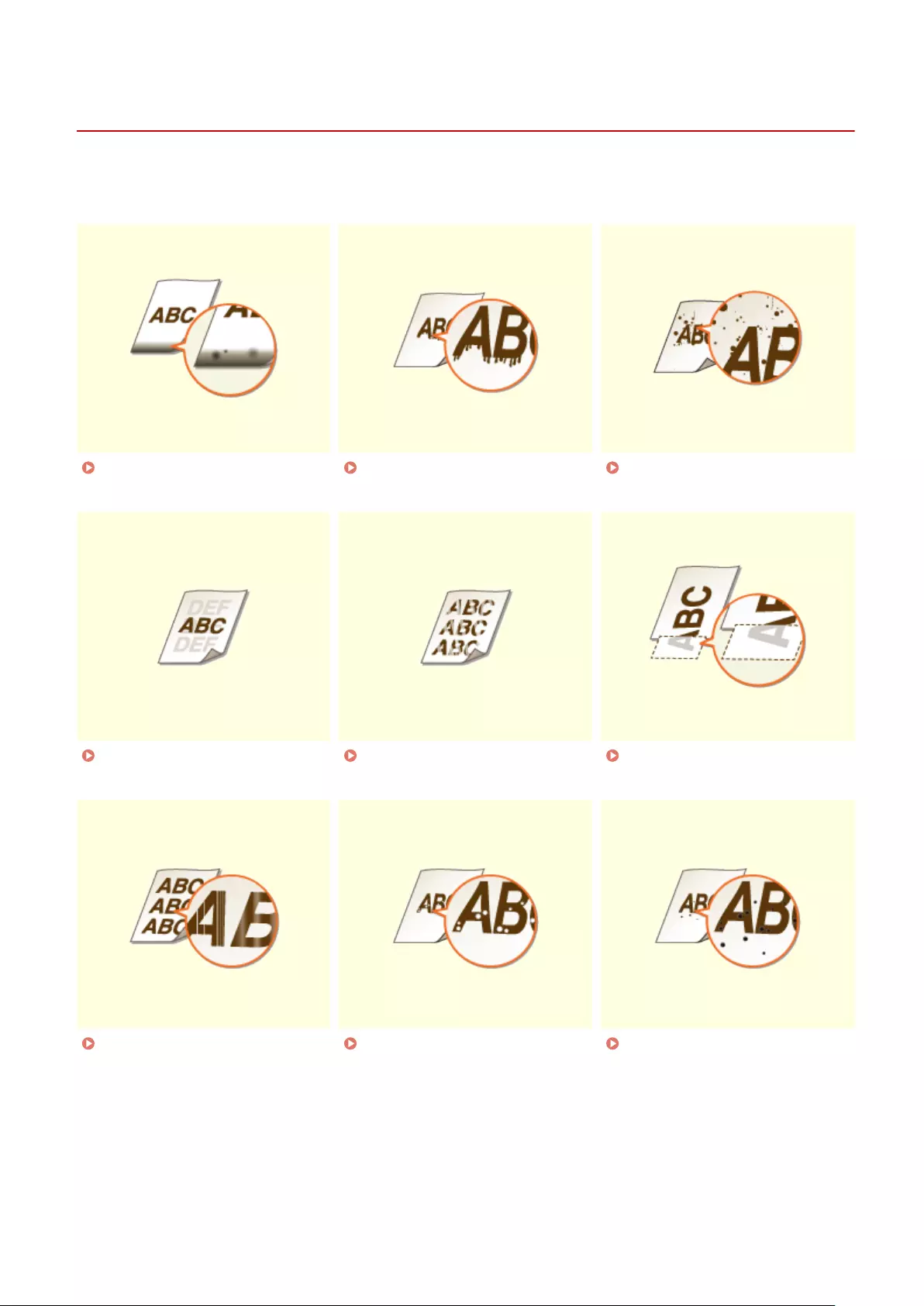
When You Cannot Print Properly
0X7U-06C
If printing results are not satisfactory, or paper creases or curls, try the following solutions. If the problems persist,
contact your local authorized Canon dealer or the Canon help line.
Smudge Marks Appear on the
Bottom Edge of Printouts(P. 505)
Smudges Appear on
Printouts(P. 505)
Toner Smudges and Splatters
Appear(P. 506)
Afterimages Appear in Blank
Areas(P. 506)
Printouts Are Faded(P. 507) A Portion of the Page Is Not
Printed(P. 507)
Streaks Appear/Printing is
Uneven(P. 508)
White Spots Appear(P. 508) Black Spots Appear(P. 509)
Troubleshooting
503

Printing Results Are Not Satisfactory
0X7U-06E
Dirt inside the machine may affect printing results. Perform care and cleaning to the machine rst.
Cleaning the Machine(P. 518)
Smudge Marks Appear on the Bottom Edge of Printouts
Are you using appropriate paper?
●Check the supported paper types and replace with an appropriate type.Also, specify the paper size and
type settings properly.
Paper(P. 569)
Loading Paper(P. 37)
Specifying Paper Size and Type(P. 59)
Do you print data without margins?
●This symptom occurs if a margin is set to none in the printer driver. The marginal areas within the rst 5
mm from the respective edges of paper are not printable (for envelopes, the top and bottom marginal
areas within the rst 10 mm from the top/bottom edge are not printable). Make sure to have margins
around the document to print.
[Finishing] tab [Advanced Settings] [Expand Print Region and Print] [Off]
Smudges Appear on Printouts
Are you using appropriate paper?
●Check usable paper, and replace with appropriate paper.
Paper(P. 569)
Loading Paper(P. 37)
Troubleshooting
505
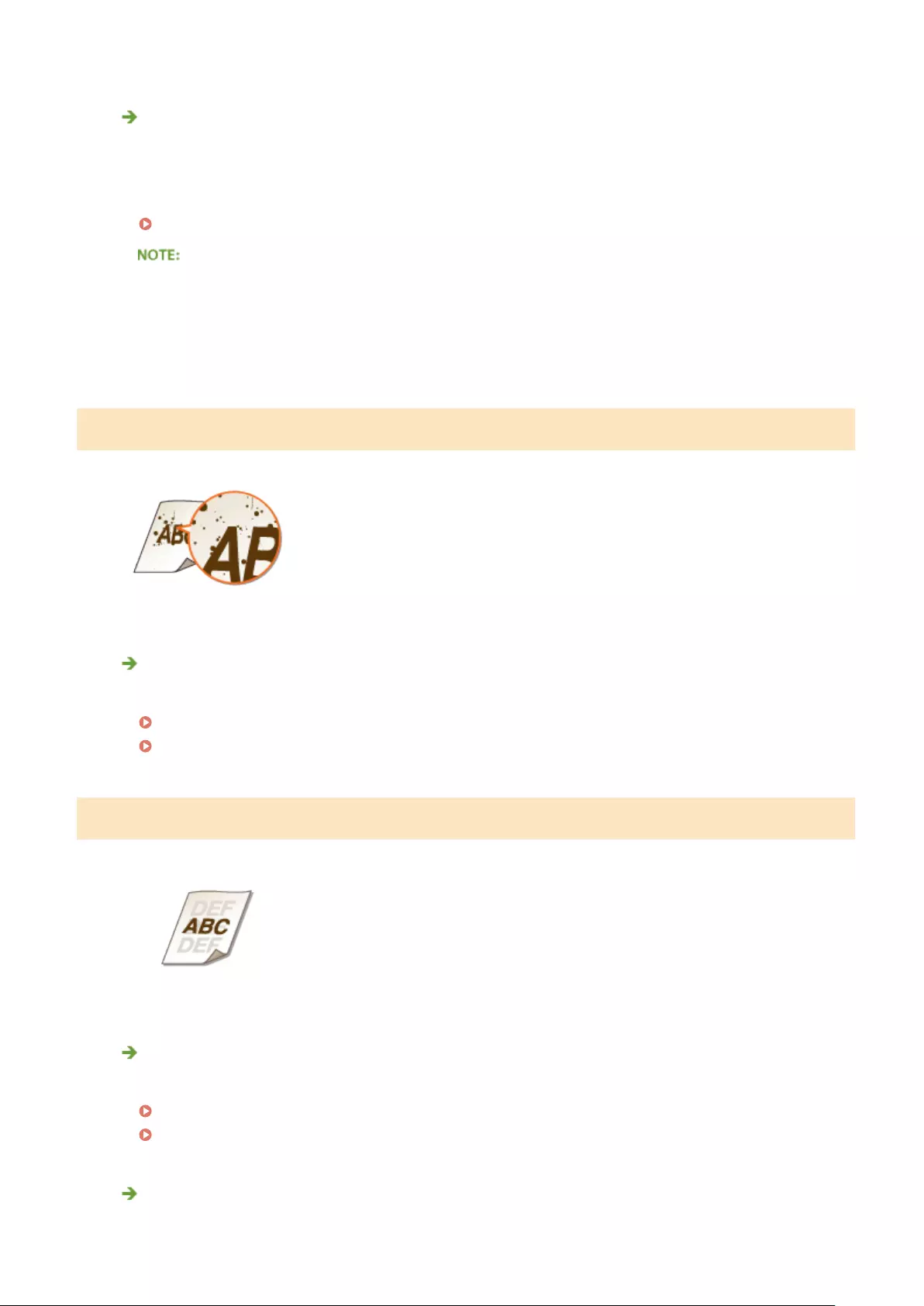
Do streaks appear on printouts depending on the paper type or the operating
environment?
●Change the setting for <Special Print Mode A>. The improvement effect is weakest with <Mode 1> and
strongest with <Mode 4>. Try the adjustment starting with <Mode 1>.
Special Print Mode A(P. 409)
●This item cannot be set when <Barcode Adj. Mode> is set to one of <Mode 1> to <Mode 4>.
●Print density will be lighter when you select stronger improvement. It may also result in less sharp edges
and rougher details.
●If you set this item to <Mode 3> or <Mode 4>, the printing speed becomes slower.
Toner Smudges and Splatters Appear
Are you using appropriate paper?
●Check usable paper, and replace with appropriate paper.
Paper(P. 569)
Loading Paper(P. 37)
Afterimages Appear in Blank Areas
Are you using appropriate paper?
●Check usable paper, and replace with appropriate paper.
Paper(P. 569)
Loading Paper(P. 37)
Is it time to replace the toner cartridge?
●Materials inside the toner cartridge may have deteriorated. Replace the toner cartridge.
Troubleshooting
506

How to Replace Toner Cartridges(P. 524)
Printouts Are Faded
Is the amount remaining in toner cartridge running low?
●Check how much toner is left, and replace the toner cartridge as necessary.
Replacing Toner Cartridges(P. 521)
Are you using appropriate paper?
●Check usable paper, and replace with appropriate paper. Also, specify the paper size and type settings
properly.
Paper(P. 569)
Loading Paper(P. 37)
Specifying Paper Size and Type(P. 59)
A Portion of the Page Is Not Printed
Do the paper guides align with the edges of the paper?
●If the paper guides are too loose or too tight, part of a document may not be printed.
Loading Paper(P. 37)
Do you print data without margins?
●This symptom occurs if a margin is set to none in the printer driver. The marginal areas within the rst 5
mm from the respective edges of paper are not printable (for envelopes, the top and bottom marginal
areas within the rst 10 mm from the top/bottom edge are not printable). Make sure to have margins
around the document to print.
[Finishing] tab [Advanced Settings] [Expand Print Region and Print] [Off]
Troubleshooting
507
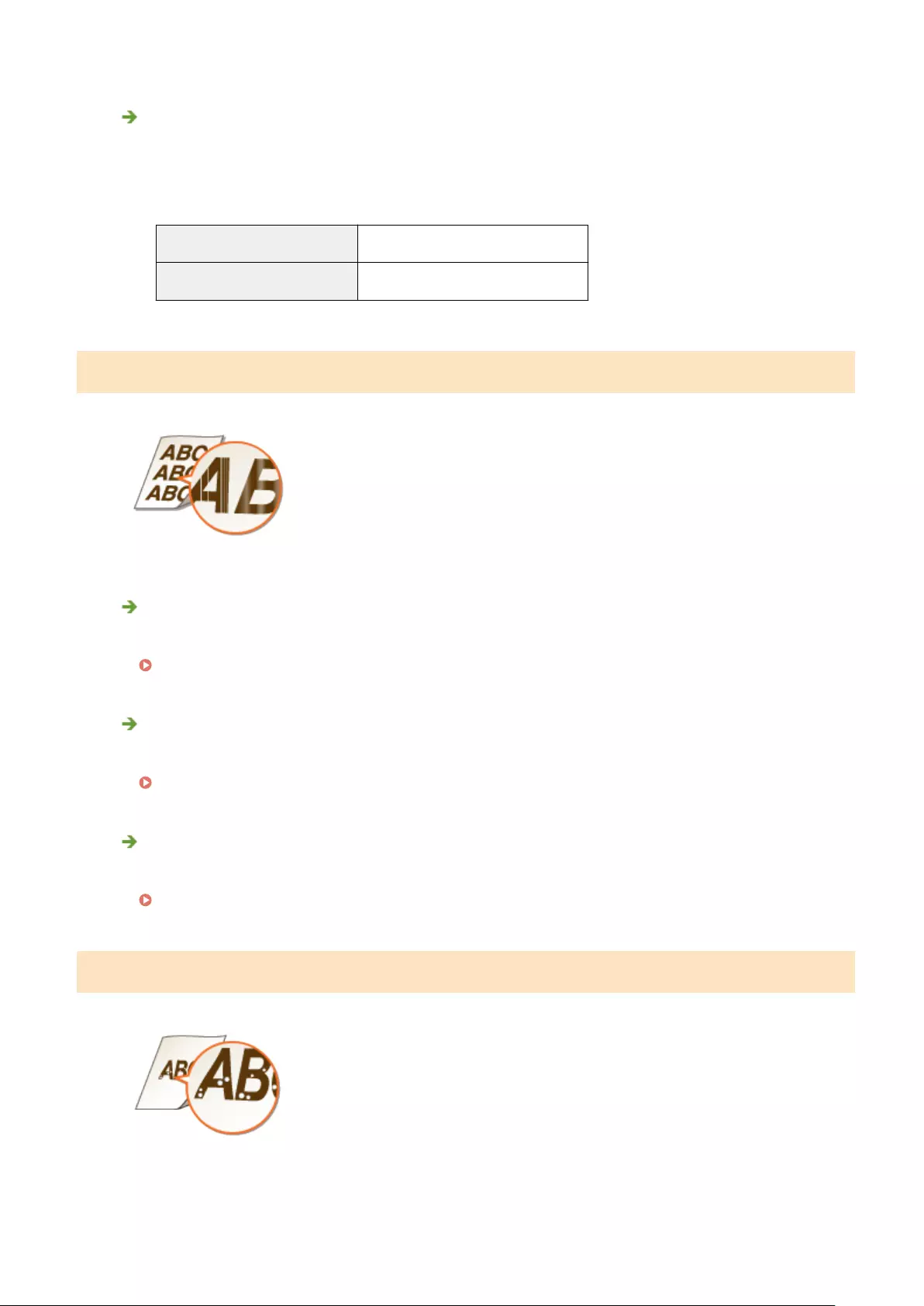
Are you using custom size paper loaded in correct orientation?
●Load the custom size paper in portrait orientation when you print without using the UFR II printer driver.
●Load the custom size paper in landscape orientation if the following conditions are met when you are
using the UFR II printer driver.
Paper Size in Select Feeder Menu <Free Size>
Loaded Paper Long edge length is 215.9 mm or less.
Streaks Appear/Printing is Uneven
Have you cleaned the xing unit?
●Clean the xing unit.
Fixing Unit(P. 520)
Is the amount remaining in toner cartridge running low?
●Check how much toner is left, and replace the toner cartridge as necessary.
Replacing Toner Cartridges(P. 521)
Is it time to replace the toner cartridge?
●Materials inside the toner cartridge may have deteriorated. Replace the toner cartridge.
How to Replace Toner Cartridges(P. 524)
White Spots Appear
Troubleshooting
508
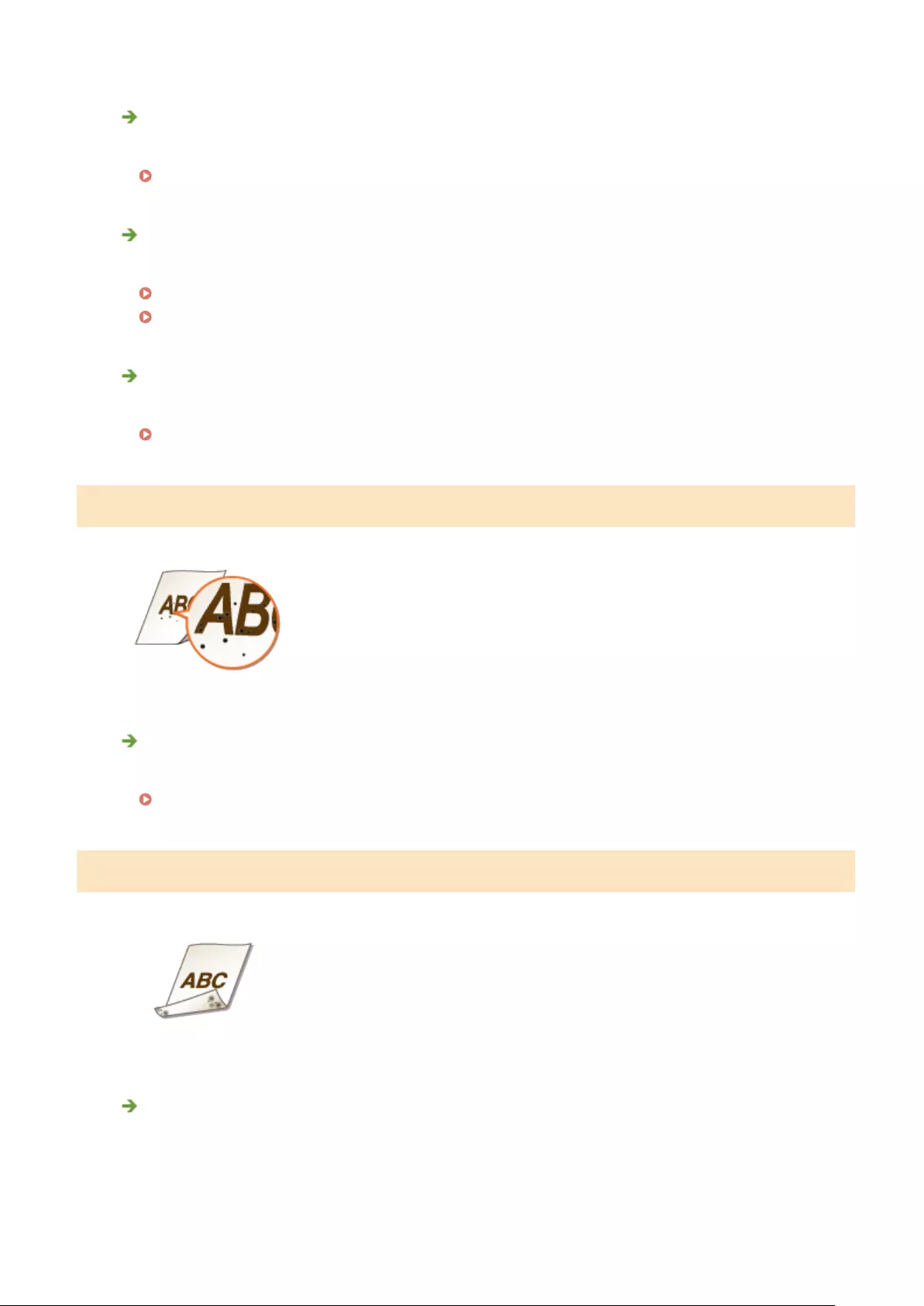
Are you using paper that has absorbed moisture?
●Replace with appropriate paper.
Loading Paper(P. 37)
Are you using appropriate paper?
●Check usable paper, and replace with appropriate paper.
Paper(P. 569)
Loading Paper(P. 37)
Is it time to replace the toner cartridge?
●Materials inside the toner cartridge may have deteriorated. Replace the toner cartridge.
How to Replace Toner Cartridges(P. 524)
Black Spots Appear
Have you cleaned the xing unit?
●Clean the xing unit.
Fixing Unit(P. 520)
Reverse Side of Paper is Smudged
Have you loaded paper that is smaller than the size of the print data?
●Check to make sure that the paper size matches the size of the print data.
Troubleshooting
509
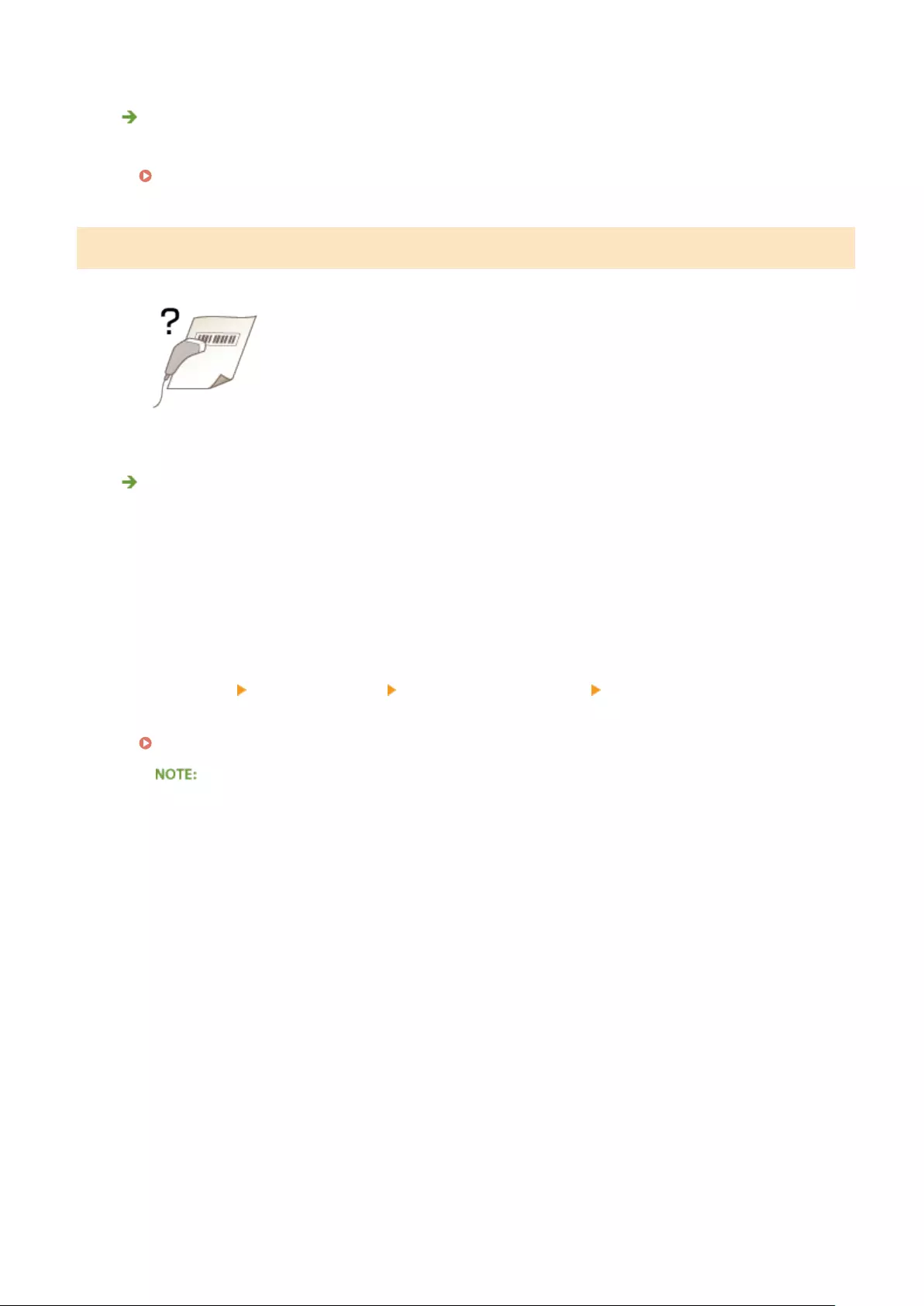
Have you cleaned the xing unit?
●Clean the xing unit.
Fixing Unit(P. 520)
Printed Barcode Cannot Be Read
Are you using a small barcode or a barcode consisting of thick lines?
●Enlarge the barcode.
●If the direction of lines in the barcode is perpendicular to the paper output direction, turn the image 90
degrees to make the lines parallel to the paper output direction.
●If the problem persists even after performing the above operation, change the mode by using [Barcode
Adjustment Mode]. The improvement effect is weakest with [Mode 1] and strongest with [Mode 4]. Try the
adjustment starting with [Mode 1].
Setting in the Printer Driver
[Finishing] tab [Advanced Settings] [Barcode Adjustment Mode] Select the mode
Specifying Settings in the Setting Menu of the Operation Panel
Barcode Adj. Mode(P. 411)
●Print density will be lighter when you select stronger improvement.
●When printing from the computer, the setting in the printer driver takes precedence. When the setting
of [Graphics Mode] in the printer driver is changed to [UFR II Mode] and [Barcode Adjustment Mode] is
changed to [Printer Default], the setting in the operation panel takes precedence.
●When you set <Barcode Adj. Mode> to one of <Mode 1> to <Mode 4>, <Special Print Mode A> is
automatically set to <Off>.
Troubleshooting
510
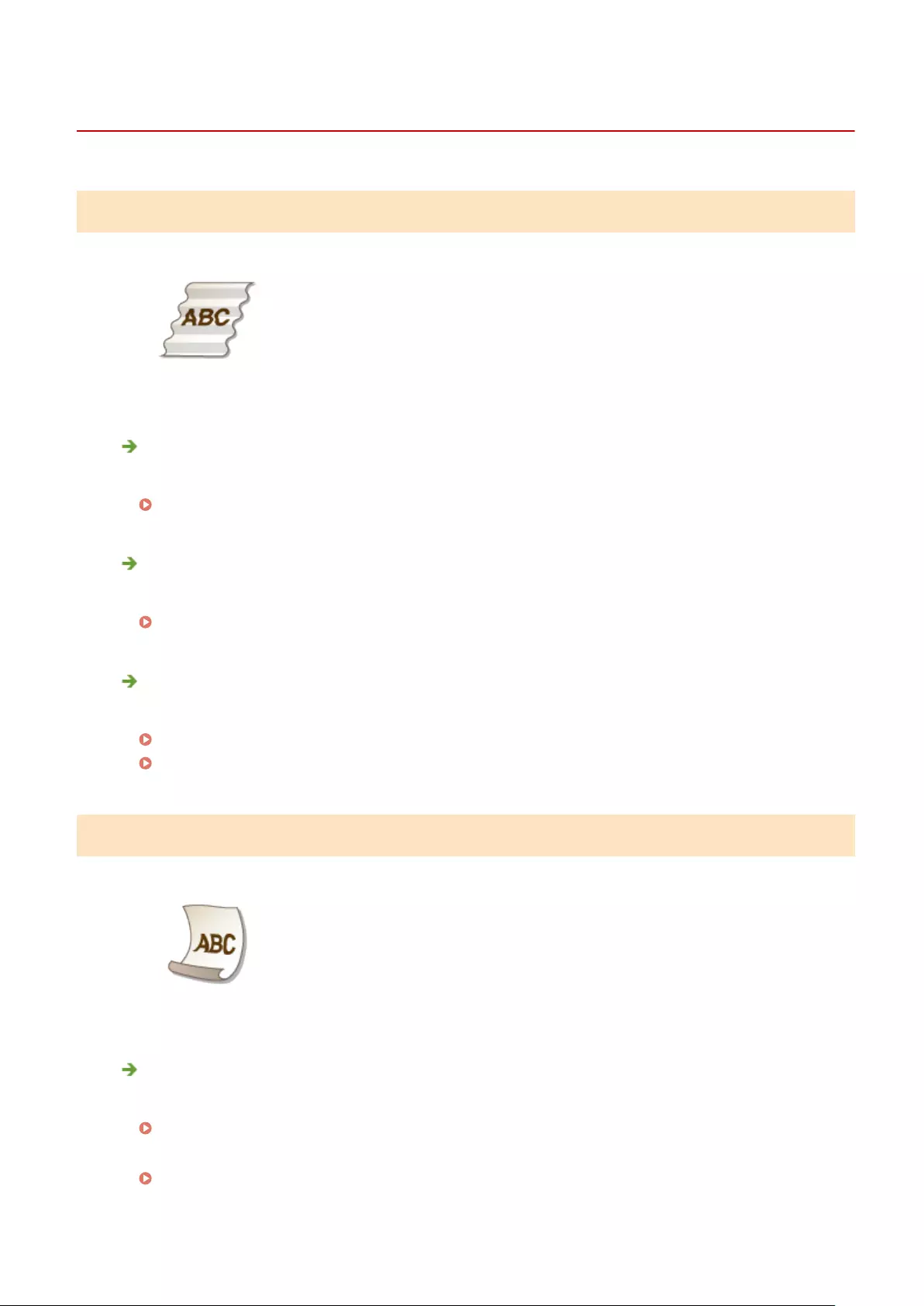
Paper Creases or Curls
0X7U-06F
Paper Creases
Is paper loaded correctly?
●If paper is not loaded below the load limit line or the load limit guide or is loaded obliquely, it may crease.
Loading Paper(P. 37)
Are you using paper that has absorbed moisture?
●Replace with appropriate paper.
Loading Paper(P. 37)
Are you using appropriate paper?
●Check usable paper, and replace with appropriate paper.
Paper(P. 569)
Loading Paper(P. 37)
Paper Curls
Are you using paper that has absorbed moisture?
●Replace with appropriate paper.
Loading Paper(P. 37)
●When the current setting of the paper type is <Plain>, change it to <Plain L>
Specifying Paper Size and Type(P. 59)
Troubleshooting
511
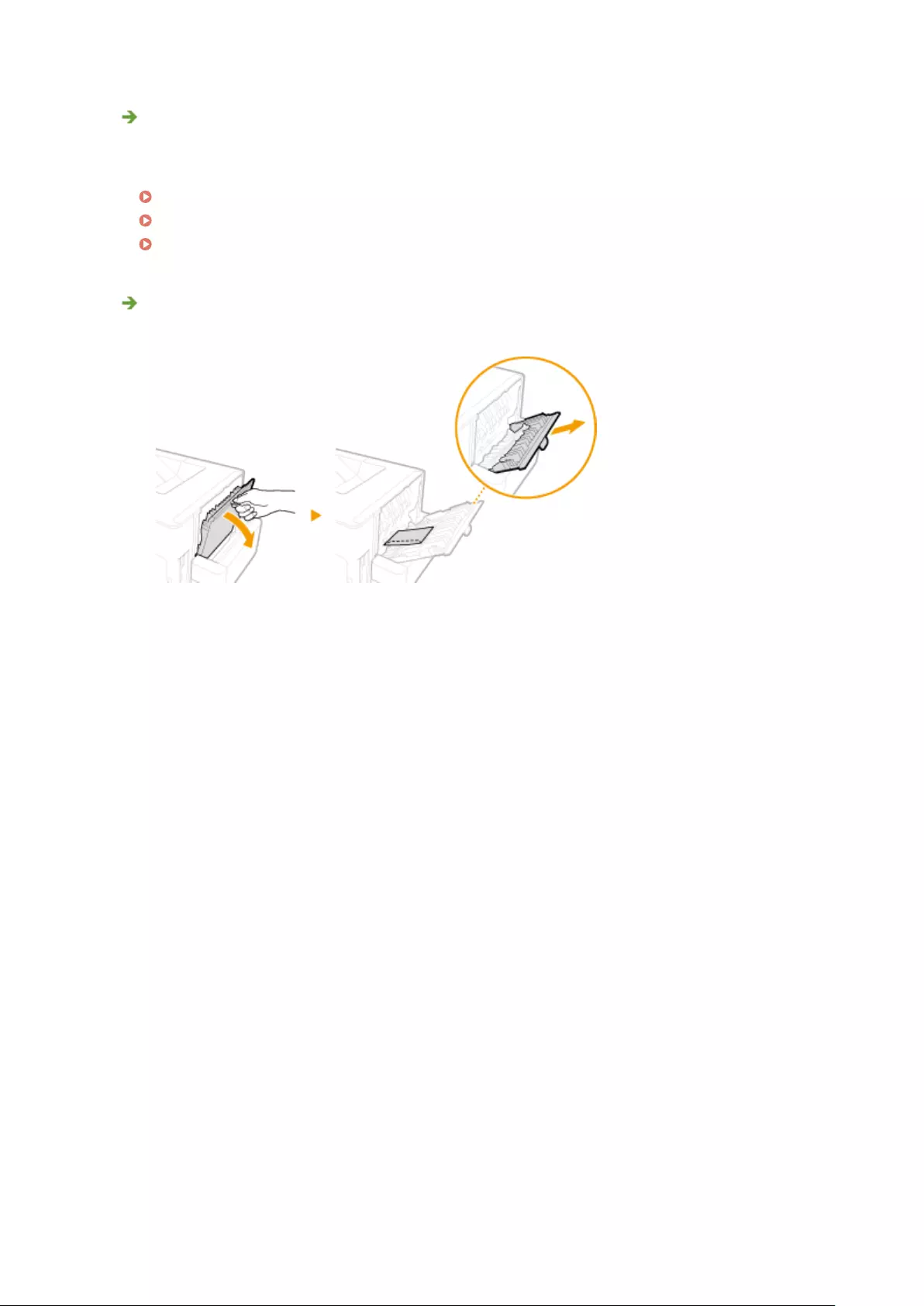
Are you using appropriate paper?
●Check usable paper, and replace with appropriate paper. Also, specify the paper size and type settings
properly.
Paper(P. 569)
Loading Paper(P. 37)
Specifying Paper Size and Type(P. 59)
Do you output printouts to the output tray?
●If printouts of envelopes curl, output them to the sub-output tray on the back side of the machine.
Troubleshooting
512
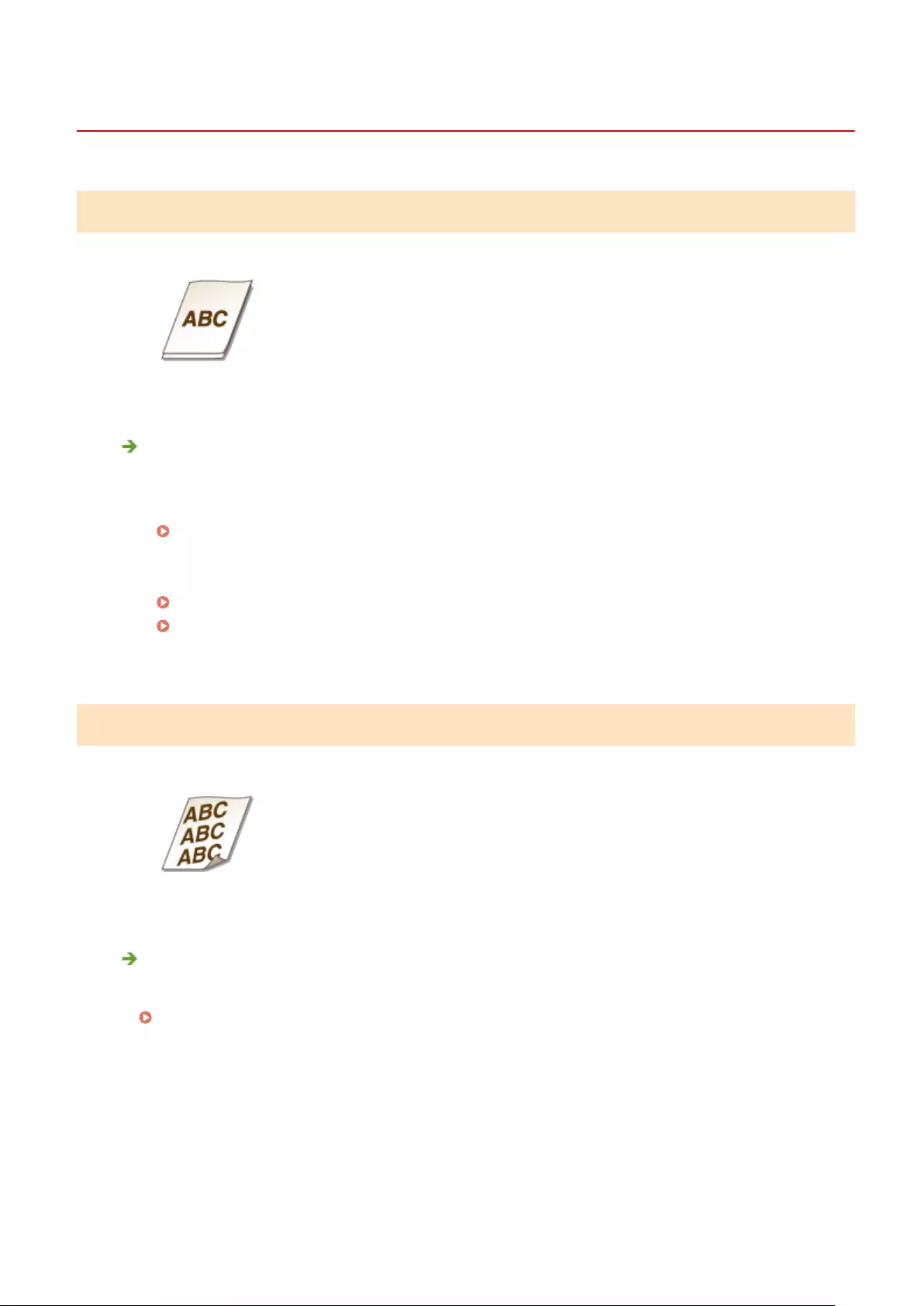
Paper Is Fed Incorrectly
0X7U-06H
Paper Is Not Fed/Two or More Sheets Are Fed Together
Is paper loaded correctly?
●Fan the paper stack thoroughly so that paper is not stuck together.
●Check whether paper is loaded correctly.
Loading Paper(P. 37)
●Check whether the number of sheets of paper loaded is appropriate and whether the appropriate paper is
used.
Paper(P. 569)
Loading Paper(P. 37)
●Check whether mixed sizes and types of paper are loaded together.
Printouts Are Skewed
Do the paper guides align with the edges of the paper?
●If the paper guides are too loose or too tight, the printouts are skewed.
Loading Paper(P. 37)
Troubleshooting
513
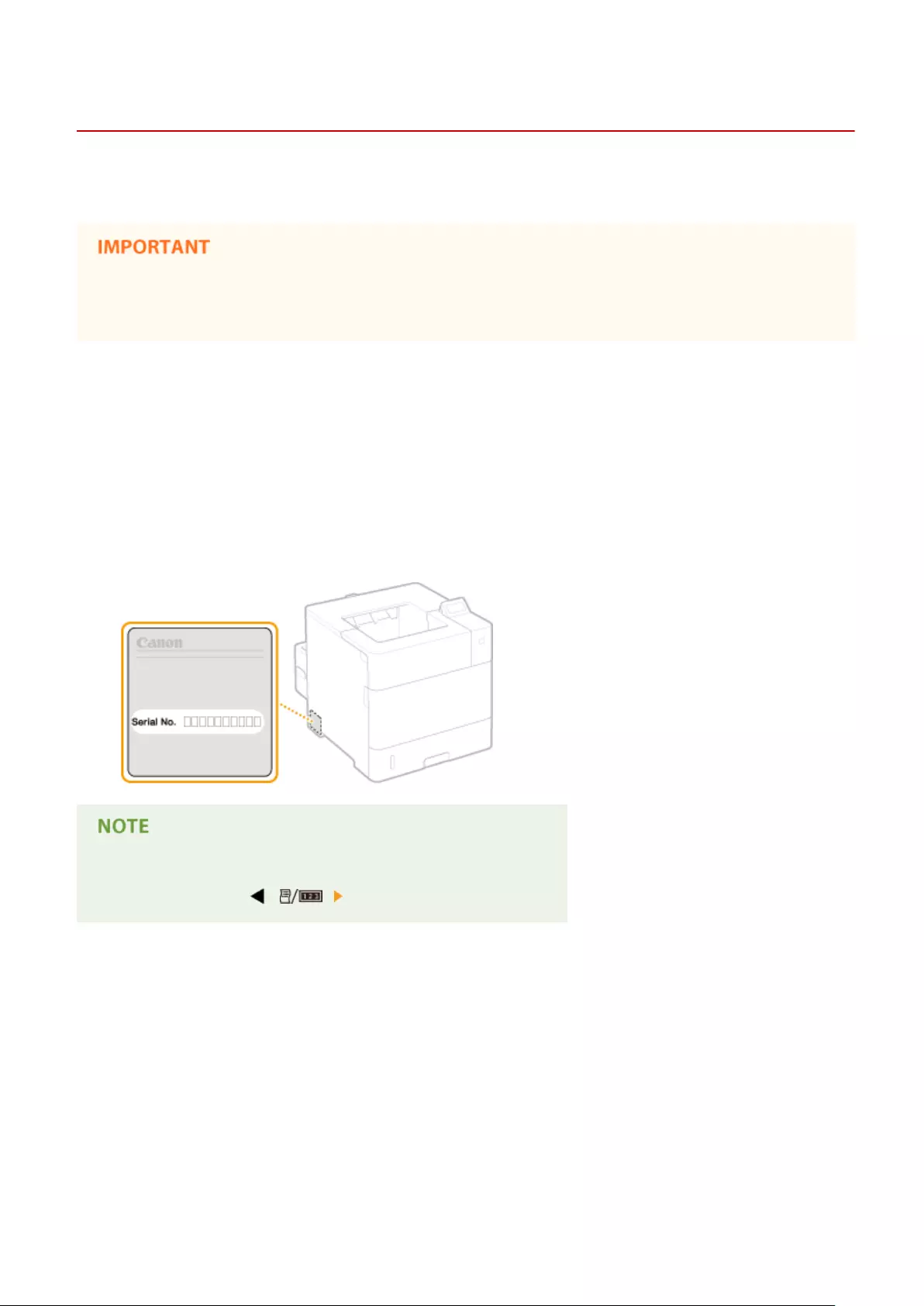
When a Problem Cannot Be Solved
0X7U-06J
If you cannot solve a problem by referring to the information in this chapter, contact your local authorized Canon
dealer or the Canon help line.
Do not disassemble or repair the machine yourself
●If you disassemble or repair the machine yourself, it may not be covered by warranty.
◼When Contacting Canon
When contacting us, have the following information ready:
●Product name (LBP352x/LBP351x)
●Dealer where you purchased the machine
●Details about your problem (such as what you did, what happened as a result, and displayed messages)
●Serial number (10 alphanumeric characters long, found on the label on the back side of the machine)
Checking the serial number from the operation panel
You can also check by ( ) <Serial Number>.
Troubleshooting
514

Maintenance
Maintenance ..................................................................................................................................................... 516
Cleaning the Machine ....................................................................................................................................... 518
Exterior ......................................................................................................................................................... 519
Fixing Unit .................................................................................................................................................... 520
Replacing Toner Cartridges .............................................................................................................................. 521
How to Replace Toner Cartridges ................................................................................................................. 524
Relocating the Machine .................................................................................................................................... 527
Maintaining and Improving Print Quality ....................................................................................................... 529
Adjusting Print Density ................................................................................................................................. 530
Adjusting Print Position ................................................................................................................................ 532
Printing Reports and Lists ................................................................................................................................ 536
Viewing the Counter Value ............................................................................................................................... 545
Checking Consumables ..................................................................................................................................... 548
Initializing Settings ........................................................................................................................................... 550
Initializing Menu ........................................................................................................................................... 551
Initializing the Network Settings ................................................................................................................... 552
Maintenance
515
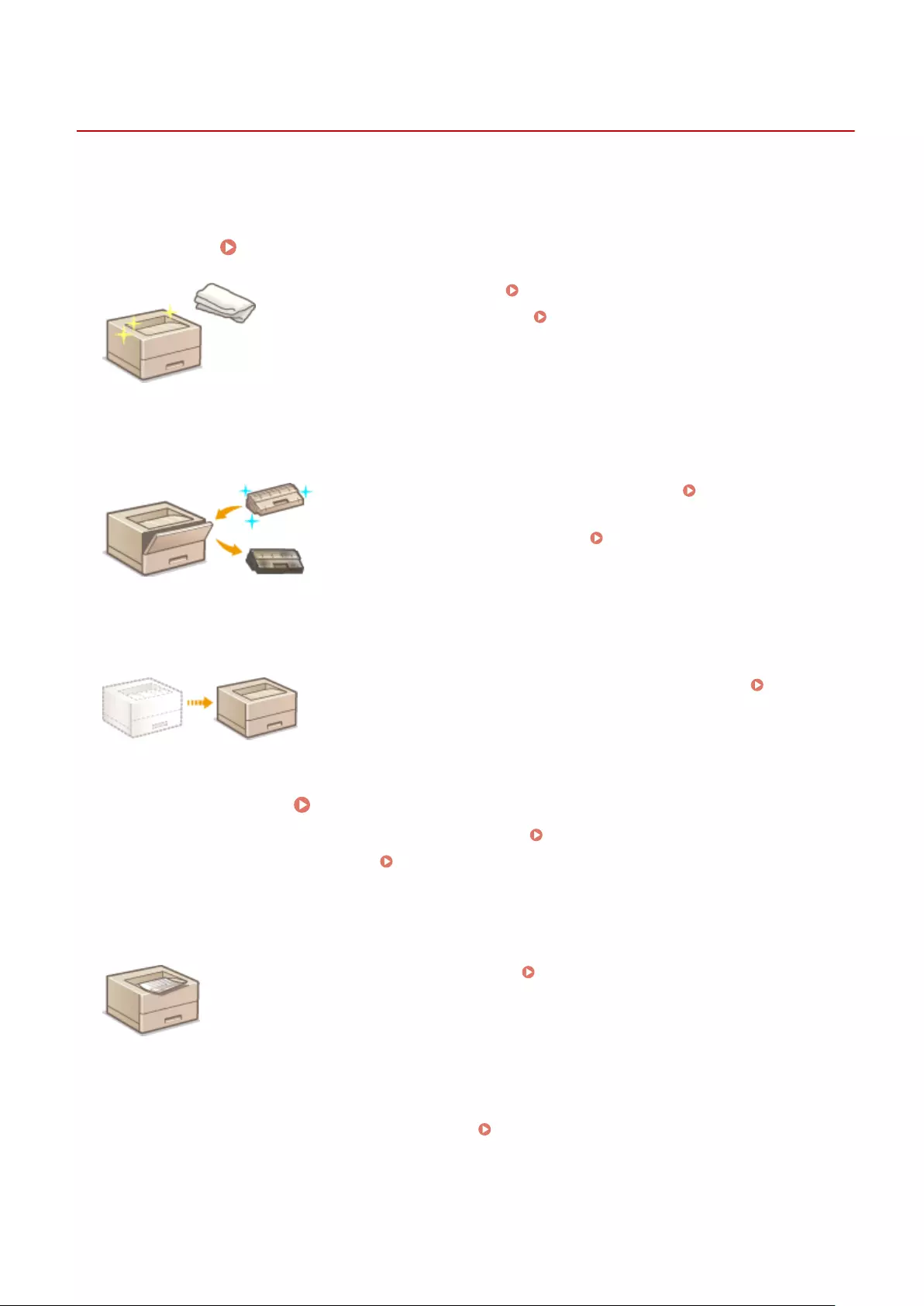
Maintenance
0X7U-06K
This chapter describes upkeep of the machine, including how to clean the machine and initialize settings.
◼Basic Cleaning Cleaning the Machine(P. 518)
●The machine becomes dirty, see Exterior(P. 519) .
●Black spots appear on printouts, see Fixing Unit(P. 520) .
◼Replacing Toner Cartridges
●If you want to check the remaining toner level, see Replacing Toner
Cartridges(P. 521) .
●How to replace toner cartridges, see How to Replace Toner
Cartridges(P. 524) .
◼Relocating the Machine
●Relocating the machine for maintenance or an oce move, see Relocating
the Machine(P. 527) .
◼Managing Print Quality Maintaining and Improving Print Quality(P. 529)
●If you want to adjust the toner density to be used for printing, see Adjusting Print Density(P. 530) .
●If you want to adjust the print position, see Adjusting Print Position(P. 532) .
◼Printing Reports and Lists
●Printing out lists of settings or the like , see Printing Reports and Lists(P. 536) .
◼Checking the Total Pages Printed by the Machine
If you want to check the total page number of printouts , see Viewing the Counter Value(P. 545) .
Maintenance
516
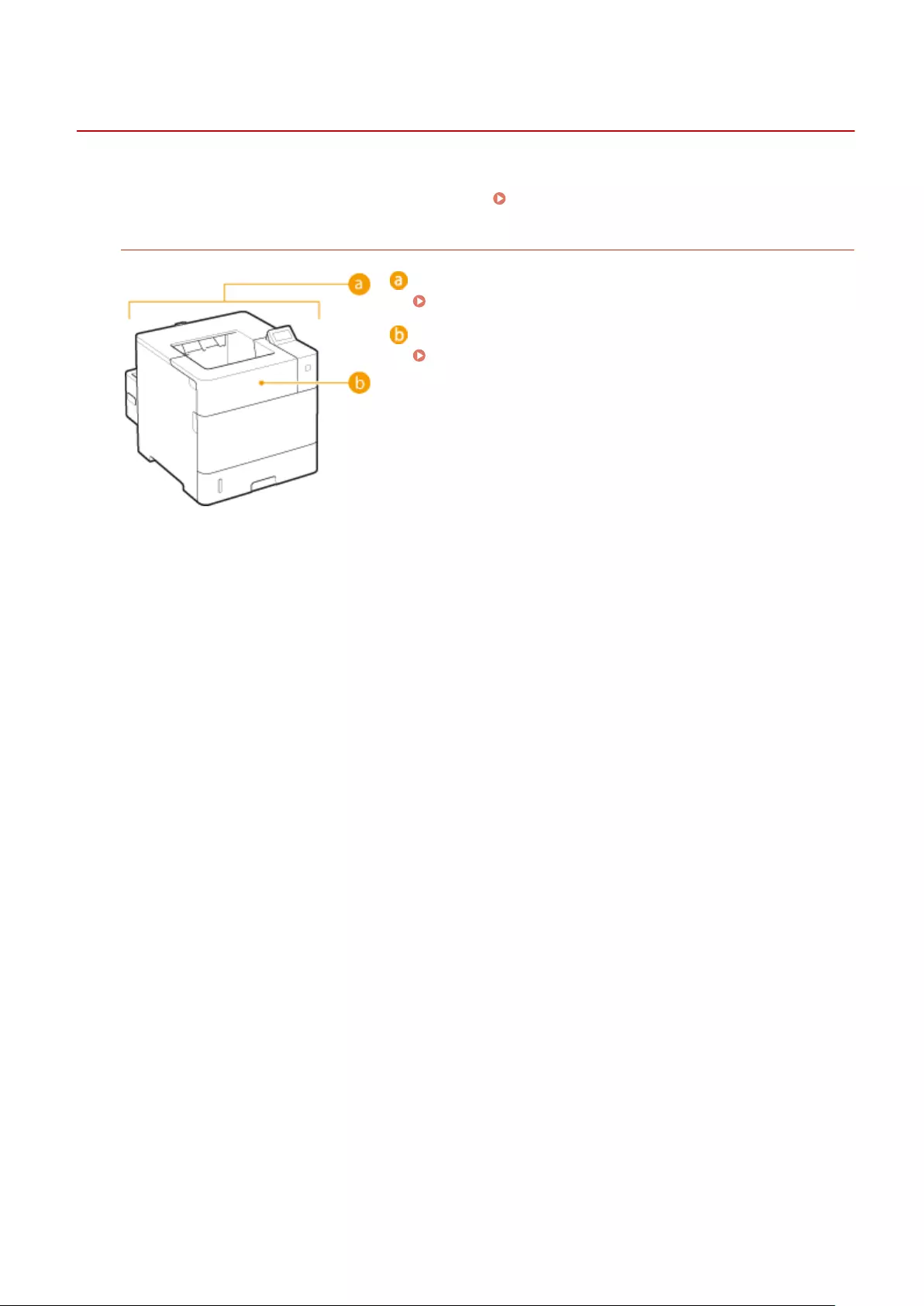
Cleaning the Machine
0X7U-06L
Regularly clean the machine to prevent deterioration in printing quality and to ensure that you use it safely and easily.
Carefully read the safety instructions before you start cleaning. Maintenance and Inspections(P. 9)
Where to Clean
Exterior of the machine and ventilation slots
Exterior(P. 519)
Internal xing unit
Fixing Unit(P. 520)
Maintenance
518
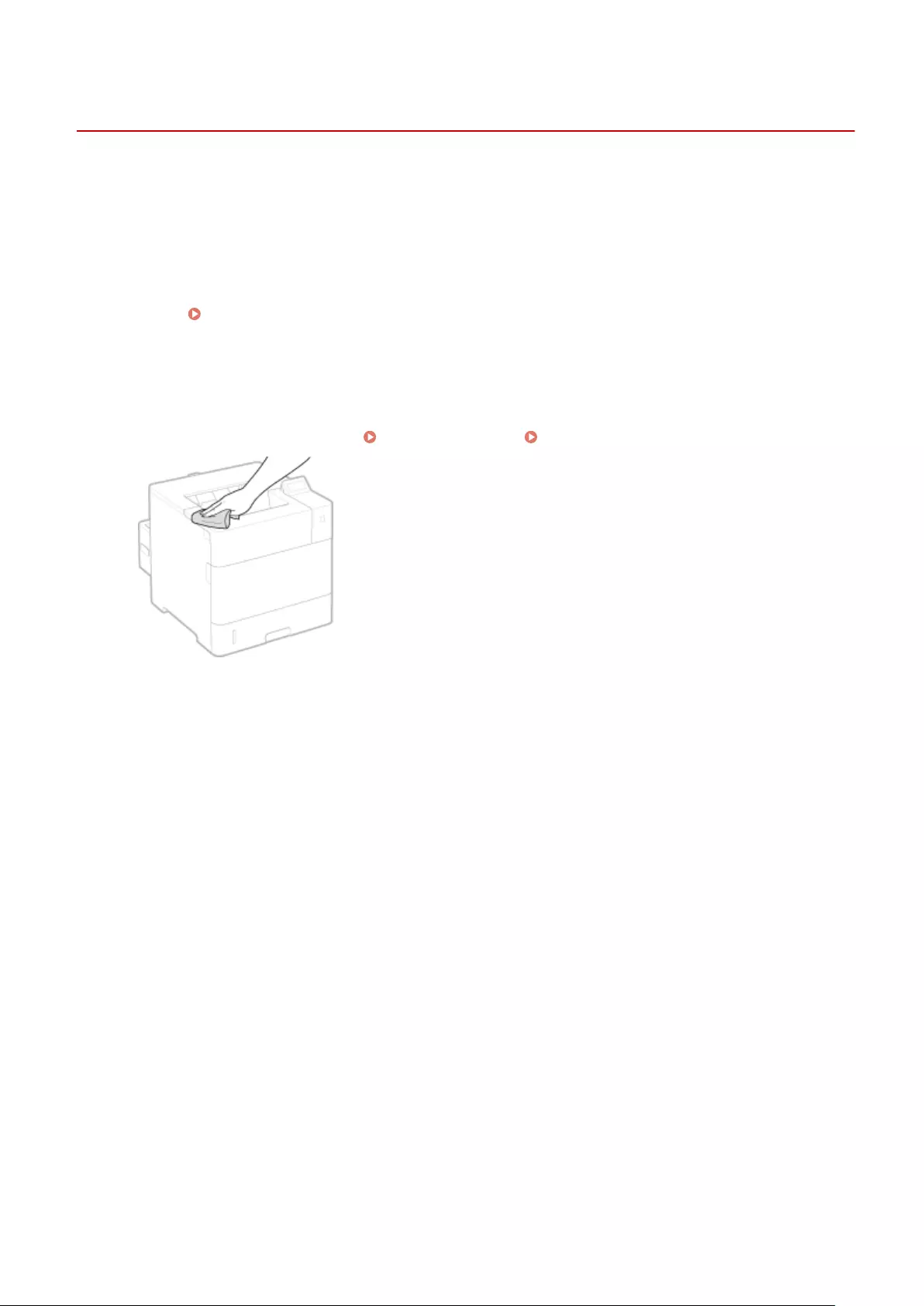
Exterior
0X7U-06R
Regularly wipe the exterior of the machine, especially around the ventilation slots, to keep the machine in good
condition.
1Turn OFF the machine, and unplug the power cord from the AC power outlet.
●When you turn OFF the power, shut down the machine from the operation panel without using the power
switch. Turning OFF the Power (Performing a Shutdown)(P. 33)
2Clean the exterior of the machine and the ventilation slots.
●Use a soft, well-wrung-out cloth dampened with water or a mild detergent diluted with water.
●To locate the ventilation slots, see Front Side(P. 17) and Back Side(P. 19) .
3Wait for the exterior of machine to dry completely.
4Reconnect the power cord and turn ON the machine.
Maintenance
519
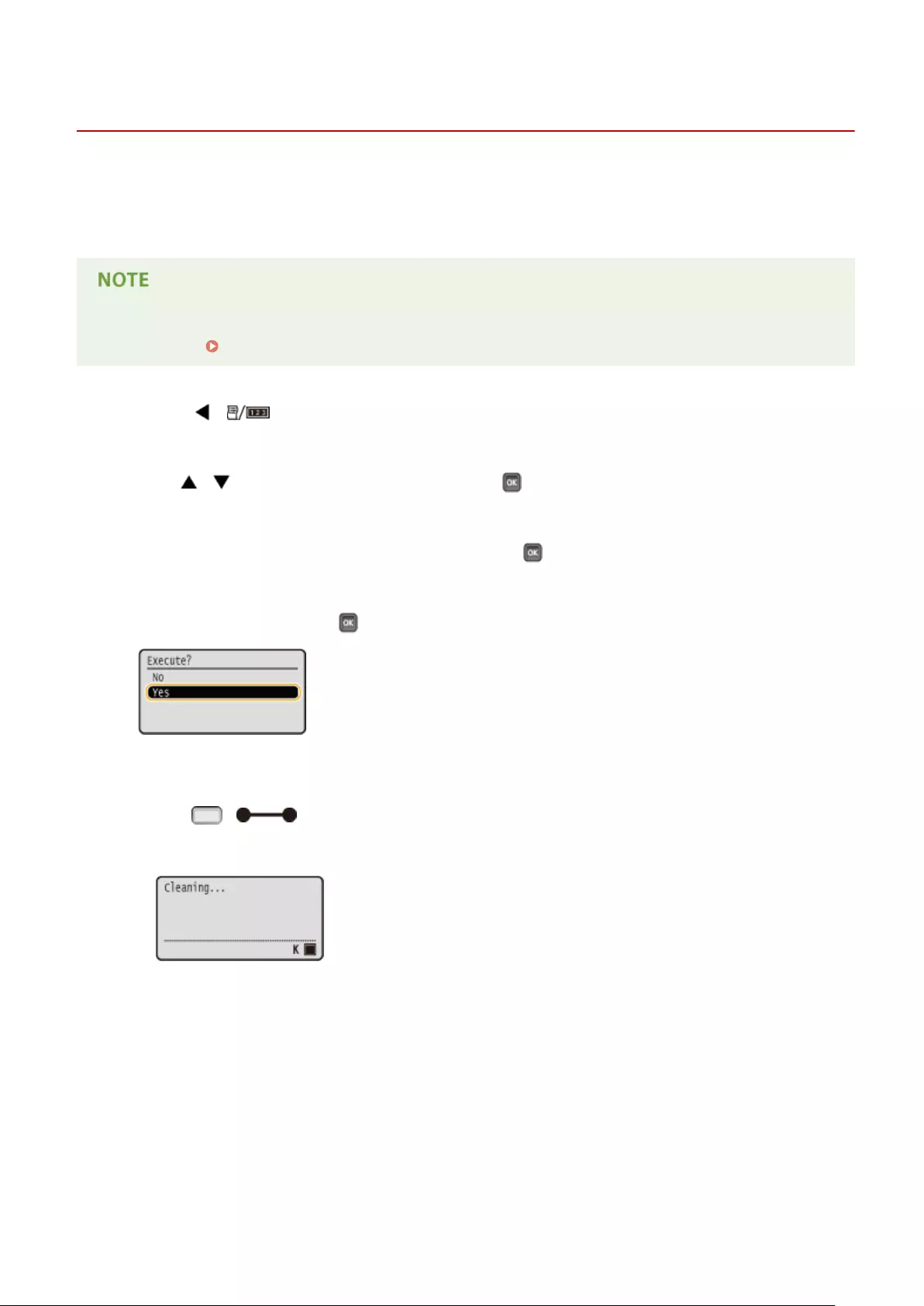
Fixing Unit
0X7U-06S
Dirt may adhere to the xing units inside the machine and cause black spots to appear on printouts. To clean the
xing unit, perform the following procedure. Note that you cannot clean the xing unit when the machine has
documents waiting to be printed. Note that cleaning the xing unit requires A4 or Letter size paper with a weight of 60
to 120 g/m². Set the paper in the multi-purpose tray before performing the following procedure.
●Cleaning consumes the toner cartridge. Make sure that there is sucient toner cartridge remaining
beforehand. Checking the Amount Remaining in the Toner Cartridge(P. 522)
1Press ( ).
2Use / to select <Cleaning>, and press .
3Select the size of the loaded paper, and press .
4Select <Yes>, and press .
➠The <Set cleaning paper and press the Online key.> message appears on the display.
5Press ( ).
➠The cleaning paper is slowly fed into the machine and the cleaning of the xing unit starts.
●You cannot stop the cleaning halfway. Wait until the cleaning is completed (approx. 165 seconds).
Maintenance
520

Replacing Toner Cartridges
0X7U-06U
The machine will display a message when a toner cartridge is nearly empty. Note that the print quality becomes poor if
you continue printing without taking any action. You can check the amount remaining in the toner cartridge on the
display.
When a Message Appear(P. 521)
If Printouts are Poor in Quality(P. 522)
Checking the Amount Remaining in the Toner Cartridge(P. 522)
◼When a Message Appear
Depending on which message is displayed, you will need to make sure that you have a replacement toner cartridge
ready or replace the toner cartridge. How to Replace Toner Cartridges(P. 524) Consumables(P. 573)
<16 Tnr cart. will soon reach end of lifetime.>
<Toner cartridge will soon reach end of lifetime.>
This message noties you that a toner cartridge needs to be replaced soon. Make sure that you have a
replacement toner cartridge ready. Replace the toner cartridge if you see this message before you start to print
a large job.
●When the <Toner cartridge will soon reach end of lifetime.> message is displayed, the printing is
temporarily stopped. To resume the printing, press ( ).
●Which message is to be displayed depends on the <Warning Step> setting in the setting menu of the
operation panel. Warning Step(P. 364)
●You can set any value as the percentage of the amount remaining in the toner cartridge that triggers
this message. Spec Tnr Chk Timing(P. 414)
<1G Change toner cartridge recommended.>
The toner cartridge has reached the end of its lifetime. It is recommended that you replace this cartridge with a
new one.
●You can continue printing when this message is displayed, but the print quality may deteriorate.
●Receiving e-mail and fax documents will be disabled. Printing Received E-mail (E-Mail Print)
(P. 157)
Maintenance
521
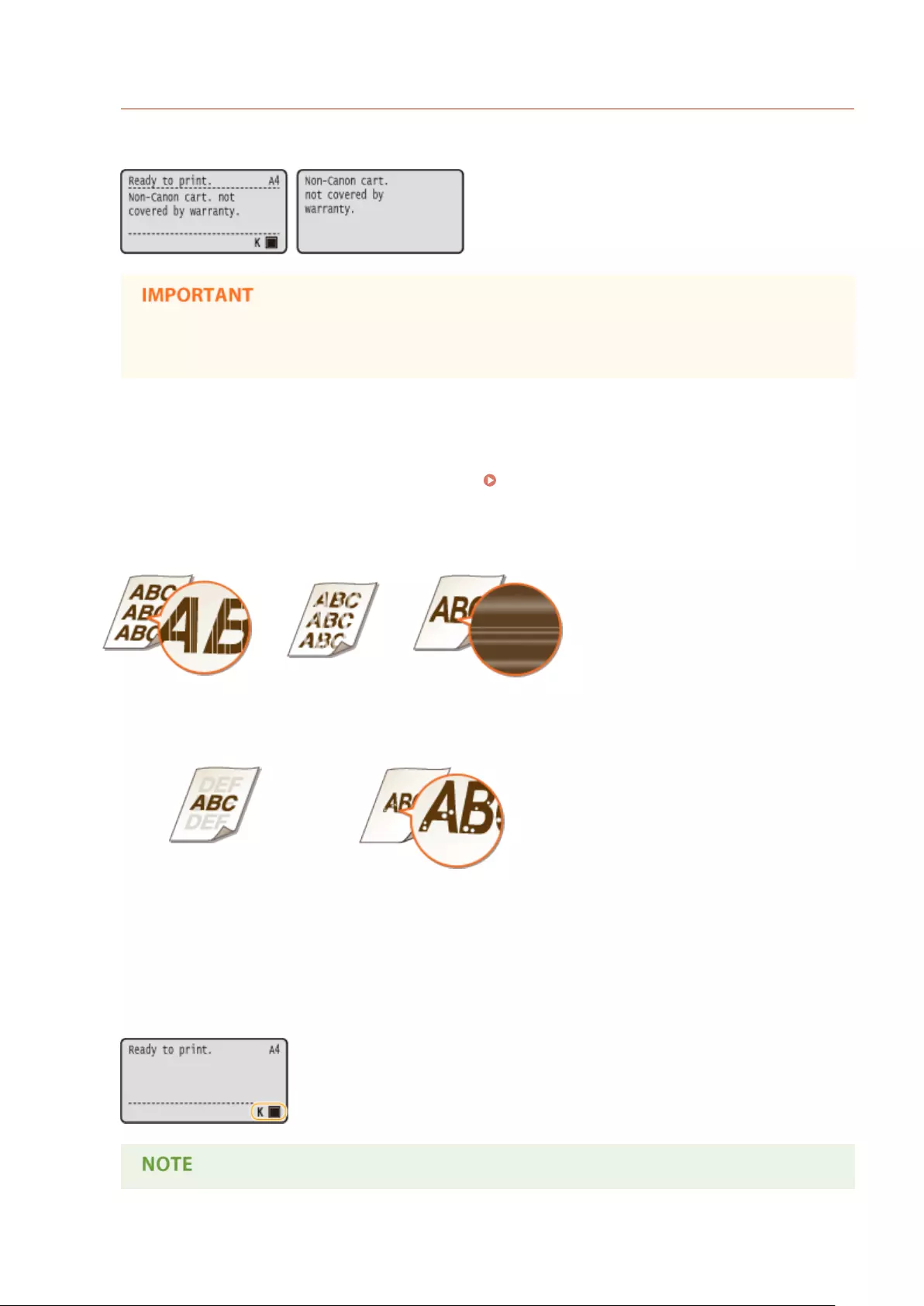
<Non-Canon cart. not covered by warranty.>
This message noties you that the machine may not print in optimum quality. It is recommended that you
replace this cartridge with a new one.
●You can continue printing when this message is displayed, but the print quality may deteriorate.
Doing so may result in damage to the machine.
◼If Printouts are Poor in Quality
If your printouts begin to show any of the following features, one of your toner cartridges is consumed. Replace the
nearly empty toner cartridge even if no message is displayed. How to Replace Toner Cartridges(P. 524)
Streaks appear Partially faded Uneven density
Afterimages appear in blank areas White spots appear
◼Checking the Amount Remaining in the Toner Cartridge
You can check the amount remaining in the toner cartridge on the main screen. It is recommended that you check the
amount before you start to print a large job.
Maintenance
522
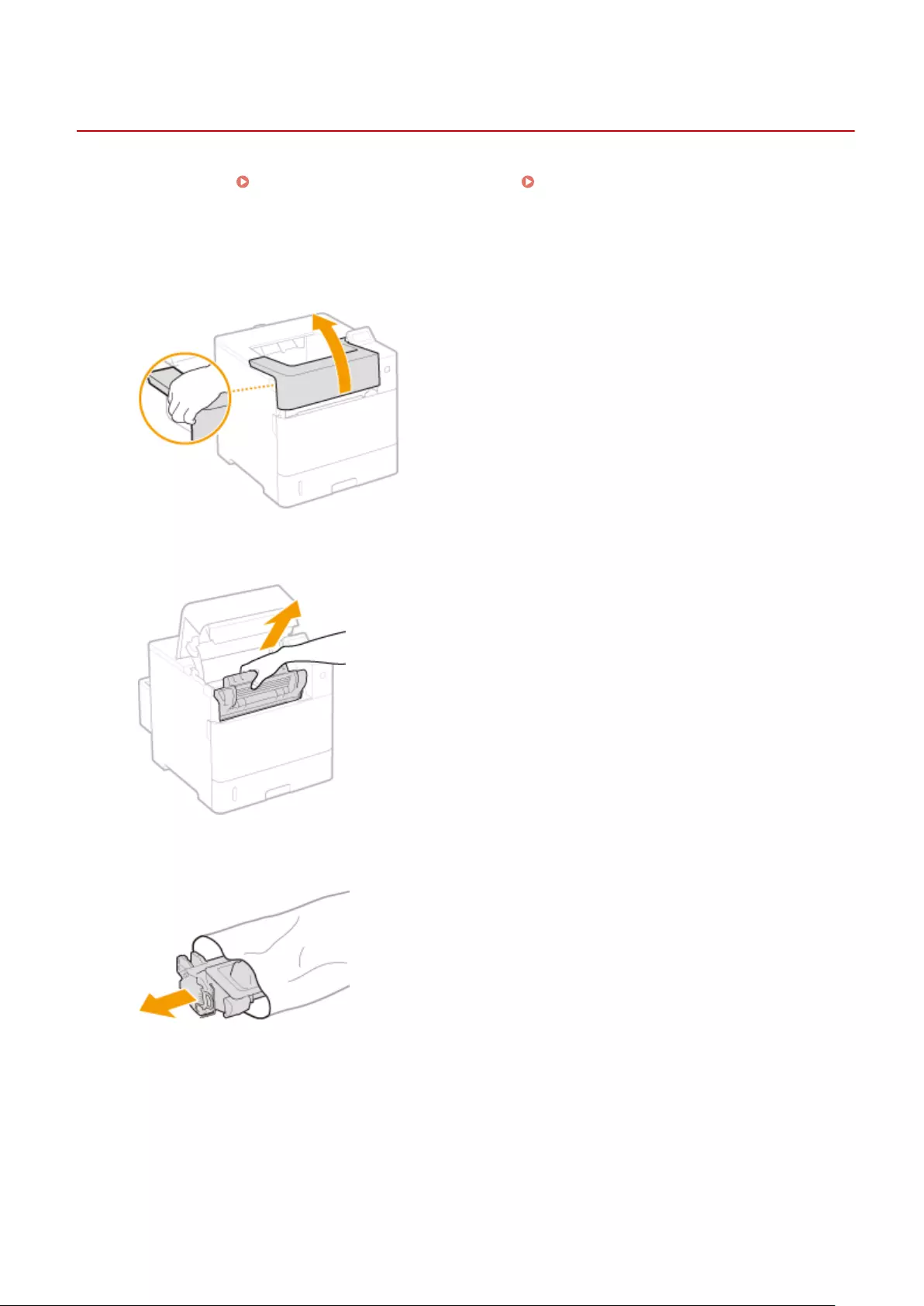
How to Replace Toner Cartridges
0X7U-06W
Read the precautions in Maintenance and Inspections(P. 9) and Consumables(P. 10) before replacing the toner
cartridges.
1Open the top cover.
●Hold the handle on the left side, and open the top cover.
2Remove the toner cartridge.
3Remove the replacement toner cartridge from the protective bag.
4Shake the toner cartridge ve or six times as shown below to evenly distribute the
toner inside the cartridge, and then place it on a at surface.
Maintenance
524
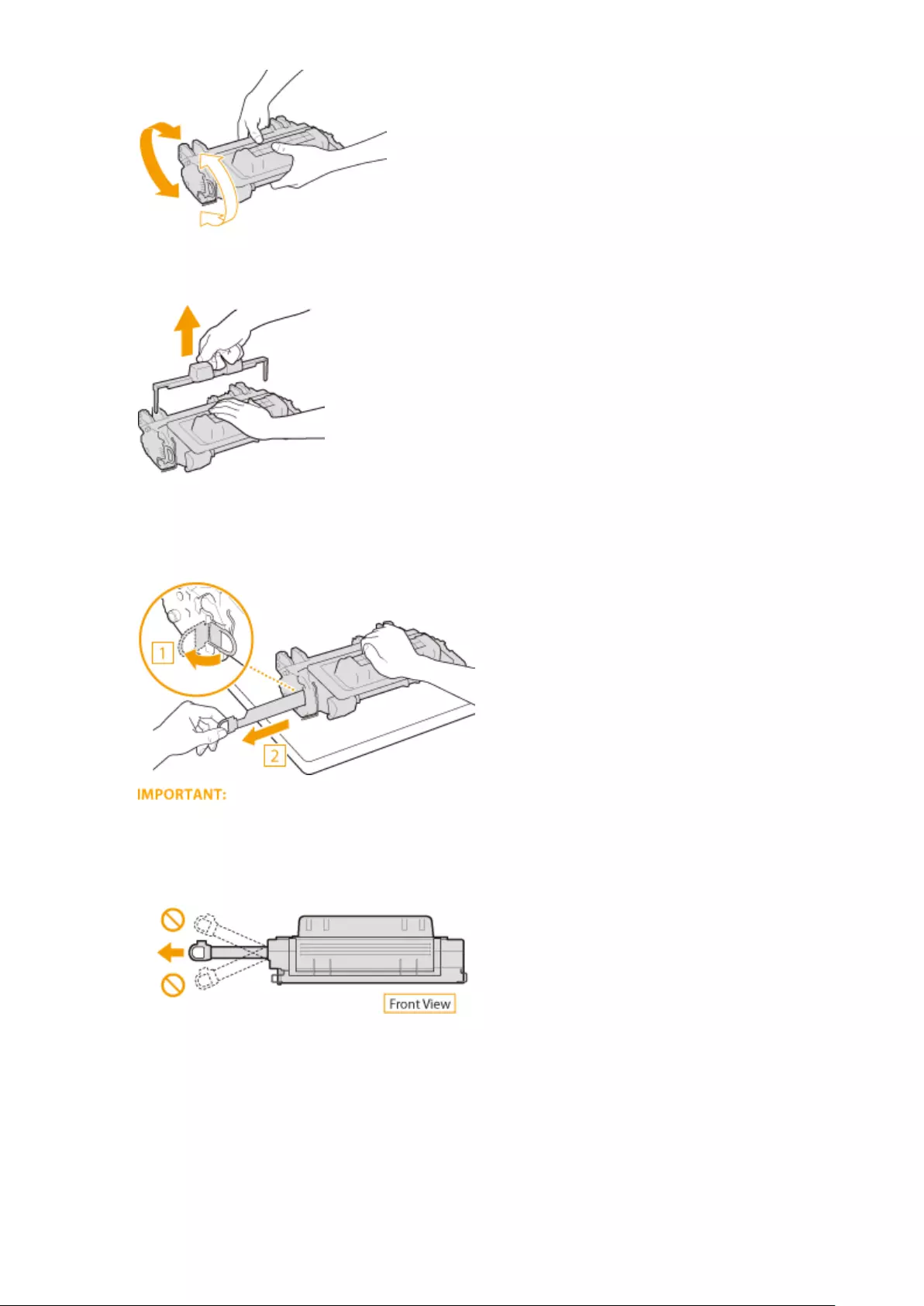
5Remove the Packing Materials.
6Pull the sealing tape straight out.
●The full length of the sealing tape is approximately 55 cm.
When pulling out the sealing tape
If the sealing tape remains inside the toner cartridge, the quality of printouts may deteriorate.
●Do not pull out the sealing tape at an angle or sideways. If the tape breaks, you may not be able to pull it
out completely.
●If the sealing tape becomes stuck when pulling it out, keep pulling until it is completely removed.
7Install the toner cartridge.
●Fully push it in until it cannot go any further.
Maintenance
525
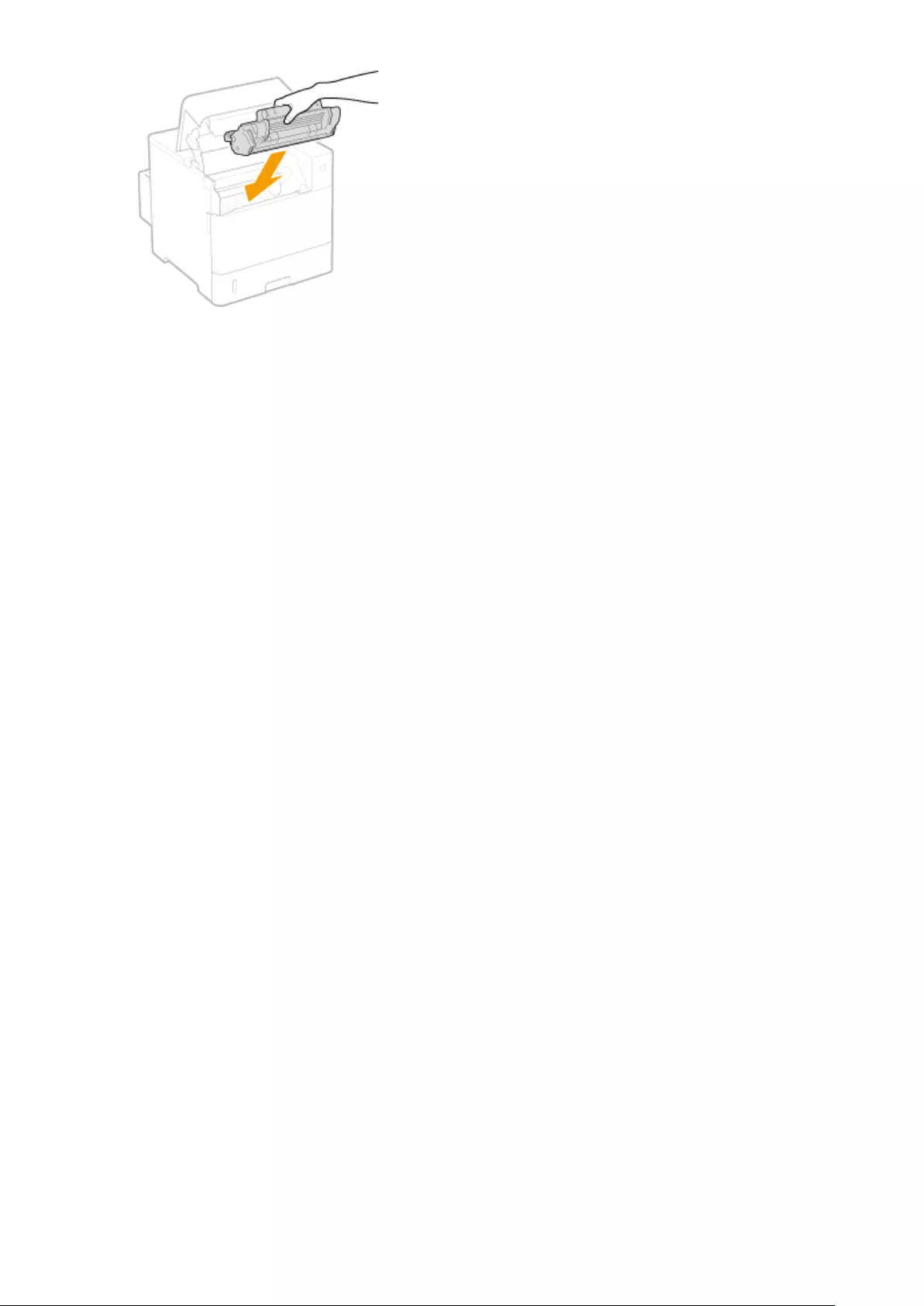
8Close the top cover.
Maintenance
526
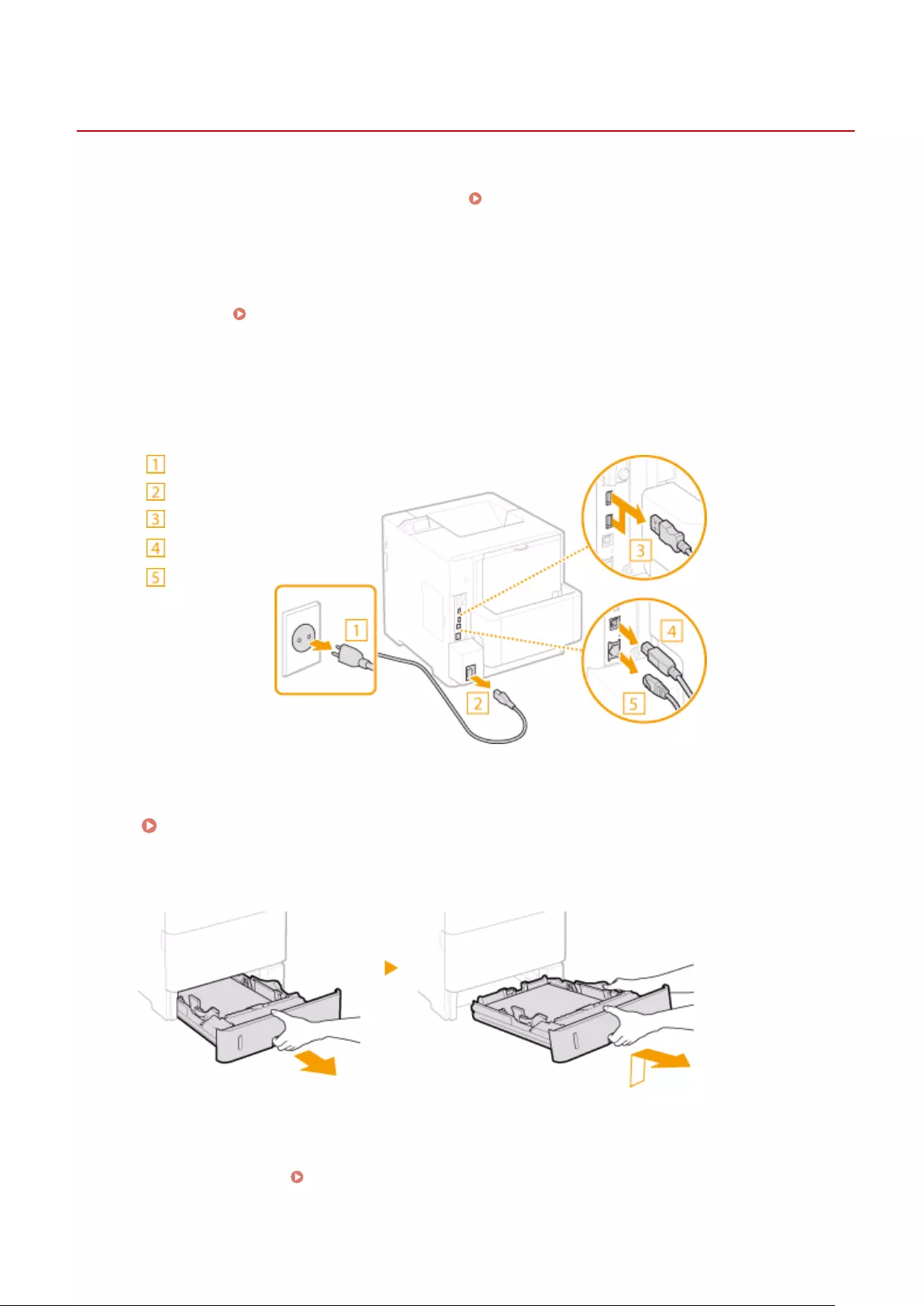
Relocating the Machine
0X7U-06X
The machine is heavy. Make sure to follow the procedures below when moving the machine to avoid injury, and also
make sure to read the safety precautions before you begin. Important Safety Instructions(P. 2)
1Turn OFF the machine and computer.
●When you turn OFF the power, be sure to shut down the machine from the operation panel without using the
power switch. Turning OFF the Power (Performing a Shutdown)(P. 33)
2Disconnect the cables and cord from the machine in numerical order as in the
illustration below.
●Whether the cables with "*" are connected depends on your environment.
Power plug
Power cord
USB device
USB cable*
LAN cable*
3When transporting the machine across a long distance, remove the toner cartridge.
How to Replace Toner Cartridges(P. 524)
4Pull out the paper drawer until it stops, and remove it while lifting the front side.
5Close all the open covers, and move the machine to a new location.
●The machine is heavy ( Machine Specications(P. 566) ). Do not try hard to carry the machine.
●Use the handles on both sides of the machine, and have at least two people carry it.
Maintenance
527
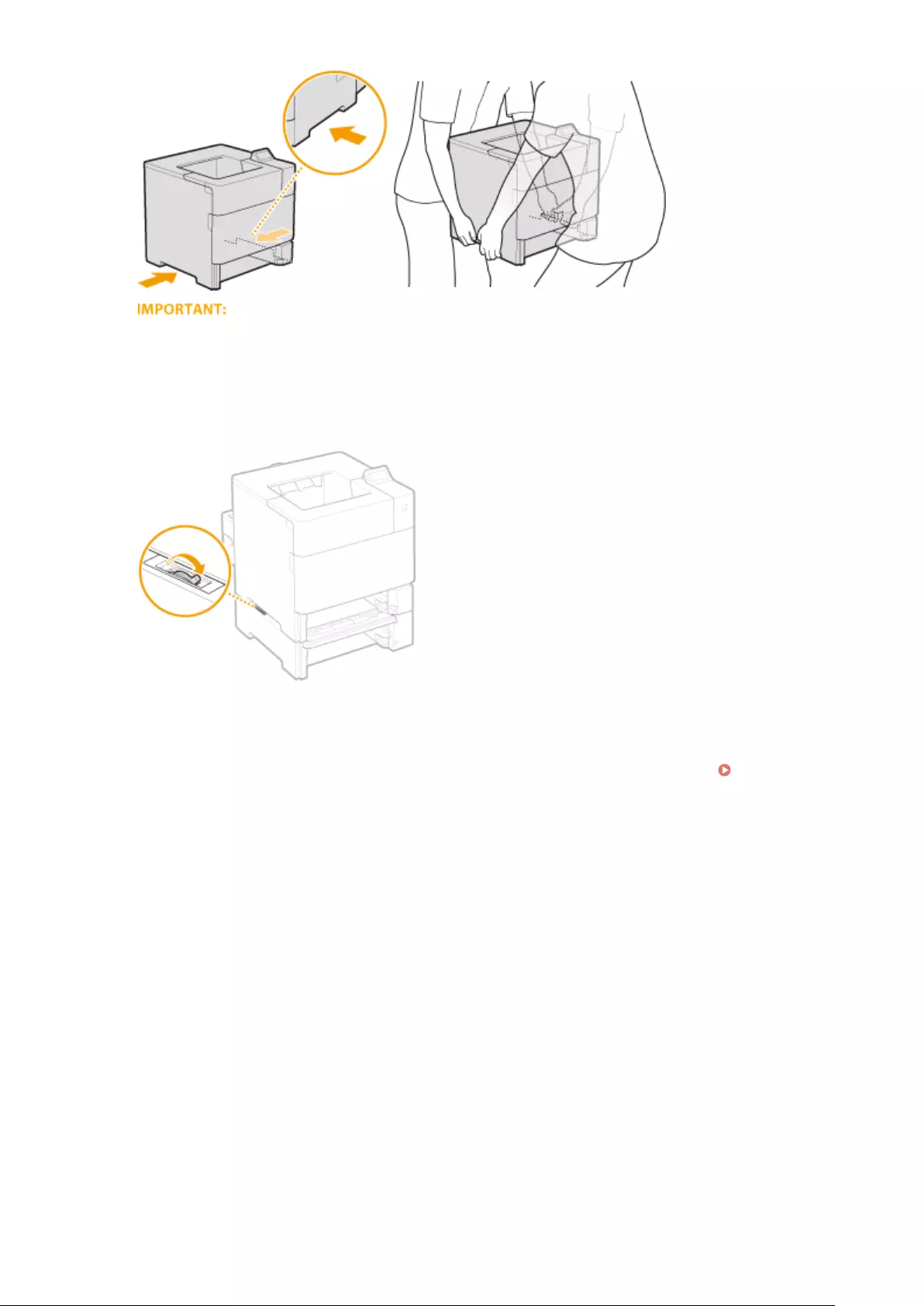
Be sure to hold the lift handles
●Do not move the machine by holding the duplex unit.
If the optional paper feeder or paper deck is attached to the machine
●Unlock the paper feeder or paper deck before lifting the machine, and transport the paper feeder or paper
deck separately.
6Carefully place the machine at the new installation site.
●For information about how to install the machine after relocating it, see Getting Started. Manuals
Included with the Machine(P. 587)
Maintenance
528

Maintaining and Improving Print Quality
0X7U-06Y
When you cannot obtain a satisfactory print result, such as when the resulting print density or print position is
different than expected, try the following adjustments.
◼Density Adjustment
Adjust the toner density. You can make ne adjustment of toner density by density level. Adjusting Print
Density(P. 530)
◼Print Position Adjustment
For each paper source, you can adjust the print position. Adjusting Print Position(P. 532)
Maintenance
529
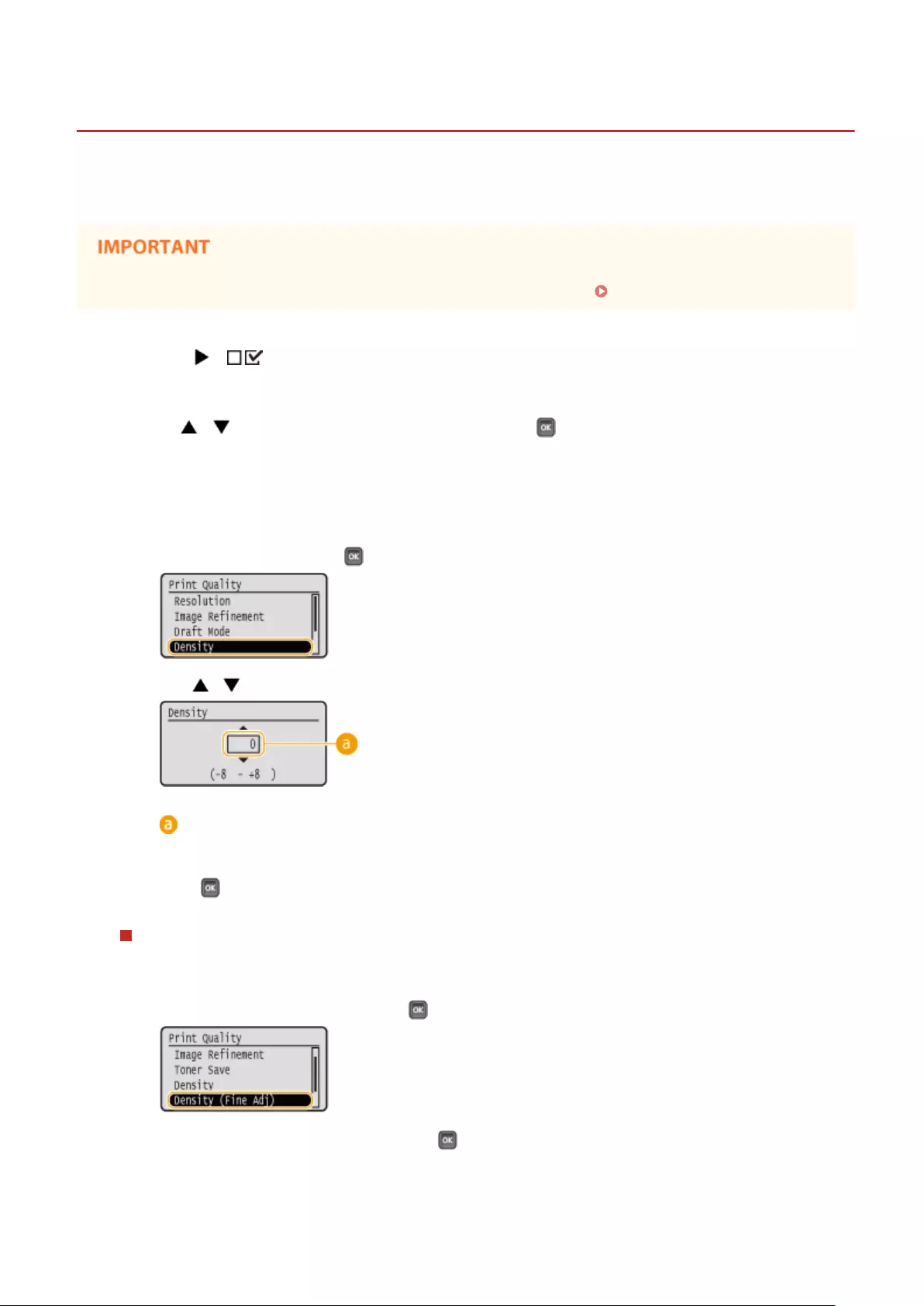
Adjusting Print Density
0X7U-070
If the resulting print is darker or lighter than expected, you can adjust the toner density. You can make ne adjustment
of the toner density by dividing the whole density range into three areas.
●If <Toner Save> is set to <On>, you cannot use this adjustment function. Toner Save(P. 400)
1Press ( ).
2Use / to select <Print Quality>, and press .
3Adjust the density.
1Select <Density>, and press .
2Use / to adjust the density.
Density adjustment
Set a "+" value to increase the density. Set a "-" value to decrease the density.
3Press .
Making ne adjustment of toner density by density level
You can make ne adjustment of toner density on three density levels - high, medium, and low.
1Select <Density (Fine Adj)>, and press .
2Select the desired density level, and press .
Maintenance
530
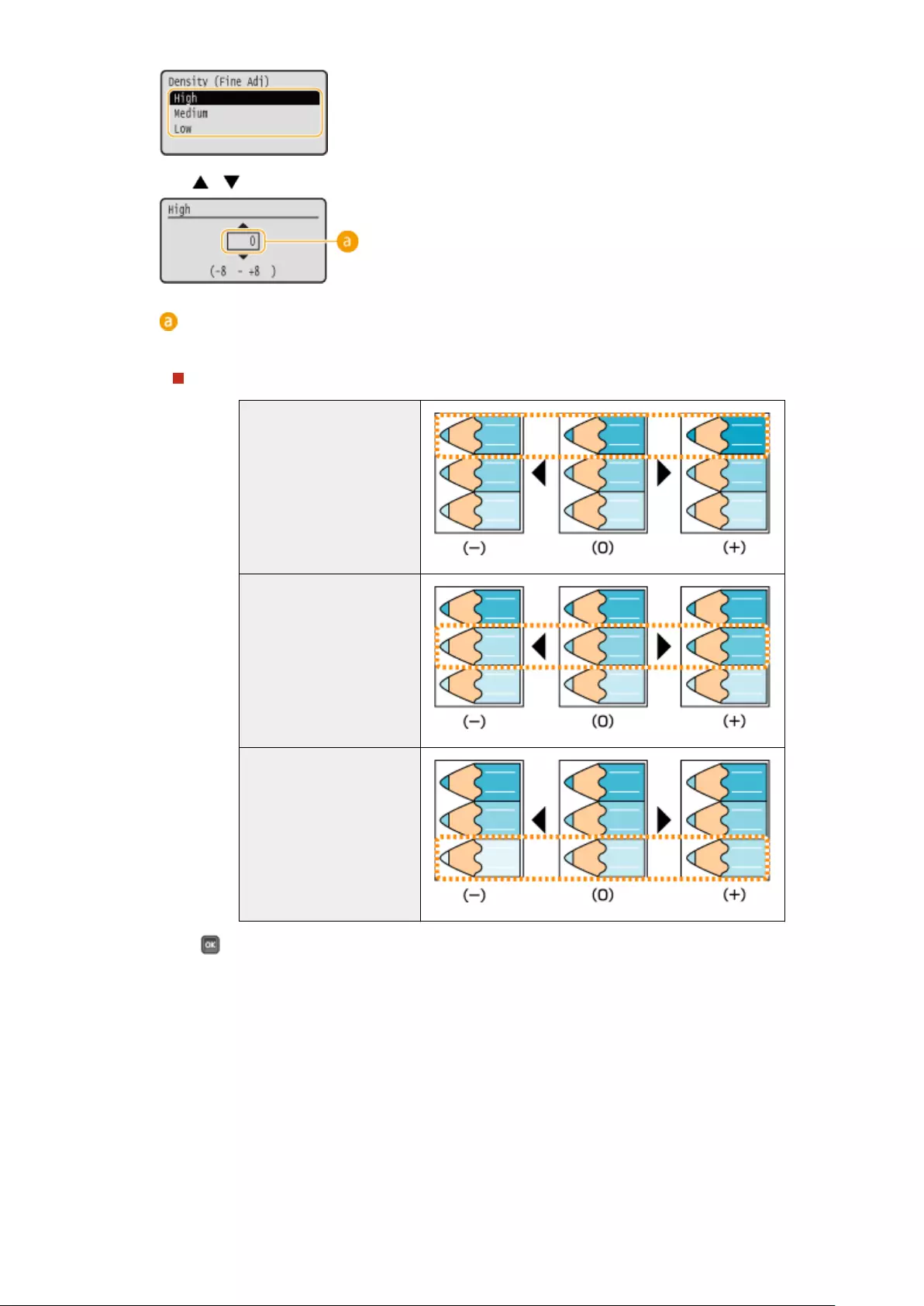
3Use / to adjust the density.
Density adjustment
Set a "+" value to increase the density. Set a "-" value to decrease the density.
Example adjustment of each density area
<High>
<Medium>
<Low>
4Press .
●If you want to also make adjustments on other density levels, repeat the operations in steps 2 to 4.
Maintenance
531
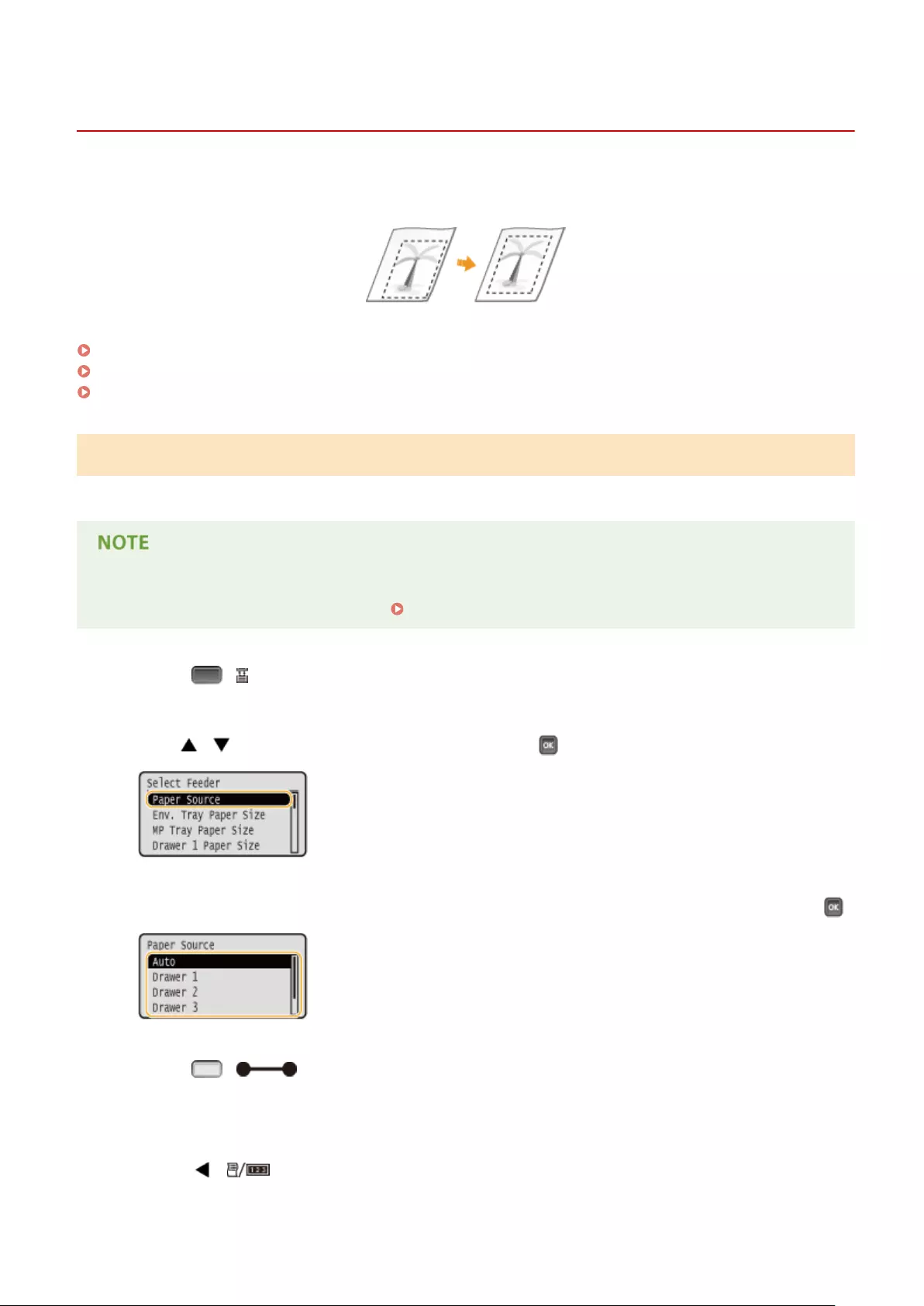
Adjusting Print Position
0X7U-071
If a document is printed off-center or out of the printable range, adjust the print position. You can adjust the print
position for each paper source.
Step 1: Printing the Current Print Position(P. 532)
Step 2: Checking the Direction and Distance to Adjust(P. 533)
Step 3: Adjusting the Print Position for Each Paper Source(P. 534)
Step 1: Printing the Current Print Position
You can perform "Printing Position Adjustment Print" to check the direction and distance to adjust.
●When you want to check the print position for 2-sided printing, set <2-Sided Printing> to <On> in the setting
menu of the operation panel in advance. 2-Sided Printing(P. 459)
1Press ( ).
2Use / to select <Paper Source>, and press .
3Select the paper source for which you want to check the print position, and press .
4Press ( ).
➠The screen returns to the main screen.
5Press ( ).
Maintenance
532
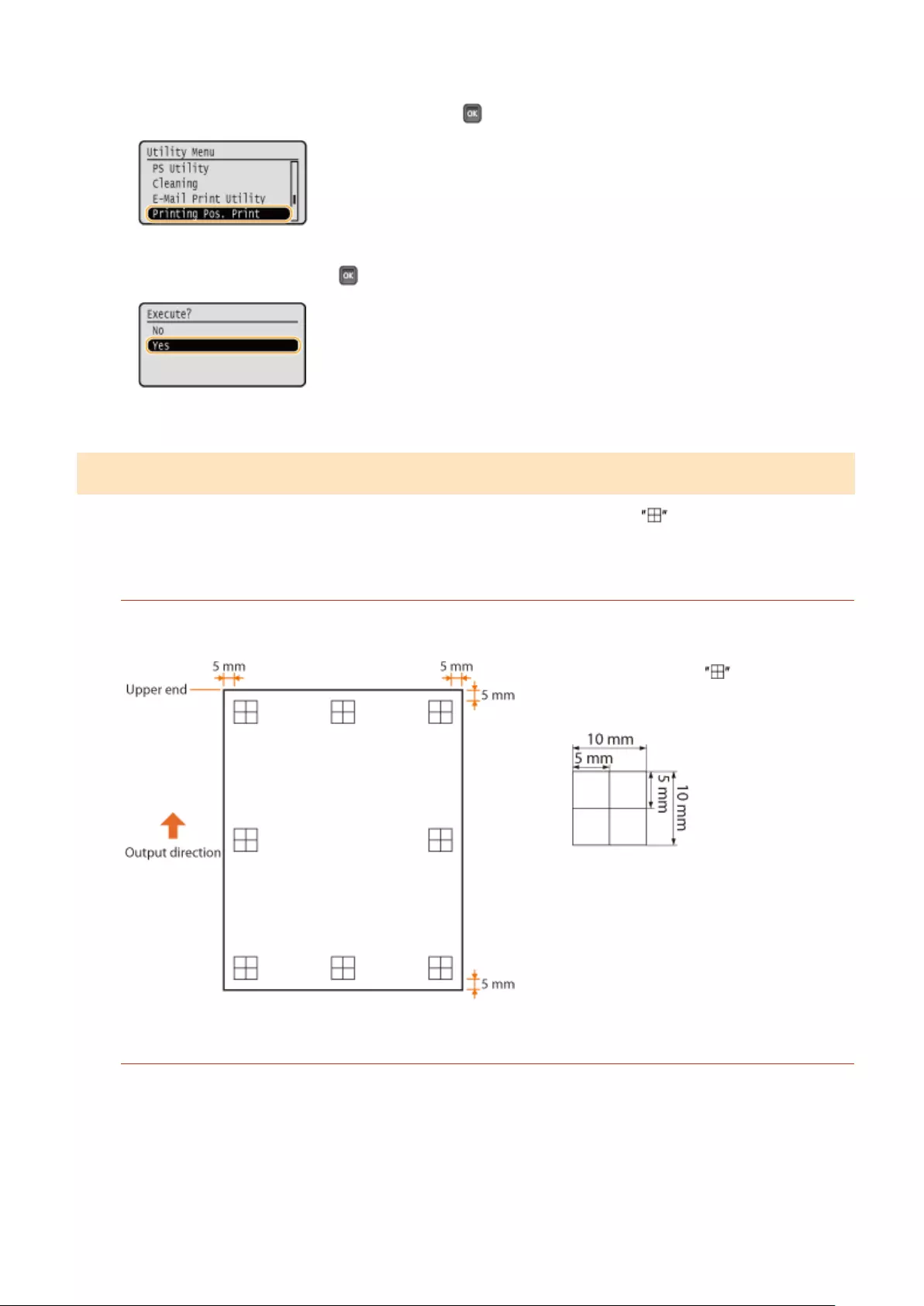
6Select <Printing Pos. Print>, and press .
7Select <Yes>, and press .
➠A printing position adjustment printout is output.
Step 2: Checking the Direction and Distance to Adjust
When Printing Position Adjustment Print is performed, the print position check marks are printed. Determine the
direction and distance to adjust based on those marks. When the print position is normal, all the marks are printed at
a position 5 mm from the nearest edge of the paper.
How to Check Printing Position Adjustment Printouts
The edge of paper that comes out rst when the paper is output is the top of a Printing Position Adjustment
Print. When you check the print position, make sure which edge of the paper is the top.
●The size of the mark for checking the
print position is as shown in the illustration
below.
When the Print Position Is Off-Center
When the print position check marks are printed off the correct position, you need to adjust the print position.
When you adjust the print position, specify the direction using "+" and "-" and the distance using "mm". Use "-"
to shift the print position upward and "+" to shift it downward (vertical position correction). Use "-" to shift the
print position leftward and "+" to shift it rightward (horizontal position correction).
Vertical direction (<Offset Y>) Horizontal direction (<Offset X>)
Maintenance
533
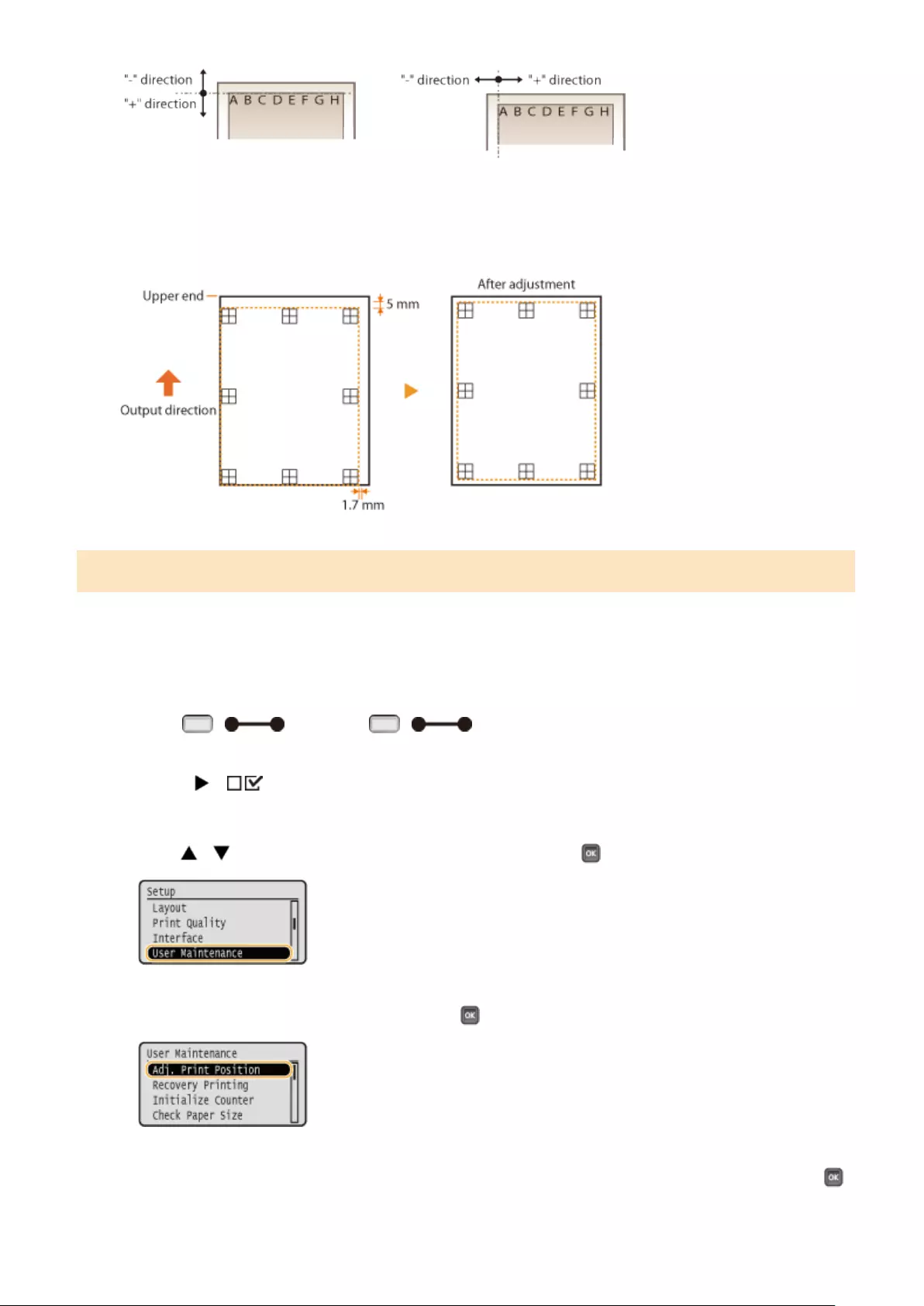
In the example shown below, to shift the print position 5 mm upward and 1.7 mm rightward, "-5.0 mm" is set in
<Offset Y> and "+1.70 mm" is set in <Offset X>.
Step 3: Adjusting the Print Position for Each Paper Source
After you conrm the direction and distance to adjust, specify an adjusted print position. You can adjust the print
position in the range of -5.0 to +5.0 mm in 0.1 mm increments in either direction: vertical and horizontal.
1Set the machine to oine.
●When ( ) is lit, press ( ).
2Press ( ).
3Use / to select <User Maintenance>, and press .
4Select <Adj. Print Position>, and press .
5Select the combination of the direction to adjust and the paper source, and press .
Maintenance
534

●You can use <Offset Y (2-Sided)> and <Offset X (2-Sided)> to adjust the print position on the rst page (front
side) in 2-sided printing mode regardless of the paper source.
●The print position on the second page (back side) in 2-sided printing mode follows the settings for the
available paper source. For example, the vertical print position for 2-sided printing from the multi-purpose
tray is adjusted as shown below.
First page (front side) <Offset Y (2-Sided)> setting value
Second page (back side) <Offset Y (MP Tray)> setting value
6Set a value, and press .
●Based on the printout made by Printing Position Adjustment Print, use / to enter a value.
●To adjust another position or paper source, repeat steps 5 and 6.
7Press ( ).
➠The screen returns to the main screen.
8Press ( ) again.
➠The machine becomes online.
9Perform the Printing Position Adjustment Print, and check the adjusted print
position on the printout. Step 1: Printing the Current Print Position(P. 532)
Adjusting all print positions
You can use <Offset Y> and <Offset X> in the setting menu of the operation panel to adjust the print positions
for all types of printing regardless of the paper source. You can adjust the print position in the range of -50.0 to
+50.0 mm in 0.5 mm increments in either direction: vertical and horizontal. Offset Y/Offset X(P. 395)
Maintenance
535
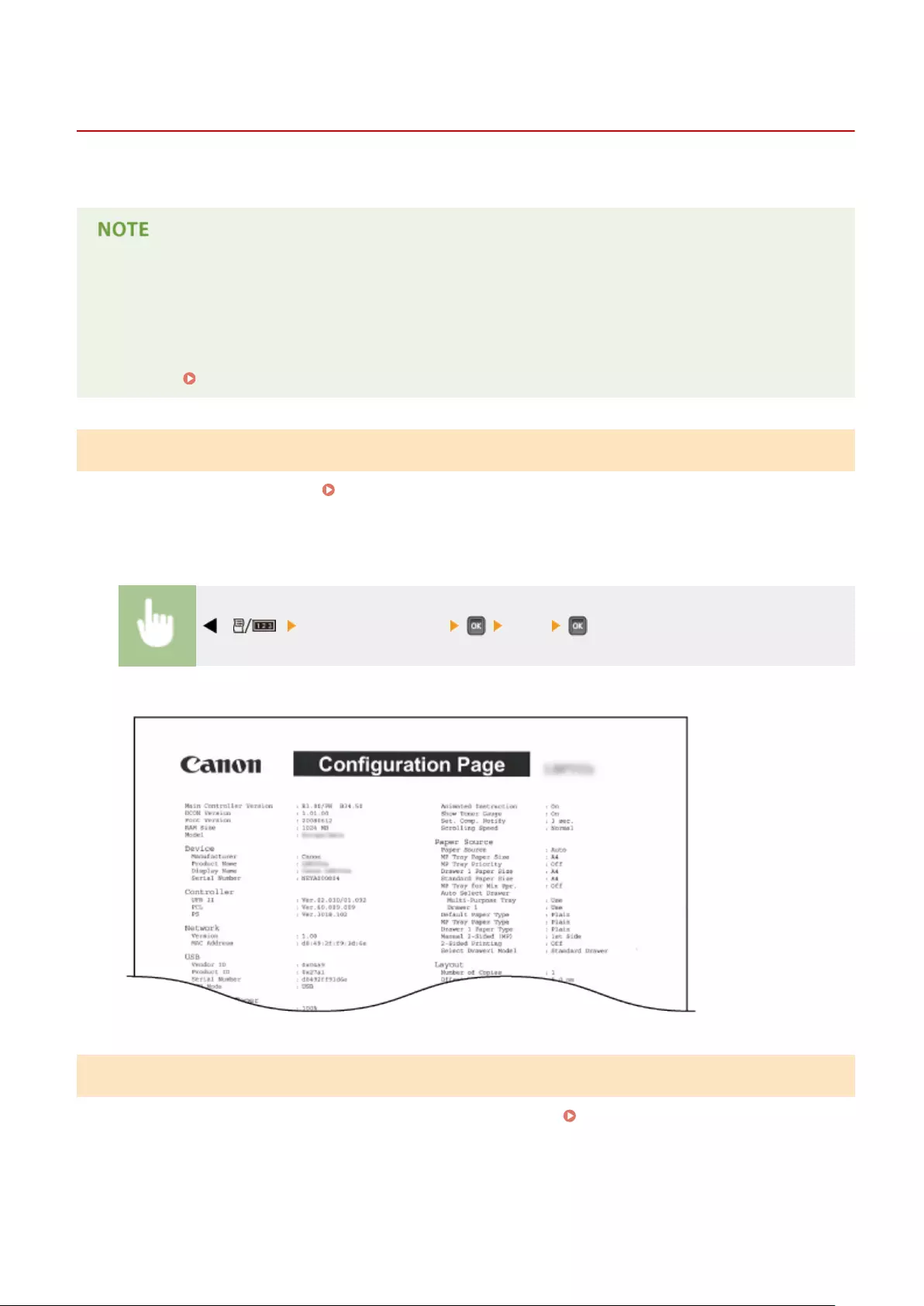
Printing Reports and Lists
0X7U-072
You can check the condition of consumables and the machine settings by printing reports and lists.
Asterisks (*)
●Settings marked with "*1" are not displayed depending on whether an optional SD card is installed on the
machine.
●Settings marked with "*2" are not displayed when [Display Job Log] check box of the Remote UI is not
selected. Hiding the Print Job History(P. 291)
Conguration Page
You can check the machine settings ( Setup Menu(P. 360) ), the contents registered in the machine, and other
information in list form. The other information includes the amount of remaining toner, the number of printed pages,
and the capacity of the memory (RAM) mounted on the machine. Setting items whose name is preceded by an asterisk
(*) are the items whose setting was changed from the factory default.
( ) <Conguration Page> <Yes>
Example:
Network Status Print
You can check the settings about the network congured in the machine ( Network(P. 375) ) in list form. The
information about the security including the address lter settings and IPSec settings is also printed.
Maintenance
536
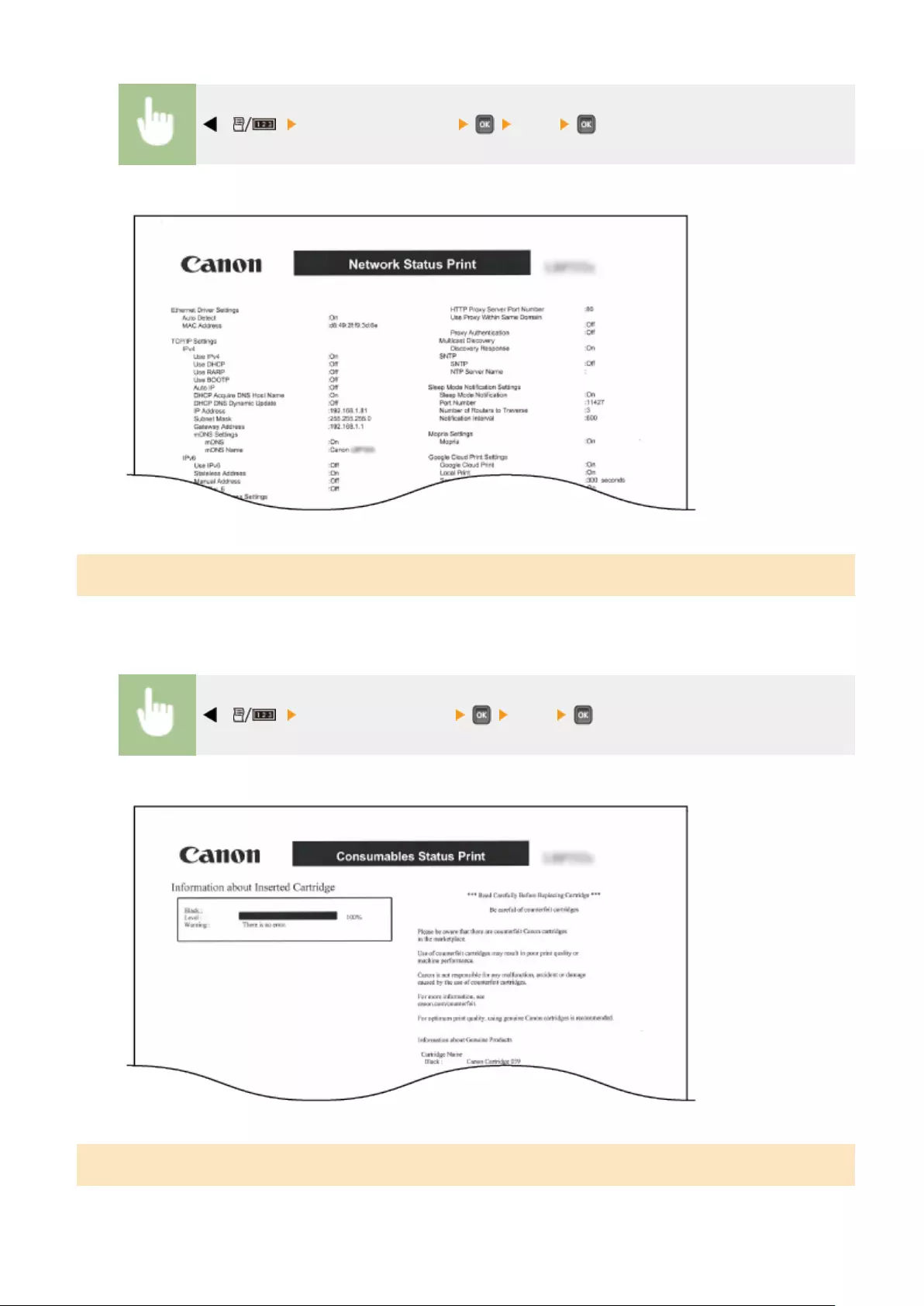
( ) <Network Status Print> <Yes>
Example:
Consmbl. Status Prt.
The information such as toner remaining amount, warning messages, and information on where you can purchase
new toner cartridges can be viewed in list form.
( ) <Consmbl. Status Prt.> <Yes>
Example:
IPSec Policy List
You can check the list of policy names and the IPSec settings registered in the machine by printing an IPSec Policy List.
Maintenance
537
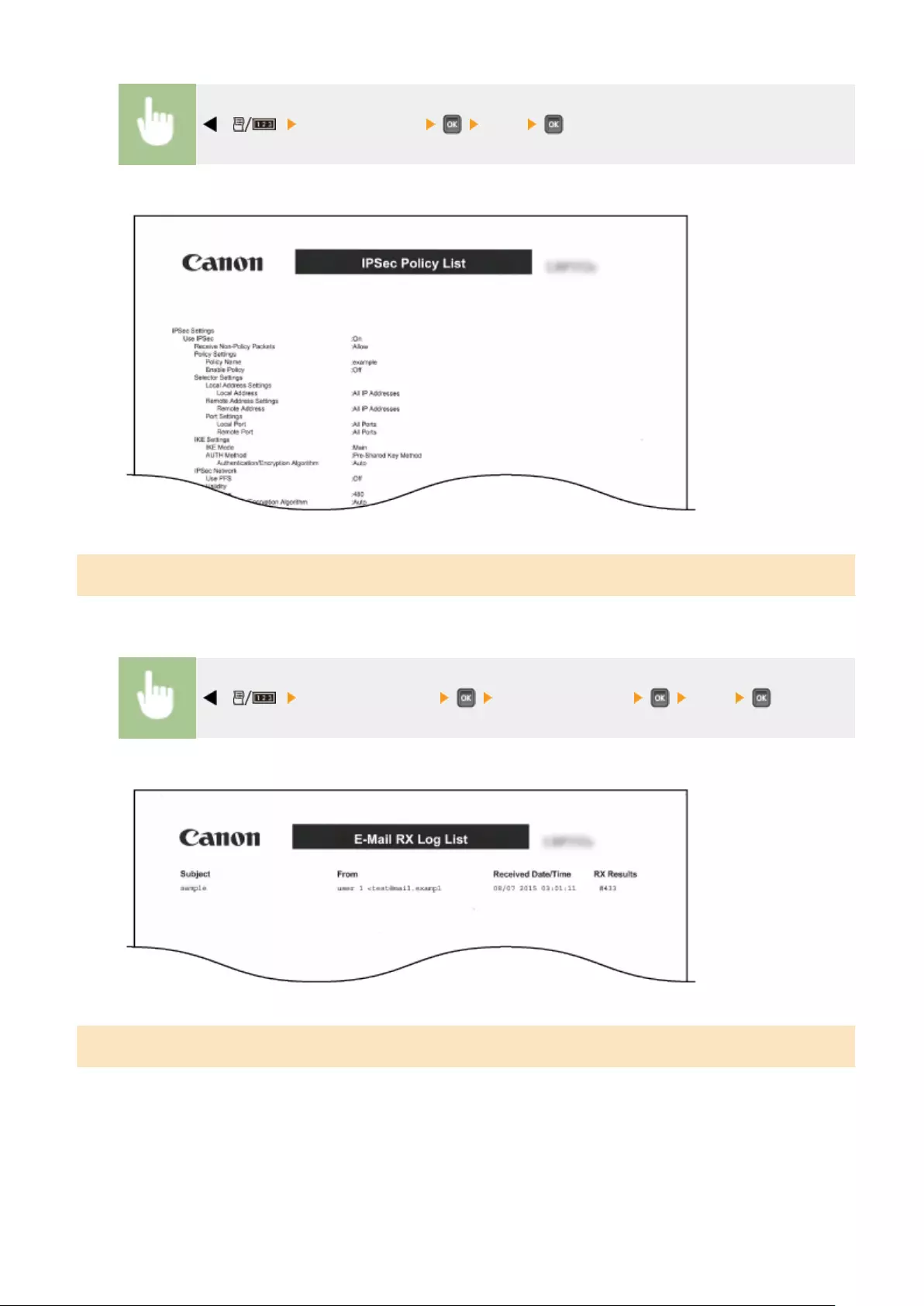
( ) <IPSec Policy List> <Yes>
Example:
E-Mail RX Log List
You can check a log consisting of subjects and received date/time of e-mails received in the machine in list form.
( ) <E-Mail Print Utility> <E-Mail RX Log List> <Yes>
Example:
Page Count List
You can check the number of pages printed for each department by printing a report when [Department ID
Management] is enabled.
Maintenance
538
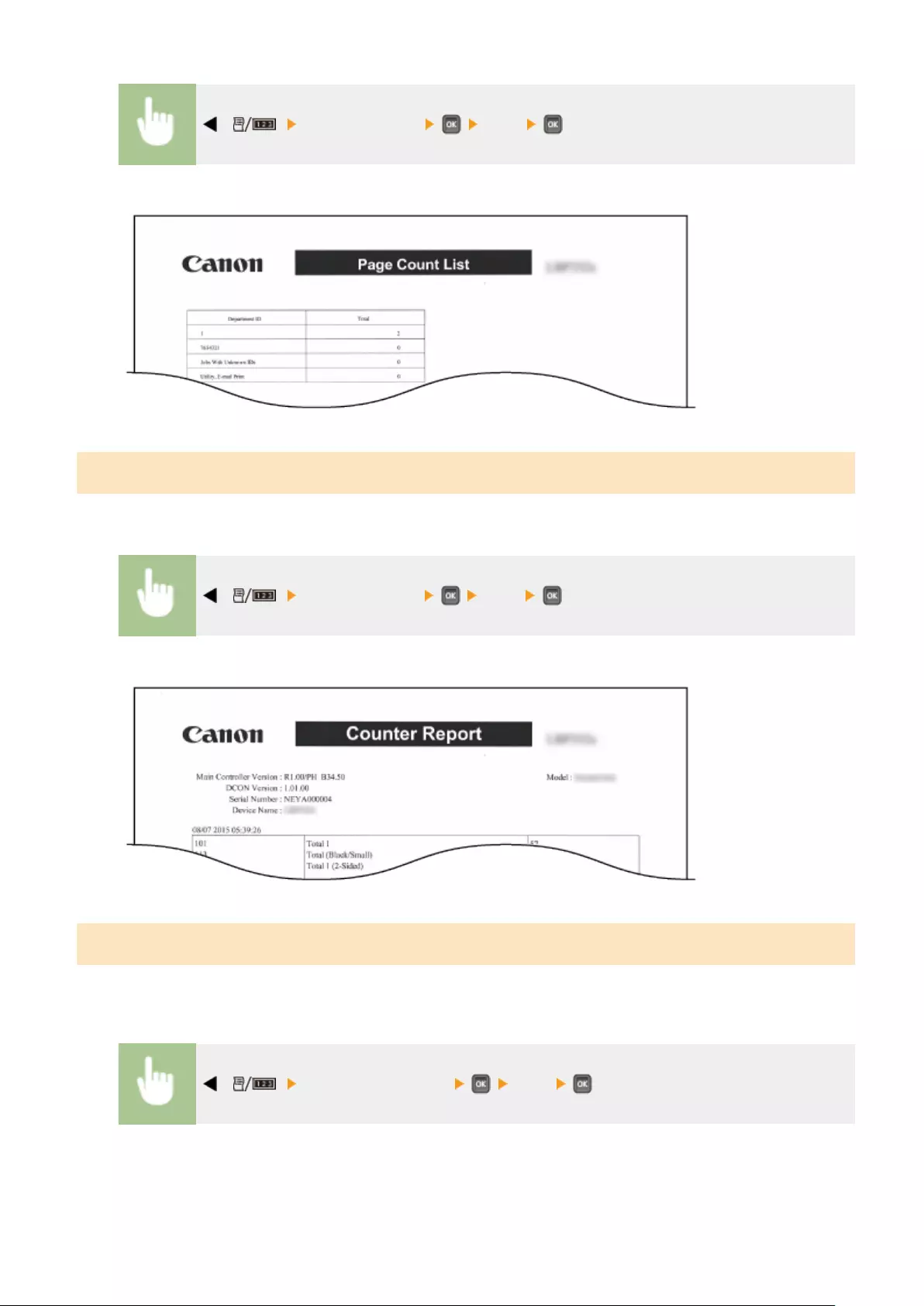
( ) <Page Count List> <Yes>
Example:
Counter Report
You can print an aggregate report of the number of pages printed for each counter.
( ) <Counter Report> <Yes>
Example:
Print MEAP Sys. Info
You can check the information about MEAP applications installed in the machine and the MEAP system applications in
list form if the MEAP function is enabled.
( ) <Print MEAP Sys. Info> <Yes>
Example:
Maintenance
539
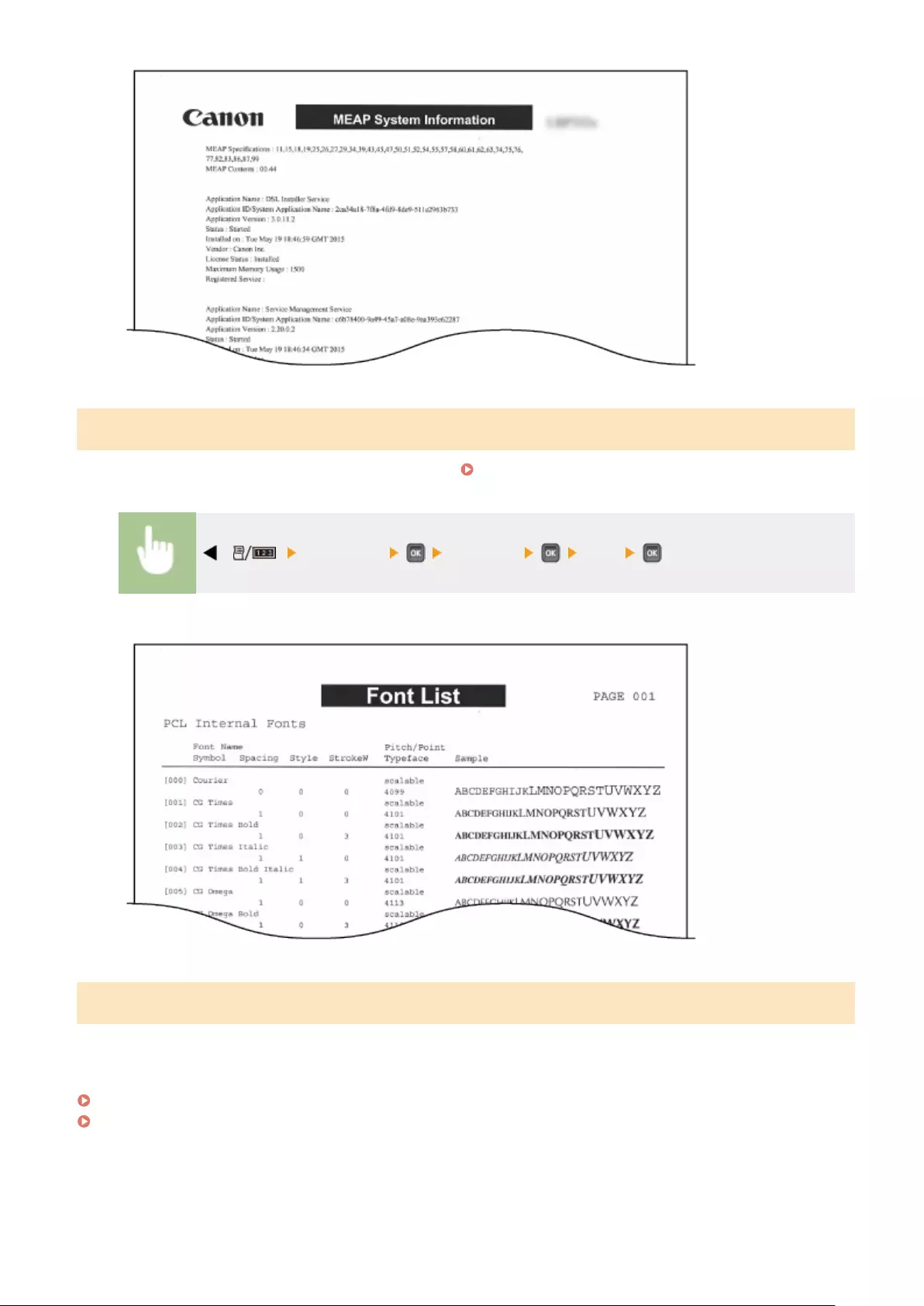
PCL Font List
You can check the fonts available in PCL mode in list form. Font Samples(P. 624)
( ) <PCL Utility> <Font List> <Yes>
Example:
PS Mode List
The settings for use of the PS mode and the internal information items registered in the machine are printed in list
form.
Conguration Page(P. 541)
Font List(P. 541)
Maintenance
540
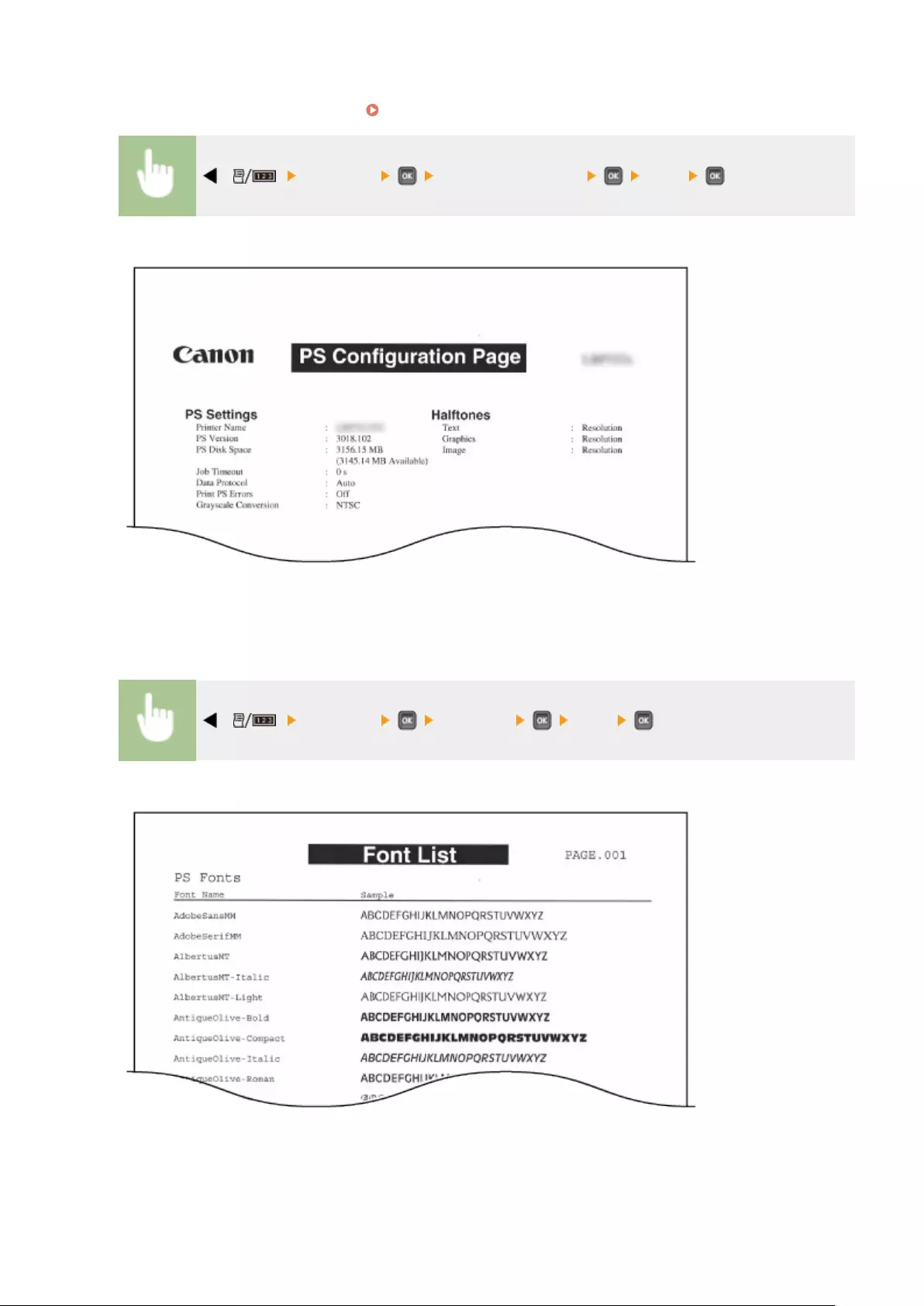
◼Conguration Page
You can check the machine settings ( PS(P. 439) ) and the contents registered in the machine in list form.
( ) <PS Utility> <Conguration Page> <Yes>
Example:
◼Font List
You can check the fonts available in PS mode in list form.
( ) <PS Utility> <Font List> <Yes>
Example:
Maintenance
541
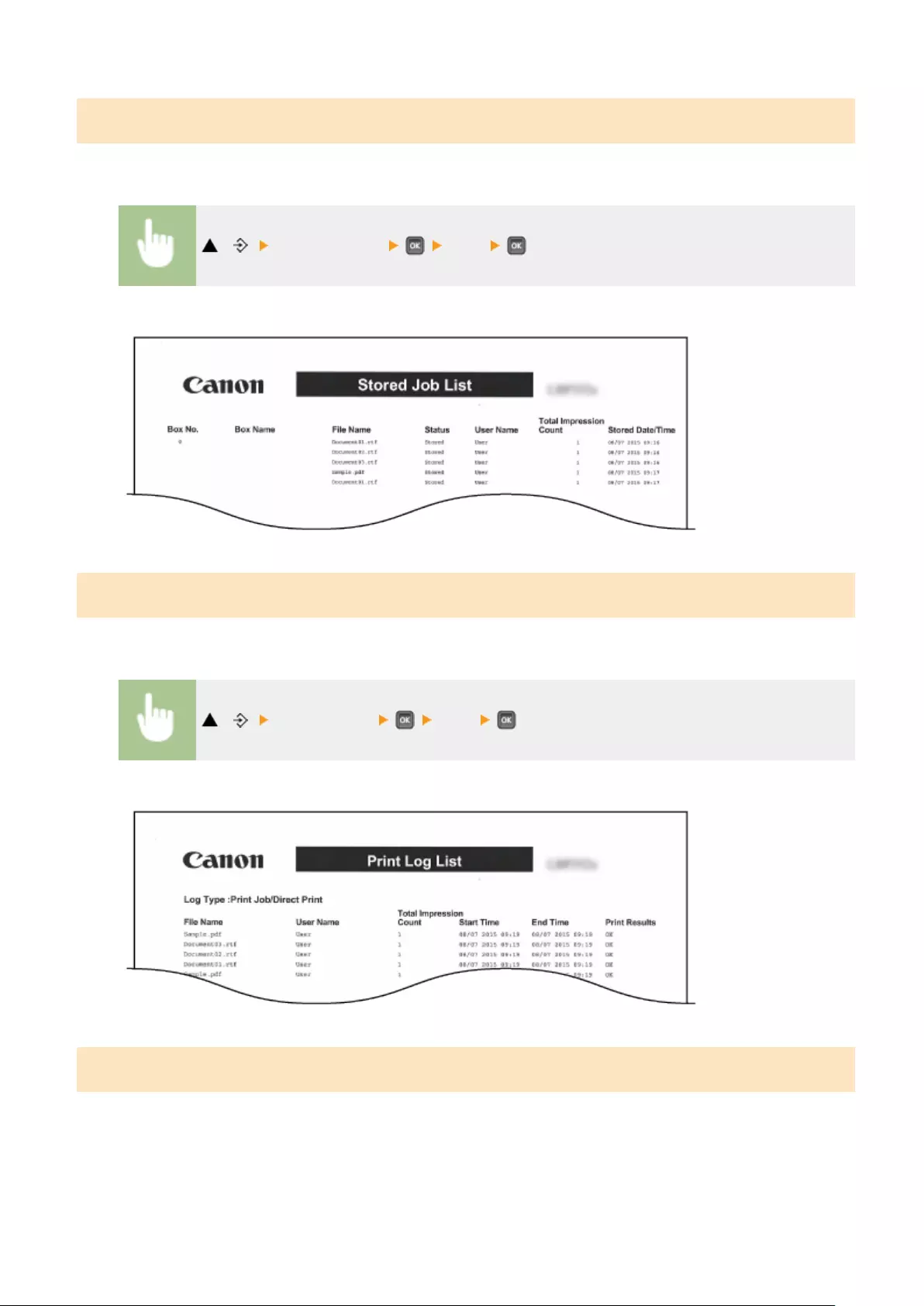
Stored Job List *1
You can print a list of documents stored in the SD card installed on the machine.
( ) <Stored Job List> <Yes>
Example:
Job Print Log *2
You can print a log of documents printed from the computer in list from.
( ) <Job Print Log> <Yes>
Example:
Stored Job Print Log *1*2
You can print a print log of documents stored in the SD card installed on the machine in list form.
Maintenance
542

( ) <Stored Job Print Log> <Yes>
Example:
Report Print Log *2
You can print the settings and a print log of reports in list form.
( ) <Report Print Log> <Yes>
Example:
E-Mail Print Log *2
You can print a print log of received e-mails in list form.
( ) <E-Mail Print Log> <Yes>
Example:
Maintenance
543
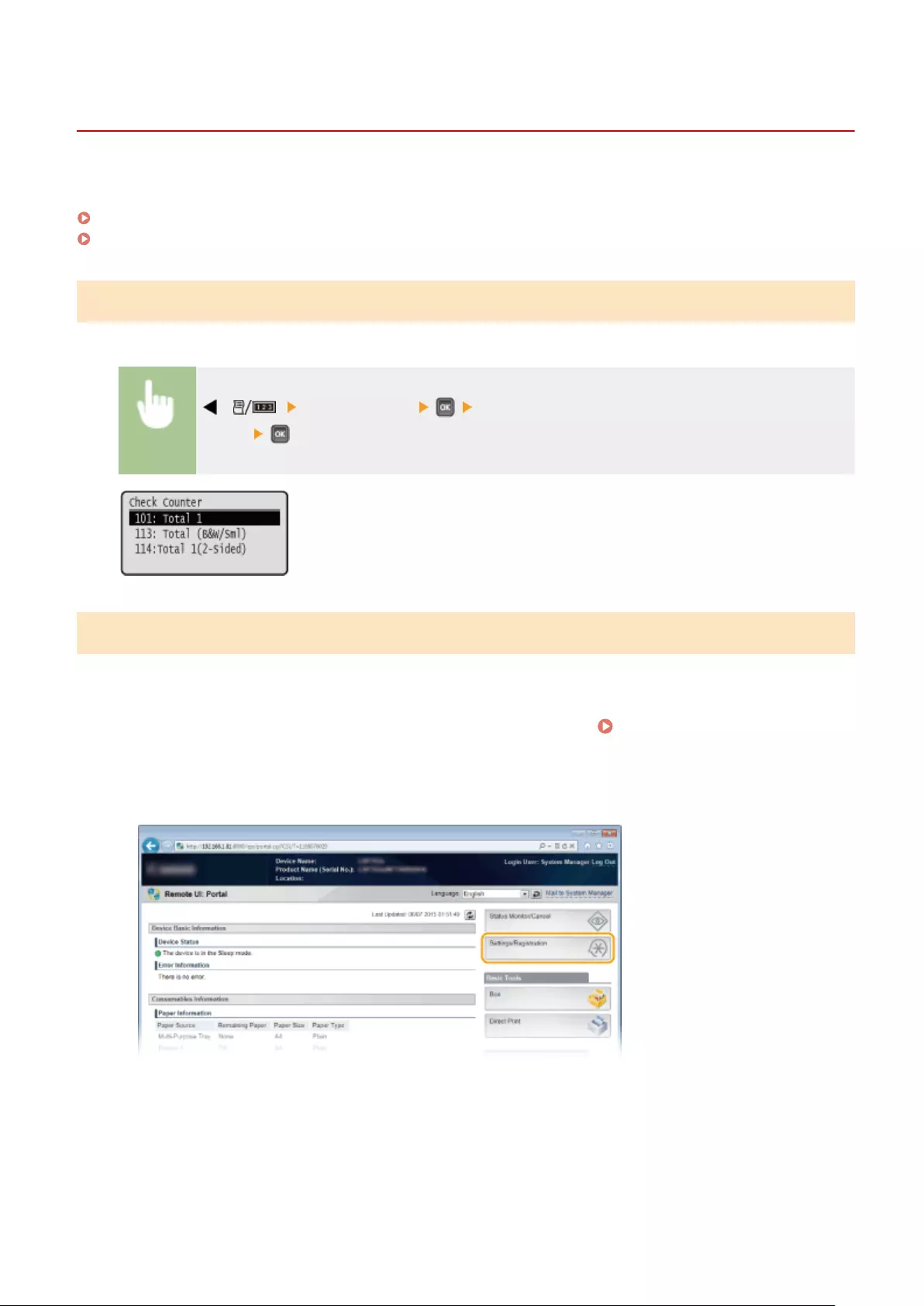
Viewing the Counter Value
0X7U-073
You can check the number of printed pages.
Checking Total Number of Printed Pages(P. 545)
Checking the Number of Pages Printed for Each Department(P. 545)
Checking Total Number of Printed Pages
You can check the total number of printed pages.
( ) <Check Counter> <101: Total 1>, <113: Total (B&W/Sml)>, or <114:Total 1(2-
Sided)>
Checking the Number of Pages Printed for Each Department
You can check the number of pages printed for each department.
1Start the Remote UI and log on in Management Mode. Starting Remote UI(P. 333)
2Click [Settings/Registration].
3Click [Department ID Management].
Maintenance
545

➠The number of printed pages is displayed for each Department ID under [Printed Pages].
To print the check result
Page Count List(P. 538)
To clear the page count to zero
●When you want to clear the page count to zero for each department, click the text link under [Dept. ID], and
click [Clear Count] [OK].
Maintenance
546
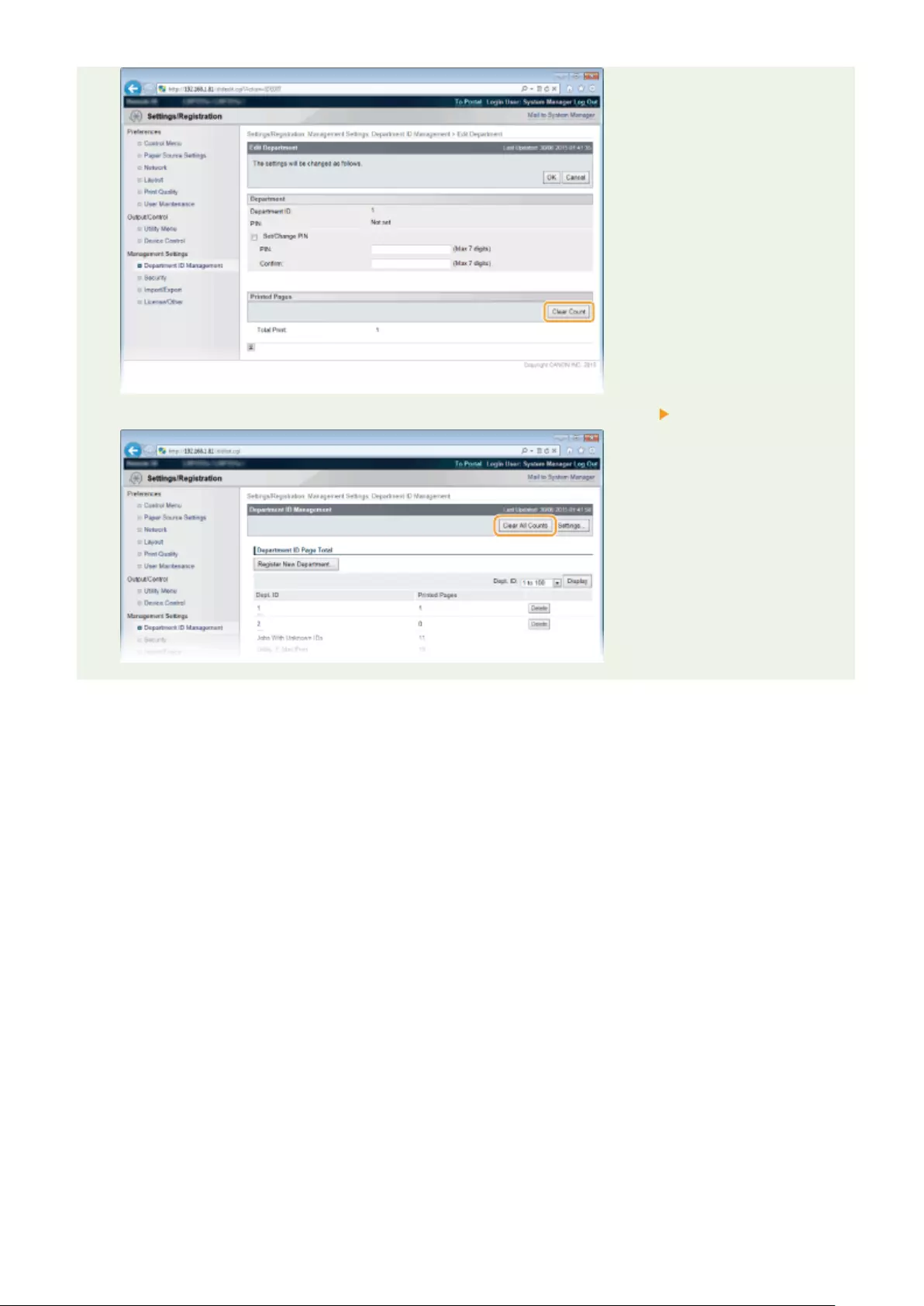
●If you want to return the counts of all departments to zero, click [Clear All Counts] [OK].
Maintenance
547

Checking Consumables
0X7U-074
You can use the operation panel to check the information of the consumables.
Checking Paper
You can display the currently specied paper size and paper type, and the remaining paper level for each paper
source.
( ) <Consumables Info.> <Paper Information> Select the paper
source
Paper source selection
Select the paper source of which information is displayed.
Checking the Toner Cartridge Model
You can display the model number of the toner cartridge for the machine.
( ) <Consumables Info.> <Toner Cart. Model>
Checking the Amount of Remaining Toner
You can display the amount of remaining toner.
( ) <Consumables Info.> <Remaining Toner>
Maintenance
548
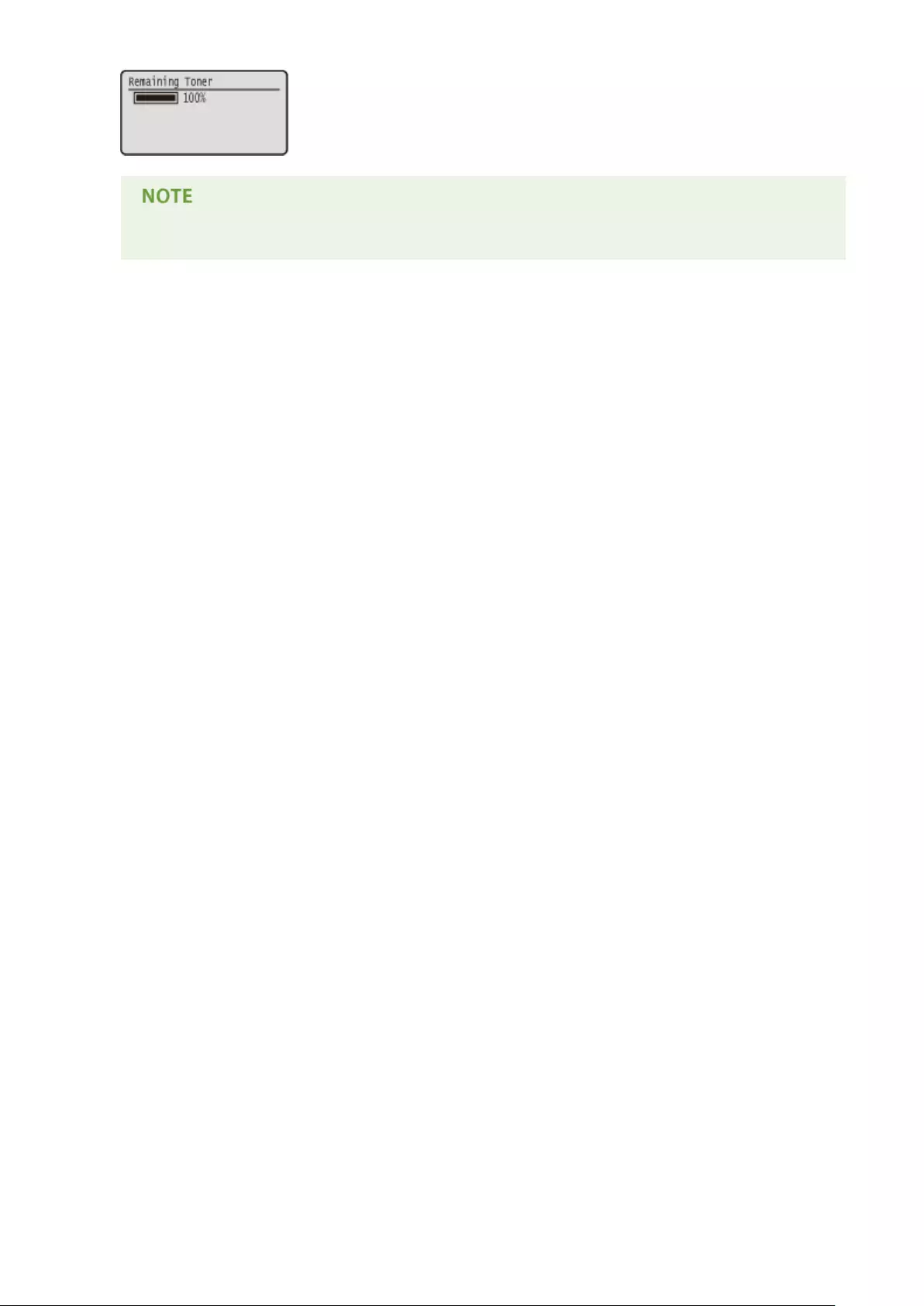
●The displayed remaining toner level can be used only as a guide and may differ from the actual level.
Maintenance
549

Initializing Menu
0X7U-076
You can restore the settings of the machine ( Setup Menu(P. 360) ) to the factory default settings.
Do not press the power switch when the initialization is in progress
●If the machine is turned OFF during the initialization, it may be damaged.
If a Remote UI Access PIN has been specied
●The Remote UI Access PIN is also initialized. After performing initialization, respecify a Remote UI Access
PIN. Setting a Remote UI PIN(P. 263)
●When you want to initialize the network settings, follow the procedure in Initializing the Network
Settings(P. 552) .
●When you want to initialize the settings in <Adj. Print Position>, follow the procedure in Adj. Print
Position(P. 406) .
( ) <Initialize Menu> <Yes> Perform a hard reset ( Performing a
Hard Reset(P. 451) )
Maintenance
551
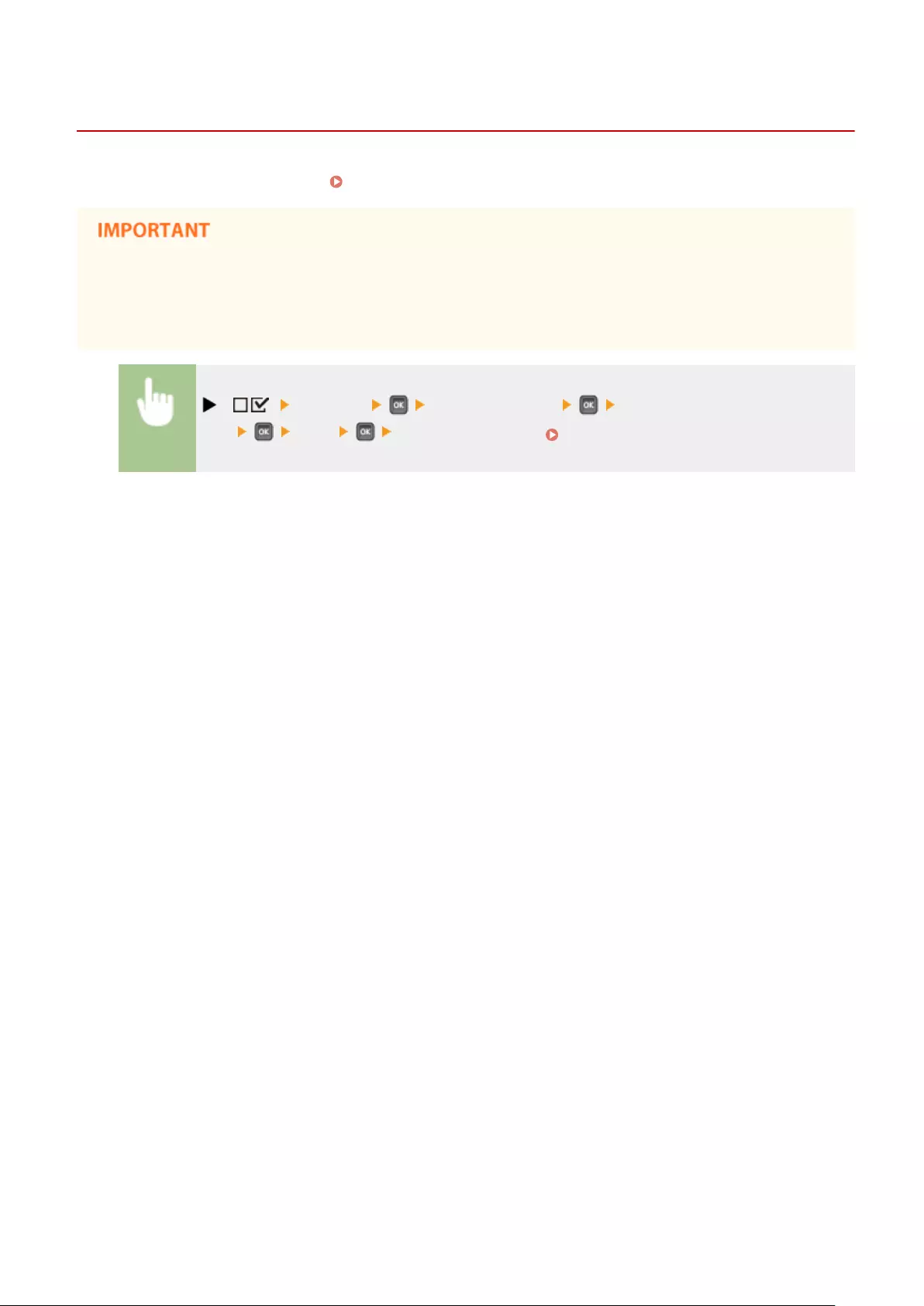
Initializing the Network Settings
0X7U-077
You can restore the network settings ( Network(P. 375) ) to the factory default settings.
Do not initialize the network settings when the machine is printing or receiving print
data
●Doing so may result in incorrect printing, paper jams, or damage to the machine.
( ) <Network> Check the message <Init. Network
Set.> <Yes> Perform a hard reset ( Performing a Hard Reset(P. 451) )
Maintenance
552

Appendix
Appendix ............................................................................................................................................................. 554
Third Party Software ......................................................................................................................................... 555
Feature Highlights ............................................................................................................................................ 556
Going Green and Saving Money ................................................................................................................... 557
Improving Eciency ..................................................................................................................................... 559
So Much More .............................................................................................................................................. 562
Specications .................................................................................................................................................... 565
Machine Specications ................................................................................................................................. 566
Paper ............................................................................................................................................................ 569
Consumables ..................................................................................................................................................... 573
Consumable Parts ............................................................................................................................................. 574
Optional Items ................................................................................................................................................... 575
Installing the ROM ........................................................................................................................................ 579
Installing an SD Card .................................................................................................................................... 583
Manuals Included with the Machine ................................................................................................................ 587
Using e-Manual .................................................................................................................................................. 588
Installing e-Manual ....................................................................................................................................... 589
Uninstalling e-Manual .................................................................................................................................. 591
Screen Layout of e-Manual ........................................................................................................................... 592
Viewing e-Manual ......................................................................................................................................... 598
Manual Display Settings ............................................................................................................................... 600
Managing MEAP Applications ........................................................................................................................... 601
Using FTP Clients ............................................................................................................................................... 602
Preparing for Using the FTP Server .............................................................................................................. 603
Printing via FTP Client (FTP Print) .................................................................................................................. 606
Specifying Settings via FTP Client ................................................................................................................. 608
Others ................................................................................................................................................................ 615
Basic Windows Operations ........................................................................................................................... 616
For Mac OS Users ......................................................................................................................................... 623
Font Samples ................................................................................................................................................ 624
Notice ........................................................................................................................................................... 629
Oce Locations ................................................................................................................................................. 633
Appendix
553

Appendix
0X7U-078
This chapter contains technical specications of this machine, instructions on how to use the e-Manual, disclaimers,
copyright information, and other important information for customers.
Appendix
554

Third Party Software
0X7U-08U
Appendix
555

Feature Highlights
0X7U-079
Give the features that are described in this section a try. The features are grouped under three headings: "Going
Green and Saving Money," "Improving Eciency," and "So Much More."
Appendix
556
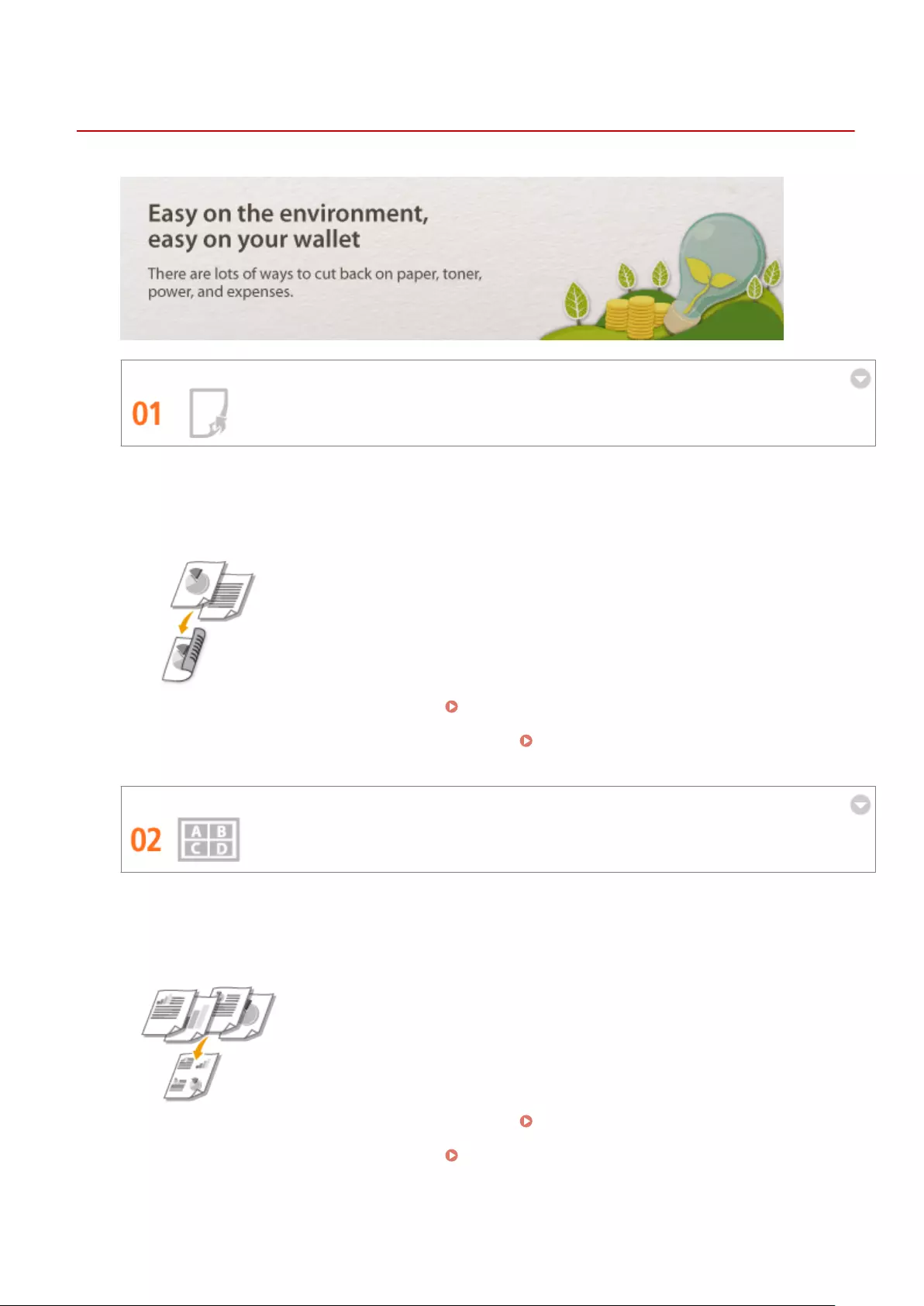
Going Green and Saving Money
0X7U-07A
2-Sided Printing
You can print on both sides of the paper. Use 2-sided printing to save paper not only on large print jobs but also
when you only want to print a few pages. To save even more, combine 2-sided printing with N on 1 printing of
multiple pages on one sheet of paper. You can print up to 32 pages on a single sheet, which is both economical
and environmentally friendly.
To print 2-sided documents from your computer: Switching 1-Sided and 2-Sided Printing(P. 89)
To print multiple pages onto one sheet from your computer: Printing Multiple Pages onto One Sheet(P. 93)
Print Multiple Pages on a Single Sheet
When there are many pages in a document, the printout can be inconveniently bulky-hard to carry around and
store, and also hard to read. But there is a solution. Print multiple pages onto one sheet! This allows you to save
paper and make your documents slimmer and easier to handle. It is even more effective when combined with 2-
sided printing.
To print multiple pages onto one sheet from your computer: Printing Multiple Pages onto One Sheet(P. 93)
To print 2-sided documents from your computer: Switching 1-Sided and 2-Sided Printing(P. 89)
Appendix
557
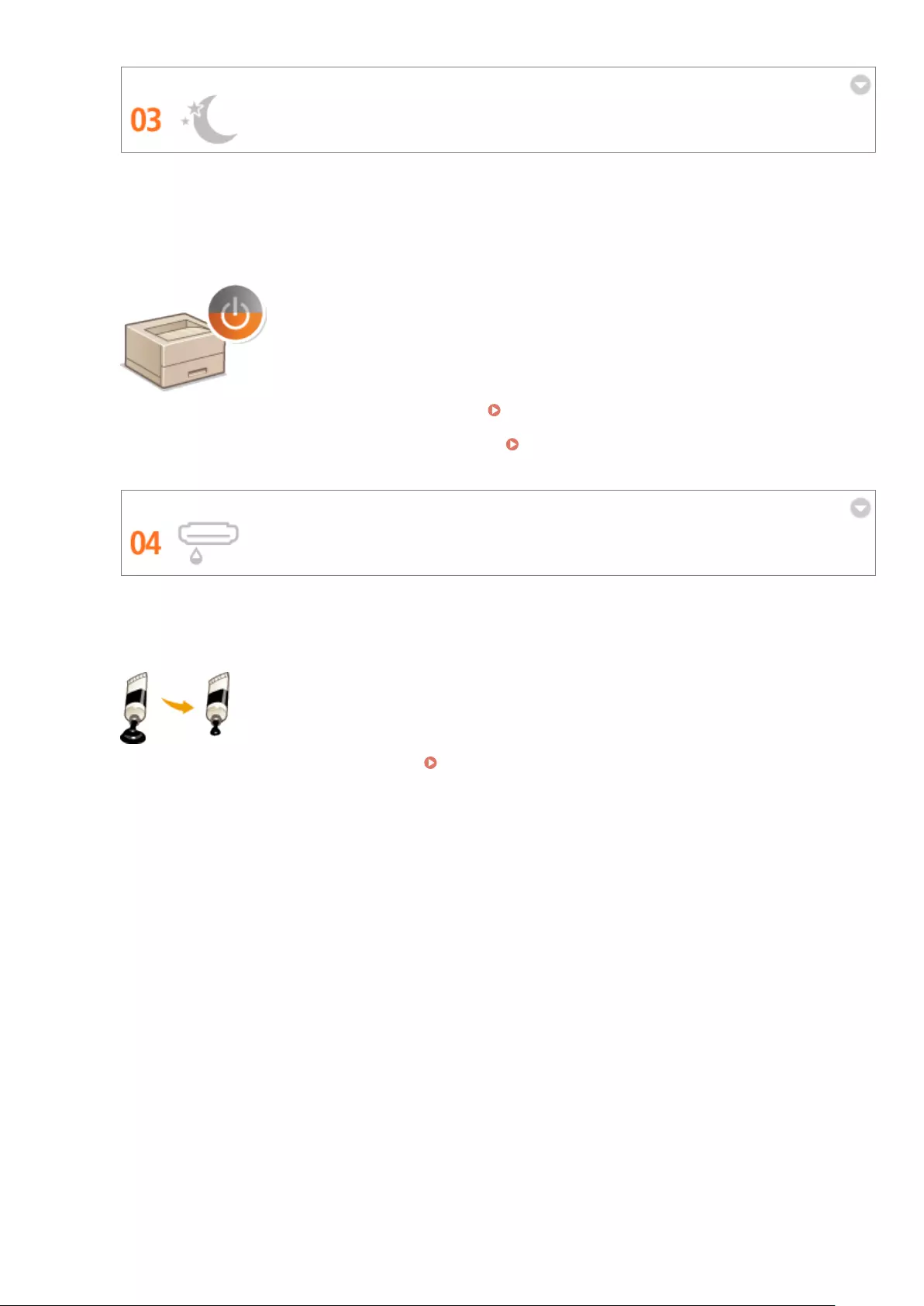
Sleep Mode
If you will not be using the machine for a while, you can save power by putting it into sleep mode, either
manually or automatically. You don't need to turn OFF the power each time, but you can still have the machine
minimize its power consumption. The auto shutdown function can boost the savings, by automatically turning
OFF the machine if it remains idle for a longer time. These convenient functions work in the background to save
power and money every day.
To save power by putting the machine into sleep mode: Entering Sleep Mode(P. 68)
To congure the machine to be automatically turned OFF: Setting Auto Shutdown Time(P. 71)
Save Toner
To economize on toner, you can use the <Toner Save> mode for drafts and test printouts. Or you can switch
between modes according to purpose, using normal mode for beautiful photos and draft mode for company
documents that do not require presentation quality.
For more information about this function, see Saving Toner(P. 107) .
Appendix
558
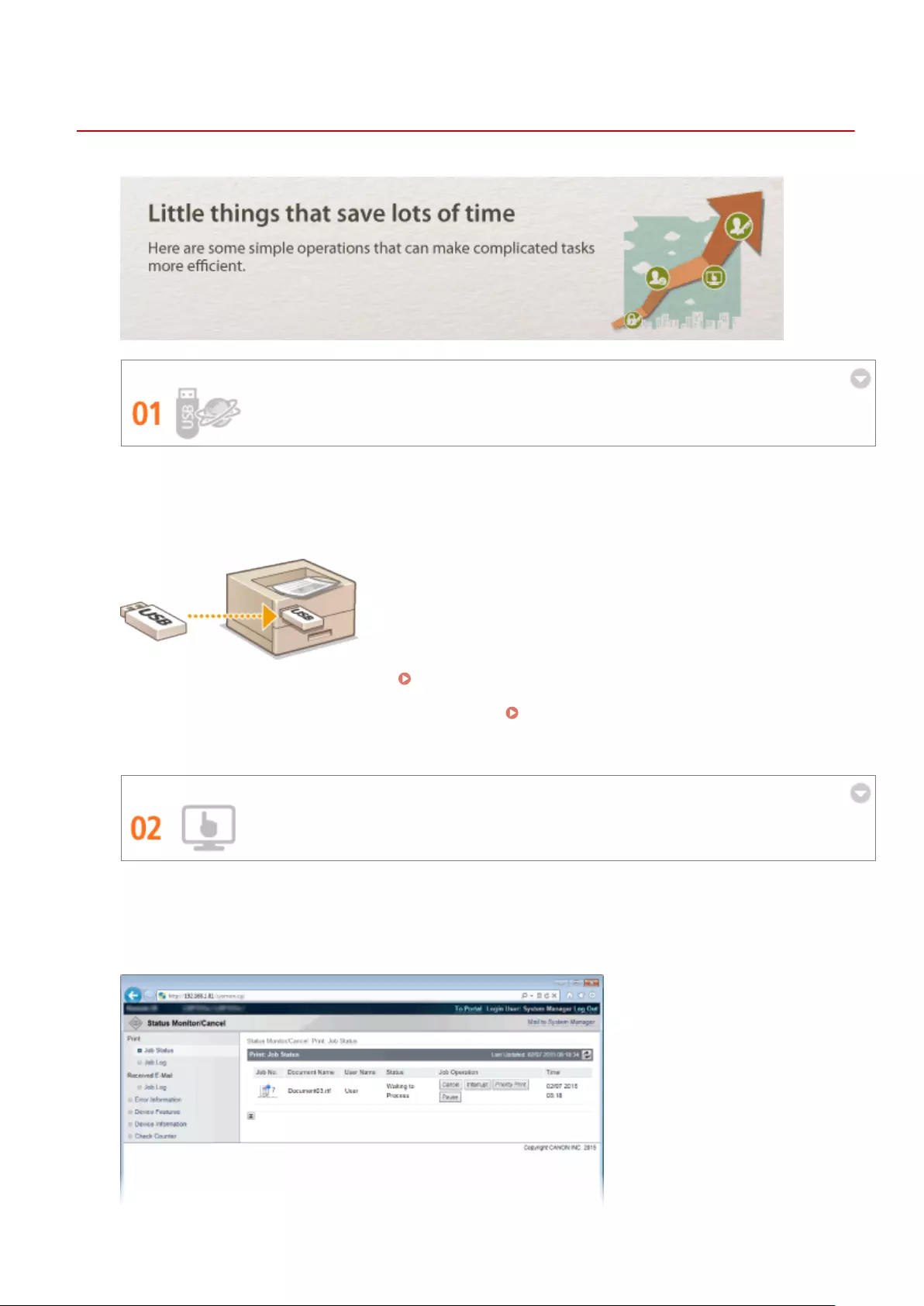
Improving Eciency
0X7U-07C
Print without Application Programs
You can send PDF/PS/EPS/JPEG/TIFF/XPS data from the Remote UI directly to the machine for printing. You can
also print without a computer by connecting a USB memory device to the machine. There is no need to open
les, so you do not need to start an application program. This is very convenient when you are in a hurry and do
not have access to a computer.
To print data directly from the Remote UI: Printing without Opening a File (Direct Print)(P. 146)
To print data directly from USB Memory (USB Direct Print): Printing from USB Memory (USB Direct Print)
(P. 120)
Remote Management with Remote UI
The Remote UI allows you to manage the machine remotely from the computer at your desk. You can check the
remaining amounts of paper and toner cartridge, and check the current status of print jobs to decide if you
should temporarily interrupt print jobs to print urgent documents or move documents up among the jobs
waiting to be printed. Save time and trouble by eliminating trips between your desk and the printer.
Appendix
559
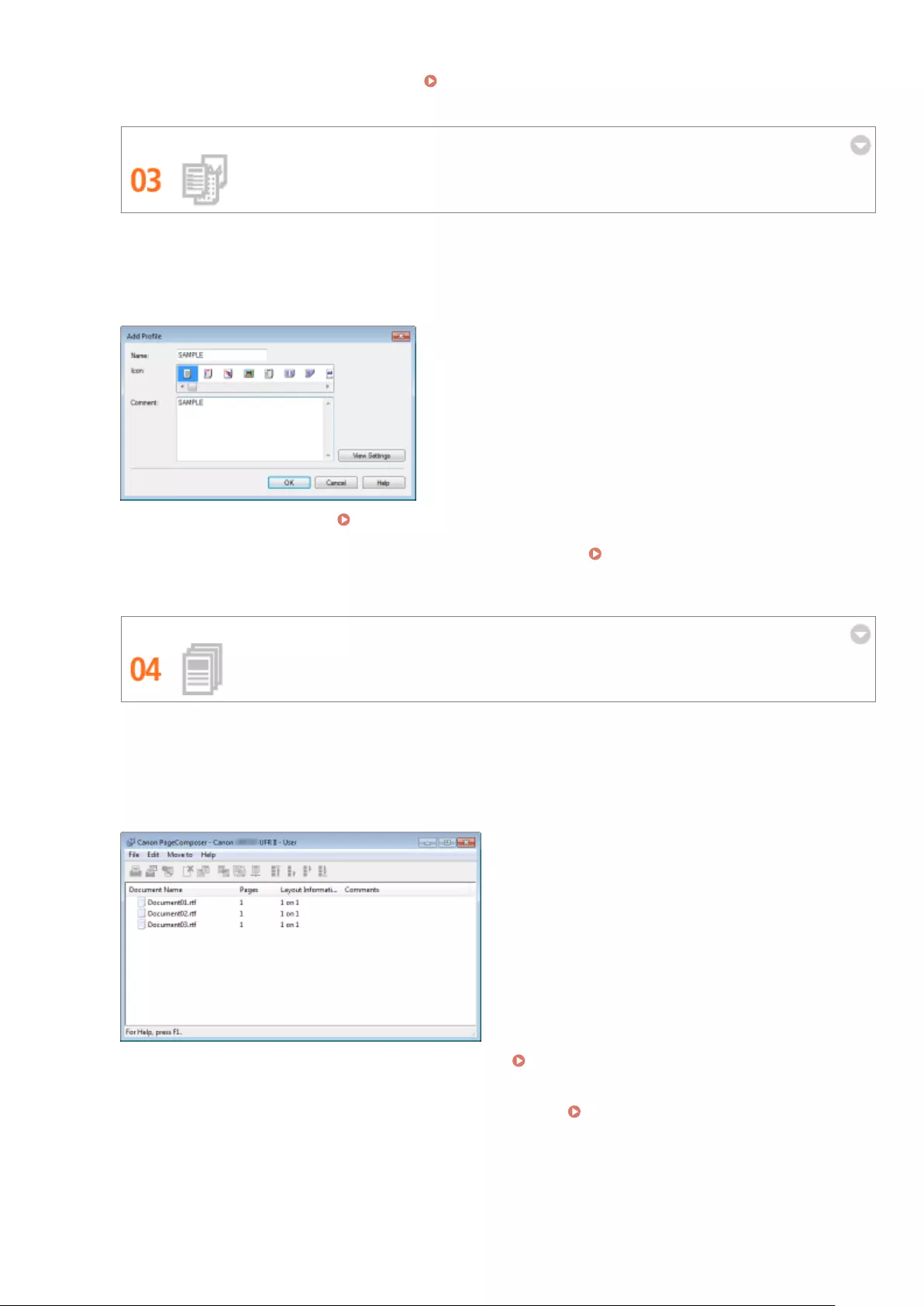
For more information about this function, see Using Remote UI(P. 332) .
Register Favorite Settings and Call Them Up at Any Time
Everyone in the oce uses the printer. If you register the most popular settings as the default settings, you can
use them right away. You can also register frequently used combinations of print settings as "proles." Then
you can call up your favorite settings in a single operation, by selecting a prole instead of selecting each
setting every time you print.
To change default print settings: Changing Default Settings(P. 116)
To register combinations of frequently used print settings as "proles": Registering Combinations of
Frequently Used Print Settings(P. 114)
Save Time with Shortcuts
When you have a number of documents to print, it would be convenient to print them all with one operation.
Canon PageComposer allows you to combine multiple documents and print them all at once. You can also save
frequently printed documents like fax cover sheets in the machine's SD card, and then print them directly from
the operation panel. You don't need to return to your computer and start the printer driver. These shortcuts
save time and allow you to work more eciently.
To combine multiple documents and print them all at once: Combining and Printing Multiple
Documents(P. 109)
To print a document saved on the SD card installed on the machine: Printing a Document Stored in the
Machine (Stored Job Print)(P. 137)
Appendix
560
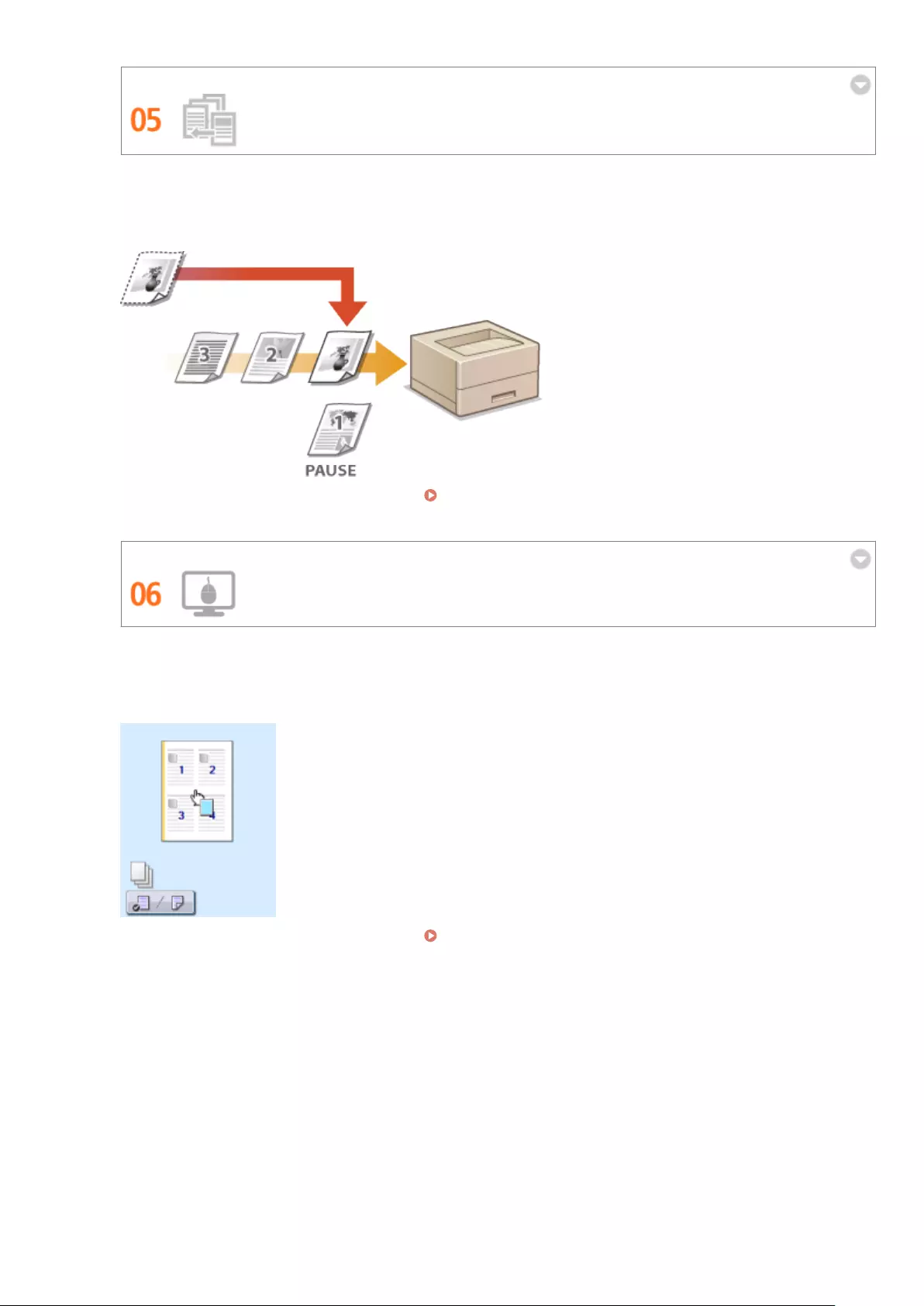
Interrupt Printing for Rush Jobs
You need to print 1 page right away, but a 200-page document is printing and 5 other print jobs are waiting! At
times like this, you can use the Interrupt Print function to have your page printed now without canceling the
other jobs. When your page is nished, printing of the other print jobs resumes smoothly and automatically.
For more information about this function, see Checking Current Status of Print Documents(P. 342) .
Make Print Settings Quickly with Intuitive Operation
You can easily specify the page layout as well as binding position, switching between 1-sided and 2-sided
printing, etc. intuitively on the preview image in the printer driver. The simple click-operation allows you to
conveniently make settings while viewing how settings are applied.
For more information about this function, see Basic Printing Operations(P. 78) .
Appendix
561

So Much More
0X7U-07E
Using a smartphone/tablet
At times such as when you want to quickly print out a proposal you completed on a tablet while travelling to a
business destination, Canon Mobile Application comes in handy. Even in environments without a wireless LAN
router, you can connect to the machine with a mobile device wirelessly and directly.
PCless, quick, and easy! An even broader range of possibilities for work/play with functionality made for this age
of speed.
For more information about this function, see Can Be Used Conveniently with a Mobile Device(P. 165)
Easy Printing with Google Cloud Print
Hook up to Google Cloud Print with your laptop or cell phone, send your data, and out come your printed
documents. With this machine, Google Cloud Print, and your mobile device, print whenever you want from
wherever you want.
For more information about this function, see Using Google Cloud Print(P. 176) .
Keep Your Printouts Private
Appendix
562

Normally, when you print something from your computer, it comes out of the printer right away. However, if
you have sensitive documents, this may not be what you want. Just use secure printing and no one will be able
to print your documents without entering your password on the machine's operation panel. Don't let your
condential documents lie exposed on the tray for everyone to see. For even greater security, you can print a
watermark such as "CONFIDENTIAL" or "PRIVATE COPY."
To print a document secured by a PIN: Printing a Document Secured by a PIN (Secured Print)(P. 131)
To print watermarks such as "CONFIDENTIAL" over the document: Printing Watermarks(P. 101)
Make Posters
Blow up a regular one-sheet printout and make an exceptionally large poster. A large poster will be printed out
on nine sheets. Put them together in a 3x3 grid, and voila!
For more information about this function, see Printing Posters(P. 95) .
Make Booklets
Sometimes your documents deserve better presentation than a staple in the upper-left corner. Making booklets
is easy. The print driver will take care of the page positioning for you. All you have to do is fold the pages and
staple them along the middle.
For more information about this function, see Printing Booklet(P. 96) .
Automatically Collate Meeting Handouts
Appendix
563

When you print multiple copies of a multi-page document, you can use the collate function to print one copy
after another with all of the pages in the correct order. This is convenient when preparing handouts for
meetings or presentations.
For more information about this function, see Collating Printouts by Page(P. 91) .
Appendix
564
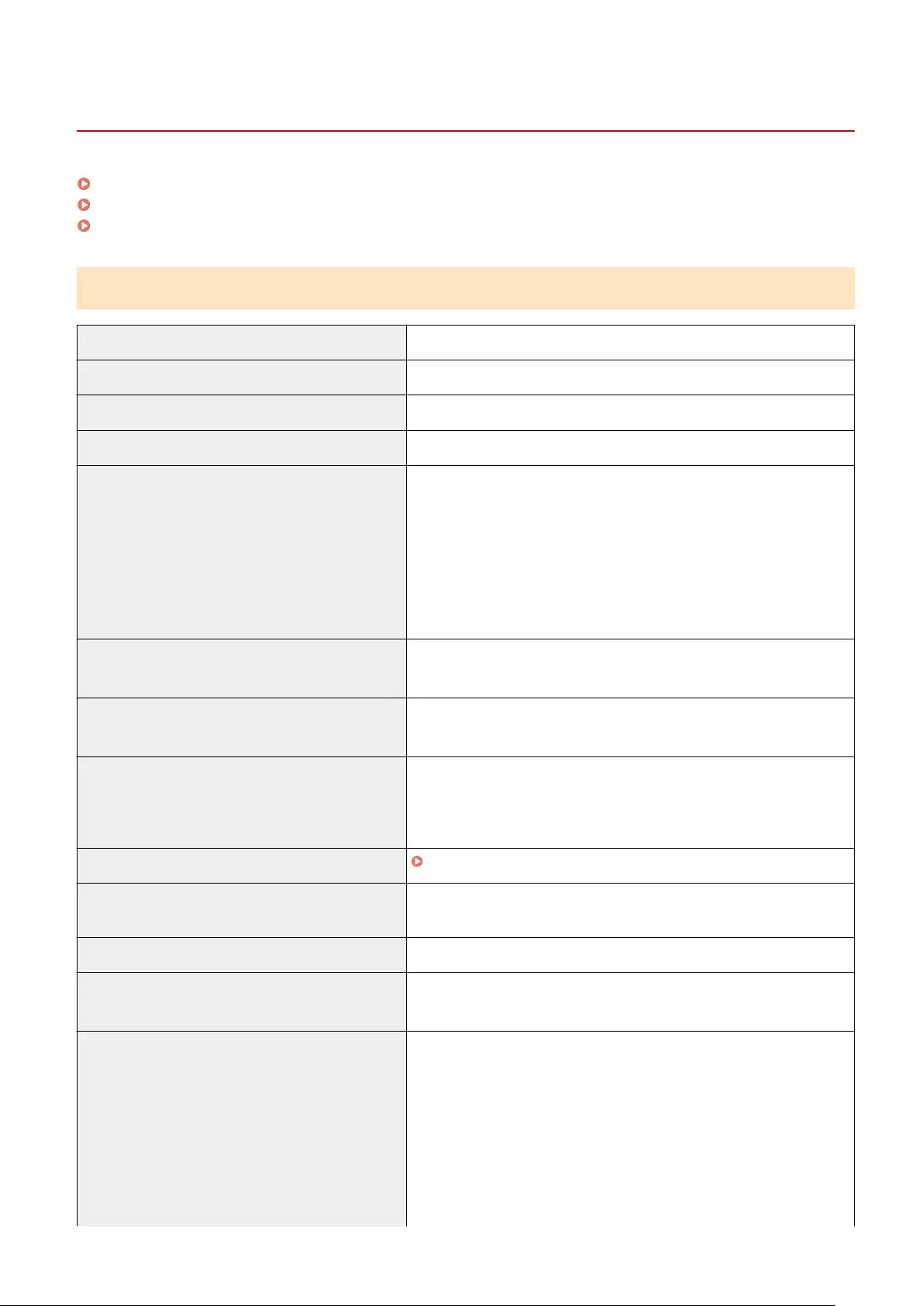
Machine Specications
0X7U-07H
Hardware Specications(P. 566)
Controller Specications(P. 567)
Software Specications(P. 568)
Hardware Specications
Type Desktop page printer
Printing Method Semiconductor laser + dry-type electrophotographic method
Toner Fixing System On-demand xing system
Resolution 600 dpi
Print Speed *1
(Plain paper (60 to 89 g/m²), A4 continuous printing)
LBP352x
●1-sided printing: 62 sheets/minute
●2-sided printing: 41.4 pages/minute *2
LBP351x
●1-sided printing: 55 sheets/minute
●2-sided printing: 36.5 pages/minute *2
Warm-Up Time *3
(from power ON until machine enters standby)
●Normal start: 29 seconds or less
●Quick start: 12 seconds or less
Recovery Time *4
(recovery from sleep mode to standby)
●Mid (Printer Sleep): 10 seconds or less
●High (Deep Sleep): 10 seconds or less
First Print Time *4
(1-sided printing on A4 size paper, with the output tray used)
LBP352x
7.0 seconds
LBP351x
7.2 seconds
Acceptable Paper Stock Paper(P. 569)
2-Sided Printing ●Standard size:
A4, B5, A5, Legal, Letter, Executive, and Foolscap
Paper Output Face down (output tray)/Face up (sub-output tray)
Output Capacity *5 ●Output tray: Approx. 500 sheets
●Sub-output tray: 100 sheets
Noise
(measured in accordance with ISO 7779, declared noise
emission in accordance with ISO 9296)
LwAd (Declared A-weighted sound power level (1 B = 10 dB))
●During standby mode: 4.0 B or less
●During printing:
1-sided printing: 7.1 B or less
2-sided printing: 7.1 B or less
LpAm (Declared A-weighted sound pressure level (Bystander position))
●During standby mode: 26 dB
●During printing:
Appendix
566
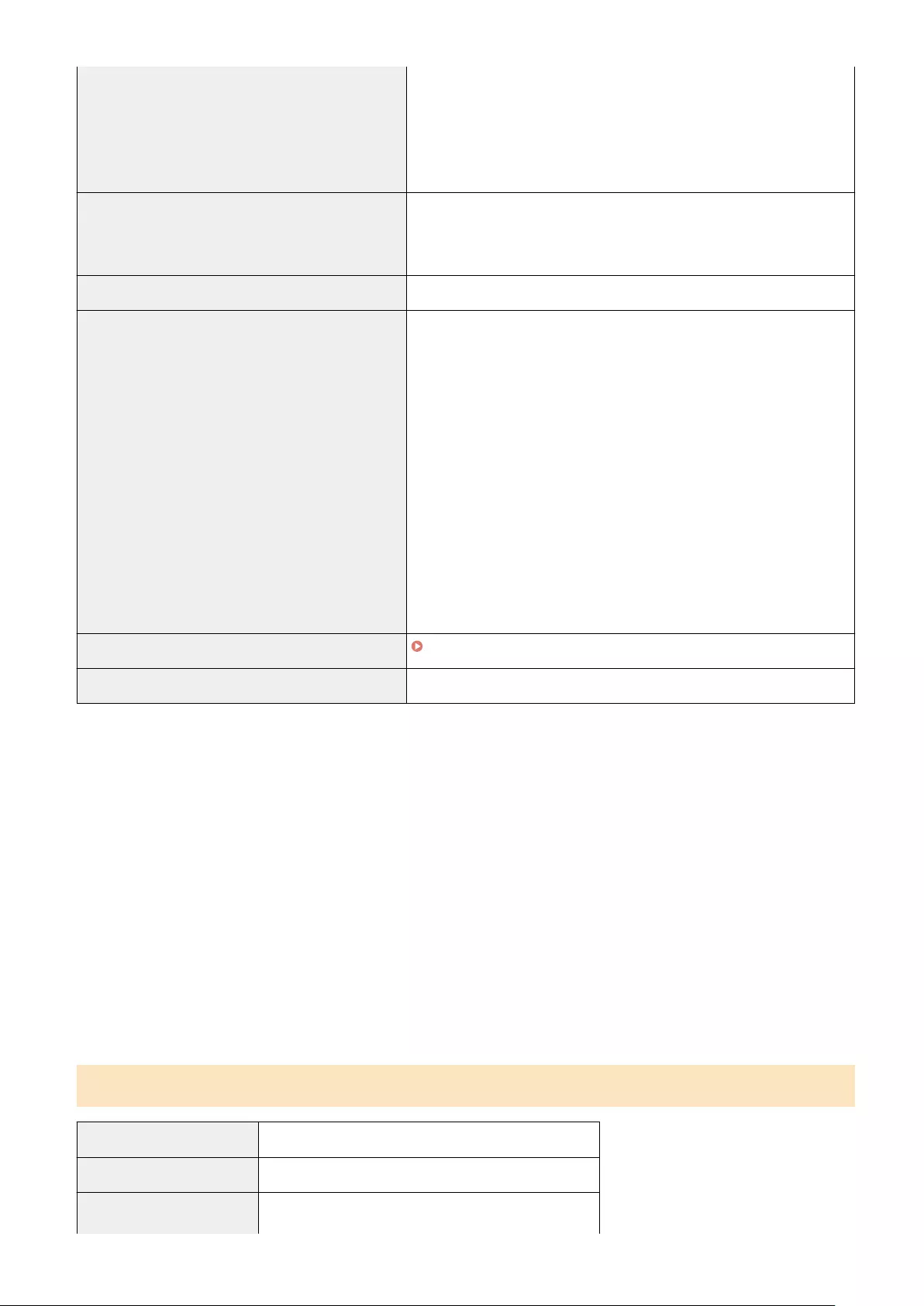
LBP352x
1-sided printing: 57 dB
2-sided printing: 57 dB
LBP351x
1-sided printing: 56 dB
2-sided printing: 56 dB
Environmental Conditions
(Main unit only)
System requirements
●Temperature: 10 to 30 °C
●Humidity: 20 to 80% RH (no condensation)
Power Supply 220 to 240 V (± 10 %), 50/60 Hz (± 2 Hz)
Power Consumption *6
(at 20 °C)
●Maximum: 1,650 W or less
●During operation:
Approx. 850 W (LBP352x)
Approx. 800 W (LBP351x)
●During standby: Approx. 19 W
●During sleep mode:
<Mid (Printer Sleep)> *7:
Approx. 4.0 W (Wired LAN connection)
Approx. 4.2 W (USB connection)
<High (Deep Sleep)> *7:
Approx. 1.1 W (Wired LAN connection)
Approx. 2.0 W (USB connection)
●During power-off:
0.17 W or less (shutdown)
0.75 W or less (quick turn-OFF)
Consumables Consumables(P. 573)
Weight *8 Approx. 24.5 kg
*1 The print speed may be slower depending on the output resolution, paper size, paper type, paper orientation, and a
specied number of sheets to print.
*2 For 2-sided printing, one page printed on the front side of a sheet and one printed on the back side are counted as one
output sheet.
*3 May vary depending on the use conditions of the machine (including attached optional accessories and installation
environment).
*4 May vary depending on the output environment.
*5 May vary depending on the installation environment and paper type used.
*6 Even if the printer is turned OFF, power is still consumed slightly while the power plug is inserted in the AC power outlet.
To stop the power consumption completely, unplug the power plug from the AC power outlet.
*7 Power may be consumed more than the values shown here according to the situation even if the sleep mode is set to <Mid
(Printer Sleep)> or <High (Deep Sleep)>.
*8 The weight of the machine excluding the weight of a toner cartridge.
Controller Specications
CPU 264 MHz + 528 MHz
Memory (RAM) Capacity 1,024 MB
Host Interface ●USB interface:
Hi-Speed USB x 4 (Front side x 1, Back side x 3)
Appendix
567
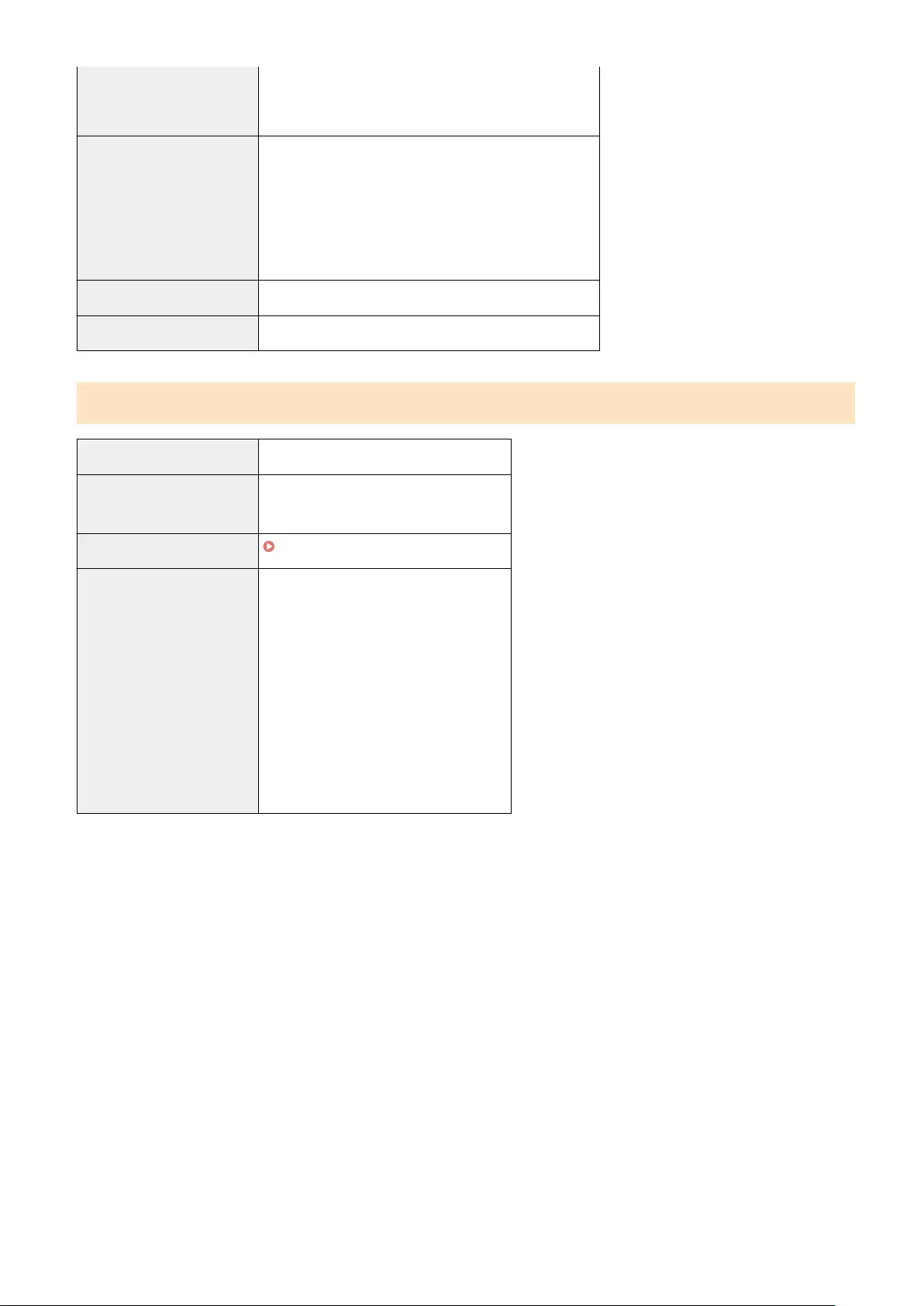
●Network interface:
Common to 10BASE-T/100BASE-TX/1000BASE-T (RJ-45)
Full Duplex/Half Duplex
User Interface ●LCD:
132 x 65 dots
F-STN LCD
●LED indicator: 5 indicators
●Operation key: 12 keys
●Numeric key: Yes
ROM connector 1 connector
SD card slot 1 slot
Software Specications
Built-in Control Command PCL6, PostScript 3, UFR II, PDF, and XPS
Built-in Scalable Font ●PCL: 93 Scalable fonts, 10 Bitmap fonts
●PS: 136 standard fonts
Printable Range Printable Area(P. 572)
Network Interface Supported protocol
●TCP/IP (Frame type: Ethernet II)
●SMB (option)
Print application
●LPD
●RAW
●IPP/IPPS
●FTP
●WSD
Appendix
568

Paper
0X7U-07J
◼Supported Paper Sizes
Paper sizes that can be loaded in the paper drawer, multi-purpose tray, or optional paper sources are listed below.
Drawer 1
A4 (210.0 x 297.0 mm) *1*2
B5 (182.0 x 257.0 mm) *1*2
A5 (148.0 x 210.0 mm) *2*3
A6 (105.0 x 148.0 mm) *1*4
Legal (215.9 x 355.6 mm) *1*2
Letter (215.9 x 279.4 mm) *1*2
Statement (139.7 x 215.9 mm) *1*4
Executive (184.1 x 266.7 mm) *1*2
Foolscap (215.9 x 330.2 mm) *1*2
16K (195.0 x 270.0 mm) *1
Custom Paper Size *5
Drawer 2 to 5 (optional)
A4 (210.0 x 297.0 mm) *1*2
B5 (182.0 x 257.0 mm) *1*2
A5 (148.0 x 210.0 mm) *1*2
Legal (215.9 x 355.6 mm) *1*2
Letter (215.9 x 279.4 mm) *1*2
Executive (184.1 x 266.7 mm) *1*2
Foolscap (215.9 x 330.2 mm) *1*2
16K (195.0 x 270.0 mm) *1
Custom Paper Size *6
Paper Deck (optional)
A4 (210.0 x 297.0 mm) *1*2
Legal (215.9 x 355.6 mm) *1*2
Letter (215.9 x 279.4 mm) *1*2
Multi-Purpose Tray
A4 (210.0 x 297.0 mm) *1*2
B5 (182.0 x 257.0 mm) *1*2
A5 (148.0 x 210.0 mm) *2*7
A6 (105.0 x 148.0 mm) *1
Legal (215.9 x 355.6 mm) *1*2
Letter (215.9 x 279.4 mm) *1*2
Statement (139.7 x 215.9 mm) *1
Executive (184.1 x 266.7 mm) *1*2
Foolscap (215.9 x 330.2 mm) *1*2
16K (195.0 x 270.0 mm) *1
Envelope COM10 (104.7 x 241.3 mm) *1
Envelope Monarch (98.4 x 190.5 mm) *1
Envelope C5 (162.0 x 229.0 mm) *1
Envelope DL (110.0 x 220.0 mm) *1
Index Card (76.2 x 127.0 mm) *1
Custom Paper Size *8
Envelope Feeder (optional)
Envelope COM10 (104.7 x 241.3 mm) *1
Envelope Monarch (98.4 x 190.5 mm) *1
Appendix
569
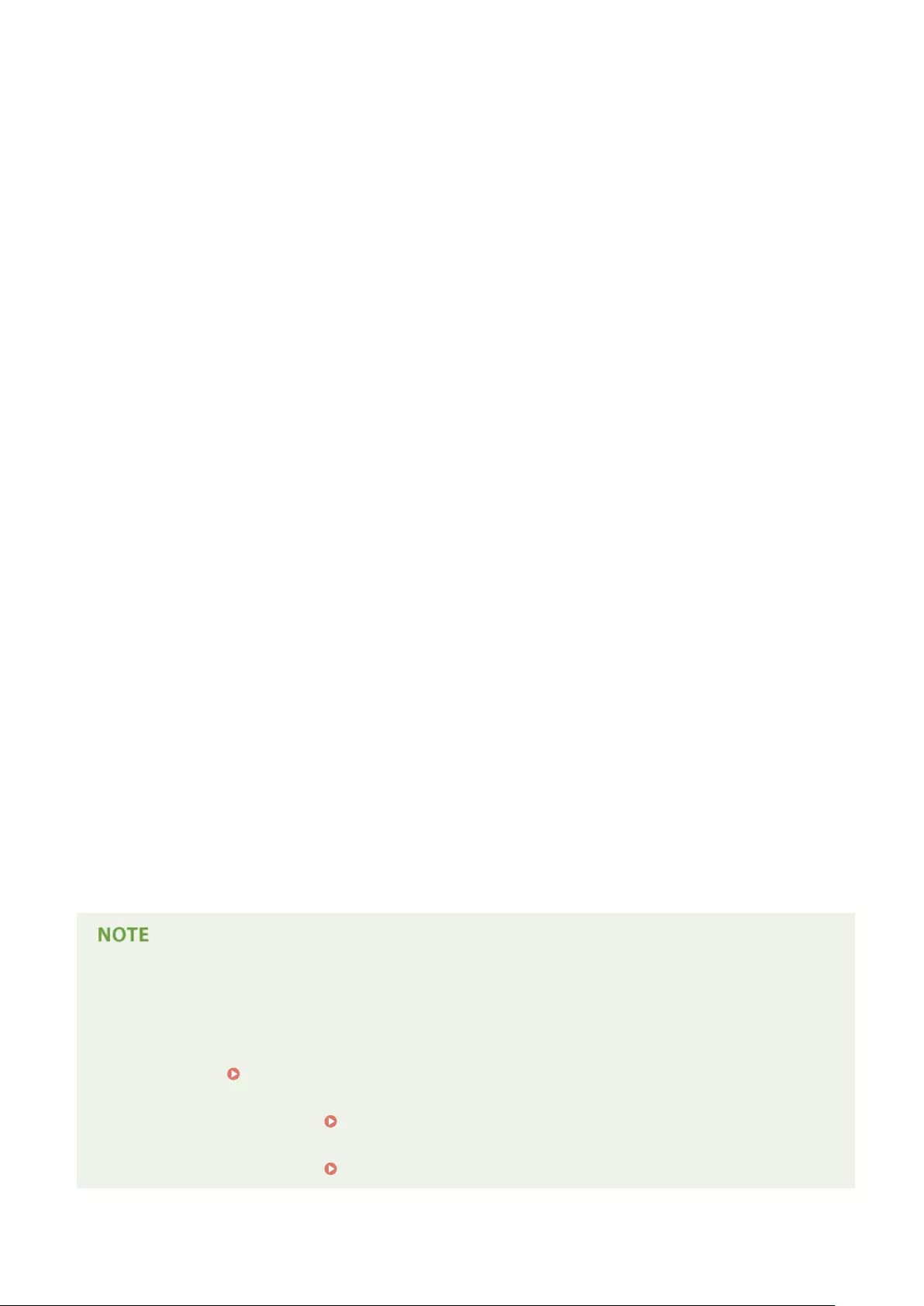
Envelope C5 (162.0 x 229.0 mm) *1
Envelope DL (110.0 x 220.0 mm) *1
Custom Paper Size *9
*1 Can be loaded in portrait orientation only.
*2 Automatic 2-sided printing is available without replacing paper.
*3 A5 size paper can be loaded in landscape orientation only when the optional A5 cassette is installed. Automatic 2-sided
printing on A5 size paper is only possible when the paper is loaded in portrait orientation.
*4 Printable only when an optional custom media cassette is attached.
*5 The following sizes are available:
Machine's standard paper drawer
●When loaded in portrait orientation:
Width 148.0 to 215.9 mm, Length 210.0 to 355.6 mm
●When loaded in landscape orientation (only with the UFR II printer driver used):
Width 148.0 to 215.9 mm, Length 148.0 to 215.9 mm
Custom media cassette (optional)
●When loaded in portrait orientation:
Width 102.0 to 170.0 mm, Length 148.0 to 282.0 mm
●When loaded in landscape orientation (only with the UFR II printer driver used):
Width 102.0 to 170.0 mm, Length 148.0 to 170.0 mm
*6 The following sizes are available:
●When loaded in portrait orientation:
Width 148.0 to 215.9 mm, Length 210.0 to 355.6 mm
●When loaded in landscape orientation (only with the UFR II printer driver used):
Width 210.0 to 215.9 mm, Length 210.0 to 215.9 mm
*7 Automatic 2-sided printing on A5 size paper is only possible when the paper is loaded in portrait orientation.
*8 The following sizes are available:
●When loaded in portrait orientation:
Width 76.2 to 215.9 mm, Length 127.0 to 355.6 mm
●When loaded in landscape orientation (only with the UFR II printer driver used):
Width 127.0 to 215.9 mm, Length 127.0 to 215.9 mm
*9 The following sizes are available:
●When loaded in portrait orientation:
Width 90.0 to 178.0 mm, Length 160.0 to 254.0 mm
●When loaded in landscape orientation (only with the UFR II printer driver used):
Width 160.0 to 178.0 mm, Length 160.0 to 178.0 mm
Factory default settings
●For drawers 1 to 5, the default setting of paper size is <Auto>. With this setting, the machine automatically
recognizes the size of the loaded paper and therefore you need not change the paper size setting in most
cases. However, you need to change the paper size setting when using the optional A5 cassette or custom
media cassette. Specifying the Size and Type of the Paper in the Paper Drawer(P. 60)
●For the multi-purpose tray, the default setting of paper size is <A4>. Change the paper size setting when
using a different size of paper. Specifying Paper Size and Type in the Multi-Purpose Tray(P. 63)
●For the envelope feeder, the default setting of paper size is <Env. DL>. Change the paper size setting when
using a different size of paper. Specifying Paper Size and Type for the Envelope Feeder (Option)(P. 65)
Appendix
570
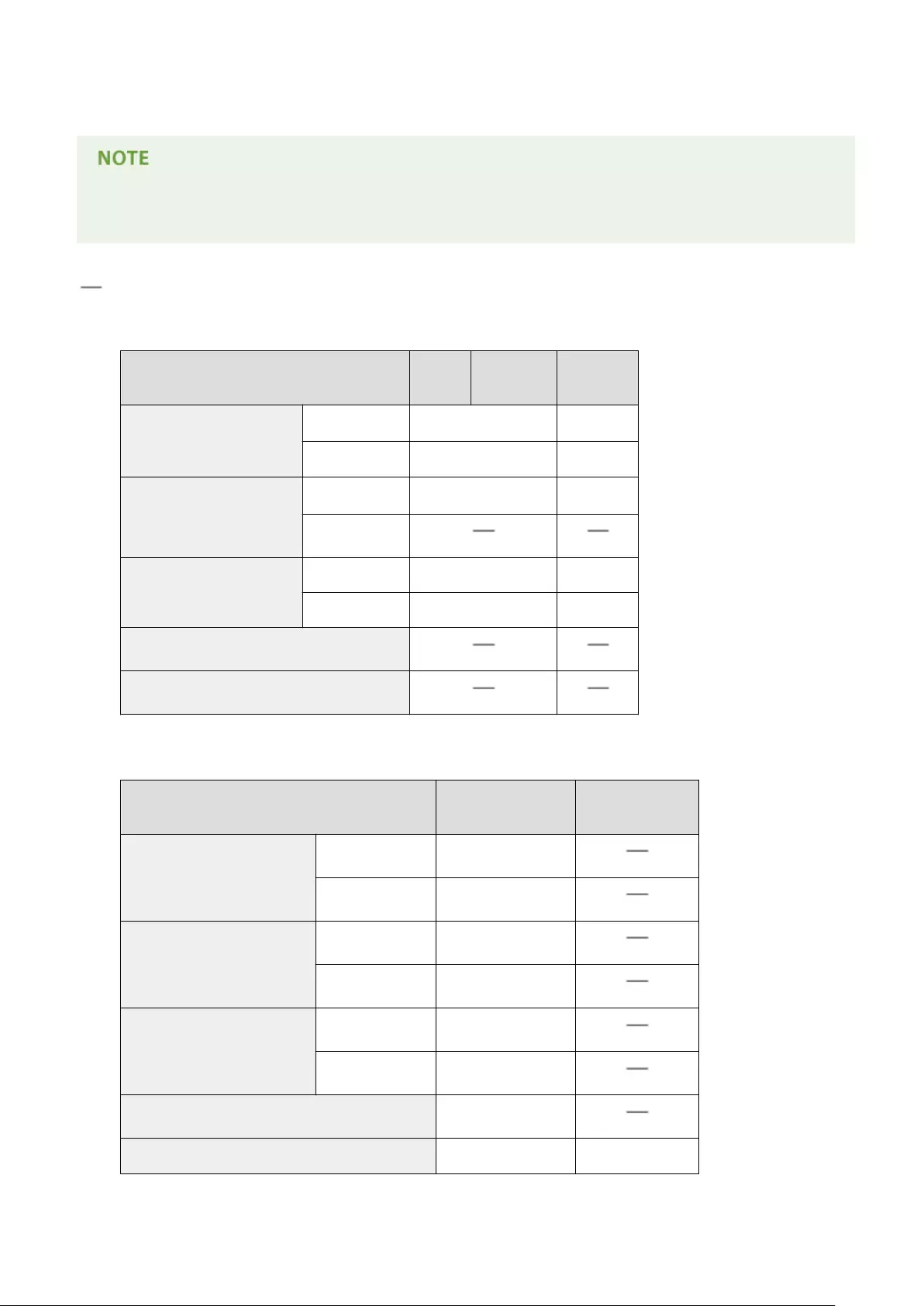
◼Paper Type and Paper Source Capacity
Chlorine-free paper can be used with this machine.
●Print quality may deteriorate depending on the paper type used. Each source capacity indicated in the
following table is merely a guide, so it may be different from the actual capacity.
: Unavailable
Drawer 1/Drawer 2 to 5 (optional)/Paper Deck (optional)
Paper Type Drawer 1 Drawer 2 to 5
(optional)
Paper Deck
(optional)
Plain paper *1*2
60 to 80 g/m² 500 sheets *3 1,500 sheets
81 to 89 g/m² 300 sheets 900 sheets
Heavy paper
90 to 120 g/m² *2 250 sheets 750 sheets
121 to 135 g/m²
Bond paper *2
60 to 75 g/m² 500 sheets 1,500 sheets
76 to 90 g/m² 300 sheets 900 sheets
Labels
Envelope
Multi-Purpose Tray/Envelope Feeder (optional)
Paper Type Multi-Purpose Tray Envelope Feeder
(optional)
Plain paper *1*2
60 to 80 g/m² 100 sheets
81 to 89 g/m² 50 sheets
Heavy paper
90 to 120 g/m² *2 50 sheets
121 to 135 g/m² 50 sheets
Bond paper *2
60 to 75 g/m² 100 sheets
76 to 90 g/m² 50 sheets
Labels 40 sheets
Envelope 10 sheets 75 sheets
*1 Recycled paper is also available.
*2 Automatic 2-sided printing is available without replacing paper.
Appendix
571
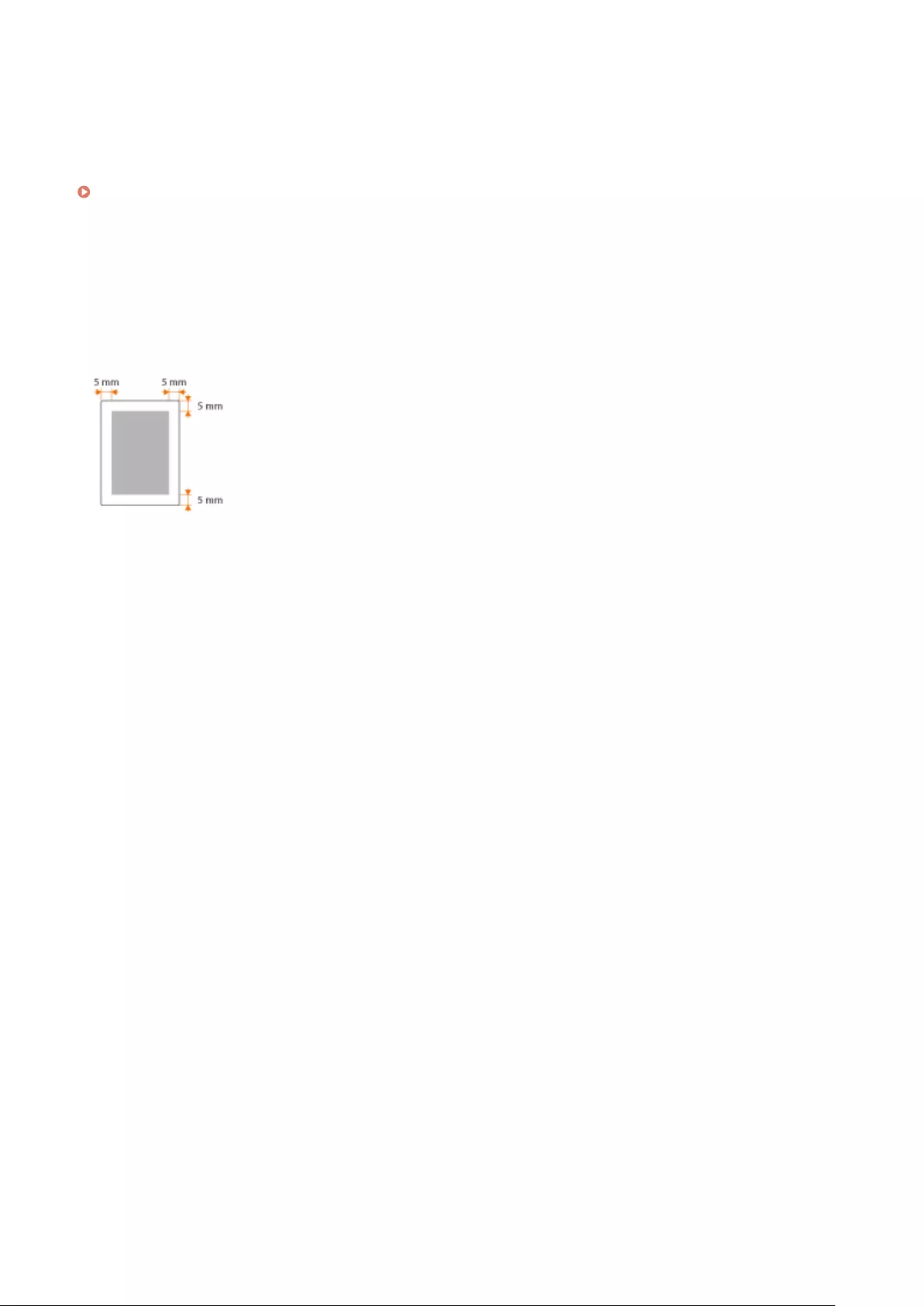
*3 The source capacity when paper of 80 g/m² is used. For paper of 64 g/m², up to 550 sheets can be loaded.
◼Paper Type and Setting for the Machine
Loading Paper(P. 37)
◼Printable Area
The shaded areas in the image below indicate the printable area of the document. For envelope, the top, bottom, left,
and right margins are all 10 mm.
Appendix
572
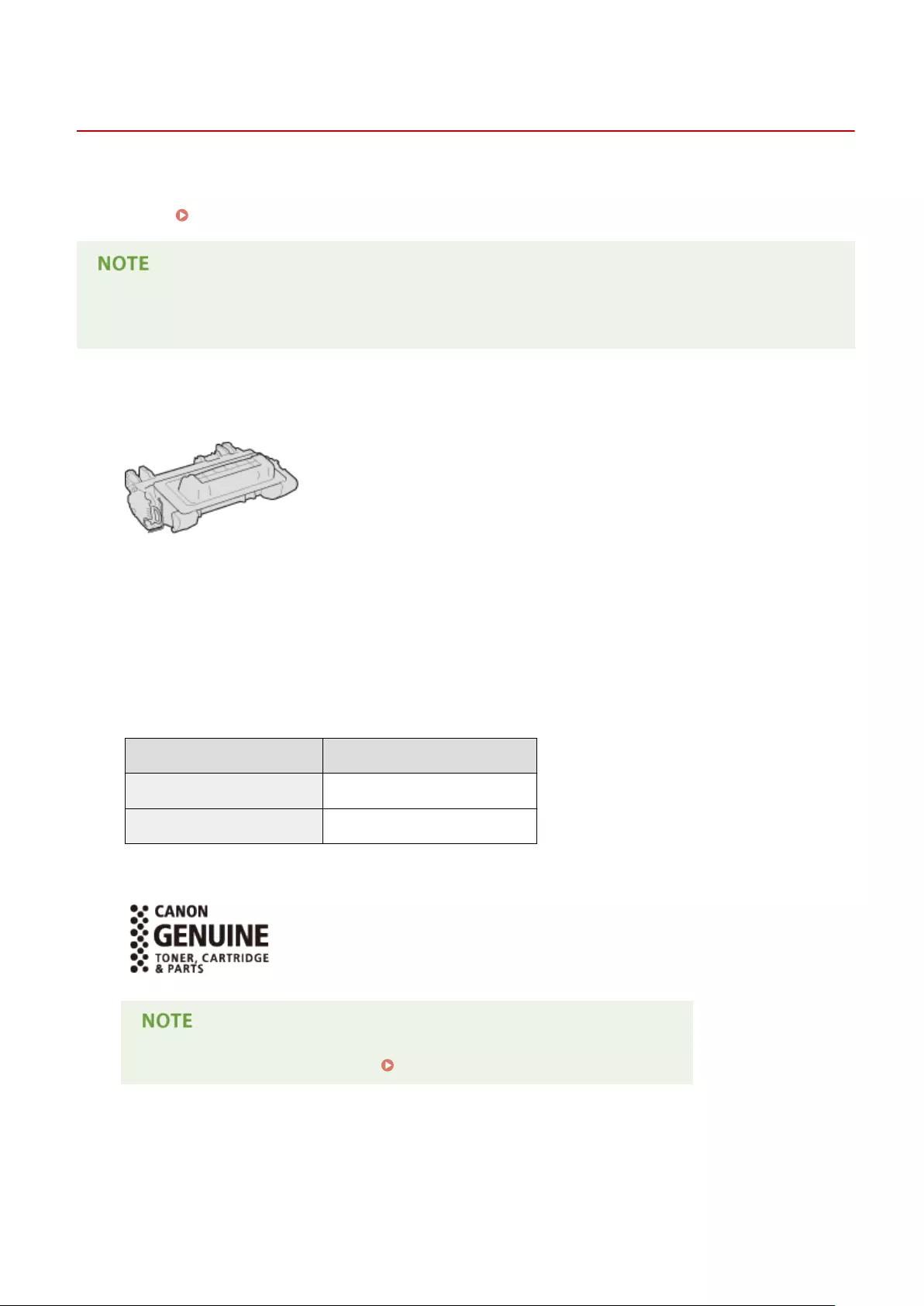
Consumables
0X7U-07K
The following is a guide to the estimated replacement time for the consumables used in this machine. Purchase
consumables at your local authorized Canon dealer. Observe safety and health precautions when storing and handling
consumables ( Consumables(P. 10) ).
●Depending on the installation environment, printing paper size, or document type, you may need to replace
consumables before the end of the estimated lifetime.
◼Toner Cartridges
Supplied Toner Cartridges
The average yield* of the toner cartridge that comes with the machine is 11,000 sheets.
* The average yield is based on "ISO/IEC 19752" (the global standard related to "Method for the determination of toner
cartridge yield for monochromatic electrophotographic printers and multi-function devices that contain printer
components" issued by ISO [International Organization for Standardization]) when printing A4 size paper with the default
print density setting.
Replacement Toner Cartridges
For optimum print quality, using Canon genuine toner cartridges is recommended.
Canon Genuine Toner Cartridge Average yield of toner cartridge*
Canon Cartridge 039 11,000 sheets
Canon Cartridge 039 H 25,000 sheets
Genuine Canon Consumables
For optimum print quality, using Canon genuine Toner, Cartridge and Parts is recommended.
●When replacing toner cartridges How to Replace Toner Cartridges(P. 524)
Appendix
573

Consumable Parts
0X7U-07L
This section describes the consumable parts of the machine and the estimated timings for replacing them. Purchase
the consumable parts at your local authorized Canon dealer.
●Depending on the installation environment, paper size, or data type, you may need to replace consumable
parts before the end of their estimated lifetime.
◼User Maintenance Kit UM-A1
Fixing unit/Transfer roller/Feeder roller
The average number of pages that can be printed per xing unit is 225,000. When replacing the xing unit,
also replace the rollers.
●When replacing the xing unit or other consumable part, see the "Replacing Guide" supplied with
"User Maintenance Kit UM-A1". You can also see "Replacing Guide" at the Canon Web site.
Appendix
574
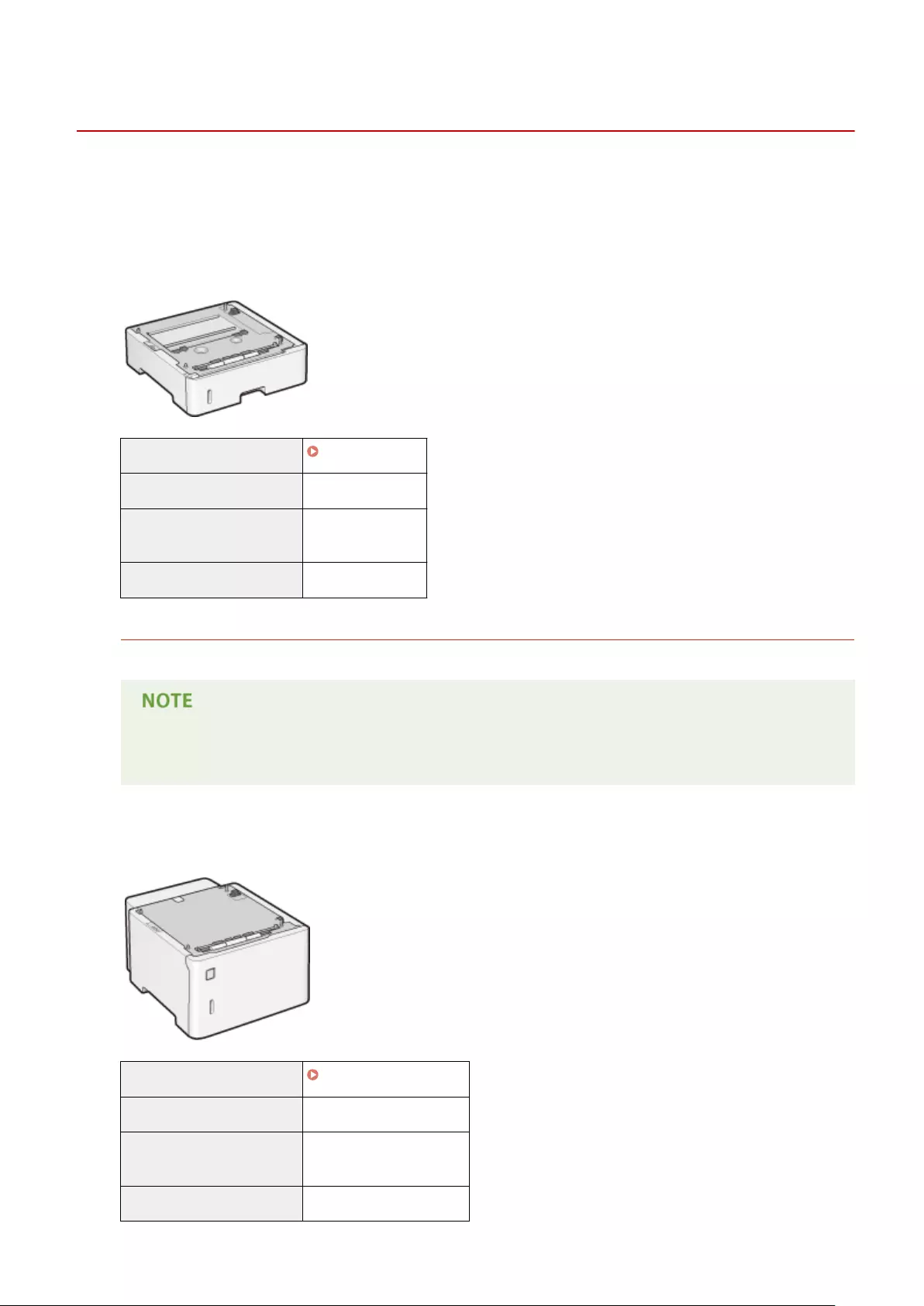
Optional Items
0X7U-07R
The functionality of the machine can be fully utilized by using the optional items described below. Optional items can
be purchased from the retail outlet where you purchased the machine or from your local Canon dealer.
◼Paper Feeder PF-B1
Use of the optional paper feeder allows you to load a different size of paper
than that loadable in the standard paper drawer, thus reducing the time and
labor of paper size replacement.
Available Paper Paper(P. 569)
Power Supply From main unit
Dimensions
(W x L x H) 415 x 448 x 148 mm
Weight Approx. 6.4 kg
Installation Method
See "Getting Started."
●You can install up to four units of paper feeder in the machine. However, if you use the optional paper
deck, the maximum installable number of paper feeder units is three.
◼Paper Deck Unit PD-G1
Use of the optional paper deck allows you to load a large amount of paper of
standard size such as A4, thus reducing the time and labor of paper
replenishment.
Available Paper Paper(P. 569)
Power supply Supplied from the machine
Dimensions
(W x L x H) 415 x 519 x 286 mm
Weight Approx. 12.7 kg
Appendix
575
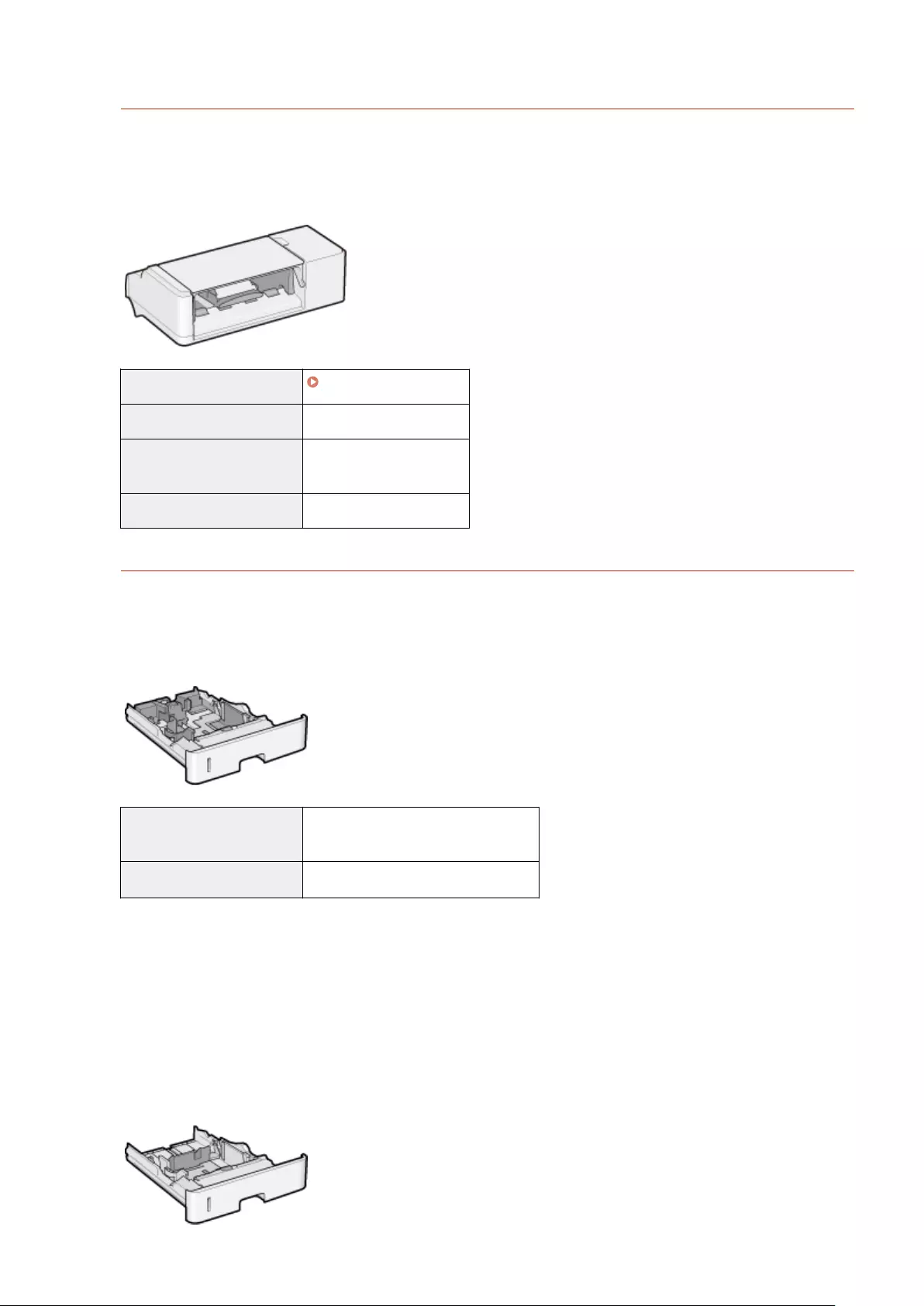
Installation Method
See "Getting Started."
◼Envelope Feeder EF-A1
If you install the envelope feeder, you can load a large number of
envelopes. Even when the envelope feeder is left installed, you can use the
multi-purpose tray.
Available Paper Paper(P. 569)
Power supply Supplied from the machine
Dimensions
(W x L x H) 330 x 234 x 118 mm
Weight Approx. 2.3 kg
Installation Method
See "Getting Started."
◼Custom Media Cassette CM-A1
You can load A6 size paper. To use this cassette, replace the standard paper
drawer in the machine by it.
Paper Capacity Approx. 500 sheets (64 g/m²)
Approx. 450 sheets (80 g/m²)
Available Paper A5, A6, Statement, Custom Paper Size *
*The following sizes are available:
●When loaded in portrait orientation:
Width 102.0 to 170.0 mm, Length 148.0 to 282.0 mm
●When loaded in landscape orientation (only with the UFR II printer driver used):
Width 102.0 to 170.0 mm, Length 148.0 to 170.0 mm
◼A5 Cassette C-A1
You can load A5 size paper in landscape orientation. To use this cassette,
replace the standard paper drawer in the machine by it.
Appendix
576

Paper Capacity Approx. 500 sheets (64 g/m²)
Approx. 450 sheets (80 g/m²)
Available Paper A5
◼Barcode Printing Kit-F1
If the Barcode Printing Kit-F1 is installed on the machine, barcode printing mode is added,
enabling barcodes to be printed from your computer.
The Barcode Printing Kit-F1 contains the following barcode fonts.
●OCR-B
●Symb. FontInform
●Symbole stethos
●BarDIMM ©1997
●USPS ZEBRA+4Stat
This option enables you to generate barcodes in various formats. Note that if you want to print
barcodes, PCL must be enabled. For information on using the Barcode Printing Kit, see the
Barcode Printing Guide (PDF manual). The Barcode Printing Guide is stored in the following
folder on the Instruction Manual DVD-ROM.
[LBP351_352 Manual_eng]-[pdfs]-[Barcode Printing Guide]
Installation Method
Installing the ROM(P. 579)
●You can install only one unit of Barcode Printing Kit-F1 on the machine.
◼PCL International Font Set-C1
If the PCL International Font Set-C1 is installed on the machine, the following fonts are added
for a PCL printer. As a result, you can output using multiple languages in a SAP Unicode
environment.
●Andale® and WorldType® Collection J (Japanese Version)
●Andale® and WorldType® Collection K (Korean Version)
●Andale® and WorldType® Collection S (Simplied Chinese Version)
●Andale® and WorldType® Collection T (Traditional Chinese Version)
In order to support differences in character design depending on the region, four font versions
are enabled.
Installation Method
Installing the ROM(P. 579)
Appendix
577
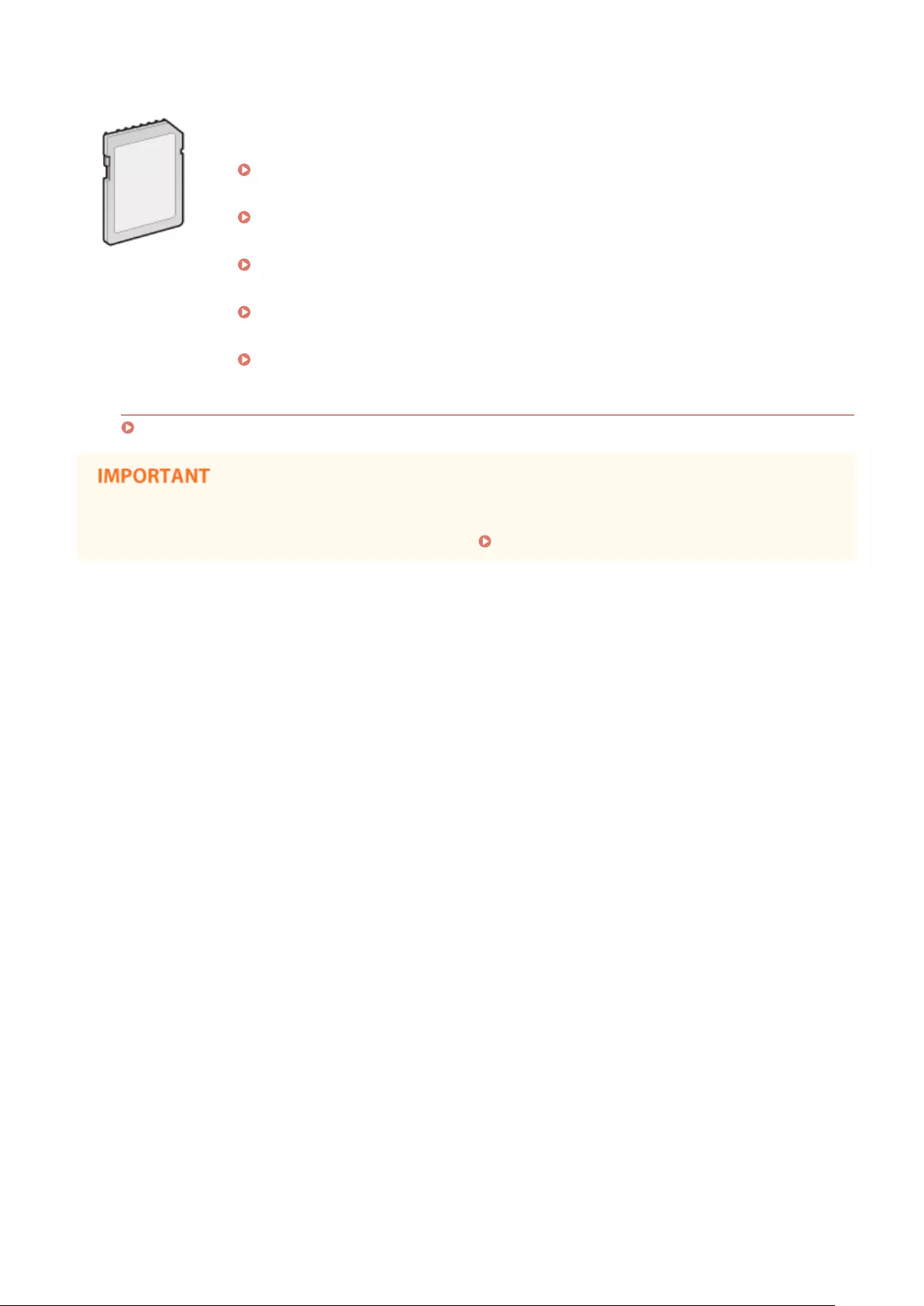
◼SD CARD-C1
You can install the SD card to use the functions described below.
●Secured Print
Printing a Document Secured by a PIN (Secured Print)(P. 131)
●Stored Job Print
Printing a Document Stored in the Machine (Stored Job Print)(P. 137)
●Interrupt Print, Priority Print, Pause/Resume
Checking Current Status of Print Documents(P. 342)
●SMB Print
Conguring SMB(P. 242)
●Spooler
Spooler(P. 389)
Installation Method
Installing an SD Card(P. 583)
●When you dispose of a used SD card, perform <Completely Del. Data> for it or physically destroy it to
prevent your personal information from being leaked. Installing an SD Card(P. 583)
Appendix
578

Installing the ROM
0X7U-07S
This section describes how to install the Barcode Printing Kit-F1 or PCL
International Font Set-C1 in the machine. The ROM is used connected to
the ROM connectors inside the right cover of the machine. Read the
precautions in Installation(P. 3) before installing the ROM.
Precautions when installing the ROM
●Do not cause any metal such as screws to come into contact with the circuit boards in the machine. Doing so
may result in damage to the machine.
●Do not touch the internal parts, printed wiring, connectors, or switches. Doing so may result in damage to
the machine.
●Do not turn ON the power when the ROM cover is open. Doing so may result in damage to the machine.
Precautions for avoiding static electricity
The ROM contains parts that are sensitive to static electricity. Observe the following precautions for preventing
the ROM from being damaged by static electricity.
●Touch a metal portion in the room to discharge static electricity from your body before handling the ROM.
●Do not touch any item that is likely to generate static electricity, such as a display, during work.
●To avoid the inuence of static electricity, do not remove the ROM from the protective bag until just before
connecting it to the ROM connectors.
1Turn OFF the machine, and unplug the power plug from the AC power outlet.
●When you turn OFF the power, shut down the machine from the operation panel without using the power
switch. Turning OFF the Power (Performing a Shutdown)(P. 33)
2Remove the right cover.
1While pushing the catch, slightly open the cover toward you.
Appendix
579
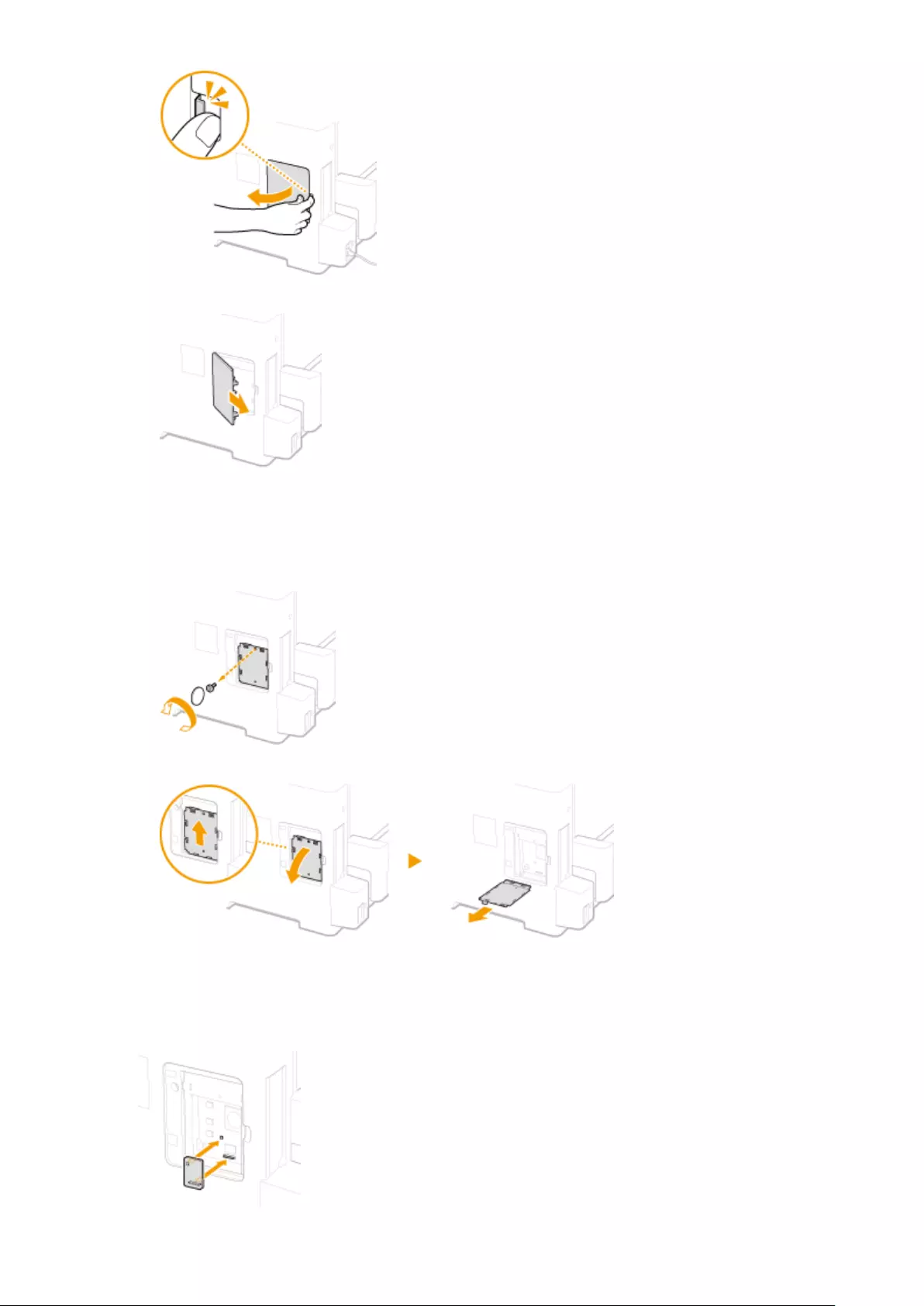
2Remove the right cover in the direction indicated by the arrow.
3Remove the ROM cover.
1Use a coin to remove the screws.
2Open the ROM cover, and remove it in the direction indicated by the arrow.
4Install the ROM.
●While aligning the ROM with the two ROM connectors of the machine, securely push it until it stops.
Appendix
580
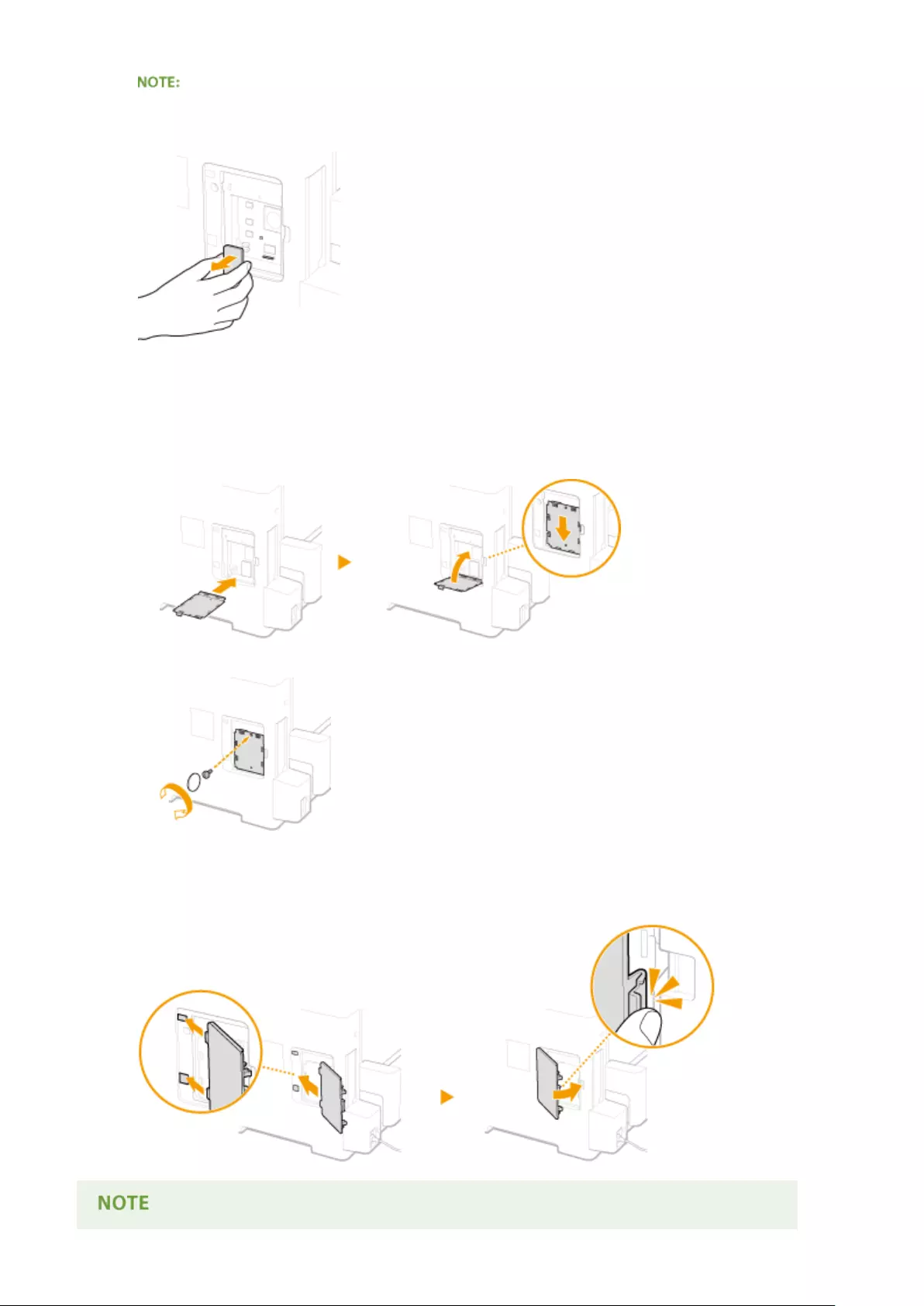
When disconnecting the ROM
●Hold the edges of the ROM and pull it out as shown in the illustration below.
5Put the ROM cover back into position.
1Close the ROM cover by pushing in the catch of the ROM cover in the direction indicated by the
arrow.
2Use a coin to reattach the screws.
6Insert the right cover in the direction indicated by the arrow, and close it while
pushing the catch.
Appendix
581
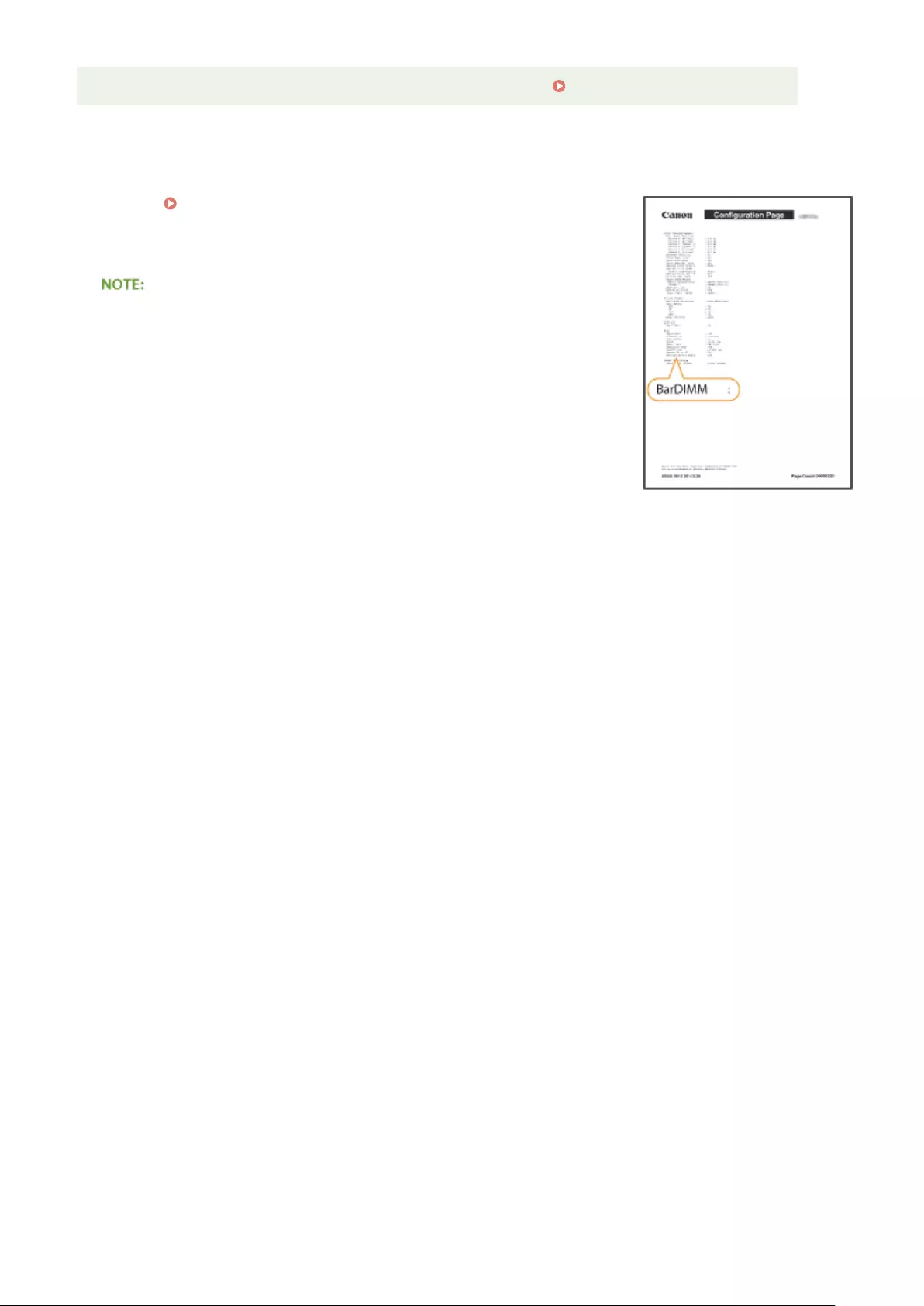
●When you want to install an SD card at the same time, proceed to Installing an SD Card(P. 583) .
◼Checking that Barcode Printing Kit-F1 Is Properly Installed
Print the Conguration Page(P. 445) , and conrm that "BarDIMM" is
displayed in "PCL"
If "BarDIMM" is displayed, the ROM is properly installed.
If "BarDIMM" is not displayed
●The ROM is not installed properly. Remove the ROM from the machine, and
reconnect it.
Appendix
582
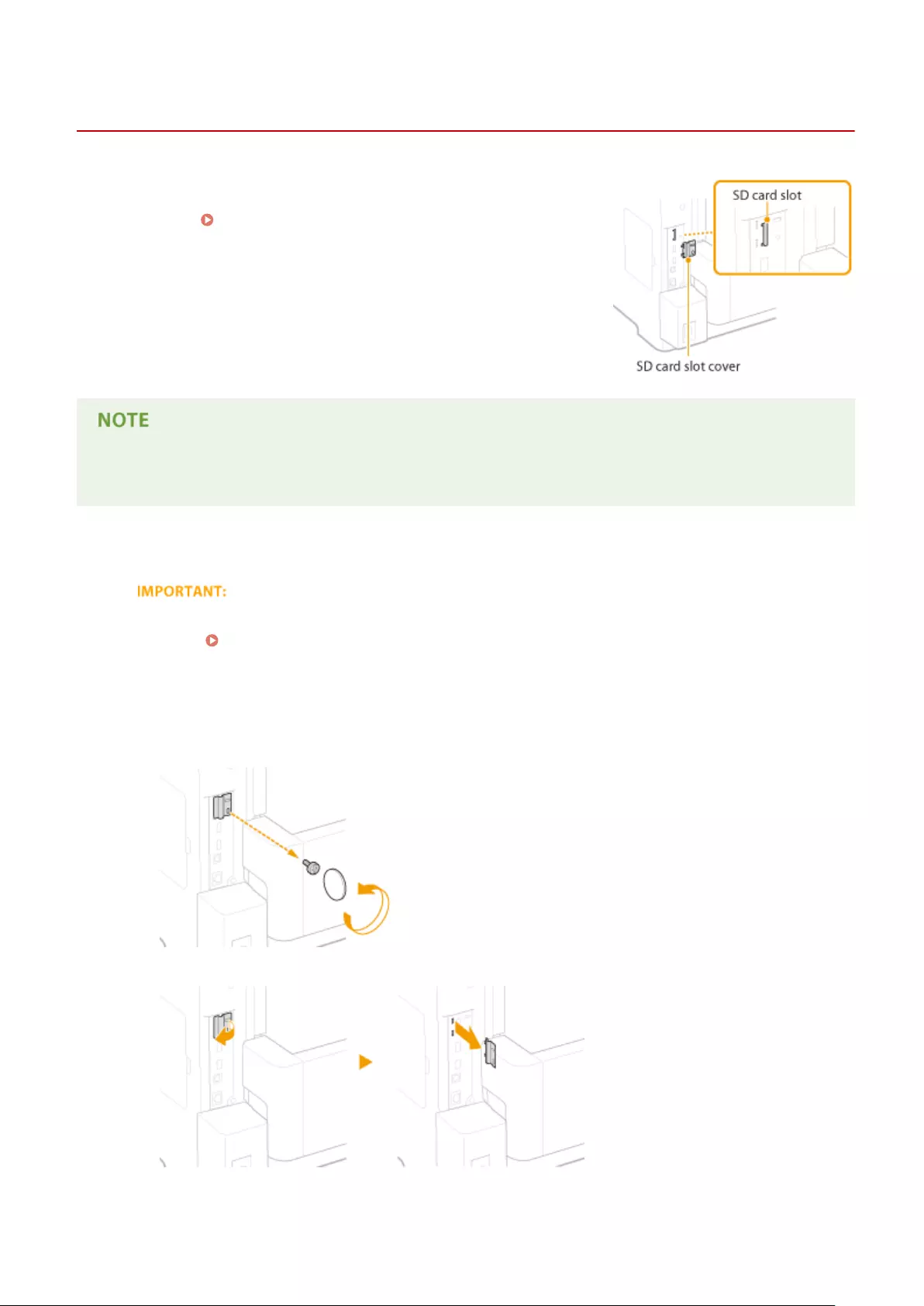
Installing an SD Card
0X7U-07U
This section describes how to mount and initialize an SD card. Insert the
SD card into the SD card slot on the back side of the machine. Read the
precautions in Installation(P. 3) before installing the SD card. Note that
the data in the machine that is stored to the SD card is all subjected to
encryption. This ensures safe use of the SD card on a computer or in other
situation because the encrypted data in the SD card is protected against
unauthorized extraction.
●Before mounting the SD card, check whether the SD card is write-protected. If the card is write-protected,
unlock the card before inserting it.
1Turn OFF the machine, and unplug the power plug from the AC power outlet.
●When you turn OFF the power, shut down the machine from the operation panel without using the power
switch. Turning OFF the Power (Performing a Shutdown)(P. 33)
2Remove the SD card slot cover.
1Use a coin to remove the screws.
2Open the SD card slot cover, and remove it in the direction indicated by the arrow.
Appendix
583
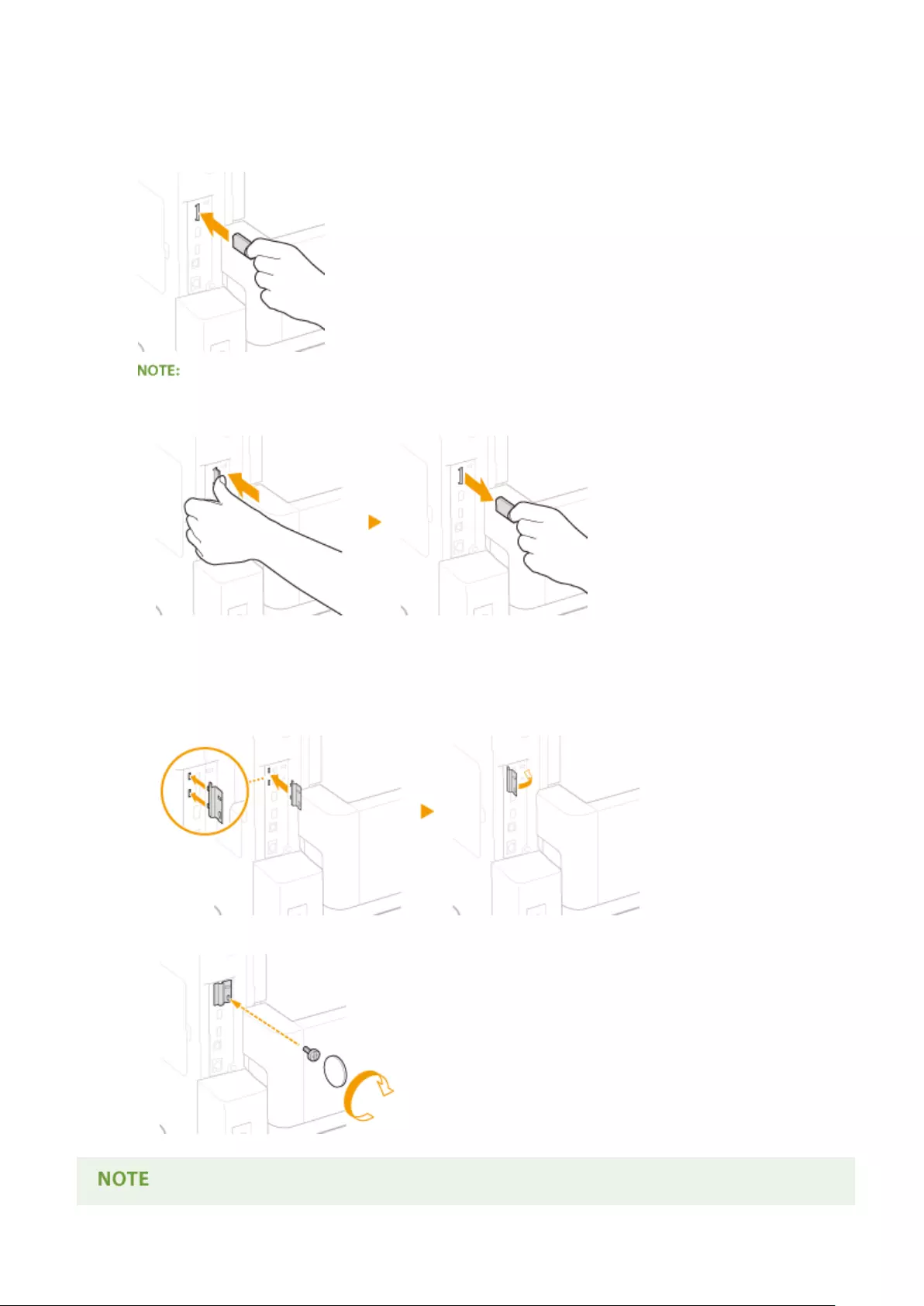
3Install an SD Card.
●Insert the card into the SD card slot until it clicks.
When removing the SD card
●Push the SD card until it clicks as shown in the illustration, release your nger, and then remove it.
4Reinstall the SD card slot cover.
1Close the SD card slot cover by pushing in the catch of the cover.
2Use a coin to reattach the screws.
Appendix
584

SD Card Anti-theft Security Slot
●The SD card slot cover is provided with a security slot, to which you can
attach security wire or equivalent.
●The hole of the security slot is 3.4 mm wide and 7.4 mm high.
●For inquires about the security slot, contact your local authorized Canon
dealer.
◼Initializing the SD Card
When you turn ON the power for the rst time after installing the SD card, <Format
SD Card?> appears on the display. Press to start initializing the SD card. When the
initialization is completed, the SD card is ready to use.
If <Format SD Card?> is not displayed
●Initialize the SD card by selecting <Format> under <SD Card Maintenance> in the setting menu of the
operation panel. SD Card Maintenance(P. 410)
◼Checking that the SD Card Is Properly Installed on the Machine
Print the Conguration Page(P. 536) , and the SD card is installed properly if
"SD Card" in "Control Menu" is "On."
If no SD card status information is indicated
●The SD card is not installed properly. Remove the SD card from the
machine, and remount it.
◼Conguring the Information of the SD Card
If an SD card was added after the printer driver was installed, you need to congure the SD card information in the
printer driver. Optional Items(P. 575)
◼Deleting All Data in an SD Card
Before disposing of an SD card, you can use the procedure below to delete all data in the card. The procedure deletes
even those fragments of data that cannot be deleted normally. This eliminates the risk of your data being red by third
parties, thus you can dispose of the SD card safely.
Appendix
585
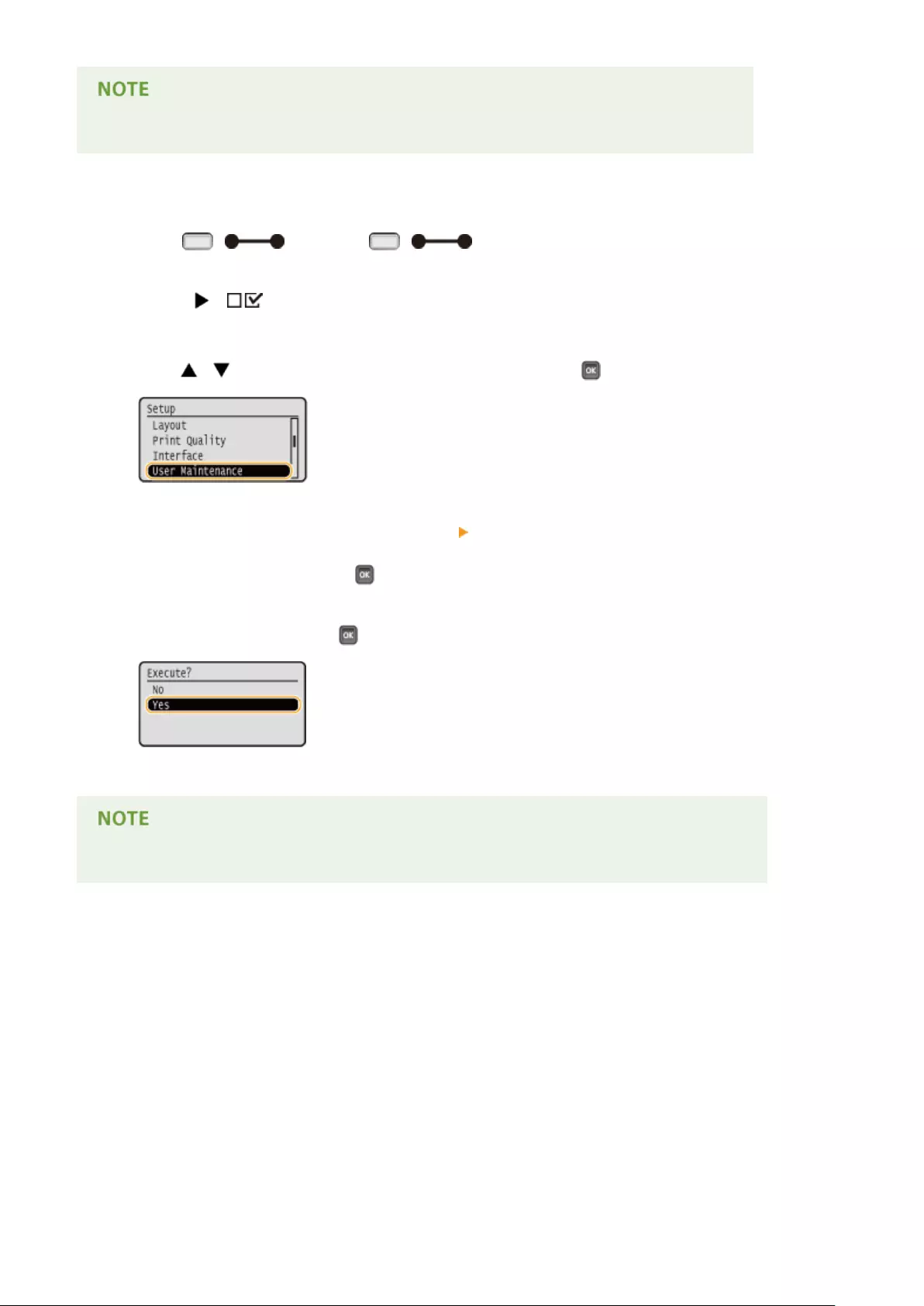
●For any SD cards other than the optional "SD CARD-C1", the procedure below cannot be used.
1Set the machine to oine.
●When ( ) is lit, press ( ).
2Press ( )
3Use / to select <User Maintenance>, and press .
4Proceed with <SD Card Maintenance> <Completely Del. Data> in this order.
●When a message appears, press .
5Select <Yes>, and press .
➠The machine is restarted. After that, the machine is turned OFF automatically.
●When <Completely Del. Data> has been performed, the setting for <SD Card> changes to <Off>.
Appendix
586
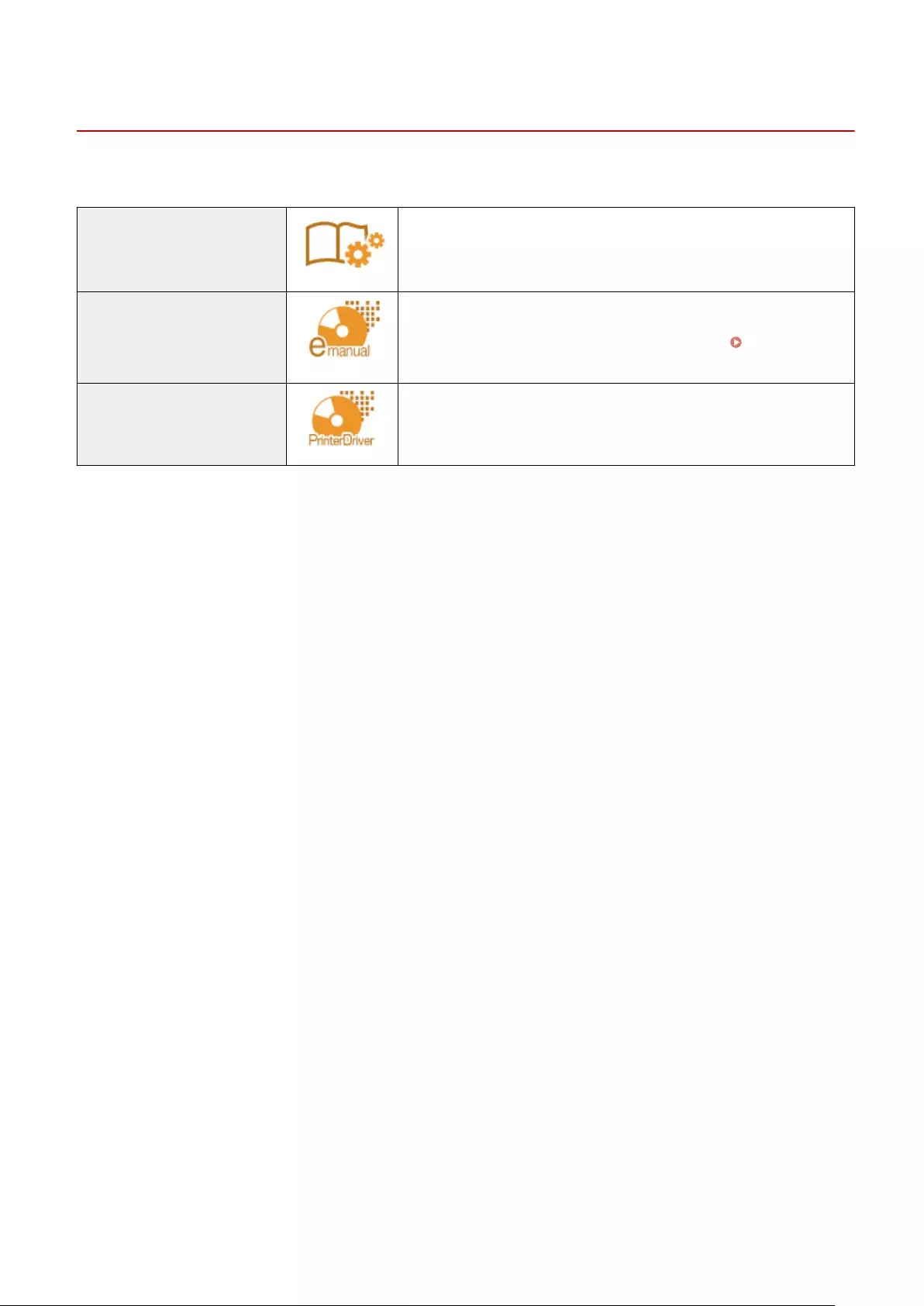
Manuals Included with the Machine
0X7U-081
The manuals listed below are included with the machine. Refer to them as necessary.
Getting Started Read this manual rst. It describes basic setup procedures, from removing
the packing materials to setting up the machine.
e-Manual
(This Manual)
This manual describes all the functions of the machine in a manual that is
viewed using a Web browser. You can browse information by category or
enter a keyword to search for pages on a specic topic. Using e-
Manual(P. 588)
Printer Driver Installation Guide This manual describes how to install the printer driver and the supplied
software on the User Software DVD-ROM.
Appendix
587
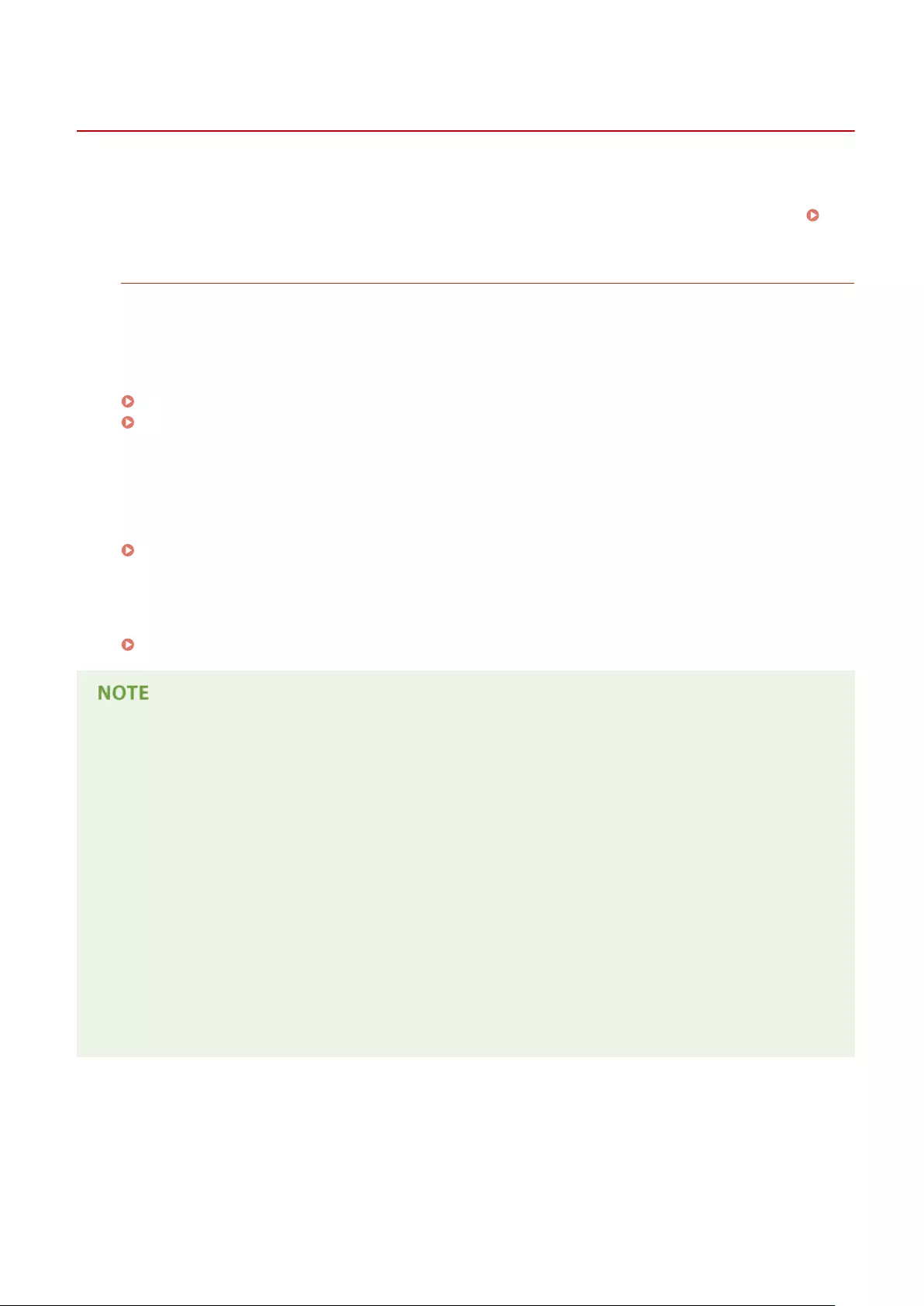
Using e-Manual
0X7U-082
The e-Manual is a manual that can be viewed on your computer that describes all of the functions of the machine. You
can search from your intended use or enter a keyword to quickly nd the page you are looking for. You can use the e-
Manual by installing it on your computer, or start the e-Manual directly from the Instruction Manual DVD-ROM.
Installing e-Manual(P. 589)
How to Find the Topic You Are Looking for
You can nd the page you are looking for using the following 3 methods.
Search the contents
You can nd the page you are looking for by selecting the topic from the [Contents] tab on the left side of the
screen, and selecting the [Chapter icon] next to the topic.
Top Page(P. 592)
Topic Page(P. 594)
Search by keyword
Perform a search by entering a keyword, such as "envelope" or "toner cartridge", and the pages containing the
keyword are displayed. You can nd the page you are looking for from those results. You can also enter phrases
such as "connecting to a network." The keyword search also supports the AND Boolean to search for multiple
keywords.
Search Tab(P. 596)
Search the site map
Click [Site Map] on the top part of the screen, and a list of all the e-Manual topics is displayed. From there you
can nd the topic you are looking for.
Site Map(P. 597)
System Requirements
●To use the e-Manual, the following Web browsers are required. The content of the e-Manual may not display
correctly if a browser not listed below is used.
Windows:
Internet Explorer 8.0/9.0/10.0/11.0
Firefox 24.x ESR/26.x/29.x/30.x/31.x/31.x ESR/32.x/33.x/34.x/35.x/36.x/37.x/38.x
Mac OS:
Safari 7.x/8.x
Firefox 24.x ESR/26.x/29.x/30.x/31.x/31.x ESR/32.x/33.x/34.x/35.x/36.x/37.x/38.x
●The DVD-ROM provided for this product may include manuals in PDF format. If you do not have access to
Adobe Reader to view the manuals in PDF format, try other programs such as PDF Preview developed by
Vivid Document Imaging Technologies.
About the latest e-Manual
For the latest e-Manual, see the Canon Web site.
Appendix
588
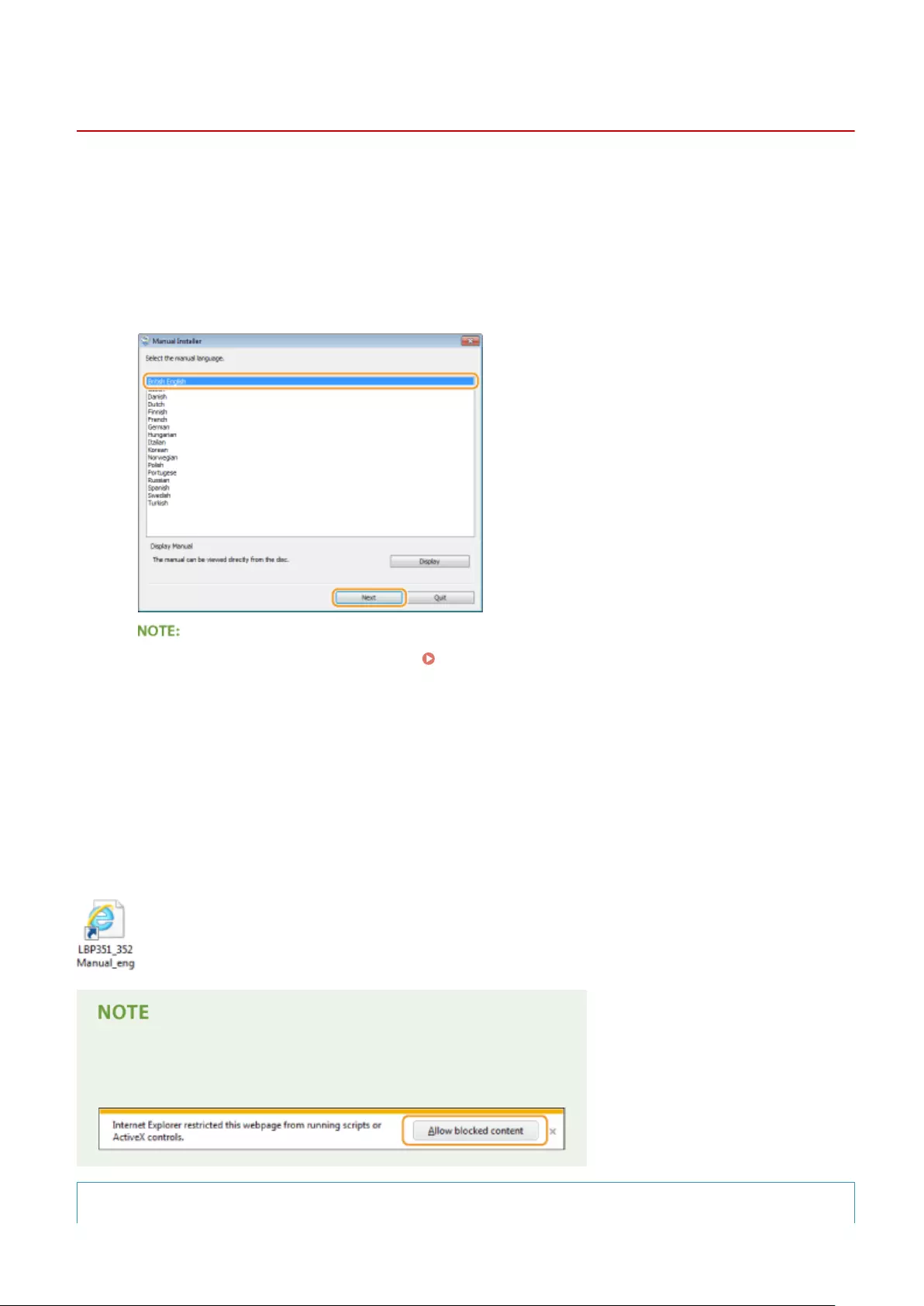
Installing e-Manual
0X7U-083
Install the e-Manual on your computer by using the Instruction Manual DVD-ROM that comes with the machine.
1Insert the Instruction Manual DVD-ROM into the drive on the computer.
2Select the language, and click [Next].
●If the above screen is not displayed Displaying the Setup Screen of Instruction Manual DVD-
ROM(P. 617)
●If [AutoPlay] is displayed, click [Run Maninst.exe].
3Follow the on-screen instructions to install the manual.
◼Viewing the e-Manual
Double-click the [LBP351_352 Manual_eng] icon on the desktop.
If a security warning message appears
●Click [Allow blocked content].
TIPS for Viewing the e-Manual Directly from the DVD-ROM
Appendix
589

1Insert the Instruction Manual DVD-ROM into the drive on the computer.
●If the setup screen of the Instruction Manual DVD-ROM is not displayed, remove the DVD-ROM
from the drive, and insert it again. If the setup screen is still not displayed Displaying the
Setup Screen of Instruction Manual DVD-ROM(P. 617)
2Select the language, and click [Display] in "Display Manual."
Appendix
590

Uninstalling e-Manual
0X7U-084
You can remove the e-Manual from the computer to restore the computer to the same state it was in before the e-
Manual was installed. Manually delete the data generated during installation.
1Delete the folder in which the manual is saved.
●Windows Vista/7/Server 2008/8.1/Server 2012 R2
Delete the [LBP351_352 Manual_eng] folder in "C:/Users/(user-name)/Documents/Canon/Manuals."
●Windows 8/Server 2012
Delete the [LBP351_352 Manual_eng] folder in "C:/Users/(user-name)/My Documents/Canon/Manuals."
●Windows Server 2003
Delete the [LBP351_352 Manual_eng] folder in "C:/Documents and Settings/(user-name)/My Documents/
Canon/Manuals."
●The above shows an example of standard installation. If you changed the location to install the e-manual,
search for and delete the folder in question.
2Delete the [LBP351_352 Manual_eng] shortcut icon from the desktop.
Appendix
591
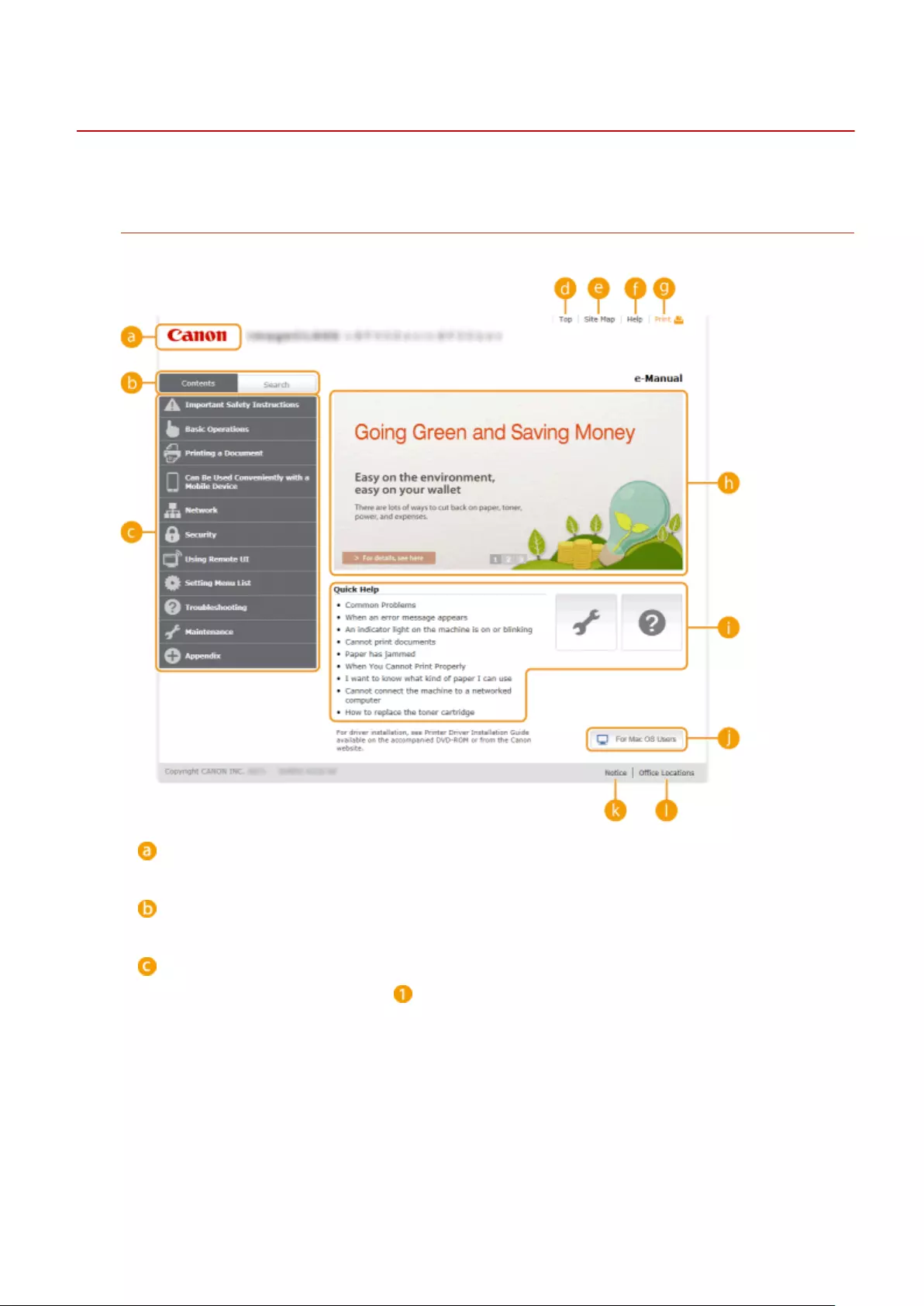
Screen Layout of e-Manual
0X7U-085
The e-Manual is divided into different screens, and the content of each screen varies.
Top Page
Appears when e-Manual is started.
Canon
Click to return to the top page.
[Contents] tab/[Search] tab
Click to toggle the display between the table of contents and search.
Contents
The titles of chapters are displayed ( ). Place the mouse pointer over one of the titles, and topics of the
chapter are displayed on the right. Click a topic and its page is displayed.
Appendix
592

[Top]
Click to return to the top page.
[Site map]
Click to display all the e-Manual topics.
[Help]
Click to display information on how to view the e-Manual, how to perform a search, and other information.
[Print]
Click to print the displayed content.
Feature Highlights
Provides a variety of practical examples of ways to use the machine. Click / / / to toggle the
display of practical examples by category, or click the sliding display for more information about each
category. The sliding display can be stopped by moving the pointer onto it. Feature Highlights(P. 593)
[Quick Help] / [Troubleshooting] / [Maintenance]
Click to view how to solve problems or maintain the machine.
[For Mac OS Users]
Click to view precautions when using Mac OS.
[Notice]
Click to view important information you should know when using the machine.
[Oce Locations]
Click to display contact information for any inquiries about the machine.
Feature Highlights
Provides a variety of practical examples of ways to use the machine.
Appendix
593
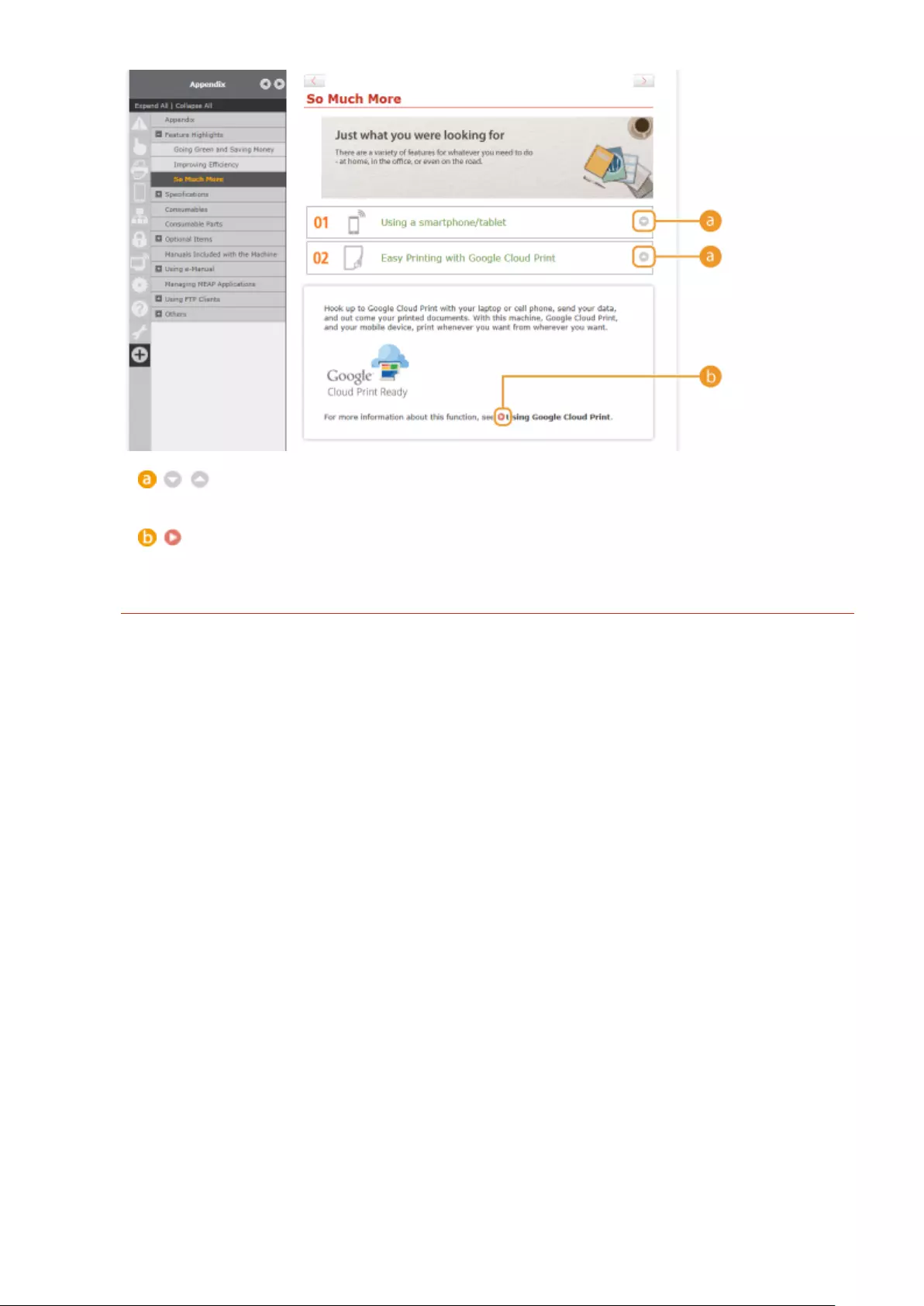
/
Click to display the detailed information. Click again to close the window.
Click to display the corresponding topic page.
Topic Page
Contains information about how to congure and use the machine.
Appendix
594
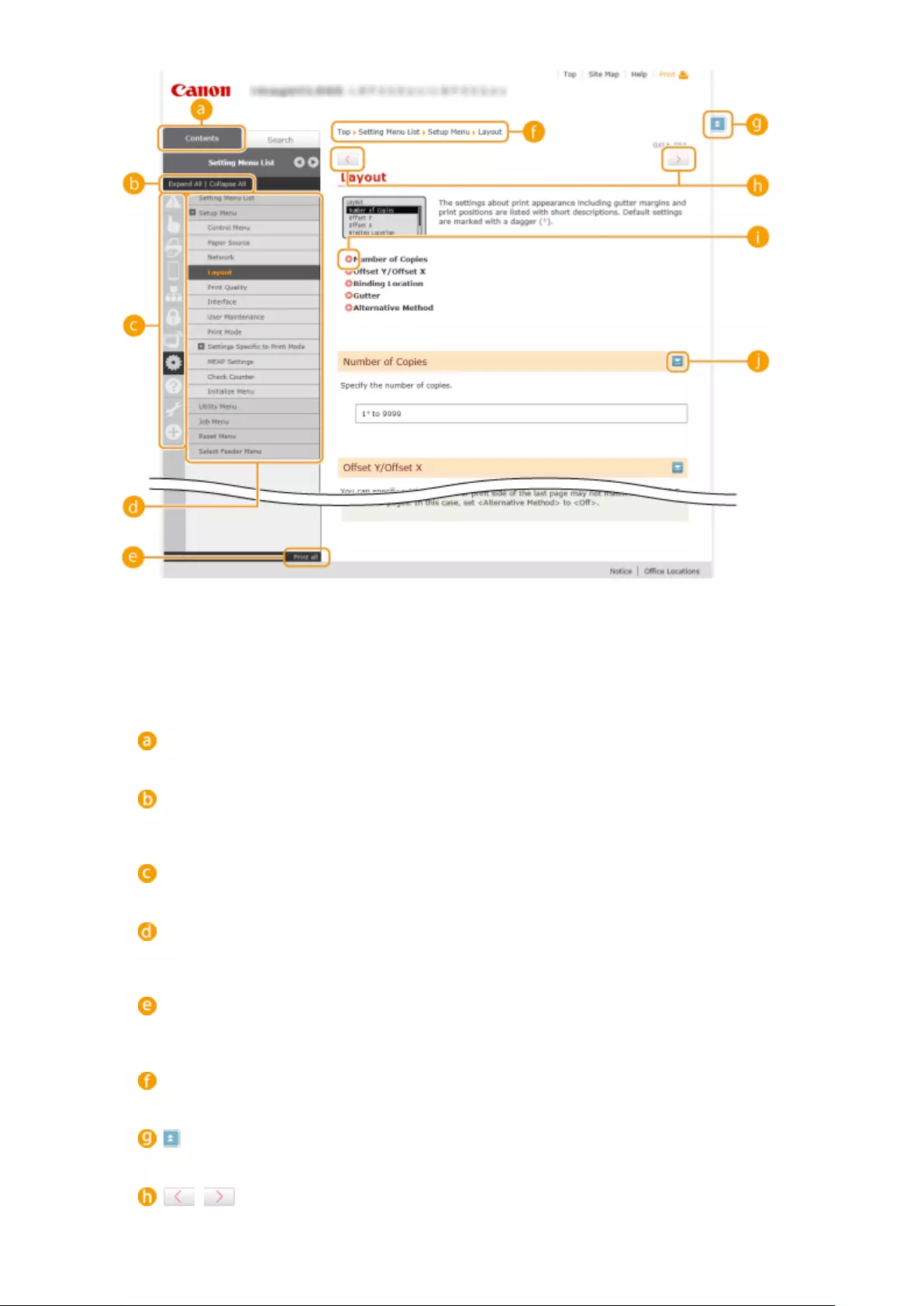
[Contents]
The chapter icons and titles are displayed.
[Expand all]/[Collapse all]
Click [Expand all] to display all of the subsections of all topics. Click [Collapse all] to close all of the
subsections of all the topics.
Chapter icons
Click a chapter icon to navigate to the top of the corresponding chapter.
Topic page
Displays the topics of the selected chapter. If "+" is displayed on the topic, clicking it displays the
subsections of that topic. Click "-" to close the expanded topic.
[Print all]
All pages of the selected chapter are opened in a separate window. The chapter can be printed if
necessary.
Navigation
See what chapter topic you are currently viewing.
Click to return to the page top.
/
Click to display the previous or following topic.
Appendix
595

Click to jump to the corresponding page. To return to the previous page, click "Back" on your Web
browser.
Click to display the hidden detailed descriptions. Click again to close the detailed descriptions.
Search Tab
Contains a text box to perform a search and nd the page you are looking for.
[Enter keyword(s) here]
Enter a keyword or keywords and click to display the search results in the search result list ( ). You
can search for pages containing all the keywords by separating the keywords by a space (blank). Also you
can only search for pages containing an exact phrase by enclosing the keywords in double quotation
marks.
[Search options]
Click to specify search conditions such as scope of search and fuzzy match conditions. To display the
conditions, click this button when it is gray. To close the display, click the button when it is orange.
Search scope selector
Species the search scope. You can eciently search for topics by narrowing the search scope. The search
scope selector is especially useful when you can predict the general location of the topic that you are
looking for.
Search options selector
Select the check box to make your search case-sensitive.
[Search with these conditions]
Click to display the search results with the conditions specied with and .
Search result list
Displays the search results of the pages that contain the specied keywords. From the results, locate the
page you are looking for and click the topic title of the page. If the results cannot be displayed on one
page, click / or a page number to display the results on the corresponding page.
Appendix
596

Site Map
Displays the table of contents for the e-Manual.
Chapter icons
Click to jump to the topic of the selected chapter.
Title (Topic)
Displays titles and topics. Click a title or topic to jump to the page.
Click to return to the page top.
/
Click to go to the previous or next chapter.
Appendix
597

Viewing e-Manual
0X7U-086
Marks
Cautions regarding safety, restrictions and cautions regarding the handling of the machine, useful tips, and
other information are indicated using the marks below.
Indicates a warning concerning operations that may lead to death or injury to
persons if not performed correctly. To use the machine safely, always pay
attention to these warnings.
Indicates a caution concerning operations that may lead to injury to persons if not
performed correctly. To use the machine safely, always pay attention to these
cautions.
Indicates an operation that must not be performed. Read these items carefully,
and make sure not to perform the described operations.
Indicates operational requirements and restrictions. Be sure to read these items
carefully to operate the machine correctly, and avoid damage to the machine or
property.
Indicates a clarication of an operation, or contains additional explanations for a
procedure.
Indicates useful functions or tips for using the machine.
Keys and Buttons Used in this Manual
Keys on the operation panel and buttons on the computer display appear in the following notation:
Type Example
Keys on the operation panel ( )
Settings displayed on the operation panel <Timer Settings>
<Paper is jammed.>
Buttons and other text interfaces displayed on the computer display [Preferences]
/ Used in This Manual
The / keys are used to select a desired setting. They are only described at the rst applicable occurrence
of their use in a page and omitted from the second time onward. For example, the / keys appear in Step
2, but are omitted in Step 3.
Example:
1Press ( ).
2Use / to select <Network>, and press .
3Select <TCP/IP Settings> <IPv4 Settings> <IP Address Settings>.
Appendix
598

Screens Used in This Manual
Unless otherwise noted, displays used in the e-Manual are those for the LBP352x. Depending on the operating
system you are using, the appearance of the displays used in this manual may slightly differ from the actual
displays. Also, the appearance of the printer driver and software may differ depending on their version.
Illustrations Used in This Manual
The illustrations of the toner cartridge used in the e-Manual are those for the Canon Cartridge 039.
Appendix
599

Manual Display Settings
0X7U-08W
Appendix
600
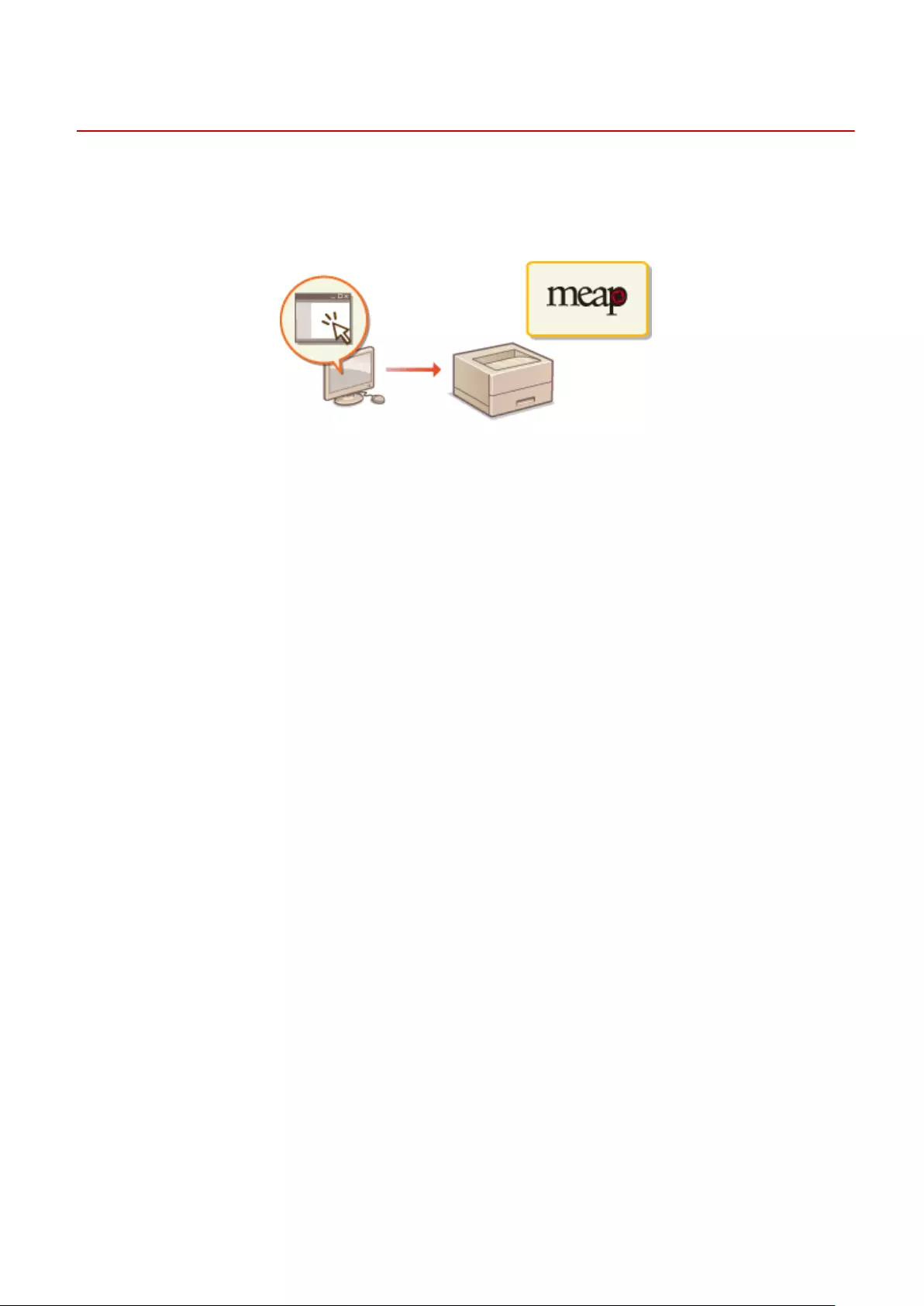
Managing MEAP Applications
0X7U-087
You can install MEAP applications (function-enhancing software) on the machine to add various features. You can
customize the functions according to your needs, for example, to congure an authentication system with IC cards or
to manage printouts based on logs. When you want to manage MEAP applications, access the machine from your
computer via a Web browser. For more information, see Function Guide for MEAP Application Management .
Appendix
601
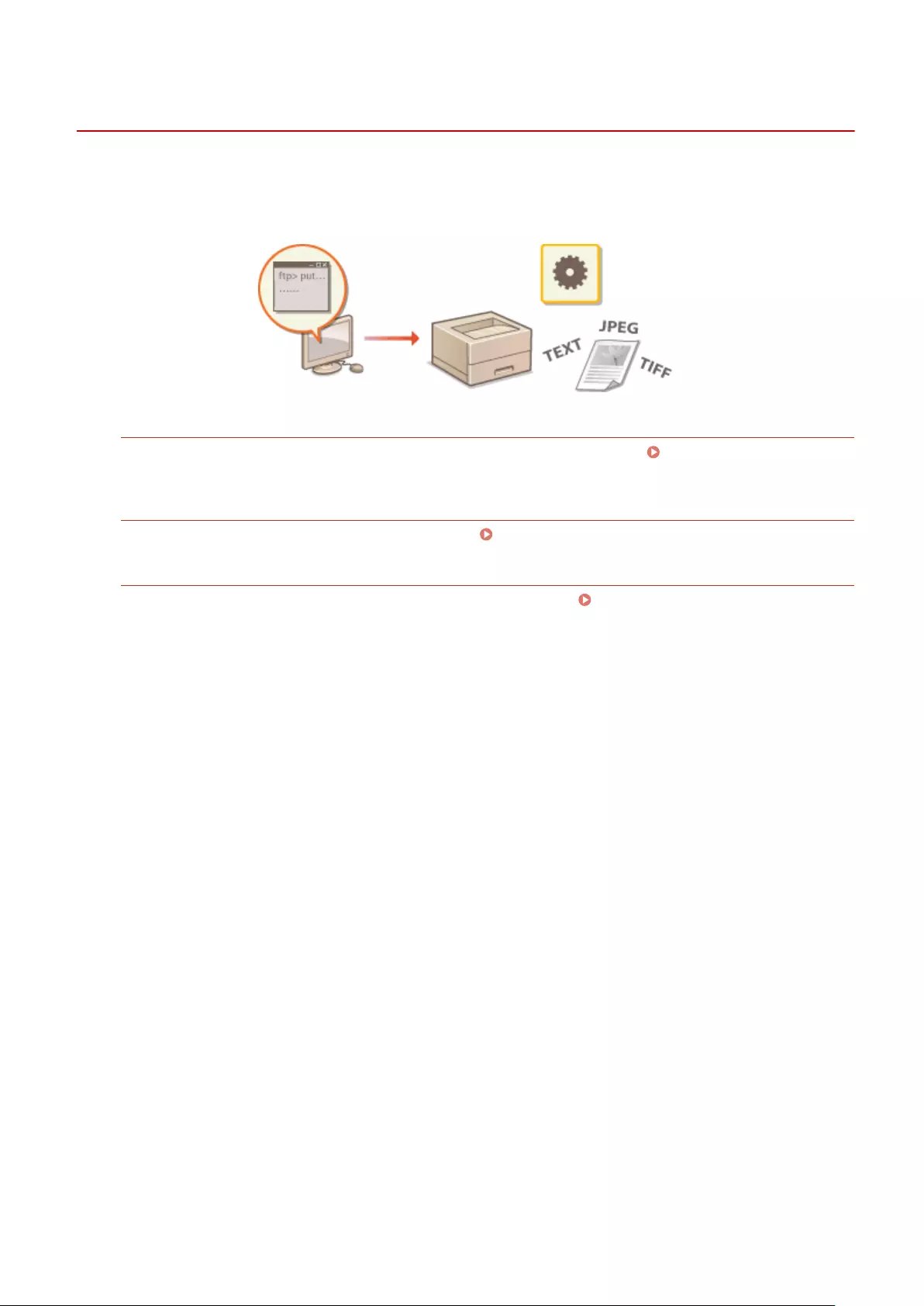
Using FTP Clients
0X7U-088
You can use an FTP client to access the FTP server of the machine and specify settings for document printing and
networking. Printing and settings can be performed with Command Prompt installed in the operating system as
standard, requiring neither specic drivers nor specic applications.
Preparing for Using the FTP Server
Specify settings to enable communication between the machine and the clients. Preparing for Using the FTP
Server(P. 603)
Printing via FTP Client (FTP Print)
You can print a document sent to the machine via FTP. Printing via FTP Client (FTP Print)(P. 606)
Specifying Settings via FTP Client
You can download the machine settings in text format and edit them. Specifying Settings via FTP
Client(P. 608)
Appendix
602
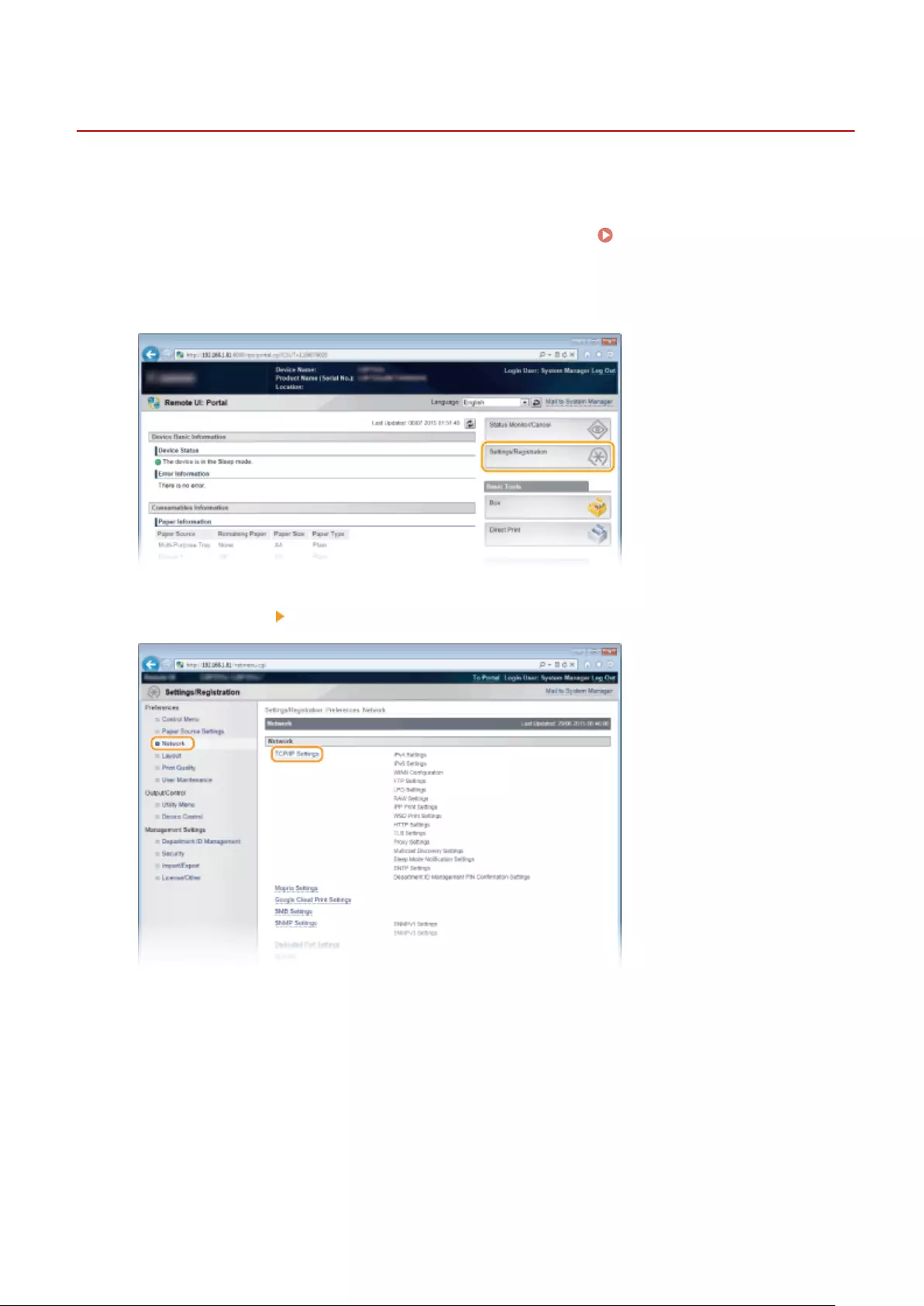
Preparing for Using the FTP Server
0X7U-089
Because the factory default settings prevent operations from FTP clients, specify settings to allow the operations.
1Start the Remote UI and log on in Management Mode. Starting Remote UI(P. 333)
2Click [Settings/Registration].
3Click [Network] [TCP/IP Settings].
4Click [Edit] in [FTP Settings].
Appendix
603
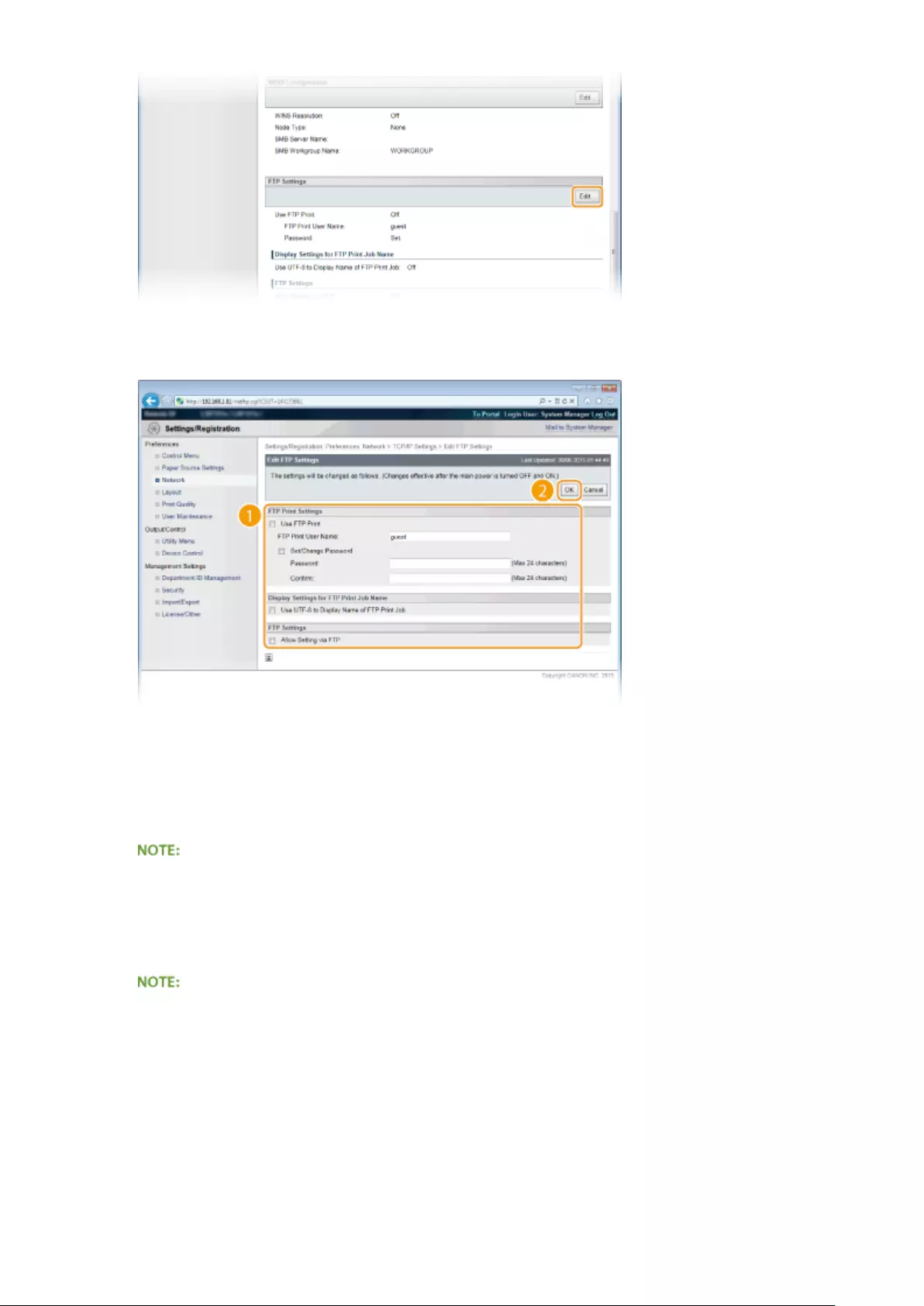
5Specify the required settings and click [OK].
[Use FTP Print]
To perform printing via FTP client, select the check box. Otherwise, clear the check box.
[FTP Print User Name]
Enter up to 24 alphanumeric characters for the user name used to log on to the FTP server when performing
FTP Print.
●You cannot set "root."
[Set/Change Password]
Select the check box to set the FTP Print password, and enter up to 24 alphanumeric characters for the
password in the [Password] text box. For conrmation, enter the same password in the [Conrm] text box.
●If you click [OK] with the check box selected and the [Password] and [Conrm] text boxes left blank, the
currently set password is deleted.
[Use UTF-8 to Display Name of FTP Print Job]
Select the check box if you are using UTF-8 character code for the name of the le to be printed.
[Allow Setting via FTP]
Select the check box to allow setting changes of the machine via FTP client. When not allowing setting
changes, clear the check box.
6Perform a hard reset.
Appendix
604
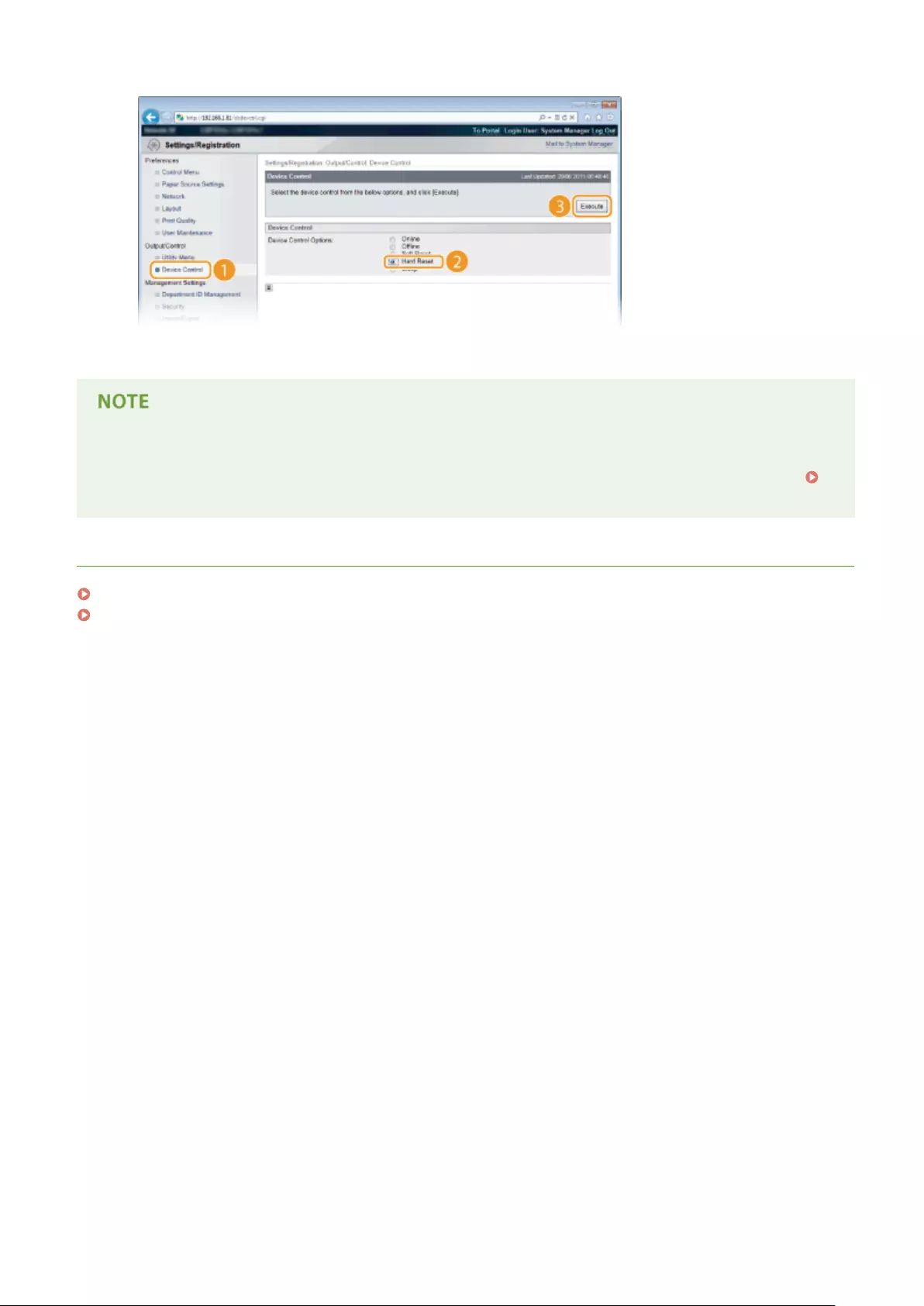
●Click [Device Control], select [Hard Reset], and then click [Execute].
➠The settings are enabled after the hard reset is performed.
Using the operation panel
●You can also enable or disable FTP print, and FTP settings from the setting menu of the operation panel.
FTP(P. 379)
LINKS
Printing via FTP Client (FTP Print)(P. 606)
Specifying Settings via FTP Client(P. 608)
Appendix
605
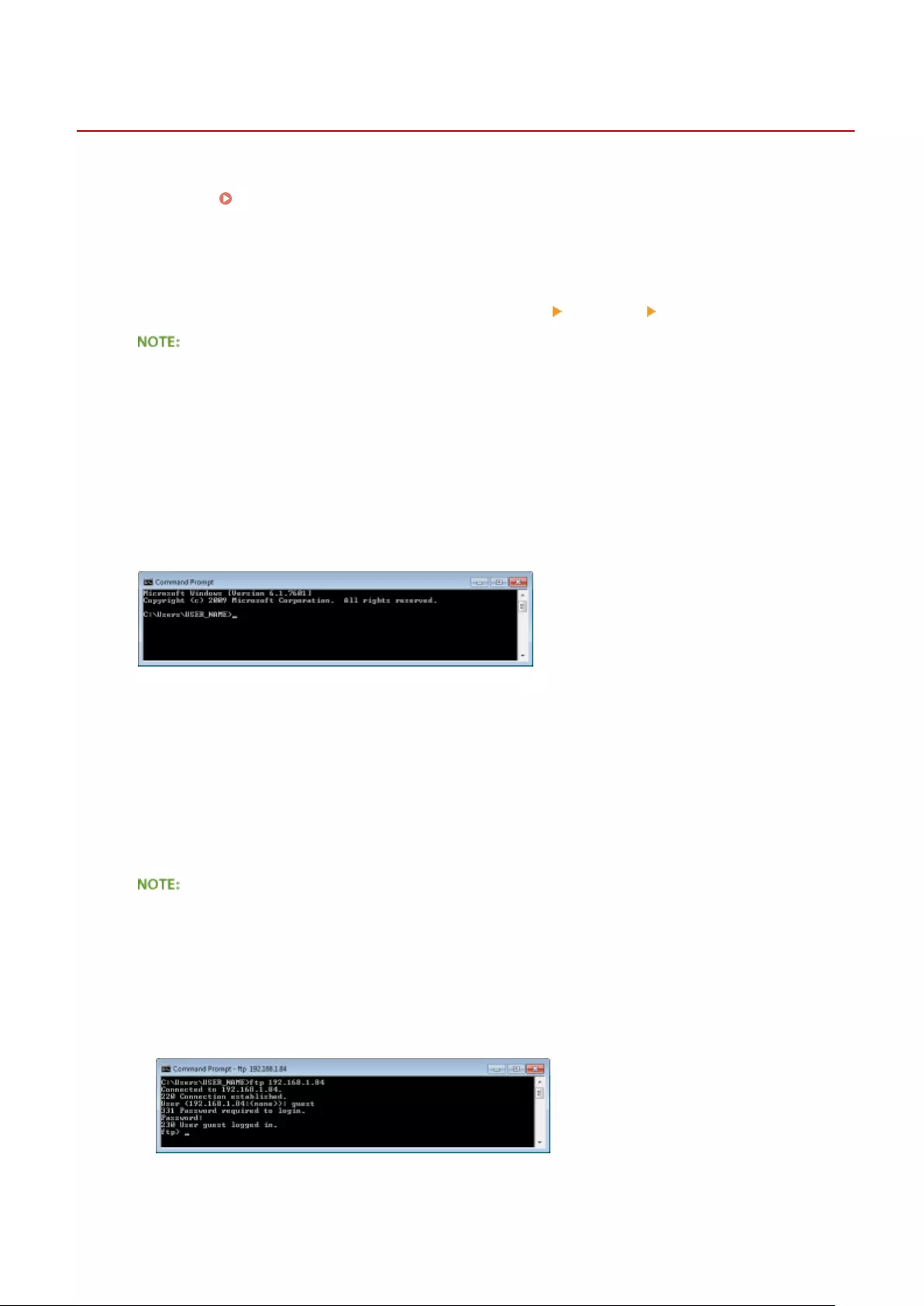
Printing via FTP Client (FTP Print)
0X7U-08A
Documents in TEXT/JPEG/TIFF format can be printed from FTP clients via network. Check the IP address set to the
machine in advance ( Network Status Print(P. 536) ). If you are unsure of the IP address, contact your network
administrator.
1Start [Command Prompt].
●Open the [Start] menu and select [All Programs] or [Programs] [Accessory] [Command Prompt].
For Mac OS users
●Start the Terminal.
For UNIX users
●Display the console screen.
2Copy a document that you want to print to the directory displayed in Command
Prompt.
●In an example of a screen, the document is copied into the "USER_NAME" folder in [Users] on drive C:.
3Enter "ftp <IP address of the machine>" and press the [ENTER] key.
●Example: ftp 192.168.1.45
4Enter the FTP Print user name and press the [ENTER] key.
●The default user name is "guest".
●Anonymous (a user with no account) cannot be used to log on.
5Enter the FTP Print password and press the [ENTER] key.
●The default password is "7654321".
➠"230 User <FTP Print user name> logged in." is displayed.
6Enter "bin" and press the [ENTER] key.
Appendix
606

➠The data transfer mode is changed to binary mode.
●You also need to specify binary mode when printing a text document.
7Enter "put <File name to print>" and press the [ENTER] key.
●Example: put sample.txt
➠The document is printed.
8Enter "quit" and press the [ENTER] key.
9Enter "exit" and press the [ENTER] key.
➠Command Prompt exits.
Appendix
607
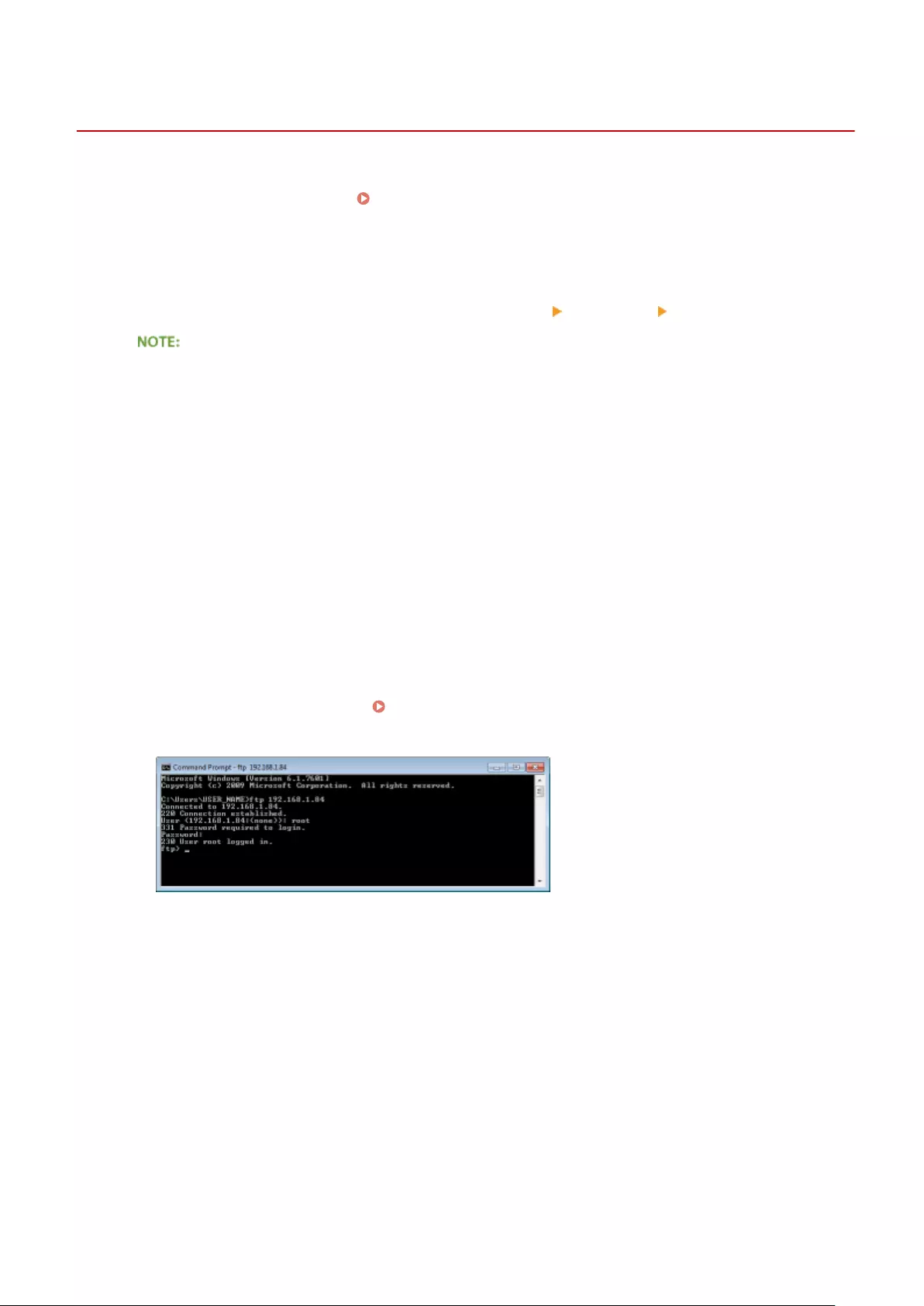
Specifying Settings via FTP Client
0X7U-08C
You can specify settings, such as the network settings of the machine, from an FTP client via TCP/IP network. Check the
IP address set to the machine in advance ( Network Status Print(P. 536) ). If you are unsure of the IP address,
contact your network administrator.
1Start [Command Prompt].
●Open the [Start] menu and select [All Programs] or [Programs] [Accessories] [Command Prompt].
For Mac OS users
●Start the Terminal.
For UNIX users
●Display the console screen.
2Enter "ftp <IP address of the machine>" and press the [ENTER] key.
●Example: ftp 192.168.1.45
3Enter "root" for the user name and press the [ENTER] key.
4Enter the System Manager password and press the [ENTER] key.
●The default password is "7654321". Setting the System Manager Password(P. 253)
➠"230 User root logged in." is displayed.
5Enter "cd cong" and press the [ENTER] key.
6Enter "get CONFIG <le name>" and press the [ENTER] key.
●"CONFIG" must be all uppercase.
●Any characters can be used in <le name> (example: get CONFIG Setting.txt).
➠The setting le is downloaded to the directory that is displayed when Command Prompt is started. In an
example of a screen, the le is downloaded to the "USER_NAME" folder in [Users] on drive C:.
Appendix
608
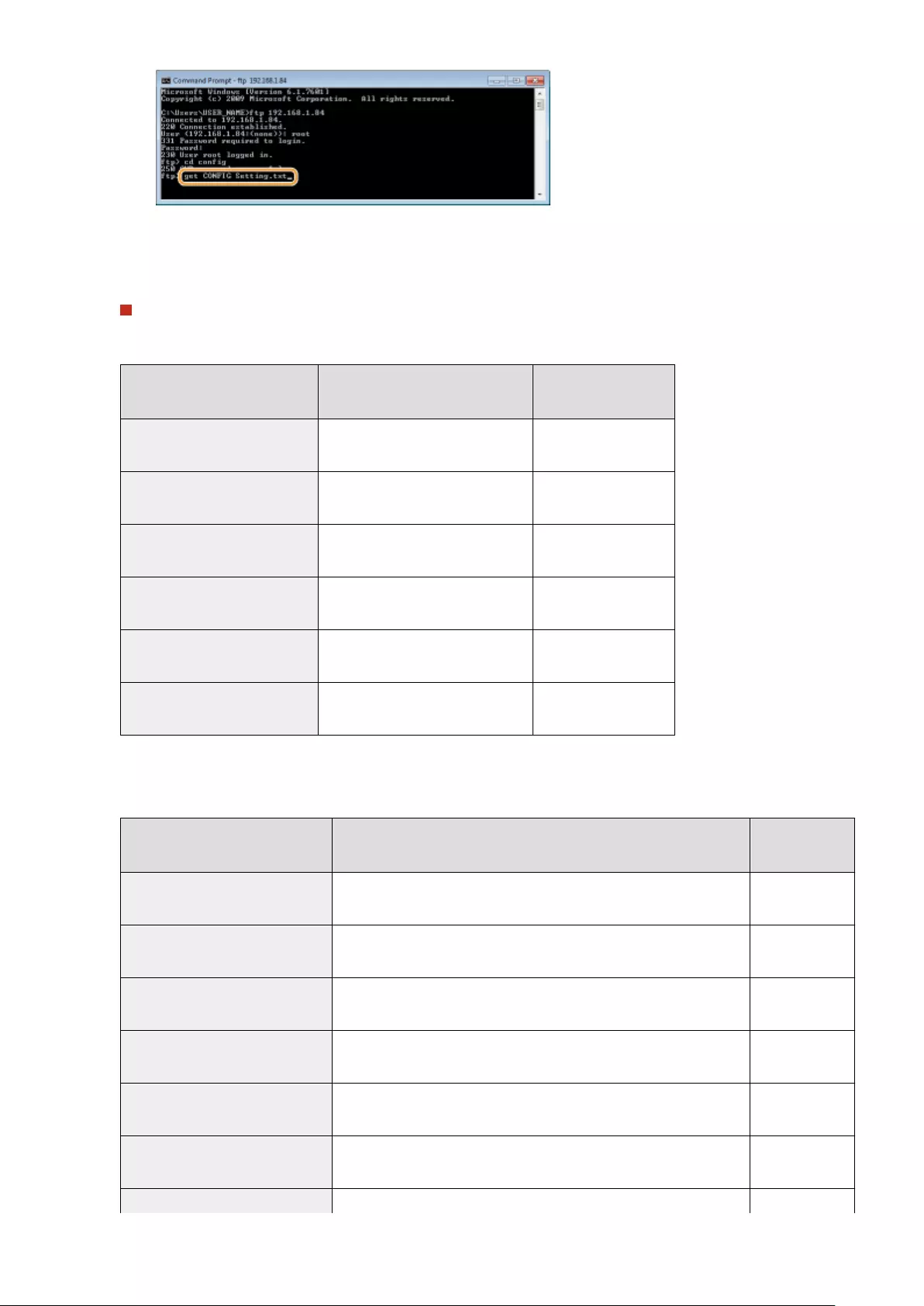
7Edit the downloaded cong le by using the text editor such as Notepad.
List of cong le setting items
General Menu (General Settings)
Item Name Setting Value Factory Default
Setting
DEVICE_NAME
(Device Name) Up to 128 characters LBP352x/LBP351x
SYS_LOC
(Location) Up to 128 characters (Blank)
SYS_CONTACT
(System Manager) Up to 32 characters (Blank)
ROOT_PWD
(System Manager Password) Up to 16 alphanumeric characters 7654321
USER_JOB_CONT
(Allow End-User's Job Operation) ON, OFF OFF
LINK_URL1
(Support Link URL) Up to 512 alphanumeric characters http://www.canon.com
TCP/IP Menu (TCP/IP Settings)
Item Name Setting Value Factory Default
Setting
INT_ADDR
(IP Address) IP Address 0.0.0.0
NET_MASK
(Subnet Mask) IP Address 0.0.0.0
DEF_GW
(Gateway Address) IP Address 0.0.0.0
DHCP_ENB
(Use DHCP) ON, OFF OFF
RARP_ENB
(Use RARP) ON, OFF OFF
BOOTP_ENB
(Use BOOTP) ON, OFF OFF
DNS_PADDR IP Address 0.0.0.0
Appendix
609
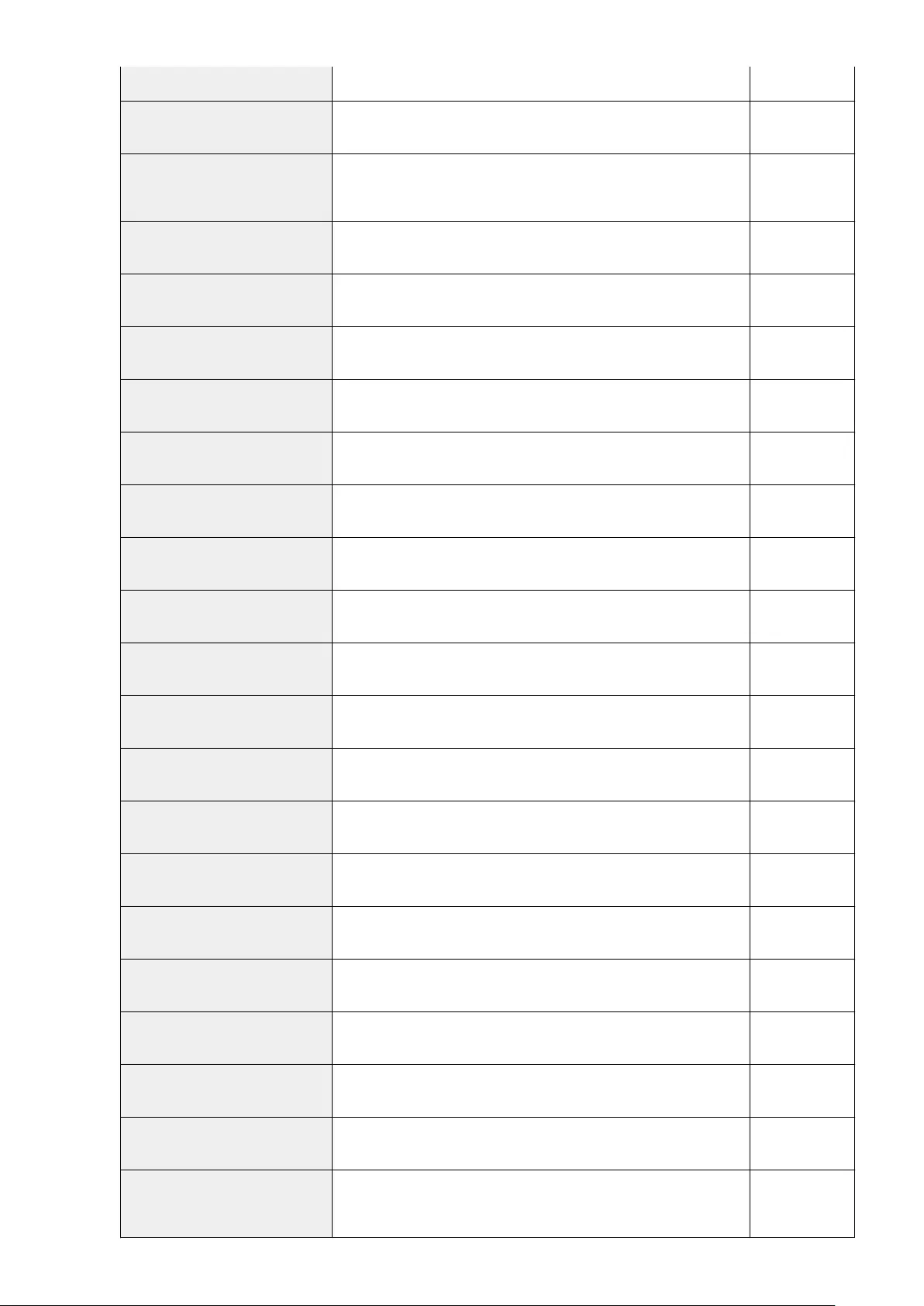
(Primary DNS Server Address)
DNS_SADDR
(Secondary DNS Server Address) IP Address 0.0.0.0
HOST_NAME
(Host Name) Up to 47 alphanumeric characters
"Canon"+
"Lower 6 digits
of MAC address"
DOMAIN_NAME
(Domain Name) Up to 47 alphanumeric characters (Blank)
DDNS_ENB
(DNS Dynamic Update) ON, OFF OFF
WINS_ENB
(WINS Resolution) ON, OFF OFF
WINS_SERVER
(WINS Server Address) IP Address 0.0.0.0
ARP_PING_ENB
(Use ARP/PING) ON, OFF ON
LPD_ENB
(Use LPD Printing) ON, OFF ON
LPD_BANN
(Print LPD Banner Page) ON, OFF OFF
RAW_ENB
(Use RAW Printing) ON, OFF ON
RAW_BIDIR_ENB
(Use Bidirectional Communication) ON, OFF OFF
FTP_PRINT_ENB
(Use FTP Print) ON, OFF OFF
FTP_PRINT_USER
(FTP Print User Name) Up to 24 alphanumeric characters guest
FTP_PRINT_PWD
(FTP Print Password) Up to 24 alphanumeric characters 7654321
IPP_ENB
(Use IPP) ON, OFF ON
IPP_AUTH_ENB
(Use IPP Authentication) ON, OFF OFF
IPP_AUTH_ACCUNT1
(IPP Authentication User Name)
Up to 24 alphanumeric characters (mandatory when using IPP
authentication) guest
IPP_AUTH_PASSWD1
(IPP Authentication Password)
Up to 24 alphanumeric characters (mandatory when using IPP
authentication) 7654321
WSD_ENB
(Use WSD Printing) ON, OFF OFF
WSD_BROWSING
(Use WSD Browsing) ON, OFF OFF
WSD_MULTICAST_
DISCOVERY
(Use Multicast Discovery)
ON, OFF OFF
Appendix
610
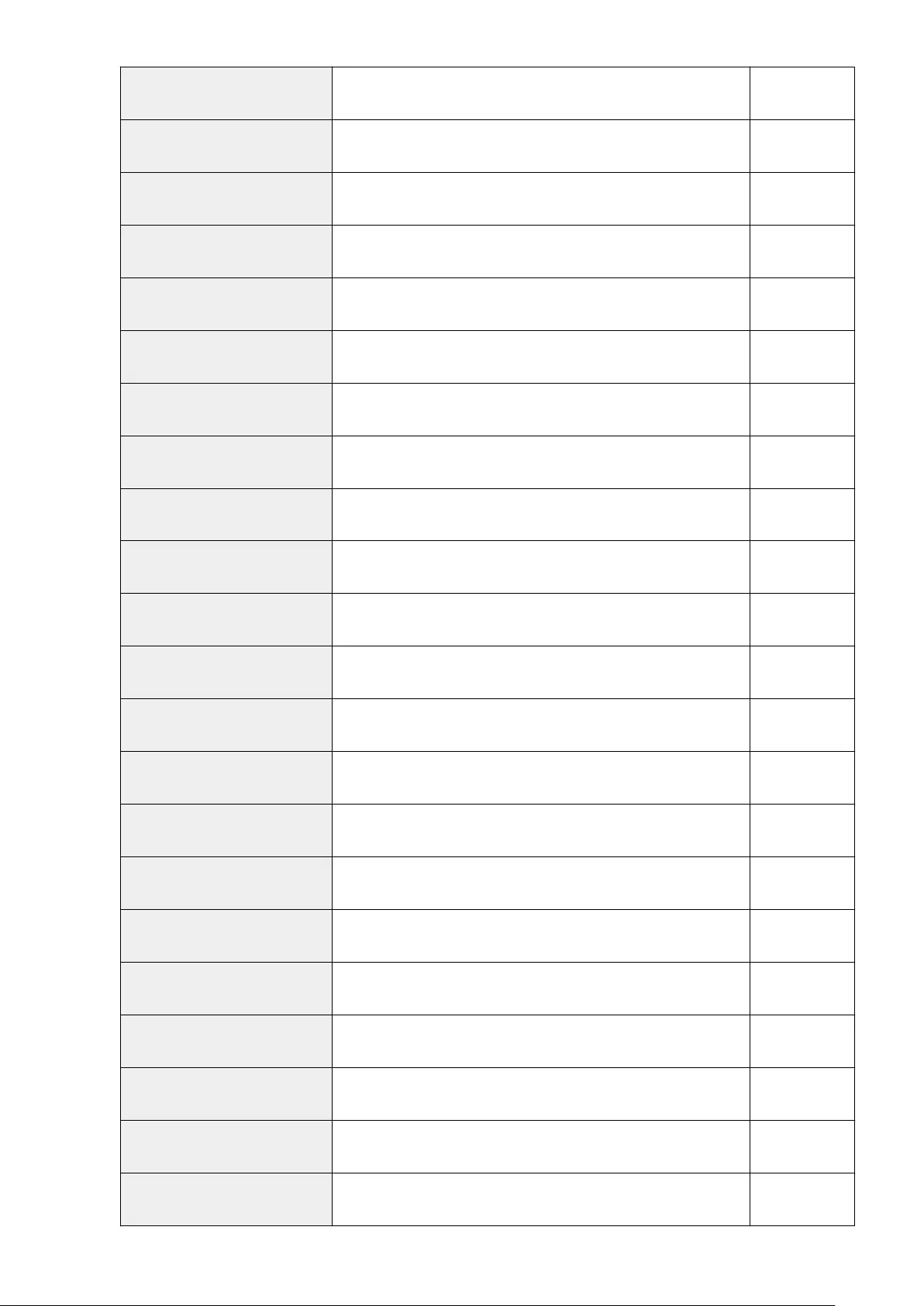
HTTP_ENB
(Use HTTP) ON, OFF ON
SNTP_ENB
(Use SNTP) ON, OFF OFF
SNTP_ADDR
(NTP Server Name) IP address or host name (Blank)
SNTP_INTERVAL
(Polling Interval) 1 to 48 (hr.) 24
DISCOVERY_ENB
(Respond to Discovery) ON, OFF ON
DISCOVERY_SCOPE_NAME
(Scope Name) Up to 32 alphanumeric characters default
EMAIL_PRINT_ENB
(POP3 RX) ON, OFF OFF
EMAIL_POP_ADDR
(POP3 Server Name) Up to 48 alphanumeric characters (Blank)
EMAIL_POP_ACCOUNT
(POP3 User Name) Up to 32 alphanumeric characters (Blank)
EMAIL_POP_PASSWD
(POP3 Password) Up to 32 alphanumeric characters (Blank)
EMAIL_POP_INTERVAL
(POP3 RX Interval) 0 to 90 (min.) 0
EMAIL_POP_PORTNO
(POP3 Server Port Number) 0 to 65535 110
IPV4_USE
(Use IPv4) ON, OFF ON
IPV6_USE
(Use IPv6) ON, OFF OFF
IPV6_STATELESS_USE
(Use Stateless Address) ON, OFF ON
IPV6_MANUAL_ADDR_USE
(Use Manual Address) ON, OFF OFF
IPV6_MANUAL_ADDR_SET
(IP Address) IP Address (Blank)
IPV6_MANUAL_ADDR_PREFIX
(Prex Length) 0 to 128 64
IPV6_MANUAL_ROUTER_ADDR
(Default Router Address) IP Address (Blank)
IPV6_DHCPV6_USE
(Use DHCPv6) ON, OFF OFF
IPV6_DNS_ADDRESS_PRI
(Primary DNS Server Address) IP Address (Blank)
IPV6_DNS_ADDRESS_SEC
(Secondary DNS Server Address) IP Address (Blank)
Appendix
611
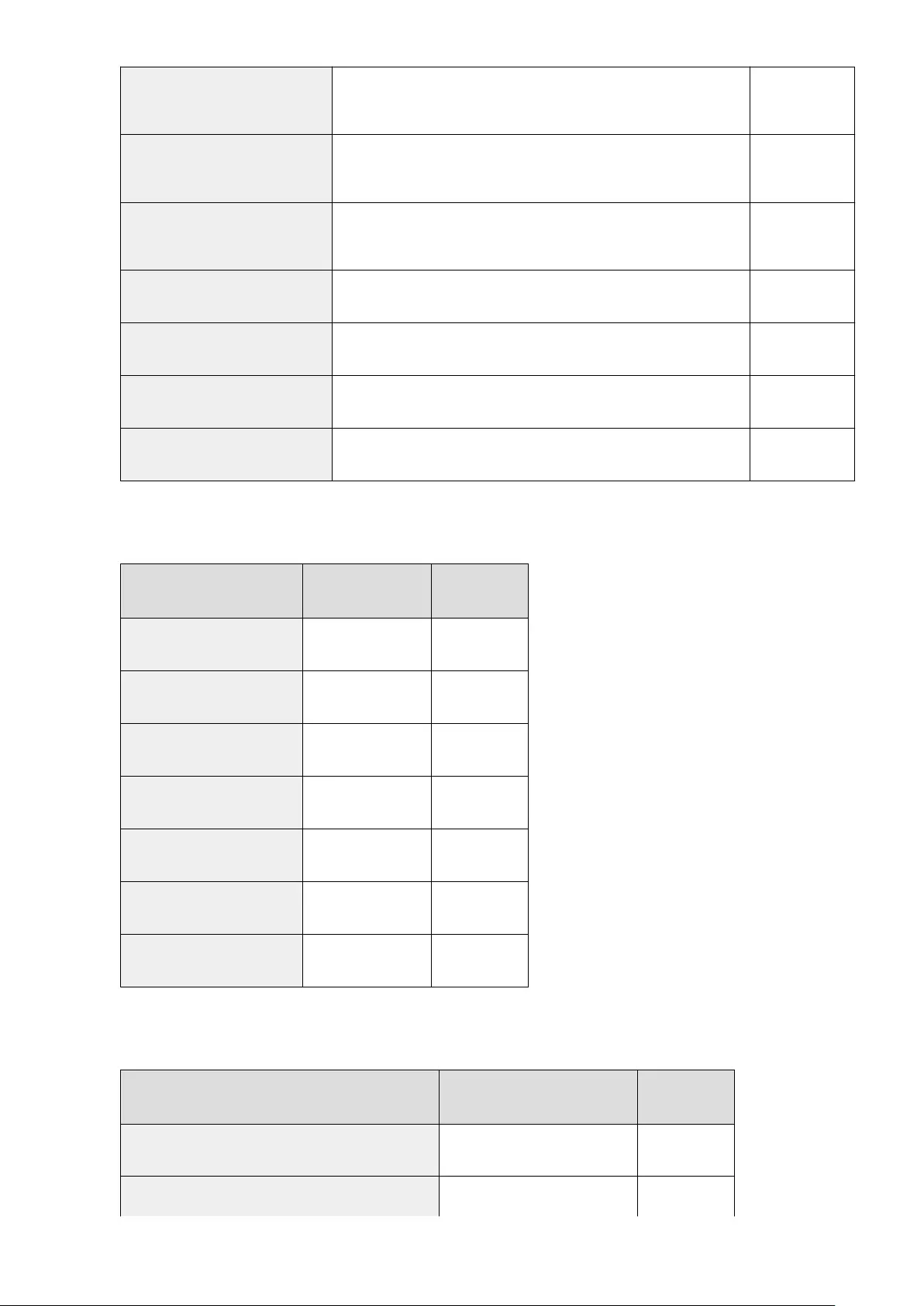
IPV6_DNS_NAME_
SAME_AS_IPV4
(Use IPv4 Host/Domain Names)
ON, OFF OFF
IPV6_DNS_HOST_NAME_V6
(Host Name) Up to 47 alphanumeric characters
"Canon"+
"Lower 6 digits
of MAC address"
IPV6_DNS_DOMAIN_
NAME_V6
(Domain Name)
Up to 47 alphanumeric characters (Blank)
IPV6_DNS_DYNAMIC_SET
(DNS Dynamic Update) ON, OFF OFF
IPV6_DNS_STATELESS
(Register Stateless Address) ON, OFF OFF
IPV6_DNS_MANUAL
(Register Manual Address) ON, OFF OFF
IPV6_DNS_STATEFUL
(Register Stateful Address) ON, OFF OFF
SMB Server Menu (SMB Settings)
Item Name Setting Value Factory Default
Setting
SMB_ENB
(Use SMB) ON, OFF OFF
SMB_SERVER
(Server Name) Up to 16 characters (Blank)
SMB_WG
(Workgroup Name) Up to 16 characters WORKGROUP
SMB_COMMENT
(Comments) Up to 192 characters (Blank)
SMB_LM_ENB
(Use LM Announce) ON, OFF OFF
SMB_PRINT_ENB
(Use SMB Printing) ON, OFF OFF
SMB_PRINTER
(Printer Name) Up to 13 characters PRINTER
SNMP Menu (SNMP Settings)
Item Name Setting Value Factory Default
Setting
SNMP_V1_ENB
(Use SNMPv1) ON, OFF ON
SNMP_COMMUNITY1_
ENB ON, OFF ON
Appendix
612
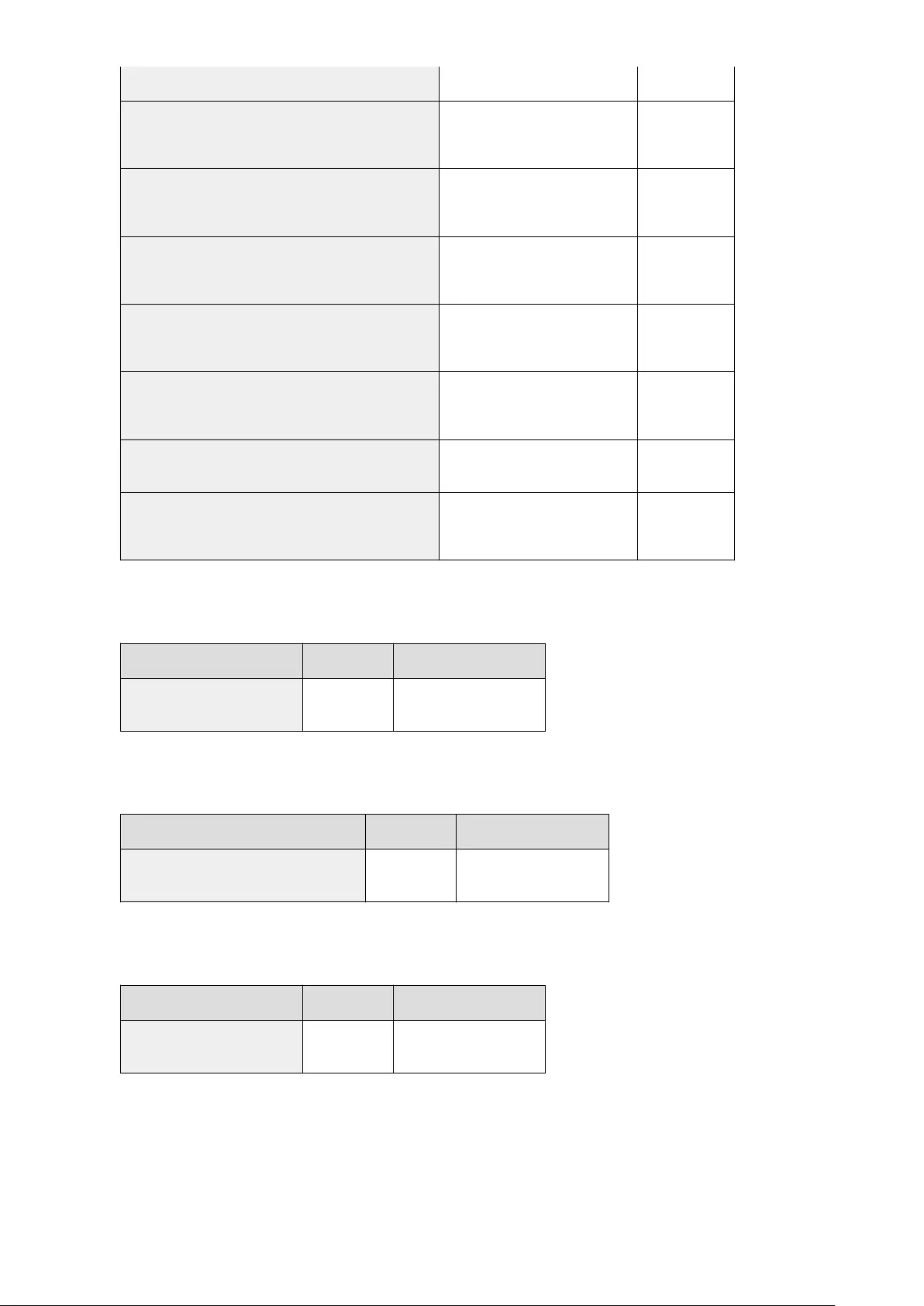
(Use Community Name 1)
SNMP_COMMUNITY1_
ACCESS
(MIB Access Permission)
RW (Read/Write), RO (Read Only) RO
SNMP_COMMUNITY1_
NAME
(Community Name 1)
Up to 32 alphanumeric
characters public
SNMP_COMMUNITY2_
ENB
(Use Community Name 2)
ON, OFF OFF
SNMP_COMMUNITY2_
ACCESS
(MIB Access Permission)
RW (Read/Write), RO (Read Only) RO
SNMP_COMMUNITY2_
NAME
(Community Name 2)
Up to 32 alphanumeric
characters public2
SNMP_V3_ENB
(Use SNMPv3) ON, OFF OFF
SNMP_GET_PRT_MNG_
INFO
(Obtain Printer Management Information from Host)
ON, OFF OFF
SPOOLER Menu (Spool Settings)
Item Name Setting Value Factory Default Setting
SPOOL_ENB
(Use Spooler) ON, OFF OFF
START TIMER Menu (Waiting Time for Connection at Startup)
Item Name Setting Value Factory Default Setting
STRT_DELAY_TIME
(Waiting Time for Connection at Startup) 0 to 300 (sec.) 0
RUI Menu (Remote UI Settings)
Item Name Setting Value Factory Default Setting
RUI_ENB
(Use Remote UI) ON, OFF ON
8Enter "put <le name> CONFIG" and press the [ENTER] key.
●Specify the edited le name in <le name> (example: put Setting.txt CONFIG).
➠The setting le is uploaded.
Appendix
613

9Enter "get reset" and press the [ENTER] key.
➠The machine is restarted. The settings are enabled after the machine is restarted.
10 Conrm that the machine has been normally restarted, press [C] key while holding
down the [CTRL] key.
11 Enter "quit" and press the [ENTER] key.
12 Enter "exit" and press the [ENTER] key.
➠Command Prompt exits.
LINKS
Network(P. 375)
Appendix
614

Others
0X7U-08H
This section describes basic Windows operations and includes disclaimers, copyright information, and other
information.
Appendix
615
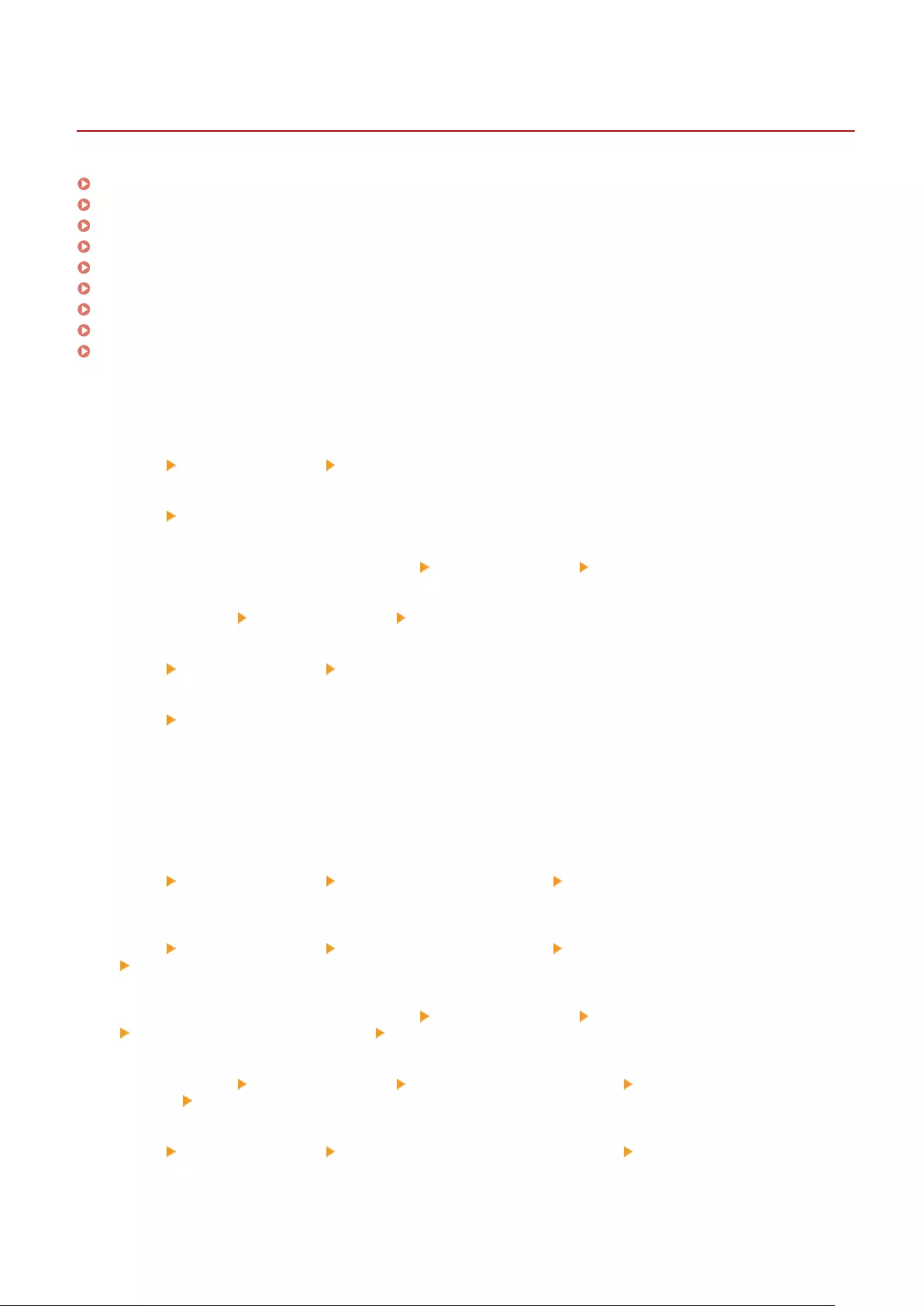
Basic Windows Operations
0X7U-08J
Displaying the Printer Folder(P. 616)
Enabling [Network discovery](P. 616)
Displaying Shared Printers in the Print Server(P. 617)
Displaying the Setup Screen of Instruction Manual DVD-ROM(P. 617)
Printing a Test Page in Windows(P. 618)
Checking the Bit Architecture(P. 619)
Checking the Printer Port(P. 619)
Checking Bidirectional Communication(P. 620)
Displaying [Local Area Connection Properties](P. 621)
◼Displaying the Printer Folder
Windows Vista
[Start] select [Control Panel] [Printer].
Windows 7/Server 2008 R2
[Start] select [Devices and Printers].
Windows 8/Server 2012
Right-click the lower-left corner of the screen select [Control Panel] [View devices and printers].
Windows 8.1/Server 2012 R2
Right-click [Start] select [Control Panel] [View devices and printers].
Windows Server 2008
[Start] select [Control Panel] double-click [Printers].
Windows Server 2003
[Start] select [Printers and Faxes].
◼Enabling [Network discovery]
If you are using Windows Vista/7/8/Server 2008/Server 2012, enable [Network discovery] to view the computers on
your network.
Windows Vista
[Start] select [Control Panel] [View network status and tasks] select [Turn on network discovery] under
[Network discovery].
Windows 7/Server 2008 R2
[Start] select [Control Panel] [View network status and tasks] [Change advanced sharing settings]
select [Turn on network discovery] under [Network discovery].
Windows 8/Server 2012
Right-click the lower-left corner of the screen select [Control Panel] [View network status and tasks]
[Change advanced sharing settings] select [Turn on network discovery] under [Network discovery].
Windows 8.1/Server 2012 R2
Right-click [Start] select [Control Panel] [View network status and tasks] [Change advanced sharing
settings] select [Turn on network discovery] under [Network discovery].
Windows Server 2008
[Start] select [Control Panel] double-click [Network and Sharing Center] select [Turn on network
discovery] under [Network discovery].
Appendix
616

◼Displaying Shared Printers in the Print Server
1Open Windows Explorer.
Windows Vista/7/Server 2003/Server 2008
[Start] select [All Programs] or [Programs] [Accessories] [Windows Explorer].
Windows 8/Server 2012
Right-click the lower-left corner of the screen select [File Explorer].
Windows 8.1/Server 2012 R2
Right-click [Start] select [File Explorer].
2Select [Network] or [My Network Places] in printer server.
●To view computers on the network, you may need to turn on network discovery or search the network for
computers.
➠Shared printers are displayed.
1
◼Displaying the Setup Screen of Instruction Manual DVD-ROM
If your computer does not display the setup screen after the Instruction Manual DVD-ROM is inserted, follow the
procedure below. The DVD-ROM drive name is indicated as "D:" in this manual. The DVD-ROM drive name may differ
depending on the computer you are using.
Windows Vista/7/Server 2008
[Start] enter "D:\Maninst.exe" in [Search programs and les] or [Start Search] press the [ENTER] key.
Windows 8/Server 2012
Right-click the lower-left corner of the screen [Run] Enter "D:\Maninst.exe" click [OK]
Windows 8.1/Server 2012 R2
Right-click [Start] [Run] Enter "D:\Maninst.exe" click [OK]
Appendix
617

Windows Server 2003
[Start] [Run] enter "D:\Maninst.exe" click [OK]
◼Printing a Test Page in Windows
You can check whether the printer driver is operational by printing a test page in Windows.
1Load A4 size paper in the paper drawer or multi-purpose tray. Loading Paper(P. 37)
2Open the printer folder. Displaying the Printer Folder(P. 616)
3Right-click your printer icon and click [Printer properties] or [Properties].
4Click [Print Test Page] in [General] tab.
➠The test page is printed.
Appendix
618

◼Checking the Bit Architecture
If you are not sure whether your computer is running 32-bit or 64-bit Windows, follow the procedure below.
1Display [Control Panel].
Windows Vista/7/Server 2008
[Start] select [Control Panel].
Windows 8/Server 2012
Right-click the lower-left corner of the screen select [Control Panel].
Windows 8.1/Server 2012 R2
Right-click [Start] select [Control Panel].
2Display [System].
Windows Vista/7/8/Server 2008 R2/Server 2012
Click [System and Maintenance] or [System and Security] [System].
Windows Server 2008
Double-click [System].
3Check the bit architecture.
For 32-bit versions
[32-bit Operating System] is displayed.
For 64-bit versions
[64-bit Operating System] is displayed.
◼Checking the Printer Port
1Open the printer folder. Displaying the Printer Folder(P. 616)
2Right-click your printer icon and click [Printer properties] or [Properties].
Appendix
619
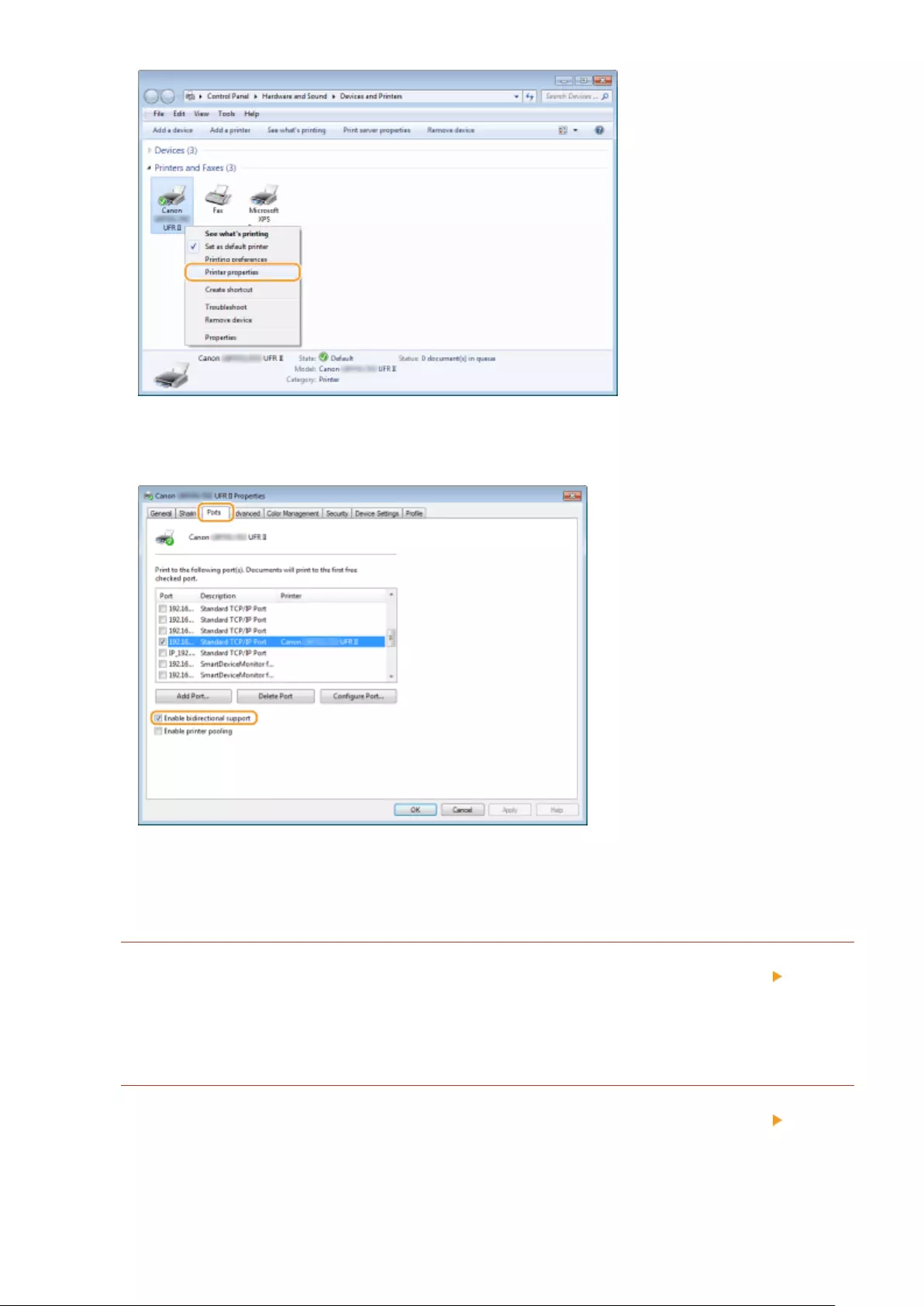
3In the [Ports] tab, make sure that the [Enable bidirectional support] check box is
selected.
◼Displaying [Local Area Connection Properties]
Windows Vista
1Open the [Start] menu, select [Control Panel], and click [View network status and tasks] [Manage
network connections].
2Right-click the [Local Area Connection] icon, and click [Properties] in the pop-up menu.
Windows 7/Server 2008 R2
1Open the [Start] menu, select [Control Panel], and click [View network status and tasks] [Change
adapter settings].
2Right-click the [Local Area Connection] icon, and click [Properties] in the pop-up menu.
Appendix
621

Windows 8/Server 2012
1Right-click the lower left corner of the screen Select [Control Panel], and click [View network
status and tasks] [Change adapter settings].
2Right-click the [Local Area Connection] icon, and click [Properties] in the pop-up menu.
Windows Server 2008
1Open the [Start] menu, select [Control Panel], double-click the [Network and Sharing Center] tab,
and then click [Manage network connections].
2Right-click the [Local Area Connection] icon, and click [Properties] in the pop-up menu.
Windows 8.1/Server 2012 R2
1Right-click the [Start] Select [Control Panel], and click [View network status and tasks] [Change
adapter settings].
2Right-click the [Local Area Connection] icon, and click [Properties] in the pop-up menu.
Windows Server 2003
1Open the [Start] menu, and click [Control Panel] [Network Connections] [Local Area
Connection].
2Click [Properties].
Appendix
622
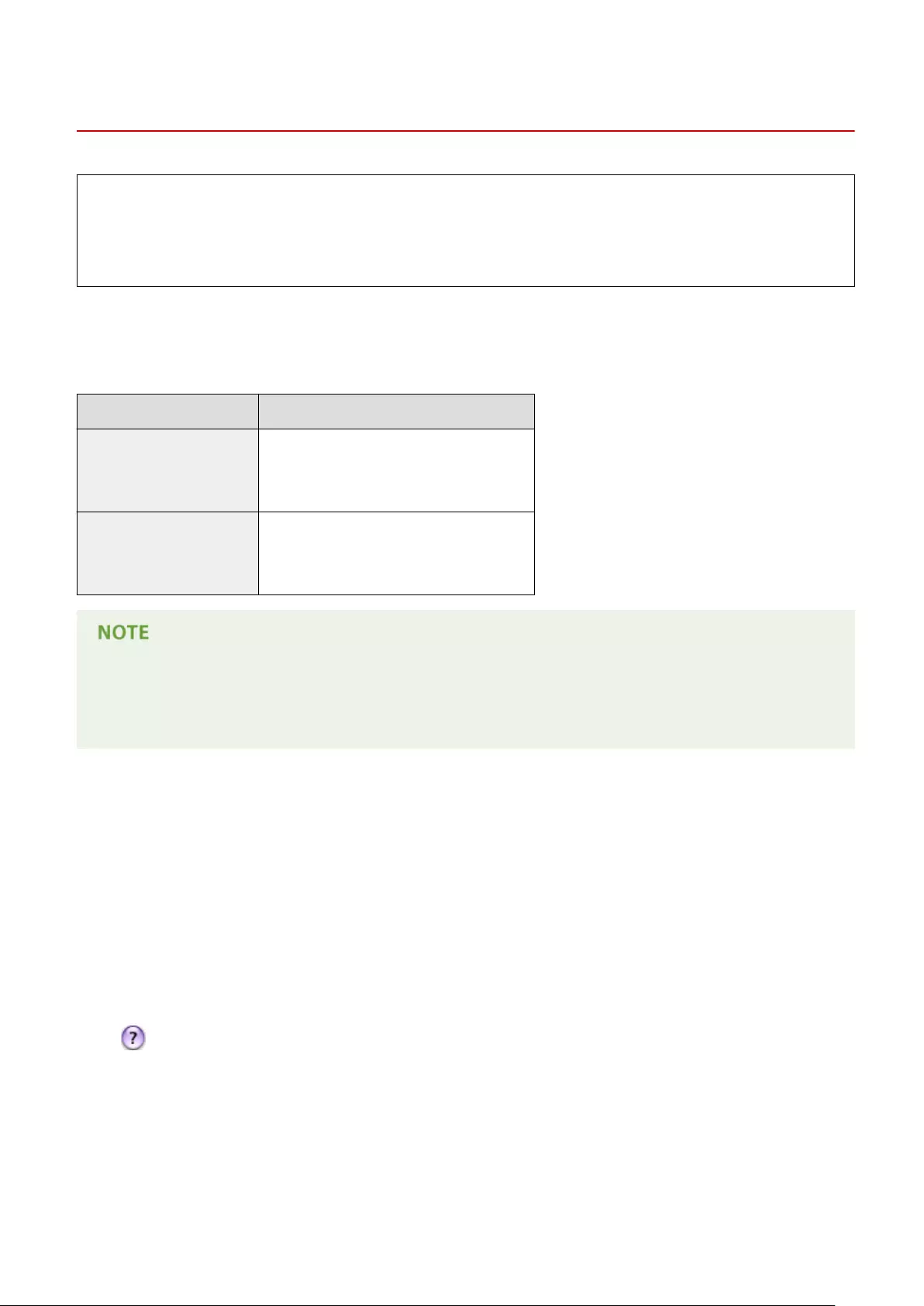
For Mac OS Users
0X7U-08K
Your machine may have not come with a printer driver for Mac OS depending on when you purchased the
machine. The printer drivers are uploaded to the Canon website when they become needed. Check the
operating system of your computer and download the appropriate printer driver from the Canon website. For
the printer driver installation procedure and how to operate the driver, see the "Canon UFR II/UFRII LT Printer
Driver Guide".
In the e-Manual and Printer Driver Installation Guide, methods to operate in the Windows environment are explained
as examples. To view how to use the printer drivers and utility for Mac OS, see the following guide or help.
Object Reference
Installing the Printer Driver ●Getting Started
●Canon UFR II/UFRII LT Printer Driver Guide
●Canon PS Printer Driver Guide
Using each feature ●Printer Driver's Help
●Canon UFR II/UFRII LT Printer Driver Guide
●Canon PS Printer Driver Guide
Using RAW as the printing protocol
●When adding a printer during printer driver installation, select [HP Jetdirect - Socket] (or [Socket/HP Jet
Direct]).
◼Displaying the Printer Driver Guide
Double-click the following HTML le in the [Documents] folder on the supplied DVD-ROM.
Canon UFR II/UFRII LT Printer Driver Guide / Canon PS Printer Driver Guide
[Documents]-[XXXXXX]*-[Guide]-[index.html]
* For [XXXXXX], select your desired language.
◼Displaying the Printer Driver's Help
Click [ ] on the printer driver.
Appendix
623

Font Samples
0X7U-08S
The fonts lists printed from the Utility menu are a comprehensive listing of all fonts currently available. The listing
contains the names and print samples of the fonts stored on the printer.
Scalable Fonts (PCL)(P. 625)
OCR Code Scalable Fonts (PCL) (P. 628)
Bitmapped Fonts (PCL)(P. 628)
Appendix
624

Scalable Fonts (PCL)
Appendix
625
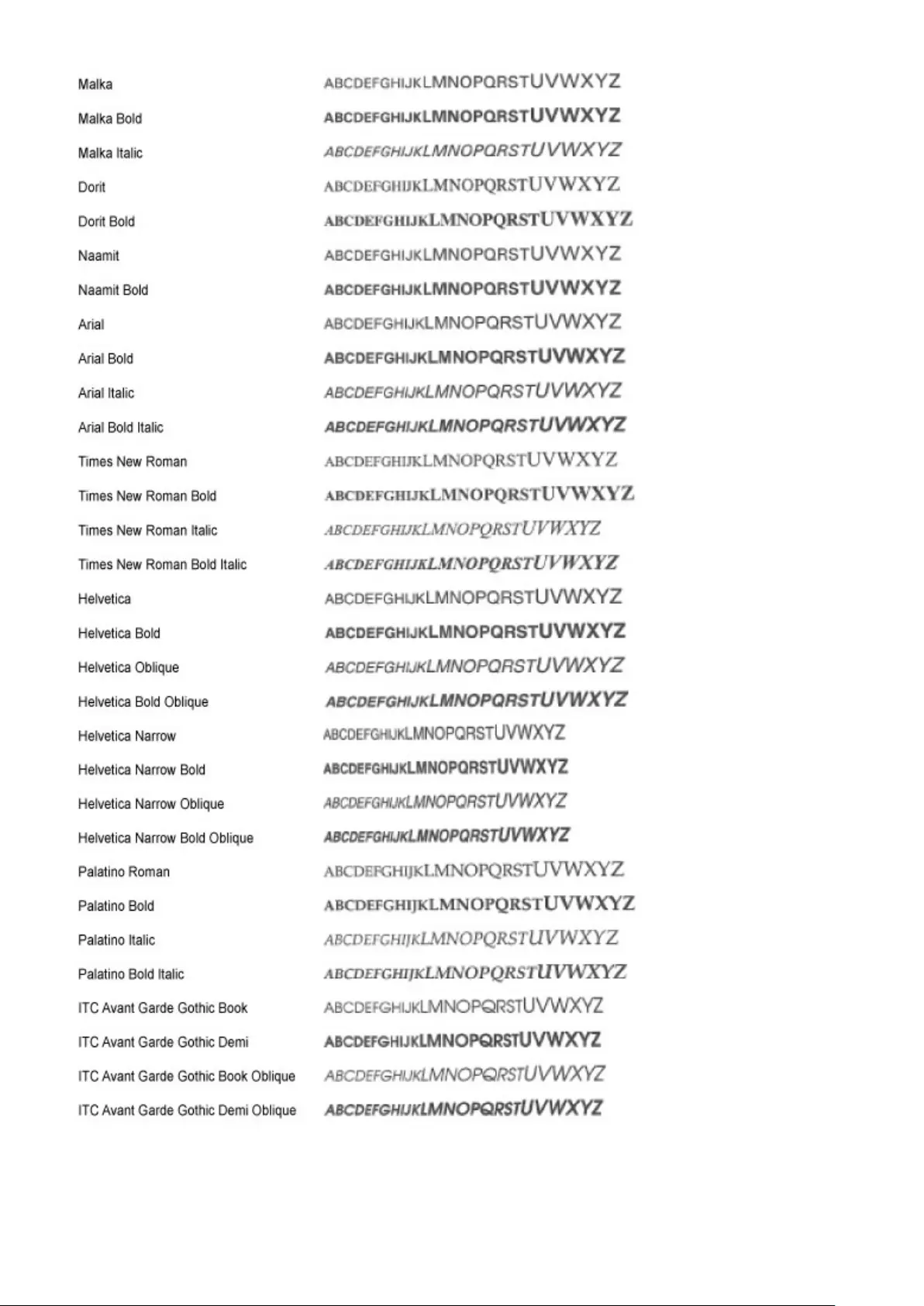
Appendix
626
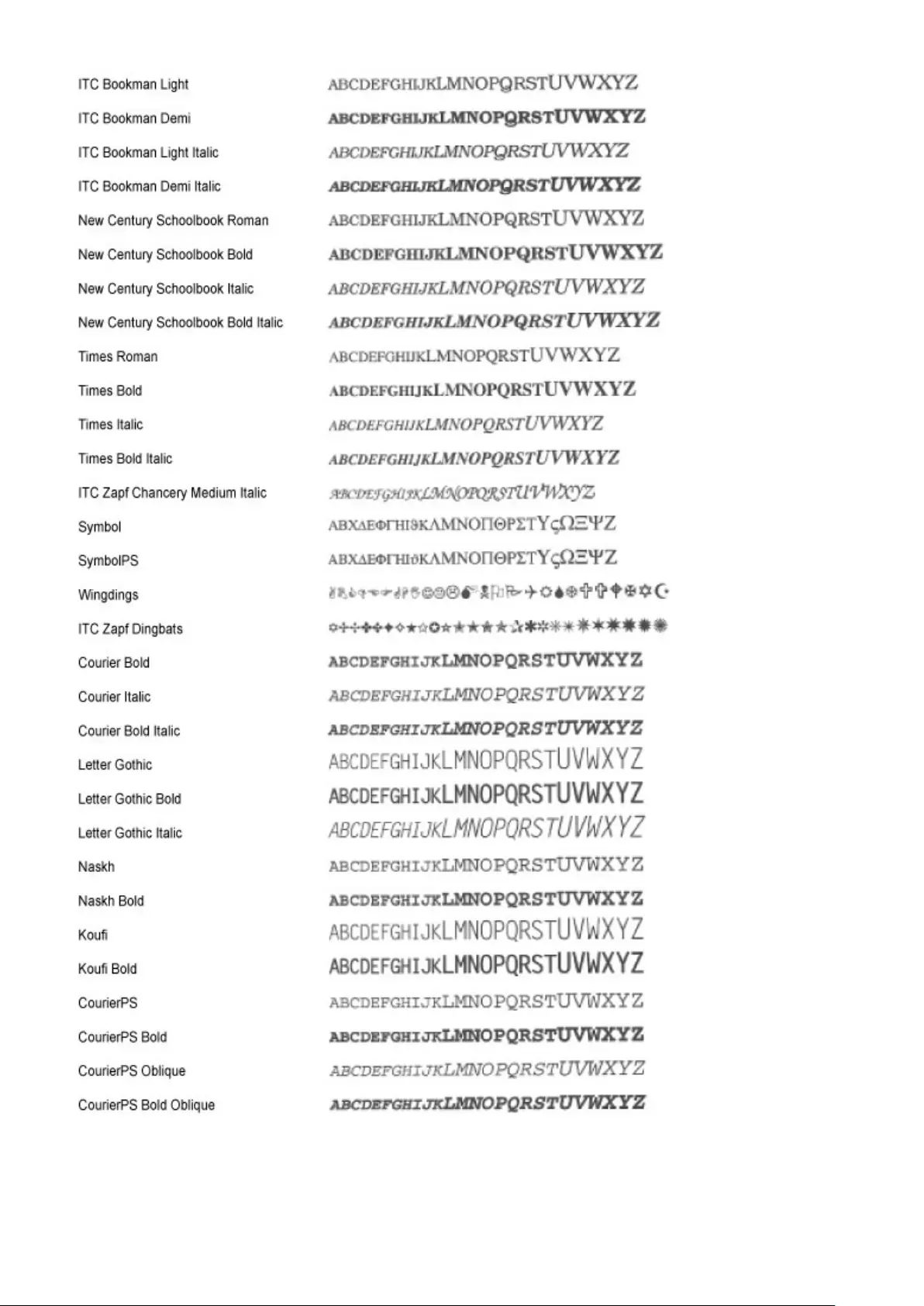
Appendix
627
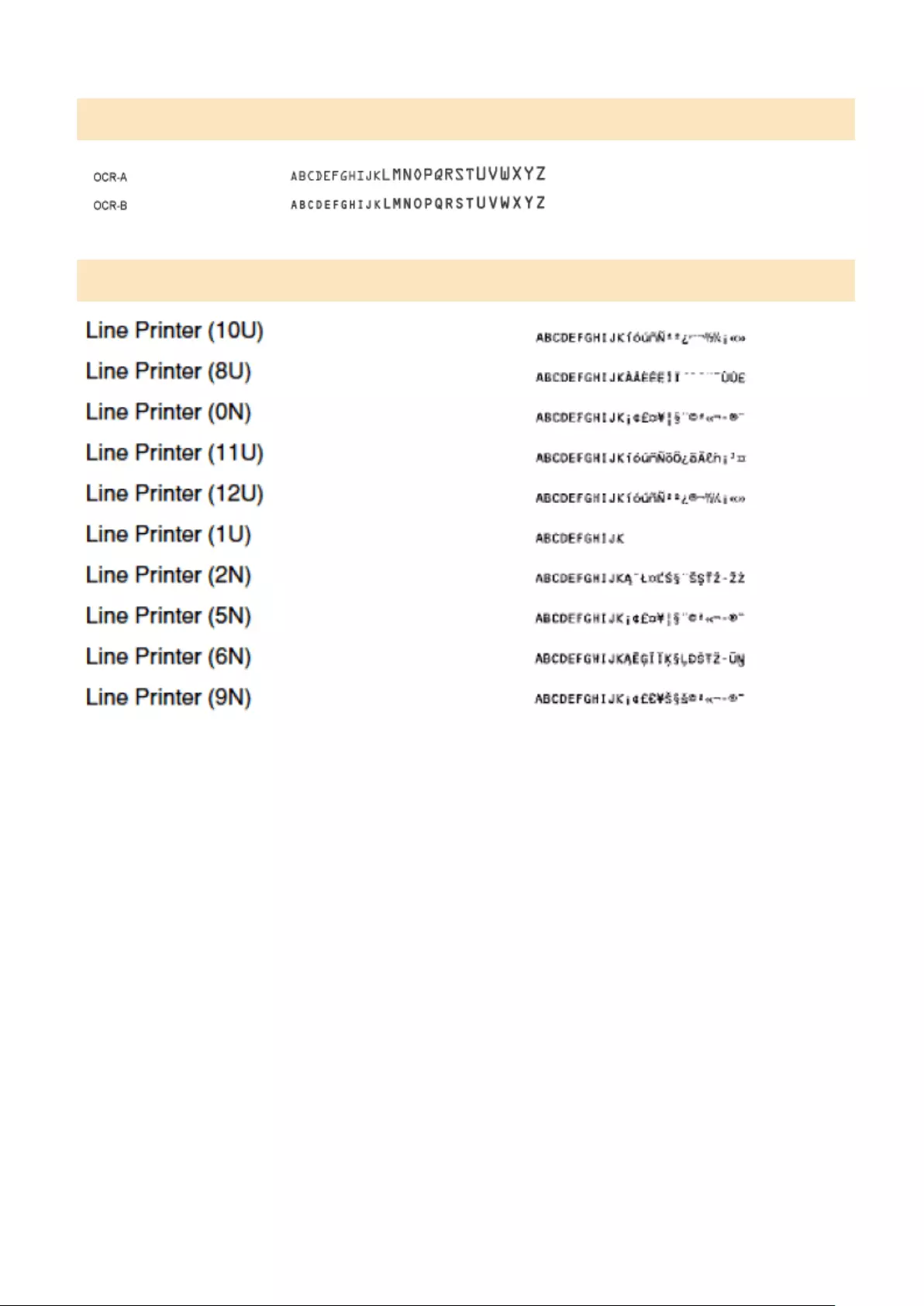
OCR Code Scalable Fonts (PCL)
Bitmapped Fonts (PCL)
Appendix
628
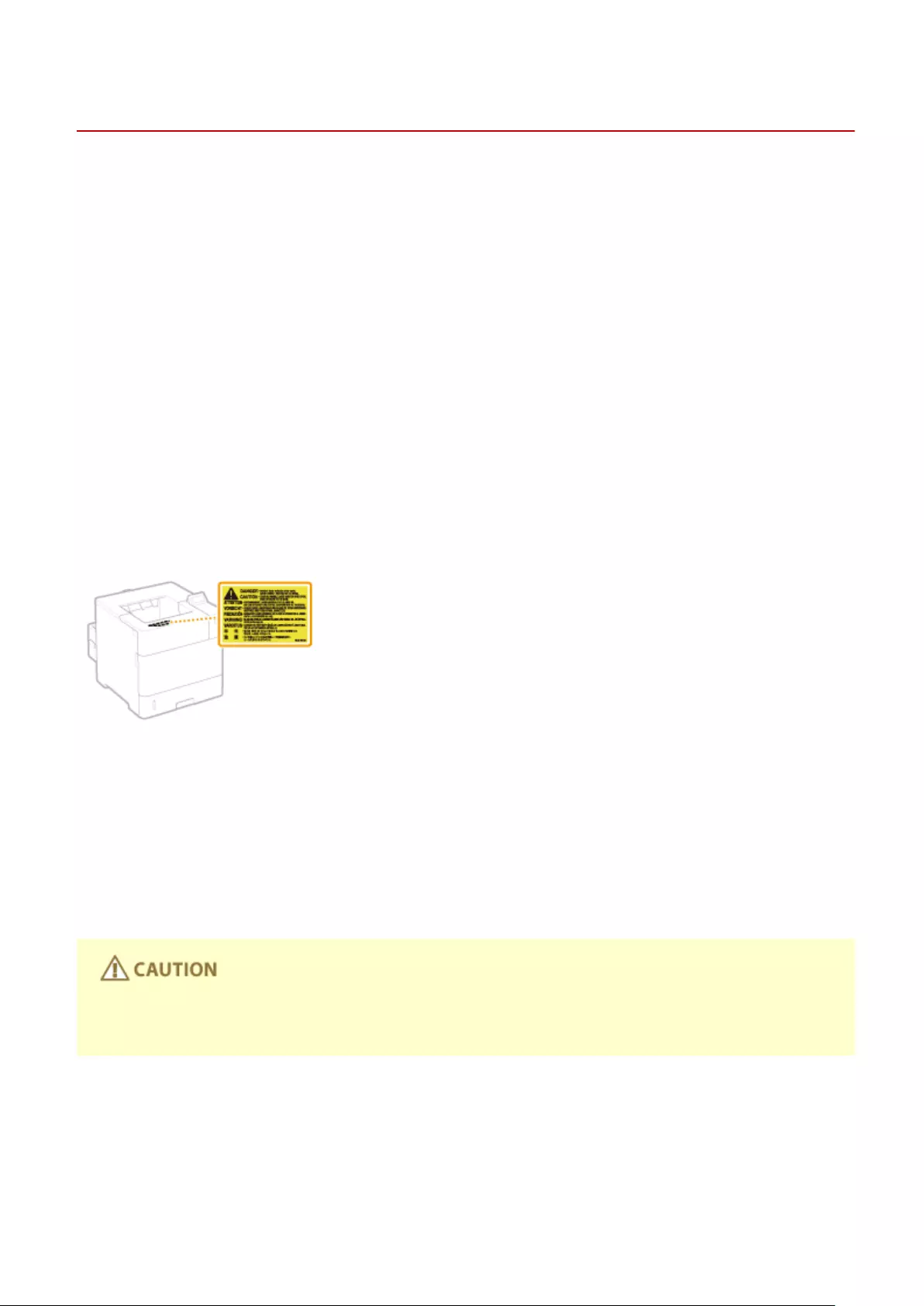
Notice
0X7U-08L
◼Product Name
Safety regulations require the product's name to be registered.
In some regions where this product is sold, the following name(s) in parentheses ( ) may be registered instead.
LBP352x/LBP351x (F168200)
◼EMC requirements of EC Directive
This equipment conforms with the essential EMC requirements of EC Directive. We declare that this product conforms
with the EMC requirements of EC Directive at nominal mains input 230 V, 50 Hz although the rated input of the product
is 220 to 240 V, 50/60 Hz. Use of shielded cable is necessary to comply with the technical EMC requirements of EC
Directive.
◼Laser Safety
This product is conrmed as a Class 1 laser product in IEC60825-1:2007 and EN60825-1:2007.
CLASS 1 LASER PRODUCT
LASER KLASSE 1
APPAREIL À LASER DE CLASSE 1
APPARECCHIO LASER DI CLASSE 1
PRODUCTO LÁSER DE CLASE 1
APARELHO A LASER DE CLASSE 1
LUOKAN 1 LASER-TUOTE
LASERPRODUKT KLASS 1
Use of controls, adjustments, or performance of procedures other than those specied in this manual may
result in hazardous radiation exposure.
Appendix
629
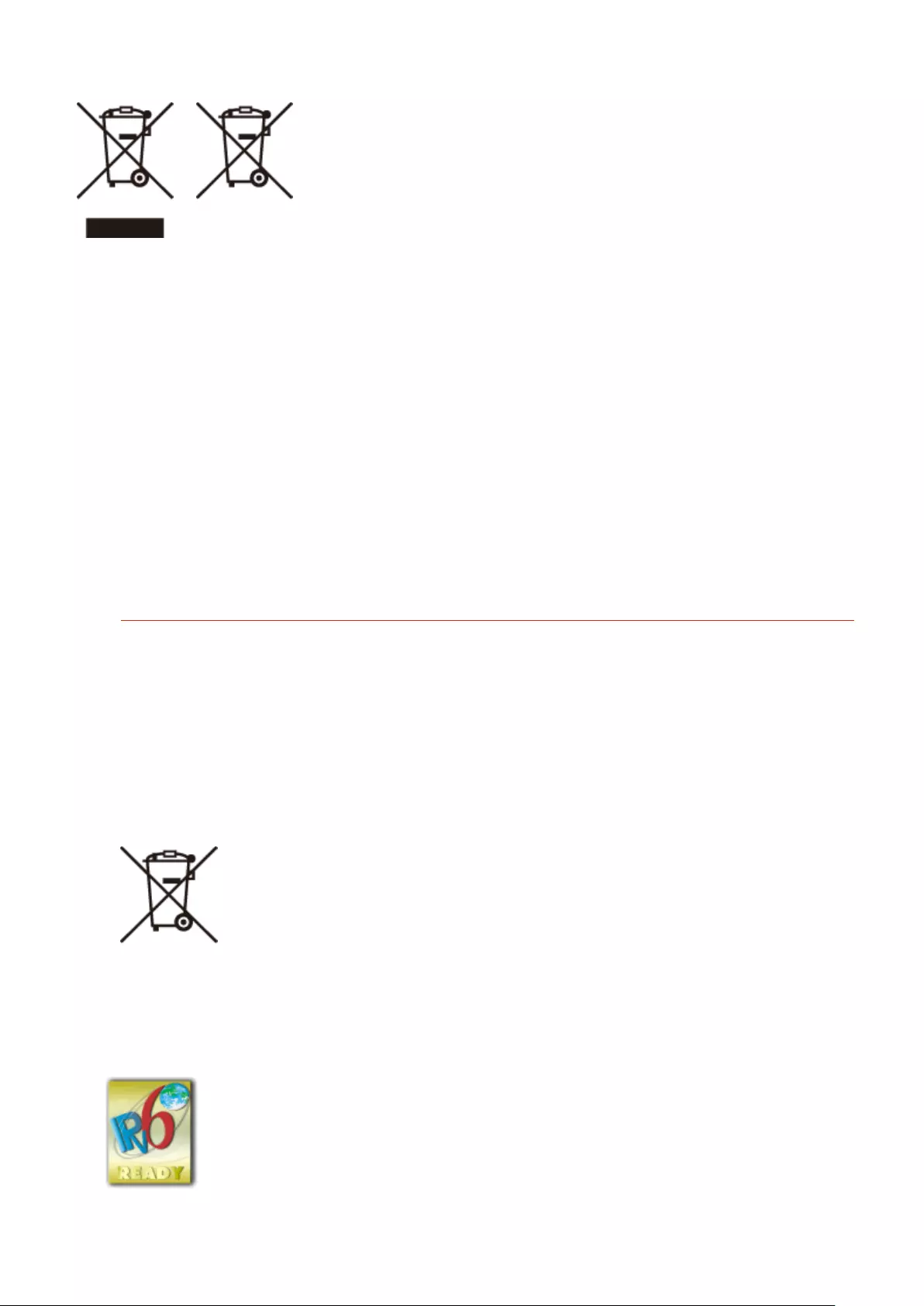
◼WEEE Directive / Rule
Only for European Union and EEA (Norway, Iceland and Liechtenstein)
These symbols indicate that this product is not to be disposed of with your household waste, according to the WEEE
Directive (2012/19/EU), the Battery Directive (2006/66/EC) and/or national legislation implementing those Directives.
If a chemical symbol is printed beneath the symbol shown above, in accordance with the Battery Directive, this
indicates that a heavy metal (Hg = Mercury, Cd = Cadmium, Pb = Lead) is present in this battery or accumulator at a
concentration above an applicable threshold specied in the Battery Directive.
This product should be handed over to a designated collection point, e.g., on an authorized one-for-one basis when
you buy a new similar product or to an authorized collection site for recycling waste electrical and electronic
equipment (EEE) and batteries and accumulators. Improper handling of this type of waste could have a possible
impact on the environment and human health due to potentially hazardous substances that are generally associated
with EEE. Your cooperation in the correct disposal of this product will contribute to the effective usage of natural
resources.
For more information about the recycling of this product, please contact your local city oce, waste authority,
approved scheme or your household waste disposal service or visit www.canon-europe.com/weee , or www.canon-
europe.com/battery .
India only
This product is not to be disposed of with your household waste, according to the e-waste (Management and
Handling) Rules, 2011. This product should be handed over to a designated collection point, e.g., to an
authorized collection site for recycling waste electrical and electronic equipment (EEE). Improper handling of
this type of waste could have a possible negative impact on the environment and human health due to
potentially hazardous substances that are generally associated with EEE. At the same time, your cooperation in
the correct disposal of this product will contribute to the effective usage of natural resources. For more
information regarding return and recycling of WEEE products, please visit http://www.canon.co.in/
environment .
Also, this product complies with the "India E-waste Rule 2011" and prohibits use of lead, mercury, hexavalent
chromium, polybrominated biphenyls or polybrominated diphenyl ethers in concentrations exceeding 0.1 % by
weight and 0.01 % by weight for Cadmium, except for the exemptions set in Schedule II of the Rule.
◼IPv6 Ready Logo
The protocol stack included in this machine has obtained the IPv6 Ready Logo Phase-2
established by the IPv6 Forum.
Appendix
630

◼Legal Limitations on the Usage of Your Product and the Use of Images
Using your product to scan, print or otherwise reproduce certain documents, and the use of such images as
scanned, printed or otherwise reproduced by your product, may be prohibited by law and may result in criminal
and/or civil liability. A non-exhaustive list of these documents is set forth below. This list is intended to be a guide
only. If you are uncertain about the legality of using your product to scan, print or otherwise reproduce any
particular document, and/or of the use of the images scanned, printed or otherwise reproduced, you should
consult in advance with your legal advisor for guidance.
●Paper Money
●Travelers Checks
●Money Orders
●Food Stamps
●Certicates of Deposit
●Passports
●Postage Stamps (canceled or uncanceled)
●Immigration Papers
●Identifying Badges or Insignias
●Internal Revenue Stamps (canceled or uncanceled)
●Selective Service or Draft Papers
●Bonds or Other Certicates of Indebtedness
●Checks or Drafts Issued by Governmental Agencies
●Stock Certicates
●Motor Vehicle Licenses and Certicates of Title
●Copyrighted Works/Works of Art without Permission of Copyright Owner
◼Disclaimers
●The information in this document is subject to change without notice.
●CANON INC. MAKES NO WARRANTY OF ANY KIND WITH REGARD TO THIS MATERIAL, EITHER EXPRESS OR IMPLIED,
EXCEPT AS PROVIDED HEREIN, INCLUDING WITHOUT LIMITATION, THEREOF, WARRANTIES AS TO MARKETABILITY,
MERCHANTABILITY, FITNESS FOR A PARTICULAR PURPOSE OF USE OR NON-INFRINGEMENT. CANON INC. SHALL
NOT BE LIABLE FOR ANY DIRECT, INCIDENTAL, OR CONSEQUENTIAL DAMAGES OF ANY NATURE, OR LOSSES OR
EXPENSES RESULTING FROM THE USE OF THIS MATERIAL.
◼Copyright
Copyright CANON INC. 2016
No part of this publication may be reproduced, transmitted, transcribed, stored in a retrieval system, or translated into
any language or computer language in any form or by any means, electronic, mechanical, magnetic, optical, chemical,
manual, or otherwise, without the prior written permission of Canon Inc.
◼Trademarks
"MEAP" is a trademark of CANON Inc., referring to an "application platform" for Canon multifunction and single
function printers.
Adobe, Acrobat, and Reader are registered trademarks of Adobe Systems Incorporated in the United States and/or
other countries.
Appendix
631

Apple, Bonjour, iPad, iPhone, iPod touch, Mac, Mac OS, Mac OS X and Safari are trademarks of Apple Inc.
Microsoft, Windows, Windows Vista, Windows Server, Internet Explorer, Word and Excel are either registered
trademarks or trademarks of Microsoft Corporation in the United States and/or other countries.
Google Cloud Print, Google Chrome, Android, Google Docs and Gmail are either registered trademarks or trademarks
of Google Inc.
This product contains the Universal Font Scaling Technology or UFST® under license from Monotype Imaging, Inc.
UFST® is a trademark of Monotype Imaging, Inc. registered in the United States Patent and Trademark Oce and may
be registered in certain jurisdictions.
UFST: Copyright © 1989 - 1996, 1997, 2003, 2004, 2008, all rights reserved, by Monotype Imaging Inc.
Java and all Java based trademarks and logos are trademarks or registered trademarks of Oracle and/or its aliates.
Adobe, PostScript, and the PostScript logo are either registered trademarks or trademarks of Adobe Systems
Incorporated in the United States and/or other countries.
Copyright © 2007 -08 Adobe Systems Incorporated. All rights reserved.
Protected by U.S. Patents 5,737,599; 5,781,785; 5,819,301; 5,929,866; 5,943,063; 6,073,148; 6,515,763; 6,639,593;
6,754,382; 7,046,403; 7,213,269; 7,242,415; Patents pending in the U.S. and other countries.
All instances of the name PostScript in the text are references to the PostScript language as dened by Adobe Systems
Incorporated unless otherwise stated. The name PostScript also is used as a product trademark for Adobe Systems'
implementation of the PostScript language interpreter.
Except as otherwise stated, any reference to a "PostScript printing device," "PostScript display device," or similar item
refers to a printing device, display device or item (respectively) that contains PostScript technology created or licensed
by Adobe Systems Incorporated and not to devices or items that purport to
be merely compatible with the PostScript language.
Adobe, the Adobe logo, PostScript, the PostScript logo, and PostScript 3 are either registered trademarks or
trademarks of Adobe Systems Incorporated in the United States and/or other countries.
Linux is a registered trademark of Linus Torvalds. Microsoft and Windows are either registered trademarks or
trademarks of Microsoft Corporation in the United States and/or other countries.
All other trademarks are the property of their respective owners.
All other product and brand names are registered trademarks, trademarks or service marks of their respective owners.
Appendix
632
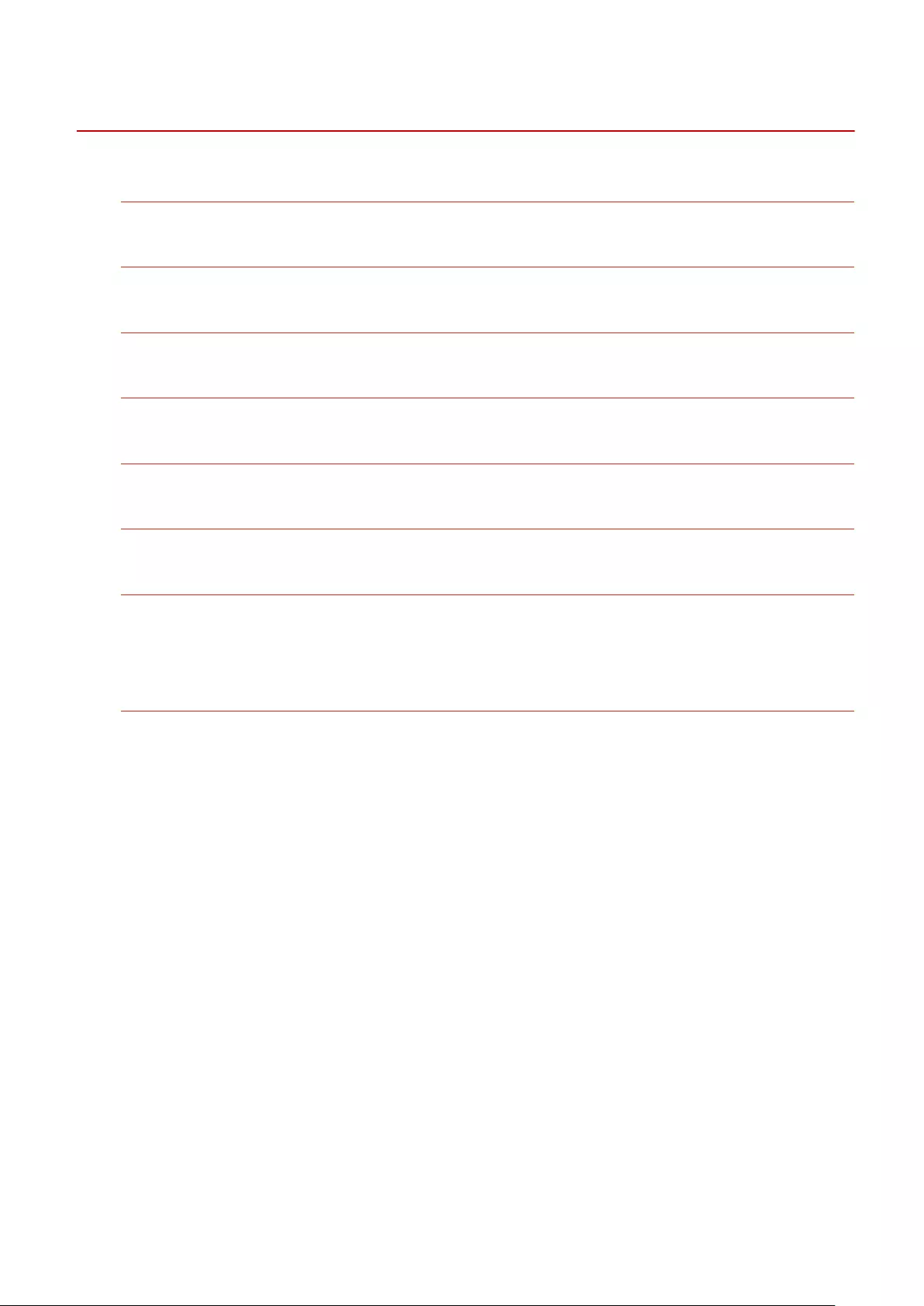
Oce Locations
0X7U-08R
CANON INC.
30-2, Shimomaruko 3-chome, Ohta-ku, Tokyo 146-8501, Japan
CANON MARKETING JAPAN INC.
16-6, Konan 2-chome, Minato-ku, Tokyo 108-8011, Japan
CANON U.S.A., INC.
One Canon Park, Melville, NY 11747, U.S.A.
CANON EUROPA N.V.
Bovenkerkerweg 59, 1185 XB Amstelveen, The Netherlands
CANON CHINA CO. LTD.
2F Jinbao Building No.89, Jinbao Street, Dongcheng District, Beijing 100005, PRC
CANON SINGAPORE PTE LTD
1 Fusionopolis Place, #15-10, Galaxis, Singapore 138522
CANON AUSTRALIA PTY LTD
Building A, The Park Estate, 5 Talavera Road, Macquarie Park, NSW 2113, Australia
CANON GLOBAL WORLDWIDE SITES
http://www.canon.com/
Appendix
633

This Font Software is licensed under the SIL Open Font License,
Version 1.1.
This license is copied below, and is also available with a FAQ at:
http://scripts.sil.org/OFL
-----------------------------------------------------------
SIL OPEN FONT LICENSE Version 1.1 - 26 February 2007
-----------------------------------------------------------
PREAMBLE
The goals of the Open Font License (OFL) are to stimulate worldwide
development of collaborative font projects, to support the font
creation efforts of academic and linguistic communities, and to
provide a free and open framework in which fonts may be shared and
improved in partnership with others.
The OFL allows the licensed fonts to be used, studied, modied and
redistributed freely as long as they are not sold by themselves. The
fonts, including any derivative works, can be bundled, embedded,
redistributed and/or sold with any software provided that any reserved
names are not used by derivative works. The fonts and derivatives,
however, cannot be released under any other type of license. The
requirement for fonts to remain under this license does not apply to
any document created using the fonts or their derivatives.
DEFINITIONS
"Font Software" refers to the set of les released by the Copyright
Holder(s) under this license and clearly marked as such. This may
include source les, build scripts and documentation.
"Reserved Font Name" refers to any names specied as such after the
copyright statement(s).
"Original Version" refers to the collection of Font Software
components as distributed by the Copyright Holder(s).
"Modied Version" refers to any derivative made by adding to,
deleting, or substituting -- in part or in whole -- any of the
components of the Original Version, by changing formats or by porting
the Font Software to a new environment.
"Author" refers to any designer, engineer, programmer, technical
writer or other person who contributed to the Font Software.
PERMISSION & CONDITIONS
Permission is hereby granted, free of charge, to any person obtaining
a copy of the Font Software, to use, study, copy, merge, embed,
modify, redistribute, and sell modied and unmodied copies of the
Font Software, subject to the following conditions:
SIL OPEN FONT LICENSE
634

1) Neither the Font Software nor any of its individual components, in
Original or Modied Versions, may be sold by itself.
2) Original or Modied Versions of the Font Software may be bundled,
redistributed and/or sold with any software, provided that each copy
contains the above copyright notice and this license. These can be
included either as stand-alone text les, human-readable headers or
in the appropriate machine-readable metadata elds within text or
binary les as long as those elds can be easily viewed by the user.
3) No Modied Version of the Font Software may use the Reserved Font
Name(s) unless explicit written permission is granted by the
corresponding Copyright Holder. This restriction only applies to the
primary font name as presented to the users.
4) The name(s) of the Copyright Holder(s) or the Author(s) of the Font
Software shall not be used to promote, endorse or advertise any
Modied Version, except to acknowledge the contribution(s) of the
Copyright Holder(s) and the Author(s) or with their explicit written
permission.
5) The Font Software, modied or unmodied, in part or in whole,
must be distributed entirely under this license, and must not be
distributed under any other license. The requirement for fonts to
remain under this license does not apply to any document created using
the Font Software.
TERMINATION
This license becomes null and void if any of the above conditions are
not met.
DISCLAIMER
THE FONT SOFTWARE IS PROVIDED "AS IS", WITHOUT WARRANTY OF ANY KIND,
EXPRESS OR IMPLIED, INCLUDING BUT NOT LIMITED TO ANY WARRANTIES OF
MERCHANTABILITY, FITNESS FOR A PARTICULAR PURPOSE AND NONINFRINGEMENT
OF COPYRIGHT, PATENT, TRADEMARK, OR OTHER RIGHT. IN NO EVENT SHALL THE
COPYRIGHT HOLDER BE LIABLE FOR ANY CLAIM, DAMAGES OR OTHER LIABILITY,
INCLUDING ANY GENERAL, SPECIAL, INDIRECT, INCIDENTAL, OR CONSEQUENTIAL
DAMAGES, WHETHER IN AN ACTION OF CONTRACT, TORT OR OTHERWISE, ARISING
FROM, OUT OF THE USE OR INABILITY TO USE THE FONT SOFTWARE OR FROM
OTHER DEALINGS IN THE FONT SOFTWARE.
SIL OPEN FONT LICENSE
635


































